Vögel in Central America in taxonomischer Hierarchie
Klasse aves (Vögel / Birds):
Ordnung Anseriformes (Vögel / Ducks, geese and swans):
Familie anatidae (Entenvögel / Anatidae):
Unterfamilie Anatinae (Dabbling ducks plus extinct):
Tribus Anatini (Schwimmenten / Dabbling ducks):
Mother and 4 of 9 babies on the Pfäffikersee 2020-05-20 09.12.44 null
Dieser Vogel erscheint jenseits grossen Meere in Kontinenten :
Europa, Nordamerika, Südamerika, Afrika.
Common waterbird at Pfäffikersee
Etymologie: ![]() Der heutige Name kann als Hinweis auf ihre Brutplätze verstanden werden, zu denen auf Stock gesetzte Weiden, Weidengebüsch oder auch Reisighaufen gehören.
['Stock' wird weiter erklärt: Als Stockausschlag bezeichnet man bei Bäumen und Sträuchern Triebe, die nach dem Verlust der primären Sprossachse
neu aus dem Stumpf oder Stubben (der dann „Stock“ genannt wird) austreiben.] [Link]
Der heutige Name kann als Hinweis auf ihre Brutplätze verstanden werden, zu denen auf Stock gesetzte Weiden, Weidengebüsch oder auch Reisighaufen gehören.
['Stock' wird weiter erklärt: Als Stockausschlag bezeichnet man bei Bäumen und Sträuchern Triebe, die nach dem Verlust der primären Sprossachse
neu aus dem Stumpf oder Stubben (der dann „Stock“ genannt wird) austreiben.] [Link]
![]() The name 'was derived from the Old French malart or mallart for "wild drake"' [Link]
The name 'was derived from the Old French malart or mallart for "wild drake"' [Link]
Vokalisierung: ![]() Female: A distinct coarse, laughing quacking; "haaa ha ha ha ha ha", with first note accented and then descending in pitch. Male: a more silent, very nasal "rriib". [Link]
Female: A distinct coarse, laughing quacking; "haaa ha ha ha ha ha", with first note accented and then descending in pitch. Male: a more silent, very nasal "rriib". [Link]
Rufe: ![]() Display call a high-pitched short whistle. [Link]
Display call a high-pitched short whistle. [Link]
Körperlich: Länge=50-65 cm,
Flügelspanne=81-98 cm,
Gewicht=750-1450 g
Krickente am Aa-Bach beim Südende des Pfäffikersee 2021-01-26 15.41.54 null
Dieser Vogel erscheint jenseits grossen Meere in Kontinenten :
Europa, Nordamerika, Südamerika, Afrika.
Wintergast am Teich am Aa-Bach beim Südende des Pfäffikersee
Etymologie: ![]() Die hellen «krrik»-Rufe der stimmfreudigen Erpel verhalfen dieser Art zu ihrem deutschen Namen. [Link]
Die hellen «krrik»-Rufe der stimmfreudigen Erpel verhalfen dieser Art zu ihrem deutschen Namen. [Link]
Vokalisierung: ![]() Male: characteristic, short, highly resonant and metallic "plytt". A bit similar to Pintail, but higher pitched and lacking accompanying whistling sound. Female: various quacking sounds generally quicker paced, more nasal and noticeably higher pitched than Mallard. [Link]
Male: characteristic, short, highly resonant and metallic "plytt". A bit similar to Pintail, but higher pitched and lacking accompanying whistling sound. Female: various quacking sounds generally quicker paced, more nasal and noticeably higher pitched than Mallard. [Link]
Körperlich: Länge=34-38 cm,
Flügelspanne=58-64 cm,
Gewicht=200-450 g
Ruf:
Blup blup, fast wie vom Computer generiert
Krickente Ruf von XenoCanto
♫ Krickente Ruf von XenoCanto Quelle: XENOCANTO

Ruf Eigenschaften:
Ruf Melodie: simple rhythmic, slow, Frequenz: low (1-3 KHz),
Profil Wikipedia Vogelwarte BirdLife ZH Audubon Xeno-Canto BirdID NABU

Wikipedia: Northern pintail
Dieser Vogel erscheint jenseits grossen Meere in Kontinenten :
Europa, Nordamerika, Südamerika, Afrika.
Allgemein: ![]() The pintail or northern pintail (Anas acuta) is a duck with wide geographic distribution that breeds in the northern areas of Europe and across the Palearctic and North America. It is migratory and winters south of its breeding range to the equator. Unusually for a bird with such a large range, it has no geographical subspecies if the possibly conspecific duck Eaton's pintail is considered to be a separate species.
[more]
The pintail or northern pintail (Anas acuta) is a duck with wide geographic distribution that breeds in the northern areas of Europe and across the Palearctic and North America. It is migratory and winters south of its breeding range to the equator. Unusually for a bird with such a large range, it has no geographical subspecies if the possibly conspecific duck Eaton's pintail is considered to be a separate species.
[more]
Vokalisierung: ![]() Female: similar to Mallards coarse laughing sound, but with a more emphasized first "haaa", and a more silent accelerating subsequent "laugh". Male: Pleasant, resonant "plop" similar to Teal, but lower pitched, richer, mellower and not so metallic. Accompanied by a higher pitched, slightly raspy whistling "aiiooo" rising and falling in pitch. [Link]
Female: similar to Mallards coarse laughing sound, but with a more emphasized first "haaa", and a more silent accelerating subsequent "laugh". Male: Pleasant, resonant "plop" similar to Teal, but lower pitched, richer, mellower and not so metallic. Accompanied by a higher pitched, slightly raspy whistling "aiiooo" rising and falling in pitch. [Link]
Körperlich: Länge=51-66 cm,
Flügelspanne=51-66 cm,
Gewicht=500-1100 g
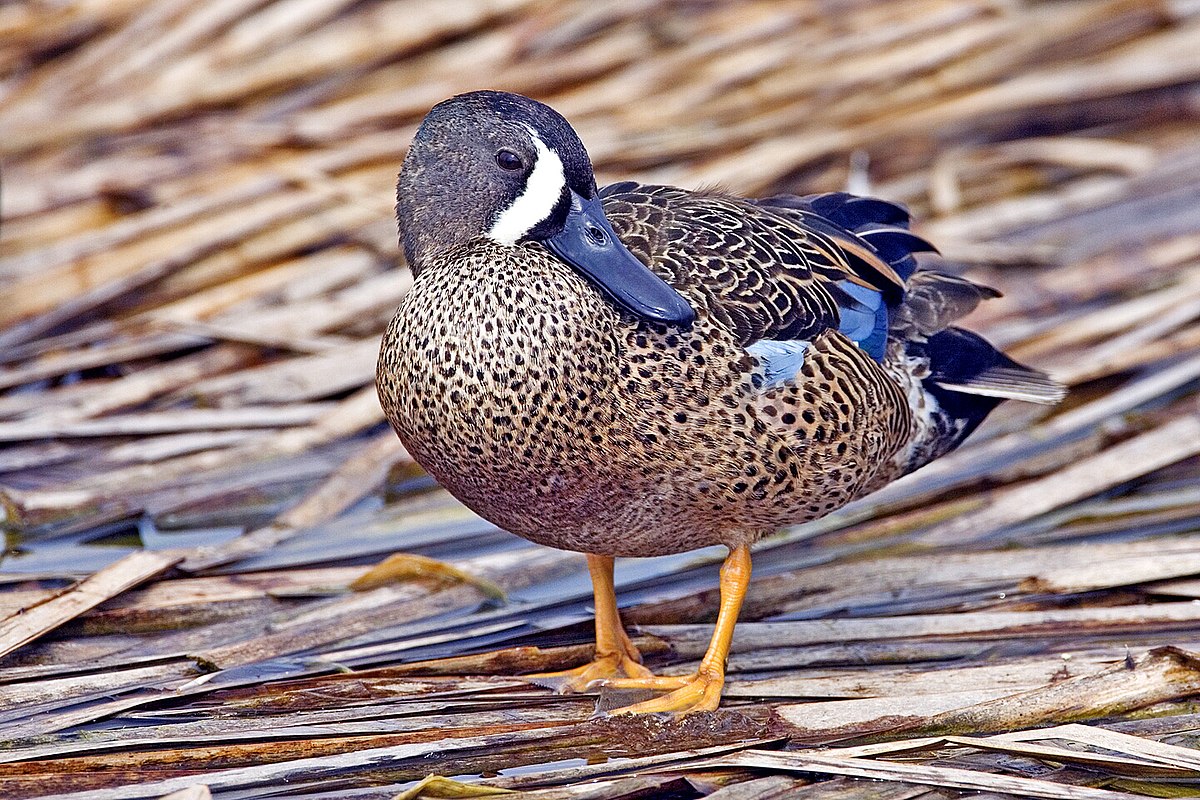
Wikipedia: Blue-winged teal
Allgemein: ![]() The blue-winged teal (Spatula discors) is a species of bird in the duck, goose, and swan family Anatidae. One of the smaller members of the dabbling duck group, it occurs in North America, where it breeds from southern Alaska to Nova Scotia, and south to northern Texas. It winters along the Pacific and Atlantic coasts and south into the Caribbean islands and Central America.
[more]
The blue-winged teal (Spatula discors) is a species of bird in the duck, goose, and swan family Anatidae. One of the smaller members of the dabbling duck group, it occurs in North America, where it breeds from southern Alaska to Nova Scotia, and south to northern Texas. It winters along the Pacific and Atlantic coasts and south into the Caribbean islands and Central America.
[more]

Wikipedia: American wigeon
![]() The American wigeon (Mareca americana), also known as the baldpate, is a species of dabbling duck found in North America. Formerly assigned to Anas, this species is classified with the other wigeons in the dabbling duck genus Mareca. It is the New World counterpart of the Eurasian wigeon. Mareca is from the Brazilian-Portuguese word Marréco for a small duck and americana refers to America.[2][3]
[more]
The American wigeon (Mareca americana), also known as the baldpate, is a species of dabbling duck found in North America. Formerly assigned to Anas, this species is classified with the other wigeons in the dabbling duck genus Mareca. It is the New World counterpart of the Eurasian wigeon. Mareca is from the Brazilian-Portuguese word Marréco for a small duck and americana refers to America.[2][3]
[more]
Tribus Aythyini (Tauchenten / Diving ducks):

Wikipedia: Ring-necked duck
![]() The ring-necked duck (Aythya collaris) is a diving duck from North America commonly found in freshwater ponds and lakes.[2] The scientific name is derived from Greek aithuia, an unidentified seabird mentioned by authors including Hesychius and Aristotle, and Latin collaris, "of the neck" from collum, "neck".[3]
[more]
The ring-necked duck (Aythya collaris) is a diving duck from North America commonly found in freshwater ponds and lakes.[2] The scientific name is derived from Greek aithuia, an unidentified seabird mentioned by authors including Hesychius and Aristotle, and Latin collaris, "of the neck" from collum, "neck".[3]
[more]

Wikipedia: Lesser scaup
![]() The lesser scaup (Aythya affinis) is a small North American diving duck that migrates south as far as Central America in winter. It is colloquially known as the little bluebill or broadbill because of its distinctive blue bill. The origin of the name scaup may stem from the bird's preference for feeding on scalp—the Scottish word for clams, oysters, and mussels; however, some credit it to the female's discordant scaup call as the name's source.[2] It is apparently a very close relative of the Holarctic greater scaup or "bluebill" (A. marila), with which it forms a superspecies.[3][4] The scientific name is derived from Ancient Greek aithuia an unidentified seabird mentioned by authors including Hesychius and Aristotle, and Latin, affinis "related to", from its resemblance to the greater scaup.[5]
[more]
The lesser scaup (Aythya affinis) is a small North American diving duck that migrates south as far as Central America in winter. It is colloquially known as the little bluebill or broadbill because of its distinctive blue bill. The origin of the name scaup may stem from the bird's preference for feeding on scalp—the Scottish word for clams, oysters, and mussels; however, some credit it to the female's discordant scaup call as the name's source.[2] It is apparently a very close relative of the Holarctic greater scaup or "bluebill" (A. marila), with which it forms a superspecies.[3][4] The scientific name is derived from Ancient Greek aithuia an unidentified seabird mentioned by authors including Hesychius and Aristotle, and Latin, affinis "related to", from its resemblance to the greater scaup.[5]
[more]
Gattung Cairina:
Profil Wikipedia Audubon Xeno-Canto

Wikipedia: Muscovy duck
![]() The Muscovy duck (Cairina moschata) is a large duck native to Mexico and Central and South America. Small wild and feral breeding populations have established themselves in the United States, particularly in Florida, Louisiana, Massachusetts, and the lower Rio Grande Valley of Texas, the Big Island of Hawaii, as well as in many other parts of North America, including southern Canada. Feral Muscovy ducks are found in New Zealand, Australia, and in parts of Europe.
[more]
The Muscovy duck (Cairina moschata) is a large duck native to Mexico and Central and South America. Small wild and feral breeding populations have established themselves in the United States, particularly in Florida, Louisiana, Massachusetts, and the lower Rio Grande Valley of Texas, the Big Island of Hawaii, as well as in many other parts of North America, including southern Canada. Feral Muscovy ducks are found in New Zealand, Australia, and in parts of Europe.
[more]
Gattung Nomonyx:

Wikipedia: Masked duck
![]() The masked duck (Nomonyx dominicus) is a tiny stiff-tailed duck ranging through the tropical Americas. They are found from Mexico to South America and also in the Caribbean. Primarily not migratory, masked ducks are reported as very uncommon vagrants in the southernmost United States, along the Mexican border and in Florida. As of 2000, the conservation status for masked ducks in Texas is 3,800 birds.[2] On April 1, 1962, it was recorded from Lowndes County, Georgia, where it was photographed by Alexander Wetmore.[3]
[more]
The masked duck (Nomonyx dominicus) is a tiny stiff-tailed duck ranging through the tropical Americas. They are found from Mexico to South America and also in the Caribbean. Primarily not migratory, masked ducks are reported as very uncommon vagrants in the southernmost United States, along the Mexican border and in Florida. As of 2000, the conservation status for masked ducks in Texas is 3,800 birds.[2] On April 1, 1962, it was recorded from Lowndes County, Georgia, where it was photographed by Alexander Wetmore.[3]
[more]
Familie Anatidae (Waterfowl):
Unterfamilie Dendrocygninae:
Gattung Dendrocygna:
Black billed whistling duck. 2020-02-19 07.35.22 null
We saw this on the Pipeline Road near Gamboa, Panama - see tiger heron for more on that.
Allgemein: ![]() Die Kubapfeifgans (Dendrocygna arborea) ist eine Art der Entenvögel. In der Unterfamilie der Pfeifgänse stellt sie die größte Art dar. Sie ist auf den Großen Antillen, einigen Bahama-Inseln, den Kaimaninseln und den Kleinen Antillen bis nach Martinique verbreitet.
[more]
Die Kubapfeifgans (Dendrocygna arborea) ist eine Art der Entenvögel. In der Unterfamilie der Pfeifgänse stellt sie die größte Art dar. Sie ist auf den Großen Antillen, einigen Bahama-Inseln, den Kaimaninseln und den Kleinen Antillen bis nach Martinique verbreitet.
[more]
Profil Wikipedia Audubon Xeno-Canto

Wikipedia: Fulvous whistling-duck
Dieser Vogel erscheint jenseits grossen Meere in Kontinenten :
Nordamerika, Südamerika, Afrika.
![]() The fulvous whistling duck or fulvous tree duck (Dendrocygna bicolor) is a species of whistling duck that breeds across the world's tropical regions in much of Mexico and South America, the West Indies, the southern United States, sub-Saharan Africa and the Indian subcontinent. It has plumage that is mainly reddish brown, long legs and a long grey bill, and shows a distinctive white band across its black tail in flight. Like other members of its ancient lineage, it has a whistling call which is given in flight or on the ground. Its preferred habitat consists of wetlands with plentiful vegetation, including shallow lakes and paddy fields.
The nest, built from plant material and unlined, is placed among dense vegetation or in a tree hole. The typical clutch is around ten whitish eggs. The breeding adults, which pair for life, take turns to incubate, and the eggs hatch in 24–29 days. The downy grey ducklings leave the nest within a day or so of hatching, but the parents continue to protect them until they fledge around nine weeks later.
[more]
The fulvous whistling duck or fulvous tree duck (Dendrocygna bicolor) is a species of whistling duck that breeds across the world's tropical regions in much of Mexico and South America, the West Indies, the southern United States, sub-Saharan Africa and the Indian subcontinent. It has plumage that is mainly reddish brown, long legs and a long grey bill, and shows a distinctive white band across its black tail in flight. Like other members of its ancient lineage, it has a whistling call which is given in flight or on the ground. Its preferred habitat consists of wetlands with plentiful vegetation, including shallow lakes and paddy fields.
The nest, built from plant material and unlined, is placed among dense vegetation or in a tree hole. The typical clutch is around ten whitish eggs. The breeding adults, which pair for life, take turns to incubate, and the eggs hatch in 24–29 days. The downy grey ducklings leave the nest within a day or so of hatching, but the parents continue to protect them until they fledge around nine weeks later.
[more]
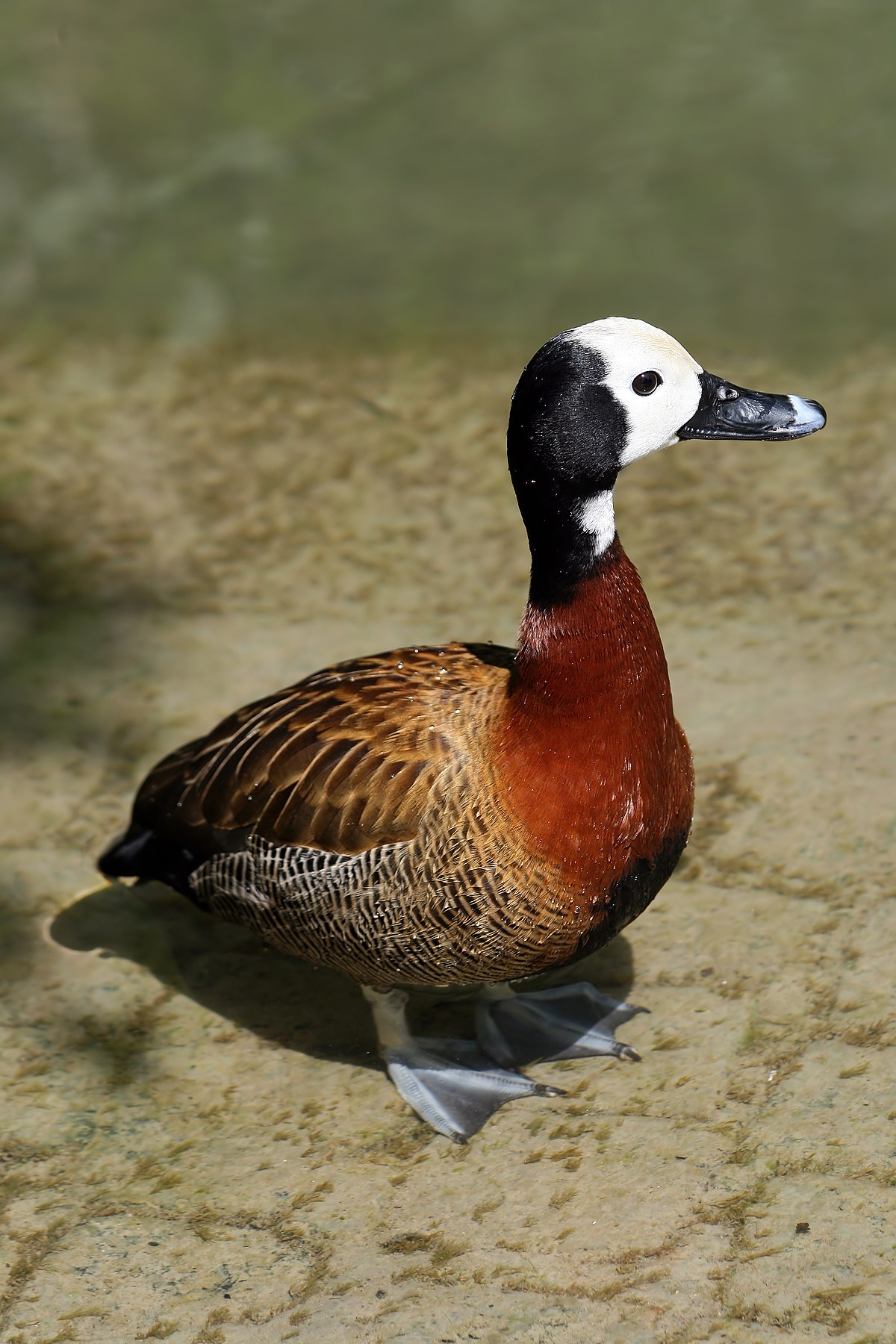
Wikipedia: White-faced whistling-duck
Dieser Vogel erscheint jenseits grossen Meere in Kontinenten :
Südamerika, Afrika.
![]() Anas viduata Linnaeus, 1766
[more]
Anas viduata Linnaeus, 1766
[more]

Wikipedia: Black-bellied whistling-duck
![]() The black-bellied whistling duck (Dendrocygna autumnalis), formerly called the black-bellied tree duck, is a whistling duck that breeds from the southernmost United States, Mexico, and tropical Central to south-central South America. In the US, it can be found year-round in peninsular Florida, parts of southeast Texas, coastal Alabama and seasonally in southeast Arizona, and Louisiana's Gulf Coast. It is a rare breeder in such disparate locations as Arkansas, Georgia, Tennessee, and South Carolina, though it is now a common breeder in parts of central Florida. There is a large population of several hundred that winter each year in Audubon Park in uptown New Orleans, Louisiana. Since it is one of only two whistling duck species native to North America, it is occasionally just known as the "whistling duck" or "Mexican squealer" in the southern USA.
[more]
The black-bellied whistling duck (Dendrocygna autumnalis), formerly called the black-bellied tree duck, is a whistling duck that breeds from the southernmost United States, Mexico, and tropical Central to south-central South America. In the US, it can be found year-round in peninsular Florida, parts of southeast Texas, coastal Alabama and seasonally in southeast Arizona, and Louisiana's Gulf Coast. It is a rare breeder in such disparate locations as Arkansas, Georgia, Tennessee, and South Carolina, though it is now a common breeder in parts of central Florida. There is a large population of several hundred that winter each year in Audubon Park in uptown New Orleans, Louisiana. Since it is one of only two whistling duck species native to North America, it is occasionally just known as the "whistling duck" or "Mexican squealer" in the southern USA.
[more]
Ordnung Suliformes:
Familie Phalacrocoracidae (Kormorane / Cormorants and shags):
Gattung Phalacrocorax:
Olivenscharbe / Neotropic cormorant (Phalacrocorax brasilianus)
Profil Wikipedia Audubon Xeno-Canto

Wikipedia: Neotropic cormorant
![]() The neotropic cormorant or olivaceous cormorant (Phalacrocorax brasilianus) is a medium-sized cormorant found throughout the American tropics and subtropics, from the middle Rio Grande and the Gulf and Californian coasts of the United States south through Mexico and Central America to southern South America, where it is called by the Indian name of biguá. It also breeds on the Bahamas, Cuba and Trinidad. It can be found both at coasts (including some mangrove areas) and on inland waters. There are at least two subspecies: P. b. mexicanus from Nicaragua northwards and P. b. brasilianus further south. In Peru the neotropic cormorant is used by the Uru people for fishing.
[more]
The neotropic cormorant or olivaceous cormorant (Phalacrocorax brasilianus) is a medium-sized cormorant found throughout the American tropics and subtropics, from the middle Rio Grande and the Gulf and Californian coasts of the United States south through Mexico and Central America to southern South America, where it is called by the Indian name of biguá. It also breeds on the Bahamas, Cuba and Trinidad. It can be found both at coasts (including some mangrove areas) and on inland waters. There are at least two subspecies: P. b. mexicanus from Nicaragua northwards and P. b. brasilianus further south. In Peru the neotropic cormorant is used by the Uru people for fishing.
[more]
Ordnung Pelecaniformes (Ibis, herons and pelicans):
Familie Ardeidae (Reiher / Herons):
Gattung Ardea (Great herons):
Silberreiher / Great egret (Ardea alba)

Silberreiher in Deutschland, von WikiCommons Von Andreas Eichler, CC BY-SA 4.0, https://commons.wikimedia.org/w/index.php?curid=59954907
Dieser Vogel erscheint jenseits grossen Meere in Kontinenten :
Europa, Nordamerika, Südamerika, Afrika.
Auf dem Heimweg von Schwanden haben wir bei Benken ganz weisse Reiher gesehen.
Laut ornitho.ch waren sie Silberreiher.
Bei den meisten Quellen heisst es, sie sind in der Schweiz nur Durchzüger oder Wintergäste.
Aber laut Balzari und Gygax, brüten auch einige Voegel am Lac Neuchatel seit 2013.
Vokalisierung: ![]() Silent outside breeding ground. [Link]
Silent outside breeding ground. [Link]
Rufe: ![]() In colonies various harsh calls like a dry, and mechanical "kerrrrrrr", and a very nasal "geet" or "ga-geet ga-geet" are heard. [Link]
In colonies various harsh calls like a dry, and mechanical "kerrrrrrr", and a very nasal "geet" or "ga-geet ga-geet" are heard. [Link]
Körperlich: Länge=85-102 cm,
Flügelspanne=140-170 cm,
Gewicht=960-1030 g
Kanadareiher / Great blue heron (Ardea herodias)
Profil Wikipedia Audubon Xeno-Canto
Great blue heron, apparently known as a predator of small birds and chased away, above Cherrywood Court. 2021-06-17 05.48.04 null
Allgemein: ![]() The great blue heron (Ardea herodias) is a large wading bird in the heron family Ardeidae, common near the shores of open water and in wetlands over most of North America and Central America, as well as the Caribbean and the Galápagos Islands. It is a rare vagrant to coastal Spain, the Azores, and areas of far southern Europe. An all-white population found in south Florida and the Florida Keys is known as the great white heron. Debate exists about whether this represents a white color morph of the great blue heron, a subspecies of it, or an entirely separate species.[2][3] The status of white individuals known to occur elsewhere in the Caribbean, and very rarely elsewhere in eastern North America, is unclear.[3]
[more]
The great blue heron (Ardea herodias) is a large wading bird in the heron family Ardeidae, common near the shores of open water and in wetlands over most of North America and Central America, as well as the Caribbean and the Galápagos Islands. It is a rare vagrant to coastal Spain, the Azores, and areas of far southern Europe. An all-white population found in south Florida and the Florida Keys is known as the great white heron. Debate exists about whether this represents a white color morph of the great blue heron, a subspecies of it, or an entirely separate species.[2][3] The status of white individuals known to occur elsewhere in the Caribbean, and very rarely elsewhere in eastern North America, is unclear.[3]
[more]
Cocoireiher / Cocoi heron (Ardea cocoi)
Profil Wikipedia Xeno-Canto

Wikipedia: Cocoi heron
![]() The cocoi heron (Ardea cocoi) is a species of long-legged wading bird in the heron family Ardeidae found across South America. It has predominantly pale grey plumage with a darker grey crest. A carnivore, it hunts fish and crustaceans in shallow water.
[more]
The cocoi heron (Ardea cocoi) is a species of long-legged wading bird in the heron family Ardeidae found across South America. It has predominantly pale grey plumage with a darker grey crest. A carnivore, it hunts fish and crustaceans in shallow water.
[more]
Gattung Nycticorax (Night herons):
Nachtreiher / Black-crowned night-heron (Nycticorax nycticorax)

Wikipedia: Black-crowned night-heron
Dieser Vogel erscheint jenseits grossen Meere in Kontinenten :
Europa, Nordamerika, Südamerika, Afrika.
![]() The black-crowned night heron (Nycticorax nycticorax), or black-capped night heron, commonly shortened to just night heron in Eurasia, is a medium-sized heron found throughout a large part of the world, except in the coldest regions and Australasia (where it is replaced by the closely related nankeen night heron, with which it has hybridized in the area of contact).
[more]
The black-crowned night heron (Nycticorax nycticorax), or black-capped night heron, commonly shortened to just night heron in Eurasia, is a medium-sized heron found throughout a large part of the world, except in the coldest regions and Australasia (where it is replaced by the closely related nankeen night heron, with which it has hybridized in the area of contact).
[more]
Rufe: ![]() Most commonly hear call is a nasal, soft croaking "roack", like cross between Raven and frog. [Link]
Most commonly hear call is a nasal, soft croaking "roack", like cross between Raven and frog. [Link]
Körperlich: Länge=58-65 cm,
Flügelspanne=105-112 cm,
Gewicht=500-800 g
Gattung Egretta (Plumed egrets):
Egretta thula / Snowy egret (Egretta thula)
Profil Wikipedia Audubon Xeno-Canto

Wikipedia: Snowy egret
Dieser Vogel erscheint jenseits grossen Meere in Kontinenten :
Nordamerika, Südamerika, Afrika.
Allgemein: ![]() The snowy egret (Egretta thula) is a small white heron. The genus name comes from Provençal French for the little egret, aigrette, which is a diminutive of aigron, 'heron'. The species name thula is the Araucano term for the black-necked swan, applied to this species in error by Chilean naturalist Juan Ignacio Molina in 1782.[3]
[more]
The snowy egret (Egretta thula) is a small white heron. The genus name comes from Provençal French for the little egret, aigrette, which is a diminutive of aigron, 'heron'. The species name thula is the Araucano term for the black-necked swan, applied to this species in error by Chilean naturalist Juan Ignacio Molina in 1782.[3]
[more]
Blaureiher / Little blue heron (Egretta caerulea)
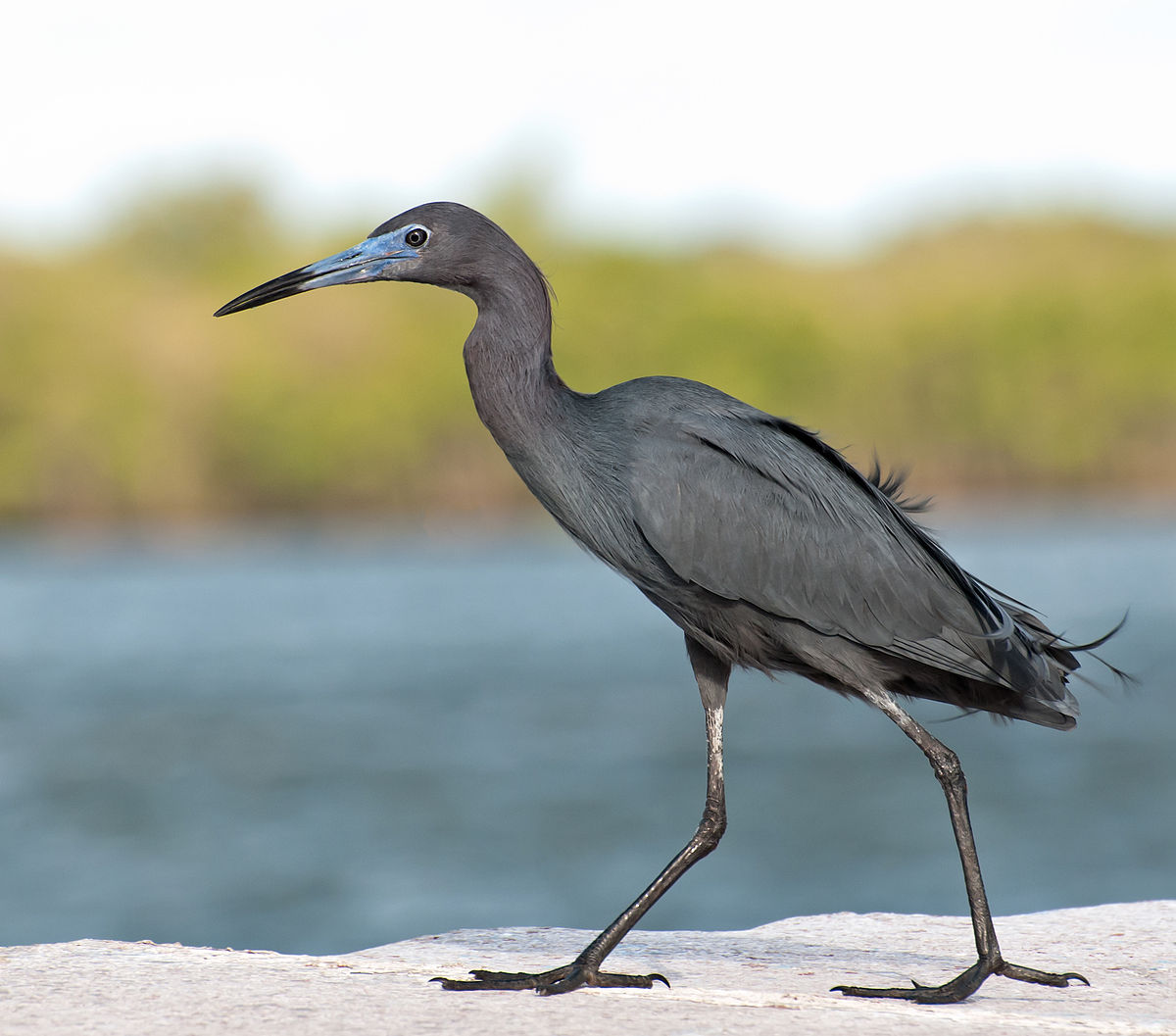
Wikipedia: Little blue heron
Dieser Vogel erscheint jenseits grossen Meere in Kontinenten :
Nordamerika, Südamerika, Afrika.
![]() The little blue heron (Egretta caerulea) is a small heron belonging to the family Ardeidae.
[more]
The little blue heron (Egretta caerulea) is a small heron belonging to the family Ardeidae.
[more]
Rötelreiher / Reddish egret (Egretta rufescens)
Profil Wikipedia Audubon Xeno-Canto

Wikipedia: Reddish egret
![]() The reddish egret (Egretta rufescens) is a medium-sized heron. It is a resident breeder in Central America, The Bahamas, the Caribbean, the Gulf Coast of the United States, and Mexico.[2] There is post-breeding dispersal to well north of the nesting range. In the past, this bird was a victim of the plume trade.
[more]
The reddish egret (Egretta rufescens) is a medium-sized heron. It is a resident breeder in Central America, The Bahamas, the Caribbean, the Gulf Coast of the United States, and Mexico.[2] There is post-breeding dispersal to well north of the nesting range. In the past, this bird was a victim of the plume trade.
[more]
Dreifarbenreiher / Tricolored heron (Egretta tricolor)
Profil Wikipedia Audubon Xeno-Canto
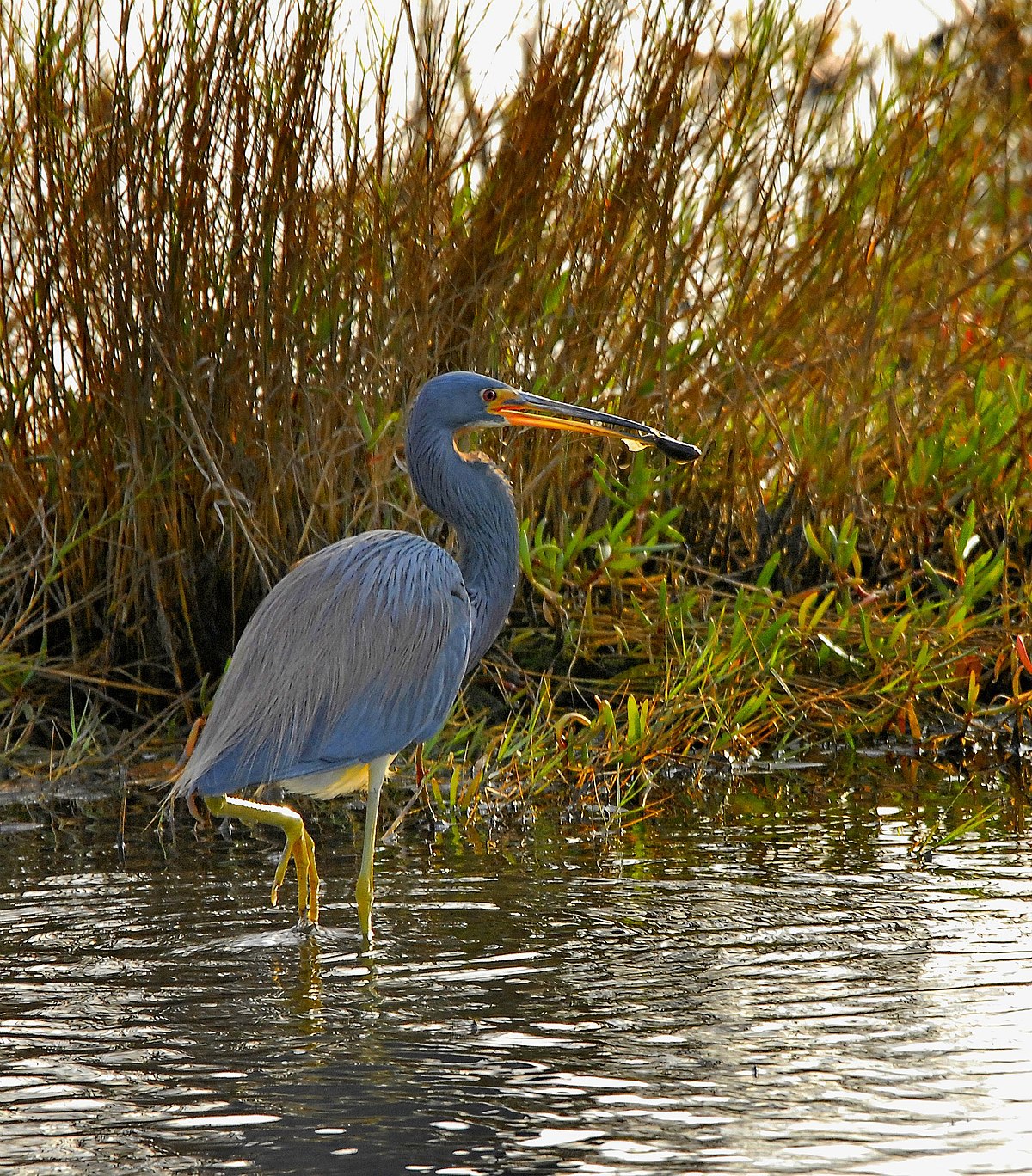
Wikipedia: Tricolored heron
![]() The tricolored heron (Egretta tricolor), formerly known as the Louisiana heron, is a small species of heron native to coastal parts of the Americas; in the Atlantic region, it ranges from the northeastern United States, south along the coast, through the Gulf of Mexico and the Caribbean, to northern South America as far south as Brazil. In the Pacific region, it ranges from Peru to California, but it is only a nonbreeding visitor to the far north.
[more]
The tricolored heron (Egretta tricolor), formerly known as the Louisiana heron, is a small species of heron native to coastal parts of the Americas; in the Atlantic region, it ranges from the northeastern United States, south along the coast, through the Gulf of Mexico and the Caribbean, to northern South America as far south as Brazil. In the Pacific region, it ranges from Peru to California, but it is only a nonbreeding visitor to the far north.
[more]
Gattung Nyctanassa:
Krabbenreiher / Yellow-crowned night heron (Nyctanassa violacea)
Juvenile Yellow-crowned night heron in Manzanillo, Costa Rica. 2020-03-13 08.59.00 null
![]() Der Krabbenreiher (Nyctanassa violacea, Syn.: Nycticorax violaceus) ist eine Vogelart aus der Familie der Reiher.
[more]
Der Krabbenreiher (Nyctanassa violacea, Syn.: Nycticorax violaceus) ist eine Vogelart aus der Familie der Reiher.
[more]
Gattung Botaurus (Brown bitterns):
Nordamerikanische Rohrdommel / American bittern (Botaurus lentiginosus)

Wikipedia: American bittern
Dieser Vogel erscheint jenseits grossen Meere in Kontinenten :
Nordamerika, Südamerika, Afrika.
![]() The American bittern (Botaurus lentiginosus) is a species of wading bird in the heron family. It has a Nearctic distribution, breeding in Canada and the northern and central parts of the United States, and wintering in the U.S. Gulf Coast states, all of Florida into the Everglades, the Caribbean islands and parts of Central America.
[more]
The American bittern (Botaurus lentiginosus) is a species of wading bird in the heron family. It has a Nearctic distribution, breeding in Canada and the northern and central parts of the United States, and wintering in the U.S. Gulf Coast states, all of Florida into the Everglades, the Caribbean islands and parts of Central America.
[more]
Südamerikanische Rohrdommel / Pinnated bittern (Botaurus pinnatus)

Wikipedia: Pinnated bittern
![]() The pinnated bittern (Botaurus pinnatus), also known as the South American bittern, is a large member of the heron family (Ardeidae) found in the New World tropics. Like the other Botaurus bitterns, its plumage is mostly buffy-brown and cryptically patterned. Though it is a widespread species, it is rarely seen – presumably due to its skulking habits – and much about its life history remains little known.
[more]
The pinnated bittern (Botaurus pinnatus), also known as the South American bittern, is a large member of the heron family (Ardeidae) found in the New World tropics. Like the other Botaurus bitterns, its plumage is mostly buffy-brown and cryptically patterned. Though it is a widespread species, it is rarely seen – presumably due to its skulking habits – and much about its life history remains little known.
[more]
Gattung Bubulcus (Cattle egrets):
Kuhreiher / Cattle egret (Bubulcus ibis)
Arenal cattle w cattle egrets. 2018-02-27 16.42.14 null
Dieser Vogel erscheint jenseits grossen Meere in Kontinenten :
Europa, Nordamerika, Südamerika, Afrika.
![]() The cattle egret (Bubulcus ibis) is a cosmopolitan species of heron (family Ardeidae) found in the tropics, subtropics, and warm-temperate zones. It is the only member of the monotypic genus Bubulcus, although some authorities regard two of its subspecies as full species, the western cattle egret and the eastern cattle egret. Despite the similarities in plumage to the egrets of the genus Egretta, it is more closely related to the herons of Ardea. Originally native to parts of Asia, Africa, and Europe, it has undergone a rapid expansion in its distribution and successfully colonised much of the rest of the world in the last century.
[more]
The cattle egret (Bubulcus ibis) is a cosmopolitan species of heron (family Ardeidae) found in the tropics, subtropics, and warm-temperate zones. It is the only member of the monotypic genus Bubulcus, although some authorities regard two of its subspecies as full species, the western cattle egret and the eastern cattle egret. Despite the similarities in plumage to the egrets of the genus Egretta, it is more closely related to the herons of Ardea. Originally native to parts of Asia, Africa, and Europe, it has undergone a rapid expansion in its distribution and successfully colonised much of the rest of the world in the last century.
[more]
Vokalisierung: ![]() Usually silent away from breeding ground. In the colonies a chorus of various coarse sounds can be heard. Most distinct is a disyllabic "rick-rack". Other sounds includes short, guttural utterings, or drawn, harsh shrieks. [Link]
Usually silent away from breeding ground. In the colonies a chorus of various coarse sounds can be heard. Most distinct is a disyllabic "rick-rack". Other sounds includes short, guttural utterings, or drawn, harsh shrieks. [Link]
Körperlich: Länge=48-53 cm,
Flügelspanne=90-96 cm,
Gewicht=300-400 g
Gattung Butorides (Green-backed herons):
Butorides striata / Green-backed heron (Butorides striata)

Wikipedia: Green-backed heron
Dieser Vogel erscheint jenseits grossen Meere in Kontinenten :
Europa, Südamerika, Afrika.
Grünreiher / Green heron (Butorides virescens)
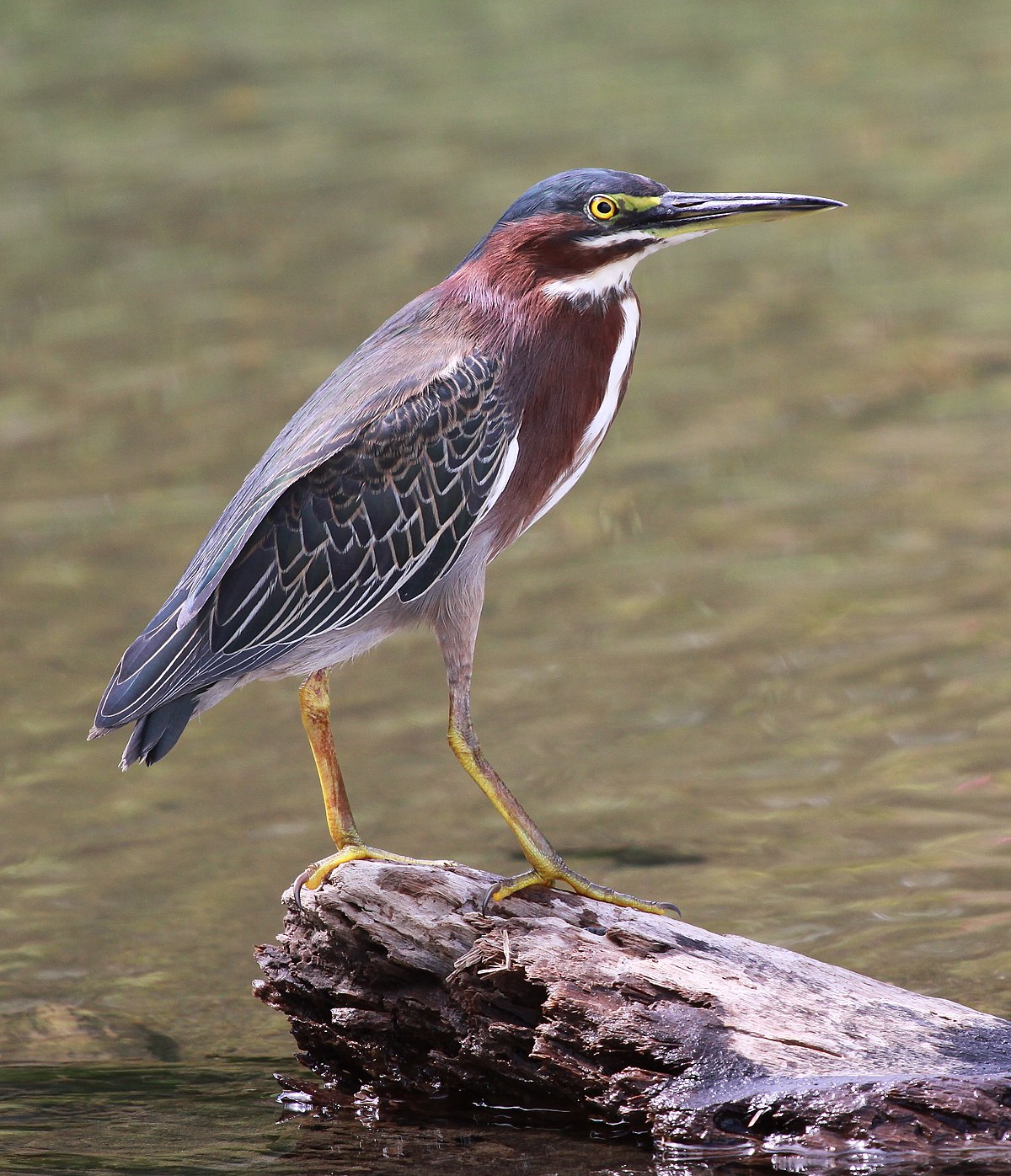
Wikipedia: Green heron
Allgemein: ![]() The green heron (Butorides virescens) is a small heron of North and Central America. Butorides is from Middle English butor "bittern" and Ancient Greek -oides, "resembling", and virescens is Latin for "greenish".[2]
[more]
The green heron (Butorides virescens) is a small heron of North and Central America. Butorides is from Middle English butor "bittern" and Ancient Greek -oides, "resembling", and virescens is Latin for "greenish".[2]
[more]
Gattung Cochlearius:
Kahnschnabel / Boat-billed heron (Cochlearius cochlearius)

Boat billed heron in Cahuita, Costa Rica. 2020-03-17 16.57.49 null
![]() Der Kahnschnabel (Cochlearius cochlearius) gehört innerhalb der Familie der Reiher (Ardeidae) zur monotypischen Gattung Cochlearius.
[more]
Der Kahnschnabel (Cochlearius cochlearius) gehört innerhalb der Familie der Reiher (Ardeidae) zur monotypischen Gattung Cochlearius.
[more]
Gattung Ixobrychus (Least bitterns):
Amerikanische Zwergdommel / Least bittern (Ixobrychus exilis)
Profil Wikipedia Audubon Xeno-Canto
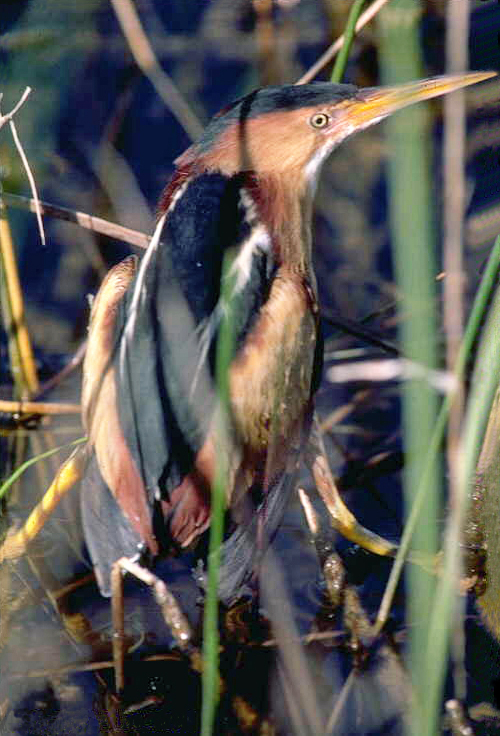
Wikipedia: Least bittern
![]() The least bittern (Ixobrychus exilis) is a small heron, the smallest member of the family Ardeidae found in the Americas.
[more]
The least bittern (Ixobrychus exilis) is a small heron, the smallest member of the family Ardeidae found in the Americas.
[more]
Gattung Tigrisoma:
Streifenreiher / Fasciated tiger heron (Tigrisoma fasciatum)
Fasciated tiger heron. 2020-02-19 06.59.06 null
We saw this on a guided tour of the Pipeline Road near Gamboa, Panama, which is named after an oil pipeline built to ensure supply during World War II, but never actually put into service, and now providing access to Soberania National Park.
Allgemein: ![]() Der Streifenreiher (Tigrisoma fasciatum) ist ein in Südamerika verbreiteter Reiher.
[more]
Der Streifenreiher (Tigrisoma fasciatum) ist ein in Südamerika verbreiteter Reiher.
[more]
Nacktkehlreiher / Bare-throated tiger-heron (Tigrisoma mexicanum)
Profil Wikipedia Xeno-Canto

Wikipedia: Bare-throated tiger-heron
![]() The bare-throated tiger heron (Tigrisoma mexicanum) is a wading bird of the heron family, Ardeidae, found from Mexico to northwestern Colombia, with one recorded sighting from the United States in Hidalgo County, Texas.[2] It is 80 cm (31 in) in length and weighs 1,200 g (42 oz).
[more]
The bare-throated tiger heron (Tigrisoma mexicanum) is a wading bird of the heron family, Ardeidae, found from Mexico to northwestern Colombia, with one recorded sighting from the United States in Hidalgo County, Texas.[2] It is 80 cm (31 in) in length and weighs 1,200 g (42 oz).
[more]
Marmorreiher / Rufescent tiger-heron (Tigrisoma lineatum)
Profil Wikipedia Xeno-Canto
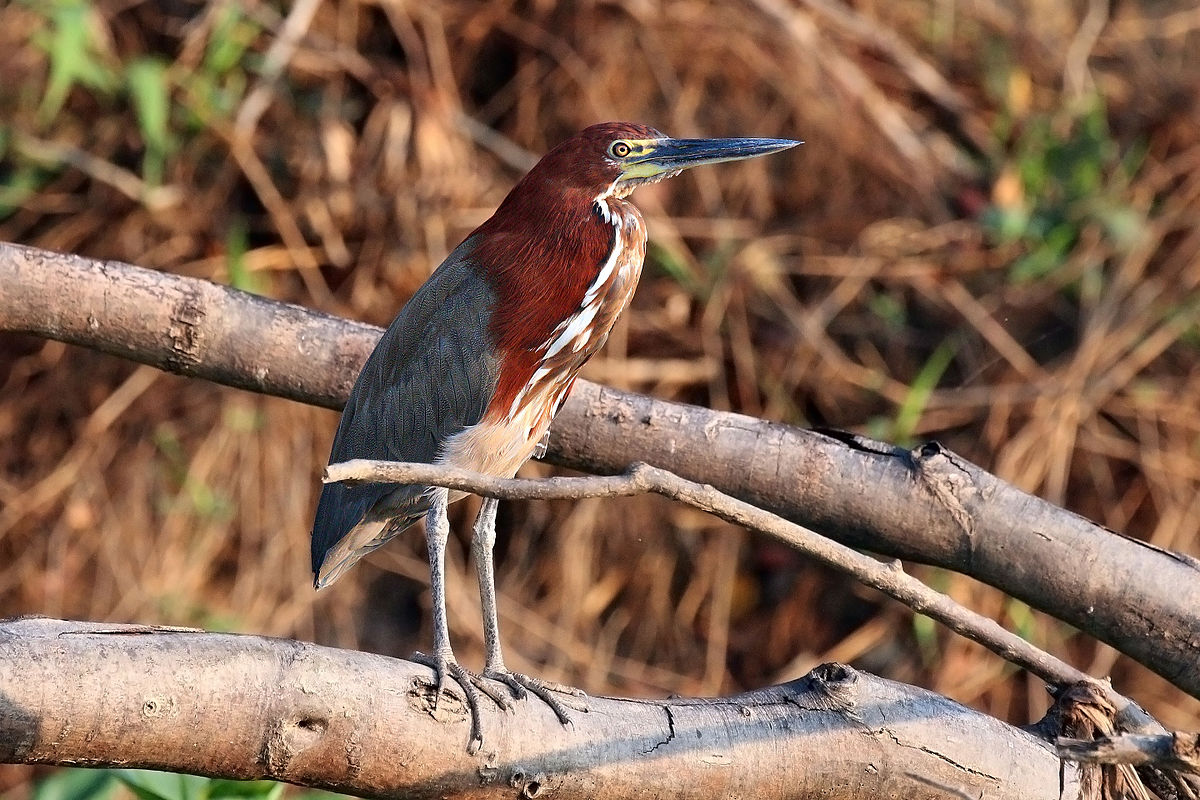
Wikipedia: Rufescent tiger-heron
![]() The rufescent tiger heron (Tigrisoma lineatum) is a species of heron in the family Ardeidae. It is found in wetlands from Central America through much of South America.
[more]
The rufescent tiger heron (Tigrisoma lineatum) is a species of heron in the family Ardeidae. It is found in wetlands from Central America through much of South America.
[more]
Gattung Agamia:
Agamia agami / Agami heron (Agamia agami)
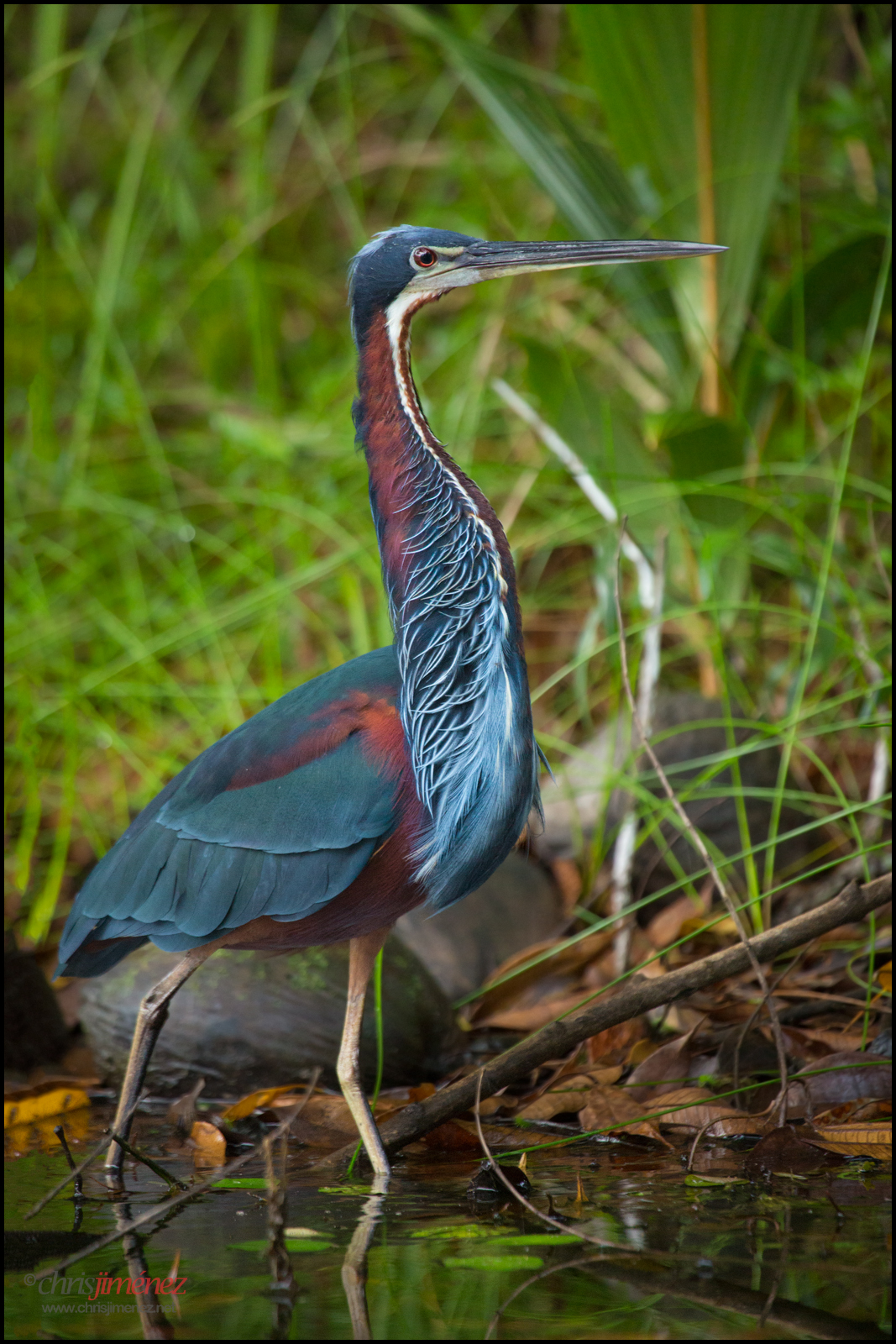
Wikipedia: Agami heron
![]() The agami heron (Agamia agami) is a medium-sized heron. It is a resident breeding bird from Central America south to Peru and Brazil. It is sometimes known as the chestnut-bellied heron, and is the only member of the genus Agamia (Reichenbach, 1853). In Brazil it is sometimes called Soco beija-flor, meaning 'hummingbird heron', thanks to its unique coloration pattern.[2]
[more]
The agami heron (Agamia agami) is a medium-sized heron. It is a resident breeding bird from Central America south to Peru and Brazil. It is sometimes known as the chestnut-bellied heron, and is the only member of the genus Agamia (Reichenbach, 1853). In Brazil it is sometimes called Soco beija-flor, meaning 'hummingbird heron', thanks to its unique coloration pattern.[2]
[more]
Gattung Pilherodius:
Kappenreiher / Capped heron (Pilherodius pileatus)

Wikipedia: Capped heron
![]() The capped heron (Pilherodius pileatus) is a water bird endemic to the neotropics, inhabiting rainforest from the center of Panama to the south of Brazil.[2] It is the only species of the genus Pilherodius, and one of the least known of the heron family, Ardeidae. It is superficially similar to the group of the night herons, but is active during daytime or at twilight.[3]
[more]
The capped heron (Pilherodius pileatus) is a water bird endemic to the neotropics, inhabiting rainforest from the center of Panama to the south of Brazil.[2] It is the only species of the genus Pilherodius, and one of the least known of the heron family, Ardeidae. It is superficially similar to the group of the night herons, but is active during daytime or at twilight.[3]
[more]
Familie Fregatidae (Frigatebirds):
Gattung Fregata:
Bindenfregattvogel / Great frigatebird (Fregata minor)
Profil Wikipedia Audubon Xeno-Canto
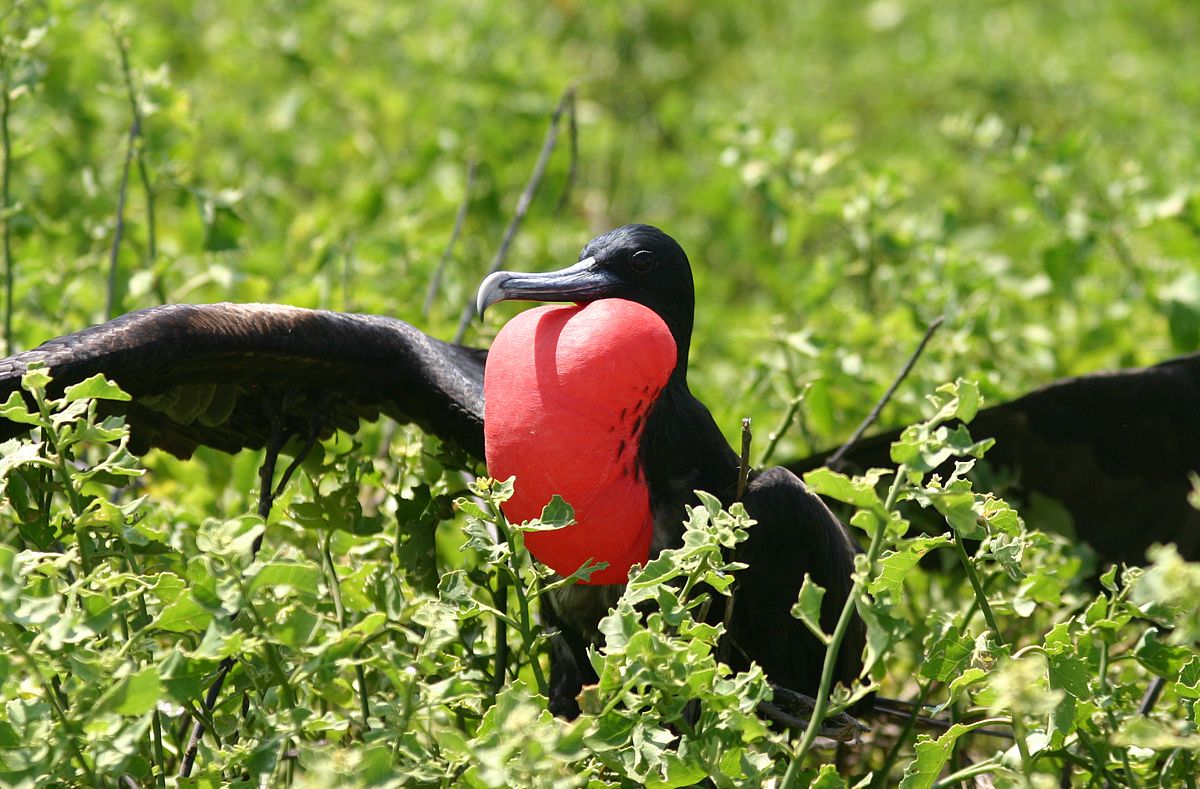
Wikipedia: Great frigatebird
Dieser Vogel erscheint jenseits grossen Meere in Kontinenten :
Nordamerika, Südamerika, Afrika.
![]() The great frigatebird (Fregata minor) is a large seabird in the frigatebird family. There are major nesting populations in the tropical Pacific (including the Galapagos Islands) and Indian Oceans, as well as a tiny population in the South Atlantic.
[more]
The great frigatebird (Fregata minor) is a large seabird in the frigatebird family. There are major nesting populations in the tropical Pacific (including the Galapagos Islands) and Indian Oceans, as well as a tiny population in the South Atlantic.
[more]
Prachtfregattvogel / Magnificent frigatebird (Fregata magnificens)
Profil Wikipedia Audubon Xeno-Canto

Wikipedia: Magnificent frigatebird
Dieser Vogel erscheint jenseits grossen Meere in Kontinenten :
Nordamerika, Südamerika, Afrika.
![]() The magnificent frigatebird (Fregata magnificens) or man o' war is a seabird of the frigatebird family Fregatidae. With a length of 89–114 centimetres (35–45 in) and wingspan of 2.17–2.44 m (7.1–8.0 ft) it is the largest species of frigatebird. It occurs over tropical and subtropical waters off America, between northern Mexico and Perú on the Pacific coast and between Florida and southern Brazil along the Atlantic coast.[1] There are also populations on the Galápagos Islands in the Pacific and the Cape Verde islands in the Atlantic.
[more]
The magnificent frigatebird (Fregata magnificens) or man o' war is a seabird of the frigatebird family Fregatidae. With a length of 89–114 centimetres (35–45 in) and wingspan of 2.17–2.44 m (7.1–8.0 ft) it is the largest species of frigatebird. It occurs over tropical and subtropical waters off America, between northern Mexico and Perú on the Pacific coast and between Florida and southern Brazil along the Atlantic coast.[1] There are also populations on the Galápagos Islands in the Pacific and the Cape Verde islands in the Atlantic.
[more]
Familie Pelecanidae (Pelicans):
Gattung Pelecanus:
Pelecanus occidentalis / Brown pelican (Pelecanus occidentalis)
Profil Wikipedia Audubon Xeno-Canto
Brown pelican tentative ID. 2020-03-08 13.27.20 null
![]() The brown pelican (Pelecanus occidentalis) is a bird of the pelican family, Pelecanidae, one of three species found in the Americas and one of two that feed by diving into water. It is found on the Atlantic Coast from New Jersey to the mouth of the Amazon River, and along the Pacific Coast from British Columbia to northern Chile, including the Galapagos Islands. The nominate subspecies in its breeding plumage has a white head with a yellowish wash on the crown. The nape and neck are dark maroon–brown. The upper sides of the neck have white lines along the base of the gular pouch, and the lower fore neck has a pale yellowish patch. The male and female are similar, but the female is slightly smaller. The nonbreeding adult has a white head and neck. The pink skin around the eyes becomes dull and gray in the nonbreeding season. It lacks any red hue, and the pouch is strongly olivaceous ochre-tinged and the legs are olivaceous gray to blackish-gray.
[more]
The brown pelican (Pelecanus occidentalis) is a bird of the pelican family, Pelecanidae, one of three species found in the Americas and one of two that feed by diving into water. It is found on the Atlantic Coast from New Jersey to the mouth of the Amazon River, and along the Pacific Coast from British Columbia to northern Chile, including the Galapagos Islands. The nominate subspecies in its breeding plumage has a white head with a yellowish wash on the crown. The nape and neck are dark maroon–brown. The upper sides of the neck have white lines along the base of the gular pouch, and the lower fore neck has a pale yellowish patch. The male and female are similar, but the female is slightly smaller. The nonbreeding adult has a white head and neck. The pink skin around the eyes becomes dull and gray in the nonbreeding season. It lacks any red hue, and the pouch is strongly olivaceous ochre-tinged and the legs are olivaceous gray to blackish-gray.
[more]
Familie Phaethontidae (Tropicbirds):
Gattung Phaethon:
Rotschnabel-Tropikvogel / Red-billed tropicbird (Phaethon aethereus)
Profil Wikipedia Audubon Xeno-Canto

Wikipedia: Red-billed tropicbird
Dieser Vogel erscheint jenseits grossen Meere in Kontinenten :
Nordamerika, Südamerika, Afrika.
![]() The red-billed tropicbird (Phaethon aethereus) is a tropicbird, one of three closely related species of seabird of tropical oceans. Superficially resembling a tern in appearance, it has mostly white plumage with some black markings on the wings and back, a black mask and, as its common name suggests, a red bill. Most adults have tail streamers that are about two times their body length, with those in males being generally longer than those in females. The red-billed tropicbird itself has three subspecies recognized, including the nominate. The subspecies mesonauta is distinguished from the nominate by the rosy tinge of its fresh plumage, and the subspecies indicus can be differentiated by its smaller size, more restricted mask, and more orange bill. This species ranges across the tropical Atlantic, eastern Pacific, and Indian Oceans. The nominate is found in the southern Atlantic Ocean, the subspecies indicus in the waters off of the Middle East and in the Indian Ocean, and the subspecies mesonauta in the eastern portions of both the Atlantic and the Pacific Oceans and in the Caribbean. It was one of the many species described by Carl Linnaeus in his 1758 10th edition of Systema Naturae.
[more]
The red-billed tropicbird (Phaethon aethereus) is a tropicbird, one of three closely related species of seabird of tropical oceans. Superficially resembling a tern in appearance, it has mostly white plumage with some black markings on the wings and back, a black mask and, as its common name suggests, a red bill. Most adults have tail streamers that are about two times their body length, with those in males being generally longer than those in females. The red-billed tropicbird itself has three subspecies recognized, including the nominate. The subspecies mesonauta is distinguished from the nominate by the rosy tinge of its fresh plumage, and the subspecies indicus can be differentiated by its smaller size, more restricted mask, and more orange bill. This species ranges across the tropical Atlantic, eastern Pacific, and Indian Oceans. The nominate is found in the southern Atlantic Ocean, the subspecies indicus in the waters off of the Middle East and in the Indian Ocean, and the subspecies mesonauta in the eastern portions of both the Atlantic and the Pacific Oceans and in the Caribbean. It was one of the many species described by Carl Linnaeus in his 1758 10th edition of Systema Naturae.
[more]
Familie Sulidae (Tölpel / Gannets and boobies):
Gattung Sula:
Weißbauchtölpel / Brown booby (Sula leucogaster)
Profil Wikipedia Audubon Xeno-Canto

Wikipedia: Brown booby
Dieser Vogel erscheint jenseits grossen Meere in Kontinenten :
Nordamerika, Südamerika, Afrika.
![]() The brown booby (Sula leucogaster) is a large seabird of the booby family, Sulidae, of which it is perhaps the most common and widespread species.[3] It has a pantropical range, which overlaps with that of other booby species. The gregarious brown booby commutes and forages at low height over inshore waters. Flocks plunge-dive to take small fish, especially when these are driven near the surface by their predators. They only nest on the ground, and roost on solid objects rather than the water surface.[3]
[more]
The brown booby (Sula leucogaster) is a large seabird of the booby family, Sulidae, of which it is perhaps the most common and widespread species.[3] It has a pantropical range, which overlaps with that of other booby species. The gregarious brown booby commutes and forages at low height over inshore waters. Flocks plunge-dive to take small fish, especially when these are driven near the surface by their predators. They only nest on the ground, and roost on solid objects rather than the water surface.[3]
[more]
Rotfußtölpel / Red-footed booby (Sula sula)
Profil Wikipedia Audubon Xeno-Canto
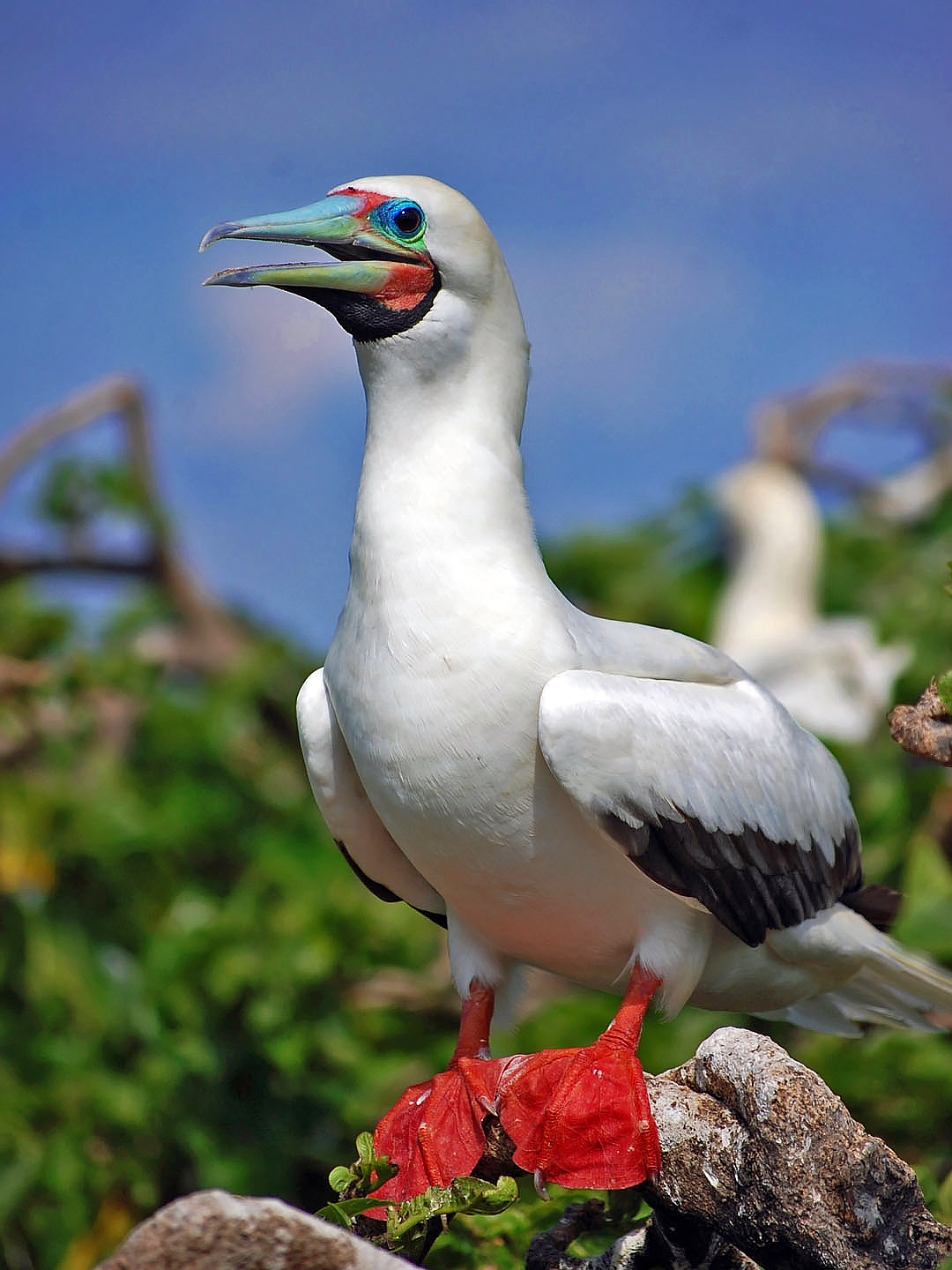
Wikipedia: Red-footed booby
Dieser Vogel erscheint jenseits grossen Meere in Kontinenten :
Nordamerika, Südamerika, Afrika.
![]() The red-footed booby (Sula sula) is a large seabird of the booby family, Sulidae. Adults always have red feet, but the colour of the plumage varies. They are powerful and agile fliers, but they are clumsy in takeoffs and landings. They are found widely in the tropics, and breed colonially in coastal regions, especially islands. The species faces few natural or man-made threats, although its population is declining; it is considered to be a least-concern species by the International Union for Conservation of Nature (IUCN).
[more]
The red-footed booby (Sula sula) is a large seabird of the booby family, Sulidae. Adults always have red feet, but the colour of the plumage varies. They are powerful and agile fliers, but they are clumsy in takeoffs and landings. They are found widely in the tropics, and breed colonially in coastal regions, especially islands. The species faces few natural or man-made threats, although its population is declining; it is considered to be a least-concern species by the International Union for Conservation of Nature (IUCN).
[more]
Sula dactylatra / Masked booby (Sula dactylatra)
Profil Wikipedia Audubon Xeno-Canto

Wikipedia: Masked booby
Dieser Vogel erscheint jenseits grossen Meere in Kontinenten :
Nordamerika, Südamerika, Afrika.
![]() The masked booby (Sula dactylatra), also called the masked gannet or the blue-faced booby, is a large seabird of the booby and gannet family, Sulidae. First described by the French naturalist René-Primevère Lesson in 1831, the masked booby is one of six species of booby in the genus Sula. It has a typical sulid body shape, with a long pointed yellowish bill, long neck, aerodynamic body, long slender wings and pointed tail. The adult is bright white with black wings, a black tail and a dark face mask; at 75–85 cm (30–33 in) long, it is the largest species of booby. The sexes have similar plumage. This species ranges across tropical oceans, except in the eastern Atlantic and eastern Pacific. In the latter, it is replaced by the Nazca booby (Sula granti), which was formerly regarded as a subspecies of masked booby.
[more]
The masked booby (Sula dactylatra), also called the masked gannet or the blue-faced booby, is a large seabird of the booby and gannet family, Sulidae. First described by the French naturalist René-Primevère Lesson in 1831, the masked booby is one of six species of booby in the genus Sula. It has a typical sulid body shape, with a long pointed yellowish bill, long neck, aerodynamic body, long slender wings and pointed tail. The adult is bright white with black wings, a black tail and a dark face mask; at 75–85 cm (30–33 in) long, it is the largest species of booby. The sexes have similar plumage. This species ranges across tropical oceans, except in the eastern Atlantic and eastern Pacific. In the latter, it is replaced by the Nazca booby (Sula granti), which was formerly regarded as a subspecies of masked booby.
[more]
Nazcatölpel / Nazca booby (Sula granti)
Profil Wikipedia Xeno-Canto

Wikipedia: Nazca booby
![]() The Nazca booby (Sula granti) is a large seabird of the booby family, Sulidae, native to the eastern Pacific. First described by Walter Rothschild in 1902, it was long considered a subspecies of the masked booby until recognised as distinct genetically and behaviorally in 2002. It has a typical sulid body shape, with a long pointed orange-yellow bill, long neck, aerodynamic body, long slender wings and pointed tail. The adult is bright white with black and white wings, a black tail and a dark face mask.
[more]
The Nazca booby (Sula granti) is a large seabird of the booby family, Sulidae, native to the eastern Pacific. First described by Walter Rothschild in 1902, it was long considered a subspecies of the masked booby until recognised as distinct genetically and behaviorally in 2002. It has a typical sulid body shape, with a long pointed orange-yellow bill, long neck, aerodynamic body, long slender wings and pointed tail. The adult is bright white with black and white wings, a black tail and a dark face mask.
[more]
Blaufußtölpel / Blue-footed booby (Sula nebouxii)
Profil Wikipedia Xeno-Canto

Wikipedia: Blue-footed booby
![]() The blue-footed booby (Sula nebouxii) is a marine bird native to subtropical and tropical regions of the eastern Pacific Ocean. It is one of six species of the genus Sula – known as boobies. It is easily recognizable by its distinctive bright blue feet, which is a sexually selected trait. Males display their feet in an elaborate mating ritual by lifting them up and down while strutting before the female. The female is slightly larger than the male and can measure up to 90 cm (35 in) long with a wingspan up to 1.5 m (5 ft).[2]
[more]
The blue-footed booby (Sula nebouxii) is a marine bird native to subtropical and tropical regions of the eastern Pacific Ocean. It is one of six species of the genus Sula – known as boobies. It is easily recognizable by its distinctive bright blue feet, which is a sexually selected trait. Males display their feet in an elaborate mating ritual by lifting them up and down while strutting before the female. The female is slightly larger than the male and can measure up to 90 cm (35 in) long with a wingspan up to 1.5 m (5 ft).[2]
[more]
Guanotölpel / Peruvian booby (Sula variegata)
Profil Wikipedia Xeno-Canto
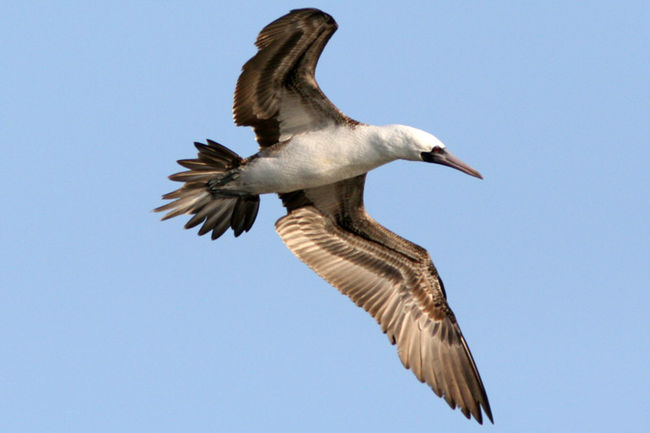
Wikipedia: Peruvian booby
![]() The Peruvian booby (Sula variegata) is an endemic bird of the Peruvian current, and an important predator of the marine community to which it belongs.[3] Its distribution is much less widespread than other closely related booby species. It is the most abundant seabird species that inhabits the Peruvian coast[4] and the second most important guano-producing seabird. During the mid-twentieth century, the Peruvian booby population reached 3 million birds.[5]
[more]
The Peruvian booby (Sula variegata) is an endemic bird of the Peruvian current, and an important predator of the marine community to which it belongs.[3] Its distribution is much less widespread than other closely related booby species. It is the most abundant seabird species that inhabits the Peruvian coast[4] and the second most important guano-producing seabird. During the mid-twentieth century, the Peruvian booby population reached 3 million birds.[5]
[more]
Familie Threskiornithidae:
Gattung Plegadis:
Plegadis falcinellus / Glossy ibis (Plegadis falcinellus)
Profil Wikipedia Vogelwarte BirdLife ZH Audubon Xeno-Canto BirdID NABU

Wikipedia: Glossy ibis
Dieser Vogel erscheint jenseits grossen Meere in Kontinenten :
Europa, Nordamerika, Südamerika, Afrika.
![]() The glossy ibis (Plegadis falcinellus) is a water bird in the order Pelecaniformes and the ibis and spoonbill family Threskiornithidae. The scientific name derives from Ancient Greek plegados and Latin, falcis, both meaning "sickle" and referring to the distinctive shape of the bill.[2]
[more]
The glossy ibis (Plegadis falcinellus) is a water bird in the order Pelecaniformes and the ibis and spoonbill family Threskiornithidae. The scientific name derives from Ancient Greek plegados and Latin, falcis, both meaning "sickle" and referring to the distinctive shape of the bill.[2]
[more]
Vokalisierung: ![]() Generally silent away from breeding ground. Dry, crow-like "garr garr", may be heard occasionally in flight. At breeding ground various guttural grunts, and piping, hissing sounds. [Link]
Generally silent away from breeding ground. Dry, crow-like "garr garr", may be heard occasionally in flight. At breeding ground various guttural grunts, and piping, hissing sounds. [Link]
Körperlich: Länge=55-65 cm,
Flügelspanne=80-95 cm,
Gewicht=530-768 g
Brillensichler / White-faced ibis (Plegadis chihi)
Profil Wikipedia Audubon Xeno-Canto
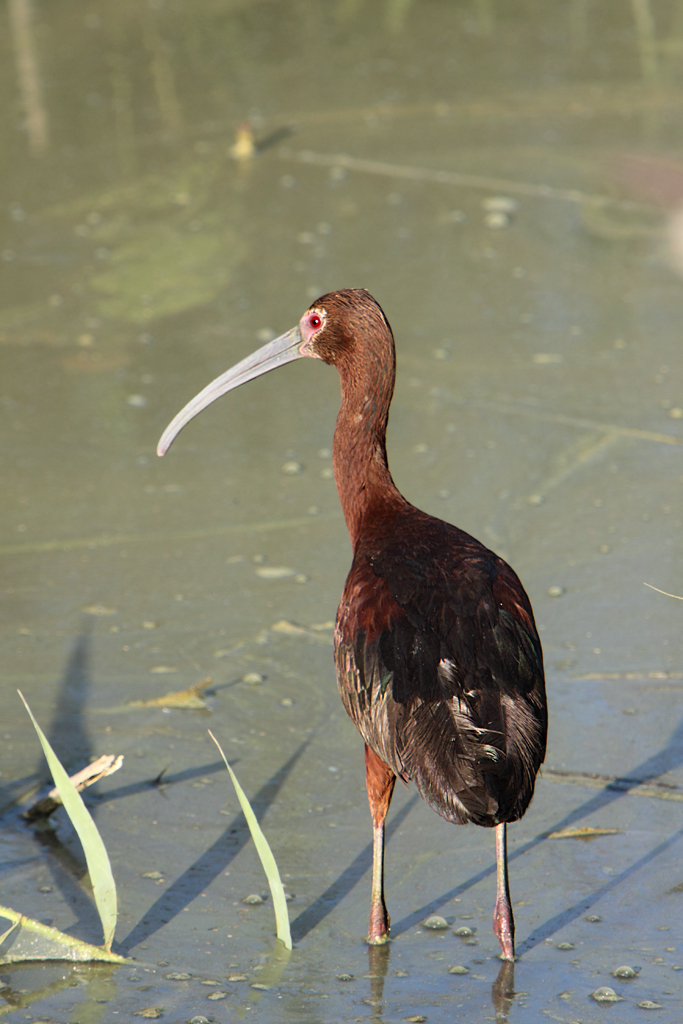
Wikipedia: White-faced ibis
Allgemein: ![]() The white-faced ibis (Plegadis chihi) is a wading bird in the ibis family, Threskiornithidae.
[more]
The white-faced ibis (Plegadis chihi) is a wading bird in the ibis family, Threskiornithidae.
[more]
Gattung Platalea:
Rosalöffler / Roseate spoonbill (Platalea ajaja)

Wikipedia: Roseate spoonbill
![]() The roseate spoonbill (Platalea ajaja) is a gregarious wading bird of the ibis and spoonbill family, Threskiornithidae. It is a resident breeder in South America mostly east of the Andes, and in coastal regions of the Caribbean, Central America, Mexico, the Gulf Coast of the United States,[2][3] and from central Florida's Atlantic coast[4] at Merritt Island National Wildlife Refuge, adjoined with NASA Kennedy Space Center at least as far north as South Carolina's Myrtle Beach.[5]
[more]
The roseate spoonbill (Platalea ajaja) is a gregarious wading bird of the ibis and spoonbill family, Threskiornithidae. It is a resident breeder in South America mostly east of the Andes, and in coastal regions of the Caribbean, Central America, Mexico, the Gulf Coast of the United States,[2][3] and from central Florida's Atlantic coast[4] at Merritt Island National Wildlife Refuge, adjoined with NASA Kennedy Space Center at least as far north as South Carolina's Myrtle Beach.[5]
[more]
Gattung Mesembrinibis:
Grünibis / Green ibis (Mesembrinibis cayennensis)
Profil Wikipedia Xeno-Canto

Wikipedia: Green ibis
![]() The green ibis (Mesembrinibis cayennensis), also known as the Cayenne ibis, is a wading bird in the ibis family Threskiornithidae. It is the only member of the genus Mesembrinibis.
[more]
The green ibis (Mesembrinibis cayennensis), also known as the Cayenne ibis, is a wading bird in the ibis family Threskiornithidae. It is the only member of the genus Mesembrinibis.
[more]
Ordnung Passeriformes (Singvögel / Passerine):
Unterordnung Passeri (Sperlingsvögel):
Überfamilie Sylvioidea:
Familie Hirundinidae (Schwalben / Swallows):
Profil Wikipedia Vogelwarte BirdLife ZH Audubon Xeno-Canto BirdID NABU
Rauchschwalben schenkel farm, farbe betont für ID. 2020-04-16 10.09.16 null
Dieser Vogel erscheint jenseits grossen Meere in Kontinenten :
Europa, Nordamerika, Südamerika, Afrika.
Seen every evening from spring to fall, need good picture.
Etymologie: ![]() In früheren Jahrhunderten flogen sie vielfach durch die Öffnungen im Giebel ein und aus, durch die auch der Rauch des Herdfeuers abzog. So erhielten sie den Namen Rauchschwalben. [Link]
In früheren Jahrhunderten flogen sie vielfach durch die Öffnungen im Giebel ein und aus, durch die auch der Rauch des Herdfeuers abzog. So erhielten sie den Namen Rauchschwalben. [Link]
Gesang: ![]() Characteristic calls and song. Song a sparkling, squeaky energetic improvisation with interspersed contact calls, often with diagnostic ending; an electric and drawn-out "su-eerrrrrrrrrrrrrrr". [Link]
Characteristic calls and song. Song a sparkling, squeaky energetic improvisation with interspersed contact calls, often with diagnostic ending; an electric and drawn-out "su-eerrrrrrrrrrrrrrr". [Link]
Rufe: ![]() Contact call a short and sharp "weet" or "kee-weet". [Link]
Contact call a short and sharp "weet" or "kee-weet". [Link]
Körperlich: Länge=17-19 cm,
Flügelspanne=32-34 cm,
Gewicht=16-22 g
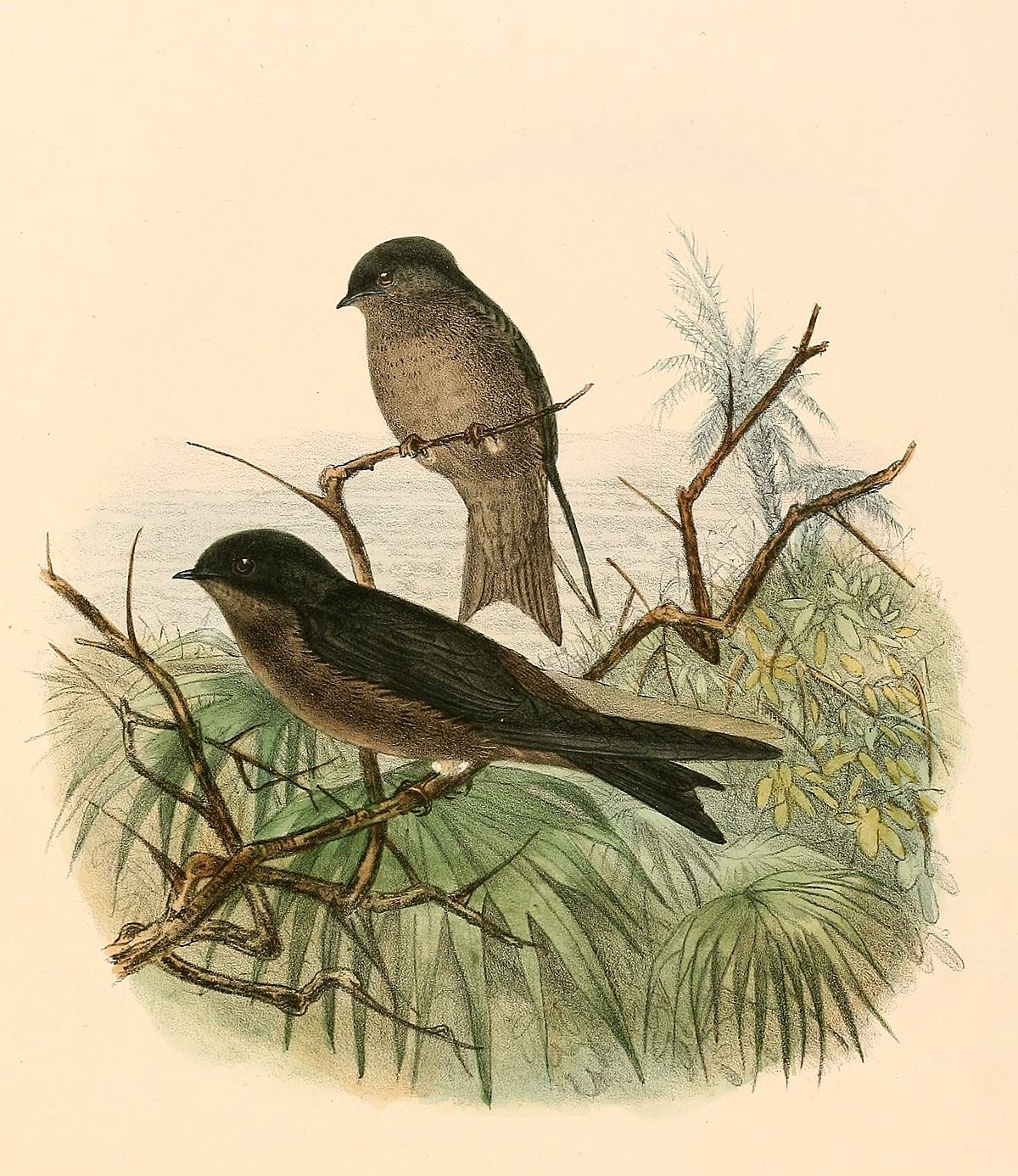
Wikipedia: White-thighed swallow
Allgemein: ![]() The white-thighed swallow (Neochelidon tibialis) is a species of bird in the family Hirundinidae. Its genus, Neochelidon, is monotypic.
[more]
The white-thighed swallow (Neochelidon tibialis) is a species of bird in the family Hirundinidae. Its genus, Neochelidon, is monotypic.
[more]
Tree swallow, Cromwell Valley Park, Maryland. 2021-06-14 15.15.38 null
![]() The tree swallow (Tachycineta bicolor) is a migratory bird of the family Hirundinidae. Found in the Americas, the tree swallow was first described in 1807 by French ornithologist Louis Vieillot as Hirundo bicolor. It has since been moved to its current genus, Tachycineta, within which its phylogenetic placement is debated. The tree swallow has glossy blue-green upperparts, with the exception of the blackish wings and tail, and white underparts. The bill is black, the eyes dark brown, and the legs and feet pale brown. The female is generally duller than the male, and the first-year female has mostly brown upperparts, with some blue feathers. Juveniles have brown upperparts, and a grey-brown-washed breast. The tree swallow breeds in the US and Canada. It winters along southern US coasts south, along the Gulf Coast, to Panama and the northwestern coast of South America, and in the West Indies.
[more]
The tree swallow (Tachycineta bicolor) is a migratory bird of the family Hirundinidae. Found in the Americas, the tree swallow was first described in 1807 by French ornithologist Louis Vieillot as Hirundo bicolor. It has since been moved to its current genus, Tachycineta, within which its phylogenetic placement is debated. The tree swallow has glossy blue-green upperparts, with the exception of the blackish wings and tail, and white underparts. The bill is black, the eyes dark brown, and the legs and feet pale brown. The female is generally duller than the male, and the first-year female has mostly brown upperparts, with some blue feathers. Juveniles have brown upperparts, and a grey-brown-washed breast. The tree swallow breeds in the US and Canada. It winters along southern US coasts south, along the Gulf Coast, to Panama and the northwestern coast of South America, and in the West Indies.
[more]
Profil Wikipedia Audubon Xeno-Canto

Wikipedia: Violet-green swallow
![]() The violet-green swallow (Tachycineta thalassina) is a small North American passerine bird in the swallow family. These aerial insectivores are distributed along the west coast from Alaska to Mexico, extending as far east as Montana and Texas. With an appearance very similar to the tree swallow, these individuals can be identified by the white rump side-patches that appear to separate their green back and purple tail. Violet-green swallows are secondary cavity nesters, found in a number of habitats including deciduous and coniferous forest. In addition to nesting in tree holes within these habitats, they are also widely observed nesting in the cracks of large cliffs.[2]
[more]
The violet-green swallow (Tachycineta thalassina) is a small North American passerine bird in the swallow family. These aerial insectivores are distributed along the west coast from Alaska to Mexico, extending as far east as Montana and Texas. With an appearance very similar to the tree swallow, these individuals can be identified by the white rump side-patches that appear to separate their green back and purple tail. Violet-green swallows are secondary cavity nesters, found in a number of habitats including deciduous and coniferous forest. In addition to nesting in tree holes within these habitats, they are also widely observed nesting in the cracks of large cliffs.[2]
[more]
Profil Wikipedia Xeno-Canto

Wikipedia: Mangrove swallow
![]() The mangrove swallow (Tachycineta albilinea) is a passerine bird in the swallow family that breeds in coastal regions from Mexico through Central America to Panama. It has blue-green upperparts, blackish flight feathers, a white rump, a black tail, and white underparts. It can be identified by the supraloral white streak, the white line near its eye, which only occurs in two other species of Tachycineta: the violet-green swallow and the white-rumped swallow. The sexes, although similar in plumage, differ slightly in size. The juveniles have grey-brown upperparts and white-washed underparts. This swallow's song is generally described as a soft trilling, with a rolled jeerrt call, and a sharp alarm note.
[more]
The mangrove swallow (Tachycineta albilinea) is a passerine bird in the swallow family that breeds in coastal regions from Mexico through Central America to Panama. It has blue-green upperparts, blackish flight feathers, a white rump, a black tail, and white underparts. It can be identified by the supraloral white streak, the white line near its eye, which only occurs in two other species of Tachycineta: the violet-green swallow and the white-rumped swallow. The sexes, although similar in plumage, differ slightly in size. The juveniles have grey-brown upperparts and white-washed underparts. This swallow's song is generally described as a soft trilling, with a rolled jeerrt call, and a sharp alarm note.
[more]
Profil Wikipedia Audubon Xeno-Canto
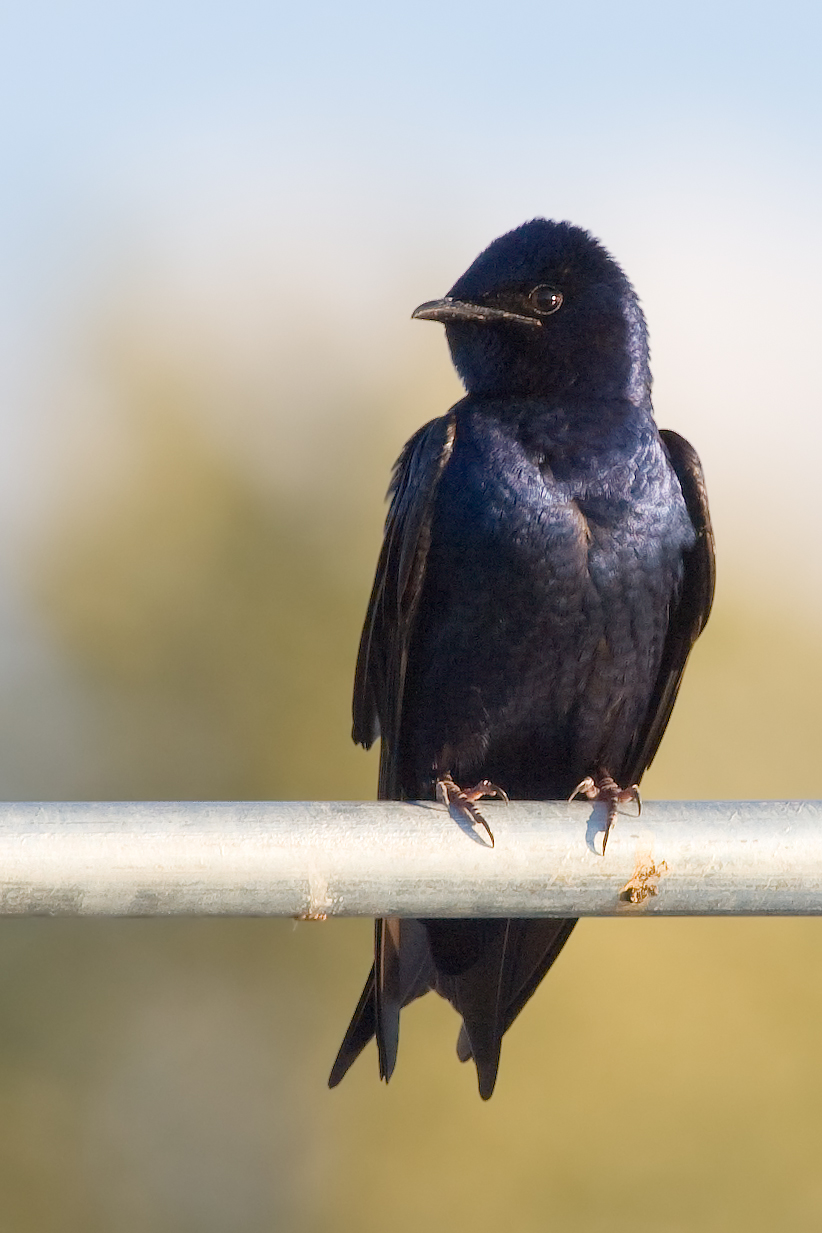
Wikipedia: Purple martin
![]() The purple martin (Progne subis) is the largest swallow in North America. Despite their name, purple martins are not truly purple. Their dark blackish-blue feathers have an iridescent sheen caused by the refraction of incident light[2] giving them a bright blue to navy blue or deep purple appearance. In some light they may even appear green in color.
[more]
The purple martin (Progne subis) is the largest swallow in North America. Despite their name, purple martins are not truly purple. Their dark blackish-blue feathers have an iridescent sheen caused by the refraction of incident light[2] giving them a bright blue to navy blue or deep purple appearance. In some light they may even appear green in color.
[more]
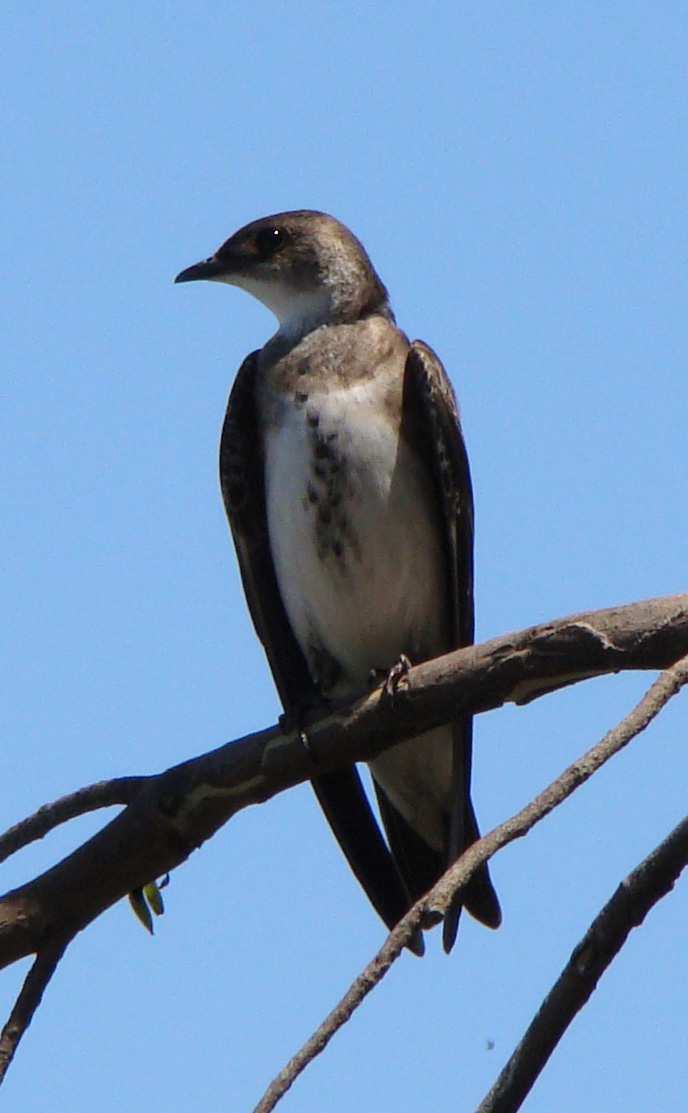
Wikipedia: Brown-chested martin
![]() The brown-chested martin (Progne tapera) is a species of passerine bird in the swallow family.
[more]
The brown-chested martin (Progne tapera) is a species of passerine bird in the swallow family.
[more]
Profil Wikipedia Xeno-Canto
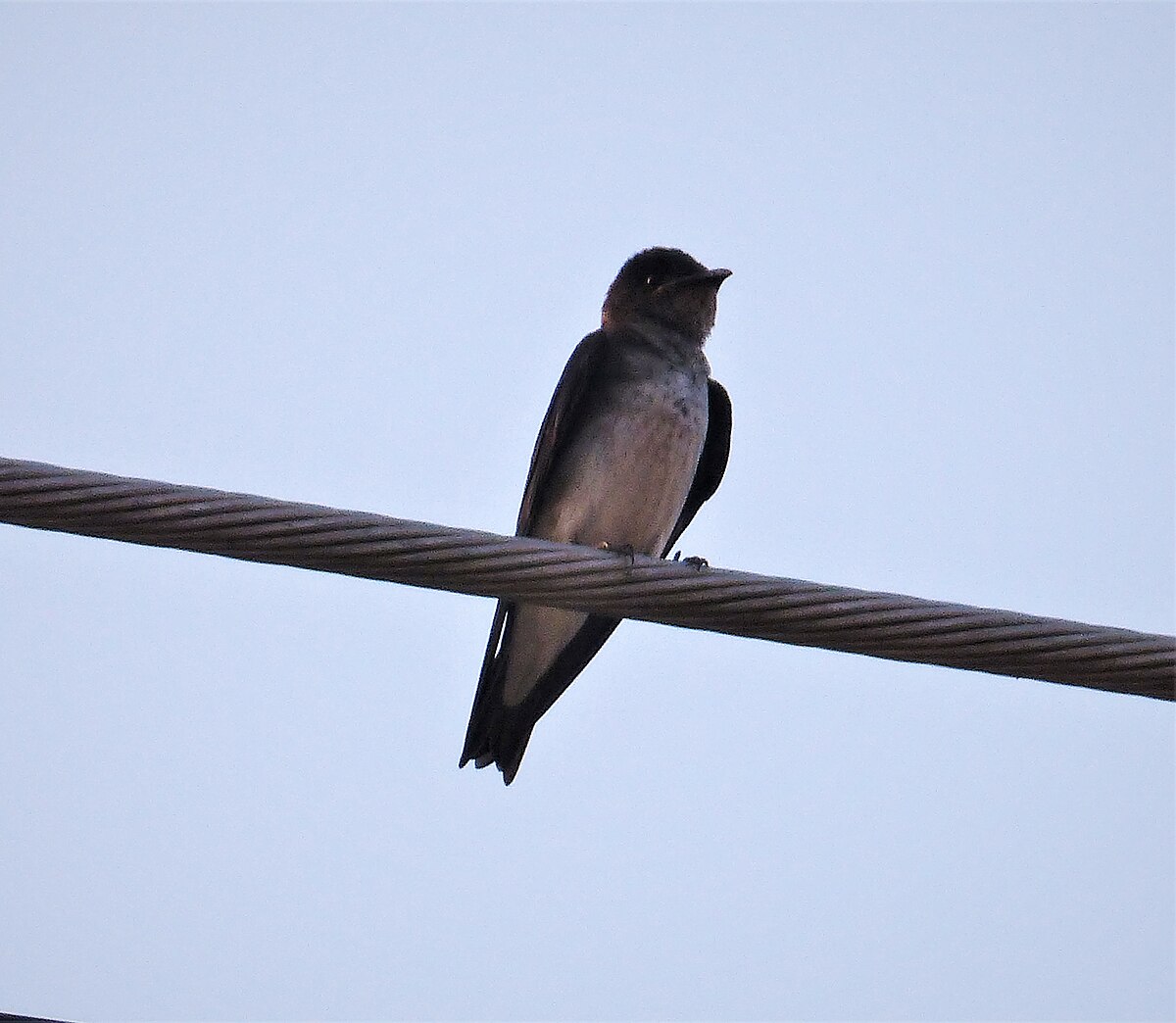
Wikipedia: Gray-breasted martin
![]() The grey-breasted martin (Progne chalybea) is a large swallow from Central and South America.
[more]
The grey-breasted martin (Progne chalybea) is a large swallow from Central and South America.
[more]
Profil Wikipedia Audubon Xeno-Canto
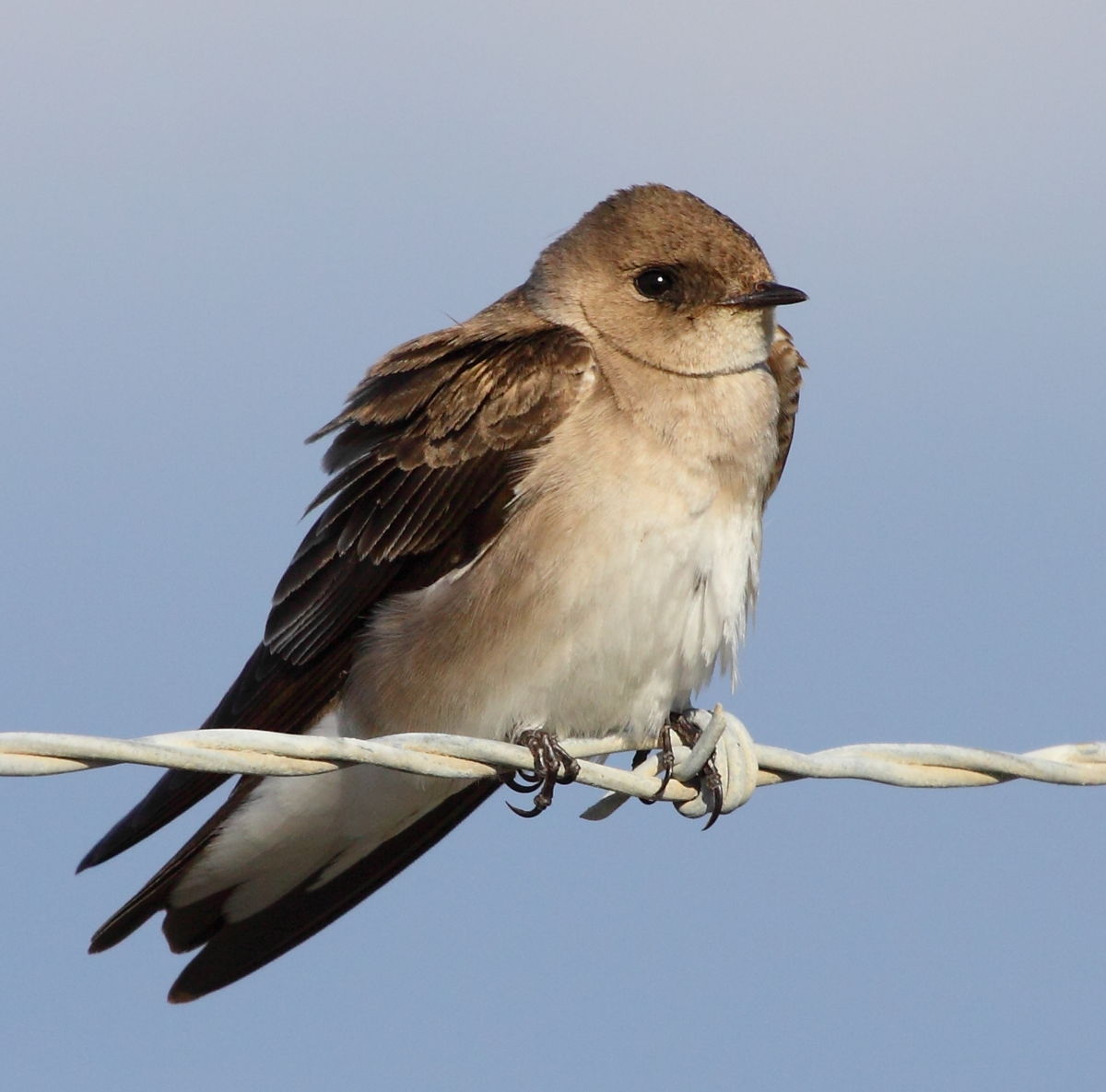
Wikipedia: Northern rough-winged swallow
![]() The northern rough-winged swallow (Stelgidopteryx serripennis) is a small, migratory swallow. It is very similar to the southern rough-winged swallow, Stelgidopteryx ruficollis.
[more]
The northern rough-winged swallow (Stelgidopteryx serripennis) is a small, migratory swallow. It is very similar to the southern rough-winged swallow, Stelgidopteryx ruficollis.
[more]
Profil Wikipedia Xeno-Canto
Arenal hike southern rough-winged swallow tentative ID by Merlin. 2018-02-28 10.47.32 null
![]() The southern rough-winged swallow (Stelgidopteryx ruficollis) is a small swallow. It was first formally described as Hirundo ruficollis by French ornithologist Louis Vieillot in 1817 in his Nouveau Dictionnaire d'Histoire Naturelle.[2]
[more]
The southern rough-winged swallow (Stelgidopteryx ruficollis) is a small swallow. It was first formally described as Hirundo ruficollis by French ornithologist Louis Vieillot in 1817 in his Nouveau Dictionnaire d'Histoire Naturelle.[2]
[more]

Wikipedia: Bank swallow
Dieser Vogel erscheint jenseits grossen Meere in Kontinenten :
Europa, Nordamerika, Südamerika, Afrika.
![]() The sand martin (Riparia riparia) or European sand martin, bank swallow, and collared sand martin in India, is a migratory passerine bird in the swallow family. It has a wide range in summer, embracing practically the whole of Europe and the Mediterranean countries and across the Palearctic to the Pacific Ocean. It is a Holarctic species also found in North America. It winters in eastern and southern Africa, South America, and the Indian Subcontinent.
[more]
The sand martin (Riparia riparia) or European sand martin, bank swallow, and collared sand martin in India, is a migratory passerine bird in the swallow family. It has a wide range in summer, embracing practically the whole of Europe and the Mediterranean countries and across the Palearctic to the Pacific Ocean. It is a Holarctic species also found in North America. It winters in eastern and southern Africa, South America, and the Indian Subcontinent.
[more]
Gesang: ![]() Song a primitive improvisation on the contact call. [Link]
Song a primitive improvisation on the contact call. [Link]
Rufe: ![]() Contact call a mono- or disyllabic "trrrrt". Similar to House Martin but more raucous and less crisp, with less rolling r's, and with stable pitch throughout. Alarm call similar to House Martin; a sharp plaintive "tseep", but somewhat purer and more drawn. [Link]
Contact call a mono- or disyllabic "trrrrt". Similar to House Martin but more raucous and less crisp, with less rolling r's, and with stable pitch throughout. Alarm call similar to House Martin; a sharp plaintive "tseep", but somewhat purer and more drawn. [Link]
Körperlich: Länge=12 cm,
Flügelspanne=26-29 cm,
Gewicht=11-16 g

Wikipedia: Cliff swallow
Dieser Vogel erscheint jenseits grossen Meere in Kontinenten :
Europa, Nordamerika, Südamerika.
Allgemein: ![]() The cliff swallow or American cliff swallow (Petrochelidon pyrrhonota) is a member of the passerine bird family Hirundinidae, the swallows and martins.[2] The scientific name is derived from Ancient Greek; Petrochelidon originates from the petros meaning "rock" and khelidon "swallow", pyrrhonota comes from purrhos meaning "flame-coloured" and -notos "-backed".[3]
[more]
The cliff swallow or American cliff swallow (Petrochelidon pyrrhonota) is a member of the passerine bird family Hirundinidae, the swallows and martins.[2] The scientific name is derived from Ancient Greek; Petrochelidon originates from the petros meaning "rock" and khelidon "swallow", pyrrhonota comes from purrhos meaning "flame-coloured" and -notos "-backed".[3]
[more]
Profil Wikipedia Xeno-Canto

Wikipedia: Blue-and-white swallow
![]() The blue-and-white swallow (Notiochelidon cyanoleuca) is a passerine bird that breeds from Nicaragua south throughout South America, except in the deserts and the Amazon Basin. The southern race is migratory, wintering as far north as Trinidad, where it is a regular visitor. The nominate northern race may have bred on that island.[2]
[more]
The blue-and-white swallow (Notiochelidon cyanoleuca) is a passerine bird that breeds from Nicaragua south throughout South America, except in the deserts and the Amazon Basin. The southern race is migratory, wintering as far north as Trinidad, where it is a regular visitor. The nominate northern race may have bred on that island.[2]
[more]
Überfamilie Passeroidea:
Familie Passeridae (Sperlinge / Sparrows):
Profil Wikipedia Vogelwarte BirdLife ZH Audubon Xeno-Canto BirdID NABU
Pair of house sparrows in a tree near Zürichstrasse, Fehraltorf 2020-04-11 07.54.30 null
Dieser Vogel erscheint jenseits grossen Meere in Kontinenten :
Europa, Nordamerika (introduced), Südamerika, Afrika.
Einer der meistverbreitete Vögel überall in Europa und Nordamerika.
In Fehraltorf gibt's 5 Haussperlinge für jeden Feldsperling.
Praktisch überall. Oft auf dem Boden oder auf deinem Tisch im Cafe,
auch in Gruppen in Büschen und Hecken.
Gesang: ![]() Song a primitive, monosyllabic, or slightly disyllabic "chilp", hard to distinguish from Tree Sparrow. [Link]
Song a primitive, monosyllabic, or slightly disyllabic "chilp", hard to distinguish from Tree Sparrow. [Link]
Rufe: ![]() Most calls very similar to Tree Sparrow, but lacks said species' distinct high pitched call (chew-itt), and alarm call is less dry and raucous. [Link]
Most calls very similar to Tree Sparrow, but lacks said species' distinct high pitched call (chew-itt), and alarm call is less dry and raucous. [Link]
Körperlich: Länge=14-15 cm,
Flügelspanne=21-25 cm,
Gewicht=24-38 g
Gesang:
Monotones Zirpen. Hauptsächlich 2-5 KHz mit Übertönen.
Gesang Eigenschaften:
Melody: simple rhythmic, slow, Frequency: 2-5 KHz Singing season: 01-01 - 08-31 Dawn chorus start, 30 minutes before dawn.
Familie Fringillidae (Finken):

Wikipedia: Lesser goldfinch
Allgemein: ![]() The lesser goldfinch (Spinus psaltria) is a very small songbird of the Americas. Together with its relatives the American goldfinch and Lawrence's goldfinch, it forms the American goldfinches clade in the genus Spinus sensu stricto.
[more]
The lesser goldfinch (Spinus psaltria) is a very small songbird of the Americas. Together with its relatives the American goldfinch and Lawrence's goldfinch, it forms the American goldfinches clade in the genus Spinus sensu stricto.
[more]
Profil Wikipedia Xeno-Canto

Wikipedia: Yellow-bellied siskin
![]() The yellow-bellied siskin (Spinus xanthogastrus) is a small passerine bird in the finch family Fringillidae. It breeds from Costa Rica south to southern Ecuador, central Bolivia and the highlands of northwestern Venezuela.
[more]
The yellow-bellied siskin (Spinus xanthogastrus) is a small passerine bird in the finch family Fringillidae. It breeds from Costa Rica south to southern Ecuador, central Bolivia and the highlands of northwestern Venezuela.
[more]

Wikipedia: Yellow-bellied siskin
![]() The yellow-bellied siskin (Spinus xanthogastrus) is a small passerine bird in the finch family Fringillidae. It breeds from Costa Rica south to southern Ecuador, central Bolivia and the highlands of northwestern Venezuela.
[more]
The yellow-bellied siskin (Spinus xanthogastrus) is a small passerine bird in the finch family Fringillidae. It breeds from Costa Rica south to southern Ecuador, central Bolivia and the highlands of northwestern Venezuela.
[more]
Profil Wikipedia Xeno-Canto
Red-legged honeycreeper. 2020-02-21 07.42.10 null
We saw this on the grounds of Gamboa Rainforest Resort, a hotel at the old U.S. administrative center for the Panama Canal. You can spend hours watching birds and wildlife just around the hotel.
Allgemein: ![]() Der Türkisnaschvogel, auch Rotfußhonigsauger (Cyanerpes cyaneus) genannt, ist eine kleine Vogelart aus der Familie der Tangaren (Thraupidae).
[more]
Der Türkisnaschvogel, auch Rotfußhonigsauger (Cyanerpes cyaneus) genannt, ist eine kleine Vogelart aus der Familie der Tangaren (Thraupidae).
[more]
Profil Wikipedia Xeno-Canto
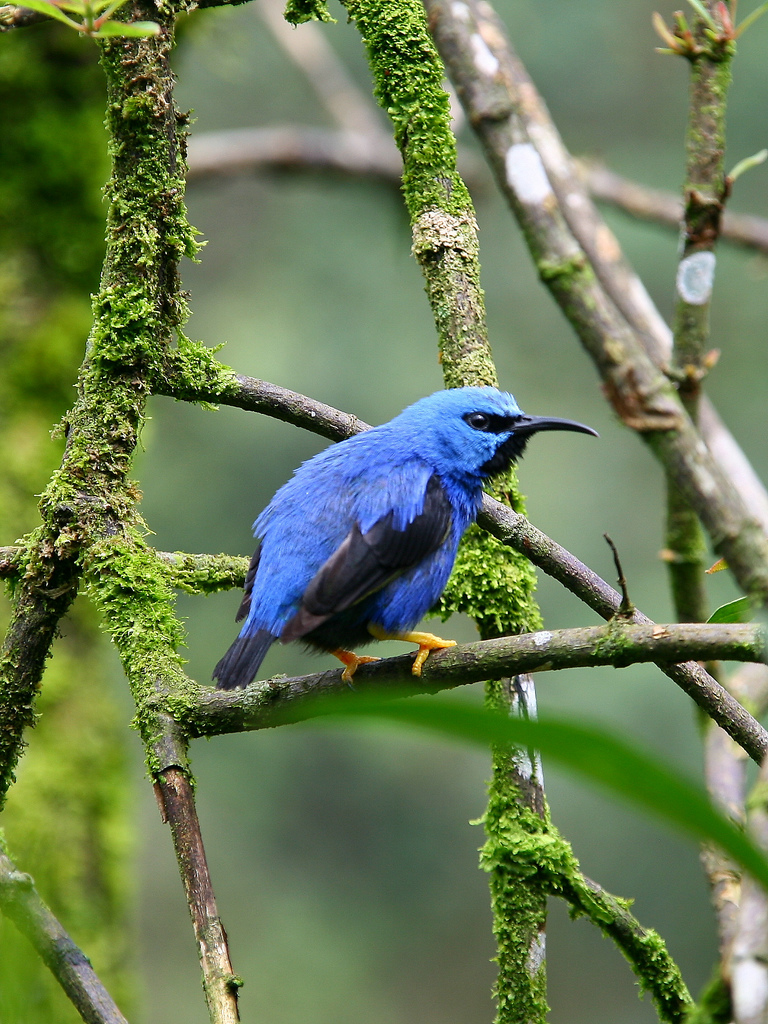
Wikipedia: Shining honeycreeper
![]() The shining honeycreeper (Cyanerpes lucidus) is a small bird in the tanager family. It is found in the tropical New World in Central America from southern Mexico to Panama and northwest Colombia. It is sometimes considered to be conspecific with the purple honeycreeper (C. caeruleus), but the two species breed sympatrically in eastern Panama and northwest Colombia.
[more]
The shining honeycreeper (Cyanerpes lucidus) is a small bird in the tanager family. It is found in the tropical New World in Central America from southern Mexico to Panama and northwest Colombia. It is sometimes considered to be conspecific with the purple honeycreeper (C. caeruleus), but the two species breed sympatrically in eastern Panama and northwest Colombia.
[more]
Profil Wikipedia Xeno-Canto
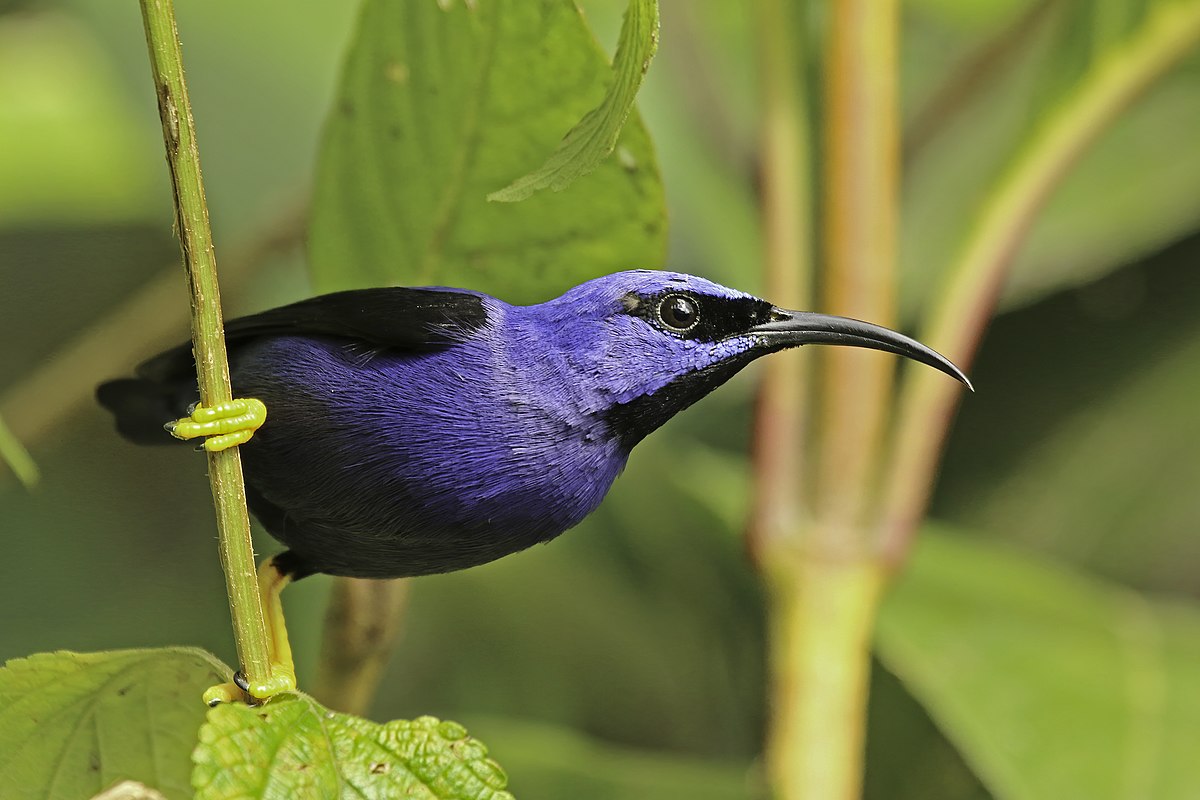
Wikipedia: Purple honeycreeper
![]() The purple honeycreeper (Cyanerpes caeruleus) is a small Neotropical bird in the tanager family Thraupidae. It is found in the tropical New World from Colombia and Venezuela south to Brazil, and on Trinidad. A few, possibly introduced birds have been recorded on Tobago.
[more]
The purple honeycreeper (Cyanerpes caeruleus) is a small Neotropical bird in the tanager family Thraupidae. It is found in the tropical New World from Colombia and Venezuela south to Brazil, and on Trinidad. A few, possibly introduced birds have been recorded on Tobago.
[more]
Profil Wikipedia Xeno-Canto
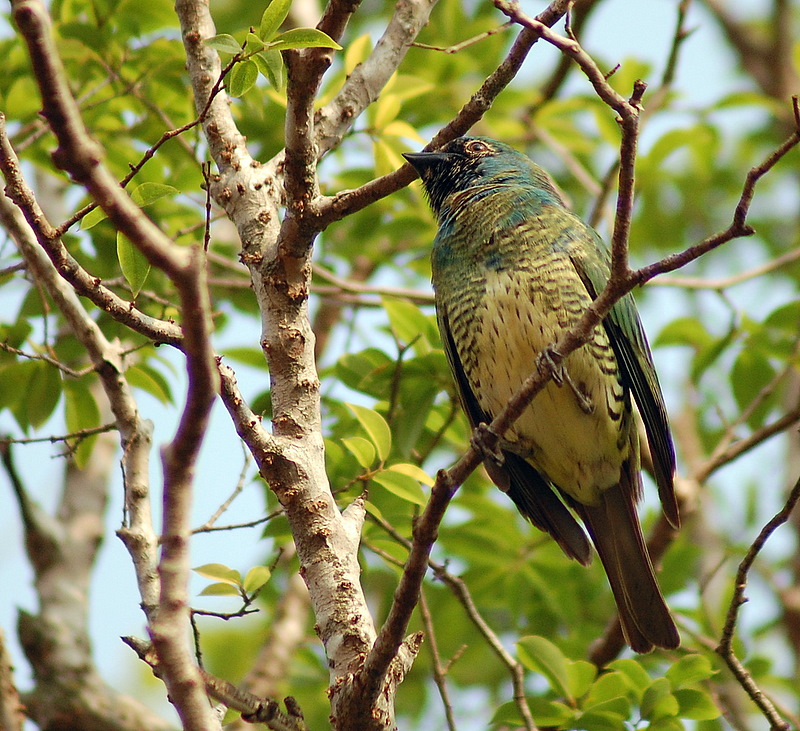
Wikipedia: Swallow tanager
![]() The swallow tanager (Tersina viridis) is a species of Neotropic bird in the tanager family Thraupidae. It is the only member of the genus Tersina. It is found widely throughout South America, from eastern Panama to far northern Argentina. The species is sexually dimorphic: the female is a yellow-green and the male a turquoise blue with a small deep black face and upper throat patch.
[more]
The swallow tanager (Tersina viridis) is a species of Neotropic bird in the tanager family Thraupidae. It is the only member of the genus Tersina. It is found widely throughout South America, from eastern Panama to far northern Argentina. The species is sexually dimorphic: the female is a yellow-green and the male a turquoise blue with a small deep black face and upper throat patch.
[more]
Profil Wikipedia Audubon Xeno-Canto
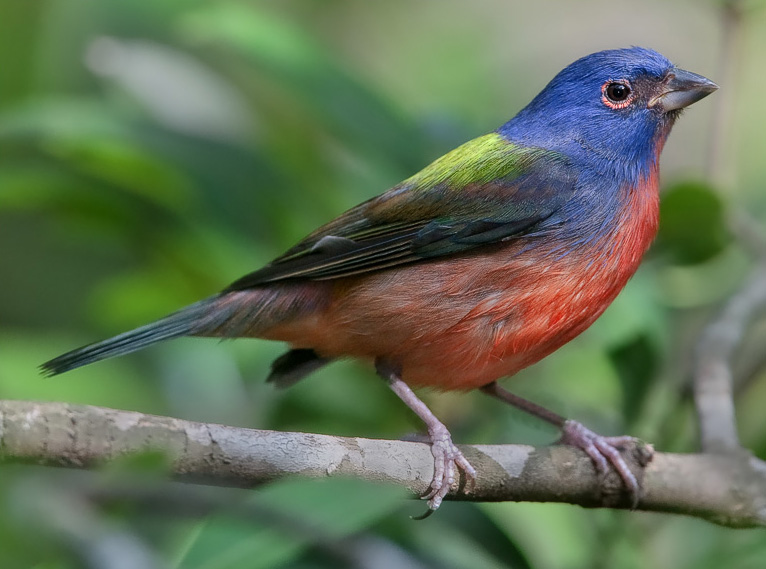
Wikipedia: Painted bunting
![]() The painted bunting (Passerina ciris) is a species of bird in the cardinal family, Cardinalidae, that is native to North America. The bright plumage of the male only comes in the second year of life; in the first year they can only be distinguished from the female by close inspection.
[more]
The painted bunting (Passerina ciris) is a species of bird in the cardinal family, Cardinalidae, that is native to North America. The bright plumage of the male only comes in the second year of life; in the first year they can only be distinguished from the female by close inspection.
[more]

Wikipedia: Blue grosbeak
![]() The blue grosbeak (Passerina caerulea), is a medium-sized North American passerine bird in the cardinal family Cardinalidae. It is mainly migratory, wintering in Central America and breeding in northern Mexico and the southern United States. The male is blue with two brown wing bars. The female is mainly brown with scattered blue feathers on the upperparts and two brown wing bars.
[more]
The blue grosbeak (Passerina caerulea), is a medium-sized North American passerine bird in the cardinal family Cardinalidae. It is mainly migratory, wintering in Central America and breeding in northern Mexico and the southern United States. The male is blue with two brown wing bars. The female is mainly brown with scattered blue feathers on the upperparts and two brown wing bars.
[more]
Profil Wikipedia Audubon Xeno-Canto
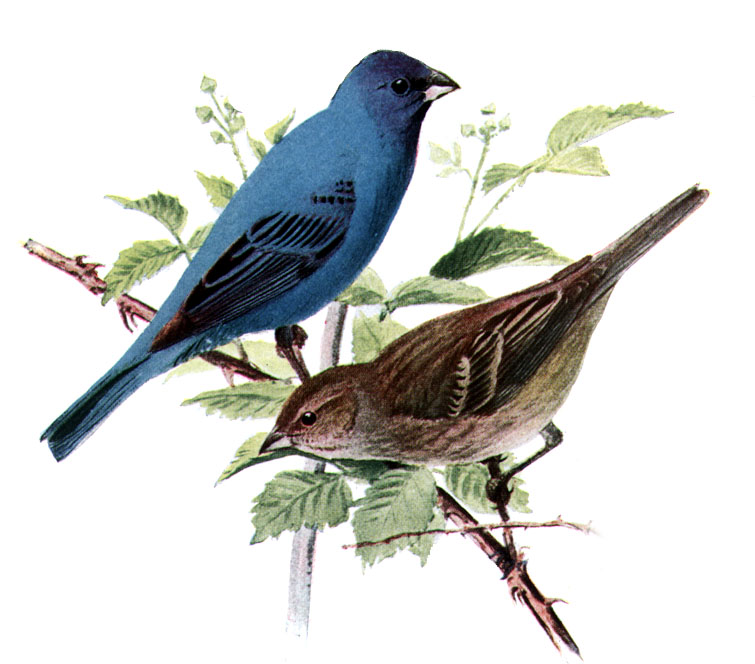
Wikipedia: Indigo bunting
![]() The indigo bunting (Passerina cyanea) is a small seed-eating bird in the cardinal family, Cardinalidae. It is migratory, ranging from southern Canada to northern Florida during the breeding season, and from southern Florida to northern South America during the winter.[2] It often migrates by night, using the stars to navigate.[3] Its habitat is farmland, brush areas, and open woodland.[4] The indigo bunting is closely related to the lazuli bunting and interbreeds with the species where their ranges overlap.
[more]
The indigo bunting (Passerina cyanea) is a small seed-eating bird in the cardinal family, Cardinalidae. It is migratory, ranging from southern Canada to northern Florida during the breeding season, and from southern Florida to northern South America during the winter.[2] It often migrates by night, using the stars to navigate.[3] Its habitat is farmland, brush areas, and open woodland.[4] The indigo bunting is closely related to the lazuli bunting and interbreeds with the species where their ranges overlap.
[more]
Profil Wikipedia Audubon Xeno-Canto
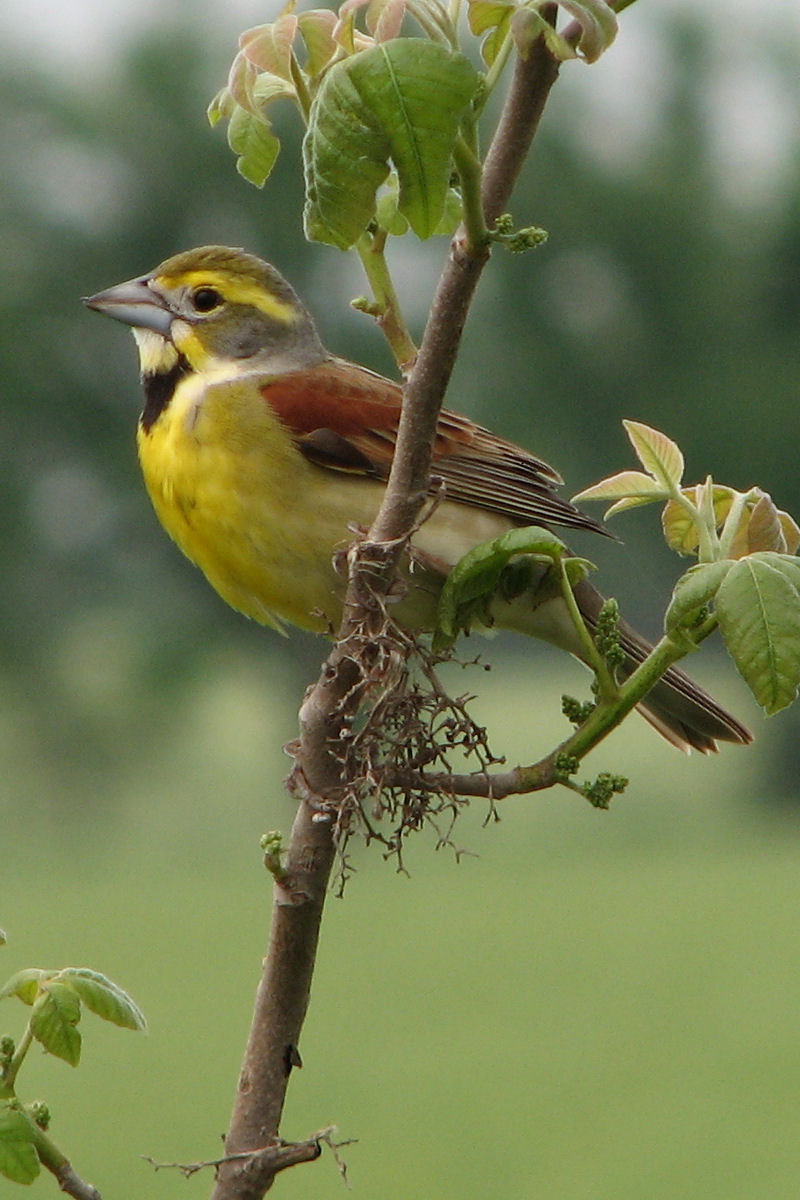
Wikipedia: Dickcissel
![]() Emberiza townsendi
Emberiza townsendi
Emberiza townsendii (lapsus)
Spiza townsendi
Spiza townsendii (lapsus)
(see text)
[more]
Profil Wikipedia Audubon Xeno-Canto
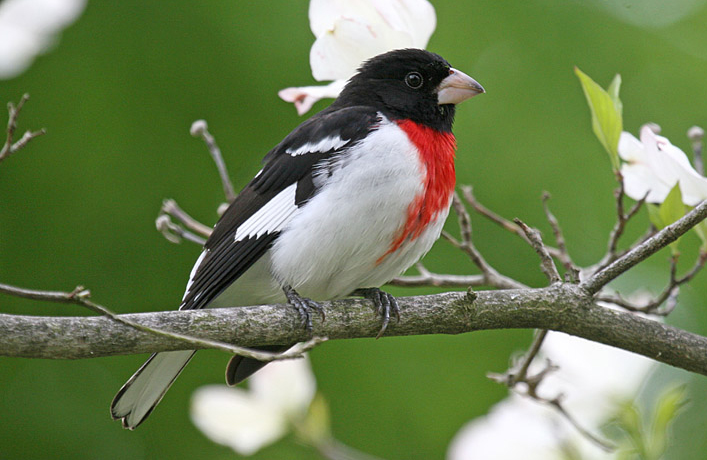
Wikipedia: Rose-breasted grosbeak
![]() The rose-breasted grosbeak (Pheucticus ludovicianus) is a large, seed-eating grosbeak in the cardinal family (Cardinalidae). It is primarily a foliage gleaner.[2] Males have black heads, wings, backs, and tails, and a bright rose colored patch on their white breast. Males and females exhibit marked sexual dimorphism.
[more]
The rose-breasted grosbeak (Pheucticus ludovicianus) is a large, seed-eating grosbeak in the cardinal family (Cardinalidae). It is primarily a foliage gleaner.[2] Males have black heads, wings, backs, and tails, and a bright rose colored patch on their white breast. Males and females exhibit marked sexual dimorphism.
[more]
Profil Wikipedia Xeno-Canto

Wikipedia: Black-thighed grosbeak
![]() The black-thighed grosbeak (Pheucticus tibialis) is a large seed-eating bird in the cardinal family, which is endemic to the mountains of Costa Rica and western Panama.
[more]
The black-thighed grosbeak (Pheucticus tibialis) is a large seed-eating bird in the cardinal family, which is endemic to the mountains of Costa Rica and western Panama.
[more]
Profil Wikipedia Xeno-Canto

Wikipedia: Black-faced grosbeak
![]() The black-faced grosbeak (Caryothraustes poliogaster) is a large seed-eating bird in the cardinal family (Cardinalidae), which is a resident breeding species from south-eastern Mexico to eastern Panama.
[more]
The black-faced grosbeak (Caryothraustes poliogaster) is a large seed-eating bird in the cardinal family (Cardinalidae), which is a resident breeding species from south-eastern Mexico to eastern Panama.
[more]
Profil Wikipedia Xeno-Canto

Wikipedia: Yellow-green grosbeak
![]() The yellow-green grosbeak (Caryothraustes canadensis) is a species of grosbeak in the family Cardinalidae.
[more]
The yellow-green grosbeak (Caryothraustes canadensis) is a species of grosbeak in the family Cardinalidae.
[more]

Wikipedia: Blue-black grosbeak
![]() The blue-black grosbeak (Cyanoloxia cyanoides) is a species of songbird in the family Cardinalidae.
[more]
The blue-black grosbeak (Cyanoloxia cyanoides) is a species of songbird in the family Cardinalidae.
[more]
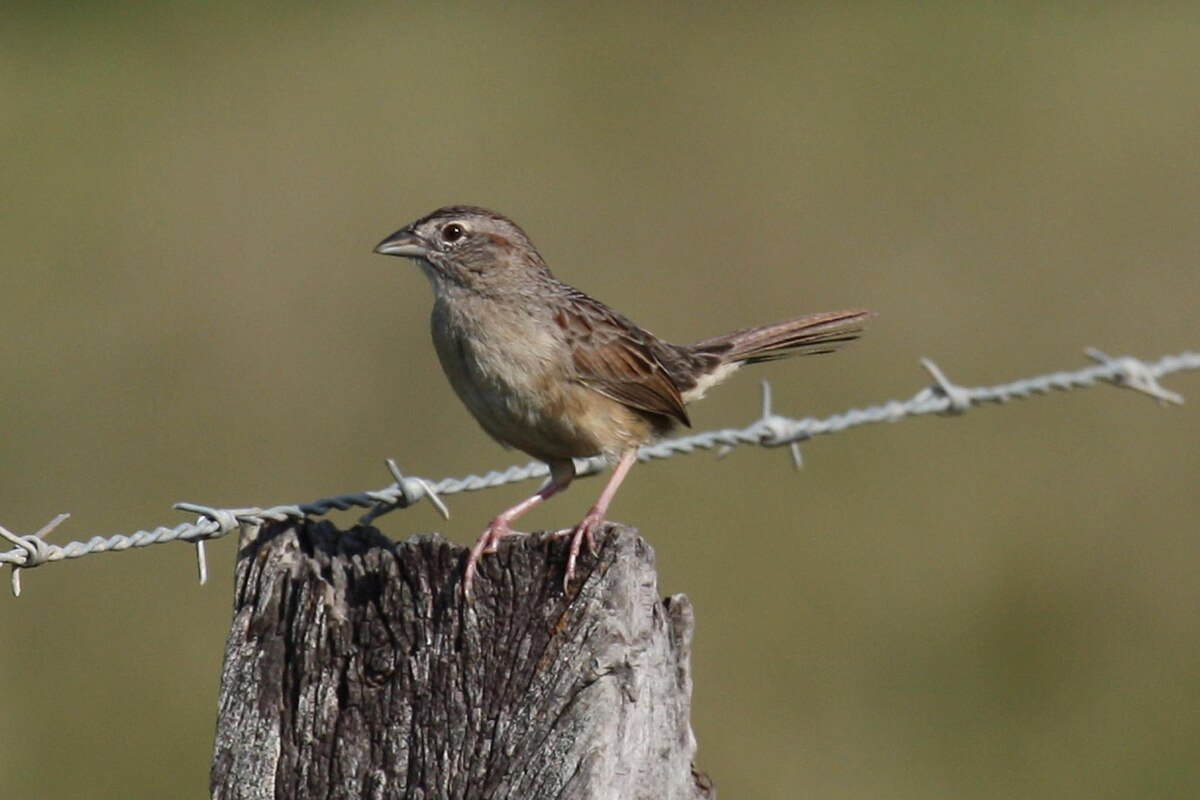
Wikipedia: Botteri's sparrow
![]() Botteri's sparrow (Peucaea botterii) is a medium-sized sparrow.
[more]
Botteri's sparrow (Peucaea botterii) is a medium-sized sparrow.
[more]

Wikipedia: Stripe-headed sparrow
![]() The stripe-headed sparrow (Peucaea ruficauda) is an American sparrow which breeds from Pacific coastal south-western Mexico, including the transverse ranges, Cordillera Neovolcanica to Pacific coastal northern Costa Rica.
[more]
The stripe-headed sparrow (Peucaea ruficauda) is an American sparrow which breeds from Pacific coastal south-western Mexico, including the transverse ranges, Cordillera Neovolcanica to Pacific coastal northern Costa Rica.
[more]
Profil Wikipedia Xeno-Canto

Wikipedia: Golden-browed chlorophonia
![]() The golden-browed chlorophonia (Chlorophonia callophrys) is a species of bird in the family Fringillidae. It is found in Costa Rica and Panama. It is uncommon in subtropical or tropical moist montane forest above 750 m (2,460 ft) elevation.
[more]
The golden-browed chlorophonia (Chlorophonia callophrys) is a species of bird in the family Fringillidae. It is found in Costa Rica and Panama. It is uncommon in subtropical or tropical moist montane forest above 750 m (2,460 ft) elevation.
[more]
Profil Wikipedia Xeno-Canto

Wikipedia: White-vented euphonia
![]() The white-vented euphonia (Euphonia minuta) is a species of bird in the family Fringillidae.
[more]
The white-vented euphonia (Euphonia minuta) is a species of bird in the family Fringillidae.
[more]
Profil Wikipedia Xeno-Canto

Wikipedia: Thick-billed euphonia
![]() The thick-billed euphonia (Euphonia laniirostris) is a species of bird in the family Fringillidae, formerly placed in the Thraupidae.
[more]
The thick-billed euphonia (Euphonia laniirostris) is a species of bird in the family Fringillidae, formerly placed in the Thraupidae.
[more]
Profil Wikipedia Xeno-Canto
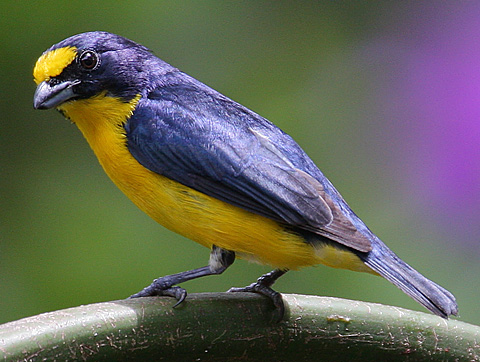
Wikipedia: Yellow-throated euphonia
![]() The yellow-throated euphonia (Euphonia hirundinacea) is a species of songbird in the family Fringillidae. It is found in southeastern Mexico and throughout Central America with its range stretching from Belize south to western Panama. It inhabits primarily both humid and dry regions where it prefers the forest edge, open woodland, and shaded plantations. It has two subspecies, the nominate subspecies Euphonia hirundinacea hirundinacea and Euphonia hirundinacea gnatho. This finch is a small bird with pointed wings and a short bill and short tail. Males of this species have dark glossy blue-black upperparts excluding a yellow forecrown, and bright yellow underparts, while females have olive green upperparts and whitish-gray breast and lower parts. It has a shrill song that alternates between high-pitched and moderately pitched and appears to be able to mimic some calls of other birds.
[more]
The yellow-throated euphonia (Euphonia hirundinacea) is a species of songbird in the family Fringillidae. It is found in southeastern Mexico and throughout Central America with its range stretching from Belize south to western Panama. It inhabits primarily both humid and dry regions where it prefers the forest edge, open woodland, and shaded plantations. It has two subspecies, the nominate subspecies Euphonia hirundinacea hirundinacea and Euphonia hirundinacea gnatho. This finch is a small bird with pointed wings and a short bill and short tail. Males of this species have dark glossy blue-black upperparts excluding a yellow forecrown, and bright yellow underparts, while females have olive green upperparts and whitish-gray breast and lower parts. It has a shrill song that alternates between high-pitched and moderately pitched and appears to be able to mimic some calls of other birds.
[more]
Profil Wikipedia Xeno-Canto

Wikipedia: Elegant euphonia
![]() The elegant or blue-hooded euphonia (Euphonia elegantissima) is a species of bird in the family Fringillidae. It is found in Belize, Costa Rica, El Salvador, Guatemala, Honduras, Mexico, Nicaragua, and Panama.
[more]
The elegant or blue-hooded euphonia (Euphonia elegantissima) is a species of bird in the family Fringillidae. It is found in Belize, Costa Rica, El Salvador, Guatemala, Honduras, Mexico, Nicaragua, and Panama.
[more]
Profil Wikipedia Xeno-Canto

Wikipedia: Tawny-capped euphonia
![]() The tawny-capped euphonia (Euphonia anneae) is a species of bird in the family Fringillidae.
It is found in Colombia, Costa Rica, and Panama.
Its natural habitats are subtropical or tropical moist lowland forest, subtropical or tropical moist montane forest, and heavily degraded former forest.
[more]
The tawny-capped euphonia (Euphonia anneae) is a species of bird in the family Fringillidae.
It is found in Colombia, Costa Rica, and Panama.
Its natural habitats are subtropical or tropical moist lowland forest, subtropical or tropical moist montane forest, and heavily degraded former forest.
[more]
Profil Wikipedia Xeno-Canto

Wikipedia: Olive-backed euphonia
![]() The olive-backed euphonia (Euphonia gouldi) is a small passerine bird in the finch family. It is a resident breeder in the Caribbean lowlands and foothills from southern Mexico to western Panama.
[more]
The olive-backed euphonia (Euphonia gouldi) is a small passerine bird in the finch family. It is a resident breeder in the Caribbean lowlands and foothills from southern Mexico to western Panama.
[more]
Profil Wikipedia Xeno-Canto

Wikipedia: Yellow-crowned euphonia
![]() The yellow-crowned euphonia (Euphonia luteicapilla) is a species of bird in the family Fringillidae. It is found in Costa Rica, Nicaragua, and Panama, and is perhaps the most common euphonia in its range.[2] Its natural habitats are subtropical or tropical dry forest, subtropical or tropical moist lowland forest, and heavily degraded former forest. It can be found on occasion in the canopy of small forests.[3]
[more]
The yellow-crowned euphonia (Euphonia luteicapilla) is a species of bird in the family Fringillidae. It is found in Costa Rica, Nicaragua, and Panama, and is perhaps the most common euphonia in its range.[2] Its natural habitats are subtropical or tropical dry forest, subtropical or tropical moist lowland forest, and heavily degraded former forest. It can be found on occasion in the canopy of small forests.[3]
[more]
Profil Wikipedia Xeno-Canto

Wikipedia: Scrub euphonia
![]() The scrub euphonia (Euphonia affinis) is a species of bird in the family Fringillidae.
[more]
The scrub euphonia (Euphonia affinis) is a species of bird in the family Fringillidae.
[more]

Wikipedia: Spot-crowned euphonia
![]() The spot-crowned euphonia (Euphonia imitans) is a species of bird in the family Fringillidae.
It is found in Costa Rica and Panama.
Its natural habitats are subtropical or tropical moist lowland forest and heavily degraded former forest.
[more]
The spot-crowned euphonia (Euphonia imitans) is a species of bird in the family Fringillidae.
It is found in Costa Rica and Panama.
Its natural habitats are subtropical or tropical moist lowland forest and heavily degraded former forest.
[more]
Profil Wikipedia Xeno-Canto

Wikipedia: Orange-bellied euphonia
![]() The orange-bellied euphonia (Euphonia xanthogaster) is a species of bird in the finch family, Fringillidae. They were formerly considered tanagers (Thraupidae). It is found in Bolivia, Brazil, Colombia, Ecuador, Guyana, Panama, Peru, and Venezuela. Its natural habitats are subtropical or tropical moist lowland forest and subtropical or tropical moist montane forest.
[more]
The orange-bellied euphonia (Euphonia xanthogaster) is a species of bird in the finch family, Fringillidae. They were formerly considered tanagers (Thraupidae). It is found in Bolivia, Brazil, Colombia, Ecuador, Guyana, Panama, Peru, and Venezuela. Its natural habitats are subtropical or tropical moist lowland forest and subtropical or tropical moist montane forest.
[more]
Profil Wikipedia Xeno-Canto

Wikipedia: Fulvous-vented euphonia
![]() The fulvous-vented euphonia (Euphonia fulvicrissa) is a species of bird in the family Fringillidae, formerly placed in the Thraupidae
[more]
The fulvous-vented euphonia (Euphonia fulvicrissa) is a species of bird in the family Fringillidae, formerly placed in the Thraupidae
[more]
Familie Motacillidae (Stelzenverwandte):
Profil Wikipedia Xeno-Canto

Wikipedia: Yellowish pipit
![]() The yellowish pipit (Anthus lutescens) is a species of bird in the family Motacillidae.
It is found in Argentina, Bolivia, Brazil, Chile, Colombia, French Guiana, Guyana, Panama, Paraguay, Peru, Suriname, Uruguay, and Venezuela.
Its natural habitats are temperate grassland, subtropical or tropical seasonally wet or flooded lowland grassland, and pastureland.
[more]
The yellowish pipit (Anthus lutescens) is a species of bird in the family Motacillidae.
It is found in Argentina, Bolivia, Brazil, Chile, Colombia, French Guiana, Guyana, Panama, Paraguay, Peru, Suriname, Uruguay, and Venezuela.
Its natural habitats are temperate grassland, subtropical or tropical seasonally wet or flooded lowland grassland, and pastureland.
[more]
Familie Estrildidae:
Profil Wikipedia Vogelwarte BirdLife ZH Xeno-Canto NABU
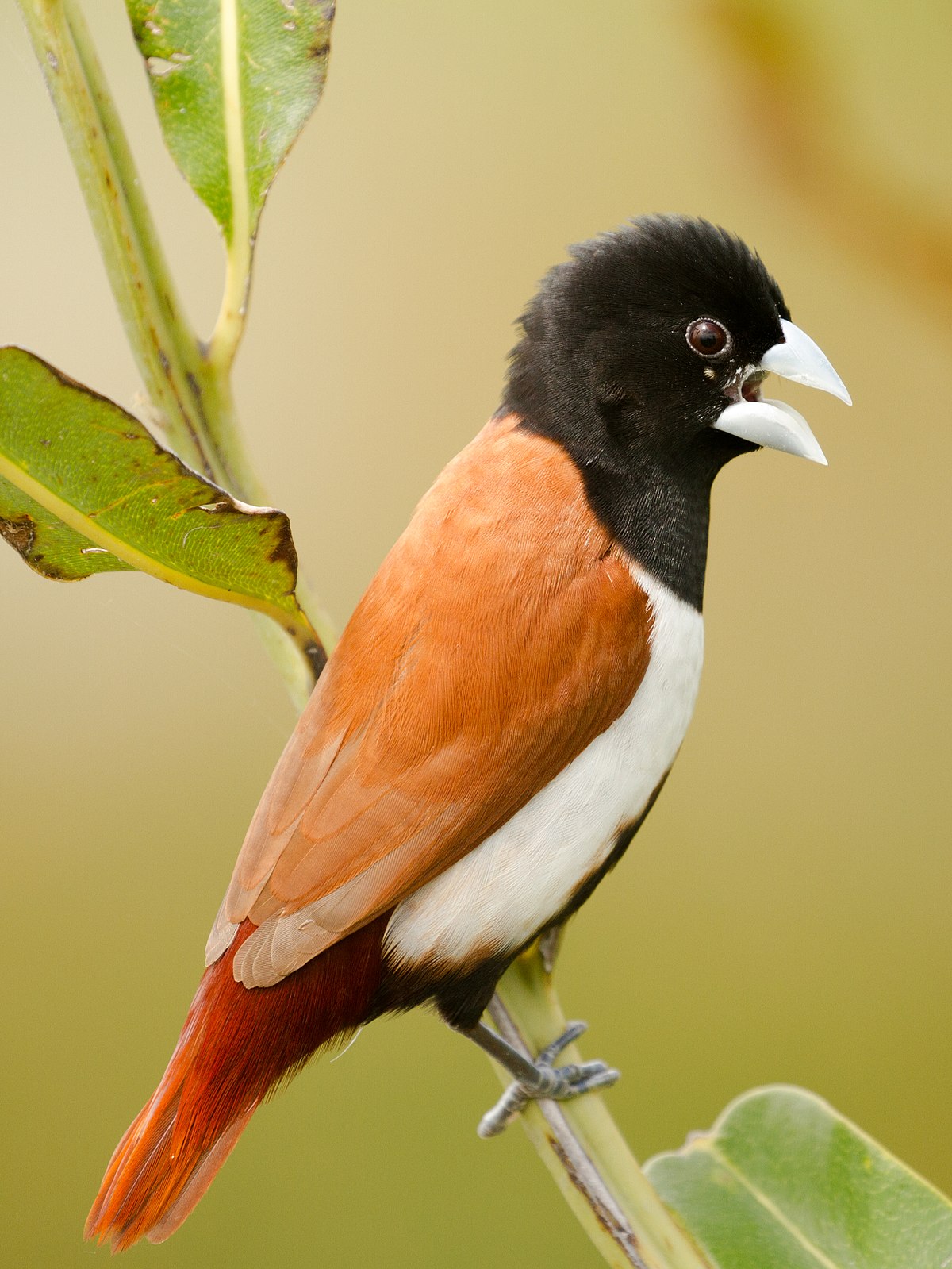
Wikipedia: Tricolored munia
Dieser Vogel erscheint jenseits grossen Meere in Kontinenten :
Europa, Südamerika.
![]() The tricoloured munia (Lonchura malacca) is an estrildid finch, native to Bangladesh,[2] India, Sri Lanka, Pakistan, and southern China. The species has also introduced to the Caribbean, in Trinidad, Jamaica, Hispaniola, Puerto Rico, Cuba, and Venezuela. This species, like the chestnut munia has been known as the black-headed munia. Immature birds have pale brown upperparts, lack the dark head found in adults, and have uniform buff underparts that can be confused with immatures of other munias such as the scaly-breasted munia.
[more]
The tricoloured munia (Lonchura malacca) is an estrildid finch, native to Bangladesh,[2] India, Sri Lanka, Pakistan, and southern China. The species has also introduced to the Caribbean, in Trinidad, Jamaica, Hispaniola, Puerto Rico, Cuba, and Venezuela. This species, like the chestnut munia has been known as the black-headed munia. Immature birds have pale brown upperparts, lack the dark head found in adults, and have uniform buff underparts that can be confused with immatures of other munias such as the scaly-breasted munia.
[more]
Familie Icteridae (New world blackbirds, orioles and allies):
Red-winged blackbird, Cromwell Valley Park, Marylan. 2021-06-14 16.09.06 null
![]() The red-winged blackbird (Agelaius phoeniceus) is a passerine bird of the family Icteridae found in most of North America and much of Central America. It breeds from Alaska and Newfoundland south to Florida, the Gulf of Mexico, Mexico, and Guatemala, with isolated populations in western El Salvador, northwestern Honduras, and northwestern Costa Rica. It may winter as far north as Pennsylvania and British Columbia, but northern populations are generally migratory, moving south to Mexico and the southern United States. Claims have been made that it is the most abundant living land bird in North America, as bird-counting censuses of wintering red-winged blackbirds sometimes show that loose flocks can number in excess of a million birds per flock and the full number of breeding pairs across North and Central America may exceed 250 million in peak years. It also ranks among the best-studied wild bird species in the world.[2][3][4][5][6] The red-winged blackbird is sexually dimorphic; the male is all black with a red shoulder and yellow wing bar, while the female is a nondescript dark brown. Seeds and insects make up the bulk of the red-winged blackbird's diet.
[more]
The red-winged blackbird (Agelaius phoeniceus) is a passerine bird of the family Icteridae found in most of North America and much of Central America. It breeds from Alaska and Newfoundland south to Florida, the Gulf of Mexico, Mexico, and Guatemala, with isolated populations in western El Salvador, northwestern Honduras, and northwestern Costa Rica. It may winter as far north as Pennsylvania and British Columbia, but northern populations are generally migratory, moving south to Mexico and the southern United States. Claims have been made that it is the most abundant living land bird in North America, as bird-counting censuses of wintering red-winged blackbirds sometimes show that loose flocks can number in excess of a million birds per flock and the full number of breeding pairs across North and Central America may exceed 250 million in peak years. It also ranks among the best-studied wild bird species in the world.[2][3][4][5][6] The red-winged blackbird is sexually dimorphic; the male is all black with a red shoulder and yellow wing bar, while the female is a nondescript dark brown. Seeds and insects make up the bulk of the red-winged blackbird's diet.
[more]
Profil Wikipedia Audubon Xeno-Canto
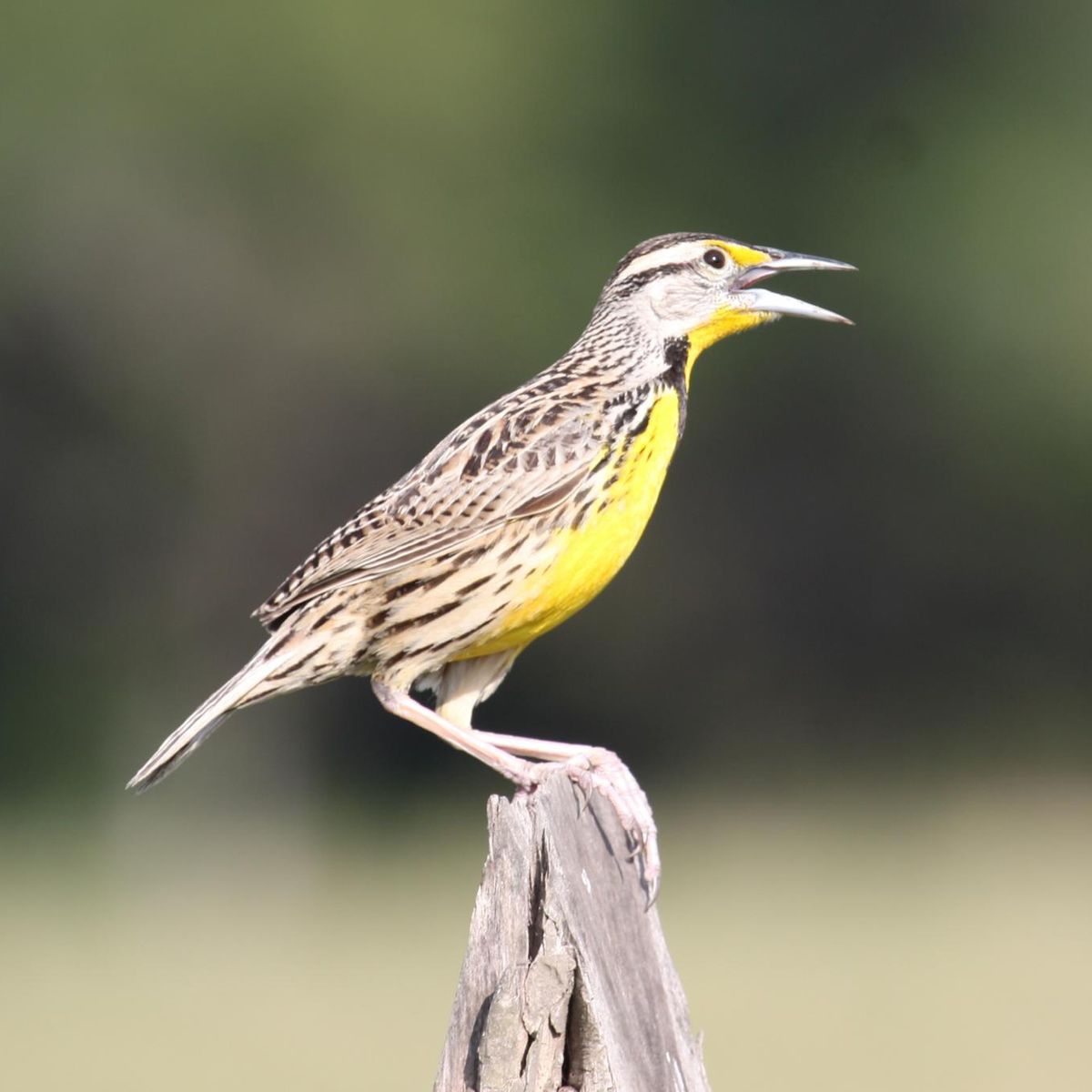
Wikipedia: Eastern meadowlark
![]() The eastern meadowlark (Sturnella magna) is a medium-sized icterid bird, very similar in appearance to the western meadowlark. It occurs from eastern North America to South America, where it is also most widespread in the east.
[more]
The eastern meadowlark (Sturnella magna) is a medium-sized icterid bird, very similar in appearance to the western meadowlark. It occurs from eastern North America to South America, where it is also most widespread in the east.
[more]

Wikipedia: Red-breasted meadowlark
![]() The red-breasted meadowlark (Leistes militaris) is a passerine bird in the New World family Icteridae. It was formerly named red-breasted blackbird but is not closely related to the red-winged blackbird group.[2]
[more]
The red-breasted meadowlark (Leistes militaris) is a passerine bird in the New World family Icteridae. It was formerly named red-breasted blackbird but is not closely related to the red-winged blackbird group.[2]
[more]
Profil Wikipedia Xeno-Canto
Monteverde great tailed grackle female. 2018-02-12 16.47.52 null
![]() The great-tailed grackle or Mexican grackle (Quiscalus mexicanus) is a medium-sized, highly social passerine bird native to North and South America. A member of the family Icteridae, it is one of 10 extant species of grackle and is closely related to the boat-tailed grackle and the extinct slender-billed grackle.[2] In the southern United States, it is sometimes simply referred to as "blackbird" or (erroneously) "crow"[3] due to its glossy black plumage, and similarly it is often called cuervo ("crow") in some parts of Mexico, although it is not a member of the crow genus Corvus, nor even of the family Corvidae.
[more]
The great-tailed grackle or Mexican grackle (Quiscalus mexicanus) is a medium-sized, highly social passerine bird native to North and South America. A member of the family Icteridae, it is one of 10 extant species of grackle and is closely related to the boat-tailed grackle and the extinct slender-billed grackle.[2] In the southern United States, it is sometimes simply referred to as "blackbird" or (erroneously) "crow"[3] due to its glossy black plumage, and similarly it is often called cuervo ("crow") in some parts of Mexico, although it is not a member of the crow genus Corvus, nor even of the family Corvidae.
[more]
Profil Wikipedia Xeno-Canto

Wikipedia: Nicaraguan grackle
![]() The Nicaraguan grackle (Quiscalus nicaraguensis) is a species of passerine bird belonging to the genus Quiscalus, a genus of grackles in the New World blackbird family, Icteridae. It is found only in Nicaragua and northernmost Costa Rica.
[more]
The Nicaraguan grackle (Quiscalus nicaraguensis) is a species of passerine bird belonging to the genus Quiscalus, a genus of grackles in the New World blackbird family, Icteridae. It is found only in Nicaragua and northernmost Costa Rica.
[more]
Profil Wikipedia Xeno-Canto
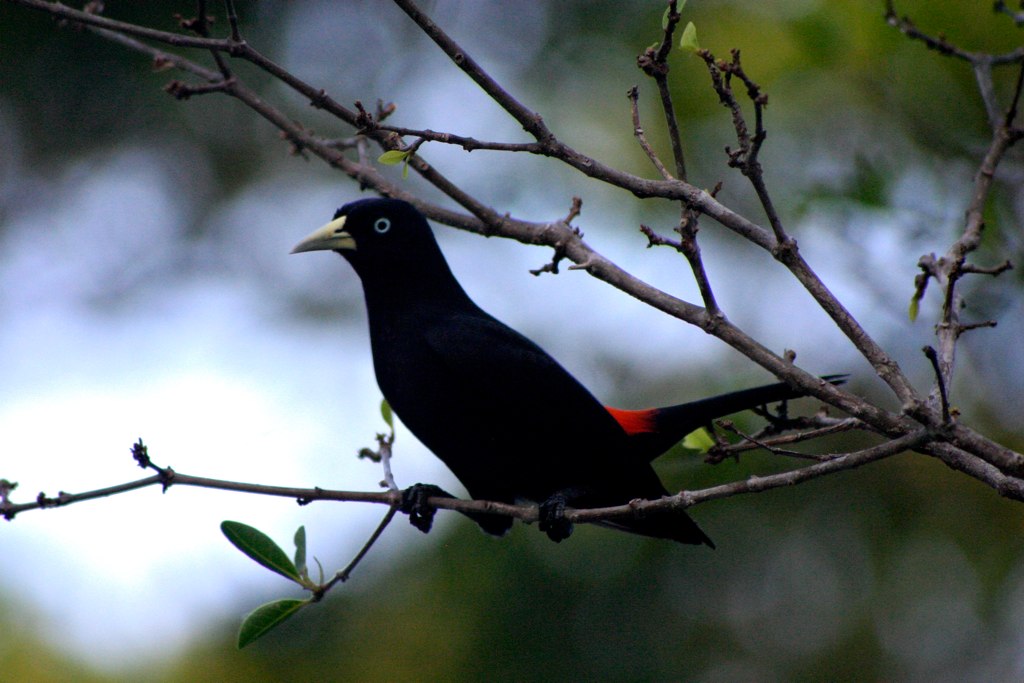
Wikipedia: Scarlet-rumped cacique
![]() The scarlet-rumped cacique (Cacicus uropygialis) is a passerine bird species in the New World family Icteridae. It breeds from eastern Honduras to Panama and in the Pacific lowlands of South America from western Colombia south to Ecuador, and in the lower reaches of the northern Andes. There are several subspecies, some of which have been proposed for elevation to full species status.
[more]
The scarlet-rumped cacique (Cacicus uropygialis) is a passerine bird species in the New World family Icteridae. It breeds from eastern Honduras to Panama and in the Pacific lowlands of South America from western Colombia south to Ecuador, and in the lower reaches of the northern Andes. There are several subspecies, some of which have been proposed for elevation to full species status.
[more]
Profil Wikipedia Xeno-Canto

Wikipedia: Yellow-rumped cacique
![]() The yellow-rumped cacique (Cacicus cela) is a passerine bird in the New World family Icteridae. It breeds in much of northern South America from Panama and Trinidad south to Peru, Bolivia and central Brazil. However, they have been sighted as far north as Nayarit state in Mexico.
[more]
The yellow-rumped cacique (Cacicus cela) is a passerine bird in the New World family Icteridae. It breeds in much of northern South America from Panama and Trinidad south to Peru, Bolivia and central Brazil. However, they have been sighted as far north as Nayarit state in Mexico.
[more]
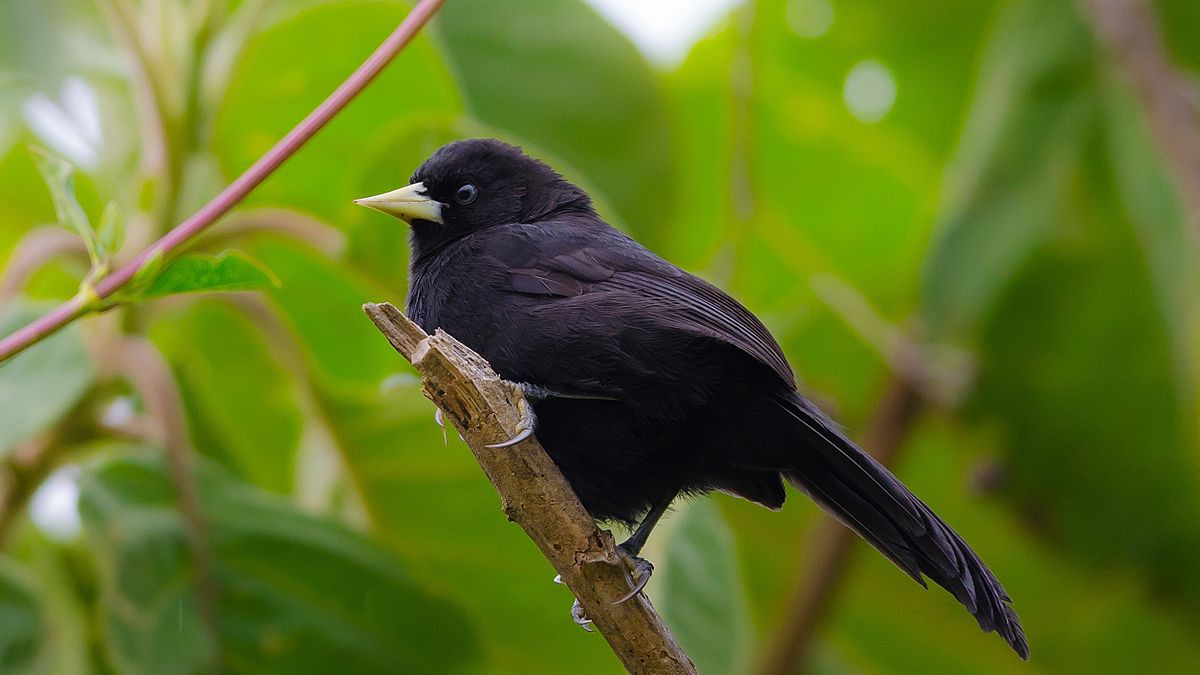
Wikipedia: Yellow-billed cacique
![]() The yellow-billed cacique (Amblycercus holosericeus) is a species of cacique in the family Icteridae. It is monotypic within the genus Amblycercus.[2] There is some question as to whether or not it is a true cacique.[3][4]
[more]
The yellow-billed cacique (Amblycercus holosericeus) is a species of cacique in the family Icteridae. It is monotypic within the genus Amblycercus.[2] There is some question as to whether or not it is a true cacique.[3][4]
[more]
Profil Wikipedia Xeno-Canto
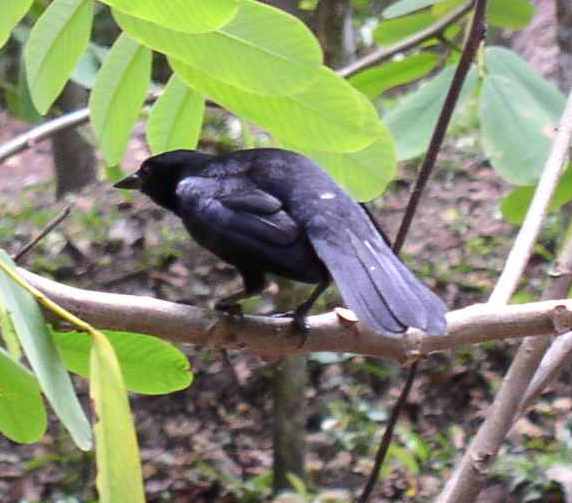
Wikipedia: Melodious blackbird
![]() The melodious blackbird (Dives dives) is a New World tropical bird.
[more]
The melodious blackbird (Dives dives) is a New World tropical bird.
[more]
Profil Wikipedia Audubon Xeno-Canto

Wikipedia: Bobolink
![]() The bobolink (Dolichonyx oryzivorus) is a small New World blackbird and the only member of the genus Dolichonyx. An old name for this species is the "Rice Bird", from its tendency to feed on cultivated grains. Adults are 16–18 cm (6.3–7.1 in) long with short finch-like bills and weigh about 1 oz (28 g). Adult males are mostly black with creamy napes and white scapulars, lower backs, and rumps. Adult females are mostly light brown with black streaks on the back and flanks, and dark stripes on the head; their wings and tails are darker. The bobolink breeds in the summer in North America and southern Canada, often wintering in South America. Considered a pest by some farmers, the numbers of these birds are declining and are a species at risk throughout Canada.
[more]
The bobolink (Dolichonyx oryzivorus) is a small New World blackbird and the only member of the genus Dolichonyx. An old name for this species is the "Rice Bird", from its tendency to feed on cultivated grains. Adults are 16–18 cm (6.3–7.1 in) long with short finch-like bills and weigh about 1 oz (28 g). Adult males are mostly black with creamy napes and white scapulars, lower backs, and rumps. Adult females are mostly light brown with black streaks on the back and flanks, and dark stripes on the head; their wings and tails are darker. The bobolink breeds in the summer in North America and southern Canada, often wintering in South America. Considered a pest by some farmers, the numbers of these birds are declining and are a species at risk throughout Canada.
[more]
Black-cowled oriole in Manzanillo, Costa Rica. 2020-03-12 09.34.56 null
![]() The black-cowled oriole (Icterus prosthemelas) is a species of bird in the family Icteridae. It is common and widespread in the Caribbean lowlands and foothills from southern Mexico to western Panama. It lives primarily in humid or semihumid forest, as well as in clearings, along forest edges, in plantations, in semi-open areas with scattered trees and bushes, and in gardens. The adult male is black, with yellow on the belly, shoulder, rump, wing lining, and crissum. The female's plumage varies depending on location. In the south of its range, it is similar to that of the male. In the north, its crown and upperparts are olive-yellow, while its face, throat, upper breast, wings, and tail are black.
[more]
The black-cowled oriole (Icterus prosthemelas) is a species of bird in the family Icteridae. It is common and widespread in the Caribbean lowlands and foothills from southern Mexico to western Panama. It lives primarily in humid or semihumid forest, as well as in clearings, along forest edges, in plantations, in semi-open areas with scattered trees and bushes, and in gardens. The adult male is black, with yellow on the belly, shoulder, rump, wing lining, and crissum. The female's plumage varies depending on location. In the south of its range, it is similar to that of the male. In the north, its crown and upperparts are olive-yellow, while its face, throat, upper breast, wings, and tail are black.
[more]
Profil Wikipedia Audubon Xeno-Canto
Seldom seen Baltimore Oriole, Cromwell Valley Park. 2021-06-18 11.34.42 null
![]() The Baltimore oriole (Icterus galbula) is a small icterid blackbird common in eastern North America as a migratory breeding bird. It received its name from the resemblance of the male's colors to those on the coat-of-arms of Lord Baltimore. Observations of interbreeding between the Baltimore oriole and the western Bullock's oriole, Icterus bullockii, led to both being classified as a single species, called the northern oriole, from 1973 to 1995. Research by James Rising, a professor of zoology at the University of Toronto, and others showed that the two birds actually did not interbreed significantly.[2]
[more]
The Baltimore oriole (Icterus galbula) is a small icterid blackbird common in eastern North America as a migratory breeding bird. It received its name from the resemblance of the male's colors to those on the coat-of-arms of Lord Baltimore. Observations of interbreeding between the Baltimore oriole and the western Bullock's oriole, Icterus bullockii, led to both being classified as a single species, called the northern oriole, from 1973 to 1995. Research by James Rising, a professor of zoology at the University of Toronto, and others showed that the two birds actually did not interbreed significantly.[2]
[more]
Profil Wikipedia Audubon Xeno-Canto

Wikipedia: Orchard oriole
![]() The orchard oriole (Icterus spurius) is the smallest species of icterid. The subspecies of the Caribbean coast of Mexico, I. s. fuertesi, is sometimes considered a separate species, the ochre oriole or Fuertes's oriole.
[more]
The orchard oriole (Icterus spurius) is the smallest species of icterid. The subspecies of the Caribbean coast of Mexico, I. s. fuertesi, is sometimes considered a separate species, the ochre oriole or Fuertes's oriole.
[more]
Profil Wikipedia Audubon Xeno-Canto

Wikipedia: Spot-breasted oriole
![]() The spot-breasted oriole (Icterus pectoralis) is a species of bird in the family Icteridae.
[more]
The spot-breasted oriole (Icterus pectoralis) is a species of bird in the family Icteridae.
[more]
Profil Wikipedia Xeno-Canto
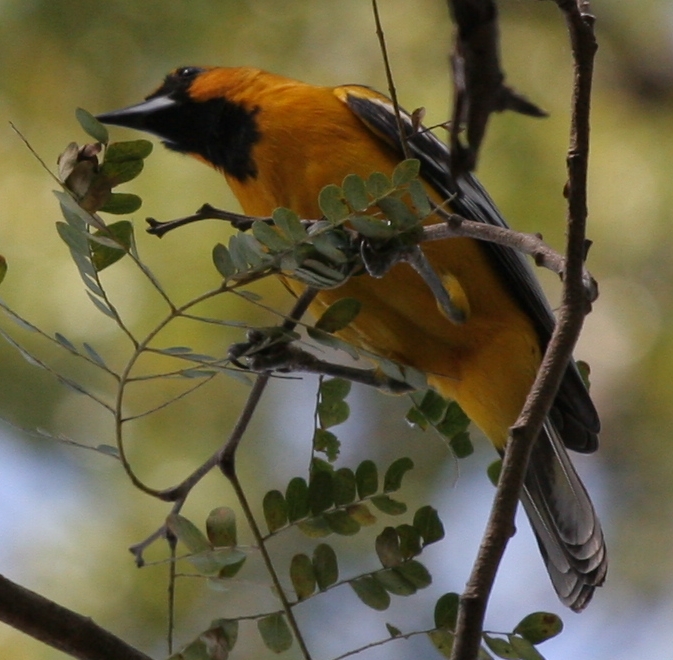
Wikipedia: Streak-backed oriole
![]() The streak-backed oriole (Icterus pustulatus) is a medium-sized species of passerine bird from the icterid family (the same family as many blackbirds, meadowlarks, cowbirds, grackles, and others, including the New World orioles). It is native to Central America and Mexico and is an occasional visitor to the United States.[1]
[more]
The streak-backed oriole (Icterus pustulatus) is a medium-sized species of passerine bird from the icterid family (the same family as many blackbirds, meadowlarks, cowbirds, grackles, and others, including the New World orioles). It is native to Central America and Mexico and is an occasional visitor to the United States.[1]
[more]
Profil Wikipedia Xeno-Canto
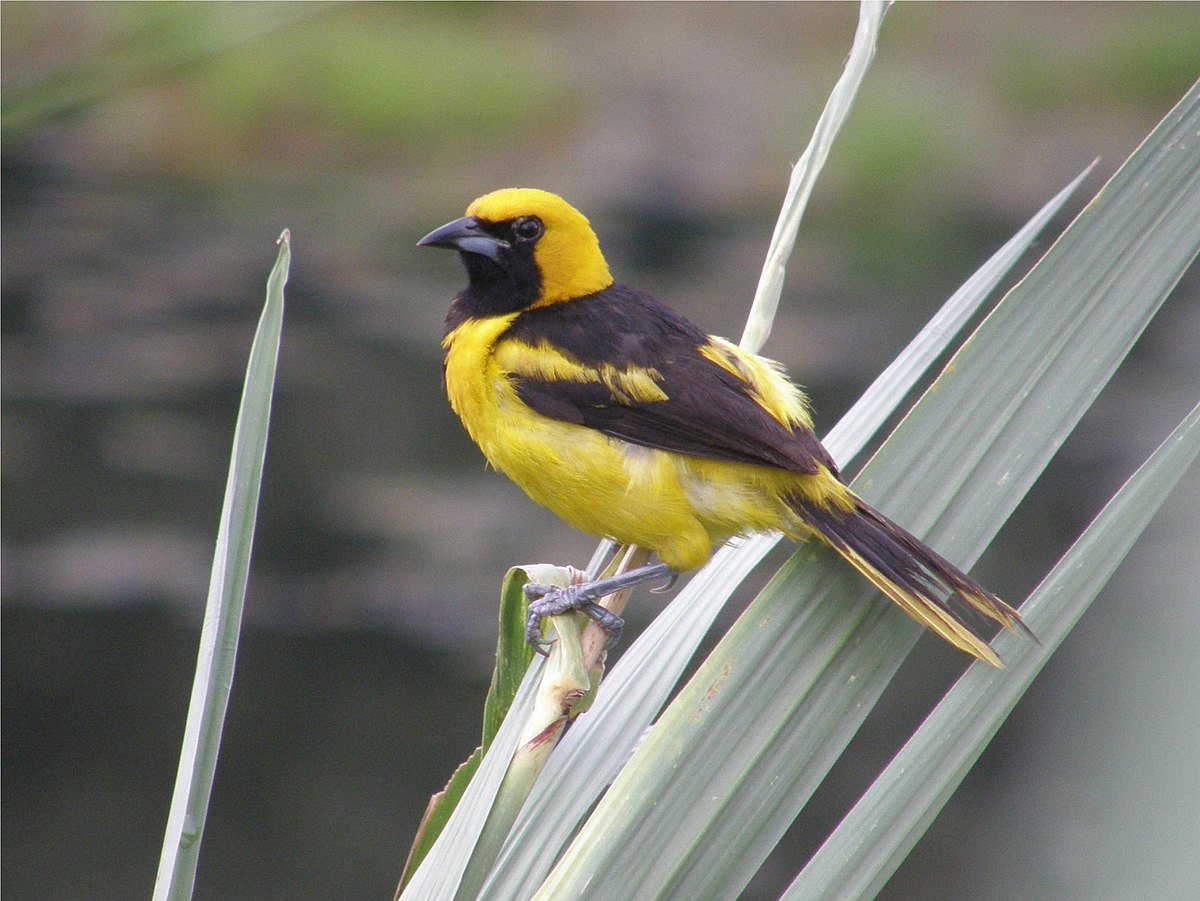
Wikipedia: Yellow-tailed oriole
![]() The yellow-tailed oriole (Icterus mesomelas) is a passerine bird in the New World family Icteridae. It breeds from southern Mexico to western Peru and northwestern Venezuela; in Peru it also lives in a river valley corridor.
[more]
The yellow-tailed oriole (Icterus mesomelas) is a passerine bird in the New World family Icteridae. It breeds from southern Mexico to western Peru and northwestern Venezuela; in Peru it also lives in a river valley corridor.
[more]
Profil Wikipedia Xeno-Canto

Wikipedia: Orange-crowned oriole
![]() The orange-crowned oriole (Icterus auricapillus) is a species of bird in the family Icteridae. It is found in eastern Panama, Colombia and Venezuela.
[more]
The orange-crowned oriole (Icterus auricapillus) is a species of bird in the family Icteridae. It is found in eastern Panama, Colombia and Venezuela.
[more]
Profil Wikipedia Xeno-Canto

Wikipedia: Yellow-tailed oriole
![]() The yellow-tailed oriole (Icterus mesomelas) is a passerine bird in the New World family Icteridae. It breeds from southern Mexico to western Peru and northwestern Venezuela; in Peru it also lives in a river valley corridor.
[more]
The yellow-tailed oriole (Icterus mesomelas) is a passerine bird in the New World family Icteridae. It breeds from southern Mexico to western Peru and northwestern Venezuela; in Peru it also lives in a river valley corridor.
[more]
Profil Wikipedia Xeno-Canto
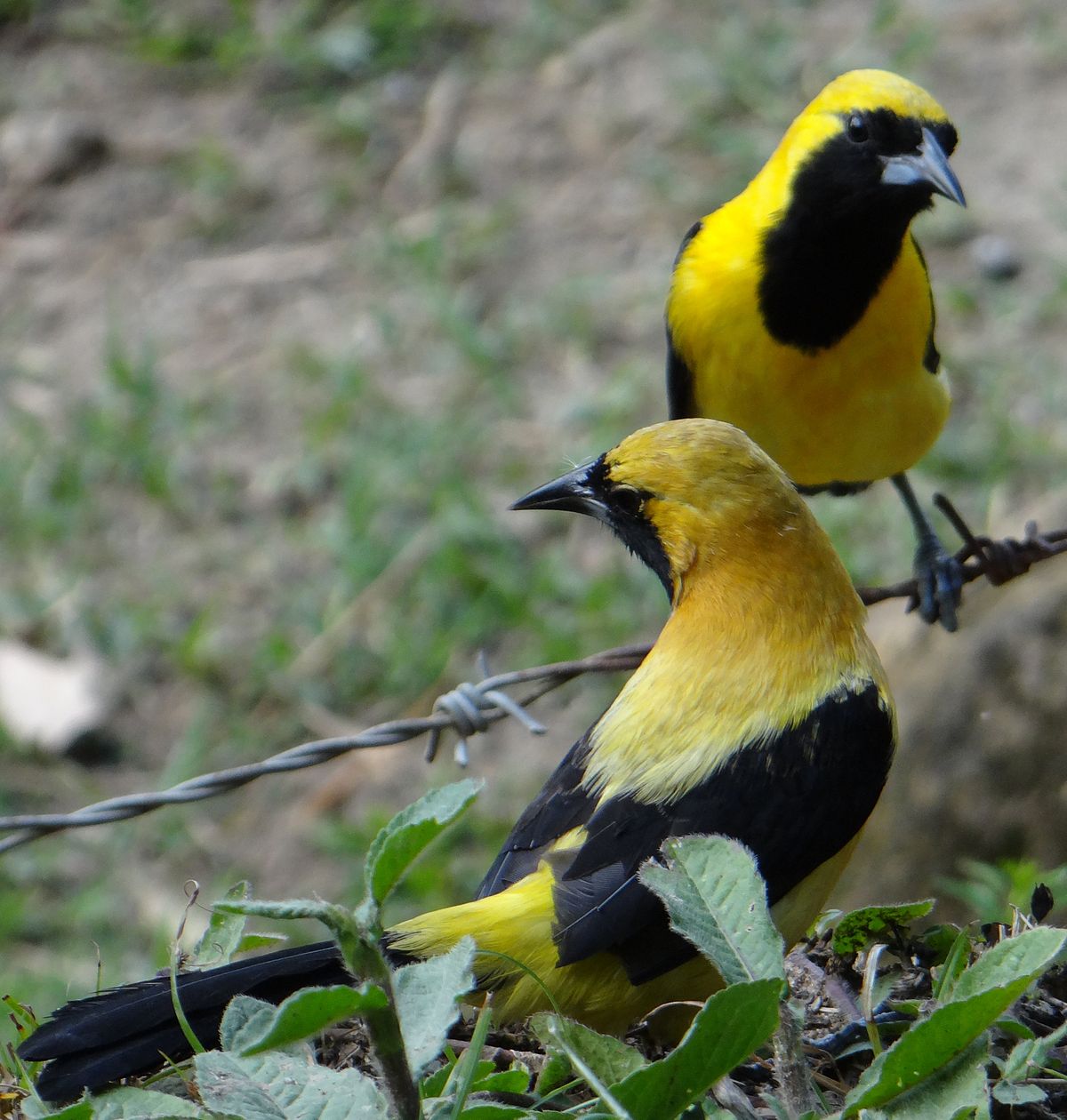
Wikipedia: Yellow-backed oriole
![]() The yellow-backed oriole (Icterus chrysater) is a species of bird in the family Icteridae.
[more]
The yellow-backed oriole (Icterus chrysater) is a species of bird in the family Icteridae.
[more]
Profil Wikipedia Audubon Xeno-Canto

Wikipedia: Shiny cowbird
![]() The shiny cowbird (Molothrus bonariensis) is a passerine bird in the New World family Icteridae. It breeds in most of South America except for dense forests and areas of high altitude such as mountains.[1] Since 1900 the shiny cowbirds' range has shifted northward, and it was recorded in the Caribbean islands as well as the United States, where it is found breeding in southern Florida.[2] It is a bird associated with open habitats, including disturbed land from agriculture and deforestation.[1]
[more]
The shiny cowbird (Molothrus bonariensis) is a passerine bird in the New World family Icteridae. It breeds in most of South America except for dense forests and areas of high altitude such as mountains.[1] Since 1900 the shiny cowbirds' range has shifted northward, and it was recorded in the Caribbean islands as well as the United States, where it is found breeding in southern Florida.[2] It is a bird associated with open habitats, including disturbed land from agriculture and deforestation.[1]
[more]
Profil Wikipedia Audubon Xeno-Canto

Wikipedia: Bronzed cowbird
![]()
The bronzed cowbird (once known as the red-eyed cowbird, Molothrus aeneus) is a small icterid.
[more]
Profil Wikipedia Xeno-Canto
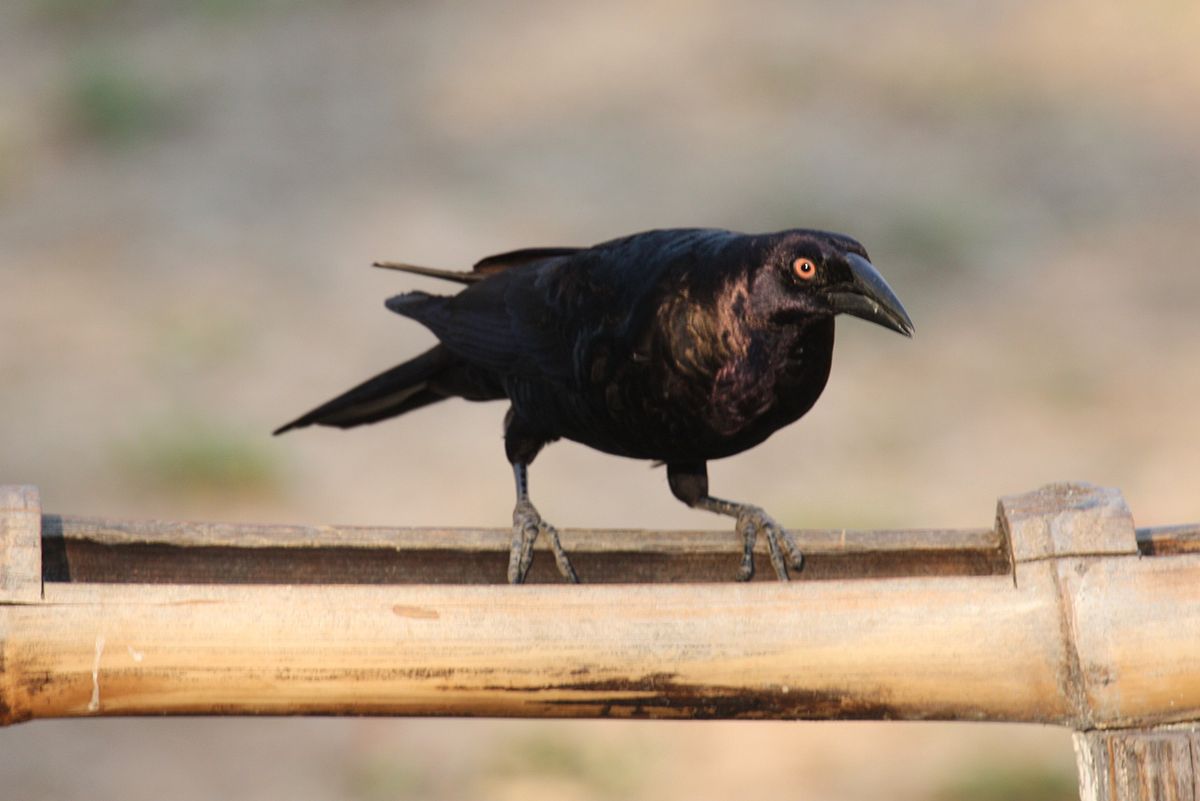
Wikipedia: Giant cowbird
![]() The giant cowbird (Molothrus oryzivorus) is a large passerine bird in the New World family Icteridae. It breeds from southern Mexico south to northern Argentina, and on Trinidad and Tobago. It may have relatively recently colonised the latter island.
[more]
The giant cowbird (Molothrus oryzivorus) is a large passerine bird in the New World family Icteridae. It breeds from southern Mexico south to northern Argentina, and on Trinidad and Tobago. It may have relatively recently colonised the latter island.
[more]
Arenal feeder montezuma oropendola landing. 2018-02-27 12.51.44 null
![]() Der Montezumastirnvogel (Psarocolius montezuma, Syn.: Gymnostinops montezuma) ist ein mittelamerikanischer Singvogel aus der Familie der Stärlinge.
[more]
Der Montezumastirnvogel (Psarocolius montezuma, Syn.: Gymnostinops montezuma) ist ein mittelamerikanischer Singvogel aus der Familie der Stärlinge.
[more]
Profil Wikipedia Xeno-Canto

Wikipedia: Crested oropendola
![]() The crested oropendola also known as the Suriname crested oropendola or the cornbird (Psarocolius decumanus) is a New World tropical icterid bird. It is a resident breeder in lowland South America east of the Andes, from Panama and Colombia south to northern Argentina, as well as on Trinidad and Tobago. If the genus Gymnostinax for the Montezuma oropendola and its closest relatives were considered valid, this species would probably belong in that genus (Price & Lanyon 2002).
[more]
The crested oropendola also known as the Suriname crested oropendola or the cornbird (Psarocolius decumanus) is a New World tropical icterid bird. It is a resident breeder in lowland South America east of the Andes, from Panama and Colombia south to northern Argentina, as well as on Trinidad and Tobago. If the genus Gymnostinax for the Montezuma oropendola and its closest relatives were considered valid, this species would probably belong in that genus (Price & Lanyon 2002).
[more]
Profil Wikipedia Xeno-Canto

Wikipedia: Chestnut-headed oropendola
![]() Psarocolius waglerii (lapsus)
[more]
Psarocolius waglerii (lapsus)
[more]

Wikipedia: Black oropendola
![]() The black oropendola (Psarocolius guatimozinus) is a species of bird in the family Icteridae (New World blackbirds). It is found in Colombia and Panama. Its natural habitat is subtropical or tropical moist lowland forests.
[more]
The black oropendola (Psarocolius guatimozinus) is a species of bird in the family Icteridae (New World blackbirds). It is found in Colombia and Panama. Its natural habitat is subtropical or tropical moist lowland forests.
[more]
Familie Parulidae (New world warblers):

Wikipedia: Golden-winged warbler
![]() The golden-winged warbler (Vermivora chrysoptera) is a New World warbler. It breeds in southeastern and south-central Canada and in the Appalachian Mountains in northeastern to north-central United States. The majority (~70%) of the global population breeds in Wisconsin, Minnesota, and Manitoba. Golden-winged warbler populations are slowly expanding northwards, but are generally declining across its range, most likely as a result of habitat loss and competition/interbreeding with the very closely related blue-winged warbler, Vermivora cyanoptera.
[more]
The golden-winged warbler (Vermivora chrysoptera) is a New World warbler. It breeds in southeastern and south-central Canada and in the Appalachian Mountains in northeastern to north-central United States. The majority (~70%) of the global population breeds in Wisconsin, Minnesota, and Manitoba. Golden-winged warbler populations are slowly expanding northwards, but are generally declining across its range, most likely as a result of habitat loss and competition/interbreeding with the very closely related blue-winged warbler, Vermivora cyanoptera.
[more]

Wikipedia: Blue-winged warbler
![]() The blue-winged warbler (Vermivora cyanoptera) is a fairly common New World warbler, 11.5 cm (4.5 in) long and weighing 8.5 g (0.30 oz). It breeds in eastern North America in southern Ontario and the eastern United States. Its range is extending northwards, where it is replacing the very closely related golden-winged warbler, Vermivora chrysoptera.
[more]
The blue-winged warbler (Vermivora cyanoptera) is a fairly common New World warbler, 11.5 cm (4.5 in) long and weighing 8.5 g (0.30 oz). It breeds in eastern North America in southern Ontario and the eastern United States. Its range is extending northwards, where it is replacing the very closely related golden-winged warbler, Vermivora chrysoptera.
[more]

Wikipedia: Rufous-capped warbler
![]() The rufous-capped warbler (Basileuterus rufifrons) is a New World warbler native from Mexico south to much of Central America, rarely occurring as far north as southeastern Arizona and south Texas.
[more]
The rufous-capped warbler (Basileuterus rufifrons) is a New World warbler native from Mexico south to much of Central America, rarely occurring as far north as southeastern Arizona and south Texas.
[more]

Wikipedia: Golden-crowned warbler
![]() The golden-crowned warbler (Basileuterus culicivorus) is a small New World warbler.
[more]
The golden-crowned warbler (Basileuterus culicivorus) is a small New World warbler.
[more]
Profil Wikipedia Xeno-Canto

Wikipedia: Costa Rican warbler
![]() The black-eared warbler or Costa Rican warbler (Basileuterus melanotis) is a species of bird in the family Parulidae. It was previously considered conspecific with the three-striped warbler and the Tacarcuna warbler.
[more]
The black-eared warbler or Costa Rican warbler (Basileuterus melanotis) is a species of bird in the family Parulidae. It was previously considered conspecific with the three-striped warbler and the Tacarcuna warbler.
[more]
Profil Wikipedia Xeno-Canto

Wikipedia: Black-cheeked warbler
![]() The black-cheeked warbler (Basileuterus melanogenys) is a New World warbler, resident breeding bird endemic to the Talamancan montane forests of Costa Rica and western Panama.
[more]
The black-cheeked warbler (Basileuterus melanogenys) is a New World warbler, resident breeding bird endemic to the Talamancan montane forests of Costa Rica and western Panama.
[more]
Profil Wikipedia Xeno-Canto

Wikipedia: Pirre warbler
![]() The Pirre warbler (Basileuterus ignotus) is a species of bird in the family Parulidae.
It is found in the borderline area of Panama and Colombia.
Its natural habitat is subtropical or tropical moist montane forests.
It is threatened by habitat loss.
[more]
The Pirre warbler (Basileuterus ignotus) is a species of bird in the family Parulidae.
It is found in the borderline area of Panama and Colombia.
Its natural habitat is subtropical or tropical moist montane forests.
It is threatened by habitat loss.
[more]

Wikipedia: Kentucky warbler
![]() The Kentucky warbler (Geothlypis formosa) is a small species of New World warbler. It is a sluggish and heavy warbler with a short tail, preferring to spend most of its time on or near the ground, except when singing.
[more]
The Kentucky warbler (Geothlypis formosa) is a small species of New World warbler. It is a sluggish and heavy warbler with a short tail, preferring to spend most of its time on or near the ground, except when singing.
[more]

Wikipedia: Mourning warbler
![]() The mourning warbler (Geothlypis philadelphia) is a small songbird of the New World warbler family. Mourning warblers are native to eastern and central North America as well as some countries in Central America.[2] They are neotropical migrants and tend to be found in dense second growth forests.[3] They are under the Wood-warbler category, which consists of arboreal and terrestrial colorful passerines. Wood warblers are in the order Passeriformes, which are perching birds including more than half of all bird species, and the family Parulidae which also includes the Common Yellowthroat, Black and White Warbler, Nashville Warbler, ovenbird, and American Redstart. They are very similar to the MacGillivray's Warbler in appearance, especially in females and immature birds, but their breeding range does not overlap into the west.[4]
[more]
The mourning warbler (Geothlypis philadelphia) is a small songbird of the New World warbler family. Mourning warblers are native to eastern and central North America as well as some countries in Central America.[2] They are neotropical migrants and tend to be found in dense second growth forests.[3] They are under the Wood-warbler category, which consists of arboreal and terrestrial colorful passerines. Wood warblers are in the order Passeriformes, which are perching birds including more than half of all bird species, and the family Parulidae which also includes the Common Yellowthroat, Black and White Warbler, Nashville Warbler, ovenbird, and American Redstart. They are very similar to the MacGillivray's Warbler in appearance, especially in females and immature birds, but their breeding range does not overlap into the west.[4]
[more]
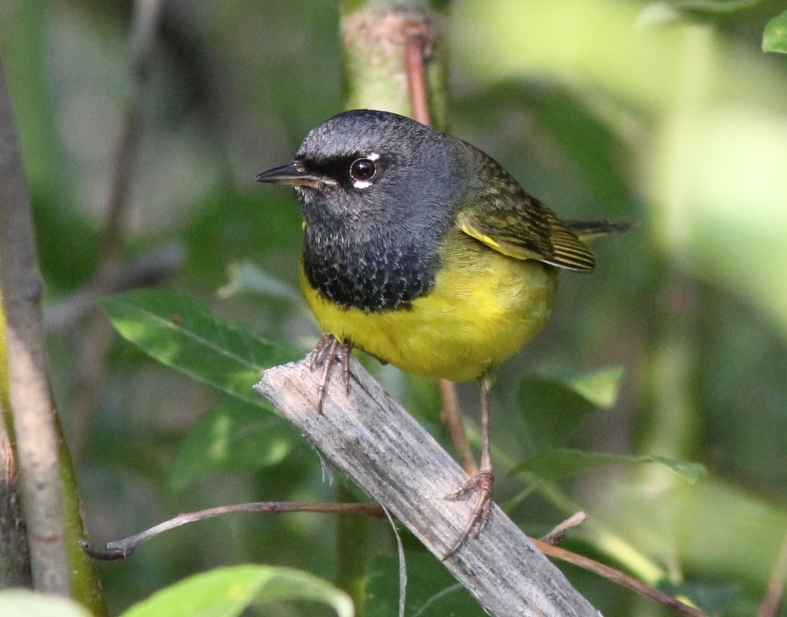
Wikipedia: Macgillivray's warbler
![]() MacGillivray's warbler (Geothlypis tolmiei) is a species of New World warbler. These birds are sluggish and heavy warblers, preferring to spend most of their time on, or near the ground, except when singing.
[more]
MacGillivray's warbler (Geothlypis tolmiei) is a species of New World warbler. These birds are sluggish and heavy warblers, preferring to spend most of their time on, or near the ground, except when singing.
[more]

Wikipedia: Common yellowthroat
![]() The common yellowthroat (Geothlypis trichas) is a New World warbler. It is an abundant breeder in North America, ranging from southern Canada to central Mexico. The genus name Geothlypis is from Ancient Greek geo, "ground", and thlupis, an unidentified small bird; thlypis is often used in the scientific names of New World warblers. The specific trichas is also from Greek; trikhas is a kind of thrush, the word being derived from trikhos, "hair".[2]
[more]
The common yellowthroat (Geothlypis trichas) is a New World warbler. It is an abundant breeder in North America, ranging from southern Canada to central Mexico. The genus name Geothlypis is from Ancient Greek geo, "ground", and thlupis, an unidentified small bird; thlypis is often used in the scientific names of New World warblers. The specific trichas is also from Greek; trikhas is a kind of thrush, the word being derived from trikhos, "hair".[2]
[more]
Profil Wikipedia Xeno-Canto

Wikipedia: Gray-crowned yellowthroat
![]() The grey-crowned yellowthroat (Geothlypis poliocephala) is a species of bird in the family Parulidae.
It is found in Belize, Costa Rica, El Salvador, Guatemala, Honduras, Mexico, Nicaragua, Panama, and the United States.
Its natural habitats are subtropical or tropical moist shrubland and heavily degraded former forest.
[more]
The grey-crowned yellowthroat (Geothlypis poliocephala) is a species of bird in the family Parulidae.
It is found in Belize, Costa Rica, El Salvador, Guatemala, Honduras, Mexico, Nicaragua, Panama, and the United States.
Its natural habitats are subtropical or tropical moist shrubland and heavily degraded former forest.
[more]
Profil Wikipedia Xeno-Canto

Wikipedia: Olive-crowned yellowthroat
![]() The olive-crowned yellowthroat (Geothlypis semiflava) is a species of bird in the family Parulidae.
It is found in Colombia, Costa Rica, Ecuador, Honduras, Mexico, Nicaragua, and Panama.
Its natural habitats are subtropical or tropical moist shrubland and heavily degraded former forest.
[more]
The olive-crowned yellowthroat (Geothlypis semiflava) is a species of bird in the family Parulidae.
It is found in Colombia, Costa Rica, Ecuador, Honduras, Mexico, Nicaragua, and Panama.
Its natural habitats are subtropical or tropical moist shrubland and heavily degraded former forest.
[more]
Profil Wikipedia Audubon Xeno-Canto

Wikipedia: Yellow-breasted chat
![]() The yellow-breasted chat (Icteria virens) is a large songbird found in North America, and is the only member of the family Icteriidae. It was once a member of the New World warbler family, but in 2017, the American Ornithological Society moved it to its own family. Its placement is not definitely resolved.
[more]
The yellow-breasted chat (Icteria virens) is a large songbird found in North America, and is the only member of the family Icteriidae. It was once a member of the New World warbler family, but in 2017, the American Ornithological Society moved it to its own family. Its placement is not definitely resolved.
[more]
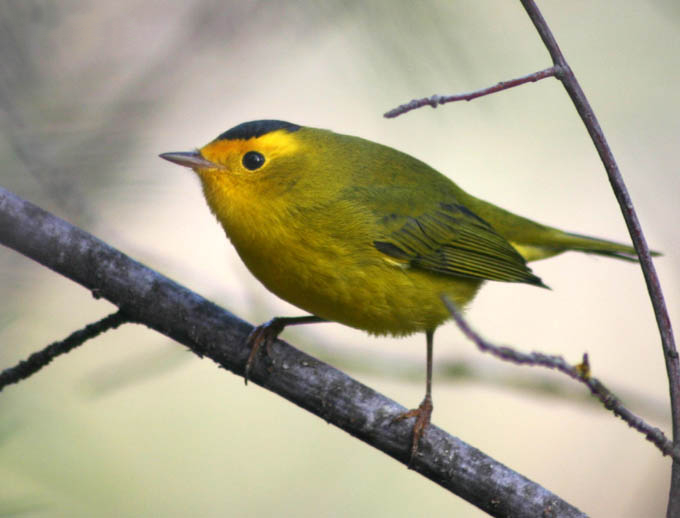
Wikipedia: Wilson's warbler
![]() Wilson's warbler (Cardellina pusilla) is a small New World warbler. It is greenish above and yellow below, with rounded wings and a long, slim tail. The male has a black crown patch; depending on the subspecies, that mark is reduced or absent in the female. It breeds across Canada and south through the western United States, and winters from Mexico south through much of Central America. It is a very rare vagrant to western Europe.
[more]
Wilson's warbler (Cardellina pusilla) is a small New World warbler. It is greenish above and yellow below, with rounded wings and a long, slim tail. The male has a black crown patch; depending on the subspecies, that mark is reduced or absent in the female. It breeds across Canada and south through the western United States, and winters from Mexico south through much of Central America. It is a very rare vagrant to western Europe.
[more]

Wikipedia: Canada warbler
![]() The Canada warbler (Cardellina canadensis) is a small boreal songbird of the New World warbler family (Parulidae). It summers in Canada and northeastern United States and winters in northern South America.
[more]
The Canada warbler (Cardellina canadensis) is a small boreal songbird of the New World warbler family (Parulidae). It summers in Canada and northeastern United States and winters in northern South America.
[more]

Wikipedia: Worm-eating warbler
![]() The worm-eating warbler (Helmitheros vermivorum) is a small New World warbler that breeds in the Eastern United States and migrates to southern Mexico, the Caribbean, and Central America for the winter.
[more]
The worm-eating warbler (Helmitheros vermivorum) is a small New World warbler that breeds in the Eastern United States and migrates to southern Mexico, the Caribbean, and Central America for the winter.
[more]

Wikipedia: Black-and-white warbler
![]() The black-and-white warbler (Mniotilta varia) is a species of New World warbler, and the only member of its genus, Mniotilta.[2]
It breeds in northern and eastern North America and winters in Florida, Central America, and the West Indies down to Peru. This species is a very rare vagrant to western Europe.[2]
[more]
The black-and-white warbler (Mniotilta varia) is a species of New World warbler, and the only member of its genus, Mniotilta.[2]
It breeds in northern and eastern North America and winters in Florida, Central America, and the West Indies down to Peru. This species is a very rare vagrant to western Europe.[2]
[more]
Profil Wikipedia Xeno-Canto

Wikipedia: Collared redstart
![]() The collared whitestart (Myioborus torquatus), also known as the collared redstart, is a tropical New World warbler endemic to the mountains of Costa Rica and western-central Panama.[2]
[more]
The collared whitestart (Myioborus torquatus), also known as the collared redstart, is a tropical New World warbler endemic to the mountains of Costa Rica and western-central Panama.[2]
[more]
Profil Wikipedia Xeno-Canto

Wikipedia: Slate-throated redstart
![]() The slate-throated whitestart or slate-throated redstart (Myioborus miniatus) is a species of bird in the family Parulidae native to Central and South America.[1][2]
[more]
The slate-throated whitestart or slate-throated redstart (Myioborus miniatus) is a species of bird in the family Parulidae native to Central and South America.[1][2]
[more]
Profil Wikipedia Audubon Xeno-Canto

Wikipedia: Prothonotary warbler
![]() The prothonotary warbler (Protonotaria citrea) is a small songbird of the New World warbler family. It is the only member of the genus Protonotaria.[2]
[more]
The prothonotary warbler (Protonotaria citrea) is a small songbird of the New World warbler family. It is the only member of the genus Protonotaria.[2]
[more]

Wikipedia: Ovenbird
![]() The ovenbird (Seiurus aurocapilla) is a small songbird of the New World warbler family (Parulidae). This migratory bird breeds in eastern North America and winters in Central America, many Caribbean islands, Florida and northern Venezuela.[2][3]
[more]
The ovenbird (Seiurus aurocapilla) is a small songbird of the New World warbler family (Parulidae). This migratory bird breeds in eastern North America and winters in Central America, many Caribbean islands, Florida and northern Venezuela.[2][3]
[more]

Wikipedia: Blackburnian warbler
![]() The Blackburnian warbler (Setophaga fusca) is a small New World warbler. They breed in eastern North America, from southern Canada, westwards to the southern Canadian Prairies, the Great Lakes region and New England, to North Carolina.
[more]
The Blackburnian warbler (Setophaga fusca) is a small New World warbler. They breed in eastern North America, from southern Canada, westwards to the southern Canadian Prairies, the Great Lakes region and New England, to North Carolina.
[more]

Wikipedia: Hermit warbler
![]() The hermit warbler (Setophaga occidentalis) is a small perching bird. It is a species of New World warbler.
[more]
The hermit warbler (Setophaga occidentalis) is a small perching bird. It is a species of New World warbler.
[more]
Profil Wikipedia Audubon Xeno-Canto
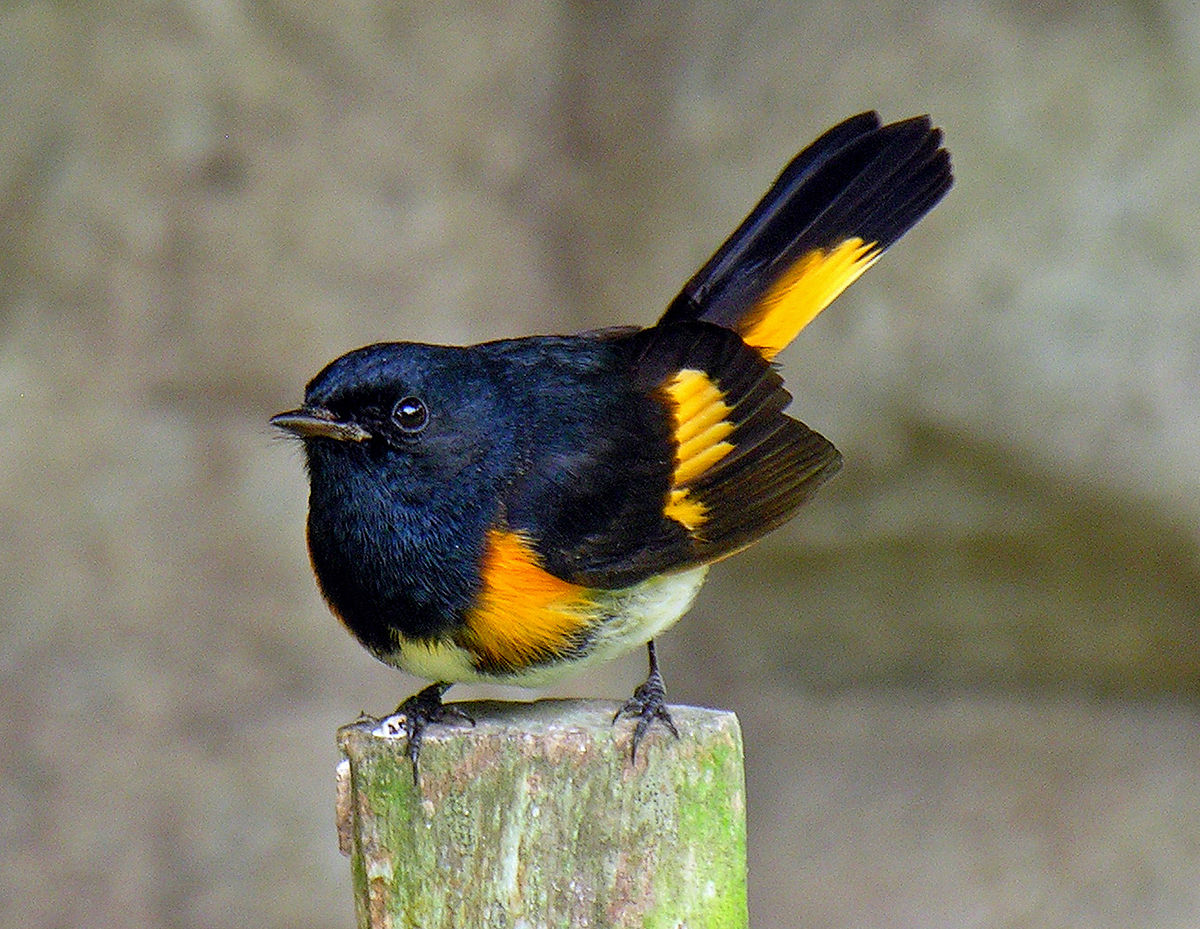
Wikipedia: American redstart
![]() The American redstart (Setophaga ruticilla) is a New World warbler. It is unrelated to the Old World (common) redstart.
[more]
The American redstart (Setophaga ruticilla) is a New World warbler. It is unrelated to the Old World (common) redstart.
[more]

Wikipedia: Pine warbler
![]() The pine warbler (Setophaga pinus) is a small songbird of the New World warbler family.
[more]
The pine warbler (Setophaga pinus) is a small songbird of the New World warbler family.
[more]
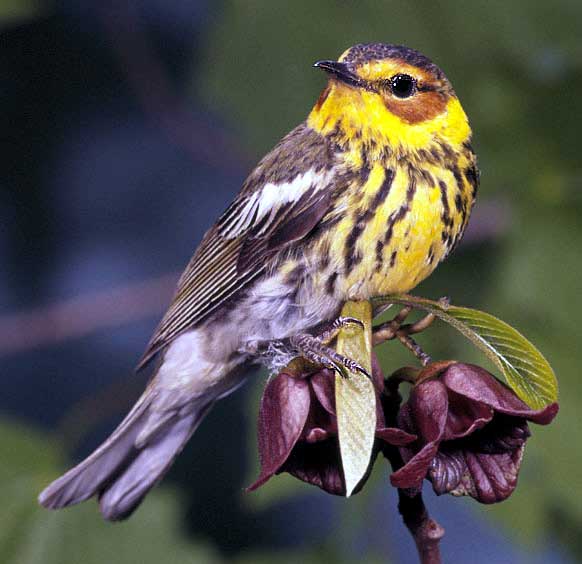
Wikipedia: Cape May warbler
![]() The Cape May warbler (Setophaga tigrina) is a species of New World warbler. It breeds in northern North America. Its breeding range spans all but the westernmost parts of southern Canada, the Great Lakes region, and New England. It is migratory, wintering in the West Indies. This species is a very rare vagrant to western Europe, with two records in Britain as of October 2013. The English name refers to Cape May, New Jersey, where George Ord collected the specimen later described by Alexander Wilson. This species was not recorded again in Cape May for another 100 years, although it is now known as an uncommon migrant there.[2]
[more]
The Cape May warbler (Setophaga tigrina) is a species of New World warbler. It breeds in northern North America. Its breeding range spans all but the westernmost parts of southern Canada, the Great Lakes region, and New England. It is migratory, wintering in the West Indies. This species is a very rare vagrant to western Europe, with two records in Britain as of October 2013. The English name refers to Cape May, New Jersey, where George Ord collected the specimen later described by Alexander Wilson. This species was not recorded again in Cape May for another 100 years, although it is now known as an uncommon migrant there.[2]
[more]

Wikipedia: Blackpoll warbler
![]() The blackpoll warbler (Setophaga striata) is a New World warbler. Breeding males are mostly black and white. They have a prominent black cap, white cheeks and white wing bars. The blackpoll breeds in forests of northern North America, from Alaska throughout most of Canada, to the mountains of New York and New England. They are a common migrant through much of North America. In fall, they fly south to the Greater Antilles and the northeastern coasts of South America in a non-stop long-distance migration over open water, averaging 2500 km, one of the longest distance non-stop overwater flights ever recorded for a migratory songbird. Rare vagrants to western Europe, they are one of the more frequent transatlantic passerine wanderers.
[more]
The blackpoll warbler (Setophaga striata) is a New World warbler. Breeding males are mostly black and white. They have a prominent black cap, white cheeks and white wing bars. The blackpoll breeds in forests of northern North America, from Alaska throughout most of Canada, to the mountains of New York and New England. They are a common migrant through much of North America. In fall, they fly south to the Greater Antilles and the northeastern coasts of South America in a non-stop long-distance migration over open water, averaging 2500 km, one of the longest distance non-stop overwater flights ever recorded for a migratory songbird. Rare vagrants to western Europe, they are one of the more frequent transatlantic passerine wanderers.
[more]
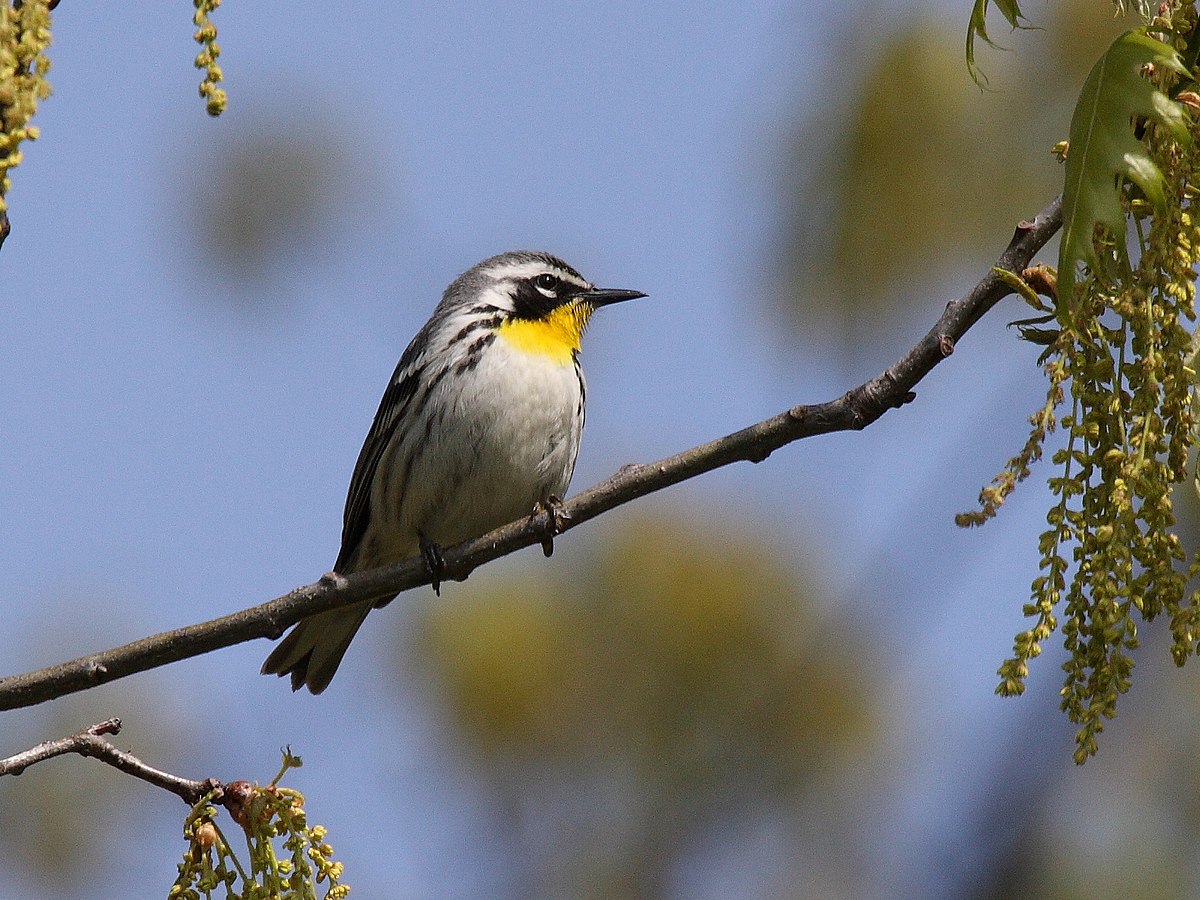
Wikipedia: Yellow-throated warbler
![]() The yellow-throated warbler (Setophaga dominica) is a small migratory songbird species breeding in temperate North America. It belongs to the New World warbler family (Parulidae).[2]
[more]
The yellow-throated warbler (Setophaga dominica) is a small migratory songbird species breeding in temperate North America. It belongs to the New World warbler family (Parulidae).[2]
[more]

Wikipedia: Hooded warbler
![]() The hooded warbler (Setophaga citrina) is a New World warbler. It breeds in eastern North America and across the eastern United States and into southernmost Canada (Ontario). It is migratory, wintering in Central America and the West Indies. Hooded warblers are very rare vagrants to western Europe.
[more]
The hooded warbler (Setophaga citrina) is a New World warbler. It breeds in eastern North America and across the eastern United States and into southernmost Canada (Ontario). It is migratory, wintering in Central America and the West Indies. Hooded warblers are very rare vagrants to western Europe.
[more]

Wikipedia: Prairie warbler
![]() The prairie warbler (Setophaga discolor) is a small songbird of the New World warbler family.
[more]
The prairie warbler (Setophaga discolor) is a small songbird of the New World warbler family.
[more]

Wikipedia: Magnolia warbler
![]() The magnolia warbler (Setophaga magnolia) is a member of the wood warbler family Parulidae.
[more]
The magnolia warbler (Setophaga magnolia) is a member of the wood warbler family Parulidae.
[more]

Wikipedia: Black-throated green warbler
![]() The black-throated green warbler (Setophaga virens) is a small songbird of the New World warbler family.
[more]
The black-throated green warbler (Setophaga virens) is a small songbird of the New World warbler family.
[more]
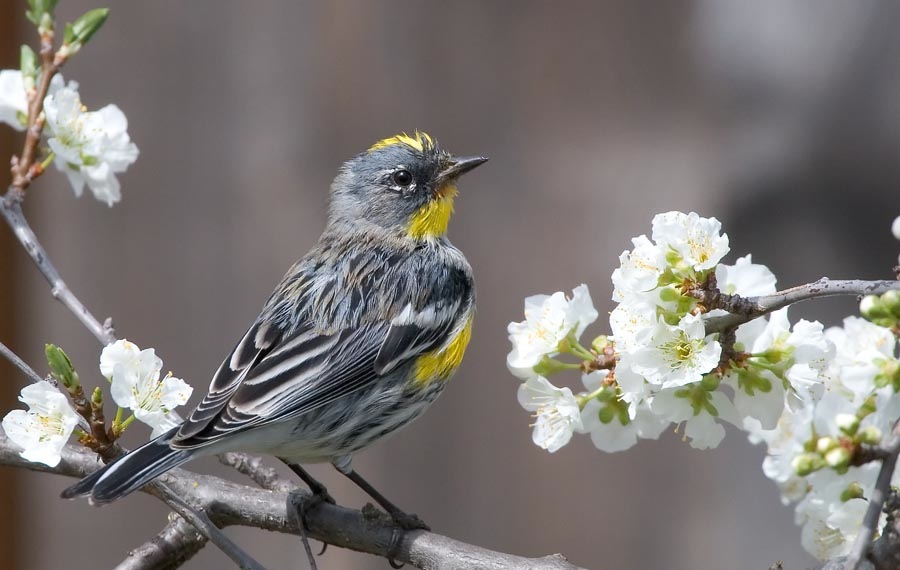
Wikipedia: Yellow-rumped warbler
![]() The yellow-rumped warbler (Setophaga coronata) is a regular North American bird species that can be commonly observed all across the continent. Its extensive distribution range connects both the Pacific and Atlantic coasts of the U.S. as well as Canada and Central America, with the population concentrating in the continent's northern parts during the breeding season and migrating southwards to southern North and Central America in Winter. The species generally prefers coniferous forests or mixed coniferous-deciduous forests as its breeding habitat, while during the winter it can be found inhabiting more open areas such as shrublands that offer food resources. The diet of the yellow-rumped warbler is based primarily on insects, though the species does eat fruits such as juniper berries as well, especially in winter.
[more]
The yellow-rumped warbler (Setophaga coronata) is a regular North American bird species that can be commonly observed all across the continent. Its extensive distribution range connects both the Pacific and Atlantic coasts of the U.S. as well as Canada and Central America, with the population concentrating in the continent's northern parts during the breeding season and migrating southwards to southern North and Central America in Winter. The species generally prefers coniferous forests or mixed coniferous-deciduous forests as its breeding habitat, while during the winter it can be found inhabiting more open areas such as shrublands that offer food resources. The diet of the yellow-rumped warbler is based primarily on insects, though the species does eat fruits such as juniper berries as well, especially in winter.
[more]

Wikipedia: Black-throated blue warbler
![]() The black-throated blue warbler (Setophaga caerulescens) is a small passerine bird of the New World warbler family. Its breeding ranges are located in the interior of deciduous and mixed coniferous forests in eastern North America. Over the cooler months, it migrates to islands in the Caribbean and Central America. It is very rarely found in western Europe, where it is considered to be a non-indigenous species. The black-throated blue warbler is sexually dimorphic; the adult male has a black face and cheeks, deep blue upperparts and white underparts, while the adult female is olive-brown above and light yellow below.
[more]
The black-throated blue warbler (Setophaga caerulescens) is a small passerine bird of the New World warbler family. Its breeding ranges are located in the interior of deciduous and mixed coniferous forests in eastern North America. Over the cooler months, it migrates to islands in the Caribbean and Central America. It is very rarely found in western Europe, where it is considered to be a non-indigenous species. The black-throated blue warbler is sexually dimorphic; the adult male has a black face and cheeks, deep blue upperparts and white underparts, while the adult female is olive-brown above and light yellow below.
[more]

Wikipedia: Cerulean warbler
![]() The cerulean warbler (Setophaga cerulea) is a small songbird of the New World warbler family.
Adult males have pale cerulean blue and white upperparts with a black necklace across the breast and black streaks on the back and flanks. Females and immature birds have greyer or greenish upperparts, a pale stripe over the eye, and no streaking on the back and no neck. All of these birds have wing bars and a thin pointed bill.
They are found in deciduous forests of eastern North America during the breeding season and then migrate to forested mountain areas in South America.
The species is considered threatened with an IUCN status of near threatened, indicating it does not face any imminent threat of extinction in the wild.
[more]
The cerulean warbler (Setophaga cerulea) is a small songbird of the New World warbler family.
Adult males have pale cerulean blue and white upperparts with a black necklace across the breast and black streaks on the back and flanks. Females and immature birds have greyer or greenish upperparts, a pale stripe over the eye, and no streaking on the back and no neck. All of these birds have wing bars and a thin pointed bill.
They are found in deciduous forests of eastern North America during the breeding season and then migrate to forested mountain areas in South America.
The species is considered threatened with an IUCN status of near threatened, indicating it does not face any imminent threat of extinction in the wild.
[more]

Wikipedia: Chestnut-sided warbler
![]() The chestnut-sided warbler (Setophaga pensylvanica) is a New World warbler. They breed in eastern North America and in southern Canada westwards to the Canadian Prairies. They also breed in the Great Lakes region and in the eastern United States.
[more]
The chestnut-sided warbler (Setophaga pensylvanica) is a New World warbler. They breed in eastern North America and in southern Canada westwards to the Canadian Prairies. They also breed in the Great Lakes region and in the eastern United States.
[more]

Wikipedia: Townsend's warbler
![]() Townsend's warbler (Setophaga townsendi) is a small songbird of the New World warbler family.
[more]
Townsend's warbler (Setophaga townsendi) is a small songbird of the New World warbler family.
[more]

Wikipedia: Northern parula
![]() The northern parula (Setophaga americana) is a small New World warbler. It breeds in eastern North America from southern Canada to Florida.[2]
[more]
The northern parula (Setophaga americana) is a small New World warbler. It breeds in eastern North America from southern Canada to Florida.[2]
[more]

Wikipedia: Palm warbler
![]() The palm warbler (Setophaga palmarum) is a small songbird of the New World warbler family.
[more]
The palm warbler (Setophaga palmarum) is a small songbird of the New World warbler family.
[more]

Wikipedia: Tropical parula
![]() The tropical parula (Setophaga pitiayumi) is a small New World warbler. It breeds from southernmost Texas and northwest Mexico (Sonora) south through Central America to northern Argentina, including Trinidad and Tobago. This widespread and common species is not considered threatened by the IUCN.[1]
[more]
The tropical parula (Setophaga pitiayumi) is a small New World warbler. It breeds from southernmost Texas and northwest Mexico (Sonora) south through Central America to northern Argentina, including Trinidad and Tobago. This widespread and common species is not considered threatened by the IUCN.[1]
[more]

Wikipedia: Bay-breasted warbler
![]() The Bay-breasted Warbler (Setophaga castanea) is a small species of songbird in the New World warbler family, Parulidae. It is one of thirty-four species in the diverse genus Setophaga.[2] Like all songbirds, or passerines, the species is classified in the order Passeriformes.
[more]
The Bay-breasted Warbler (Setophaga castanea) is a small species of songbird in the New World warbler family, Parulidae. It is one of thirty-four species in the diverse genus Setophaga.[2] Like all songbirds, or passerines, the species is classified in the order Passeriformes.
[more]

Wikipedia: Yellow warbler
![]() About 35 (but see text)
[more]
About 35 (but see text)
[more]
Profil Wikipedia Xeno-Canto

Wikipedia: Magnolia warbler
![]() The magnolia warbler (Setophaga magnolia) is a member of the wood warbler family Parulidae.
[more]
The magnolia warbler (Setophaga magnolia) is a member of the wood warbler family Parulidae.
[more]
Profil Wikipedia Xeno-Canto

Wikipedia: Golden-cheeked warbler
![]() The golden-cheeked warbler (Setophaga chrysoparia [formerly Dendroica chrysoparia]), also known as the gold finch of Texas, is an endangered species of bird that breeds in Central Texas, from Palo Pinto County southwestward along the eastern and southern edge of the Edwards Plateau to Kinney County. The golden-cheeked warbler is the only bird species with a breeding range confined to Texas.
[more]
The golden-cheeked warbler (Setophaga chrysoparia [formerly Dendroica chrysoparia]), also known as the gold finch of Texas, is an endangered species of bird that breeds in Central Texas, from Palo Pinto County southwestward along the eastern and southern edge of the Edwards Plateau to Kinney County. The golden-cheeked warbler is the only bird species with a breeding range confined to Texas.
[more]
Profil Wikipedia Xeno-Canto

Wikipedia: Wrenthrush
![]() The wrenthrush or zeledonia (Zeledonia coronata) is a species of nine-primaried oscine which is endemic to Costa Rica and western Panama. The species was first described by Robert Ridgway in 1907.[2] Neither a wren nor a thrush (and unrelated to both), it has a short tail, rounded wings and elongated tarsi.
[more]
The wrenthrush or zeledonia (Zeledonia coronata) is a species of nine-primaried oscine which is endemic to Costa Rica and western Panama. The species was first described by Robert Ridgway in 1907.[2] Neither a wren nor a thrush (and unrelated to both), it has a short tail, rounded wings and elongated tarsi.
[more]

Wikipedia: Northern waterthrush
![]() The northern waterthrush (Parkesia noveboracensis[2]) is one of the larger New World warblers and one of the Nearctic-Neotropical migratory songbirds.[3] It breeds in the northern part of North America in Canada and the northern United States including Alaska. This bird is migratory, wintering in Central America, the West Indies and Florida, as well as in Venezuela, Colombia, and Ecuador. It is a very rare vagrant to other South American countries and to western Europe.
[more]
The northern waterthrush (Parkesia noveboracensis[2]) is one of the larger New World warblers and one of the Nearctic-Neotropical migratory songbirds.[3] It breeds in the northern part of North America in Canada and the northern United States including Alaska. This bird is migratory, wintering in Central America, the West Indies and Florida, as well as in Venezuela, Colombia, and Ecuador. It is a very rare vagrant to other South American countries and to western Europe.
[more]

Wikipedia: Nashville warbler
![]() The Nashville warbler (Leiothlypis ruficapilla) is a small songbird in the New World warbler family, found in North and Central America. It breeds in parts of the northern and western United States and southern Canada, and migrates to winter in southern California and Texas, Mexico, and the north of Central America. It has a gray head and a green back, and its underparts are yellow and white.
[more]
The Nashville warbler (Leiothlypis ruficapilla) is a small songbird in the New World warbler family, found in North and Central America. It breeds in parts of the northern and western United States and southern Canada, and migrates to winter in southern California and Texas, Mexico, and the north of Central America. It has a gray head and a green back, and its underparts are yellow and white.
[more]

Wikipedia: Orange-crowned warbler
![]() The orange-crowned warbler (Leiothlypis celata) is a small songbird of the New World warbler family.
[more]
The orange-crowned warbler (Leiothlypis celata) is a small songbird of the New World warbler family.
[more]

Wikipedia: Tennessee warbler
![]() The Tennessee warbler (Leiothlypis peregrina) is a New World warbler that breeds in eastern North America and winters in southern Central America, the Caribbean, and northern South America. The specific name peregrina is from Latin peregrinus "wanderer".[2]
[more]
The Tennessee warbler (Leiothlypis peregrina) is a New World warbler that breeds in eastern North America and winters in southern Central America, the Caribbean, and northern South America. The specific name peregrina is from Latin peregrinus "wanderer".[2]
[more]
Profil Wikipedia Xeno-Canto

Wikipedia: Flame-throated warbler
![]() The flame-throated warbler (Oreothlypis gutturalis) is a small New World warbler. It is sometimes placed in the genera Vermivora and Parula.
[more]
The flame-throated warbler (Oreothlypis gutturalis) is a small New World warbler. It is sometimes placed in the genera Vermivora and Parula.
[more]
Profil Wikipedia Xeno-Canto
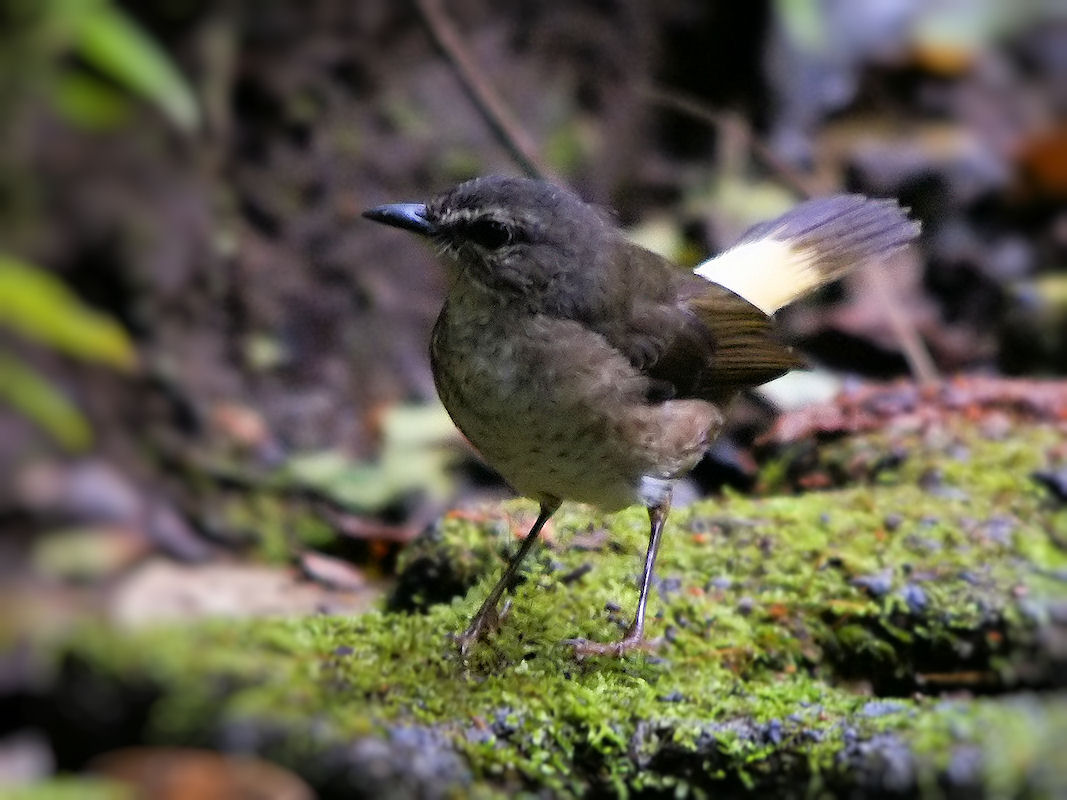
Wikipedia: Buff-rumped warbler
![]() The buff-rumped warbler (Myiothlypis fulvicauda) is a New World warbler that is resident from Honduras south to northwestern Peru and disjunctly in the western Amazon. It is found in forests at up to 1500 m altitude, always near water.
[more]
The buff-rumped warbler (Myiothlypis fulvicauda) is a New World warbler that is resident from Honduras south to northwestern Peru and disjunctly in the western Amazon. It is found in forests at up to 1500 m altitude, always near water.
[more]
Familie Cotingidae:
Gattung Carpodectes:
Carpodectes antoniae / Yellow-billed cotinga (Carpodectes antoniae)
Profil Wikipedia Xeno-Canto

Wikipedia: Yellow-billed cotinga
![]() The yellow-billed cotinga (Carpodectes antoniae) is a species of bird in the family Cotingidae. It is found in the Pacific lowlands of Costa Rica and Panama. Its natural habitats are subtropical or tropical moist lowland forest, subtropical or tropical mangrove forest, and subtropical or tropical moist shrubland. It is threatened by habitat destruction.
[more]
The yellow-billed cotinga (Carpodectes antoniae) is a species of bird in the family Cotingidae. It is found in the Pacific lowlands of Costa Rica and Panama. Its natural habitats are subtropical or tropical moist lowland forest, subtropical or tropical mangrove forest, and subtropical or tropical moist shrubland. It is threatened by habitat destruction.
[more]
Carpodectes hopkei / Black-tipped cotinga (Carpodectes hopkei)
Profil Wikipedia Xeno-Canto

Wikipedia: Black-tipped cotinga
![]() The black-tipped cotinga (Carpodectes hopkei), also known as the white cotinga, is a species of bird in the family Cotingidae. It is found in the Chocó region, from southeastern Panama to northwestern Ecuador ; its natural habitat is subtropical or tropical moist lowland forests. The male, being white, is conspicuous, but in general it is an uncommon species.
[more]
The black-tipped cotinga (Carpodectes hopkei), also known as the white cotinga, is a species of bird in the family Cotingidae. It is found in the Chocó region, from southeastern Panama to northwestern Ecuador ; its natural habitat is subtropical or tropical moist lowland forests. The male, being white, is conspicuous, but in general it is an uncommon species.
[more]
Gattung Cephalopterus:
Cephalopterus glabricollis / Bare-necked umbrellabird (Cephalopterus glabricollis)
Profil Wikipedia Xeno-Canto
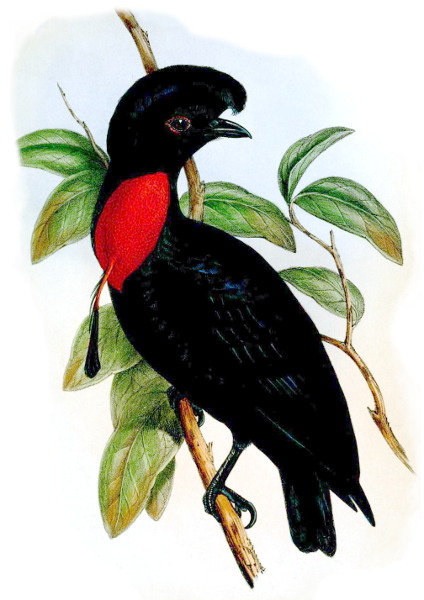
Wikipedia: Bare-necked umbrellabird
![]() The bare-necked umbrellabird (Cephalopterus glabricollis) is a species of bird in the family Cotingidae. It is found in the Talamancan montane forests of Costa Rica and Panama. Umbrellabird populations moved from highlands to lowlands and vice versa, as was proposed by Stiles (1985, 1988), and supported previous observations that male umbrellabirds return to the same breeding area every year. Bare-necked umbrellabirds live only in forests and their diet consists mainly of fruits.
[more]
The bare-necked umbrellabird (Cephalopterus glabricollis) is a species of bird in the family Cotingidae. It is found in the Talamancan montane forests of Costa Rica and Panama. Umbrellabird populations moved from highlands to lowlands and vice versa, as was proposed by Stiles (1985, 1988), and supported previous observations that male umbrellabirds return to the same breeding area every year. Bare-necked umbrellabirds live only in forests and their diet consists mainly of fruits.
[more]
Gattung Cotinga:
Cotinga amabilis / Lovely cotinga (Cotinga amabilis)
Profil Wikipedia Xeno-Canto
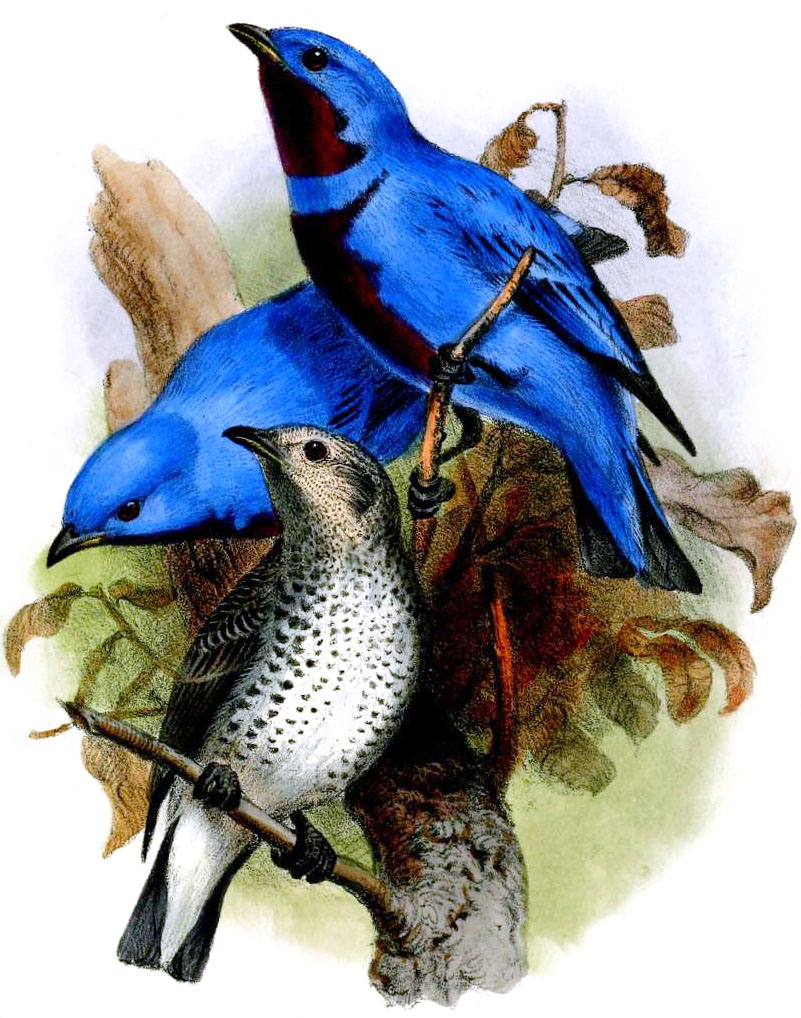
Wikipedia: Lovely cotinga
![]() The lovely cotinga (Cotinga amabilis) is a species of bird in the family Cotingidae. It is found in North and Central America from southern Mexico through Guatemala, Belize, Honduras and Nicaragua to Costa Rica with reports from western Panama. Its natural habitats are tropical moist lowland forests and heavily degraded former forest. The male is a bright turquoise blue while the female is greyish-brown with pale underparts. Because of its total population size and wide range, this species is not yet considered vulnerable.[2]
[more]
The lovely cotinga (Cotinga amabilis) is a species of bird in the family Cotingidae. It is found in North and Central America from southern Mexico through Guatemala, Belize, Honduras and Nicaragua to Costa Rica with reports from western Panama. Its natural habitats are tropical moist lowland forests and heavily degraded former forest. The male is a bright turquoise blue while the female is greyish-brown with pale underparts. Because of its total population size and wide range, this species is not yet considered vulnerable.[2]
[more]
Cotinga ridgwayi / Turquoise cotinga (Cotinga ridgwayi)

Wikipedia: Turquoise cotinga
![]() The turquoise cotinga or Ridgway's cotinga (Cotinga ridgwayi) is a species of bird in the family Cotingidae. It is found in Costa Rica and western Panama. Its natural habitats are tropical moist forests and plantations from the lowlands into lower mountain regions. It is threatened by deforestation.
[more]
The turquoise cotinga or Ridgway's cotinga (Cotinga ridgwayi) is a species of bird in the family Cotingidae. It is found in Costa Rica and western Panama. Its natural habitats are tropical moist forests and plantations from the lowlands into lower mountain regions. It is threatened by deforestation.
[more]
Nördliche Prachtkotinga / Blue cotinga (Cotinga nattererii)
Profil Wikipedia Xeno-Canto

Wikipedia: Blue cotinga
![]() The blue cotinga (Cotinga nattererii) is a species of bird in the family Cotingidae. It is found in Colombia, north-west Ecuador, eastern and central Panama and western Venezuela in tropical moist lowland forests and heavily degraded former forest. In relation to range and population size this species is not considered to be vulnerable.[2]
[more]
The blue cotinga (Cotinga nattererii) is a species of bird in the family Cotingidae. It is found in Colombia, north-west Ecuador, eastern and central Panama and western Venezuela in tropical moist lowland forests and heavily degraded former forest. In relation to range and population size this species is not considered to be vulnerable.[2]
[more]
Gattung Lipaugus:
Lipaugus unirufus / Rufous piha (Lipaugus unirufus)
Profil Wikipedia Xeno-Canto

Wikipedia: Rufous piha
![]() The rufous piha (Lipaugus unirufus) is a species of bird in the family Cotingidae.
It is found in Belize, Colombia, Costa Rica, Ecuador, Guatemala, Honduras, Mexico, Nicaragua, and Panama. Its natural habitat is subtropical or tropical moist lowland forests.[1]
[more]
The rufous piha (Lipaugus unirufus) is a species of bird in the family Cotingidae.
It is found in Belize, Colombia, Costa Rica, Ecuador, Guatemala, Honduras, Mexico, Nicaragua, and Panama. Its natural habitat is subtropical or tropical moist lowland forests.[1]
[more]
Gattung Oxyruncus:
Flammenkopfbekarde / Sharpbill (Oxyruncus cristatus)

Wikipedia: Sharpbill
![]() The sharpbill (Oxyruncus cristatus) is a small passerine bird in the family Tityridae. Its range is from the mountainous areas of tropical South America and southern Central America (Panama and Costa Rica).
[more]
The sharpbill (Oxyruncus cristatus) is a small passerine bird in the family Tityridae. Its range is from the mountainous areas of tropical South America and southern Central America (Panama and Costa Rica).
[more]
Gattung Procnias:
Procnias tricarunculatus / Three-wattled bellbird (Procnias tricarunculatus)

Wikipedia: Three-wattled bellbird
![]() The three-wattled bellbird (Procnias tricarunculatus) is a Central American migratory bird of the cotinga family. The sexes are very dis-similar in appearance. The male has a white head and throat and the remaining plumage is chestnut brown. From the base of his beak dangle three long, slender, black wattles that he uses in display. The female has olive plumage with yellowish streaked underparts and a yellow vent area.
[more]
The three-wattled bellbird (Procnias tricarunculatus) is a Central American migratory bird of the cotinga family. The sexes are very dis-similar in appearance. The male has a white head and throat and the remaining plumage is chestnut brown. From the base of his beak dangle three long, slender, black wattles that he uses in display. The female has olive plumage with yellowish streaked underparts and a yellow vent area.
[more]
Gattung Querula:
Querula purpurata / Purple-throated fruitcrow (Querula purpurata)
Profil Wikipedia Xeno-Canto

Wikipedia: Purple-throated fruitcrow
![]() The purple-throated fruitcrow (Querula purpurata) is a species of bird in the family Cotingidae, the cotingas. It is the only species of the genus Querula.[2] It is native to Nicaragua, Costa Rica and Panama and most of the northern half of South America, its habitat being humid lowland forest where it feeds mainly on insects and fruit. It is a glossy black, medium-sized bird and the male has a purple-red throat patch. It nests in close vicinity with other birds of its species. Its population is in decline, but it is a common species with a very wide range, and the International Union for Conservation of Nature has assessed its conservation status as being of "least concern".
[more]
The purple-throated fruitcrow (Querula purpurata) is a species of bird in the family Cotingidae, the cotingas. It is the only species of the genus Querula.[2] It is native to Nicaragua, Costa Rica and Panama and most of the northern half of South America, its habitat being humid lowland forest where it feeds mainly on insects and fruit. It is a glossy black, medium-sized bird and the male has a purple-red throat patch. It nests in close vicinity with other birds of its species. Its population is in decline, but it is a common species with a very wide range, and the International Union for Conservation of Nature has assessed its conservation status as being of "least concern".
[more]
Familie Furnariidae:
Gattung Cranioleuca:
Cranioleuca erythrops / Red-faced spinetail (Cranioleuca erythrops)
Profil Wikipedia Xeno-Canto
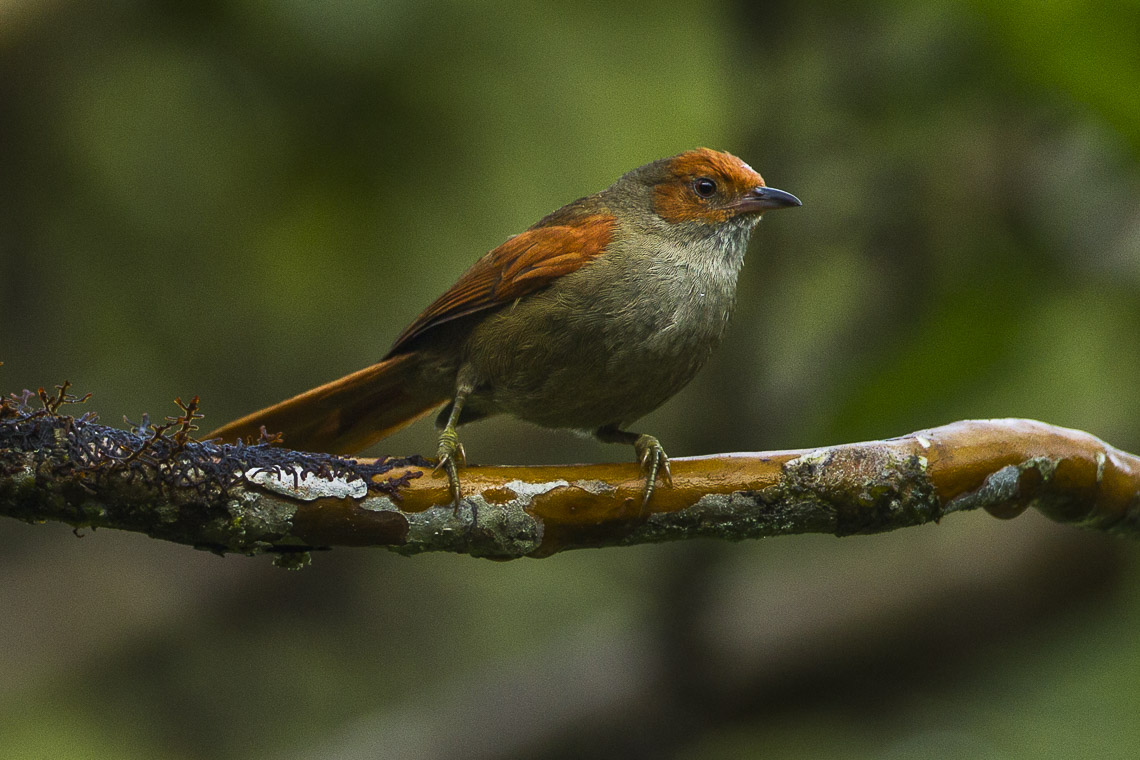
Wikipedia: Red-faced spinetail
![]() The red-faced spinetail (Cranioleuca erythrops) is a species of bird in the family Furnariidae. It is found in Colombia, Costa Rica, Ecuador, and Panama. Its natural habitat is subtropical or tropical moist montane forest.
[more]
The red-faced spinetail (Cranioleuca erythrops) is a species of bird in the family Furnariidae. It is found in Colombia, Costa Rica, Ecuador, and Panama. Its natural habitat is subtropical or tropical moist montane forest.
[more]
Gattung Synallaxis:
Synallaxis brachyura / Slaty spinetail (Synallaxis brachyura)
Profil Wikipedia Xeno-Canto

Wikipedia: Slaty spinetail
![]() The slaty spinetail or slaty castlebuilder, (Synallaxis brachyura), is a passerine bird which breeds in the tropical New World from northern Honduras to western Ecuador and east-central Brazil.
[more]
The slaty spinetail or slaty castlebuilder, (Synallaxis brachyura), is a passerine bird which breeds in the tropical New World from northern Honduras to western Ecuador and east-central Brazil.
[more]
Synallaxis albescens / Pale-breasted spinetail (Synallaxis albescens)
Profil Wikipedia Xeno-Canto

Wikipedia: Pale-breasted spinetail
![]() The pale-breasted spinetail (Synallaxis albescens), is a passerine bird which breeds in the tropical New World from Costa Rica to Uruguay,[2] and in Trinidad.
[more]
The pale-breasted spinetail (Synallaxis albescens), is a passerine bird which breeds in the tropical New World from Costa Rica to Uruguay,[2] and in Trinidad.
[more]
Gattung Glyphorynchus:
Glyphorynchus spirurus / Wedge-billed woodcreeper (Glyphorynchus spirurus)
Profil Wikipedia Xeno-Canto

Wikipedia: Wedge-billed woodcreeper
![]() The wedge-billed woodcreeper (Glyphorynchus spirurus), is a passerine bird which breeds in the tropical New World from southern Mexico to northern Bolivia, central Brazil and the Guianas; it is absent from the Pacific coastal areas except between Costa Rica and Ecuador. It is the only member of the genus Glyphorynchus.
[more]
The wedge-billed woodcreeper (Glyphorynchus spirurus), is a passerine bird which breeds in the tropical New World from southern Mexico to northern Bolivia, central Brazil and the Guianas; it is absent from the Pacific coastal areas except between Costa Rica and Ecuador. It is the only member of the genus Glyphorynchus.
[more]
Gattung Lochmias:
Lochmias nematura / Sharp-tailed streamcreeper (Lochmias nematura)
Profil Wikipedia Xeno-Canto

Wikipedia: Sharp-tailed streamcreeper
![]() The sharp-tailed streamcreeper (Lochmias nematura) is a passerine bird of South America belonging to the family Furnariidae, the ovenbirds. It is the only member of the genus Lochmias. The species is also known as the streamside streamcreeper.[2]
[more]
The sharp-tailed streamcreeper (Lochmias nematura) is a passerine bird of South America belonging to the family Furnariidae, the ovenbirds. It is the only member of the genus Lochmias. The species is also known as the streamside streamcreeper.[2]
[more]
Gattung Thripadectes:
Thripadectes rufobrunneus / Streak-breasted treehunter (Thripadectes rufobrunneus)
Profil Wikipedia Xeno-Canto

Wikipedia: Streak-breasted treehunter
![]() The streak-breasted treehunter (Thripadectes rufobrunneus) is a passerine bird in the ovenbird family Furnariidae. It is endemic to the Talamancan montane forests of Costa Rica and western Panama in Central America.
[more]
The streak-breasted treehunter (Thripadectes rufobrunneus) is a passerine bird in the ovenbird family Furnariidae. It is endemic to the Talamancan montane forests of Costa Rica and western Panama in Central America.
[more]
Gattung Philydor:
Philydor fuscipenne / Slaty-winged foliage-gleaner (Philydor fuscipenne)
Profil Wikipedia Xeno-Canto

Wikipedia: Slaty-winged foliage-gleaner
![]() The slaty-winged foliage-gleaner (Philydor fuscipenne) is a perching bird species in the ovenbird family (Furnariidae).
[more]
The slaty-winged foliage-gleaner (Philydor fuscipenne) is a perching bird species in the ovenbird family (Furnariidae).
[more]
Gattung Sclerurus:
Sclerurus mexicanus / Tawny-throated leaftosser (Sclerurus mexicanus)
Profil Wikipedia Xeno-Canto

Wikipedia: Tawny-throated leaftosser
![]() The tawny-throated leaftosser (Sclerurus mexicanus) is a tropical American bird species in the ovenbird family Furnariidae. It is also known as the tawny-throated leafscraper, Mexican leaftosser or Mexican leafscraper. This bird might be a cryptic species complex.[2]
[more]
The tawny-throated leaftosser (Sclerurus mexicanus) is a tropical American bird species in the ovenbird family Furnariidae. It is also known as the tawny-throated leafscraper, Mexican leaftosser or Mexican leafscraper. This bird might be a cryptic species complex.[2]
[more]
Sclerurus guatemalensis / Scaly-throated leaftosser (Sclerurus guatemalensis)
Profil Wikipedia Xeno-Canto
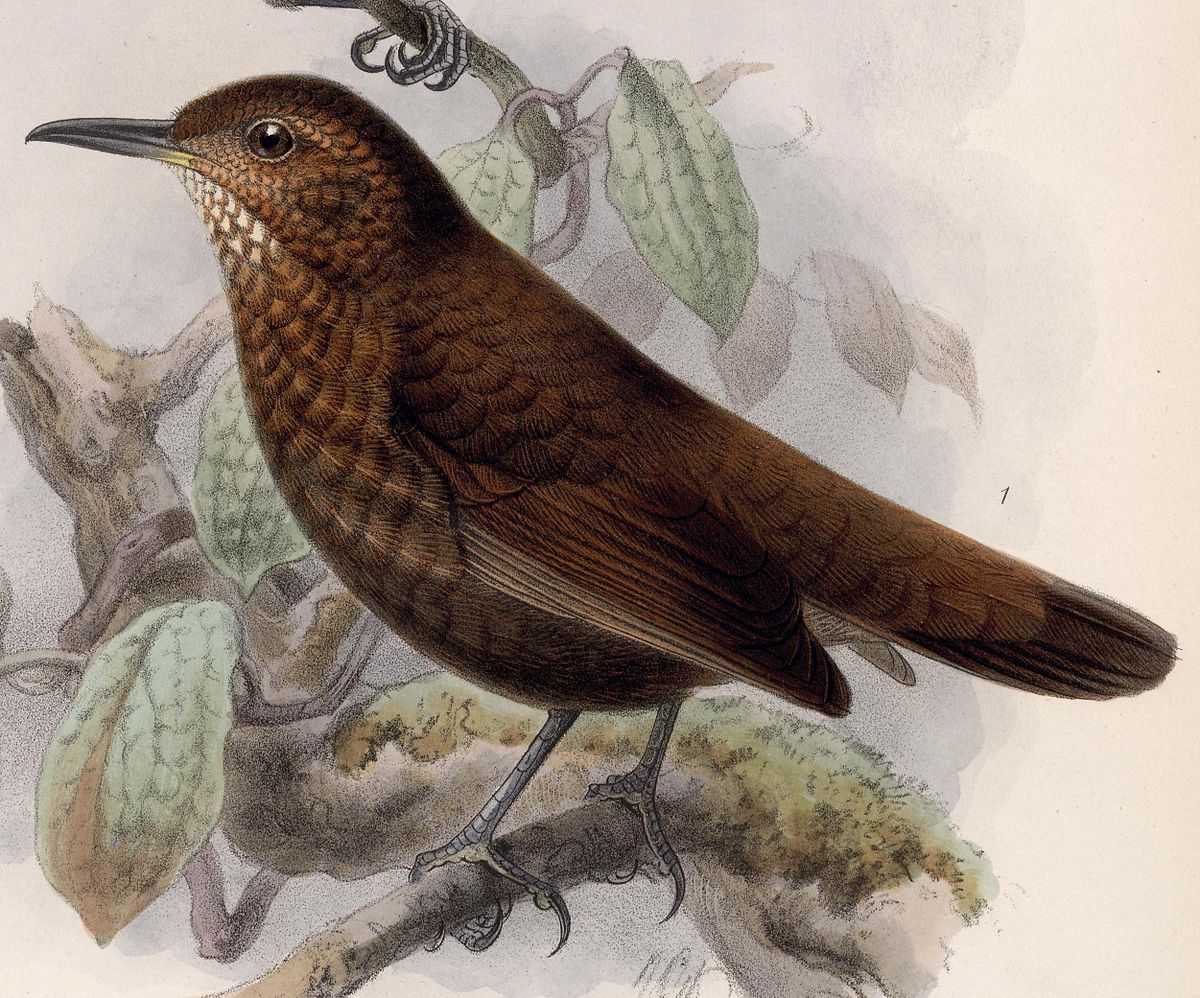
Wikipedia: Scaly-throated leaftosser
![]() The scaly-throated leaftosser (Sclerurus guatemalensis) is a species of bird in the family Furnariidae. It is found in Belize, Colombia, Costa Rica, Ecuador, Guatemala, Honduras, Mexico, Nicaragua, and Panama. Its natural habitats are subtropical or tropical moist lowland forest and subtropical or tropical moist montane forest.
[more]
The scaly-throated leaftosser (Sclerurus guatemalensis) is a species of bird in the family Furnariidae. It is found in Belize, Colombia, Costa Rica, Ecuador, Guatemala, Honduras, Mexico, Nicaragua, and Panama. Its natural habitats are subtropical or tropical moist lowland forest and subtropical or tropical moist montane forest.
[more]
Sclerurus albigularis / Gray-throated leaftosser (Sclerurus albigularis)
Profil Wikipedia Xeno-Canto

Wikipedia: Gray-throated leaftosser
![]() The grey-throated leaftosser (Sclerurus albigularis) is a species of bird in the family Furnariidae. It is found in Bolivia, Brazil, Colombia, Costa Rica, Ecuador, Panama, Peru, Trinidad and Tobago, and Venezuela. Its natural habitats are subtropical or tropical moist lowland forest and subtropical or tropical moist montane forest.
[more]
The grey-throated leaftosser (Sclerurus albigularis) is a species of bird in the family Furnariidae. It is found in Bolivia, Brazil, Colombia, Costa Rica, Ecuador, Panama, Peru, Trinidad and Tobago, and Venezuela. Its natural habitats are subtropical or tropical moist lowland forest and subtropical or tropical moist montane forest.
[more]
Gattung Automolus:
Automolus exsertus / Chiriqui foliage-gleaner (Automolus exsertus)
Profil Wikipedia Xeno-Canto

Wikipedia: Chiriqui foliage-gleaner
![]() The Chiriqui foliage-gleaner (Automolus exsertus) is a species of bird in the family Furnariidae.
[more]
The Chiriqui foliage-gleaner (Automolus exsertus) is a species of bird in the family Furnariidae.
[more]
Automolus subulatus / Striped woodhaunter (Automolus subulatus)
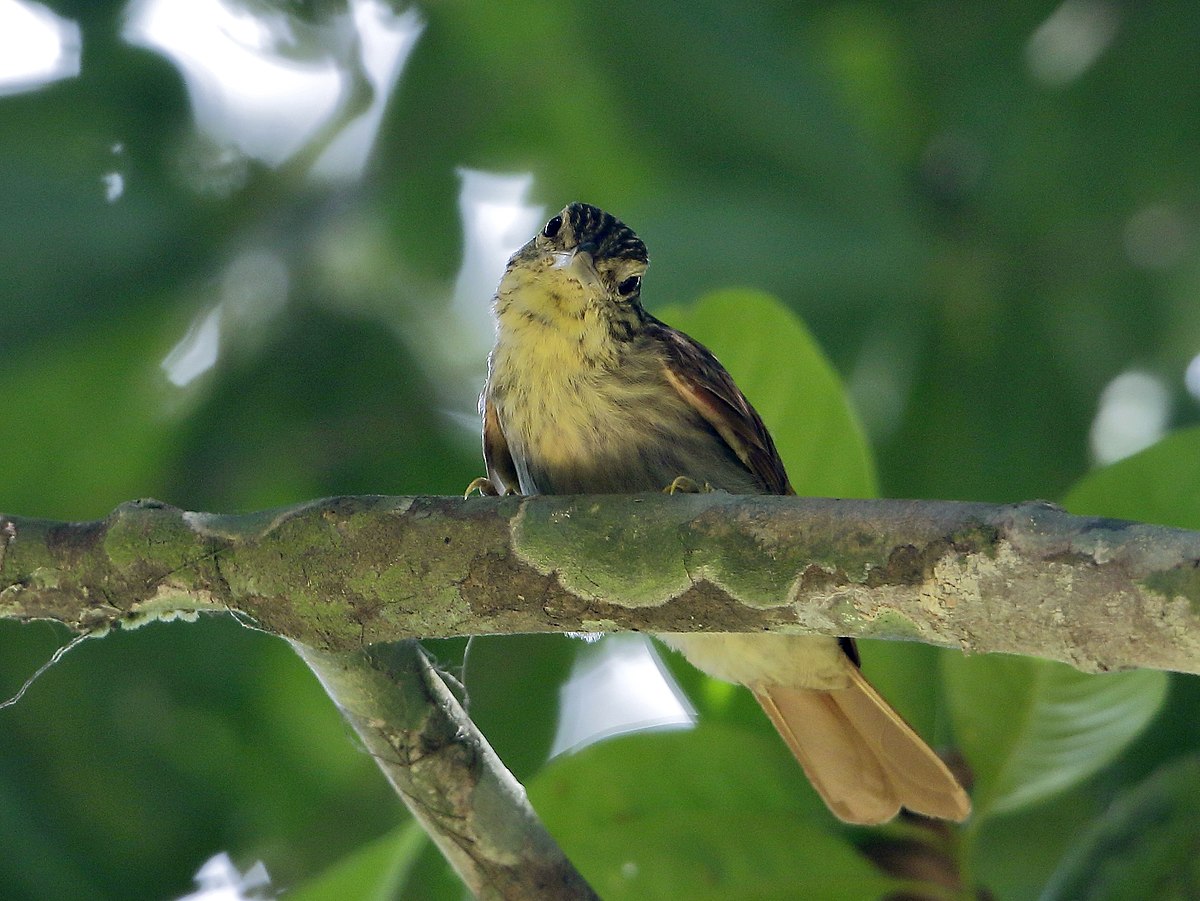
Wikipedia: Striped woodhaunter
![]() The eastern woodhaunter (Automolus subulatus), also known as the Amazonian woodhaunter, is a species of bird in the family Furnariidae. It was formerly treated as conspecific with the western woodhaunter and when lumped had the name "striped woodhaunter". It is found in the western part of the Amazon rainforest: west Brazil, southeast Colombia, east Ecuador, northeast Peru, south Venezuela and north Bolivia. Its natural habitats are subtropical or tropical moist lowland forests and subtropical or tropical moist montane forests. The species nests in earth tunnels.[3]
[more]
The eastern woodhaunter (Automolus subulatus), also known as the Amazonian woodhaunter, is a species of bird in the family Furnariidae. It was formerly treated as conspecific with the western woodhaunter and when lumped had the name "striped woodhaunter". It is found in the western part of the Amazon rainforest: west Brazil, southeast Colombia, east Ecuador, northeast Peru, south Venezuela and north Bolivia. Its natural habitats are subtropical or tropical moist lowland forests and subtropical or tropical moist montane forests. The species nests in earth tunnels.[3]
[more]
Automolus ochrolaemus / Buff-throated foliage-gleaner (Automolus ochrolaemus)

Wikipedia: Buff-throated foliage-gleaner
![]() The buff-throated foliage-gleaner (Automolus ochrolaemus) is a species of bird in the family Furnariidae.
[more]
The buff-throated foliage-gleaner (Automolus ochrolaemus) is a species of bird in the family Furnariidae.
[more]
Gattung Xenops:
Xenops rutilans / Streaked xenops (Xenops rutilans)
Profil Wikipedia Xeno-Canto

Wikipedia: Streaked xenops
![]() The streaked xenops (Xenops rutilans) is a passerine bird which breeds in the tropical New World from Costa Rica and Trinidad south to Bolivia and northern Argentina. Like the closely related true woodcreepers, it is a member of the South American bird family Furnariidae.
[more]
The streaked xenops (Xenops rutilans) is a passerine bird which breeds in the tropical New World from Costa Rica and Trinidad south to Bolivia and northern Argentina. Like the closely related true woodcreepers, it is a member of the South American bird family Furnariidae.
[more]
Xenops minutus / Plain xenops (Xenops minutus)
Profil Wikipedia Xeno-Canto

Wikipedia: Plain xenops
![]() The plain xenops (Xenops minutus) is a passerine bird which breeds in moist lowland forests in the tropical New World from southern Mexico south to western Ecuador, northeastern Argentina and central Brazil.
[more]
The plain xenops (Xenops minutus) is a passerine bird which breeds in moist lowland forests in the tropical New World from southern Mexico south to western Ecuador, northeastern Argentina and central Brazil.
[more]
Gattung Premnoplex:
Premnoplex brunnescens / Spotted barbtail (Premnoplex brunnescens)
Profil Wikipedia Xeno-Canto
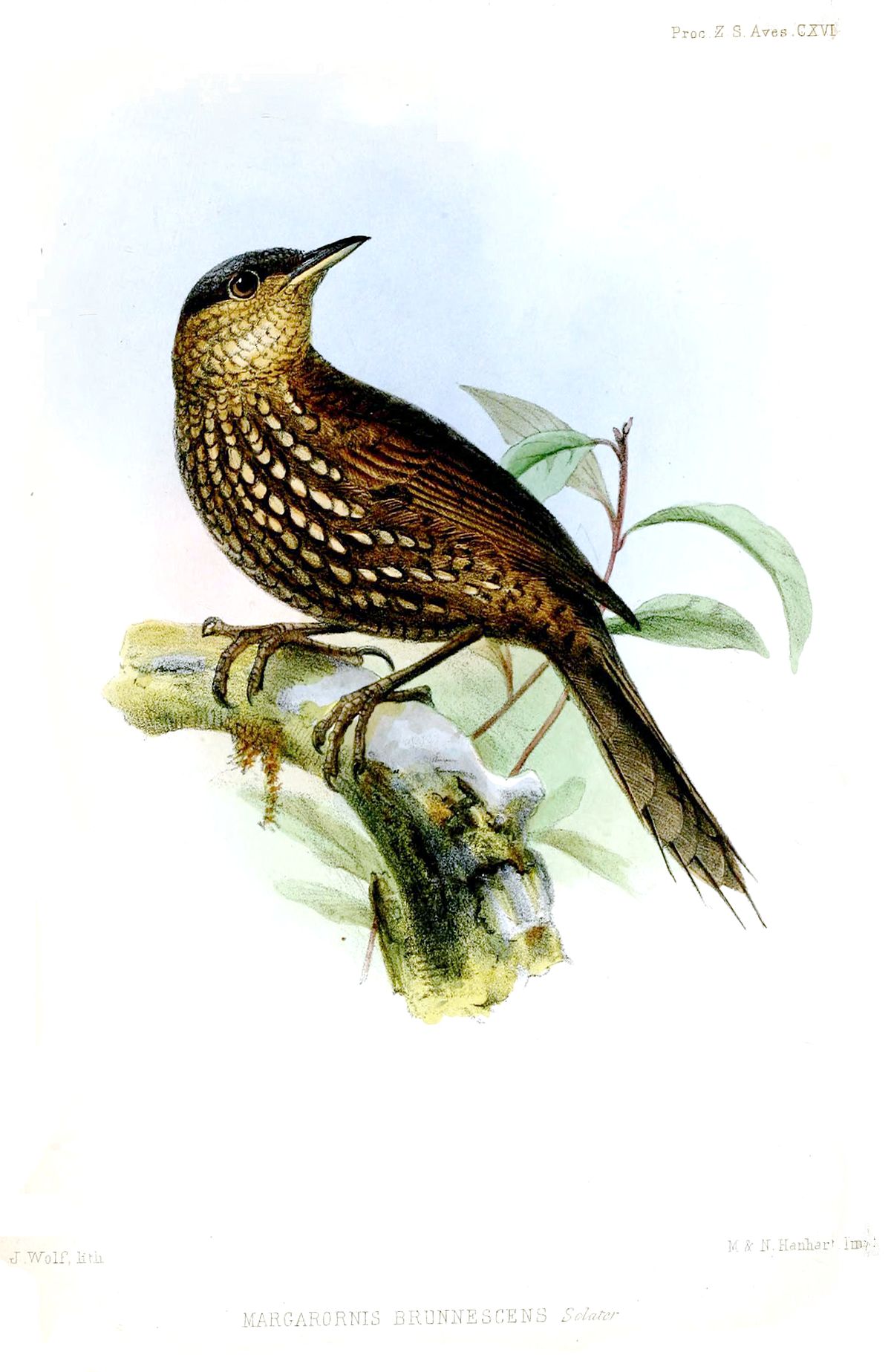
Wikipedia: Spotted barbtail
![]() The spotted barbtail (Premnoplex brunnescens) is a species of bird in the family Furnariidae. Its natural habitat is subtropical or tropical moist montane forest.
[more]
The spotted barbtail (Premnoplex brunnescens) is a species of bird in the family Furnariidae. Its natural habitat is subtropical or tropical moist montane forest.
[more]
Gattung Pseudocolaptes:
Pseudocolaptes lawrencii / Buffy tuftedcheek (Pseudocolaptes lawrencii)

Wikipedia: Buffy tuftedcheek
![]() The buffy tuftedcheek or Lawrence's tuftedcheek (Pseudocolaptes lawrencii) is a passerine bird in the ovenbird family, which breeds in the tropical New World in Costa Rica, western Panama and the Andes of Colombia and Ecuador. It is sometimes considered conspecific with the streaked tuftedcheek, P. boissonneautii, of South America. Birds from Colombia and Ecuador are sometimes considered a separate species, the Pacific tuftedcheek (P. johnsoni).
[more]
The buffy tuftedcheek or Lawrence's tuftedcheek (Pseudocolaptes lawrencii) is a passerine bird in the ovenbird family, which breeds in the tropical New World in Costa Rica, western Panama and the Andes of Colombia and Ecuador. It is sometimes considered conspecific with the streaked tuftedcheek, P. boissonneautii, of South America. Birds from Colombia and Ecuador are sometimes considered a separate species, the Pacific tuftedcheek (P. johnsoni).
[more]
Gattung Anabacerthia:
Anabacerthia variegaticeps / Scaly-throated foliage-gleaner (Anabacerthia variegaticeps)

Wikipedia: Scaly-throated foliage-gleaner
![]() The scaly-throated foliage-gleaner (Anabacerthia variegaticeps), also known as the spectacled foliage-gleaner, is a species of bird in the family Furnariidae.
It is found in Belize, Colombia, Costa Rica, Ecuador, El Salvador, Guatemala, Honduras, Mexico, and Panama.
Its natural habitats are subtropical or tropical moist lowland forest and subtropical or tropical moist montane forest.
[more]
The scaly-throated foliage-gleaner (Anabacerthia variegaticeps), also known as the spectacled foliage-gleaner, is a species of bird in the family Furnariidae.
It is found in Belize, Colombia, Costa Rica, Ecuador, El Salvador, Guatemala, Honduras, Mexico, and Panama.
Its natural habitats are subtropical or tropical moist lowland forest and subtropical or tropical moist montane forest.
[more]
Gattung Syndactyla:
Syndactyla subalaris / Lineated foliage-gleaner (Syndactyla subalaris)
Profil Wikipedia Xeno-Canto
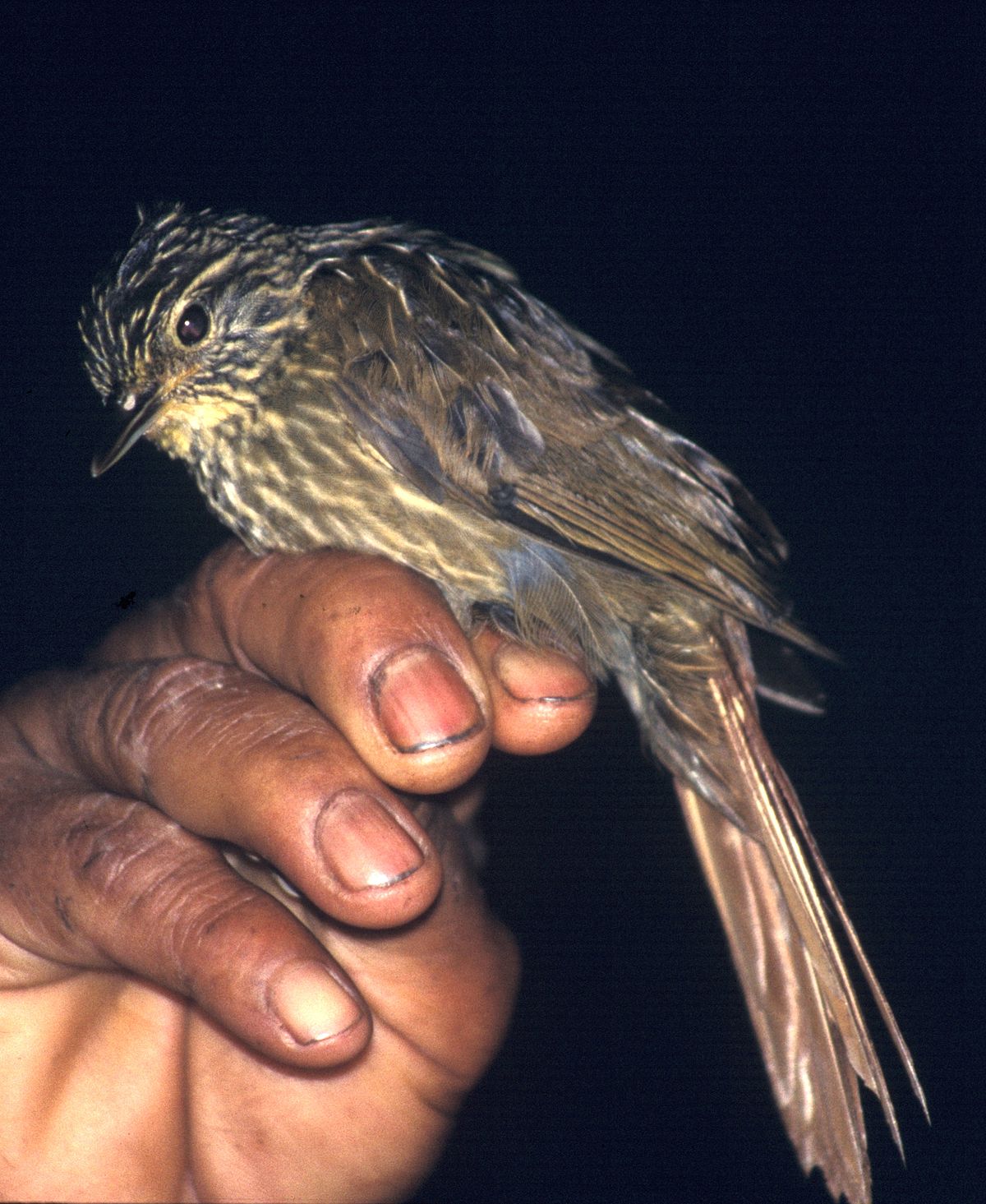
Wikipedia: Lineated foliage-gleaner
![]() The lineated foliage-gleaner (Syndactyla subalaris) is a species of bird in the family Furnariidae. It is found in Colombia, Costa Rica, Ecuador, Panama, Peru, and Venezuela. Its natural habitat is subtropical or tropical moist montane forest.
[more]
The lineated foliage-gleaner (Syndactyla subalaris) is a species of bird in the family Furnariidae. It is found in Colombia, Costa Rica, Ecuador, Panama, Peru, and Venezuela. Its natural habitat is subtropical or tropical moist montane forest.
[more]
Gattung Xenerpestes:
Xenerpestes minlosi / Double-banded graytail (Xenerpestes minlosi)
Profil Wikipedia Xeno-Canto

Wikipedia: Double-banded graytail
![]() The double-banded greytail (Xenerpestes minlosi) is a species of bird in the family Furnariidae. It is found in Colombia, Ecuador, and Panama. Its natural habitats are subtropical or tropical moist lowland forest and subtropical or tropical moist montane forest.
[more]
The double-banded greytail (Xenerpestes minlosi) is a species of bird in the family Furnariidae. It is found in Colombia, Ecuador, and Panama. Its natural habitats are subtropical or tropical moist lowland forest and subtropical or tropical moist montane forest.
[more]
Gattung Clibanornis:
Clibanornis rubiginosus / Ruddy foliage-gleaner (Clibanornis rubiginosus)
Profil Wikipedia Xeno-Canto
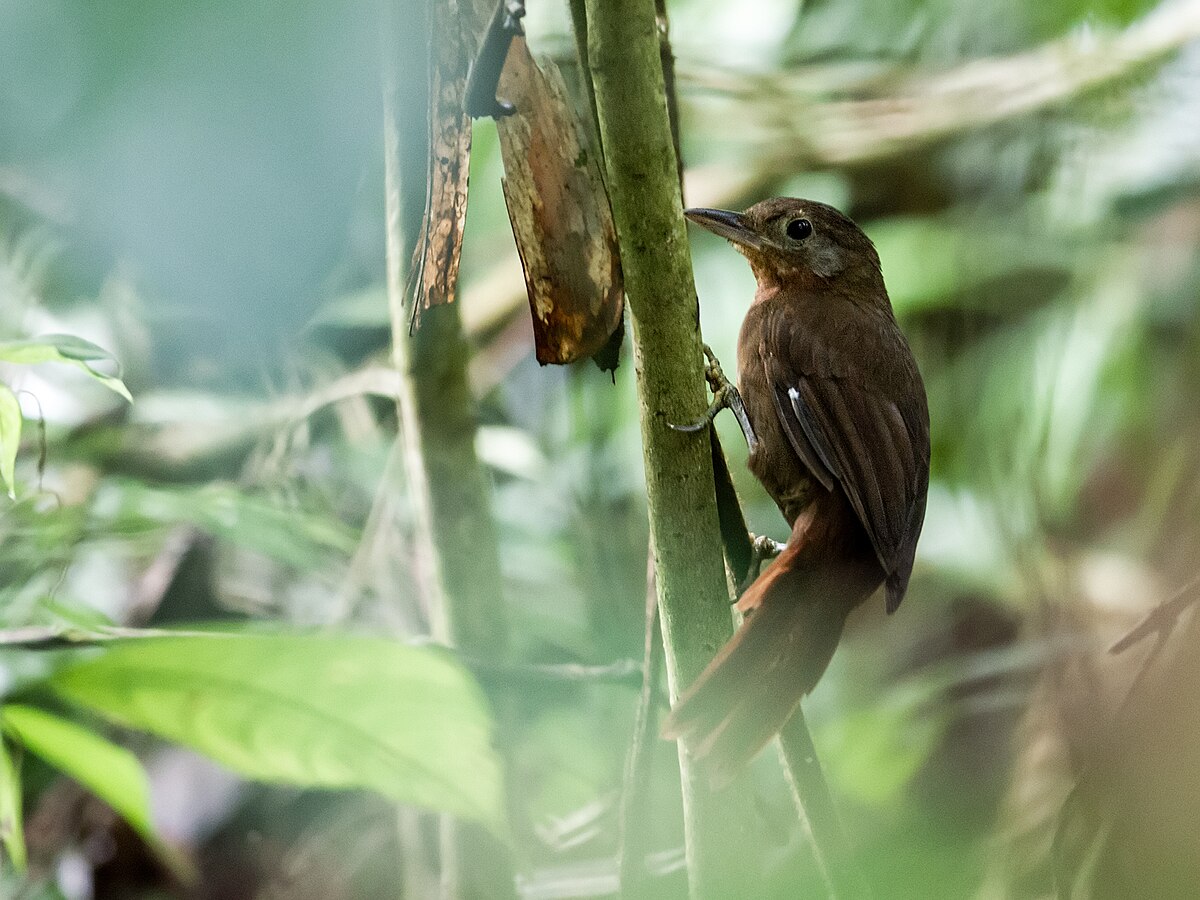
Wikipedia: Ruddy foliage-gleaner
![]() The ruddy foliage-gleaner (Clibanornis rubiginosus) is a species of bird in the family Furnariidae. Its range is highly disjunct, with populations in the highlands of Mexico and Central America, and lowlands and foothills in the Chocó, eastern Andes, and western and northeastern Amazon Basin. It is found in forest. There are distinct vocal variations throughout its range, suggesting that more than one species is involved, and one such population has recently been split from the ruddy foliage-gleaner as the Santa Marta foliage-gleaner.[2] The ruddy foliage-gleaner has recently been reclassified into the genus Clibanornis.[3]
[more]
The ruddy foliage-gleaner (Clibanornis rubiginosus) is a species of bird in the family Furnariidae. Its range is highly disjunct, with populations in the highlands of Mexico and Central America, and lowlands and foothills in the Chocó, eastern Andes, and western and northeastern Amazon Basin. It is found in forest. There are distinct vocal variations throughout its range, suggesting that more than one species is involved, and one such population has recently been split from the ruddy foliage-gleaner as the Santa Marta foliage-gleaner.[2] The ruddy foliage-gleaner has recently been reclassified into the genus Clibanornis.[3]
[more]
Familie Rhinocryptidae (Tapaculos):
Gattung Scytalopus:
Scytalopus argentifrons / Silvery-fronted tapaculo (Scytalopus argentifrons)
Profil Wikipedia Xeno-Canto

Wikipedia: Silvery-fronted tapaculo
![]() The silvery-fronted tapaculo (Scytalopus argentifrons) is a species of bird in the family Rhinocryptidae. It is found in the Talamancan montane forests. Its natural habitat is subtropical or tropical moist montane forest.
[more]
The silvery-fronted tapaculo (Scytalopus argentifrons) is a species of bird in the family Rhinocryptidae. It is found in the Talamancan montane forests. Its natural habitat is subtropical or tropical moist montane forest.
[more]
Scytalopus chocoensis / Choco tapaculo (Scytalopus chocoensis)
Profil Wikipedia Xeno-Canto

Wikipedia: Choco tapaculo
![]() The Chocó tapaculo (Scytalopus chocoensis) is a species of bird in the family Rhinocryptidae. It is found in Colombia, Ecuador, and Panama.
[more]
The Chocó tapaculo (Scytalopus chocoensis) is a species of bird in the family Rhinocryptidae. It is found in Colombia, Ecuador, and Panama.
[more]
Familie Turdidae (Drosseln / Thrushes):
Gattung Catharus:
Catharus ustulatus / Swainson's thrush (Catharus ustulatus)
Profil Wikipedia Audubon Xeno-Canto

Wikipedia: Swainson's thrush
![]() Swainson's thrush (Catharus ustulatus), also called olive-backed thrush and russet-backed thrush, is a medium-sized thrush. It is a member of genus Catharus and is typical of it in terms of its subdued coloration and beautiful, ascending flute-like voice. Swainson's thrush was named after William Swainson, an English ornithologist.
[more]
Swainson's thrush (Catharus ustulatus), also called olive-backed thrush and russet-backed thrush, is a medium-sized thrush. It is a member of genus Catharus and is typical of it in terms of its subdued coloration and beautiful, ascending flute-like voice. Swainson's thrush was named after William Swainson, an English ornithologist.
[more]
Grauwangendrossel / Gray-cheeked thrush (Catharus minimus)
Profil Wikipedia Audubon Xeno-Canto

Wikipedia: Gray-cheeked thrush
![]() The grey-cheeked thrush (Catharus minimus) is a medium-sized thrush. This species is 15–17 cm (5.9–6.7 in) in length, and has the white-dark-white underwing pattern characteristic of Catharus thrushes. It is a member of a close-knit group of migrant species together with the veery and Bicknell's thrush;[2] it forms a cryptic species pair with the latter. The grey-cheeked thrush is all but indistinguishable from Bicknell's thrush except by its slightly larger size and different song. The two were formerly considered conspecific.[3] Of all the American spotted thrushes, the grey-cheeked has the most northern breeding range.[4]
[more]
The grey-cheeked thrush (Catharus minimus) is a medium-sized thrush. This species is 15–17 cm (5.9–6.7 in) in length, and has the white-dark-white underwing pattern characteristic of Catharus thrushes. It is a member of a close-knit group of migrant species together with the veery and Bicknell's thrush;[2] it forms a cryptic species pair with the latter. The grey-cheeked thrush is all but indistinguishable from Bicknell's thrush except by its slightly larger size and different song. The two were formerly considered conspecific.[3] Of all the American spotted thrushes, the grey-cheeked has the most northern breeding range.[4]
[more]
Wilson-Drossel / Veery (Catharus fuscescens)
Profil Wikipedia Audubon Xeno-Canto

Wikipedia: Veery
![]() The veery (Catharus fuscescens) is a small North American thrush species, a member of a group of closely related and similar species in the genus Catharus, also including the gray-cheeked thrush (C. minimus), Bicknell's thrush (C. bicknelli), Swainson's thrush (C. ustulatus), and Hermit thrush (C. guttatus).[2][3] Alternate names for this species include Wilson's thrush (named so after Alexander Wilson[4]) and tawny thrush.[5] Up to six subspecies exist, which are grouped into the eastern Veery (C. fuscescens fuscescens), the western Veery or Willow Thrush (C. fuscescens salicicolus), and the Newfoundland Veery (C. fuscescens fuliginosus).[6]
[more]
The veery (Catharus fuscescens) is a small North American thrush species, a member of a group of closely related and similar species in the genus Catharus, also including the gray-cheeked thrush (C. minimus), Bicknell's thrush (C. bicknelli), Swainson's thrush (C. ustulatus), and Hermit thrush (C. guttatus).[2][3] Alternate names for this species include Wilson's thrush (named so after Alexander Wilson[4]) and tawny thrush.[5] Up to six subspecies exist, which are grouped into the eastern Veery (C. fuscescens fuscescens), the western Veery or Willow Thrush (C. fuscescens salicicolus), and the Newfoundland Veery (C. fuscescens fuliginosus).[6]
[more]
Catharus frantzii / Ruddy-capped nightingale-thrush (Catharus frantzii)
Profil Wikipedia Xeno-Canto

Wikipedia: Ruddy-capped nightingale-thrush
![]() The ruddy-capped nightingale-thrush (Catharus frantzii) is a small thrush which is a resident breeder in mountain forests from central Mexico to western Panama. A predominantly brown-plumaged bird, it has a rich song.
[more]
The ruddy-capped nightingale-thrush (Catharus frantzii) is a small thrush which is a resident breeder in mountain forests from central Mexico to western Panama. A predominantly brown-plumaged bird, it has a rich song.
[more]
Catharus fuscater / Slaty-backed nightingale-thrush (Catharus fuscater)
Profil Wikipedia Xeno-Canto

Wikipedia: Slaty-backed nightingale-thrush
![]() The slaty-backed nightingale-thrush (Catharus fuscater) is a species of bird in the family Turdidae. It is found in Bolivia, Colombia, Costa Rica, Ecuador, Panama, Peru, and Venezuela.
[more]
The slaty-backed nightingale-thrush (Catharus fuscater) is a species of bird in the family Turdidae. It is found in Bolivia, Colombia, Costa Rica, Ecuador, Panama, Peru, and Venezuela.
[more]
Catharus gracilirostris / Black-billed nightingale-thrush (Catharus gracilirostris)
Profil Wikipedia Xeno-Canto
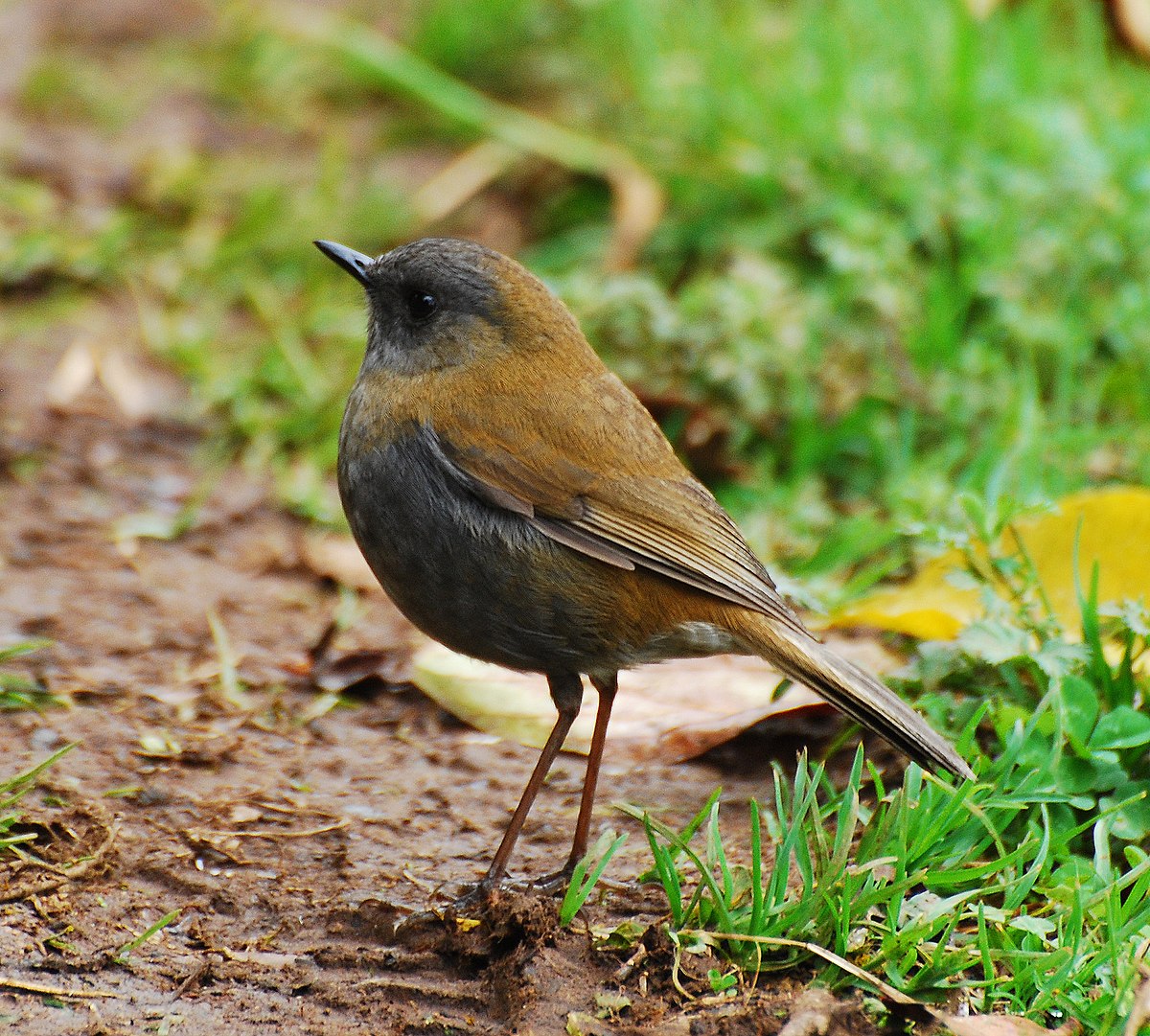
Wikipedia: Black-billed nightingale-thrush
![]() The black-billed nightingale-thrush (Catharus gracilirostris) is a small thrush endemic to the highlands of Costa Rica and western Panama. Its position in the genus Catharus is somewhat equivocal, but it is apparently closer to the hermit thrush than to the other nightingale-thrushes except the russet nightingale-thrush and/or the ruddy-capped nightingale-thrush (Winker & Pruett, 2006).[2]
[more]
The black-billed nightingale-thrush (Catharus gracilirostris) is a small thrush endemic to the highlands of Costa Rica and western Panama. Its position in the genus Catharus is somewhat equivocal, but it is apparently closer to the hermit thrush than to the other nightingale-thrushes except the russet nightingale-thrush and/or the ruddy-capped nightingale-thrush (Winker & Pruett, 2006).[2]
[more]
Catharus aurantiirostris / Orange-billed nightingale-thrush (Catharus aurantiirostris)
Profil Wikipedia Xeno-Canto
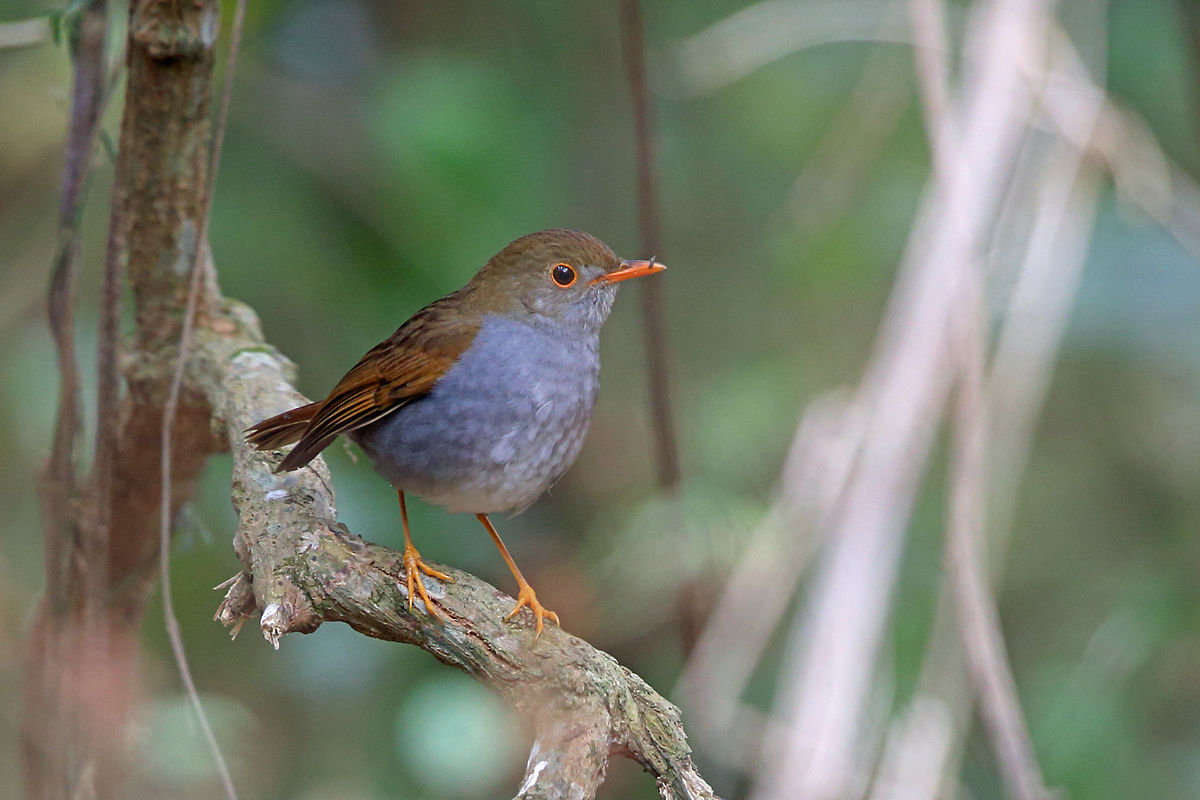
Wikipedia: Orange-billed nightingale-thrush
![]() The orange-billed nightingale-thrush (Catharus aurantiirostris) is a species of bird in the family Turdidae. It is found in Colombia, Costa Rica, El Salvador, Guatemala, Honduras, Mexico, Nicaragua, Panama, Trinidad and Tobago, and Venezuela. Its natural habitats are subtropical or tropical dry forest, subtropical or tropical moist lowland forest, subtropical or tropical moist montane forest, and heavily degraded former forest.
[more]
The orange-billed nightingale-thrush (Catharus aurantiirostris) is a species of bird in the family Turdidae. It is found in Colombia, Costa Rica, El Salvador, Guatemala, Honduras, Mexico, Nicaragua, Panama, Trinidad and Tobago, and Venezuela. Its natural habitats are subtropical or tropical dry forest, subtropical or tropical moist lowland forest, subtropical or tropical moist montane forest, and heavily degraded former forest.
[more]
Catharus mexicanus / Black-headed nightingale-thrush (Catharus mexicanus)
Profil Wikipedia Xeno-Canto
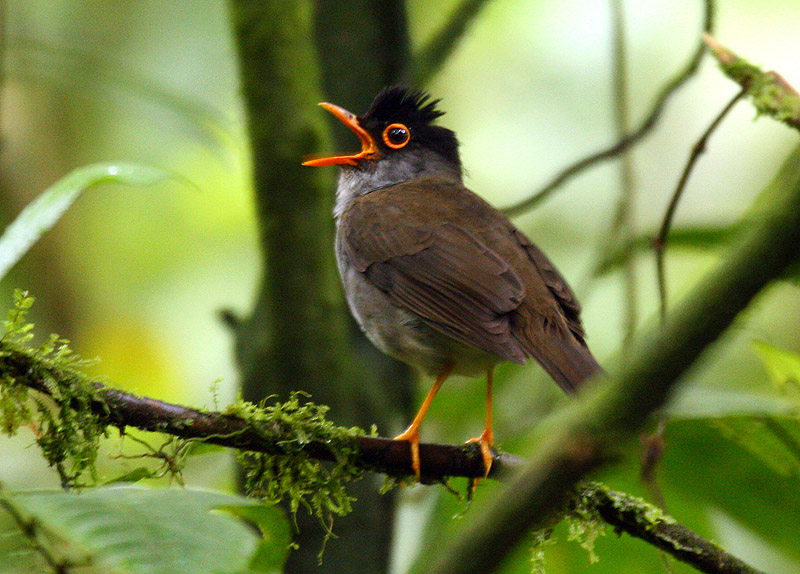
Wikipedia: Black-headed nightingale-thrush
![]() The black-headed nightingale-thrush (Catharus mexicanus) is a species of bird in the family Turdidae. It is found in Costa Rica, Guatemala, Honduras, Mexico, Nicaragua, and Panama.
[more]
The black-headed nightingale-thrush (Catharus mexicanus) is a species of bird in the family Turdidae. It is found in Costa Rica, Guatemala, Honduras, Mexico, Nicaragua, and Panama.
[more]
Gattung Turdus:
Turdus grayi / Clay-colored robin (Turdus grayi)
Lava hike clay colored thrush? national bird. 2018-03-01 17.09.44 null
![]() The clay-colored thrush (Turdus grayi) is a common Middle American bird of the thrush family (Turdidae). It is the national bird of Costa Rica, where it is well known as the yigüirro (Spanish: [ʝi'ɣwiro]). Other common names include clay-colored robin.[1]
[more]
The clay-colored thrush (Turdus grayi) is a common Middle American bird of the thrush family (Turdidae). It is the national bird of Costa Rica, where it is well known as the yigüirro (Spanish: [ʝi'ɣwiro]). Other common names include clay-colored robin.[1]
[more]
Turdus assimilis / White-throated thrush (Turdus assimilis)

Wikipedia: White-throated thrush
![]() The white-throated thrush (Turdus assimilis) is a species of bird in the family Turdidae. It is found in Mexico and Central America, ranging south to central Panama.[2] Its natural habitats are subtropical or tropical dry forests, subtropical or tropical moist lowland forests, and subtropical or tropical moist montane forests. It is common in its range and an extremely rare vagrant into Texas and Arizona; 3 sightings have been recorded (1990 and 1998 in Texas and 2019 in Arizona).[3][4]
[more]
The white-throated thrush (Turdus assimilis) is a species of bird in the family Turdidae. It is found in Mexico and Central America, ranging south to central Panama.[2] Its natural habitats are subtropical or tropical dry forests, subtropical or tropical moist lowland forests, and subtropical or tropical moist montane forests. It is common in its range and an extremely rare vagrant into Texas and Arizona; 3 sightings have been recorded (1990 and 1998 in Texas and 2019 in Arizona).[3][4]
[more]
Rußdrossel / Sooty thrush (Turdus nigrescens)
Profil Wikipedia Xeno-Canto

Wikipedia: Sooty thrush
![]() The sooty thrush (Turdus nigrescens) is a large thrush endemic to the highlands of Costa Rica and western Panama. It was formerly known as the sooty robin.
[more]
The sooty thrush (Turdus nigrescens) is a large thrush endemic to the highlands of Costa Rica and western Panama. It was formerly known as the sooty robin.
[more]
Turdus plebejus / Mountain thrush (Turdus plebejus)
Profil Wikipedia Xeno-Canto
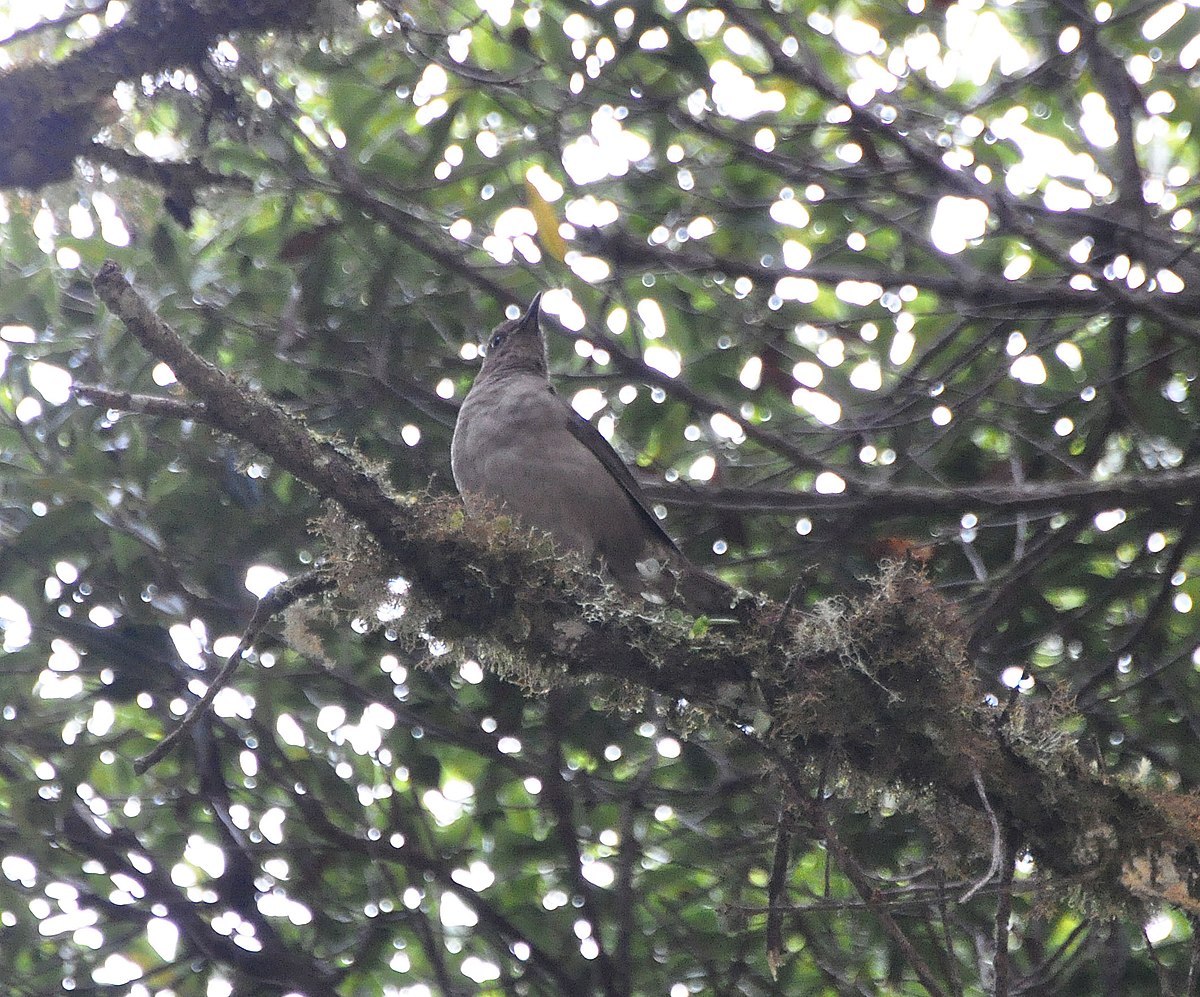
Wikipedia: Mountain thrush
![]() The mountain thrush (Turdus plebejus) is a large thrush which is found in Central America. It was formerly known as the mountain robin. Some authorities refer to it as the American mountain thrush to differentiate it from the Abyssinian thrush (Turdus abyssinicus), known in their taxonomy as the African mountain thrush.[2]
[more]
The mountain thrush (Turdus plebejus) is a large thrush which is found in Central America. It was formerly known as the mountain robin. Some authorities refer to it as the American mountain thrush to differentiate it from the Abyssinian thrush (Turdus abyssinicus), known in their taxonomy as the African mountain thrush.[2]
[more]
Turdus obsoletus / Pale-vented thrush (Turdus obsoletus)
Profil Wikipedia Xeno-Canto

Wikipedia: Pale-vented thrush
![]() The pale-vented thrush (Turdus obsoletus) is a species of bird in the family Turdidae.
[more]
The pale-vented thrush (Turdus obsoletus) is a species of bird in the family Turdidae.
[more]
Gattung Myadestes:
Myadestes melanops / Black-faced solitaire (Myadestes melanops)
Cloud forest black faced solitaire. 2018-02-17 13.24.56 null
![]() The black-faced solitaire (Myadestes melanops) is a bird in the thrush family endemic to highlands in Costa Rica and western Panama.
[more]
The black-faced solitaire (Myadestes melanops) is a bird in the thrush family endemic to highlands in Costa Rica and western Panama.
[more]
Myadestes coloratus / Varied solitaire (Myadestes coloratus)
Profil Wikipedia Xeno-Canto

Wikipedia: Varied solitaire
![]() The varied solitaire (Myadestes coloratus) is a species of bird in the family Turdidae. It is found in Colombia and Panama. Its natural habitat is subtropical or tropical moist montane forests.
[more]
The varied solitaire (Myadestes coloratus) is a species of bird in the family Turdidae. It is found in Colombia and Panama. Its natural habitat is subtropical or tropical moist montane forests.
[more]
Gattung Hylocichla:
Walddrossel / Wood thrush (Hylocichla mustelina)
Wood thrush, one of the few birds at Oregon Ridge we saw for the first time, unforunately out of focus. 2021-06-19 09.31.42 null
![]() The wood thrush (Hylocichla mustelina) is a North American passerine bird. It is closely related to other thrushes such as the American robin and is widely distributed across North America, wintering in Central America and southern Mexico. The wood thrush is the official bird of the District of Columbia.[2]
[more]
The wood thrush (Hylocichla mustelina) is a North American passerine bird. It is closely related to other thrushes such as the American robin and is widely distributed across North America, wintering in Central America and southern Mexico. The wood thrush is the official bird of the District of Columbia.[2]
[more]
Familie Tyrannidae:
Gattung Empidonax:
Gartentyrann / Least flycatcher (Empidonax minimus)
Profil Wikipedia Audubon Xeno-Canto

Wikipedia: Least flycatcher
![]() The least flycatcher (Empidonax minimus), (also called chebec, or chebecker, after the sound it makes), is a small insect-eating bird. It is the smallest Empidonax flycatcher in eastern North America.
[more]
The least flycatcher (Empidonax minimus), (also called chebec, or chebecker, after the sound it makes), is a small insect-eating bird. It is the smallest Empidonax flycatcher in eastern North America.
[more]
Empidonax flaviventris / Yellow-bellied flycatcher (Empidonax flaviventris)
Profil Wikipedia Audubon Xeno-Canto

Wikipedia: Yellow-bellied flycatcher
![]() The yellow-bellied flycatcher (Empidonax flaviventris) is a small insect-eating bird of the tyrant flycatcher family.
[more]
The yellow-bellied flycatcher (Empidonax flaviventris) is a small insect-eating bird of the tyrant flycatcher family.
[more]
Buchentyrann / Acadian flycatcher (Empidonax virescens)
Profil Wikipedia Audubon Xeno-Canto
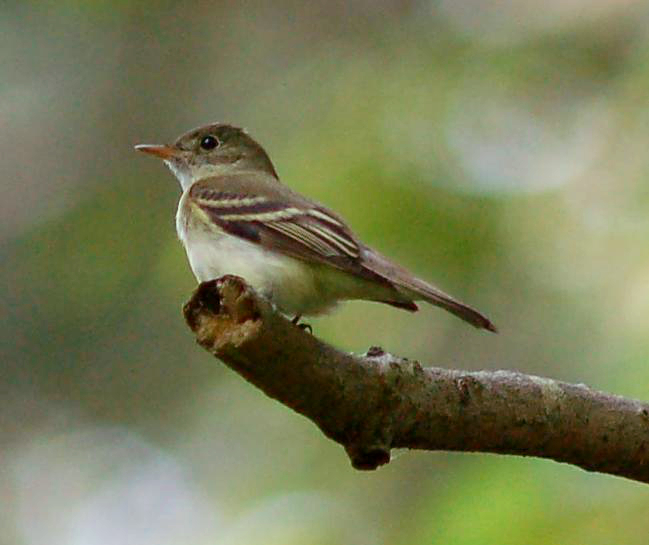
Wikipedia: Acadian flycatcher
![]() The Acadian flycatcher (Empidonax virescens) is a small insect-eating bird of the tyrant flycatcher family.
[more]
The Acadian flycatcher (Empidonax virescens) is a small insect-eating bird of the tyrant flycatcher family.
[more]
Empidonax alnorum / Alder flycatcher (Empidonax alnorum)
Profil Wikipedia Audubon Xeno-Canto

Wikipedia: Alder flycatcher
![]() The alder flycatcher (Empidonax alnorum) is a small insect-eating bird of the tyrant flycatcher family. The genus name Empidonax is from Ancient Greek empis, "gnat", and anax, "master". The specific alnorum is Latin and means "of the alders".[2]
[more]
The alder flycatcher (Empidonax alnorum) is a small insect-eating bird of the tyrant flycatcher family. The genus name Empidonax is from Ancient Greek empis, "gnat", and anax, "master". The specific alnorum is Latin and means "of the alders".[2]
[more]
Empidonax traillii / Willow flycatcher (Empidonax traillii)
Profil Wikipedia Audubon Xeno-Canto

Wikipedia: Willow flycatcher
![]() The willow flycatcher (Empidonax traillii) is a small insect-eating, neotropical migrant bird of the tyrant flycatcher family. There are four subspecies of the willow flycatcher currently recognized, all of which breed in North America (including three subspecies that breed in California).[2] Empidonax flycatchers are almost impossible to tell apart in the field so biologists use their songs to distinguish between them.[3] The binomial commemorates the Scottish zoologist Thomas Stewart Traill.
[more]
The willow flycatcher (Empidonax traillii) is a small insect-eating, neotropical migrant bird of the tyrant flycatcher family. There are four subspecies of the willow flycatcher currently recognized, all of which breed in North America (including three subspecies that breed in California).[2] Empidonax flycatchers are almost impossible to tell apart in the field so biologists use their songs to distinguish between them.[3] The binomial commemorates the Scottish zoologist Thomas Stewart Traill.
[more]
Gilbufertyrann / Yellowish flycatcher (Empidonax flavescens)
Profil Wikipedia Xeno-Canto

Wikipedia: Yellowish flycatcher
![]() The yellowish flycatcher (Empidonax flavescens) is a small passerine bird in the tyrant flycatcher family. It breeds in highlands from southeastern Mexico south to western Panama.[2]
[more]
The yellowish flycatcher (Empidonax flavescens) is a small passerine bird in the tyrant flycatcher family. It breeds in highlands from southeastern Mexico south to western Panama.[2]
[more]
Empidonax albigularis / White-throated flycatcher (Empidonax albigularis)
Profil Wikipedia Xeno-Canto

Wikipedia: White-throated flycatcher
![]() The white-throated flycatcher (Empidonax albigularis) is a species of bird in the family Tyrannidae. It is found in Belize, Costa Rica, El Salvador, Guatemala, Honduras, Mexico, Nicaragua, and Panama. Its natural habitats are subtropical or tropical moist shrubland and heavily degraded former forest.
[more]
The white-throated flycatcher (Empidonax albigularis) is a species of bird in the family Tyrannidae. It is found in Belize, Costa Rica, El Salvador, Guatemala, Honduras, Mexico, Nicaragua, and Panama. Its natural habitats are subtropical or tropical moist shrubland and heavily degraded former forest.
[more]
Empidonax atriceps / Black-capped flycatcher (Empidonax atriceps)
Profil Wikipedia Xeno-Canto
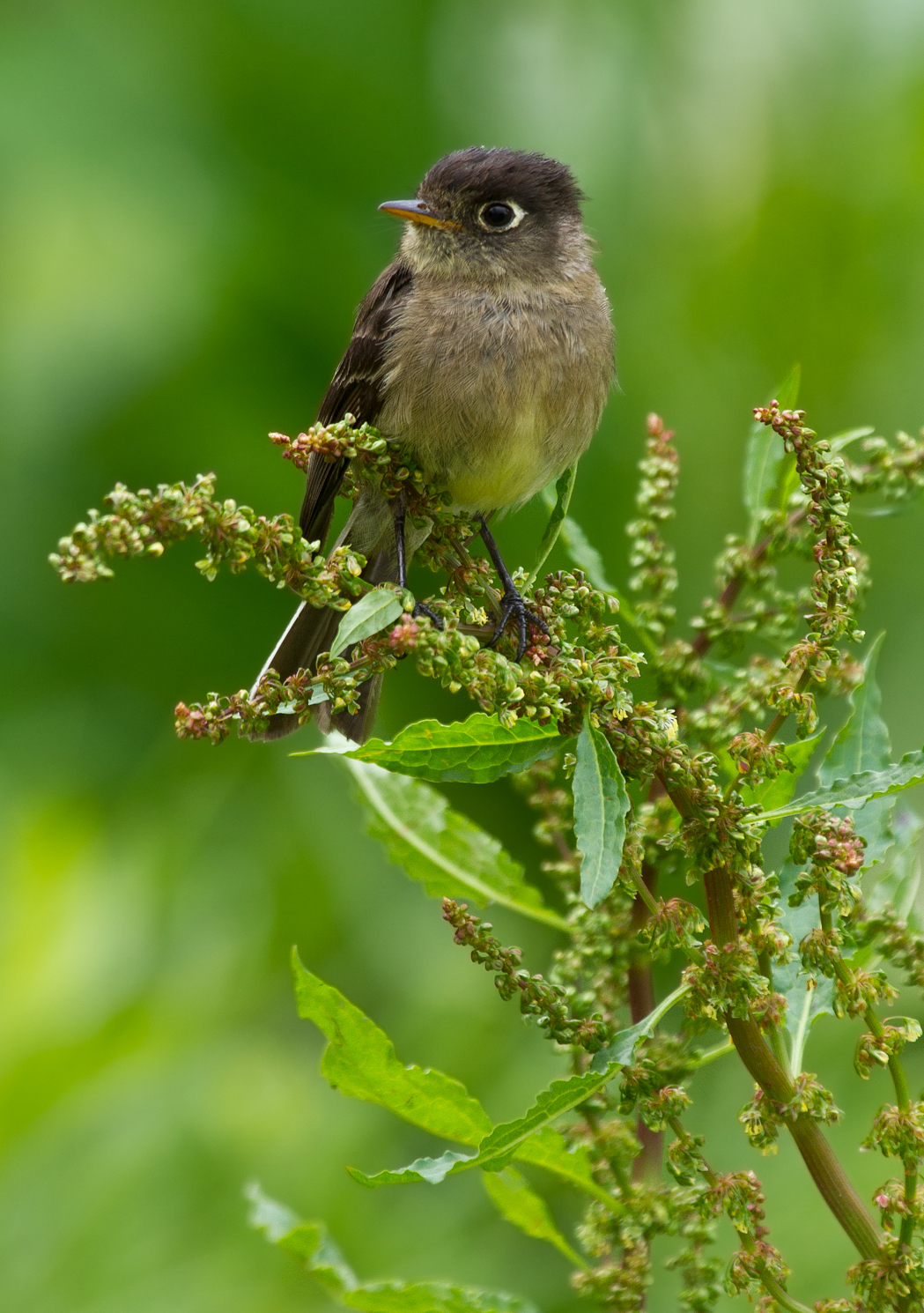
Wikipedia: Black-capped flycatcher
![]() The black-capped flycatcher (Empidonax atriceps) is a very small passerine bird in the tyrant flycatcher family. It is endemic to the highlands of Costa Rica and western Panama.
[more]
The black-capped flycatcher (Empidonax atriceps) is a very small passerine bird in the tyrant flycatcher family. It is endemic to the highlands of Costa Rica and western Panama.
[more]
Gattung Tyrannus:
Trauertyrann / Tropical kingbird (Tyrannus melancholicus)
Profil Wikipedia Audubon Xeno-Canto
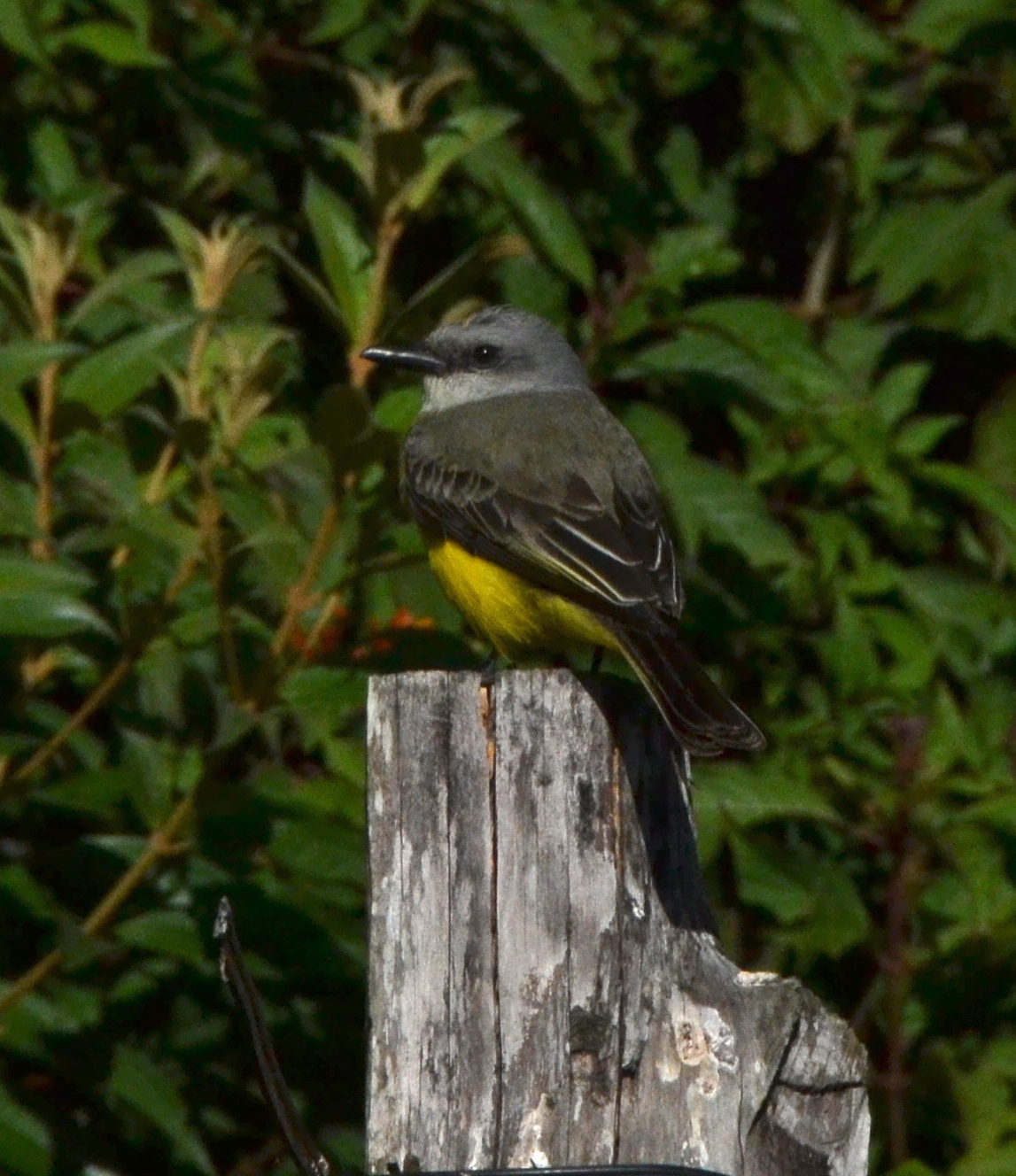
Tropical kingbird. 2018-02-16 16.18.52 null
![]() The tropical kingbird (Tyrannus melancholicus) is a large tyrant flycatcher. This bird breeds from southern Arizona and the lower Rio Grande Valley of Texas in the United States through Central America, South America as far as south as central Argentina and eastern Peru, and on Trinidad and Tobago. Birds from the northernmost and southern breeding areas migrate to warmer parts of the range after breeding.
[more]
The tropical kingbird (Tyrannus melancholicus) is a large tyrant flycatcher. This bird breeds from southern Arizona and the lower Rio Grande Valley of Texas in the United States through Central America, South America as far as south as central Argentina and eastern Peru, and on Trinidad and Tobago. Birds from the northernmost and southern breeding areas migrate to warmer parts of the range after breeding.
[more]
Königstyrann / Eastern kingbird (Tyrannus tyrannus)
Profil Wikipedia Audubon Xeno-Canto
Eastern kingbird, Cromwell Valley Park, Maryland. 2021-06-14 16.00.42 null
![]() Lanius tyrannus Linnaeus, 1758
[more]
Lanius tyrannus Linnaeus, 1758
[more]
Grauer Königstyrann / Gray kingbird (Tyrannus dominicensis)
Profil Wikipedia Audubon Xeno-Canto

Wikipedia: Gray kingbird
![]() The gray kingbird or grey kingbird, also known as pitirre, petchary, or white-breasted kingbird (Tyrannus dominicensis) is a passerine bird.
[more]
The gray kingbird or grey kingbird, also known as pitirre, petchary, or white-breasted kingbird (Tyrannus dominicensis) is a passerine bird.
[more]
Tyrannus savana / Fork-tailed flycatcher (Tyrannus savana)
Profil Wikipedia Audubon Xeno-Canto

Wikipedia: Fork-tailed flycatcher
![]() The fork-tailed flycatcher (Tyrannus savana) is a passerine bird of the tyrant flycatcher family, and is the member of a genus typically referred to as kingbirds. Named for their distinguishingly long forked tail, fork-tailed flycatchers are seen in lightly-forested or grassland areas; ranging from southern Mexico, to south past Argentina. They are most frequently observed sitting on conspicuous perches waiting for flying arthropods to fly past, they then sally out, eat their prey, and return to their perch. Northern populations near southern Mexico tend to be permanent residents, while fork-tailed flycatchers that live further south are migrants with a reputation to wander as far north as the eastern seaboard of the United States.
[more]
The fork-tailed flycatcher (Tyrannus savana) is a passerine bird of the tyrant flycatcher family, and is the member of a genus typically referred to as kingbirds. Named for their distinguishingly long forked tail, fork-tailed flycatchers are seen in lightly-forested or grassland areas; ranging from southern Mexico, to south past Argentina. They are most frequently observed sitting on conspicuous perches waiting for flying arthropods to fly past, they then sally out, eat their prey, and return to their perch. Northern populations near southern Mexico tend to be permanent residents, while fork-tailed flycatchers that live further south are migrants with a reputation to wander as far north as the eastern seaboard of the United States.
[more]
Scherenschwanz-Königstyrann / Scissor-tailed flycatcher (Tyrannus forficatus)
Profil Wikipedia Audubon Xeno-Canto
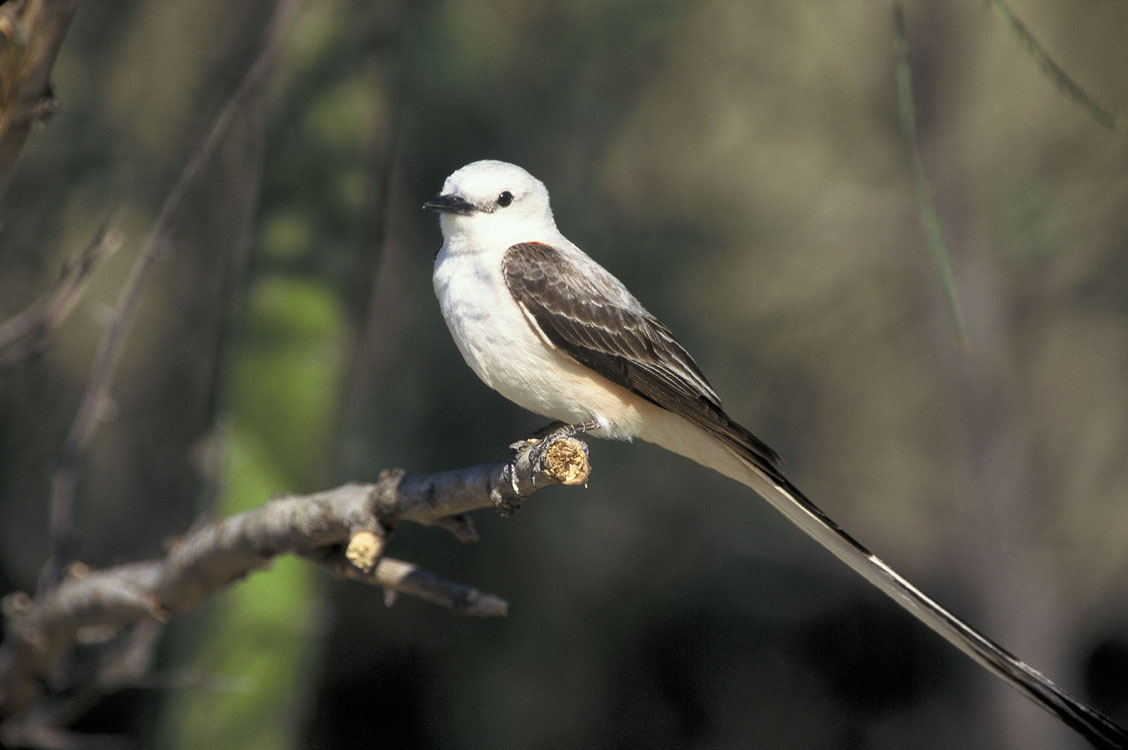
Wikipedia: Scissor-tailed flycatcher
![]() The scissor-tailed flycatcher (Tyrannus forficatus), also known as the Texas bird-of-paradise and swallow-tailed flycatcher, is a long-tailed bird of the genus Tyrannus, whose members are collectively referred to as kingbirds. The kingbirds are a group of large insectivorous (insect-eating) birds in the tyrant flycatcher (Tyrannidae) family. The scissor-tailed flycatcher is found in North and Central America.
[more]
The scissor-tailed flycatcher (Tyrannus forficatus), also known as the Texas bird-of-paradise and swallow-tailed flycatcher, is a long-tailed bird of the genus Tyrannus, whose members are collectively referred to as kingbirds. The kingbirds are a group of large insectivorous (insect-eating) birds in the tyrant flycatcher (Tyrannidae) family. The scissor-tailed flycatcher is found in North and Central America.
[more]
Arkansaskönigstyrann / Western kingbird (Tyrannus verticalis)
Profil Wikipedia Audubon Xeno-Canto

Wikipedia: Western kingbird
![]() The western kingbird (Tyrannus verticalis) is a large tyrant flycatcher found throughout western environments of North America and as far as Mexico.
[more]
The western kingbird (Tyrannus verticalis) is a large tyrant flycatcher found throughout western environments of North America and as far as Mexico.
[more]
Gattung Sayornis:
Schwarzkopf-Phoebetyrann / Black phoebe (Sayornis nigricans)
Profil Wikipedia Audubon Xeno-Canto
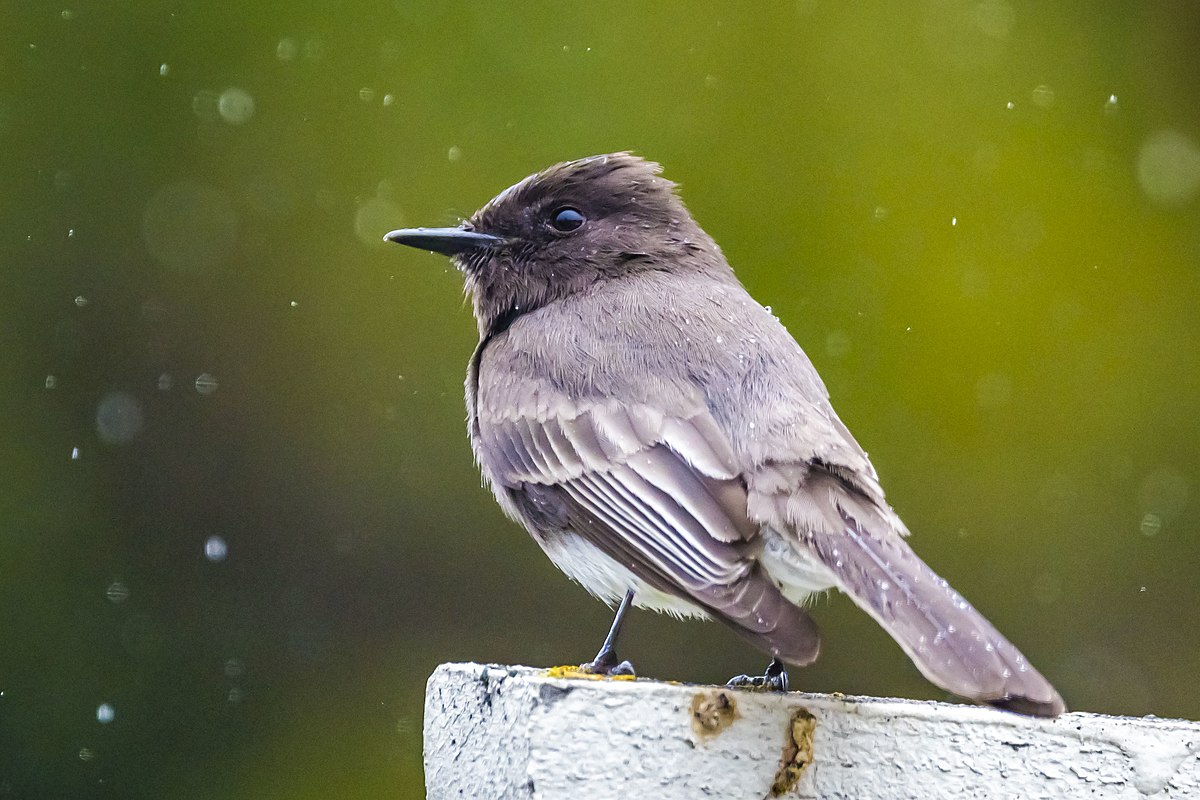
Wikipedia: Black phoebe
![]() The black phoebe (Sayornis nigricans) is a passerine bird in the tyrant-flycatcher family. It breeds from southwest Oregon and California south through Central and South America. It occurs year-round throughout most of its range and migrates less than the other birds in its genus, though its northern populations are partially migratory. Six subspecies are commonly recognized, although two are occasionally combined as a separate species, the white-winged phoebe.
[more]
The black phoebe (Sayornis nigricans) is a passerine bird in the tyrant-flycatcher family. It breeds from southwest Oregon and California south through Central and South America. It occurs year-round throughout most of its range and migrates less than the other birds in its genus, though its northern populations are partially migratory. Six subspecies are commonly recognized, although two are occasionally combined as a separate species, the white-winged phoebe.
[more]
Gattung Elaenia:
Elaenia flavogaster / Yellow-bellied elaenia (Elaenia flavogaster)
Profil Wikipedia Xeno-Canto

Wikipedia: Yellow-bellied elaenia
![]() The yellow-bellied elaenia (Elaenia flavogaster) is a small bird of the tyrant flycatcher family. It breeds from southern Mexico and the Yucatán Peninsula through Central and South America as far as northern Argentina, and on Trinidad and Tobago.
[more]
The yellow-bellied elaenia (Elaenia flavogaster) is a small bird of the tyrant flycatcher family. It breeds from southern Mexico and the Yucatán Peninsula through Central and South America as far as northern Argentina, and on Trinidad and Tobago.
[more]
Elaenia frantzii / Mountain elaenia (Elaenia frantzii)
Profil Wikipedia Xeno-Canto

Wikipedia: Mountain elaenia
![]() The mountain elaenia (Elaenia frantzii) is a small passerine bird in the tyrant flycatcher family. It breeds in highlands from Guatemala to Colombia and western Venezuela. The scientific name celebrates the German physician and naturalist, Alexander von Frantzius.
[more]
The mountain elaenia (Elaenia frantzii) is a small passerine bird in the tyrant flycatcher family. It breeds in highlands from Guatemala to Colombia and western Venezuela. The scientific name celebrates the German physician and naturalist, Alexander von Frantzius.
[more]
Elaenia chiriquensis / Lesser elaenia (Elaenia chiriquensis)
Profil Wikipedia Xeno-Canto
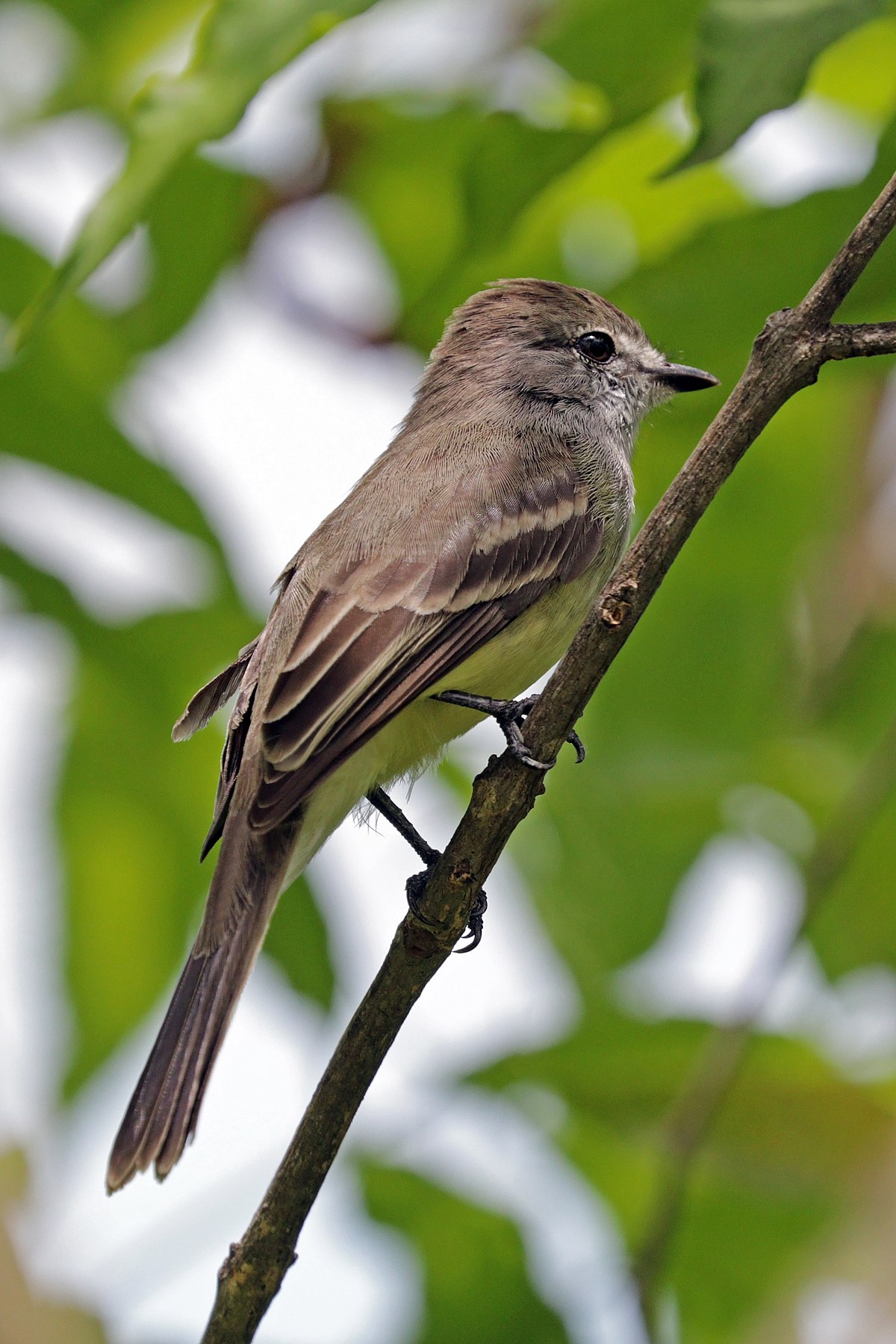
Wikipedia: Lesser elaenia
![]() The lesser elaenia (Elaenia chiriquensis) is a species of bird in the family Tyrannidae, the tyrant flycatchers.
[more]
The lesser elaenia (Elaenia chiriquensis) is a species of bird in the family Tyrannidae, the tyrant flycatchers.
[more]
Gattung Pachyramphus:
Pachyramphus aglaiae / Rose-throated becard (Pachyramphus aglaiae)
Profil Wikipedia Audubon Xeno-Canto

Wikipedia: Rose-throated becard
![]() The rose-throated becard (Pachyramphus aglaiae) is a medium-sized member of the family Tityridae. Its genus, Pachyramphus, has traditionally been placed in Cotingidae or Tyrannidae, but evidence strongly suggest it is better placed in Tityridae.[2] This species was named in honour of Aglaé Brelay.[3]
[more]
The rose-throated becard (Pachyramphus aglaiae) is a medium-sized member of the family Tityridae. Its genus, Pachyramphus, has traditionally been placed in Cotingidae or Tyrannidae, but evidence strongly suggest it is better placed in Tityridae.[2] This species was named in honour of Aglaé Brelay.[3]
[more]
Pachyramphus cinnamomeus / Cinnamon becard (Pachyramphus cinnamomeus)
Profil Wikipedia Xeno-Canto

Wikipedia: Cinnamon becard
![]() The cinnamon becard (Pachyramphus cinnamomeus) is a passerine bird found in Latin America.
[more]
The cinnamon becard (Pachyramphus cinnamomeus) is a passerine bird found in Latin America.
[more]
Pachyramphus versicolor / Barred becard (Pachyramphus versicolor)
Profil Wikipedia Xeno-Canto
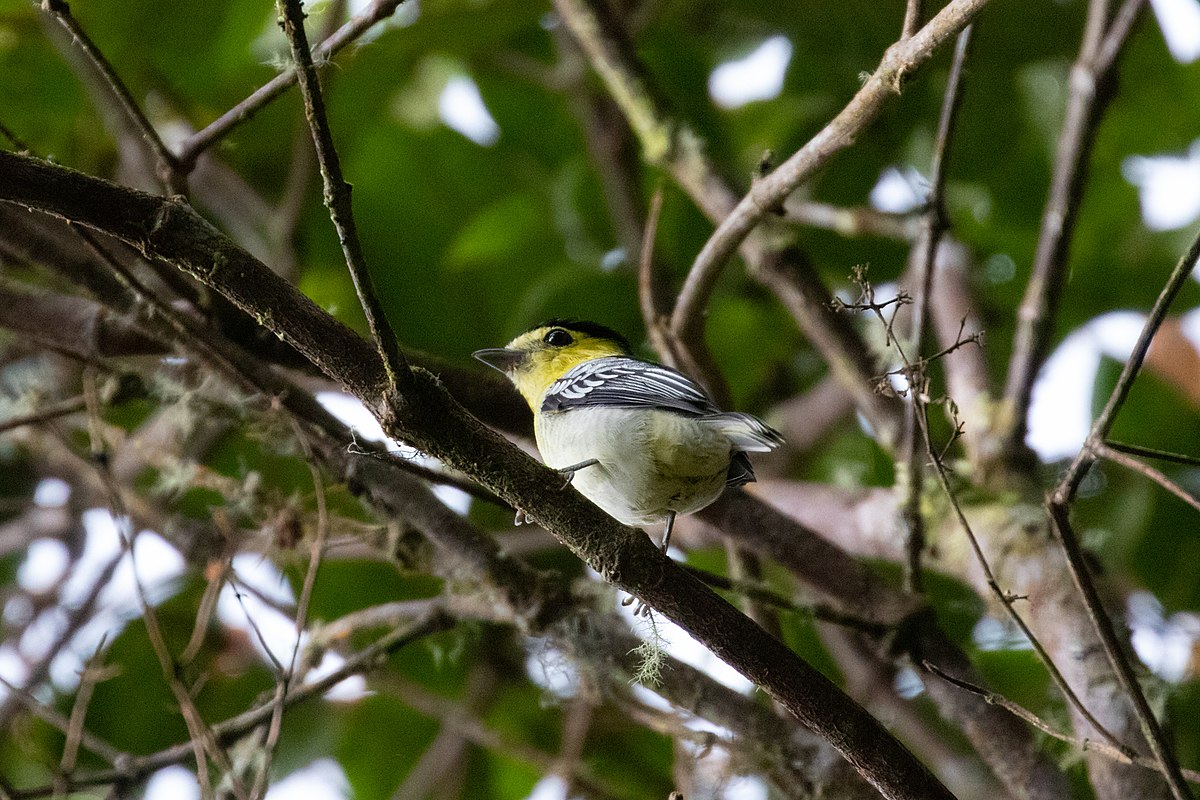
Wikipedia: Barred becard
![]() The barred becard (Pachyramphus versicolor) is a small passerine bird which is a resident breeding species in highlands from Costa Rica to northwestern Ecuador and northern Bolivia. It has traditionally been placed in Cotingidae or Tyrannidae, but evidence strongly suggests it belongs in Tityridae, where it is now placed by the South American Classification Committee.[2]
[more]
The barred becard (Pachyramphus versicolor) is a small passerine bird which is a resident breeding species in highlands from Costa Rica to northwestern Ecuador and northern Bolivia. It has traditionally been placed in Cotingidae or Tyrannidae, but evidence strongly suggests it belongs in Tityridae, where it is now placed by the South American Classification Committee.[2]
[more]
Pachyramphus polychopterus / White-winged becard (Pachyramphus polychopterus)
Profil Wikipedia Xeno-Canto

Wikipedia: White-winged becard
![]() The white-winged becard (Pachyramphus polychopterus) is a species of bird in the family Tityridae. It has traditionally been placed in Cotingidae or Tyrannidae, but evidence strongly suggest it is better placed in Tityridae,[2] where it is now placed by the South American Classification Committee. The species contains 8 subspecies that vary markedly in plumage and voice, and it has been suggested that they represent more than one species.
[more]
The white-winged becard (Pachyramphus polychopterus) is a species of bird in the family Tityridae. It has traditionally been placed in Cotingidae or Tyrannidae, but evidence strongly suggest it is better placed in Tityridae,[2] where it is now placed by the South American Classification Committee. The species contains 8 subspecies that vary markedly in plumage and voice, and it has been suggested that they represent more than one species.
[more]
Pachyramphus albogriseus / Black-and-white becard (Pachyramphus albogriseus)
Profil Wikipedia Xeno-Canto

Wikipedia: Black-and-white becard
![]() The black-and-white becard (Pachyramphus albogriseus) is a species of bird in the family Tityridae. It has traditionally been placed in Cotingidae or Tyrannidae, but evidence strongly suggest it is better placed in Tityridae,[2] where it is now placed by the South American Classification Committee. It is found in Colombia, Costa Rica, Ecuador, Panama, Peru, and Venezuela. Its natural habitats are subtropical or tropical dry forests and subtropical or tropical moist montane forests.
[more]
The black-and-white becard (Pachyramphus albogriseus) is a species of bird in the family Tityridae. It has traditionally been placed in Cotingidae or Tyrannidae, but evidence strongly suggest it is better placed in Tityridae,[2] where it is now placed by the South American Classification Committee. It is found in Colombia, Costa Rica, Ecuador, Panama, Peru, and Venezuela. Its natural habitats are subtropical or tropical dry forests and subtropical or tropical moist montane forests.
[more]
Pachyramphus homochrous / One-colored becard (Pachyramphus homochrous)
Profil Wikipedia Xeno-Canto

Wikipedia: One-colored becard
![]() The one-colored becard (Pachyramphus homochrous) is a species of bird in the family Tityridae. It has traditionally been placed in Cotingidae or Tyrannidae, but evidence strongly suggest it is better placed in Tityridae,[2] where it is now placed by the South American Classification Committee.
[more]
The one-colored becard (Pachyramphus homochrous) is a species of bird in the family Tityridae. It has traditionally been placed in Cotingidae or Tyrannidae, but evidence strongly suggest it is better placed in Tityridae,[2] where it is now placed by the South American Classification Committee.
[more]
Pachyramphus rufus / Cinereous becard (Pachyramphus rufus)
Profil Wikipedia Xeno-Canto

Wikipedia: Cinereous becard
![]() The cinereous becard (Pachyramphus rufus) is a species of bird in the family Tityridae. The term cinereous describes its colouration. It has traditionally been placed in Cotingidae or Tyrannidae, but evidence strongly suggest it is better placed in Tityridae,[2] where it is now placed by the South American Classification Committee.
[more]
The cinereous becard (Pachyramphus rufus) is a species of bird in the family Tityridae. The term cinereous describes its colouration. It has traditionally been placed in Cotingidae or Tyrannidae, but evidence strongly suggest it is better placed in Tityridae,[2] where it is now placed by the South American Classification Committee.
[more]
Gattung Tityra:
Tityra inquisitor / Black-crowned tityra (Tityra inquisitor)
Profil Wikipedia Xeno-Canto

Wikipedia: Black-crowned tityra
![]() The black-crowned tityra (Tityra inquisitor) is a medium-sized passerine bird. It has traditionally been placed in the cotinga or the tyrant flycatcher family, but evidence strongly suggest it is better placed in Tityridae.
[more]
The black-crowned tityra (Tityra inquisitor) is a medium-sized passerine bird. It has traditionally been placed in the cotinga or the tyrant flycatcher family, but evidence strongly suggest it is better placed in Tityridae.
[more]
Tityra semifasciata / Masked tityra (Tityra semifasciata)
Profil Wikipedia Xeno-Canto
Cahal pech resort masked tityra tentative ID by Merlin. 2018-02-05 17.22.32 null
![]() The masked tityra (Tityra semifasciata) is a medium-sized passerine bird. It has traditionally been placed in the cotinga or the tyrant flycatcher family, but evidence strongly suggests that it is better placed in Tityridae,[2] where it is now placed by the South American Classification Committee.
[more]
The masked tityra (Tityra semifasciata) is a medium-sized passerine bird. It has traditionally been placed in the cotinga or the tyrant flycatcher family, but evidence strongly suggests that it is better placed in Tityridae,[2] where it is now placed by the South American Classification Committee.
[more]
Gattung Mionectes:
Mionectes olivaceus / Olive-striped flycatcher (Mionectes olivaceus)
Profil Wikipedia Xeno-Canto

Wikipedia: Olive-striped flycatcher
![]() The olive-striped flycatcher (Mionectes olivaceus) is a species of bird in the family Tyrannidae.
[more]
The olive-striped flycatcher (Mionectes olivaceus) is a species of bird in the family Tyrannidae.
[more]
Mionectes oleagineus / Ochre-bellied flycatcher (Mionectes oleagineus)

Wikipedia: Ochre-bellied flycatcher
![]() The ochre-bellied flycatcher (Mionectes oleagineus) is a small bird of the tyrant flycatcher family. It breeds from southern Mexico through Central America, and South America east of the Andes as far as southern Brazil, and on Trinidad and Tobago.
[more]
The ochre-bellied flycatcher (Mionectes oleagineus) is a small bird of the tyrant flycatcher family. It breeds from southern Mexico through Central America, and South America east of the Andes as far as southern Brazil, and on Trinidad and Tobago.
[more]
Gattung Terenotriccus:
Terenotriccus erythrurus / Ruddy-tailed flycatcher (Terenotriccus erythrurus)

Wikipedia: Ruddy-tailed flycatcher
![]() The ruddy-tailed flycatcher (Terenotriccus erythrurus) is a small passerine bird in the family Tityridae. It breeds in lowlands from southeastern Mexico to northern Bolivia, north-central Brazil and the Guianas. This flycatcher ranges east of the Andes cordillera into the entire Amazon Basin of northern Brazil and the Guianas; to the west of the Andes in Colombia and Ecuador into Central America. It is the only member of the genus Terenotriccus, but some authorities place it in genus Myiobius. However, it differs in voice, behaviour, and structure from members of that group.
[more]
The ruddy-tailed flycatcher (Terenotriccus erythrurus) is a small passerine bird in the family Tityridae. It breeds in lowlands from southeastern Mexico to northern Bolivia, north-central Brazil and the Guianas. This flycatcher ranges east of the Andes cordillera into the entire Amazon Basin of northern Brazil and the Guianas; to the west of the Andes in Colombia and Ecuador into Central America. It is the only member of the genus Terenotriccus, but some authorities place it in genus Myiobius. However, it differs in voice, behaviour, and structure from members of that group.
[more]
Gattung Contopus:
Contopus sordidulus / Western wood-pewee (Contopus sordidulus)
Profil Wikipedia Audubon Xeno-Canto
Arenal western wood-pewee tentative ID by Merlin. 2018-03-01 07.50.38 null
![]() The western wood pewee (Contopus sordidulus) is a small tyrant flycatcher. Adults are gray-olive on the upperparts[2] with light underparts, washed with olive on the breast. They have two wing bars and a dark bill with yellow at the base of the lower mandible. This bird is very similar in appearance to the eastern wood pewee; the two birds were formerly considered to be one species. The call of C. sordidulus is a loud buzzy peeer; the song consists of three rapid descending tsees ending with a descending peeer.
[more]
The western wood pewee (Contopus sordidulus) is a small tyrant flycatcher. Adults are gray-olive on the upperparts[2] with light underparts, washed with olive on the breast. They have two wing bars and a dark bill with yellow at the base of the lower mandible. This bird is very similar in appearance to the eastern wood pewee; the two birds were formerly considered to be one species. The call of C. sordidulus is a loud buzzy peeer; the song consists of three rapid descending tsees ending with a descending peeer.
[more]
Contopus virens / Eastern wood-pewee (Contopus virens)
Profil Wikipedia Audubon Xeno-Canto
Eastern wood pewee, last new bird we discovered - at the parking lot shortly before leaving, Oregon Ridge. 2021-06-19 09.34.10 null
![]() The eastern wood pewee (Contopus virens) is a small tyrant flycatcher from North America. This bird and the western wood pewee (C. sordidulus) were formerly considered to be a single species. The two species are virtually identical in appearance, and can be distinguished most easily by their calls.
[more]
The eastern wood pewee (Contopus virens) is a small tyrant flycatcher from North America. This bird and the western wood pewee (C. sordidulus) were formerly considered to be a single species. The two species are virtually identical in appearance, and can be distinguished most easily by their calls.
[more]
Fichtentyrann / Olive-sided flycatcher (Contopus cooperi)
Profil Wikipedia Audubon Xeno-Canto

Wikipedia: Olive-sided flycatcher
![]() The olive-sided flycatcher (Contopus cooperi) is a passerine bird. It is a medium-sized tyrant flycatcher.
[more]
The olive-sided flycatcher (Contopus cooperi) is a passerine bird. It is a medium-sized tyrant flycatcher.
[more]
Contopus cinereus / Tropical pewee (Contopus cinereus)
Profil Wikipedia Xeno-Canto

Wikipedia: Tropical pewee
![]() The tropical pewee or southern tropical pewee (Contopus cinereus) is a small passerine bird in the tyrant flycatcher family. It breeds from southern Mexico and Trinidad south to Bolivia and Argentina. The taxon punensis, found in south-western Ecuador and western Peru, is usually included as a subspecies of the tropical pewee, but it has been suggested it should be considered a separate species, the Tumbes pewee (Contopus punensis) .
[more]
The tropical pewee or southern tropical pewee (Contopus cinereus) is a small passerine bird in the tyrant flycatcher family. It breeds from southern Mexico and Trinidad south to Bolivia and Argentina. The taxon punensis, found in south-western Ecuador and western Peru, is usually included as a subspecies of the tropical pewee, but it has been suggested it should be considered a separate species, the Tumbes pewee (Contopus punensis) .
[more]
Contopus lugubris / Dark pewee (Contopus lugubris)
Profil Wikipedia Xeno-Canto

Wikipedia: Dark pewee
![]() The dark pewee (Contopus lugubris) is a small passerine bird in the tyrant flycatcher family. It is endemic to the Talamancan montane forests of Costa Rica and western Panama.
[more]
The dark pewee (Contopus lugubris) is a small passerine bird in the tyrant flycatcher family. It is endemic to the Talamancan montane forests of Costa Rica and western Panama.
[more]
Contopus ochraceus / Ochraceous pewee (Contopus ochraceus)
Profil Wikipedia Xeno-Canto

Wikipedia: Ochraceous pewee
![]() The ochraceous pewee (Contopus ochraceus) is a species of bird in the family Tyrannidae. It is found in Costa Rica and western Panama. Its natural habitat is subtropical or tropical moist montane forests.
[more]
The ochraceous pewee (Contopus ochraceus) is a species of bird in the family Tyrannidae. It is found in Costa Rica and western Panama. Its natural habitat is subtropical or tropical moist montane forests.
[more]
Gattung Aphanotriccus:
Aphanotriccus capitalis / Tawny-chested flycatcher (Aphanotriccus capitalis)

Wikipedia: Tawny-chested flycatcher
![]() The tawny-chested flycatcher (Aphanotriccus capitalis) or Salvin's flycatcher, is a small passerine bird in the tyrant flycatcher family. It breeds in Caribbean lowlands and foothills up to 1000 m altitude from eastern Nicaragua to northern Costa Rica, although all Nicaraguan records are historical specimens collected near Lake Nicaragua or its outflow.
[more]
The tawny-chested flycatcher (Aphanotriccus capitalis) or Salvin's flycatcher, is a small passerine bird in the tyrant flycatcher family. It breeds in Caribbean lowlands and foothills up to 1000 m altitude from eastern Nicaragua to northern Costa Rica, although all Nicaraguan records are historical specimens collected near Lake Nicaragua or its outflow.
[more]
Aphanotriccus audax / Black-billed flycatcher (Aphanotriccus audax)

Wikipedia: Black-billed flycatcher
![]() The black-billed flycatcher (Aphanotriccus audax) is a species of bird in the family Tyrannidae. It was first described by American naturalist Edward William Nelson in 1912 as Praedo audax.[2] It is found in Colombia and Panama[3] and its natural habitat is subtropical or tropical moist lowland forests. It is threatened by habitat loss.[1]
[more]
The black-billed flycatcher (Aphanotriccus audax) is a species of bird in the family Tyrannidae. It was first described by American naturalist Edward William Nelson in 1912 as Praedo audax.[2] It is found in Colombia and Panama[3] and its natural habitat is subtropical or tropical moist lowland forests. It is threatened by habitat loss.[1]
[more]
Gattung Mitrephanes:
Mitrephanes phaeocercus / Tufted flycatcher (Mitrephanes phaeocercus)
Profil Wikipedia Xeno-Canto

Wikipedia: Tufted flycatcher
![]() The northern tufted flycatcher or simply tufted flycatcher (Mitrephanes phaeocercus) is a small passerine bird in the tyrant flycatcher family. It breeds in highlands from northwestern Mexico to northwestern Ecuador. The olive flycatcher (Mitrephanes olivaceus) of Peru and Bolivia is now considered a separate species.
[more]
The northern tufted flycatcher or simply tufted flycatcher (Mitrephanes phaeocercus) is a small passerine bird in the tyrant flycatcher family. It breeds in highlands from northwestern Mexico to northwestern Ecuador. The olive flycatcher (Mitrephanes olivaceus) of Peru and Bolivia is now considered a separate species.
[more]
Gattung Sublegatus:
Sublegatus arenarum / Northern scrub-flycatcher (Sublegatus arenarum)
Profil Wikipedia Xeno-Canto

Wikipedia: Northern scrub-flycatcher
![]() The northern scrub flycatcher (Sublegatus arenarum) is a species of bird in the family Tyrannidae.
It is found in Aruba, Brazil, Colombia, Costa Rica, French Guiana, Guyana, Netherlands Antilles, Panama, Suriname, Trinidad and Tobago, and Venezuela.
Its natural habitats are subtropical or tropical dry forest, subtropical or tropical moist lowland forest, subtropical or tropical mangrove forest, and subtropical or tropical dry shrubland.
[more]
The northern scrub flycatcher (Sublegatus arenarum) is a species of bird in the family Tyrannidae.
It is found in Aruba, Brazil, Colombia, Costa Rica, French Guiana, Guyana, Netherlands Antilles, Panama, Suriname, Trinidad and Tobago, and Venezuela.
Its natural habitats are subtropical or tropical dry forest, subtropical or tropical moist lowland forest, subtropical or tropical mangrove forest, and subtropical or tropical dry shrubland.
[more]
Gattung Myiobius:
Myiobius atricaudus / Black-tailed flycatcher (Myiobius atricaudus)
Profil Wikipedia Xeno-Canto
Wikipedia: Black-tailed flycatcher
![]() The black-tailed myiobius or black-tailed flycatcher (Myiobius atricaudus) is a species of passerine bird in the family Tityridae. It was previously placed in the family Tyrannidae.[2] Black-tailed flycatchers are found in Brazil, Colombia, Costa Rica, Ecuador, Panama, Peru, and Venezuela.[3] Their natural habitats are subtropical or tropical moist lowland forests and heavily degraded former forest. They are usually found alone or in pairs, but may join flocks of several species.[3]
[more]
The black-tailed myiobius or black-tailed flycatcher (Myiobius atricaudus) is a species of passerine bird in the family Tityridae. It was previously placed in the family Tyrannidae.[2] Black-tailed flycatchers are found in Brazil, Colombia, Costa Rica, Ecuador, Panama, Peru, and Venezuela.[3] Their natural habitats are subtropical or tropical moist lowland forests and heavily degraded former forest. They are usually found alone or in pairs, but may join flocks of several species.[3]
[more]
Myiobius sulphureipygius / Sulphur-rumped flycatcher (Myiobius sulphureipygius)
Profil Wikipedia Xeno-Canto

Wikipedia: Sulphur-rumped flycatcher
![]() The sulphur-rumped myiobius or sulphur-rumped flycatcher (Myiobius sulphureipygius) is a species of passerine bird in the family Tityridae. It is found in Belize, Colombia, Costa Rica, Ecuador, Guatemala, Honduras, Mexico, Nicaragua, and Panama. Its natural habitat is subtropical or tropical moist lowland forests.
[more]
The sulphur-rumped myiobius or sulphur-rumped flycatcher (Myiobius sulphureipygius) is a species of passerine bird in the family Tityridae. It is found in Belize, Colombia, Costa Rica, Ecuador, Guatemala, Honduras, Mexico, Nicaragua, and Panama. Its natural habitat is subtropical or tropical moist lowland forests.
[more]
Gattung Myiarchus:
Myiarchus crinitus / Great crested flycatcher (Myiarchus crinitus)
Profil Wikipedia Audubon Xeno-Canto

Wikipedia: Great crested flycatcher
![]() The great crested flycatcher (Myiarchus crinitus) is a large insect-eating bird of the tyrant flycatcher family. It is the most widespread member of the genus Myiarchus in North America, and is found over most of the eastern and mid-western portions of the continent.[2] It dwells mostly in the treetops and rarely is found on the ground.[3]
[more]
The great crested flycatcher (Myiarchus crinitus) is a large insect-eating bird of the tyrant flycatcher family. It is the most widespread member of the genus Myiarchus in North America, and is found over most of the eastern and mid-western portions of the continent.[2] It dwells mostly in the treetops and rarely is found on the ground.[3]
[more]
Myiarchus nuttingi / Nutting's flycatcher (Myiarchus nuttingi)

Wikipedia: Nutting's flycatcher
![]() Nutting's flycatcher (Myiarchus nuttingi) is a passerine bird in the tyrant flycatcher family. It breeds in semi-arid desert scrub and tropical deciduous forest from western Mexico to northwest Costa Rica. It is normally a year-round resident, but has been known as an occasional vagrant to southern California and Arizona–(southeastern, central, and western), in the United States. It is named for the zoologist Charles Cleveland Nutting.
[more]
Nutting's flycatcher (Myiarchus nuttingi) is a passerine bird in the tyrant flycatcher family. It breeds in semi-arid desert scrub and tropical deciduous forest from western Mexico to northwest Costa Rica. It is normally a year-round resident, but has been known as an occasional vagrant to southern California and Arizona–(southeastern, central, and western), in the United States. It is named for the zoologist Charles Cleveland Nutting.
[more]
Myiarchus tyrannulus / Brown-crested flycatcher (Myiarchus tyrannulus)
Profil Wikipedia Audubon Xeno-Canto

Wikipedia: Brown-crested flycatcher
![]() The brown-crested flycatcher (Myiarchus tyrannulus) is a passerine bird in the tyrant flycatcher family.
[more]
The brown-crested flycatcher (Myiarchus tyrannulus) is a passerine bird in the tyrant flycatcher family.
[more]
Myiarchus tuberculifer / Dusky-capped flycatcher (Myiarchus tuberculifer)
Profil Wikipedia Audubon Xeno-Canto

Wikipedia: Dusky-capped flycatcher
![]() The dusky-capped flycatcher (Myiarchus tuberculifer) is a passerine bird in the tyrant flycatcher family. It breeds in forest and other woodland from southern Arizona, as well as the Chisos Mountains, Texas, south to northern Argentina and on Trinidad. It is resident in most of its range, but American breeders retreat to Mexico in winter.
[more]
The dusky-capped flycatcher (Myiarchus tuberculifer) is a passerine bird in the tyrant flycatcher family. It breeds in forest and other woodland from southern Arizona, as well as the Chisos Mountains, Texas, south to northern Argentina and on Trinidad. It is resident in most of its range, but American breeders retreat to Mexico in winter.
[more]
Myiarchus panamensis / Panama flycatcher (Myiarchus panamensis)
Profil Wikipedia Xeno-Canto

Wikipedia: Panama flycatcher
![]() The Panamanian flycatcher (Myiarchus panamensis) is a species of bird in the family Tyrannidae. It is found in Colombia, Costa Rica, Panama, and Venezuela. Its natural habitats are subtropical or tropical dry forest, subtropical or tropical moist lowland forest, subtropical or tropical mangrove forest, subtropical or tropical dry shrubland, and heavily degraded former forest.
[more]
The Panamanian flycatcher (Myiarchus panamensis) is a species of bird in the family Tyrannidae. It is found in Colombia, Costa Rica, Panama, and Venezuela. Its natural habitats are subtropical or tropical dry forest, subtropical or tropical moist lowland forest, subtropical or tropical mangrove forest, subtropical or tropical dry shrubland, and heavily degraded former forest.
[more]
Gattung Fluvicola:
Fluvicola pica / Pied water-tyrant (Fluvicola pica)
Profil Wikipedia Xeno-Canto

Wikipedia: Pied water-tyrant
![]() The pied water tyrant (Fluvicola pica) is a small passerine bird in the tyrant flycatcher family. It breeds in tropical South America from Panama and Trinidad south to Bolivia and Argentina.
[more]
The pied water tyrant (Fluvicola pica) is a small passerine bird in the tyrant flycatcher family. It breeds in tropical South America from Panama and Trinidad south to Bolivia and Argentina.
[more]
Gattung Leptopogon:
Leptopogon superciliaris / Slaty-capped flycatcher (Leptopogon superciliaris)
Profil Wikipedia Xeno-Canto
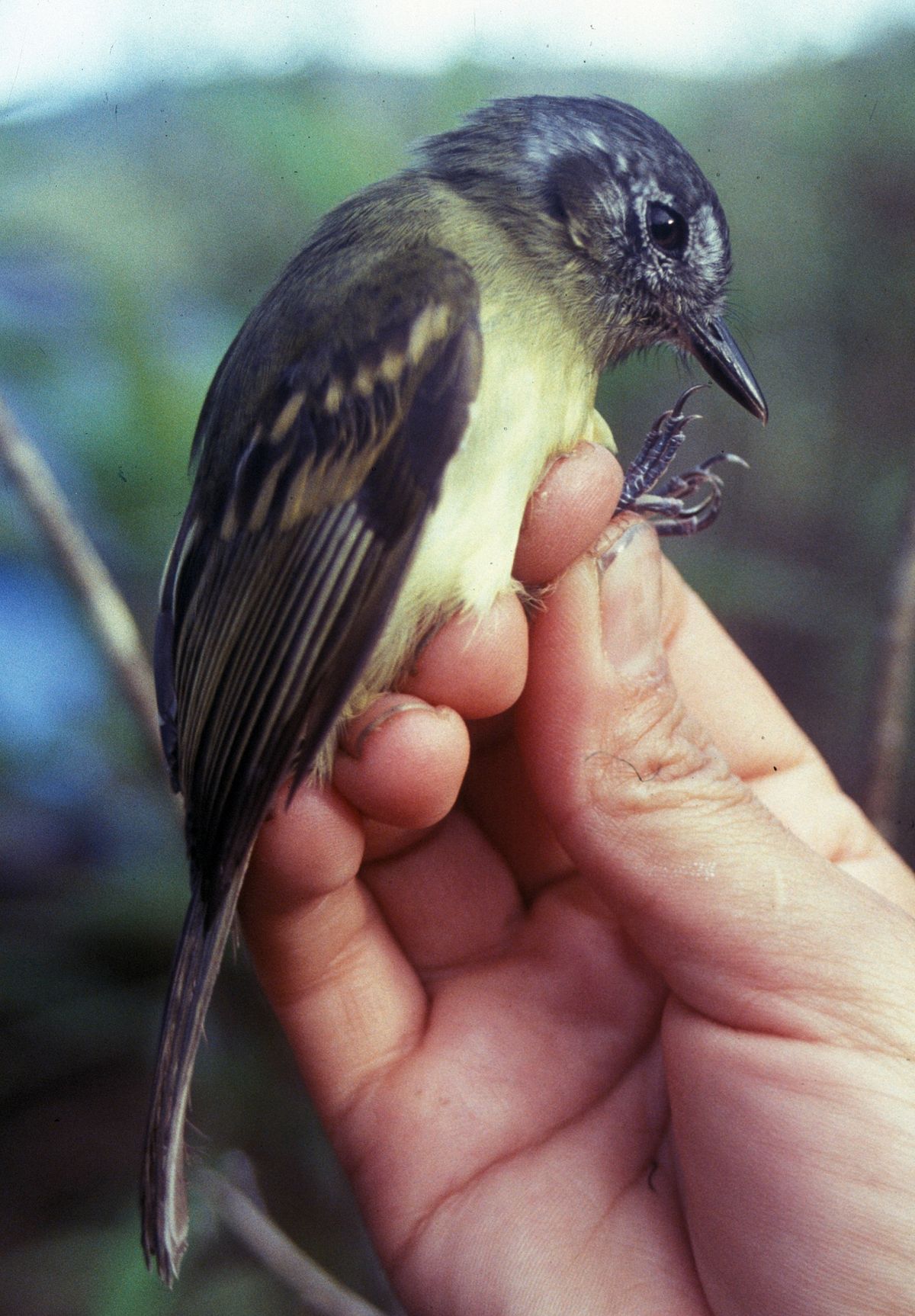
Wikipedia: Slaty-capped flycatcher
![]() The slaty-capped flycatcher (Leptopogon superciliaris) is a small passerine bird in the tyrant flycatcher family. It is found in northern Bolivia to Costa Rica and in Trinidad.
[more]
The slaty-capped flycatcher (Leptopogon superciliaris) is a small passerine bird in the tyrant flycatcher family. It is found in northern Bolivia to Costa Rica and in Trinidad.
[more]
Leptopogon amaurocephalus / Sepia-capped flycatcher (Leptopogon amaurocephalus)
Profil Wikipedia Xeno-Canto

Wikipedia: Sepia-capped flycatcher
![]() The sepia-capped flycatcher (Leptopogon amaurocephalus) is a species of bird in the family Tyrannidae.
[more]
The sepia-capped flycatcher (Leptopogon amaurocephalus) is a species of bird in the family Tyrannidae.
[more]
Gattung Myiopagis:
Myiopagis viridicata / Greenish elaenia (Myiopagis viridicata)
Profil Wikipedia Xeno-Canto

Wikipedia: Greenish elaenia
![]() The greenish elaenia (Myiopagis viridicata) is a species of bird in the family Tyrannidae, the tyrant flycatchers.
It is found in Argentina, Belize, Bolivia, Brazil, Colombia, Costa Rica, Ecuador, El Salvador, Guatemala, Guyana, Honduras, Mexico, Nicaragua, Panama, Paraguay, Peru, the United States, and Venezuela.
Its natural habitats are subtropical or tropical dry forests, subtropical or tropical moist lowland forests, and heavily degraded former forest.
[more]
The greenish elaenia (Myiopagis viridicata) is a species of bird in the family Tyrannidae, the tyrant flycatchers.
It is found in Argentina, Belize, Bolivia, Brazil, Colombia, Costa Rica, Ecuador, El Salvador, Guatemala, Guyana, Honduras, Mexico, Nicaragua, Panama, Paraguay, Peru, the United States, and Venezuela.
Its natural habitats are subtropical or tropical dry forests, subtropical or tropical moist lowland forests, and heavily degraded former forest.
[more]
Myiopagis caniceps / Gray elaenia (Myiopagis caniceps)
Profil Wikipedia Xeno-Canto
Wikipedia: Gray elaenia
![]() The grey elaenia (Myiopagis caniceps) is a species of bird in the family Tyrannidae. It is found in Argentina, Bolivia, Brazil, Colombia, Ecuador, French Guiana, Guyana, Panama, Paraguay, Peru, and Venezuela. Its natural habitat is subtropical or tropical moist lowland forest.
[more]
The grey elaenia (Myiopagis caniceps) is a species of bird in the family Tyrannidae. It is found in Argentina, Bolivia, Brazil, Colombia, Ecuador, French Guiana, Guyana, Panama, Paraguay, Peru, and Venezuela. Its natural habitat is subtropical or tropical moist lowland forest.
[more]
Myiopagis gaimardii / Forest elaenia (Myiopagis gaimardii)
Profil Wikipedia Xeno-Canto

Wikipedia: Forest elaenia
![]() The forest elaenia (Myiopagis gaimardii) is a small passerine bird in the tyrant flycatcher family. It breeds from Panama through Colombia, Venezuela and the Guianas to Bolivia and Brazil. It also occurs on Trinidad.
[more]
The forest elaenia (Myiopagis gaimardii) is a small passerine bird in the tyrant flycatcher family. It breeds from Panama through Colombia, Venezuela and the Guianas to Bolivia and Brazil. It also occurs on Trinidad.
[more]
Gattung Todirostrum:
Todirostrum cinereum / Common tody flycatcher (Todirostrum cinereum)

Wikipedia: Common tody flycatcher
![]() The common tody-flycatcher or black-fronted tody-flycatcher (Todirostrum cinereum) is a very small passerine bird in the tyrant flycatcher family. It breeds from southern Mexico to northwestern Peru, eastern Bolivia and southern, eastern and northeast Brazil.
[more]
The common tody-flycatcher or black-fronted tody-flycatcher (Todirostrum cinereum) is a very small passerine bird in the tyrant flycatcher family. It breeds from southern Mexico to northwestern Peru, eastern Bolivia and southern, eastern and northeast Brazil.
[more]
Todirostrum nigriceps / Black-headed tody-flycatcher (Todirostrum nigriceps)
Profil Wikipedia Xeno-Canto

Wikipedia: Black-headed tody-flycatcher
![]() The black-headed tody-flycatcher (Todirostrum nigriceps) is a species of bird in the family Tyrannidae.
It is found in Colombia, Costa Rica, Ecuador, Panama, and Venezuela.
Its natural habitat is subtropical or tropical moist lowland forests.
[more]
The black-headed tody-flycatcher (Todirostrum nigriceps) is a species of bird in the family Tyrannidae.
It is found in Colombia, Costa Rica, Ecuador, Panama, and Venezuela.
Its natural habitat is subtropical or tropical moist lowland forests.
[more]
Gattung Rhytipterna:
Rhytipterna holerythra / Rufous mourner (Rhytipterna holerythra)
Profil Wikipedia Xeno-Canto
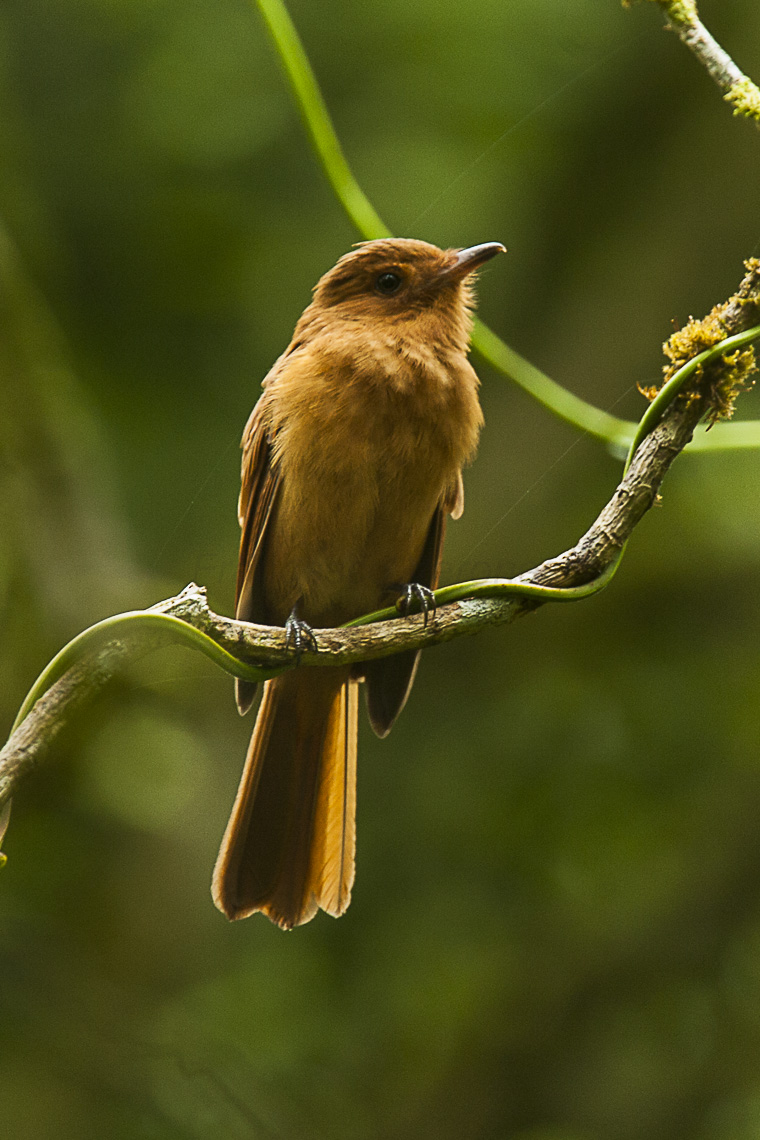
Wikipedia: Rufous mourner
![]() The rufous mourner (Rhytipterna holerythra) is a small passerine bird in the tyrant flycatcher family. It breeds from southwestern Mexico to northwestern Ecuador. It was formerly believed to be a cotinga, but well-supported anatomical evidence has shown it to be related to tyrant flycatchers of the genera Myiarchus, Sirystes and Casiornis.[2]
[more]
The rufous mourner (Rhytipterna holerythra) is a small passerine bird in the tyrant flycatcher family. It breeds from southwestern Mexico to northwestern Ecuador. It was formerly believed to be a cotinga, but well-supported anatomical evidence has shown it to be related to tyrant flycatchers of the genera Myiarchus, Sirystes and Casiornis.[2]
[more]
Gattung Sapayoa:
Tyrannenbreitrachen / Broad-billed sapayoa (Sapayoa aenigma)

Wikipedia: Broad-billed sapayoa
![]() The sapayoa or broad-billed sapayoa (Sapayoa aenigma) is a suboscine passerine found in lowland rainforests in Panama and north-western South America. As the epithet aenigma ("the enigma") implies, its relationships have long been elusive. It is easy to overlook, but appears to be common in a wide range and is not considered threatened by the IUCN.[1][2]
[more]
The sapayoa or broad-billed sapayoa (Sapayoa aenigma) is a suboscine passerine found in lowland rainforests in Panama and north-western South America. As the epithet aenigma ("the enigma") implies, its relationships have long been elusive. It is easy to overlook, but appears to be common in a wide range and is not considered threatened by the IUCN.[1][2]
[more]
Gattung Laniocera:
Laniocera rufescens / Speckled mourner (Laniocera rufescens)
Profil Wikipedia Xeno-Canto

Wikipedia: Speckled mourner
![]() The speckled mourner (Laniocera rufescens) is a species of bird in the family Tityridae. It has traditionally been placed in the family Cotingidae, but evidence strongly suggest it is better placed in Tityridae,[2] where it is now placed by the SACC. It is found in Belize, Colombia, Costa Rica, Ecuador, Guatemala, Honduras, Mexico, Nicaragua, and Panama. Its natural habitat is subtropical or tropical moist lowland forest.
[more]
The speckled mourner (Laniocera rufescens) is a species of bird in the family Tityridae. It has traditionally been placed in the family Cotingidae, but evidence strongly suggest it is better placed in Tityridae,[2] where it is now placed by the SACC. It is found in Belize, Colombia, Costa Rica, Ecuador, Guatemala, Honduras, Mexico, Nicaragua, and Panama. Its natural habitat is subtropical or tropical moist lowland forest.
[more]
Gattung Colonia:
Colonia colonus / Long-tailed tyrant (Colonia colonus)
Profil Wikipedia Xeno-Canto

Wikipedia: Long-tailed tyrant
![]() The long-tailed tyrant (Colonia colonus) is a species of bird in the family Tyrannidae, the only member of genus Colonia.
[more]
The long-tailed tyrant (Colonia colonus) is a species of bird in the family Tyrannidae, the only member of genus Colonia.
[more]
Gattung Lophotriccus:
Lophotriccus pileatus / Scale-crested pygmy-tyrant (Lophotriccus pileatus)
Profil Wikipedia Xeno-Canto

Wikipedia: Scale-crested pygmy-tyrant
![]() The scale-crested pygmy tyrant (Lophotriccus pileatus) is a species of bird in the family Tyrannidae.
[more]
The scale-crested pygmy tyrant (Lophotriccus pileatus) is a species of bird in the family Tyrannidae.
[more]
Lophotriccus pilaris / Pale-eyed pygmy-tyrant (Lophotriccus pilaris)
Profil Wikipedia Xeno-Canto

Wikipedia: Pale-eyed pygmy-tyrant
![]() The pale-eyed pygmy tyrant (Atalotriccus pilaris) is a species of bird in the tyrant flycatcher family, Tyrannidae, where it makes up the monotypic genus Atalotriccus.[2]
[more]
The pale-eyed pygmy tyrant (Atalotriccus pilaris) is a species of bird in the tyrant flycatcher family, Tyrannidae, where it makes up the monotypic genus Atalotriccus.[2]
[more]
Gattung Myiornis:
Myiornis atricapillus / Black-capped pygmy-tyrant (Myiornis atricapillus)
Profil Wikipedia Xeno-Canto

Wikipedia: Black-capped pygmy-tyrant
![]() The black-capped pygmy tyrant (Myiornis atricapillus) is the smallest passerine bird in its range, though larger than its cousin, the short-tailed pygmy tyrant. This tyrant flycatcher occurs from Costa Rica to north-western Ecuador.
[more]
The black-capped pygmy tyrant (Myiornis atricapillus) is the smallest passerine bird in its range, though larger than its cousin, the short-tailed pygmy tyrant. This tyrant flycatcher occurs from Costa Rica to north-western Ecuador.
[more]
Gattung Cnipodectes:
Cnipodectes subbrunneus / Brownish twistwing (Cnipodectes subbrunneus)
Profil Wikipedia Xeno-Canto

Wikipedia: Brownish twistwing
![]() The brownish twistwing (Cnipodectes subbrunneus), also known as the brownish flycatcher, is a species of bird in the Tyrannidae. It was the only member of the genus Cnipodectes until the description of Cnipodectes superrufus in 2007.
[more]
The brownish twistwing (Cnipodectes subbrunneus), also known as the brownish flycatcher, is a species of bird in the Tyrannidae. It was the only member of the genus Cnipodectes until the description of Cnipodectes superrufus in 2007.
[more]
Gattung Oncostoma:
Oncostoma cinereigulare / Northern bentbill (Oncostoma cinereigulare)
Profil Wikipedia Xeno-Canto

Wikipedia: Northern bentbill
![]() The northern bentbill (Oncostoma cinereigulare) is a species of bird in the family Tyrannidae. It is found in Belize, Colombia, Costa Rica, El Salvador, Guatemala, Honduras, Mexico, Nicaragua, and Panama. Its natural habitats are subtropical or tropical dry forest, subtropical or tropical moist lowland forest, and heavily degraded former forest.
[more]
The northern bentbill (Oncostoma cinereigulare) is a species of bird in the family Tyrannidae. It is found in Belize, Colombia, Costa Rica, El Salvador, Guatemala, Honduras, Mexico, Nicaragua, and Panama. Its natural habitats are subtropical or tropical dry forest, subtropical or tropical moist lowland forest, and heavily degraded former forest.
[more]
Oncostoma olivaceum / Southern bentbill (Oncostoma olivaceum)
Profil Wikipedia Xeno-Canto
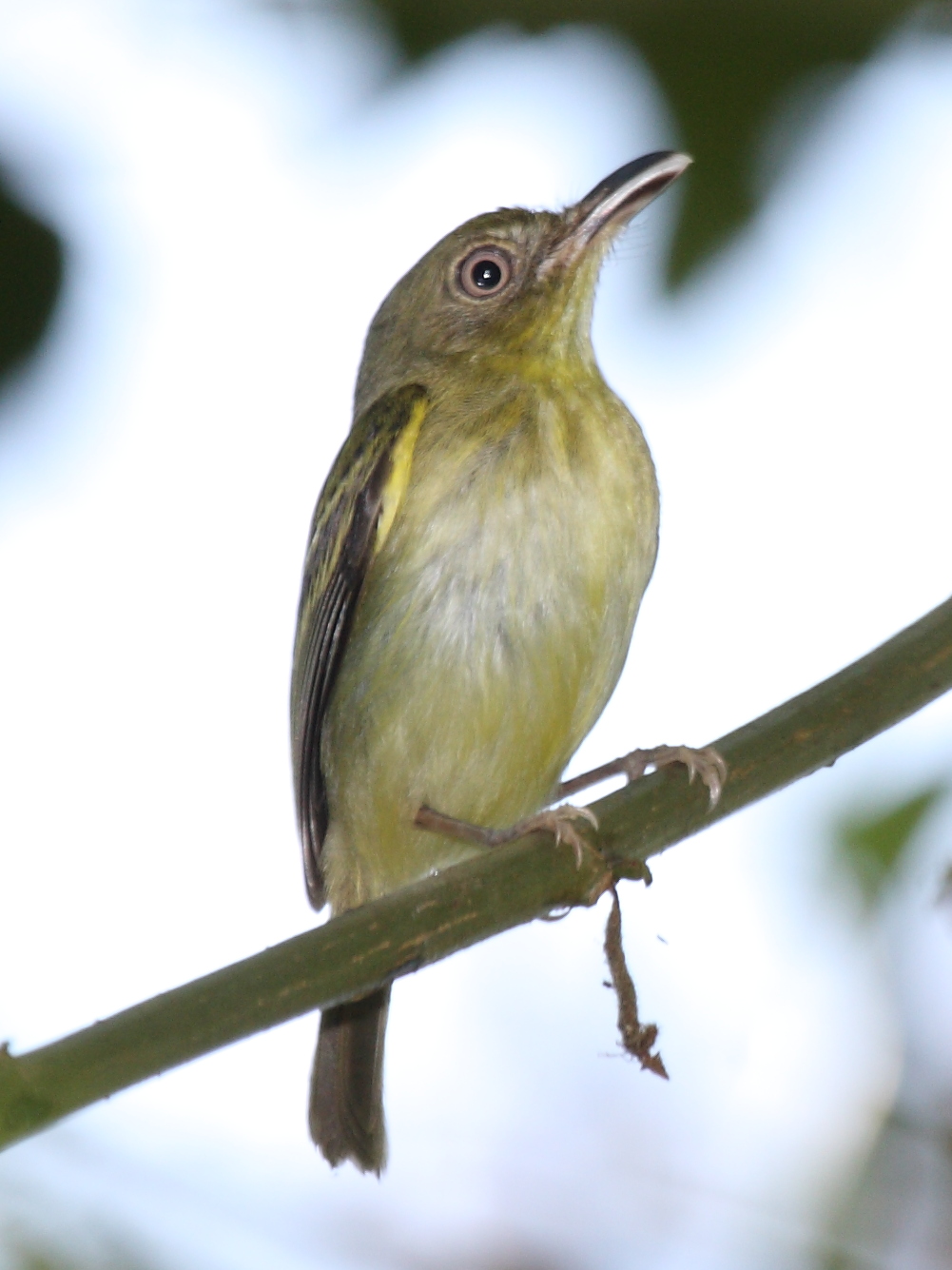
Wikipedia: Southern bentbill
![]() The southern bentbill (Oncostoma olivaceum) is a species of bird in the family Tyrannidae. It is found in Colombia and Panama. Its natural habitats are subtropical or tropical moist lowland forests and heavily degraded former forest.
[more]
The southern bentbill (Oncostoma olivaceum) is a species of bird in the family Tyrannidae. It is found in Colombia and Panama. Its natural habitats are subtropical or tropical moist lowland forests and heavily degraded former forest.
[more]
Gattung Onychorhynchus:
Onychorhynchus coronatus / Royal flycatcher (Onychorhynchus coronatus)
Profil Wikipedia Xeno-Canto

Wikipedia: Royal flycatcher
![]() The royal flycatchers are a genus, Onychorhynchus, of passerine birds in the family Tityridae[1][2] according to the IOC. Other taxonomic authorities including the AOU, Clements, and the IUCN, include it in Onychorhynchidae. Depending on authority, it includes a single widespread,[1] or four more localized species.[2] The specific epithet of the type species, coronatus, and the common name of all the species in this genus, royal flycatcher, refer to the striking, colourful crest,[3] which is seen displayed very rarely,[3] except after mating, while preening, in courtship as well as being handled.[3]
[more]
The royal flycatchers are a genus, Onychorhynchus, of passerine birds in the family Tityridae[1][2] according to the IOC. Other taxonomic authorities including the AOU, Clements, and the IUCN, include it in Onychorhynchidae. Depending on authority, it includes a single widespread,[1] or four more localized species.[2] The specific epithet of the type species, coronatus, and the common name of all the species in this genus, royal flycatcher, refer to the striking, colourful crest,[3] which is seen displayed very rarely,[3] except after mating, while preening, in courtship as well as being handled.[3]
[more]
Onychorhynchus mexicanus / Royal flycatcher (Onychorhynchus mexicanus)
Profil Wikipedia Xeno-Canto

Wikipedia: Royal flycatcher
![]() The royal flycatchers are a genus, Onychorhynchus, of passerine birds in the family Tityridae[1][2] according to the IOC. Other taxonomic authorities including the AOU, Clements, and the IUCN, include it in Onychorhynchidae. Depending on authority, it includes a single widespread,[1] or four more localized species.[2] The specific epithet of the type species, coronatus, and the common name of all the species in this genus, royal flycatcher, refer to the striking, colourful crest,[3] which is seen displayed very rarely,[3] except after mating, while preening, in courtship as well as being handled.[3]
[more]
The royal flycatchers are a genus, Onychorhynchus, of passerine birds in the family Tityridae[1][2] according to the IOC. Other taxonomic authorities including the AOU, Clements, and the IUCN, include it in Onychorhynchidae. Depending on authority, it includes a single widespread,[1] or four more localized species.[2] The specific epithet of the type species, coronatus, and the common name of all the species in this genus, royal flycatcher, refer to the striking, colourful crest,[3] which is seen displayed very rarely,[3] except after mating, while preening, in courtship as well as being handled.[3]
[more]
Gattung Capsiempis:
Capsiempis flaveola / Yellow tyrannulet (Capsiempis flaveola)

Wikipedia: Yellow tyrannulet
![]() The yellow tyrannulet (Capsiempis flaveola) is a very small passerine bird in the tyrant flycatcher family. It breeds from Nicaragua south to northeastern Argentina and southeastern Brazil. It is the only member of the genus Capsiempis, but its taxonomy is uncertain, and it has been allocated to at least three other genera in the past.
[more]
The yellow tyrannulet (Capsiempis flaveola) is a very small passerine bird in the tyrant flycatcher family. It breeds from Nicaragua south to northeastern Argentina and southeastern Brazil. It is the only member of the genus Capsiempis, but its taxonomy is uncertain, and it has been allocated to at least three other genera in the past.
[more]
Gattung Platyrinchus:
Platyrinchus cancrominus / Stub-tailed spadebill (Platyrinchus cancrominus)
Profil Wikipedia Xeno-Canto
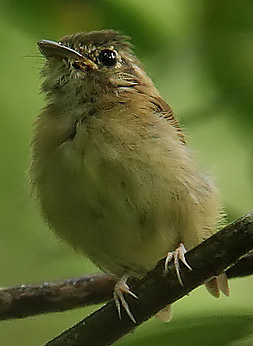
Wikipedia: Stub-tailed spadebill
![]() The stub-tailed spadebill (Platyrinchus cancrominus) is a passerine bird in the Tyrannidae family. It is commonly found in tropical dry rainforests or tropical moist lowlands throughout Central America.[2] First scientifically described in 1860, it was originally thought to be the same as Platyrinchus mystaceus but was later reclassified as a sympatric species. The stub-tailed spadebill may grow up to 9.5 cm (3.74 in) long and may weigh up to 12 g (0.42 oz). It has a white throat, yellow breast, and brown mantle and wings. The stub-tailed spadebill is most easily recognizable due to its stubby tail, broad bill, and its distinctive bird song. Some morphological differences like its greatly reduced crown differentiate it from other related species.
[more]
The stub-tailed spadebill (Platyrinchus cancrominus) is a passerine bird in the Tyrannidae family. It is commonly found in tropical dry rainforests or tropical moist lowlands throughout Central America.[2] First scientifically described in 1860, it was originally thought to be the same as Platyrinchus mystaceus but was later reclassified as a sympatric species. The stub-tailed spadebill may grow up to 9.5 cm (3.74 in) long and may weigh up to 12 g (0.42 oz). It has a white throat, yellow breast, and brown mantle and wings. The stub-tailed spadebill is most easily recognizable due to its stubby tail, broad bill, and its distinctive bird song. Some morphological differences like its greatly reduced crown differentiate it from other related species.
[more]
Platyrinchus coronatus / Golden-crowned spadebill (Platyrinchus coronatus)
Profil Wikipedia Xeno-Canto

Wikipedia: Golden-crowned spadebill
![]() The golden-crowned spadebill (Platyrinchus coronatus) is a species of bird in the family Tyrannidae. It is found in Bolivia, Brazil, Colombia, Costa Rica, Ecuador, French Guiana, Guyana, Honduras, Nicaragua, Panama, Peru, Suriname, and Venezuela. Its natural habitat is subtropical or tropical moist lowland forests.
[more]
The golden-crowned spadebill (Platyrinchus coronatus) is a species of bird in the family Tyrannidae. It is found in Bolivia, Brazil, Colombia, Costa Rica, Ecuador, French Guiana, Guyana, Honduras, Nicaragua, Panama, Peru, Suriname, and Venezuela. Its natural habitat is subtropical or tropical moist lowland forests.
[more]
Platyrinchus mystaceus / White-throated spadebill (Platyrinchus mystaceus)
Profil Wikipedia Xeno-Canto

Wikipedia: White-throated spadebill
![]() The white-throated spadebill (Platyrinchus mystaceus) is a tiny passerine bird in the tyrant flycatcher family. It lives in the tropical Americas.
[more]
The white-throated spadebill (Platyrinchus mystaceus) is a tiny passerine bird in the tyrant flycatcher family. It lives in the tropical Americas.
[more]
Gattung Phyllomyias:
Phyllomyias burmeisteri / Rough-legged tyrannulet (Phyllomyias burmeisteri)
Profil Wikipedia Xeno-Canto
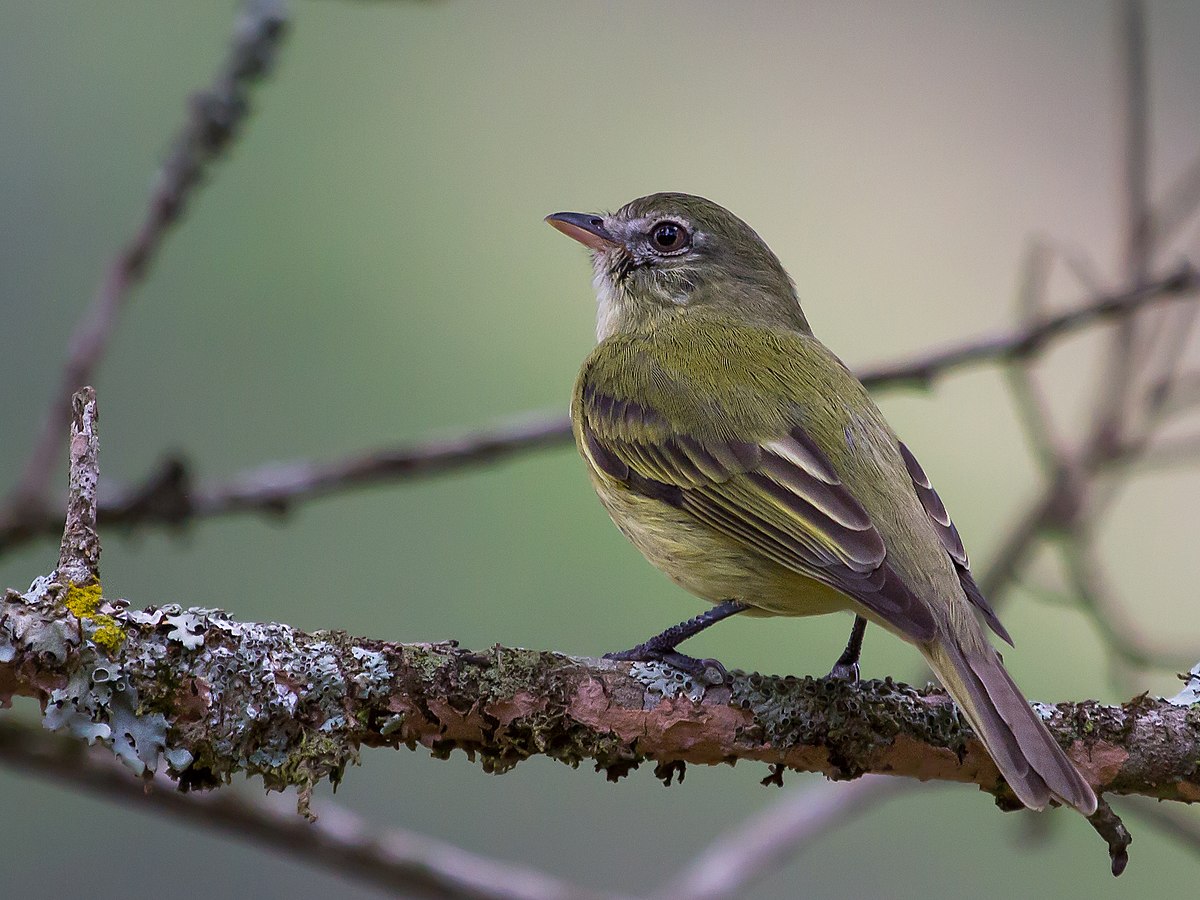
Wikipedia: Rough-legged tyrannulet
![]() The rough-legged tyrannulet (Phyllomyias burmeisteri) is a species of bird in the family Tyrannidae. It is found in Argentina, Bolivia, Brazil, Colombia, Costa Rica, Ecuador, Panama, Paraguay, Peru, and Venezuela. Its natural habitats are subtropical or tropical moist lowland forest and subtropical or tropical moist montane forest.
[more]
The rough-legged tyrannulet (Phyllomyias burmeisteri) is a species of bird in the family Tyrannidae. It is found in Argentina, Bolivia, Brazil, Colombia, Costa Rica, Ecuador, Panama, Paraguay, Peru, and Venezuela. Its natural habitats are subtropical or tropical moist lowland forest and subtropical or tropical moist montane forest.
[more]
Phyllomyias griseiceps / Sooty-headed tyrannulet (Phyllomyias griseiceps)
Profil Wikipedia Xeno-Canto

Wikipedia: Sooty-headed tyrannulet
![]() The sooty-headed tyrannulet (Phyllomyias griseiceps) is a species of bird in the family Tyrannidae. It is found in Brazil, Colombia, Ecuador, Guyana, Panama, Peru, and Venezuela.
[more]
The sooty-headed tyrannulet (Phyllomyias griseiceps) is a species of bird in the family Tyrannidae. It is found in Brazil, Colombia, Ecuador, Guyana, Panama, Peru, and Venezuela.
[more]
Gattung Tolmomyias:
Tolmomyias assimilis / Yellow-margined flycatcher (Tolmomyias assimilis)
Profil Wikipedia Xeno-Canto

Wikipedia: Yellow-margined flycatcher
![]() Zimmer's flatbill (Tolmomyias assimilis) or the yellow-margined flatbill is a species of bird in the tyrant flycatcher family Tyrannidae. It is found in humid forest in southern Central America, and the Chocó and Amazon in South America.
[more]
Zimmer's flatbill (Tolmomyias assimilis) or the yellow-margined flatbill is a species of bird in the tyrant flycatcher family Tyrannidae. It is found in humid forest in southern Central America, and the Chocó and Amazon in South America.
[more]
Tolmomyias sulphurescens / Yellow-olive flycatcher (Tolmomyias sulphurescens)
Profil Wikipedia Xeno-Canto

Wikipedia: Yellow-olive flycatcher
![]() The yellow-olive flatbill or yellow-olive flycatcher (Tolmomyias sulphurescens) is a species of bird in the family Tyrannidae. It is found in tropical and subtopical forest and woodland in Central and South America, but over its range there are significant variations in plumage, iris-colour and voice, leading to speculations that more than one species is involved. Its plumage is overall greenish-yellow, the lores are whitish, the crown is often greyish and some subspecies have a dusky patch on the auriculars. The flat bill is black above and pale pinkish or greyish below; similar to the yellow-margined flatbill, but unlike the grey-crowned flatbill.
[more]
The yellow-olive flatbill or yellow-olive flycatcher (Tolmomyias sulphurescens) is a species of bird in the family Tyrannidae. It is found in tropical and subtopical forest and woodland in Central and South America, but over its range there are significant variations in plumage, iris-colour and voice, leading to speculations that more than one species is involved. Its plumage is overall greenish-yellow, the lores are whitish, the crown is often greyish and some subspecies have a dusky patch on the auriculars. The flat bill is black above and pale pinkish or greyish below; similar to the yellow-margined flatbill, but unlike the grey-crowned flatbill.
[more]
Tolmomyias flaviventris / Yellow-breasted flycatcher (Tolmomyias flaviventris)
Profil Wikipedia Xeno-Canto

Wikipedia: Yellow-breasted flycatcher
![]() The ochre-lored flatbill (Tolmomyias flaviventris) or yellow-breasted flycatcher, is a passerine bird in the tyrant flycatcher family. It is found in South America, ranging from Colombia and Venezuela south to Peru, Bolivia, and Brazil, and on both Trinidad and Tobago. There are significant variations in its voice and plumage, with western birds duller and more olive, and eastern and northern birds brighter and more ochre-yellow. The two are sometimes considered separate species, the western olive-faced flatbill (or flycatcher), T. viridiceps, and the eastern and northern ochre-lored flatbill (or flycatcher), T. flaviventris.[2]
[more]
The ochre-lored flatbill (Tolmomyias flaviventris) or yellow-breasted flycatcher, is a passerine bird in the tyrant flycatcher family. It is found in South America, ranging from Colombia and Venezuela south to Peru, Bolivia, and Brazil, and on both Trinidad and Tobago. There are significant variations in its voice and plumage, with western birds duller and more olive, and eastern and northern birds brighter and more ochre-yellow. The two are sometimes considered separate species, the western olive-faced flatbill (or flycatcher), T. viridiceps, and the eastern and northern ochre-lored flatbill (or flycatcher), T. flaviventris.[2]
[more]
Gattung Poecilotriccus:
Poecilotriccus sylvia / Slate-headed tody-flycatcher (Poecilotriccus sylvia)
Profil Wikipedia Xeno-Canto

Wikipedia: Slate-headed tody-flycatcher
![]() The slaty-headed tody-flycatcher (Poecilotriccus sylvia) is a species of bird in the family Tyrannidae, and one of twelve in the genus Poecilotriccus.
[more]
The slaty-headed tody-flycatcher (Poecilotriccus sylvia) is a species of bird in the family Tyrannidae, and one of twelve in the genus Poecilotriccus.
[more]
Gattung Pseudotriccus:
Pseudotriccus pelzelni / Bronze-olive pygmy-tyrant (Pseudotriccus pelzelni)
Profil Wikipedia Xeno-Canto
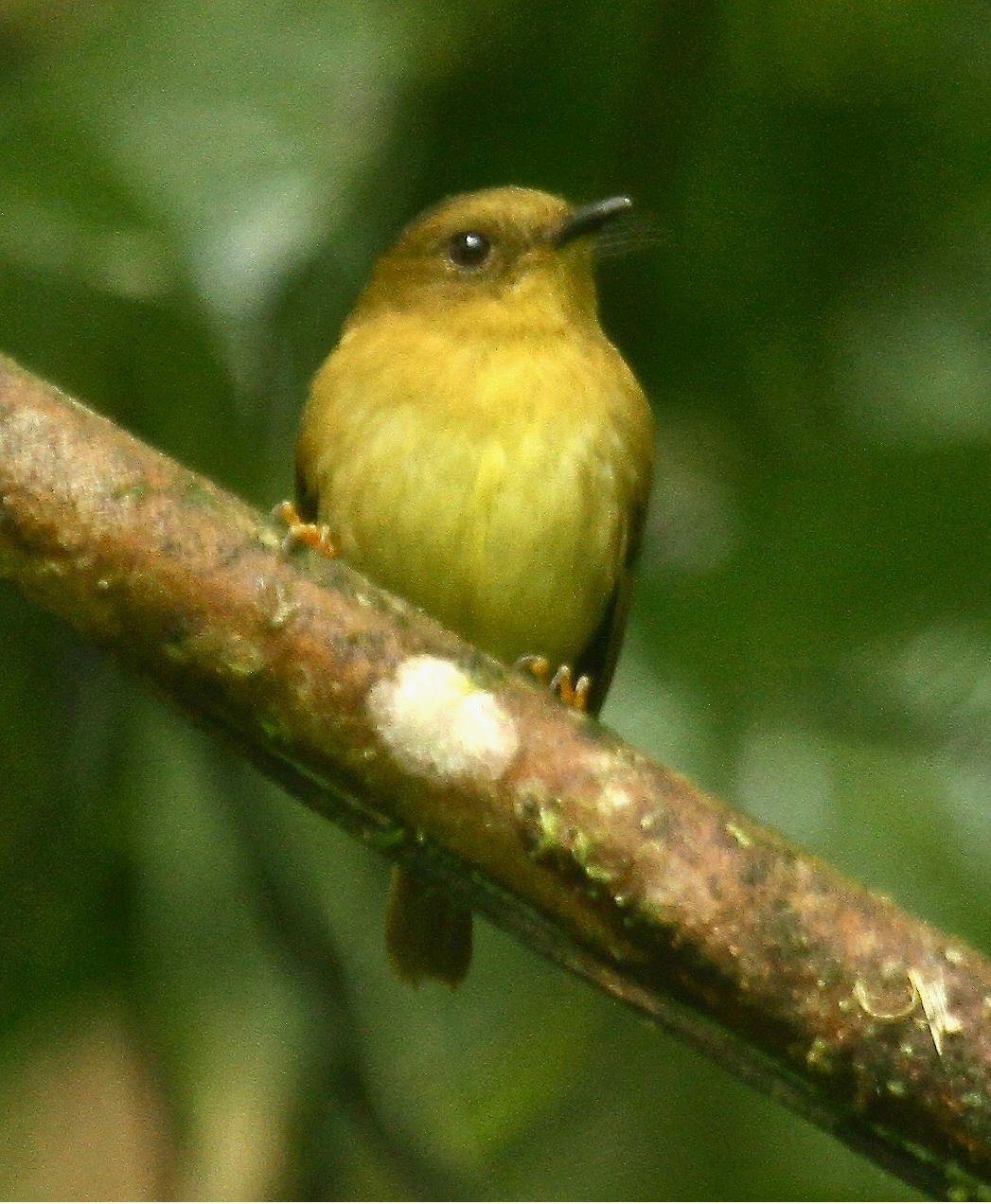
Wikipedia: Bronze-olive pygmy-tyrant
![]() The bronze-olive pygmy tyrant (Pseudotriccus pelzelni) is a species of bird in the family Tyrannidae. It is found in Colombia, Ecuador, Panama, and Peru. Its natural habitat is subtropical or tropical moist montane forests.
[more]
The bronze-olive pygmy tyrant (Pseudotriccus pelzelni) is a species of bird in the family Tyrannidae. It is found in Colombia, Ecuador, Panama, and Peru. Its natural habitat is subtropical or tropical moist montane forests.
[more]
Gattung Rhynchocyclus:
Rhynchocyclus brevirostris / Eye-ringed flatbill (Rhynchocyclus brevirostris)
Profil Wikipedia Xeno-Canto

Wikipedia: Eye-ringed flatbill
![]() The eye-ringed flatbill (Rhynchocyclus brevirostris) is a species of bird in the family Tyrannidae. It is found in Belize, Colombia, Costa Rica, El Salvador, Guatemala, Honduras, Mexico, Nicaragua, and Panama, with a slight incursion into Colombia at the south end of its range. Its natural habitats are subtropical or tropical moist lowland forests and subtropical or tropical moist montane forests.
[more]
The eye-ringed flatbill (Rhynchocyclus brevirostris) is a species of bird in the family Tyrannidae. It is found in Belize, Colombia, Costa Rica, El Salvador, Guatemala, Honduras, Mexico, Nicaragua, and Panama, with a slight incursion into Colombia at the south end of its range. Its natural habitats are subtropical or tropical moist lowland forests and subtropical or tropical moist montane forests.
[more]
Rhynchocyclus olivaceus / Olivaceous flatbill (Rhynchocyclus olivaceus)
Profil Wikipedia Xeno-Canto

Wikipedia: Olivaceous flatbill
![]() The olivaceous flatbill (Rhynchocyclus olivaceus) is a species of bird in the family Tyrannidae.
[more]
The olivaceous flatbill (Rhynchocyclus olivaceus) is a species of bird in the family Tyrannidae.
[more]
Gattung Myiodynastes:
Südlicher Fleckenmaskentyrann / Streaked flycatcher (Myiodynastes maculatus)
Profil Wikipedia Xeno-Canto
Streaked flycatcher. 2020-02-20 14.53.44 null
We saw this at Los Lagartos Restaurant on the grounds of Gamboa Rainforest Resort in Panama.
Allgemein: ![]() The streaked flycatcher (Myiodynastes maculatus) is a passerine bird in the tyrant flycatcher family.
[more]
The streaked flycatcher (Myiodynastes maculatus) is a passerine bird in the tyrant flycatcher family.
[more]
Myiodynastes luteiventris / Sulphur-bellied flycatcher (Myiodynastes luteiventris)
Profil Wikipedia Audubon Xeno-Canto
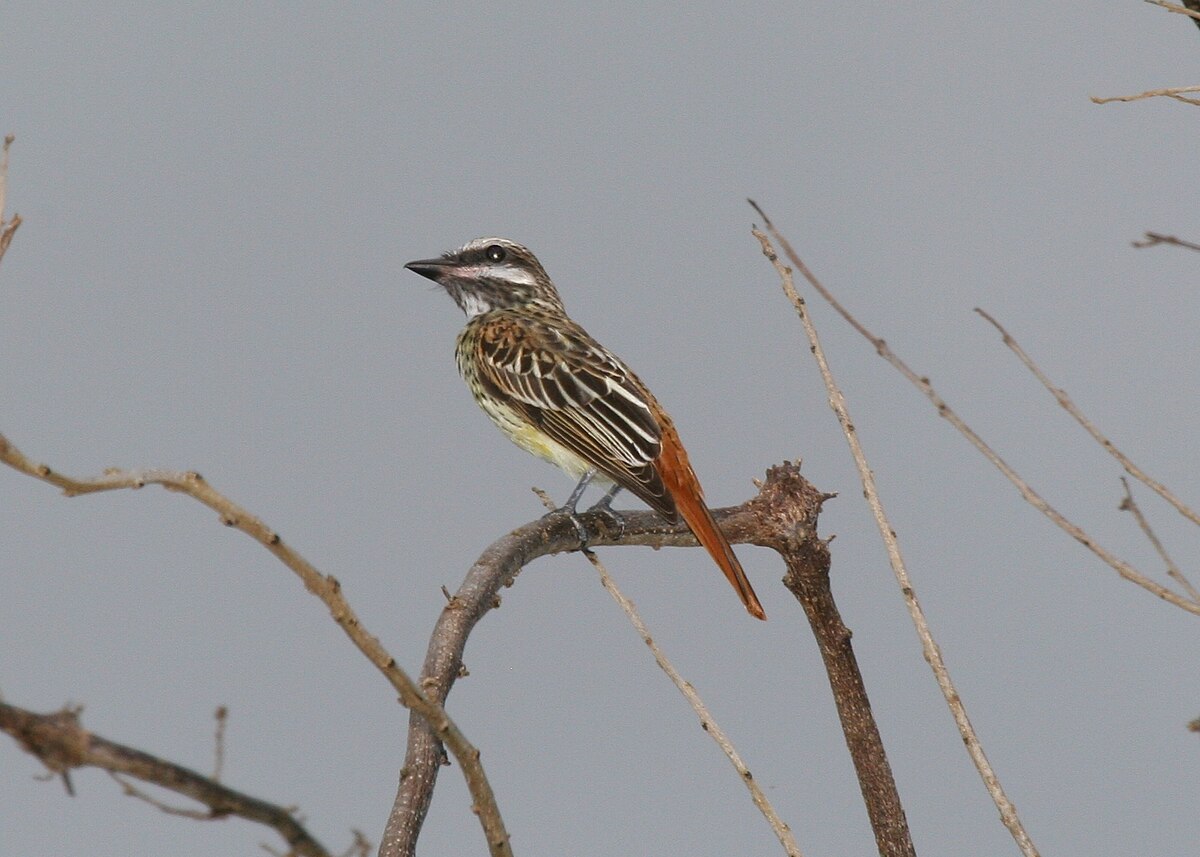
Wikipedia: Sulphur-bellied flycatcher
![]() The sulphur-bellied flycatcher (Myiodynastes luteiventris) is a large tyrant flycatcher. This bird breeds from southeasternmost Arizona of the United States (the Madrean sky islands region of Arizona, southwestern New Mexico, and northern Sonora, Mexico) to Costa Rica. They are short distance migrants, spending winters in the eastern Andean foothills of Colombia, Ecuador, Peru, Bolivia, and Brazil, and are passage migrants over the southern portions of Central America.
[more]
The sulphur-bellied flycatcher (Myiodynastes luteiventris) is a large tyrant flycatcher. This bird breeds from southeasternmost Arizona of the United States (the Madrean sky islands region of Arizona, southwestern New Mexico, and northern Sonora, Mexico) to Costa Rica. They are short distance migrants, spending winters in the eastern Andean foothills of Colombia, Ecuador, Peru, Bolivia, and Brazil, and are passage migrants over the southern portions of Central America.
[more]
Myiodynastes hemichrysus / Golden-bellied flycatcher (Myiodynastes hemichrysus)
Profil Wikipedia Xeno-Canto

Wikipedia: Golden-bellied flycatcher
![]() The golden-bellied flycatcher (Myiodynastes hemichrysus) is a passerine bird in the tyrant flycatcher family. It is an endemic resident breeder in Costa Rica and western Panama.
[more]
The golden-bellied flycatcher (Myiodynastes hemichrysus) is a passerine bird in the tyrant flycatcher family. It is an endemic resident breeder in Costa Rica and western Panama.
[more]
Myiodynastes chrysocephalus / Golden-crowned flycatcher (Myiodynastes chrysocephalus)
Profil Wikipedia Xeno-Canto

Wikipedia: Golden-crowned flycatcher
![]() The golden-crowned flycatcher (Myiodynastes chrysocephalus) is a species of bird in the family Tyrannidae.
[more]
The golden-crowned flycatcher (Myiodynastes chrysocephalus) is a species of bird in the family Tyrannidae.
[more]
Gattung Pitangus:
Schwefelmaskentyrann / Great kiskadee (Pitangus sulphuratus)
Profil Wikipedia Audubon Xeno-Canto
La fortuna Great kiskadee tenatative ID w wings spread. 2018-02-26 10.15.18 null
![]() Der Schwefelmaskentyrann (Pitangus sulphuratus), auch Schwefeltyrann genannt, ist ein Sperlingsvogel und die einzige Art der Gattung Pitangus.
[more]
Der Schwefelmaskentyrann (Pitangus sulphuratus), auch Schwefeltyrann genannt, ist ein Sperlingsvogel und die einzige Art der Gattung Pitangus.
[more]
Gattung Camptostoma:
Camptostoma imberbe / Northern beardless-tyrannulet (Camptostoma imberbe)
Profil Wikipedia Audubon Xeno-Canto

Wikipedia: Northern beardless-tyrannulet
![]() The northern beardless tyrannulet (Camptostoma imberbe) is a small passerine bird in the tyrant flycatcher family. It breeds from southeasternmost Arizona and Texas of the United States through Mexico and Central America to northwestern Costa Rica.
[more]
The northern beardless tyrannulet (Camptostoma imberbe) is a small passerine bird in the tyrant flycatcher family. It breeds from southeasternmost Arizona and Texas of the United States through Mexico and Central America to northwestern Costa Rica.
[more]
Camptostoma obsoletum / Southern beardless-tyrannulet (Camptostoma obsoletum)
Profil Wikipedia Xeno-Canto
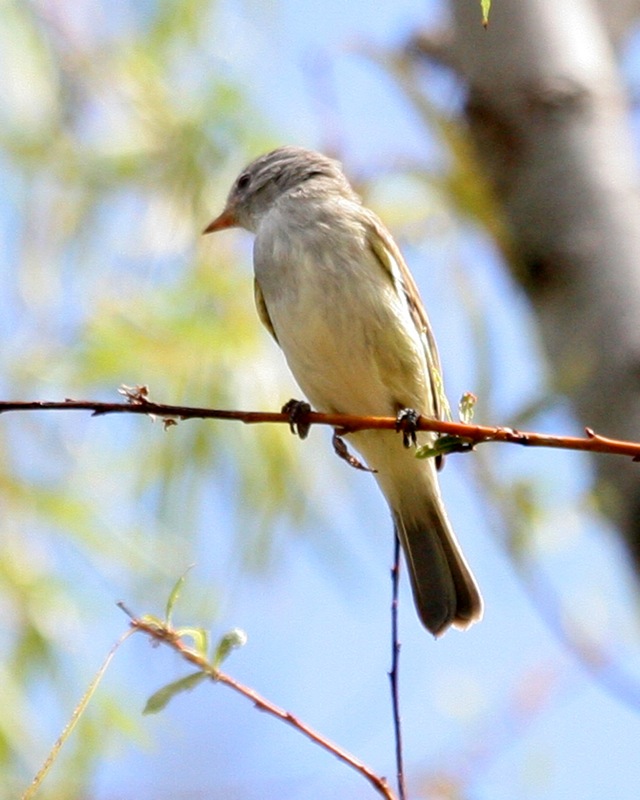
Wikipedia: Southern beardless-tyrannulet
![]() The southern beardless tyrannulet (Camptostoma obsoletum) is a small passerine bird in the tyrant flycatcher family. It breeds from Costa Rica through South America south to Paraguay, Bolivia, and Argentina.
[more]
The southern beardless tyrannulet (Camptostoma obsoletum) is a small passerine bird in the tyrant flycatcher family. It breeds from Costa Rica through South America south to Paraguay, Bolivia, and Argentina.
[more]
Gattung Serpophaga:
Serpophaga cinerea / Torrent tyrannulet (Serpophaga cinerea)
Profil Wikipedia Xeno-Canto

Wikipedia: Torrent tyrannulet
![]() The torrent tyrannulet (Serpophaga cinerea) is a small bird of the tyrant flycatcher family. It breeds from Costa Rica south to northern Bolivia and northwestern Venezuela.
[more]
The torrent tyrannulet (Serpophaga cinerea) is a small bird of the tyrant flycatcher family. It breeds from Costa Rica south to northern Bolivia and northwestern Venezuela.
[more]
Gattung Myiophobus:
Myiophobus fasciatus / Bran-colored flycatcher (Myiophobus fasciatus)
Profil Wikipedia Xeno-Canto

Wikipedia: Bran-colored flycatcher
![]() The bran-colored flycatcher (Myiophobus fasciatus) is a small passerine bird in the tyrant flycatcher family. It breeds from Costa Rica through South America to Bolivia, Uruguay, and Argentina. It also occurs on Trinidad.
[more]
The bran-colored flycatcher (Myiophobus fasciatus) is a small passerine bird in the tyrant flycatcher family. It breeds from Costa Rica through South America to Bolivia, Uruguay, and Argentina. It also occurs on Trinidad.
[more]
Gattung Ornithion:
Ornithion brunneicapillus / Brown-capped tyrannulet (Ornithion brunneicapillus)
Profil Wikipedia Xeno-Canto
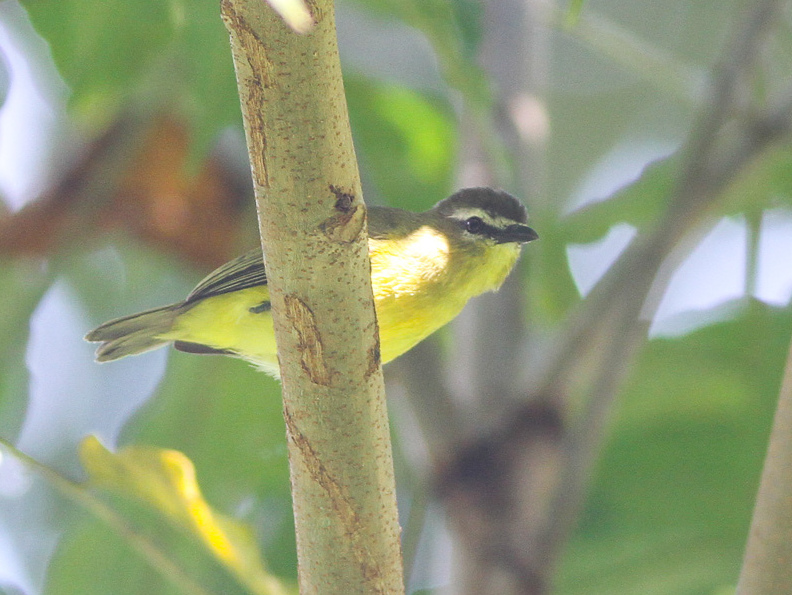
Wikipedia: Brown-capped tyrannulet
![]() The brown-capped tyrannulet (Ornithion brunneicapillus) is a species of bird in the family Tyrannidae. It is found in Colombia, Costa Rica, Ecuador, Panama, and Venezuela. Its natural habitats are subtropical or tropical moist lowland forests and heavily degraded former forest.
[more]
The brown-capped tyrannulet (Ornithion brunneicapillus) is a species of bird in the family Tyrannidae. It is found in Colombia, Costa Rica, Ecuador, Panama, and Venezuela. Its natural habitats are subtropical or tropical moist lowland forests and heavily degraded former forest.
[more]
Ornithion semiflavum / Yellow-bellied tyrannulet (Ornithion semiflavum)
Profil Wikipedia Xeno-Canto

Wikipedia: Yellow-bellied tyrannulet
![]() The yellow-bellied tyrannulet (Ornithion semiflavum) is a species of bird in the family Tyrannidae. It is found in Belize, Costa Rica, Guatemala, Honduras, Mexico, and Nicaragua. Its natural habitats are subtropical or tropical moist lowland forest and heavily degraded former forest.
[more]
The yellow-bellied tyrannulet (Ornithion semiflavum) is a species of bird in the family Tyrannidae. It is found in Belize, Costa Rica, Guatemala, Honduras, Mexico, and Nicaragua. Its natural habitats are subtropical or tropical moist lowland forest and heavily degraded former forest.
[more]
Gattung Phylloscartes:
Phylloscartes superciliaris / Rufous-browed tyrannulet (Phylloscartes superciliaris)
Profil Wikipedia Xeno-Canto

Wikipedia: Rufous-browed tyrannulet
![]() The rufous-browed tyrannulet (Phylloscartes superciliaris) is a species of bird in the family Tyrannidae.
[more]
The rufous-browed tyrannulet (Phylloscartes superciliaris) is a species of bird in the family Tyrannidae.
[more]
Gattung Tyrannulus:
Tyrannulus elatus / Yellow-crowned tyrannulet (Tyrannulus elatus)
Profil Wikipedia Xeno-Canto

Wikipedia: Yellow-crowned tyrannulet
![]() The yellow-crowned tyrannulet (Tyrannulus elatus) is a species of bird in the family Tyrannidae. It is monotypic within the genus Tyrannulus.[2] It is found in Bolivia, Brazil, Colombia, Costa Rica, Ecuador, French Guiana, Guyana, Panama, Peru, Suriname, and Venezuela, where its natural habitats are subtropical or tropical moist lowland forest, subtropical or tropical swamps, and heavily degraded former forest.[1]
[more]
The yellow-crowned tyrannulet (Tyrannulus elatus) is a species of bird in the family Tyrannidae. It is monotypic within the genus Tyrannulus.[2] It is found in Bolivia, Brazil, Colombia, Costa Rica, Ecuador, French Guiana, Guyana, Panama, Peru, Suriname, and Venezuela, where its natural habitats are subtropical or tropical moist lowland forest, subtropical or tropical swamps, and heavily degraded former forest.[1]
[more]
Gattung Zimmerius:
Zimmerius parvus / Mistletoe tyrannulet (Zimmerius parvus)
Profil Wikipedia Xeno-Canto

Wikipedia: Mistletoe tyrannulet
![]() The mistletoe tyrannulet (Zimmerius parvus) is a very small bird, a passerine in family Tyrannidae, the tyrant flycatchers.
[more]
The mistletoe tyrannulet (Zimmerius parvus) is a very small bird, a passerine in family Tyrannidae, the tyrant flycatchers.
[more]
Gattung Attila:
Attila spadiceus / Bright-rumped attila (Attila spadiceus)
Profil Wikipedia Xeno-Canto

Wikipedia: Bright-rumped attila
![]() The bright-rumped attila or polymorphic attila (Attila spadiceus) is a small passerine bird in the tyrant flycatcher family (Tyrannidae). It breeds from northwestern Mexico to western Ecuador, Bolivia and southeastern Brazil, and on Trinidad.
[more]
The bright-rumped attila or polymorphic attila (Attila spadiceus) is a small passerine bird in the tyrant flycatcher family (Tyrannidae). It breeds from northwestern Mexico to western Ecuador, Bolivia and southeastern Brazil, and on Trinidad.
[more]
Gattung Legatus:
Legatus leucophaius / Piratic flycatcher (Legatus leucophaius)
Profil Wikipedia Xeno-Canto
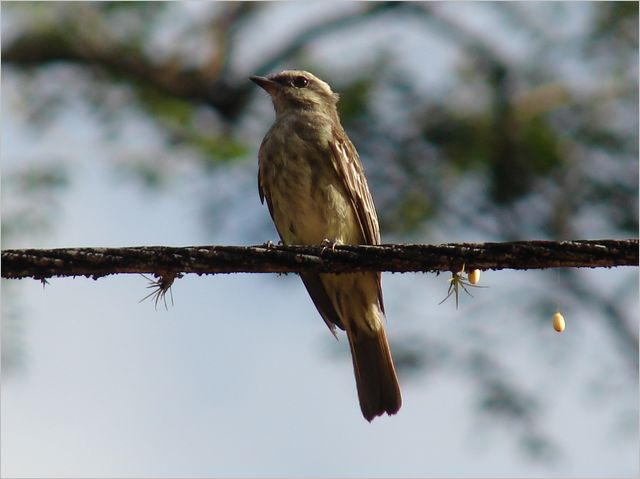
Wikipedia: Piratic flycatcher
![]() The piratic flycatcher (Legatus leucophaius) is a passerine bird, the only member of the genus Legatus. It is a resident breeder from southern Mexico and Trinidad south to Bolivia and Argentina. At least some birds from Central America and Trinidad are migratory, and this species also visits Tobago.
[more]
The piratic flycatcher (Legatus leucophaius) is a passerine bird, the only member of the genus Legatus. It is a resident breeder from southern Mexico and Trinidad south to Bolivia and Argentina. At least some birds from Central America and Trinidad are migratory, and this species also visits Tobago.
[more]
Gattung Megarynchus:
Megarynchus pitangua / Boat-billed flycatcher (Megarynchus pitangua)
Profil Wikipedia Xeno-Canto

Wikipedia: Boat-billed flycatcher
![]() The boat-billed flycatcher (Megarynchus pitangua) is a passerine bird. It is a large tyrant flycatcher, the only member of the monotypic genus Megarynchus.
[more]
The boat-billed flycatcher (Megarynchus pitangua) is a passerine bird. It is a large tyrant flycatcher, the only member of the monotypic genus Megarynchus.
[more]
Gattung Myiozetetes:
Myiozetetes granadensis / Gray-capped flycatcher (Myiozetetes granadensis)
Profil Wikipedia Xeno-Canto
La tarde last morning gray-capped flycatcher. 2018-03-11 10.56.34 null
![]() The grey-capped flycatcher (Myiozetetes granadensis) is a passerine bird, a member of the large tyrant flycatcher family.
[more]
The grey-capped flycatcher (Myiozetetes granadensis) is a passerine bird, a member of the large tyrant flycatcher family.
[more]
Myiozetetes similis / Social flycatcher (Myiozetetes similis)
Profil Wikipedia Xeno-Canto

Wikipedia: Social flycatcher
![]() The social flycatcher (Myiozetetes similis) is a passerine bird from the Americas, a member of the large tyrant flycatcher family (Tyrannidae).
[more]
The social flycatcher (Myiozetetes similis) is a passerine bird from the Americas, a member of the large tyrant flycatcher family (Tyrannidae).
[more]
Myiozetetes cayanensis / Rusty-margined flycatcher (Myiozetetes cayanensis)
Profil Wikipedia Xeno-Canto

Wikipedia: Rusty-margined flycatcher
![]() The rusty-margined flycatcher (Myiozetetes cayanensis) is a species of bird in the family Tyrannidae, the tyrant flycatchers.
[more]
The rusty-margined flycatcher (Myiozetetes cayanensis) is a species of bird in the family Tyrannidae, the tyrant flycatchers.
[more]
Gattung Sirystes:
Sirystes albogriseus / Choco sirystes (Sirystes albogriseus)
Profil Wikipedia Xeno-Canto

Wikipedia: Choco sirystes
![]() The western sirystes or Chocó sirystes (Sirystes albogriseus) is a species of bird in the family Tyrannidae. It was formerly considered conspecific with the sibilant sirystes.
[more]
The western sirystes or Chocó sirystes (Sirystes albogriseus) is a species of bird in the family Tyrannidae. It was formerly considered conspecific with the sibilant sirystes.
[more]
Gattung Philohydor:
Philohydor lictor / Lesser kiskadee (Philohydor lictor)

Wikipedia: Lesser kiskadee
![]() The lesser kiskadee (Philohydor lictor) is a species of passerine bird in the family Tyrannidae. It is the only species in the genus Philohydor. It is found in Argentina, Bermuda, Bolivia, Brazil, Colombia, Ecuador, French Guiana, Guyana, Panama, Peru, Suriname, Trinidad, Guatemala, and Venezuela. Its natural habitats are subtropical or tropical moist shrubland and swamps.
[more]
The lesser kiskadee (Philohydor lictor) is a species of passerine bird in the family Tyrannidae. It is the only species in the genus Philohydor. It is found in Argentina, Bermuda, Bolivia, Brazil, Colombia, Ecuador, French Guiana, Guyana, Panama, Peru, Suriname, Trinidad, Guatemala, and Venezuela. Its natural habitats are subtropical or tropical moist shrubland and swamps.
[more]
Gattung Conopias:
Conopias albovittatus / White-ringed flycatcher (Conopias albovittatus)
Profil Wikipedia Xeno-Canto

Wikipedia: White-ringed flycatcher
![]() The white-ringed flycatcher (Conopias albovittatus) is a species of bird in the family Tyrannidae.
[more]
The white-ringed flycatcher (Conopias albovittatus) is a species of bird in the family Tyrannidae.
[more]
Gattung Nesotriccus:
Nesotriccus murinus / Mouse-colored tyrannulet (Nesotriccus murinus)
Profil Wikipedia Xeno-Canto

Wikipedia: Mouse-colored tyrannulet
![]() The mouse-colored tyrannulet (Phaeomyias murina) is a species of bird in the tyrant flycatcher family Tyrannidae. It occurs in a wide range of scrubby and wooded habitats in tropical and subtropical South America, being absent from the southernmost part of the continent, the high Andes and dense rainforest. It also occurs in Panama and Costa Rica. It is generally common, but its small size and dull plumage results in it often being overlooked – or at least not identified, as it resembles several other tyrant flycatchers.
[more]
The mouse-colored tyrannulet (Phaeomyias murina) is a species of bird in the tyrant flycatcher family Tyrannidae. It occurs in a wide range of scrubby and wooded habitats in tropical and subtropical South America, being absent from the southernmost part of the continent, the high Andes and dense rainforest. It also occurs in Panama and Costa Rica. It is generally common, but its small size and dull plumage results in it often being overlooked – or at least not identified, as it resembles several other tyrant flycatchers.
[more]
Nesotriccus ridgwayi / Cocos flycatcher (Nesotriccus ridgwayi)
Profil Wikipedia Xeno-Canto

Wikipedia: Cocos flycatcher
![]() The Cocos flycatcher (Nesotriccus ridgwayi) is a species of bird in the family Tyrannidae, and the only species in the genus Nesotriccus.[3]
[more]
The Cocos flycatcher (Nesotriccus ridgwayi) is a species of bird in the family Tyrannidae, and the only species in the genus Nesotriccus.[3]
[more]
Familie Mimidae (Spottdrosseln):
Gattung Mimus:
Mimus gilvus / Tropical mockingbird (Mimus gilvus)
Profil Wikipedia Xeno-Canto
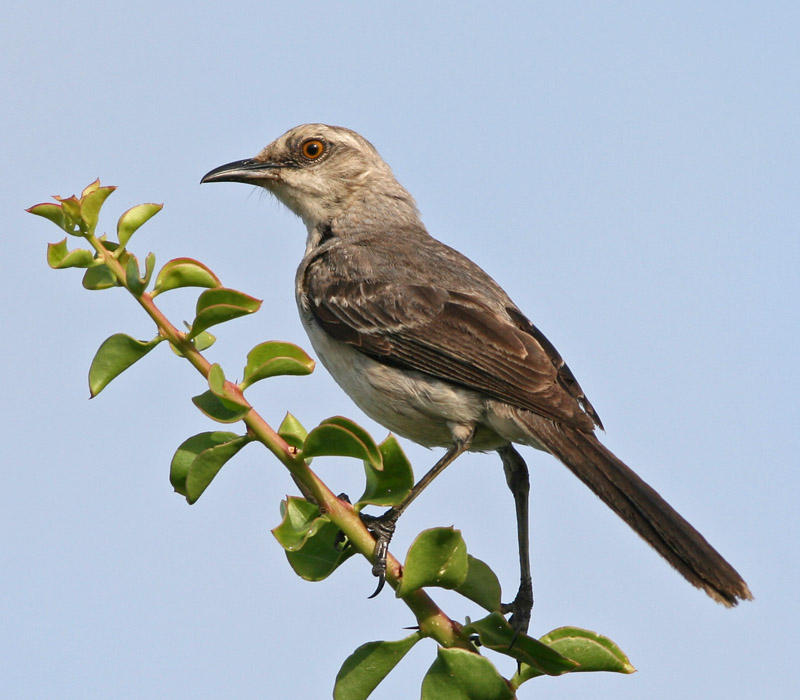
Wikipedia: Tropical mockingbird
![]() The tropical mockingbird (Mimus gilvus) is a resident breeding bird from southern Mexico south to northern Brazil, and in the Lesser Antilles and other Caribbean islands. The birds in Panama and Trinidad may have been introduced. The northern mockingbird (M. polyglottos) is its closest living relative, but the critically endangered Socorro mockingbird (M. graysoni) is also much closer to these two than previously believed .[2]
[more]
The tropical mockingbird (Mimus gilvus) is a resident breeding bird from southern Mexico south to northern Brazil, and in the Lesser Antilles and other Caribbean islands. The birds in Panama and Trinidad may have been introduced. The northern mockingbird (M. polyglottos) is its closest living relative, but the critically endangered Socorro mockingbird (M. graysoni) is also much closer to these two than previously believed .[2]
[more]
Gattung Dumetella:
Katzendrossel / Grey catbird (Dumetella carolinensis)
Catbird with cicada, Cherrywood Court, Hunt Valley, Maryland. 2021-06-12 17.11.36 null
![]() The gray catbird (Dumetella carolinensis), also spelled grey catbird, is a medium-sized North American and Central American perching bird of the mimid family. It is the only member of the "catbird" genus Dumetella. Like the black catbird (Melanoptila glabrirostris), it is among the basal lineages of the Mimidae, probably a closer relative of the Caribbean thrasher and trembler assemblage than of the mockingbirds and Toxostoma thrashers.[2][3] In some areas it is known as the slate-colored mockingbird.[4]
[more]
The gray catbird (Dumetella carolinensis), also spelled grey catbird, is a medium-sized North American and Central American perching bird of the mimid family. It is the only member of the "catbird" genus Dumetella. Like the black catbird (Melanoptila glabrirostris), it is among the basal lineages of the Mimidae, probably a closer relative of the Caribbean thrasher and trembler assemblage than of the mockingbirds and Toxostoma thrashers.[2][3] In some areas it is known as the slate-colored mockingbird.[4]
[more]
Gattung Donacobius:
Rohrspotter / Black-capped donacobius (Donacobius atricapilla)

Wikipedia: Black-capped donacobius
![]() The black-capped donacobius (Donacobius atricapilla) is a conspicuous, vocal South American bird. It is found in tropical swamps and wetlands in Argentina, Bolivia, Brazil, Colombia, Ecuador, French Guiana, Guyana, Paraguay, Peru, Suriname, and Venezuela; also Panama of Central America.[1]
[more]
The black-capped donacobius (Donacobius atricapilla) is a conspicuous, vocal South American bird. It is found in tropical swamps and wetlands in Argentina, Bolivia, Brazil, Colombia, Ecuador, French Guiana, Guyana, Paraguay, Peru, Suriname, and Venezuela; also Panama of Central America.[1]
[more]
Familie Certhiidae (Baumläufer):
Unterfamilie Troglodytinae:
Gattung Troglodytes:
Profil Wikipedia Audubon Xeno-Canto
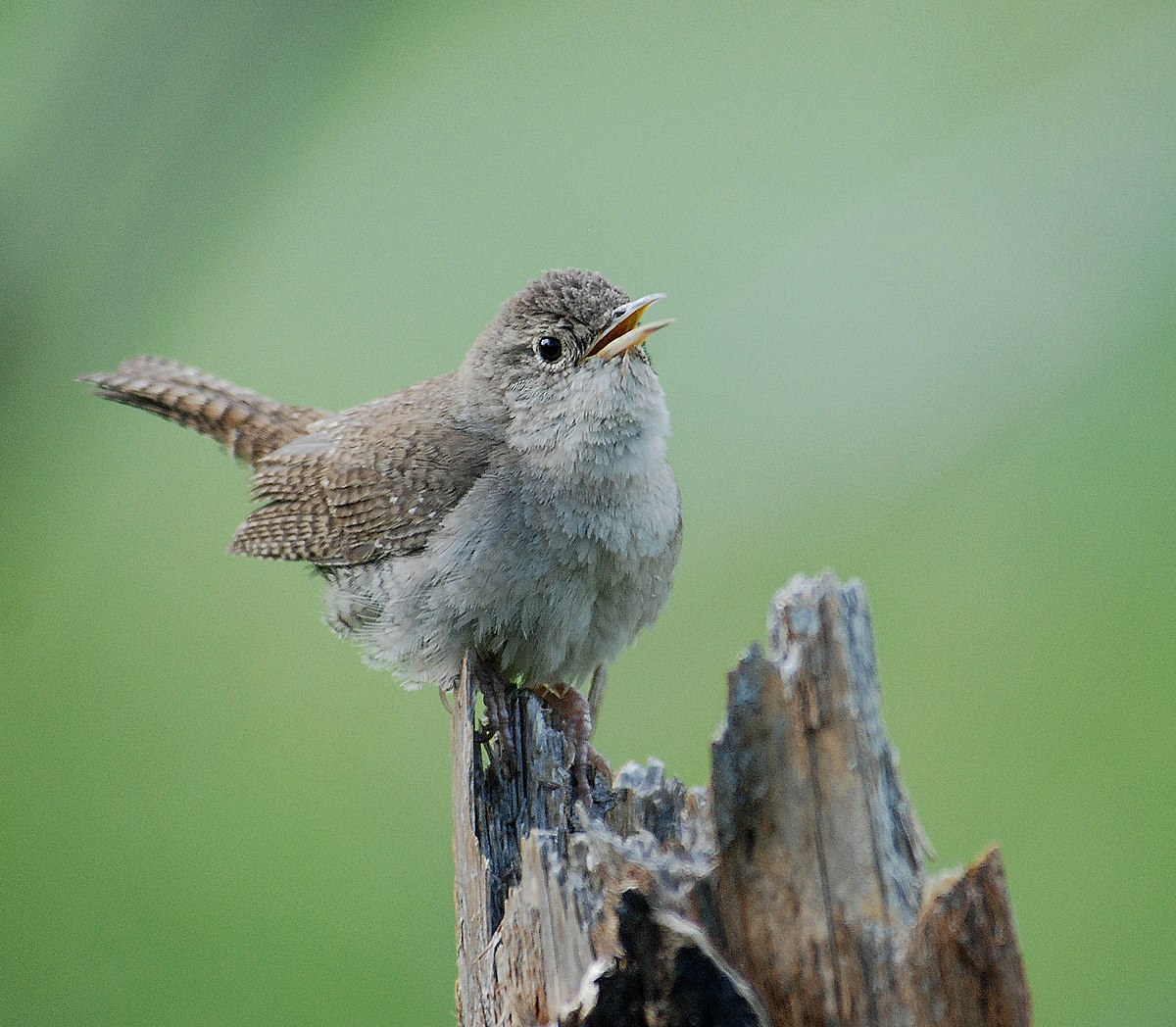
Wikipedia: House wren
![]() The house wren (Troglodytes aedon) is a very small songbird of the wren family, Troglodytidae. It occurs from Canada to southernmost South America, and is thus the most widely distributed native bird in the Americas.[2] It occurs in most suburban areas in its range and it is the single most common wren. Its taxonomy is highly complex and some subspecies groups are often considered separate species.
[more]
The house wren (Troglodytes aedon) is a very small songbird of the wren family, Troglodytidae. It occurs from Canada to southernmost South America, and is thus the most widely distributed native bird in the Americas.[2] It occurs in most suburban areas in its range and it is the single most common wren. Its taxonomy is highly complex and some subspecies groups are often considered separate species.
[more]
Profil Wikipedia Xeno-Canto

Wikipedia: Ochraceous wren
![]() The ochraceous wren (Troglodytes ochraceus) is a small songbird of the wren family. It is an endemic resident breeding species in Costa Rica and Panama. It is sometimes considered to be conspecific with the mountain wren, Troglodytes solstitialis, of South America.
[more]
The ochraceous wren (Troglodytes ochraceus) is a small songbird of the wren family. It is an endemic resident breeding species in Costa Rica and Panama. It is sometimes considered to be conspecific with the mountain wren, Troglodytes solstitialis, of South America.
[more]
Gattung Campylorhynchus:
Profil Wikipedia Xeno-Canto

Wikipedia: Band-backed wren
![]() The band-backed wren (Campylorhynchus zonatus) is a small songbird of the wren family.
[more]
The band-backed wren (Campylorhynchus zonatus) is a small songbird of the wren family.
[more]
Profil Wikipedia Xeno-Canto

Wikipedia: White-headed wren
![]() The white-headed wren (Campylorhynchus albobrunneus) is a species of bird in the family Troglodytidae.
It is found in Colombia and Panama.
Its natural habitats are subtropical or tropical moist lowland forests and heavily degraded former forest.
[more]
The white-headed wren (Campylorhynchus albobrunneus) is a species of bird in the family Troglodytidae.
It is found in Colombia and Panama.
Its natural habitats are subtropical or tropical moist lowland forests and heavily degraded former forest.
[more]
Gattung Henicorhina:

Wikipedia: Grey-breasted wood-wren
![]() The grey-breasted wood wren (Henicorhina leucophrys) is a species of bird in the family Troglodytidae.
It is found at low levels in wooded montane areas of Mexico, Central America and the northern Andes.
[more]
The grey-breasted wood wren (Henicorhina leucophrys) is a species of bird in the family Troglodytidae.
It is found at low levels in wooded montane areas of Mexico, Central America and the northern Andes.
[more]
Profil Wikipedia Xeno-Canto

Wikipedia: White-breasted wood-wren
![]() The white-breasted wood wren (Henicorhina leucosticta) is a small songbird of the wren family. It is a resident breeding species from central Mexico to northeastern Peru and Suriname.
[more]
The white-breasted wood wren (Henicorhina leucosticta) is a small songbird of the wren family. It is a resident breeding species from central Mexico to northeastern Peru and Suriname.
[more]
Gattung Thryorchilus:
Profil Wikipedia Xeno-Canto

Wikipedia: Timberline wren
![]() The timberline wren (Thryorchilus browni) is a species of bird in the family Troglodytidae. It is monotypic within the genus Thryorchilus.[2] It is found in Costa Rica and western Panama, where its natural habitat is subtropical or tropical moist montane forests.[1]
[more]
The timberline wren (Thryorchilus browni) is a species of bird in the family Troglodytidae. It is monotypic within the genus Thryorchilus.[2] It is found in Costa Rica and western Panama, where its natural habitat is subtropical or tropical moist montane forests.[1]
[more]
Gattung Cyphorhinus:
Profil Wikipedia Xeno-Canto

Wikipedia: Song wren
![]() The song wren (Cyphorhinus phaeocephalus) is a species of bird in the family Troglodytidae.
[more]
The song wren (Cyphorhinus phaeocephalus) is a species of bird in the family Troglodytidae.
[more]
Gattung Cistothorus:
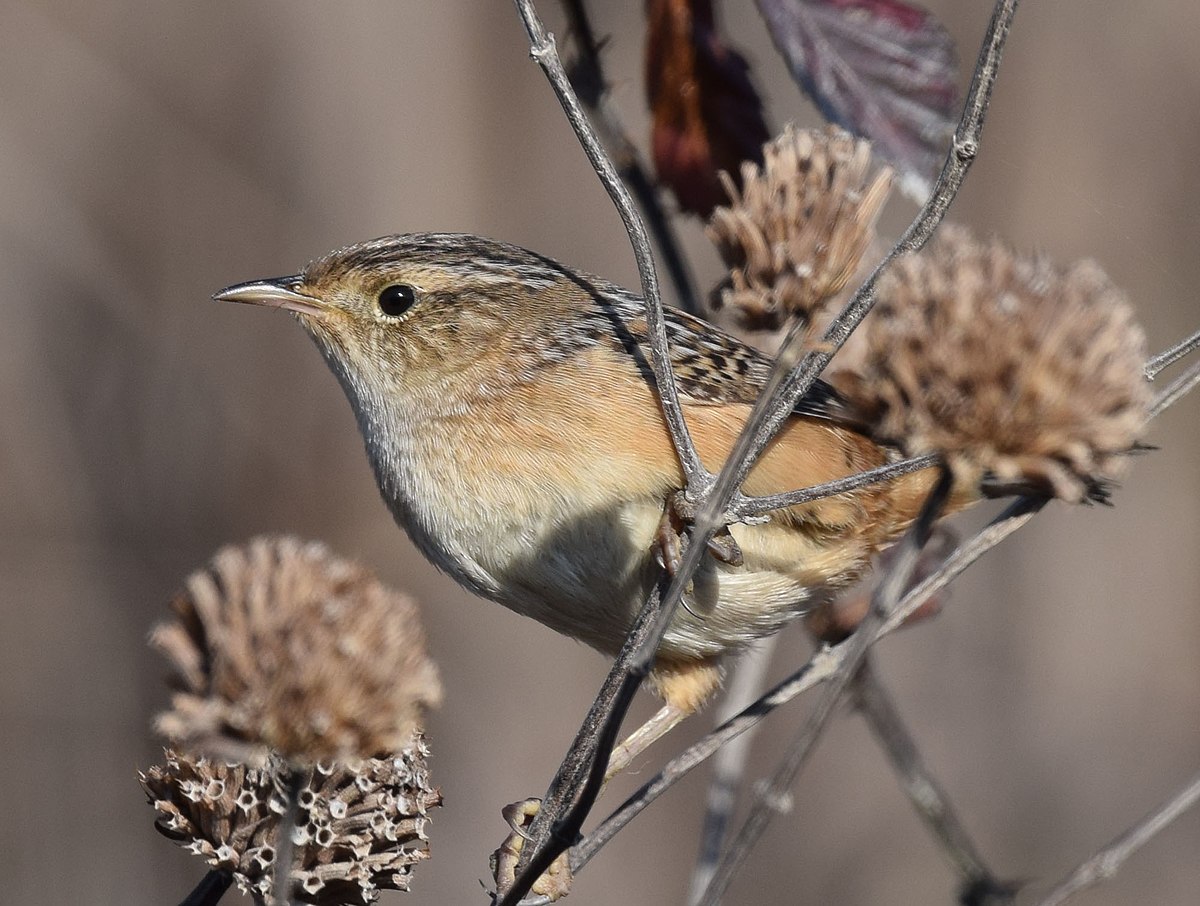
Wikipedia: Sedge wren
![]() The sedge wren (Cistothorus stellaris) is a small and secretive passerine bird in the family Troglodytidae. It is widely distributed in North America. It is often found in wet grasslands and meadows where it nests in the tall grasses and sedges and feeds on insects. The sedge wren was formerly considered as conspecific with the non-migratory grass wren of central and South America.
[more]
The sedge wren (Cistothorus stellaris) is a small and secretive passerine bird in the family Troglodytidae. It is widely distributed in North America. It is often found in wet grasslands and meadows where it nests in the tall grasses and sedges and feeds on insects. The sedge wren was formerly considered as conspecific with the non-migratory grass wren of central and South America.
[more]
Gattung Microcerculus:

Wikipedia: Southern nightingale-wren
![]() The southern nightingale-wren (Microcerculus marginatus), also known as the scaly-breasted wren, is a species of bird in the family Troglodytidae. Its rich song varies locally over its range, suggesting that more than one species is included in the taxonomic complex currently called the southern nightingale-wren.
[more]
The southern nightingale-wren (Microcerculus marginatus), also known as the scaly-breasted wren, is a species of bird in the family Troglodytidae. Its rich song varies locally over its range, suggesting that more than one species is included in the taxonomic complex currently called the southern nightingale-wren.
[more]
Profil Wikipedia Xeno-Canto

Wikipedia: Nightingale wren
![]() Microcerculus is a genus of birds in the wren family Troglodytidae that are endemic to Central America and tropical regions of South America.
[more]
Microcerculus is a genus of birds in the wren family Troglodytidae that are endemic to Central America and tropical regions of South America.
[more]
Gattung Salpinctes:
Profil Wikipedia Audubon Xeno-Canto

Wikipedia: Rock wren
![]() The rock wren (Salpinctes obsoletus) is a small songbird of the wren family native to South America and western North America. It is the only species in the genus Salpinctes.
[more]
The rock wren (Salpinctes obsoletus) is a small songbird of the wren family native to South America and western North America. It is the only species in the genus Salpinctes.
[more]
Gattung Pheugopedius:
Profil Wikipedia Xeno-Canto

Wikipedia: Spot-breasted wren
![]() The spot-breasted wren (Pheugopedius maculipectus) is a species of bird in the family Troglodytidae. It is found in Belize, Costa Rica, El Salvador, Guatemala, Honduras, Mexico, and Nicaragua.[2]
[more]
The spot-breasted wren (Pheugopedius maculipectus) is a species of bird in the family Troglodytidae. It is found in Belize, Costa Rica, El Salvador, Guatemala, Honduras, Mexico, and Nicaragua.[2]
[more]
Profil Wikipedia Xeno-Canto
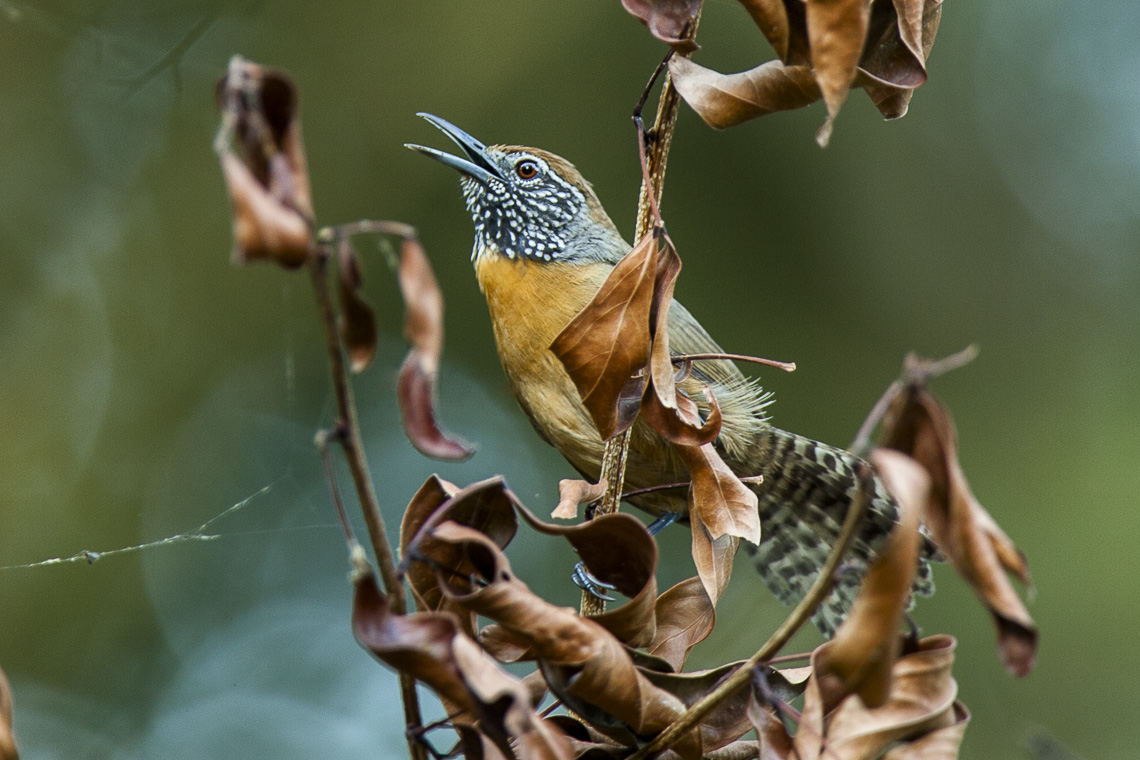
Wikipedia: Rufous-breasted wren
![]() The rufous-breasted wren (Pheugopedius rutilus) is a small songbird of the family Troglodytidae. It is found in Colombia,
Costa Rica, Panama, Trinidad and Tobago, and Venezuela.[2]
[more]
The rufous-breasted wren (Pheugopedius rutilus) is a small songbird of the family Troglodytidae. It is found in Colombia,
Costa Rica, Panama, Trinidad and Tobago, and Venezuela.[2]
[more]
Profil Wikipedia Xeno-Canto

Wikipedia: Black-bellied wren
![]() The black-bellied wren (Pheugopedius fasciatoventris) is a species of bird in the family Troglodytidae. It is found in Colombia, Costa Rica, and Panama.[2]
[more]
The black-bellied wren (Pheugopedius fasciatoventris) is a species of bird in the family Troglodytidae. It is found in Colombia, Costa Rica, and Panama.[2]
[more]
Profil Wikipedia Xeno-Canto

Wikipedia: Black-throated wren
![]() The black-throated wren (Pheugopedius atrogularis) is a species of bird in the family Troglodytidae. It is found in Costa Rica, Nicaragua, and Panama.[2]
[more]
The black-throated wren (Pheugopedius atrogularis) is a species of bird in the family Troglodytidae. It is found in Costa Rica, Nicaragua, and Panama.[2]
[more]
Profil Wikipedia Xeno-Canto

Wikipedia: Sooty-headed wren
![]() The sooty-headed wren (Pheugopedius spadix) is a species of bird in the family Troglodytidae. It is found in Colombia and Panama.[2]
[more]
The sooty-headed wren (Pheugopedius spadix) is a species of bird in the family Troglodytidae. It is found in Colombia and Panama.[2]
[more]
Gattung Thryophilus:

Wikipedia: Rufous-and-white wren
![]() Thryothorus rufalbus
[more]
Thryothorus rufalbus
[more]

Wikipedia: Banded wren
![]() The banded wren (Thryophilus pleurostictus) is a small songbird of the wren family. It is a resident breeding species from central Mexico to Costa Rica. It was formerly placed in the genus Thryothorus (Mann et al., 2006).
[more]
The banded wren (Thryophilus pleurostictus) is a small songbird of the wren family. It is a resident breeding species from central Mexico to Costa Rica. It was formerly placed in the genus Thryothorus (Mann et al., 2006).
[more]
Gattung Cantorchilus:
Profil Wikipedia Xeno-Canto

Wikipedia: Riverside wren
![]() The riverside wren (Cantorchilus semibadius) is a species of bird in the family Troglodytidae. It is found in Costa Rica and Panama.[2]
[more]
The riverside wren (Cantorchilus semibadius) is a species of bird in the family Troglodytidae. It is found in Costa Rica and Panama.[2]
[more]
Profil Wikipedia Xeno-Canto
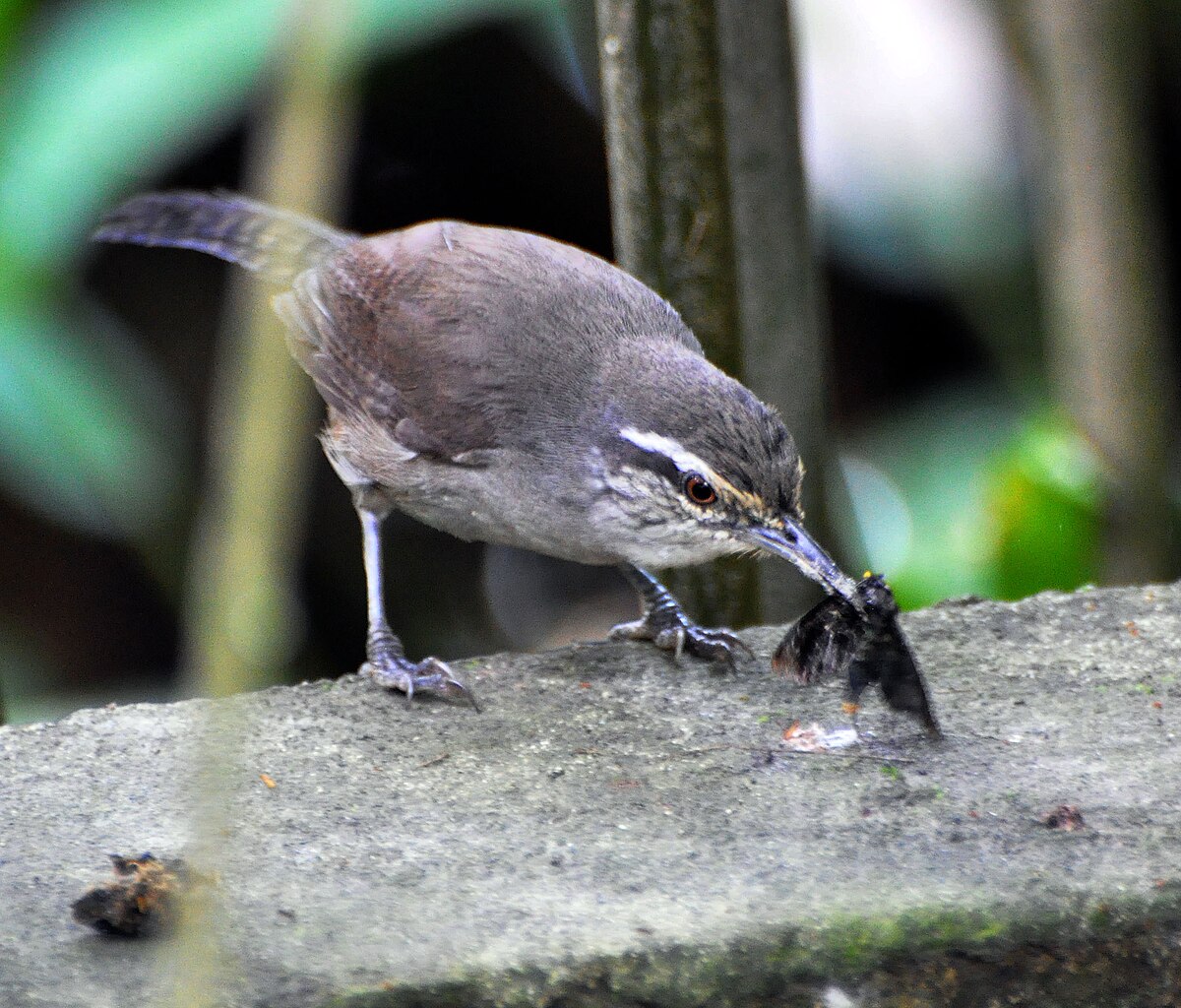
Wikipedia: Canebrake wren
![]() The canebrake wren (Cantorchilus zeledoni) is a species of bird in the family Troglodytidae. It is found in Costa Rica, Nicaragua, and Panama.[2]
[more]
The canebrake wren (Cantorchilus zeledoni) is a species of bird in the family Troglodytidae. It is found in Costa Rica, Nicaragua, and Panama.[2]
[more]
Profil Wikipedia Xeno-Canto

Wikipedia: Stripe-breasted wren
![]() The stripe-breasted wren (Cantorchilus thoracicus) is a species of bird in the family Troglodytidae. It is found in Honduras, Nicaragua, Costa Rica, and Panama.[2]
[more]
The stripe-breasted wren (Cantorchilus thoracicus) is a species of bird in the family Troglodytidae. It is found in Honduras, Nicaragua, Costa Rica, and Panama.[2]
[more]
Profil Wikipedia Xeno-Canto

Wikipedia: Cabanis's wren
![]() Cabanis's wren (Cantorchilus modestus) is a species of bird in the family Troglodytidae. It is found in Belize, Costa Rica, El Salvador, Guatemala, Honduras, Mexico, and Nicaragua.[2]
[more]
Cabanis's wren (Cantorchilus modestus) is a species of bird in the family Troglodytidae. It is found in Belize, Costa Rica, El Salvador, Guatemala, Honduras, Mexico, and Nicaragua.[2]
[more]
Profil Wikipedia Xeno-Canto

Wikipedia: Isthmian wren
![]() The isthmian wren (Cantorchilus elutus) is a species of bird in the family Troglodytidae. It is found in Costa Rica and Panama.[1]
[more]
The isthmian wren (Cantorchilus elutus) is a species of bird in the family Troglodytidae. It is found in Costa Rica and Panama.[1]
[more]
Profil Wikipedia Xeno-Canto

Wikipedia: Bay wren
![]() The bay wren (Cantorchilus nigricapillus) is a species of bird in the family Troglodytidae. It is native to southern Central America and northwestern South America.[2]
[more]
The bay wren (Cantorchilus nigricapillus) is a species of bird in the family Troglodytidae. It is native to southern Central America and northwestern South America.[2]
[more]
Profil Wikipedia Xeno-Canto

Wikipedia: Stripe-throated wren
![]() The stripe-throated wren (Cantorchilus leucopogon) is a species of bird in the family Troglodytidae. It is found in Colombia, Ecuador, and Panama.[2]
[more]
The stripe-throated wren (Cantorchilus leucopogon) is a species of bird in the family Troglodytidae. It is found in Colombia, Ecuador, and Panama.[2]
[more]

Wikipedia: Buff-breasted wren
![]() The buff-breasted wren (Cantorchilus leucotis) is a species of bird in the family Troglodytidae, the wrens.
It is found in the Amazon Basin of northern Brazil and Amazonian Colombia, Ecuador, Peru and northern-border Bolivia; also the Guianan countries Guyana, Suriname, French Guiana. It occurs in non-Amazonian regions of Venezuela and Colombia and its range extends into eastern Panama.
[more]
The buff-breasted wren (Cantorchilus leucotis) is a species of bird in the family Troglodytidae, the wrens.
It is found in the Amazon Basin of northern Brazil and Amazonian Colombia, Ecuador, Peru and northern-border Bolivia; also the Guianan countries Guyana, Suriname, French Guiana. It occurs in non-Amazonian regions of Venezuela and Colombia and its range extends into eastern Panama.
[more]
Unterfamilie Polioptilinae:
Gattung Polioptila:
Profil Wikipedia Xeno-Canto

Wikipedia: Tropical gnatcatcher
![]() The tropical gnatcatcher (Polioptila plumbea) is a small active insectivorous songbird, which is a resident species throughout a large part of the Neotropics. There are large geographical variations in its voice and plumage, resulting in some populations sometimes being considered separate species, notably the bilineata group as the white-browed gnatcatcher, and the taxon maior as the Marañón gnatcatcher.[2]
[more]
The tropical gnatcatcher (Polioptila plumbea) is a small active insectivorous songbird, which is a resident species throughout a large part of the Neotropics. There are large geographical variations in its voice and plumage, resulting in some populations sometimes being considered separate species, notably the bilineata group as the white-browed gnatcatcher, and the taxon maior as the Marañón gnatcatcher.[2]
[more]
Profil Wikipedia Xeno-Canto

Wikipedia: White-lored gnatcatcher
![]() The white-lored gnatcatcher (Polioptila albiloris) is a species of bird in the family Polioptilidae.
It is found in Costa Rica, El Salvador, Guatemala, Honduras, Mexico, and Nicaragua.
Its natural habitats are subtropical or tropical dry forests, subtropical or tropical moist lowland forests, subtropical or tropical dry shrubland, and subtropical or tropical high-altitude shrubland.
[more]
The white-lored gnatcatcher (Polioptila albiloris) is a species of bird in the family Polioptilidae.
It is found in Costa Rica, El Salvador, Guatemala, Honduras, Mexico, and Nicaragua.
Its natural habitats are subtropical or tropical dry forests, subtropical or tropical moist lowland forests, subtropical or tropical dry shrubland, and subtropical or tropical high-altitude shrubland.
[more]
Profil Wikipedia Xeno-Canto

Wikipedia: Slate-throated gnatcatcher
![]() The slate-throated gnatcatcher (Polioptila schistaceigula) is a species of bird in the family Polioptilidae.
It is found in Colombia, Ecuador, and Panama.
Its natural habitat is subtropical or tropical moist lowland forests.
[more]
The slate-throated gnatcatcher (Polioptila schistaceigula) is a species of bird in the family Polioptilidae.
It is found in Colombia, Ecuador, and Panama.
Its natural habitat is subtropical or tropical moist lowland forests.
[more]
Gattung Ramphocaenus:

Wikipedia: Long-billed gnatwren
![]() The trilling gnatwren (Ramphocaenus melanurus), formerly long-billed gnatwren, is a very small bird in the gnatcatcher family. It found from southeast Mexico south to Ecuador and Amazonia.
[more]
The trilling gnatwren (Ramphocaenus melanurus), formerly long-billed gnatwren, is a very small bird in the gnatcatcher family. It found from southeast Mexico south to Ecuador and Amazonia.
[more]
Gattung Microbates:

Wikipedia: Tawny-faced gnatwren
![]() The tawny-faced gnatwren or half-collared gnatwren (Microbates cinereiventris) is a species of bird in the family Polioptilidae.
[more]
The tawny-faced gnatwren or half-collared gnatwren (Microbates cinereiventris) is a species of bird in the family Polioptilidae.
[more]
Familie Dendrocolaptidae:
Gattung Xiphorhynchus:
Tränen-Baumsteiger / Black-striped woodcreeper (Xiphorhynchus lachrymosus)
Profil Wikipedia Xeno-Canto
Black-striped woodcreeper in Manzanillo, Costa Rica. 2020-03-12 09.50.48 null
![]() The black-striped woodcreeper (Xiphorhynchus lachrymosus) is a species of bird in the Dendrocolaptinae subfamily.
[more]
The black-striped woodcreeper (Xiphorhynchus lachrymosus) is a species of bird in the Dendrocolaptinae subfamily.
[more]
Xiphorhynchus susurrans / Cocoa woodcreeper (Xiphorhynchus susurrans)

Wikipedia: Cocoa woodcreeper
![]() The cocoa woodcreeper (Xiphorhynchus susurrans) is a passerine bird in the woodcreeper subfamily of the ovenbird family. It was formerly considered a subspecies of the buff-throated woodcreeper (X. guttatus).
[more]
The cocoa woodcreeper (Xiphorhynchus susurrans) is a passerine bird in the woodcreeper subfamily of the ovenbird family. It was formerly considered a subspecies of the buff-throated woodcreeper (X. guttatus).
[more]
Xiphorhynchus flavigaster / Ivory-billed woodcreeper (Xiphorhynchus flavigaster)
Profil Wikipedia Xeno-Canto

Wikipedia: Ivory-billed woodcreeper
![]() The ivory-billed woodcreeper (Xiphorhynchus flavigaster) is a species of bird of the order of Passerformes, which are perching birds. It is in the family Furnariidae (ovenbirds) and the subfamily Dendrocolaptinae (woodcreepers).
[more]
The ivory-billed woodcreeper (Xiphorhynchus flavigaster) is a species of bird of the order of Passerformes, which are perching birds. It is in the family Furnariidae (ovenbirds) and the subfamily Dendrocolaptinae (woodcreepers).
[more]
Xiphorhynchus erythropygius / Spotted woodcreeper (Xiphorhynchus erythropygius)
Profil Wikipedia Xeno-Canto

Wikipedia: Spotted woodcreeper
![]() The spotted woodcreeper (Xiphorhynchus erythropygius) is a species of bird in the Dendrocolaptinae subfamily. It is found in Belize, Colombia, Costa Rica, Ecuador, El Salvador, Guatemala, Honduras, Mexico, Nicaragua, and Panama.
[more]
The spotted woodcreeper (Xiphorhynchus erythropygius) is a species of bird in the Dendrocolaptinae subfamily. It is found in Belize, Colombia, Costa Rica, Ecuador, El Salvador, Guatemala, Honduras, Mexico, Nicaragua, and Panama.
[more]
Dendroplex picus / Straight-billed woodcreeper (Dendroplex picus)
Wikipedia: Straight-billed woodcreeper
![]() The straight-billed woodcreeper (Dendroplex picus) is a species of bird in the woodcreeper subfamily (Dendrocolaptinae). Its genus, Dendroplex, was recently confirmed to be distinct from Xiphorhynchus.
It is found in Bolivia, Brazil, Colombia, Ecuador, French Guiana, Guyana, Panama, Peru, Suriname, Trinidad and Tobago, and Venezuela.
Its natural habitats are subtropical or tropical dry forests, subtropical or tropical moist lowland forests, subtropical or tropical mangrove forests, and heavily degraded former forest.
[more]
The straight-billed woodcreeper (Dendroplex picus) is a species of bird in the woodcreeper subfamily (Dendrocolaptinae). Its genus, Dendroplex, was recently confirmed to be distinct from Xiphorhynchus.
It is found in Bolivia, Brazil, Colombia, Ecuador, French Guiana, Guyana, Panama, Peru, Suriname, Trinidad and Tobago, and Venezuela.
Its natural habitats are subtropical or tropical dry forests, subtropical or tropical moist lowland forests, subtropical or tropical mangrove forests, and heavily degraded former forest.
[more]
Gattung Lepidocolaptes:
Lepidocolaptes affinis / Spot-crowned woodcreeper (Lepidocolaptes affinis)
Profil Wikipedia Xeno-Canto

Wikipedia: Spot-crowned woodcreeper
![]() The spot-crowned woodcreeper (Lepidocolaptes affinis), is a passerine bird which breeds in the tropical New World from central Mexico in the east, the Sierra Madre Orientals, to northern Panama.
[more]
The spot-crowned woodcreeper (Lepidocolaptes affinis), is a passerine bird which breeds in the tropical New World from central Mexico in the east, the Sierra Madre Orientals, to northern Panama.
[more]
Lepidocolaptes souleyetii / Streak-headed woodcreeper (Lepidocolaptes souleyetii)
Profil Wikipedia Xeno-Canto
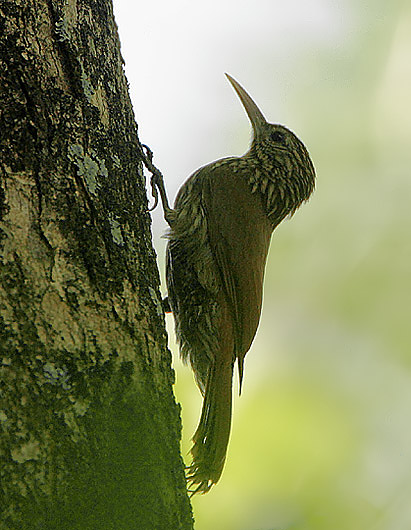
Wikipedia: Streak-headed woodcreeper
![]() The streak-headed woodcreeper (Lepidocolaptes souleyetii) is a passerine bird which breeds in the tropical New World from southern Mexico to northwestern Peru, northern Brazil and Guyana, and also on Trinidad.
[more]
The streak-headed woodcreeper (Lepidocolaptes souleyetii) is a passerine bird which breeds in the tropical New World from southern Mexico to northwestern Peru, northern Brazil and Guyana, and also on Trinidad.
[more]
Gattung Sittasomus:
Sittasomus griseicapillus / Olivaceous woodcreeper (Sittasomus griseicapillus)
Profil Wikipedia Xeno-Canto

Wikipedia: Olivaceous woodcreeper
![]() The olivaceous woodcreeper (Sittasomus griseicapillus) is a passerine bird of the tropical Americas. It belongs to the true woodcreepers (tribe Dendrocolaptini) of the ovenbird family (Furnariidae).
[more]
The olivaceous woodcreeper (Sittasomus griseicapillus) is a passerine bird of the tropical Americas. It belongs to the true woodcreepers (tribe Dendrocolaptini) of the ovenbird family (Furnariidae).
[more]
Gattung Dendrocolaptes:
Dendrocolaptes sanctithomae / Northern barred-woodcreeper (Dendrocolaptes sanctithomae)
Profil Wikipedia Xeno-Canto

Wikipedia: Northern barred-woodcreeper
![]() The northern barred woodcreeper (Dendrocolaptes sanctithomae) is a species of bird in the subfamily Dendrocolaptinae. It was formerly included as a subspecies of the Amazonian barred woodcreeper (D. certhia).
[more]
The northern barred woodcreeper (Dendrocolaptes sanctithomae) is a species of bird in the subfamily Dendrocolaptinae. It was formerly included as a subspecies of the Amazonian barred woodcreeper (D. certhia).
[more]
Dendrocolaptes picumnus / Black-banded woodcreeper (Dendrocolaptes picumnus)
Profil Wikipedia Xeno-Canto

Wikipedia: Black-banded woodcreeper
![]() The black-banded woodcreeper (Dendrocolaptes picumnus) is a species of bird in the Dendrocolaptinae subfamily, the woodcreepers.
It is discontinuously spread from Chiapas to Paraguay and northern Argentina.
Its natural habitats are subtropical or tropical moist lowland forests and subtropical or tropical moist montane forests.
[more]
The black-banded woodcreeper (Dendrocolaptes picumnus) is a species of bird in the Dendrocolaptinae subfamily, the woodcreepers.
It is discontinuously spread from Chiapas to Paraguay and northern Argentina.
Its natural habitats are subtropical or tropical moist lowland forests and subtropical or tropical moist montane forests.
[more]
Gattung Xiphocolaptes:
Xiphocolaptes promeropirhynchus / Strong-billed woodcreeper (Xiphocolaptes promeropirhynchus)
Profil Wikipedia Xeno-Canto

Wikipedia: Strong-billed woodcreeper
![]() The strong-billed woodcreeper (Xiphocolaptes promeropirhynchus) is a species of bird in the Dendrocolaptinae subfamily. It is one of the largest woodcreepers and the largest furnariids, though the slender long-billed woodcreeper is longer and the great rufous woodcreeper is larger overall. There is some size variation across the range, with typical birds measuring 28–31 cm (11-12.5 in) long and weighing about 120 grams (4.2 oz). Large strong-billed woodcreepers can measure up to 35 cm (14 in) and weigh 169 grams (6 oz).[2] The most distinctive feature of this typically marked striped, brownish bird (other than its size) is its massive, semi-decurved bill, which may be brown or blackish.
[more]
The strong-billed woodcreeper (Xiphocolaptes promeropirhynchus) is a species of bird in the Dendrocolaptinae subfamily. It is one of the largest woodcreepers and the largest furnariids, though the slender long-billed woodcreeper is longer and the great rufous woodcreeper is larger overall. There is some size variation across the range, with typical birds measuring 28–31 cm (11-12.5 in) long and weighing about 120 grams (4.2 oz). Large strong-billed woodcreepers can measure up to 35 cm (14 in) and weigh 169 grams (6 oz).[2] The most distinctive feature of this typically marked striped, brownish bird (other than its size) is its massive, semi-decurved bill, which may be brown or blackish.
[more]
Gattung Dendrocincla:
Dendrocincla fuliginosa / Plain-brown woodcreeper (Dendrocincla fuliginosa)
Profil Wikipedia Xeno-Canto
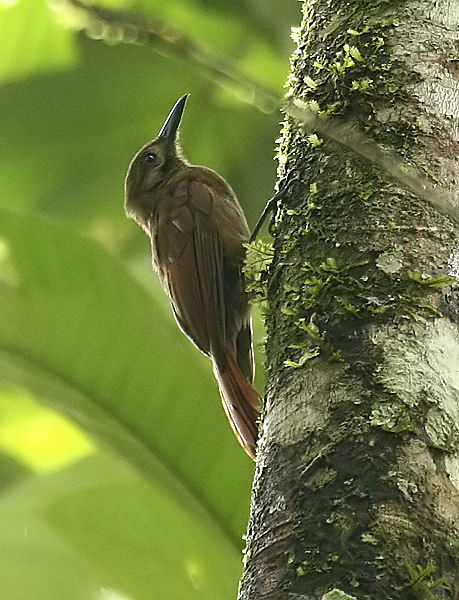
Wikipedia: Plain-brown woodcreeper
![]() The plain-brown woodcreeper (Dendrocincla fuliginosa), is a sub-oscine passerine bird which breeds in the tropical New World from Honduras through South America to northern Argentina, and in Trinidad and Tobago. Sometimes it is considered to include the plain-winged woodcreeper (D. turdina) as a subspecies.
[more]
The plain-brown woodcreeper (Dendrocincla fuliginosa), is a sub-oscine passerine bird which breeds in the tropical New World from Honduras through South America to northern Argentina, and in Trinidad and Tobago. Sometimes it is considered to include the plain-winged woodcreeper (D. turdina) as a subspecies.
[more]
Dendrocincla homochroa / Ruddy woodcreeper (Dendrocincla homochroa)
Profil Wikipedia Xeno-Canto

Wikipedia: Ruddy woodcreeper
![]() The ruddy woodcreeper (Dendrocincla homochroa), is a passerine bird which breeds in the tropical New World from southern Mexico to northern Colombia and extreme northern Venezuela.
[more]
The ruddy woodcreeper (Dendrocincla homochroa), is a passerine bird which breeds in the tropical New World from southern Mexico to northern Colombia and extreme northern Venezuela.
[more]
Dendrocincla anabatina / Tawny-winged woodcreeper (Dendrocincla anabatina)
Profil Wikipedia Xeno-Canto

Wikipedia: Tawny-winged woodcreeper
![]() The tawny-winged woodcreeper (Dendrocincla anabatina) is a species of bird in the subfamily Dendrocolaptinae, the New World woodcreepers. It is found in Belize, Costa Rica, Guatemala, Honduras, Mexico, Nicaragua, and Panama. Its natural habitat is subtropical or tropical moist lowland forests.
[more]
The tawny-winged woodcreeper (Dendrocincla anabatina) is a species of bird in the subfamily Dendrocolaptinae, the New World woodcreepers. It is found in Belize, Costa Rica, Guatemala, Honduras, Mexico, Nicaragua, and Panama. Its natural habitat is subtropical or tropical moist lowland forests.
[more]
Gattung Campylorhamphus:
Campylorhamphus pusillus / Brown-billed scythebill (Campylorhamphus pusillus )
Profil Wikipedia Xeno-Canto

Wikipedia: Brown-billed scythebill
![]() The brown-billed scythebill (Campylorhamphus pusillus) is a species of bird in the family Furnariidae.
[more]
The brown-billed scythebill (Campylorhamphus pusillus) is a species of bird in the family Furnariidae.
[more]
Rotrücken-Sensenschnabel / Red-billed scythebill (Campylorhamphus trochilirostris)
Profil Wikipedia Xeno-Canto
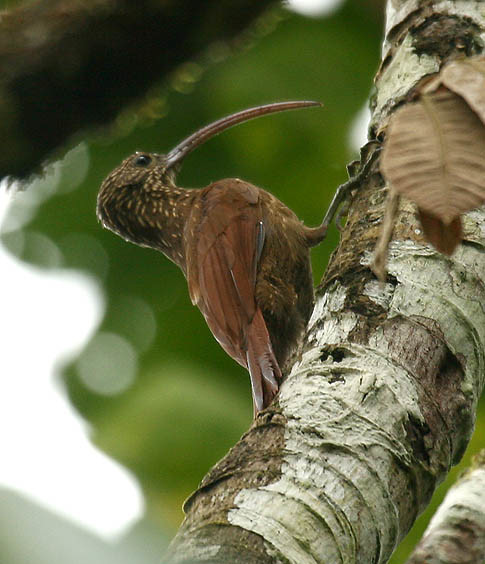
Wikipedia: Red-billed scythebill
![]() The red-billed scythebill (Campylorhamphus trochilirostris) is a species of bird in the Dendrocolaptinae subfamily.
[more]
The red-billed scythebill (Campylorhamphus trochilirostris) is a species of bird in the Dendrocolaptinae subfamily.
[more]
Campylorhamphus pusillus / Brown-billed scythebill (Campylorhamphus pusillus)
Profil Wikipedia Xeno-Canto

Wikipedia: Brown-billed scythebill
![]() The brown-billed scythebill (Campylorhamphus pusillus) is a species of bird in the family Furnariidae.
[more]
The brown-billed scythebill (Campylorhamphus pusillus) is a species of bird in the family Furnariidae.
[more]
Gattung Deconychura:
Deconychura longicauda / Long-tailed woodcreeper (Deconychura longicauda)
Profil Wikipedia Xeno-Canto
Wikipedia: Long-tailed woodcreeper
![]() The long-tailed woodcreeper (Deconychura longicauda) is a species of bird in the Dendrocolaptinae subfamily. It is monotypic within Deconychura, but formerly this genus also included the spot-throated woodcreeper.[2]
[more]
The long-tailed woodcreeper (Deconychura longicauda) is a species of bird in the Dendrocolaptinae subfamily. It is monotypic within Deconychura, but formerly this genus also included the spot-throated woodcreeper.[2]
[more]
Familie Formicariidae:
Gattung Formicarius:
Formicarius rufipectus / Rufous-breasted antthrush (Formicarius rufipectus)
Profil Wikipedia Xeno-Canto

Wikipedia: Rufous-breasted antthrush
![]() The rufous-breasted antthrush (Formicarius rufipectus) is a species of bird in the family Formicariidae. It is found in Colombia, Costa Rica, Ecuador, Panama, Peru, and Venezuela. Its natural habitat is subtropical or tropical moist montane forest.
[more]
The rufous-breasted antthrush (Formicarius rufipectus) is a species of bird in the family Formicariidae. It is found in Colombia, Costa Rica, Ecuador, Panama, Peru, and Venezuela. Its natural habitat is subtropical or tropical moist montane forest.
[more]
Formicarius analis / Black-faced antthrush (Formicarius analis)
Profil Wikipedia Xeno-Canto

Wikipedia: Black-faced antthrush
![]() The black-faced antthrush (Formicarius analis), is a species of passerine bird in the family Formicariidae.
[more]
The black-faced antthrush (Formicarius analis), is a species of passerine bird in the family Formicariidae.
[more]
Formicarius nigricapillus / Black-headed antthrush (Formicarius nigricapillus)
Profil Wikipedia Xeno-Canto

Wikipedia: Black-headed antthrush
![]() The black-headed antthrush (Formicarius nigricapillus) is a species of bird in the family Formicariidae.
Its natural habitats are subtropical or tropical moist lowland forests and subtropical or tropical moist montane forests.
[more]
The black-headed antthrush (Formicarius nigricapillus) is a species of bird in the family Formicariidae.
Its natural habitats are subtropical or tropical moist lowland forests and subtropical or tropical moist montane forests.
[more]
Gattung Grallaria:
Grallaria guatimalensis / Scaled antpitta (Grallaria guatimalensis)
Profil Wikipedia Xeno-Canto

Wikipedia: Scaled antpitta
![]() The scaled antpitta (Grallaria guatimalensis) is a species of bird in the family Grallariidae.
[more]
The scaled antpitta (Grallaria guatimalensis) is a species of bird in the family Grallariidae.
[more]
Gattung Grallaricula:
Grallaricula flavirostris / Ochre-breasted antpitta (Grallaricula flavirostris)
Profil Wikipedia Xeno-Canto

Wikipedia: Ochre-breasted antpitta
![]() The ochre-breasted antpitta (Grallaricula flavirostris) is a species of bird placed in the family Grallariidae.
[more]
The ochre-breasted antpitta (Grallaricula flavirostris) is a species of bird placed in the family Grallariidae.
[more]
Gattung Hylopezus:
Hylopezus perspicillatus / Streak-chested antpitta (Hylopezus perspicillatus)
Profil Wikipedia Xeno-Canto

Wikipedia: Streak-chested antpitta
![]() The streak-chested antpitta or spectacled antpitta (Hylopezus perspicillatus) is a species of bird in the family Grallariidae.
It is found in Colombia, Costa Rica, Ecuador, Honduras, Nicaragua, and Panama.
Its natural habitat is subtropical or tropical moist lowland forest.[2]
[more]
The streak-chested antpitta or spectacled antpitta (Hylopezus perspicillatus) is a species of bird in the family Grallariidae.
It is found in Colombia, Costa Rica, Ecuador, Honduras, Nicaragua, and Panama.
Its natural habitat is subtropical or tropical moist lowland forest.[2]
[more]
Hylopezus dives / Thicket antpitta (Hylopezus dives)

Wikipedia: Thicket antpitta
![]() The thicket antpitta (Hylopezus dives) is a species of bird in the family Grallariidae. It is found in Colombia, Costa Rica, Honduras, Nicaragua, Panama, and perhaps Ecuador. Its natural habitats are subtropical or tropical moist lowland forest and heavily degraded former forest.
[more]
The thicket antpitta (Hylopezus dives) is a species of bird in the family Grallariidae. It is found in Colombia, Costa Rica, Honduras, Nicaragua, Panama, and perhaps Ecuador. Its natural habitats are subtropical or tropical moist lowland forest and heavily degraded former forest.
[more]
Gattung Cercomacra:
Cercomacroides tyrannina / Dusky antbird (Cercomacroides tyrannina)

Wikipedia: Dusky antbird
![]() The dusky antbird or tyrannine antbird (Cercomacroides tyrannina) is a passerine bird in the antbird family. It is a resident breeder in tropical Central and South America from southeastern Mexico southwards to western Ecuador, and Amazonian Brazil.
[more]
The dusky antbird or tyrannine antbird (Cercomacroides tyrannina) is a passerine bird in the antbird family. It is a resident breeder in tropical Central and South America from southeastern Mexico southwards to western Ecuador, and Amazonian Brazil.
[more]
Cercomacra nigricans / Jet antbird (Cercomacra nigricans)
Profil Wikipedia Xeno-Canto

Wikipedia: Jet antbird
![]() The jet antbird (Cercomacra nigricans) is a species of bird in the family Thamnophilidae. It is found in Colombia, Venezuela, Panama and western Ecuador. Its natural habitat is subtropical or tropical moist lowland forests.
[more]
The jet antbird (Cercomacra nigricans) is a species of bird in the family Thamnophilidae. It is found in Colombia, Venezuela, Panama and western Ecuador. Its natural habitat is subtropical or tropical moist lowland forests.
[more]
Gattung Pittasoma:
Pittasoma michleri / Black-crowned antpitta (Pittasoma michleri)
Profil Wikipedia Xeno-Canto

Wikipedia: Black-crowned antpitta
![]() The black-crowned antpitta (Pittasoma michleri) is a species of bird in the gnateater family, Conopophagidae. It is found in Colombia, Costa Rica, and Panama. Its natural habitat is subtropical or tropical moist foothill forests.
[more]
The black-crowned antpitta (Pittasoma michleri) is a species of bird in the gnateater family, Conopophagidae. It is found in Colombia, Costa Rica, and Panama. Its natural habitat is subtropical or tropical moist foothill forests.
[more]
Familie Thamnophilidae:
Gattung Thamnophilus:
Kapuzen-Ameisenwürger / Black-hooded antshrike (Thamnophilus bridgesi)
Profil Wikipedia Xeno-Canto
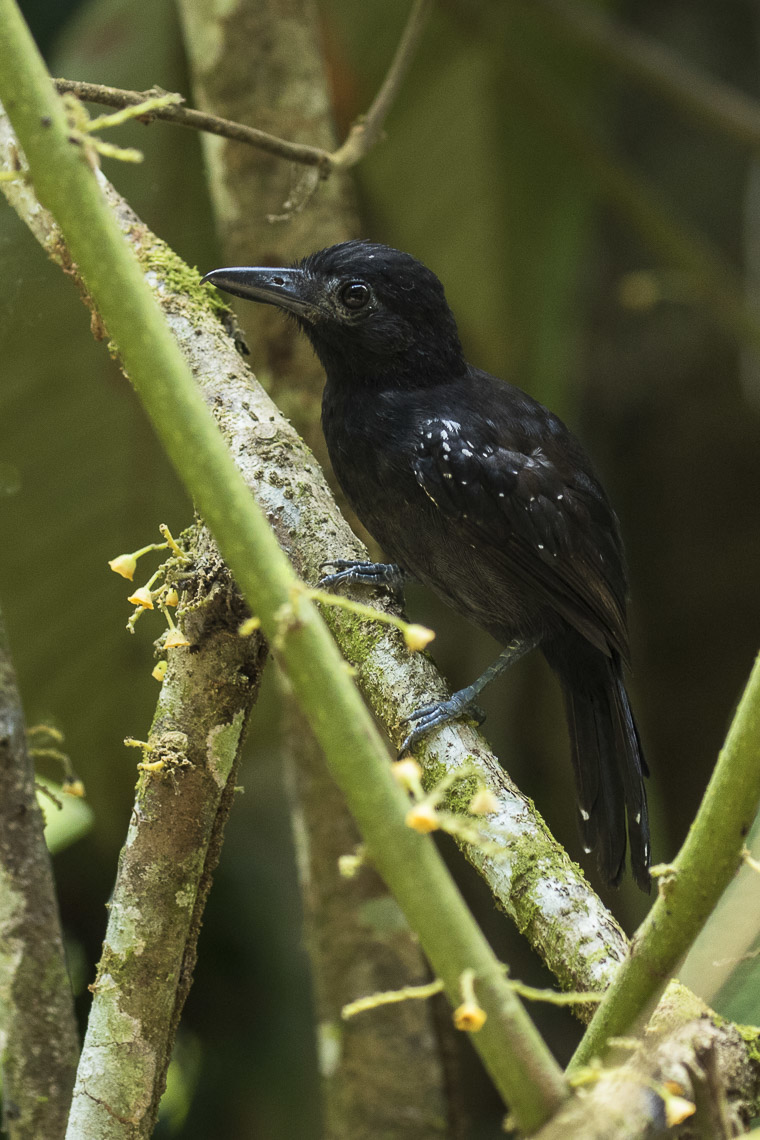
Wikipedia: Black-hooded antshrike
![]() The black-hooded antshrike (Thamnophilus bridgesi) is a species of bird in the family Thamnophilidae. It is found in Costa Rica and Panama. Its natural habitats are subtropical or tropical moist lowland forests, subtropical or tropical mangrove forests, and heavily degraded former forest.
[more]
The black-hooded antshrike (Thamnophilus bridgesi) is a species of bird in the family Thamnophilidae. It is found in Costa Rica and Panama. Its natural habitats are subtropical or tropical moist lowland forests, subtropical or tropical mangrove forests, and heavily degraded former forest.
[more]
Binden-Ameisenwürger / Barred antshrike (Thamnophilus doliatus)
Profil Wikipedia Xeno-Canto

Wikipedia: Barred antshrike
![]() The barred antshrike (Thamnophilus doliatus) is a passerine bird in the antbird family. It is found in the Neotropics from Tamaulipas, Mexico, through Central America, Trinidad and Tobago, and a large part of South America east of the Andes as far south as northern Argentina, Bolivia and Paraguay. There is one accepted record from southern Texas.[2] It is found in a wide range of wooded habitats (even gardens and parks) in both humid and arid regions. Throughout a large part of its range, it is among the most common antbirds.
[more]
The barred antshrike (Thamnophilus doliatus) is a passerine bird in the antbird family. It is found in the Neotropics from Tamaulipas, Mexico, through Central America, Trinidad and Tobago, and a large part of South America east of the Andes as far south as northern Argentina, Bolivia and Paraguay. There is one accepted record from southern Texas.[2] It is found in a wide range of wooded habitats (even gardens and parks) in both humid and arid regions. Throughout a large part of its range, it is among the most common antbirds.
[more]
Thamnophilus atrinucha / Black-crowned antshrike (Thamnophilus atrinucha)
Profil Wikipedia Xeno-Canto

Wikipedia: Black-crowned antshrike
![]() The black-crowned antshrike or western slaty antshrike (Thamnophilus atrinucha) is a species of bird in the family Thamnophilidae.
It is found in from western Ecuador, western Colombia, western Venezuela, and Central America as far north as Belize.
[more]
The black-crowned antshrike or western slaty antshrike (Thamnophilus atrinucha) is a species of bird in the family Thamnophilidae.
It is found in from western Ecuador, western Colombia, western Venezuela, and Central America as far north as Belize.
[more]
Thamnophilus nigriceps / Black antshrike (Thamnophilus nigriceps)
Profil Wikipedia Xeno-Canto

Wikipedia: Black antshrike
![]() The black antshrike (Thamnophilus nigriceps) is a species of insectivorous bird in the antbird family Thamnophilidae. It is found in Colombia and Panama. Its natural habitats are subtropical or tropical moist lowland forests and heavily degraded former forest.
[more]
The black antshrike (Thamnophilus nigriceps) is a species of insectivorous bird in the antbird family Thamnophilidae. It is found in Colombia and Panama. Its natural habitats are subtropical or tropical moist lowland forests and heavily degraded former forest.
[more]
Gattung Formicivora:
Formicivora grisea / White-fringed antwren (Formicivora grisea)
Profil Wikipedia Xeno-Canto
Wikipedia: White-fringed antwren
![]() The southern white-fringed antwren (Formicivora grisea) is an insectivorous bird in the antbird family Thamnophilidae. It is a resident breeder in tropical South America from Colombia southeast to the Guianas and Brazil.
[more]
The southern white-fringed antwren (Formicivora grisea) is an insectivorous bird in the antbird family Thamnophilidae. It is a resident breeder in tropical South America from Colombia southeast to the Guianas and Brazil.
[more]
Gattung Myrmotherula:
Myrmotherula schisticolor / Slaty antwren (Myrmotherula schisticolor)
Profil Wikipedia Xeno-Canto

Wikipedia: Slaty antwren
![]() The slaty antwren (Myrmotherula schisticolor) is a small passerine bird in the antbird family. It is a resident breeder in tropical Central and South America from southern Mexico to western Ecuador and eastern Peru.
[more]
The slaty antwren (Myrmotherula schisticolor) is a small passerine bird in the antbird family. It is a resident breeder in tropical Central and South America from southern Mexico to western Ecuador and eastern Peru.
[more]
Westlicher Strichelameisenschlüpfer / Pacific antwren (Myrmotherula pacifica)
Profil Wikipedia Xeno-Canto

Wikipedia: Pacific antwren
![]() The Pacific antwren, or Pacific streaked antwren, (Myrmotherula pacifica) is a species of bird in the family Thamnophilidae. It is found in Colombia, Ecuador and Panama, living in forests, clearings, woodland verges and gardens.
[more]
The Pacific antwren, or Pacific streaked antwren, (Myrmotherula pacifica) is a species of bird in the family Thamnophilidae. It is found in Colombia, Ecuador and Panama, living in forests, clearings, woodland verges and gardens.
[more]
Gattung Myrmornis:
Myrmornis torquata / Wing-banded antbird (Myrmornis torquata)
Profil Wikipedia Xeno-Canto

Wikipedia: Wing-banded antbird
![]() The wing-banded antbird (Myrmornis torquata) is a species of passerine bird in the antbird family, Thamnophilidae. It is placed in the monotypic genus Myrmornis.[2]
It is found in Brazil, Colombia, Ecuador, French Guiana, Guyana, Nicaragua, Panama, Peru, Suriname, and Venezuela. Its natural habitat is subtropical or tropical moist lowland forests.[1]
[more]
The wing-banded antbird (Myrmornis torquata) is a species of passerine bird in the antbird family, Thamnophilidae. It is placed in the monotypic genus Myrmornis.[2]
It is found in Brazil, Colombia, Ecuador, French Guiana, Guyana, Nicaragua, Panama, Peru, Suriname, and Venezuela. Its natural habitat is subtropical or tropical moist lowland forests.[1]
[more]
Gattung Taraba:
Taraba major / Great antshrike (Taraba major)
Profil Wikipedia Xeno-Canto

Wikipedia: Great antshrike
![]() The great antshrike (Taraba major) is a passerine bird in the antbird family, Thamnophilidae. It is the only member of the genus Taraba. It is a resident breeder in the tropical New World in southern Mexico, Central America, Trinidad and South America down to northern Argentina and southeastern Brazil.
[more]
The great antshrike (Taraba major) is a passerine bird in the antbird family, Thamnophilidae. It is the only member of the genus Taraba. It is a resident breeder in the tropical New World in southern Mexico, Central America, Trinidad and South America down to northern Argentina and southeastern Brazil.
[more]
Gattung Thamnistes:
Thamnistes anabatinus / Russet antshrike (Thamnistes anabatinus)
Profil Wikipedia Xeno-Canto
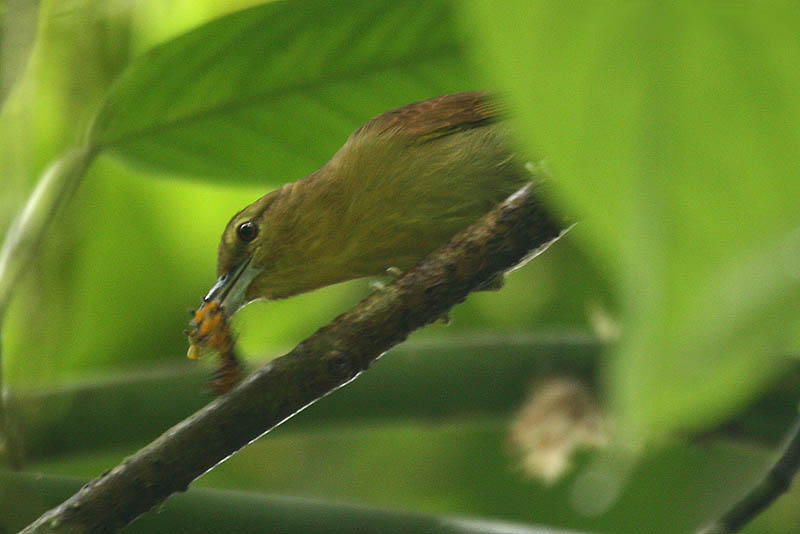
Wikipedia: Russet antshrike
![]() The russet antshrike (Thamnistes anabatinus) is a passerine bird in the antbird family.
[more]
The russet antshrike (Thamnistes anabatinus) is a passerine bird in the antbird family.
[more]
Gattung Dysithamnus:
Dysithamnus striaticeps / Streak-crowned antvireo (Dysithamnus striaticeps)
Profil Wikipedia Xeno-Canto

Wikipedia: Streak-crowned antvireo
![]() The streak-crowned antvireo (Dysithamnus striaticeps) is a species of bird in the family Thamnophilidae. It is found in Costa Rica, Honduras, and Nicaragua. Its natural habitat is subtropical or tropical moist lowland forests.
[more]
The streak-crowned antvireo (Dysithamnus striaticeps) is a species of bird in the family Thamnophilidae. It is found in Costa Rica, Honduras, and Nicaragua. Its natural habitat is subtropical or tropical moist lowland forests.
[more]
Dysithamnus puncticeps / Spot-crowned antvireo (Dysithamnus puncticeps)
Profil Wikipedia Xeno-Canto

Wikipedia: Spot-crowned antvireo
![]() The spot-crowned antvireo (Dysithamnus puncticeps) is a species of bird in the family Thamnophilidae. It is found in Colombia, Costa Rica, Ecuador, and Panama. Its natural habitat is subtropical or tropical moist lowland forests.
[more]
The spot-crowned antvireo (Dysithamnus puncticeps) is a species of bird in the family Thamnophilidae. It is found in Colombia, Costa Rica, Ecuador, and Panama. Its natural habitat is subtropical or tropical moist lowland forests.
[more]
Dysithamnus mentalis / Plain antvireo (Dysithamnus mentalis)
Profil Wikipedia Xeno-Canto

Wikipedia: Plain antvireo
![]() The plain antvireo (Dysithamnus mentalis) is a passerine bird species in the antbird family (Thamnophilidae). It is a resident breeder in tropical Central and South America.
[more]
The plain antvireo (Dysithamnus mentalis) is a passerine bird species in the antbird family (Thamnophilidae). It is a resident breeder in tropical Central and South America.
[more]
Gattung Myrmeciza:
Myrmeciza zeledoni / Zeledon's antbird (Myrmeciza zeledoni)
Profil Wikipedia Xeno-Canto

Wikipedia: Zeledon's antbird
![]() Zeledon's antbird (Percnostola zeledoni) is a species of antbird in the family Thamnophilidae. It is found at low levels in humid forests from Nicaragua to Panama, and in the Chocó of western Colombia and western Ecuador. Zeledon's antbird feeds on insects, and regularly follows swarms of army ants in order to catch prey flushed by the swarms, but it is not an obligate ant-follower like some species of antbirds.
[more]
Zeledon's antbird (Percnostola zeledoni) is a species of antbird in the family Thamnophilidae. It is found at low levels in humid forests from Nicaragua to Panama, and in the Chocó of western Colombia and western Ecuador. Zeledon's antbird feeds on insects, and regularly follows swarms of army ants in order to catch prey flushed by the swarms, but it is not an obligate ant-follower like some species of antbirds.
[more]
Myrmeciza longipes / White-bellied antbird (Myrmeciza longipes)
Profil Wikipedia Xeno-Canto
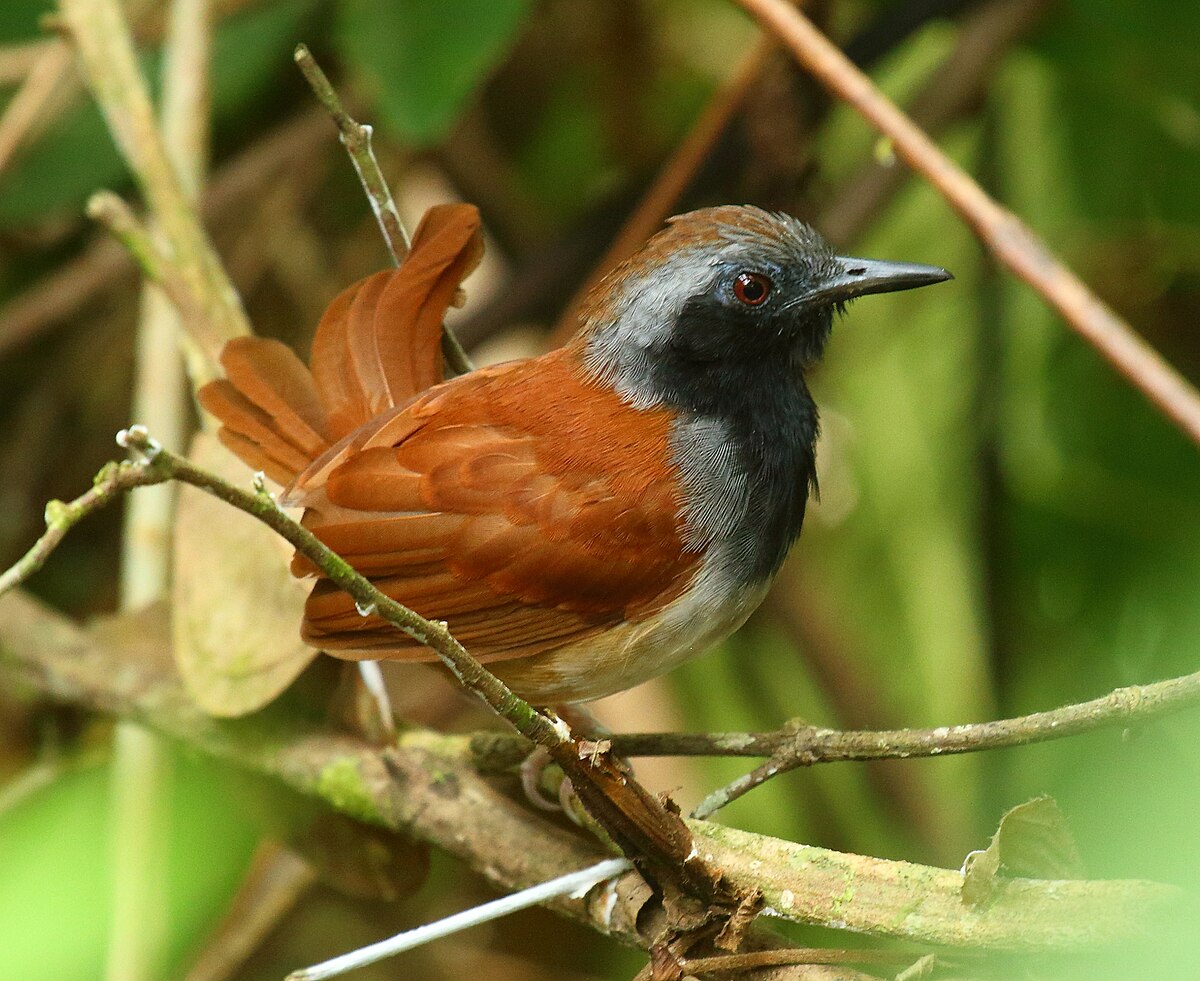
Wikipedia: White-bellied antbird
![]() The white-bellied antbird (Myrmeciza longipes), is a passerine bird which breeds in the tropical New World from Panama to northern Brazil and in Trinidad. It is also called Swainson's antcatcher (usually in historical sources) after William John Swainson, who first described it scientifically. The genus is monotypic.
[more]
The white-bellied antbird (Myrmeciza longipes), is a passerine bird which breeds in the tropical New World from Panama to northern Brazil and in Trinidad. It is also called Swainson's antcatcher (usually in historical sources) after William John Swainson, who first described it scientifically. The genus is monotypic.
[more]
Gattung Phaenostictus:
Phaenostictus mcleannani / Ocellated antbird (Phaenostictus mcleannani)
Profil Wikipedia Xeno-Canto

Wikipedia: Ocellated antbird
![]() The ocellated antbird (Phaenostictus mcleannani) is a species of antbird in the family Thamnophilidae. It is monotypic within the genus Phaenostictus and is found in southern Central America and the northwestern part of South America. Its natural habitat is the understory of tropical moist lowland forest, foothill forest, and tall secondary growth woodlands.
[more]
The ocellated antbird (Phaenostictus mcleannani) is a species of antbird in the family Thamnophilidae. It is monotypic within the genus Phaenostictus and is found in southern Central America and the northwestern part of South America. Its natural habitat is the understory of tropical moist lowland forest, foothill forest, and tall secondary growth woodlands.
[more]
Gattung Gymnopithys:
Gymnopithys bicolor / Bicolored antbird (Gymnopithys bicolor)

Wikipedia: Bicolored antbird
![]() The bicolored antbird (Gymnopithys bicolor) is a species of bird in the family Thamnophilidae. It is found in Honduras south to Panama, western Colombia and Ecuador. Its natural habitat is subtropical or tropical moist lowland forest.
[more]
The bicolored antbird (Gymnopithys bicolor) is a species of bird in the family Thamnophilidae. It is found in Honduras south to Panama, western Colombia and Ecuador. Its natural habitat is subtropical or tropical moist lowland forest.
[more]
Gymnopithys leucaspis / Bicolored antbird (Gymnopithys leucaspis)

Wikipedia: Bicolored antbird
![]() The bicolored antbird (Gymnopithys bicolor) is a species of bird in the family Thamnophilidae. It is found in Honduras south to Panama, western Colombia and Ecuador. Its natural habitat is subtropical or tropical moist lowland forest.
[more]
The bicolored antbird (Gymnopithys bicolor) is a species of bird in the family Thamnophilidae. It is found in Honduras south to Panama, western Colombia and Ecuador. Its natural habitat is subtropical or tropical moist lowland forest.
[more]
Gattung Microrhopias:
Microrhopias quixensis / Dot-winged antwren (Microrhopias quixensis)
Profil Wikipedia Xeno-Canto
Wikipedia: Dot-winged antwren
![]() The dot-winged antwren (Microrhopias quixensis) is a passerine bird in the antbird family. In the past it was sometimes known as the velvety antwren, and some of its more distinctive subspecies have their own infrequently used English names. It is a resident in tropical Central and South America from southeastern Mexico south to western Ecuador, northern Bolivia, central Brazil and the Guianas. It is the only member of the genus Microrhopias.
[more]
The dot-winged antwren (Microrhopias quixensis) is a passerine bird in the antbird family. In the past it was sometimes known as the velvety antwren, and some of its more distinctive subspecies have their own infrequently used English names. It is a resident in tropical Central and South America from southeastern Mexico south to western Ecuador, northern Bolivia, central Brazil and the Guianas. It is the only member of the genus Microrhopias.
[more]
Gattung Hylophylax:
Hylophylax naevioides / Spotted antbird (Hylophylax naevioides)
Profil Wikipedia Xeno-Canto

Wikipedia: Spotted antbird
![]() The spotted antbird (Hylophylax naevioides) is a species of bird in the family Thamnophilidae.
In southern Central America, it is found in Honduras, Nicaragua, Costa Rica and Panama; also Colombia and Ecuador of northwestern South America.
Its natural habitat is subtropical or tropical moist lowland forests.
[more]
The spotted antbird (Hylophylax naevioides) is a species of bird in the family Thamnophilidae.
In southern Central America, it is found in Honduras, Nicaragua, Costa Rica and Panama; also Colombia and Ecuador of northwestern South America.
Its natural habitat is subtropical or tropical moist lowland forests.
[more]
Gattung Gymnocichla:
Gymnocichla nudiceps / Bare-crowned antbird (Gymnocichla nudiceps)
Profil Wikipedia Xeno-Canto

Wikipedia: Bare-crowned antbird
![]() The bare-crowned antbird (Gymnocichla nudiceps) is a species of bird in the family Thamnophilidae in the monotypic genus Gymnocichla.
[more]
The bare-crowned antbird (Gymnocichla nudiceps) is a species of bird in the family Thamnophilidae in the monotypic genus Gymnocichla.
[more]
Gattung Cymbilaimus:
Zebra-Ameisenwürger / Fasciated antshrike (Cymbilaimus lineatus)
Profil Wikipedia Xeno-Canto

Wikipedia: Fasciated antshrike
![]() The fasciated antshrike (Cymbilaimus lineatus) is a species of bird in the antbird family Thamnophilidae. The species is found in Central and Southern America.
[more]
The fasciated antshrike (Cymbilaimus lineatus) is a species of bird in the antbird family Thamnophilidae. The species is found in Central and Southern America.
[more]
Gattung Epinecrophylla:
Epinecrophylla fulviventris / Checker-throated antwren (Epinecrophylla fulviventris)

Wikipedia: Checker-throated antwren
![]() The checker-throated stipplethroat (Epinecrophylla fulviventris), also called fulvous-bellied antwren or checker-throated antwren, is a small passerine bird in the antbird family. It has traditionally been placed in the genus Myrmotherula, but is, together with other members of the so-called "stipple-throated group", now placed in the new genus Epinecrophylla. This is supported by molecular work, behavior, voice and morphology. Now treated as monotypic, it includes the former subspecies E. f. costaricensis and E. f. salmoni.
[more]
The checker-throated stipplethroat (Epinecrophylla fulviventris), also called fulvous-bellied antwren or checker-throated antwren, is a small passerine bird in the antbird family. It has traditionally been placed in the genus Myrmotherula, but is, together with other members of the so-called "stipple-throated group", now placed in the new genus Epinecrophylla. This is supported by molecular work, behavior, voice and morphology. Now treated as monotypic, it includes the former subspecies E. f. costaricensis and E. f. salmoni.
[more]
Gattung Xenornis:
Xenornis setifrons / Spiny-faced antshrike (Xenornis setifrons)
Profil Wikipedia Xeno-Canto

Wikipedia: Spiny-faced antshrike
![]() The speckled antshrike or spiny-faced antshrike (Xenornis setifrons) is a species of bird in the family Thamnophilidae. It is the only member of the genus Xenornis. It is found in Panama and far northwestern Colombia.
[more]
The speckled antshrike or spiny-faced antshrike (Xenornis setifrons) is a species of bird in the family Thamnophilidae. It is the only member of the genus Xenornis. It is found in Panama and far northwestern Colombia.
[more]
Gattung Euchrepomis:
Euchrepomis callinota / Rufous-rumped antwren (Euchrepomis callinota)
Profil Wikipedia Xeno-Canto

Wikipedia: Rufous-rumped antwren
![]() The rufous-rumped antwren (Euchrepomis callinota) is a species of bird in the family Thamnophilidae. It is found in Colombia, Costa Rica, Ecuador, Guyana, Panama, Peru, Suriname, and Venezuela. Its natural habitat is subtropical or tropical moist montanes.
[more]
The rufous-rumped antwren (Euchrepomis callinota) is a species of bird in the family Thamnophilidae. It is found in Colombia, Costa Rica, Ecuador, Guyana, Panama, Peru, Suriname, and Venezuela. Its natural habitat is subtropical or tropical moist montanes.
[more]
Gattung Sipia:
Sipia laemosticta / Dull-mantled antbird (Sipia laemosticta)
Profil Wikipedia Xeno-Canto

Wikipedia: Dull-mantled antbird
![]() The dull-mantled antbird (Sipia laemosticta) is a perching bird species in the antbird family (Thamnophilidae).
[more]
The dull-mantled antbird (Sipia laemosticta) is a perching bird species in the antbird family (Thamnophilidae).
[more]
Gattung Hafferia:
Hafferia zeledoni / Zeledon's antbird (Hafferia zeledoni)
Profil Wikipedia Xeno-Canto

Wikipedia: Zeledon's antbird
![]() Zeledon's antbird (Percnostola zeledoni) is a species of antbird in the family Thamnophilidae. It is found at low levels in humid forests from Nicaragua to Panama, and in the Chocó of western Colombia and western Ecuador. Zeledon's antbird feeds on insects, and regularly follows swarms of army ants in order to catch prey flushed by the swarms, but it is not an obligate ant-follower like some species of antbirds.
[more]
Zeledon's antbird (Percnostola zeledoni) is a species of antbird in the family Thamnophilidae. It is found at low levels in humid forests from Nicaragua to Panama, and in the Chocó of western Colombia and western Ecuador. Zeledon's antbird feeds on insects, and regularly follows swarms of army ants in order to catch prey flushed by the swarms, but it is not an obligate ant-follower like some species of antbirds.
[more]
Gattung Poliocrania:
Poliocrania exsul / Chestnut-backed antbird (Poliocrania exsul)

Wikipedia: Chestnut-backed antbird
![]() The chestnut-backed antbird (Poliocrania exsul) is a passerine bird in the antbird family. It is found in humid forests in Central and South America (Chocó-Magdalena), ranging from eastern Nicaragua to western Ecuador. It mainly occurs in lowlands up to an altitude of 900 metres (3,000 ft) m, but locally it occurs higher.
[more]
The chestnut-backed antbird (Poliocrania exsul) is a passerine bird in the antbird family. It is found in humid forests in Central and South America (Chocó-Magdalena), ranging from eastern Nicaragua to western Ecuador. It mainly occurs in lowlands up to an altitude of 900 metres (3,000 ft) m, but locally it occurs higher.
[more]
Familie Pipridae:
Gattung Piprites:
Piprites griseiceps / Gray-headed piprites (Piprites griseiceps)
Profil Wikipedia Xeno-Canto

Wikipedia: Gray-headed piprites
![]() The grey-headed piprites (Piprites griseiceps) is a species of bird which traditionally has been placed in the family Tyrannidae. It is found in Costa Rica, Guatemala, Honduras, and Nicaragua. Its natural habitat is subtropical or tropical moist lowland forest.
[more]
The grey-headed piprites (Piprites griseiceps) is a species of bird which traditionally has been placed in the family Tyrannidae. It is found in Costa Rica, Guatemala, Honduras, and Nicaragua. Its natural habitat is subtropical or tropical moist lowland forest.
[more]
Gattung Schiffornis:
Schiffornis veraepacis / Northern schiffornis (Schiffornis veraepacis)
Profil Wikipedia Xeno-Canto

Wikipedia: Northern schiffornis
![]() The northern schiffornis (Schiffornis veraepacis), is a species of Neotropical bird.
[more]
The northern schiffornis (Schiffornis veraepacis), is a species of Neotropical bird.
[more]
Schiffornis stenorhyncha / Russet-winged schiffornis (Schiffornis stenorhyncha)
Profil Wikipedia Xeno-Canto

Wikipedia: Russet-winged schiffornis
![]() The russet-winged schiffornis (Schiffornis stenorhyncha), is a species of Neotropical bird.
[more]
The russet-winged schiffornis (Schiffornis stenorhyncha), is a species of Neotropical bird.
[more]
Gattung Chiroxiphia:
Chiroxiphia lanceolata / Lance-tailed manakin (Chiroxiphia lanceolata)
Profil Wikipedia Xeno-Canto

Wikipedia: Lance-tailed manakin
![]() The lance-tailed manakin (Chiroxiphia lanceolata) is a small passerine bird which breeds in tropical Central and South America from Costa Rica to northern Venezuela. This manakin is a fairly common bird of dry and moist deciduous forests, but not rainforest. It is a small, compact bird about 13 centimetres (5 in) long and similar to the blue-backed manakin, but both sexes have the two central tail feathers elongated to form a spike. Males have black plumage with a blue back, a red crown and orange legs. Females and juveniles are olive-green with paler underparts. At breeding time, males are involved in a cooperative behaviour during which they jump up and down alternately. This is a fairly common species with a wide range, and the International Union for Conservation of Nature has rated its conservation status as being of "least concern".
[more]
The lance-tailed manakin (Chiroxiphia lanceolata) is a small passerine bird which breeds in tropical Central and South America from Costa Rica to northern Venezuela. This manakin is a fairly common bird of dry and moist deciduous forests, but not rainforest. It is a small, compact bird about 13 centimetres (5 in) long and similar to the blue-backed manakin, but both sexes have the two central tail feathers elongated to form a spike. Males have black plumage with a blue back, a red crown and orange legs. Females and juveniles are olive-green with paler underparts. At breeding time, males are involved in a cooperative behaviour during which they jump up and down alternately. This is a fairly common species with a wide range, and the International Union for Conservation of Nature has rated its conservation status as being of "least concern".
[more]
Chiroxiphia linearis / Long-tailed manakin (Chiroxiphia linearis)
Profil Wikipedia Xeno-Canto

Wikipedia: Long-tailed manakin
![]() The long-tailed manakin (Chiroxiphia linearis) is a species of bird in the family Pipridae native to Central America where it inhabits both wet and dry tropical and subtropical forests. It is a small, plump bird about 10 centimetres (4 in) long. Males have black plumage with a blue back and a red crown, and the two central tail feathers are greatly elongated.. Females and juveniles are olive-green with paler underparts. At breeding time, males are involved in a cooperative lekking behaviour with a complex coordinated courtship dance. This is a fairly common species with a wide range, and the International Union for Conservation of Nature has rated its conservation status as being of "least concern".
[more]
The long-tailed manakin (Chiroxiphia linearis) is a species of bird in the family Pipridae native to Central America where it inhabits both wet and dry tropical and subtropical forests. It is a small, plump bird about 10 centimetres (4 in) long. Males have black plumage with a blue back and a red crown, and the two central tail feathers are greatly elongated.. Females and juveniles are olive-green with paler underparts. At breeding time, males are involved in a cooperative lekking behaviour with a complex coordinated courtship dance. This is a fairly common species with a wide range, and the International Union for Conservation of Nature has rated its conservation status as being of "least concern".
[more]
Gattung Manacus:
Manacus candei / White-collared manakin (Manacus candei)
Profil Wikipedia Xeno-Canto

Wikipedia: White-collared manakin
![]() The white-collared manakin (Manacus candei) is a passerine bird in the manakin family. It is a resident breeder in the tropical New World from southeastern Mexico to Costa Rica and the extreme west of Panama. It typically inhabits thickets at the edges of moist forest, tall secondary growth and old cacao plantations. It is a small, plump bird about 11 centimetres (4.3 in) long. Males have a black crown, mid-back band, wings and tail, an olive-green rump and yellow belly. Females and juveniles are olive-green with yellow bellies and resemble female orange-collared manakins. At breeding time, males are involved in lekking behaviour on the forest floor during which they puff out their neck feathers. This is a fairly common species with a wide range, and the International Union for Conservation of Nature has rated its conservation status as being of "least concern".
[more]
The white-collared manakin (Manacus candei) is a passerine bird in the manakin family. It is a resident breeder in the tropical New World from southeastern Mexico to Costa Rica and the extreme west of Panama. It typically inhabits thickets at the edges of moist forest, tall secondary growth and old cacao plantations. It is a small, plump bird about 11 centimetres (4.3 in) long. Males have a black crown, mid-back band, wings and tail, an olive-green rump and yellow belly. Females and juveniles are olive-green with yellow bellies and resemble female orange-collared manakins. At breeding time, males are involved in lekking behaviour on the forest floor during which they puff out their neck feathers. This is a fairly common species with a wide range, and the International Union for Conservation of Nature has rated its conservation status as being of "least concern".
[more]
Manacus aurantiacus / Orange-collared manakin (Manacus aurantiacus)
Profil Wikipedia Xeno-Canto

Wikipedia: Orange-collared manakin
![]() The orange-collared manakin (Manacus aurantiacus) is a passerine bird in the manakin family. It is an endemic resident breeder in Costa Rica and western Panama, where it is found in forests, secondary growth and plantations. It is a small, plump bird about 10 centimetres (4 in) long. Males have a black crown, mid back, wings and tail and an olive-green rump. The rest of the head, neck, breast and upper back are orange, and the belly is yellow. Females are olive-green with yellow underparts and resemble female white-collared manakins. At breeding time, males are involved in lekking behaviour on the forest floor. This is a fairly common species with a somewhat restricted range, and the International Union for Conservation of Nature has rated its conservation status as being of "least concern".
[more]
The orange-collared manakin (Manacus aurantiacus) is a passerine bird in the manakin family. It is an endemic resident breeder in Costa Rica and western Panama, where it is found in forests, secondary growth and plantations. It is a small, plump bird about 10 centimetres (4 in) long. Males have a black crown, mid back, wings and tail and an olive-green rump. The rest of the head, neck, breast and upper back are orange, and the belly is yellow. Females are olive-green with yellow underparts and resemble female white-collared manakins. At breeding time, males are involved in lekking behaviour on the forest floor. This is a fairly common species with a somewhat restricted range, and the International Union for Conservation of Nature has rated its conservation status as being of "least concern".
[more]
Manacus vitellinus / Golden-collared manakin (Manacus vitellinus)
Profil Wikipedia Xeno-Canto

Wikipedia: Golden-collared manakin
![]() The golden-collared manakin (Manacus vitellinus) is a species of bird in the family Pipridae.
[more]
The golden-collared manakin (Manacus vitellinus) is a species of bird in the family Pipridae.
[more]
Gattung Lepidothrix:
Lepidothrix coronata / Blue-crowned manakin (Lepidothrix coronata)

Wikipedia: Blue-crowned manakin
![]() The blue-crowned manakin (Lepidothrix coronata) is a species of bird in the family Pipridae. The males have a brilliant blue cap; some have black, others have green body plumage, but the relationship between the subspecies is not well understood.
[more]
The blue-crowned manakin (Lepidothrix coronata) is a species of bird in the family Pipridae. The males have a brilliant blue cap; some have black, others have green body plumage, but the relationship between the subspecies is not well understood.
[more]
Gattung Corapipo:
Corapipo altera / White-ruffed manakin (Corapipo altera)
Profil Wikipedia Xeno-Canto

Wikipedia: White-ruffed manakin
![]() The white-ruffed manakin (Corapipo altera) is a sub-oscine (Tyranni), passerine bird in the manakin family. It is a resident breeder in the tropical New World from eastern Honduras to northwestern Colombia. Its typical habitat is wet forest, adjacent clearings and tall secondary growth. It is a small, plump bird about 10 centimetres (4 in) long. Males have glossy blue-black plumage with a white erectile ruff on the throat and females are green. At breeding time, males are involved in lekking behaviour on the forest floor during which they puff out their neck feathers. This is a fairly common species with a wide range.
[more]
The white-ruffed manakin (Corapipo altera) is a sub-oscine (Tyranni), passerine bird in the manakin family. It is a resident breeder in the tropical New World from eastern Honduras to northwestern Colombia. Its typical habitat is wet forest, adjacent clearings and tall secondary growth. It is a small, plump bird about 10 centimetres (4 in) long. Males have glossy blue-black plumage with a white erectile ruff on the throat and females are green. At breeding time, males are involved in lekking behaviour on the forest floor during which they puff out their neck feathers. This is a fairly common species with a wide range.
[more]
Gattung Ceratopipra:
Ceratopipra mentalis / Red-capped manakin (Ceratopipra mentalis)
Profil Wikipedia Xeno-Canto

Wikipedia: Red-capped manakin
![]() The red-capped manakin (Ceratopipra mentalis) is a species of bird in the family Pipridae.
It is found in Belize, Colombia, Costa Rica, Ecuador, Guatemala, Honduras, Mexico, Nicaragua, Peru and Panama.
Its natural habitat is subtropical or tropical moist lowland forest.
[more]
The red-capped manakin (Ceratopipra mentalis) is a species of bird in the family Pipridae.
It is found in Belize, Colombia, Costa Rica, Ecuador, Guatemala, Honduras, Mexico, Nicaragua, Peru and Panama.
Its natural habitat is subtropical or tropical moist lowland forest.
[more]
Ceratopipra erythrocephala / Golden-headed manakin (Ceratopipra erythrocephala)
Profil Wikipedia Xeno-Canto

Wikipedia: Golden-headed manakin
![]() The golden-headed manakin (Ceratopipra erythrocephala) is a small passerine bird which breeds in tropical Central and South America in both wet and dry forests, secondary growth and plantations. It is a small mannakin, about 9.4 centimetres (3.7 in) long. Males are entirely black apart from a golden head, yellow bill, white and red thighs and pink legs. Females and juveniles are olive-green with pink legs. At breeding time, males are involved in a cooperative lekking behaviour during which they jump, slide and dart from perch to perch. This is a fairly common species with a wide range, and the International Union for Conservation of Nature has rated its conservation status as being of "least concern".
[more]
The golden-headed manakin (Ceratopipra erythrocephala) is a small passerine bird which breeds in tropical Central and South America in both wet and dry forests, secondary growth and plantations. It is a small mannakin, about 9.4 centimetres (3.7 in) long. Males are entirely black apart from a golden head, yellow bill, white and red thighs and pink legs. Females and juveniles are olive-green with pink legs. At breeding time, males are involved in a cooperative lekking behaviour during which they jump, slide and dart from perch to perch. This is a fairly common species with a wide range, and the International Union for Conservation of Nature has rated its conservation status as being of "least concern".
[more]
Gattung Cryptopipo:
Cryptopipo holochlora / Green manakin (Cryptopipo holochlora)

Wikipedia: Green manakin
![]() Chloropipo holochlora
Chloropipo holochlora
Xenopipo holochlora
[more]
Familie Bombycillidae (Seidenschwänze):
Gattung Bombycilla:
Bombycilla cedrorum / Cedar waxwing (Bombycilla cedrorum)
Profil Wikipedia Audubon Xeno-Canto

Wikipedia: Cedar waxwing
![]() The cedar waxwing (Bombycilla cedrorum) is a member of the family Bombycillidae or waxwing family of passerine birds. It is a medium-sized, mostly brown, gray, and yellow. This bird is named for its wax-like wing tips. It is a native of North and Central America, breeding in open wooded areas in southern Canada and wintering in the southern half of the United States, Central America, and the far northwest of South America. Its diet includes cedar cones, fruit, and insects.[2] The cedar waxwing is not endangered.
[more]
The cedar waxwing (Bombycilla cedrorum) is a member of the family Bombycillidae or waxwing family of passerine birds. It is a medium-sized, mostly brown, gray, and yellow. This bird is named for its wax-like wing tips. It is a native of North and Central America, breeding in open wooded areas in southern Canada and wintering in the southern half of the United States, Central America, and the far northwest of South America. Its diet includes cedar cones, fruit, and insects.[2] The cedar waxwing is not endangered.
[more]
Gattung Phainoptila:
Phainoptila melanoxantha / Black-and-yellow silky-flycatcher (Phainoptila melanoxantha)
Profil Wikipedia Xeno-Canto
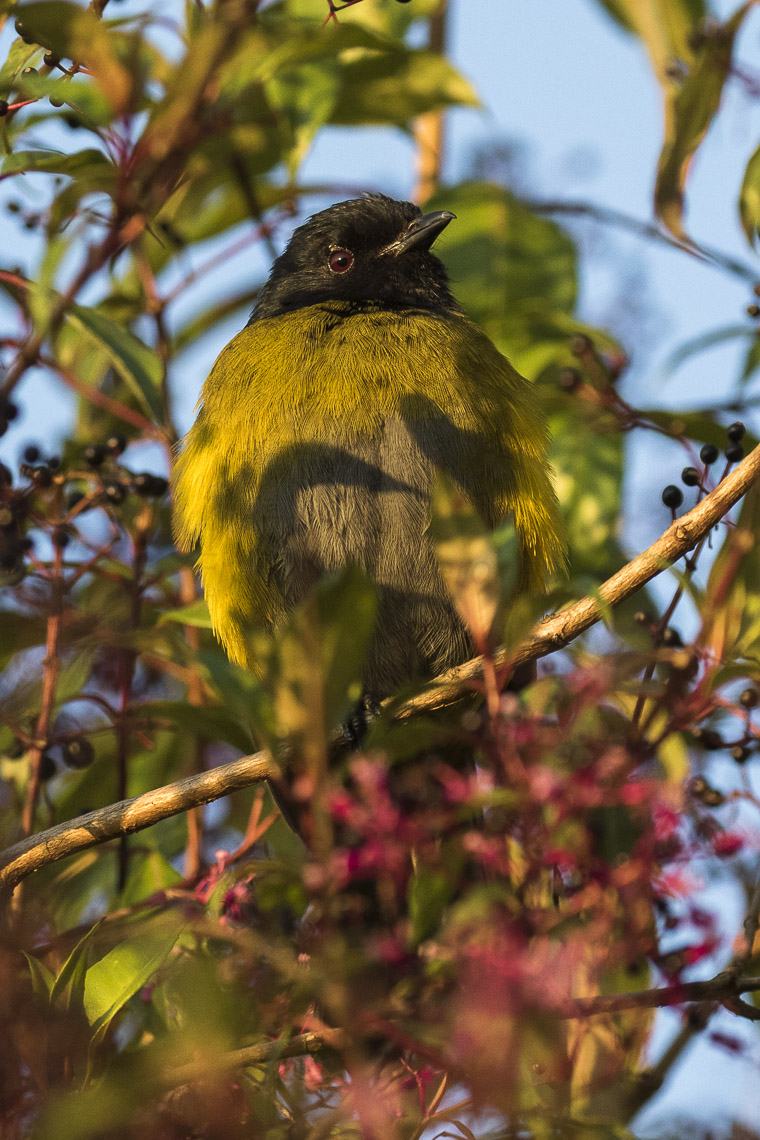
Wikipedia: Black-and-yellow silky-flycatcher
![]() The black-and-yellow phainoptila or black-and-yellow silky-flycatcher (Phainoptila melanoxantha) is a species of bird in the family Ptiliogonatidae. It is monotypic within the genus Phainoptila.[2] It is found in Costa Rica and Panama.
[more]
The black-and-yellow phainoptila or black-and-yellow silky-flycatcher (Phainoptila melanoxantha) is a species of bird in the family Ptiliogonatidae. It is monotypic within the genus Phainoptila.[2] It is found in Costa Rica and Panama.
[more]
Familie Cinclidae (Wasseramseln):
Gattung Cinclus:
Grauwasseramsel / American dipper (Cinclus mexicanus)
Profil Wikipedia Audubon Xeno-Canto
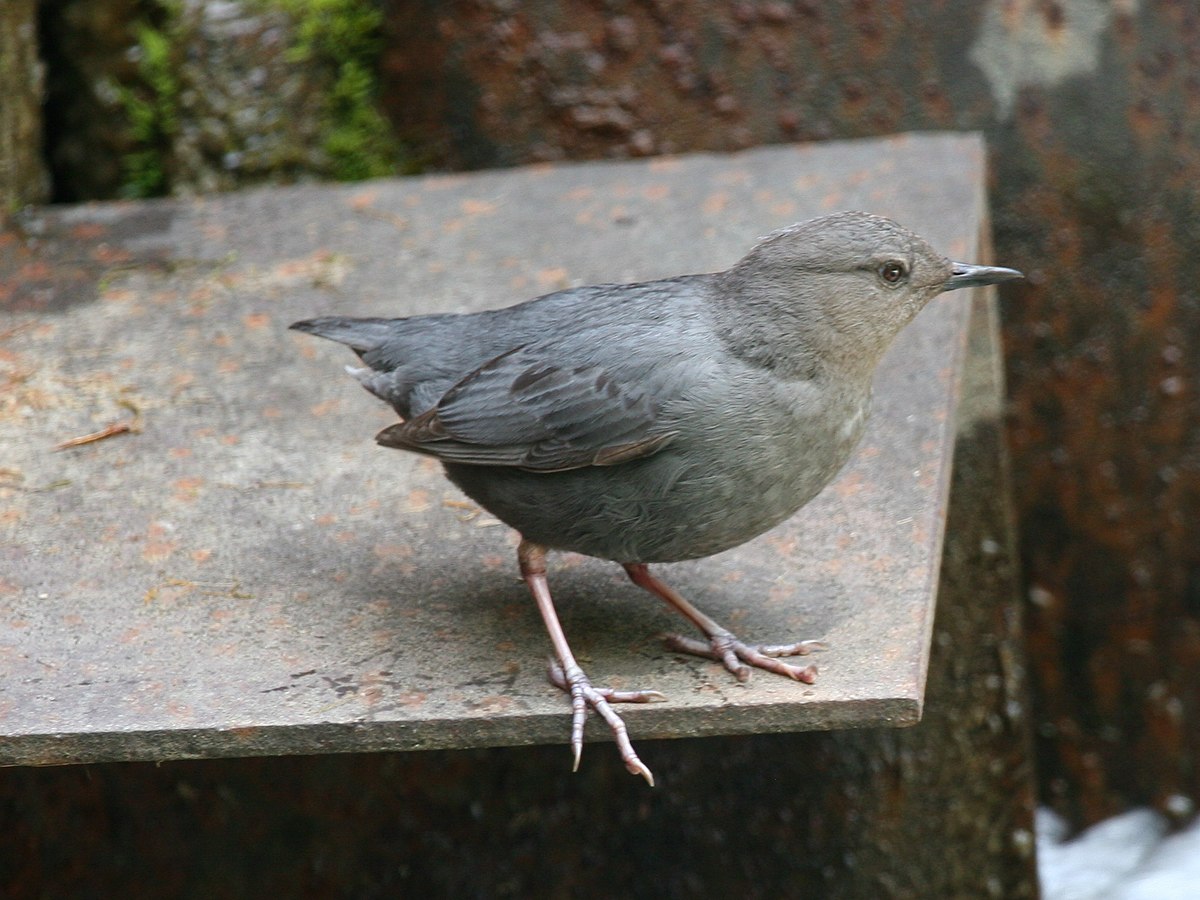
Wikipedia: American dipper
![]() The American dipper (Cinclus mexicanus), also known as a water ouzel, is a stocky dark grey bird with a head sometimes tinged with brown, and white feathers on the eyelids that cause the eyes to flash white as the bird blinks. It is 16.5 cm (6.5 in) long, has a wingspan of 23 cm,[2] and weighs on average 46 g (1.6 oz). It has long legs, and bobs its whole body up and down during pauses as it feeds on the bottom of fast-moving, rocky streams. It inhabits the mountainous regions of Central America and western North America from Panama to Alaska.
[more]
The American dipper (Cinclus mexicanus), also known as a water ouzel, is a stocky dark grey bird with a head sometimes tinged with brown, and white feathers on the eyelids that cause the eyes to flash white as the bird blinks. It is 16.5 cm (6.5 in) long, has a wingspan of 23 cm,[2] and weighs on average 46 g (1.6 oz). It has long legs, and bobs its whole body up and down during pauses as it feeds on the bottom of fast-moving, rocky streams. It inhabits the mountainous regions of Central America and western North America from Panama to Alaska.
[more]
Überfamilie Corvoidea:
Familie Corvidae (Krähenverwandte):
Gattung Cyanolyca:
Profil Wikipedia Xeno-Canto

Wikipedia: Silvery-throated jay
![]() The silvery-throated jay (Cyanolyca argentigula) is a species of bird in the family Corvidae. It is found in the Talamancan montane forests of Costa Rica and western Panama. The IUCN has rated its conservation status as being of "least concern".
[more]
The silvery-throated jay (Cyanolyca argentigula) is a species of bird in the family Corvidae. It is found in the Talamancan montane forests of Costa Rica and western Panama. The IUCN has rated its conservation status as being of "least concern".
[more]
Profil Wikipedia Xeno-Canto

Wikipedia: Azure-hooded jay
![]() The azure-hooded jay (Cyanolyca cucullata) is a species of bird in the family Corvidae. It is found in Middle America. Its natural habitat is subtropical or tropical moist montane forest. This species is known to have four subspecies. It is 11 to 12 inches (28 to 30 cm) in length and is dark blue with a black head and upper chest. The back of the head and neck are sky blue with a white border.
[more]
The azure-hooded jay (Cyanolyca cucullata) is a species of bird in the family Corvidae. It is found in Middle America. Its natural habitat is subtropical or tropical moist montane forest. This species is known to have four subspecies. It is 11 to 12 inches (28 to 30 cm) in length and is dark blue with a black head and upper chest. The back of the head and neck are sky blue with a white border.
[more]
Gattung Cyanocorax:
Profil Wikipedia Xeno-Canto
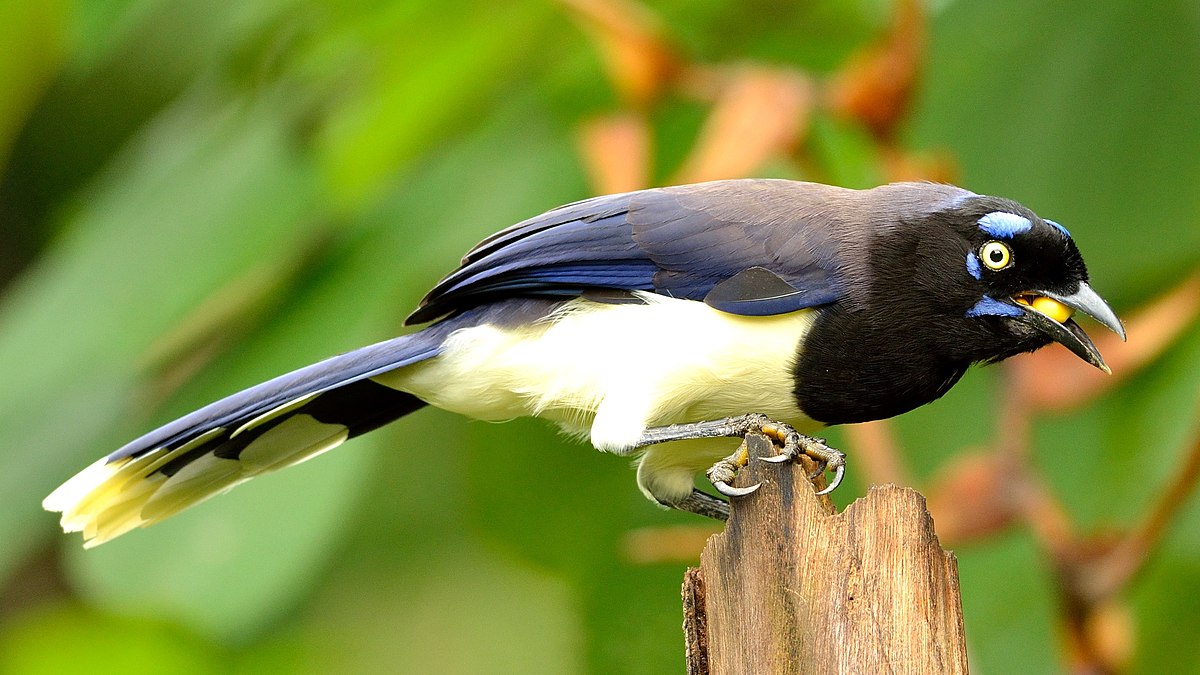
Wikipedia: Black-chested jay
![]() The black-chested jay (Cyanocorax affinis) is a species of bird in the family Corvidae.
[more]
The black-chested jay (Cyanocorax affinis) is a species of bird in the family Corvidae.
[more]
Arenal feeder 2 brown jays. 2018-02-27 13.24.36 null
![]() The brown jay (Psilorhinus morio) is a large American jay which has the habitus of a magpie, but is slightly smaller and with a shorter tail, though the bill is larger.
[more]
The brown jay (Psilorhinus morio) is a large American jay which has the habitus of a magpie, but is slightly smaller and with a shorter tail, though the bill is larger.
[more]
Gattung Calocitta:
Profil Wikipedia Xeno-Canto

Wikipedia: White-throated magpie-jay
![]() The white-throated magpie-jay (Calocitta formosa) is a large Central American species of magpie-jay. It ranges in Pacific-slope thorn forest from Jalisco, Mexico to Guanacaste, Costa Rica. Magpie-jays are noisy, gregarious birds, often traveling in easy-to-find flocks, mobbing their observers.
[more]
The white-throated magpie-jay (Calocitta formosa) is a large Central American species of magpie-jay. It ranges in Pacific-slope thorn forest from Jalisco, Mexico to Guanacaste, Costa Rica. Magpie-jays are noisy, gregarious birds, often traveling in easy-to-find flocks, mobbing their observers.
[more]
Familie Vireonidae (Vireos):
Unterfamilie Cyclarhinae (Peppershrikes):
Profil Wikipedia Xeno-Canto

Wikipedia: Rufous-browed peppershrike
![]() The rufous-browed peppershrike (Cyclarhis gujanensis) is a passerine bird in the vireo family. It is widespread and often common in woodland, forest edge, and cultivation with some tall trees from Mexico and Trinidad south to Argentina and Uruguay.
[more]
The rufous-browed peppershrike (Cyclarhis gujanensis) is a passerine bird in the vireo family. It is widespread and often common in woodland, forest edge, and cultivation with some tall trees from Mexico and Trinidad south to Argentina and Uruguay.
[more]
Unterfamilie Vireoninae (Shrike-vireos):
Profil Wikipedia Audubon Xeno-Canto

Wikipedia: Yellow-green vireo
![]() The yellow-green vireo (Vireo flavoviridis) is a small American passerine bird. It is migratory breeding from Mexico to Panama and wintering in the northern and eastern Andes and the western Amazon Basin.
[more]
The yellow-green vireo (Vireo flavoviridis) is a small American passerine bird. It is migratory breeding from Mexico to Panama and wintering in the northern and eastern Andes and the western Amazon Basin.
[more]
Profil Wikipedia Audubon Xeno-Canto

Wikipedia: Warbling vireo
![]() The warbling vireo (Vireo gilvus) is a small North American songbird.
[more]
The warbling vireo (Vireo gilvus) is a small North American songbird.
[more]
Profil Wikipedia Audubon Xeno-Canto

Wikipedia: White-eyed vireo
![]() The white-eyed vireo (Vireo griseus) is a small songbird. It breeds in the southeastern United States from New Jersey west to northern Missouri and south to Texas and Florida, and also in eastern Mexico, northern Central America, Cuba and the Bahamas.
[more]
The white-eyed vireo (Vireo griseus) is a small songbird. It breeds in the southeastern United States from New Jersey west to northern Missouri and south to Texas and Florida, and also in eastern Mexico, northern Central America, Cuba and the Bahamas.
[more]
Profil Wikipedia Audubon Xeno-Canto

Wikipedia: Black-whiskered vireo
![]() The black-whiskered vireo (Vireo altiloquus) is a small passerine bird, which breeds in southern Florida, USA, and the West Indies as far south as the offshore islands of Venezuela. It is a partial migrant, with northern birds wintering from the Greater Antilles to northern South America. This species has occurred as a rare vagrant to Costa Rica.
[more]
The black-whiskered vireo (Vireo altiloquus) is a small passerine bird, which breeds in southern Florida, USA, and the West Indies as far south as the offshore islands of Venezuela. It is a partial migrant, with northern birds wintering from the Greater Antilles to northern South America. This species has occurred as a rare vagrant to Costa Rica.
[more]
Profil Wikipedia Audubon Xeno-Canto

Wikipedia: Yellow-throated vireo
![]() The yellow-throated vireo (Vireo flavifrons) is a small American songbird.
[more]
The yellow-throated vireo (Vireo flavifrons) is a small American songbird.
[more]
Profil Wikipedia Audubon Xeno-Canto

Wikipedia: Red-eyed vireo
![]() The red-eyed vireo (Vireo olivaceus) is a small American songbird. It is somewhat warbler-like but not closely related to the New World warblers (Parulidae). Common across its vast range, this species is not considered threatened by the IUCN.
[more]
The red-eyed vireo (Vireo olivaceus) is a small American songbird. It is somewhat warbler-like but not closely related to the New World warblers (Parulidae). Common across its vast range, this species is not considered threatened by the IUCN.
[more]

Wikipedia: Philadelphia vireo
![]() The Philadelphia vireo (Vireo philadelphicus) is a small North American songbird in the vireo family (Vireonidae). "Vireo" is a Latin word referring to a green migratory bird, perhaps the female golden oriole, possibly the European greenfinch. The specific philadelphicus is for the city of Philadelphia.[2][3]
[more]
The Philadelphia vireo (Vireo philadelphicus) is a small North American songbird in the vireo family (Vireonidae). "Vireo" is a Latin word referring to a green migratory bird, perhaps the female golden oriole, possibly the European greenfinch. The specific philadelphicus is for the city of Philadelphia.[2][3]
[more]
Profil Wikipedia Xeno-Canto

Wikipedia: Brown-capped vireo
![]() The brown-capped vireo (Vireo leucophrys) is a small passerine bird. It breeds in highlands from southern Mexico south to northwestern Bolivia. It is sometimes considered to be conspecific with the similar warbling vireo.
[more]
The brown-capped vireo (Vireo leucophrys) is a small passerine bird. It breeds in highlands from southern Mexico south to northwestern Bolivia. It is sometimes considered to be conspecific with the similar warbling vireo.
[more]
Profil Wikipedia Xeno-Canto

Wikipedia: Yellow-winged vireo
![]() The yellow-winged vireo (Vireo carmioli) is a small passerine bird. It is endemic to the highlands of Costa Rica and western Panama.
[more]
The yellow-winged vireo (Vireo carmioli) is a small passerine bird. It is endemic to the highlands of Costa Rica and western Panama.
[more]
Profil Wikipedia Xeno-Canto

Wikipedia: Mangrove vireo
![]() The mangrove vireo (Vireo pallens) is a species of bird in the family Vireonidae.
[more]
The mangrove vireo (Vireo pallens) is a species of bird in the family Vireonidae.
[more]
Unterfamilie Vireolaniinae (Vireos and greenlets):

Wikipedia: Green shrike-vireo
![]() The green shrike-vireo (Vireolanius pulchellus) is a species of bird in the family Vireonidae. It is found in Belize, Colombia, Costa Rica, El Salvador, Guatemala, Honduras, Mexico, Nicaragua, and Panama. Its natural habitat is subtropical or tropical moist lowland forests.
[more]
The green shrike-vireo (Vireolanius pulchellus) is a species of bird in the family Vireonidae. It is found in Belize, Colombia, Costa Rica, El Salvador, Guatemala, Honduras, Mexico, Nicaragua, and Panama. Its natural habitat is subtropical or tropical moist lowland forests.
[more]

Wikipedia: Yellow-browed shrike-vireo
![]() The yellow-browed shrike-vireo (Vireolanius eximius) is a species of bird in the family Vireonidae.
[more]
The yellow-browed shrike-vireo (Vireolanius eximius) is a species of bird in the family Vireonidae.
[more]
Gattung Hylophilus:

Wikipedia: Tawny-crowned greenlet
![]() The tawny-crowned greenlet (Tunchiornis ochraceiceps) is a species of bird in the family Vireonidae. It is found in Belize, Bolivia, Brazil, Colombia, Costa Rica, Ecuador, French Guiana, Guatemala, Guyana, Honduras, Mexico, Nicaragua, Panama, Peru, Suriname, and Venezuela. Its natural habitat is subtropical or tropical moist lowland forest. It is monotypic in the genus Tunchiornis.
[more]
The tawny-crowned greenlet (Tunchiornis ochraceiceps) is a species of bird in the family Vireonidae. It is found in Belize, Bolivia, Brazil, Colombia, Costa Rica, Ecuador, French Guiana, Guatemala, Guyana, Honduras, Mexico, Nicaragua, Panama, Peru, Suriname, and Venezuela. Its natural habitat is subtropical or tropical moist lowland forest. It is monotypic in the genus Tunchiornis.
[more]
Profil Wikipedia Xeno-Canto

Wikipedia: Golden-fronted greenlet
![]() The golden-fronted greenlet (Pachysylvia aurantiifrons) is a small passerine bird in the vireo family. It breeds in Panama, Colombia, Venezuela and Trinidad.
[more]
The golden-fronted greenlet (Pachysylvia aurantiifrons) is a small passerine bird in the vireo family. It breeds in Panama, Colombia, Venezuela and Trinidad.
[more]
Profil Wikipedia Xeno-Canto

Wikipedia: Lesser greenlet
![]() The lesser greenlet (Pachysylvia decurtata) is a small passerine bird in the vireo family. It breeds from northeastern Mexico south to western Ecuador.
[more]
The lesser greenlet (Pachysylvia decurtata) is a small passerine bird in the vireo family. It breeds from northeastern Mexico south to western Ecuador.
[more]
Familie Thraupidae (Tanagers):
Gattung Ramphocelus:
Scharlachbauchtangare / Crimson-backed tanager (Ramphocelus dimidiatus)
Profil Wikipedia Xeno-Canto
Crimson-backed tanager gamboa town. 2020-02-17 17.52.16 null
We saw this beautiful bird walking around Gamboa town in Panama. They were also common on the hotel grounds.
Allgemein: ![]() The crimson-backed tanager (Ramphocelus dimidiatus) is a species of bird in the family Thraupidae. It is found in Colombia, Panama, and Venezuela, and introduced to French Polynesia.[2] Its natural habitats are subtropical or tropical moist lowland forests and heavily degraded former forest.[2] A nickname in Panama is sangre de toro ("Blood of the bull").[3]
[more]
The crimson-backed tanager (Ramphocelus dimidiatus) is a species of bird in the family Thraupidae. It is found in Colombia, Panama, and Venezuela, and introduced to French Polynesia.[2] Its natural habitats are subtropical or tropical moist lowland forests and heavily degraded former forest.[2] A nickname in Panama is sangre de toro ("Blood of the bull").[3]
[more]
Ramphocelus passerinii / Passerini's tanager (Ramphocelus passerinii)
La fortuna passerinis tanager pair. 2018-02-26 14.57.40 null
![]() The scarlet-rumped tanager (Ramphocelus passerinii) is a medium-sized passerine bird. This tanager is a resident breeder in the Caribbean lowlands from southern Mexico to western Panama. This species was formerly known as the scarlet-rumped tanager, but was renamed when the distinctive form found on the Pacific coast of Costa Rica and Panama was reclassified as a separate species, the Cherrie's tanager, Ramphocelus costaricensis. While most authorities have accepted this split, there are notable exceptions (e.g. the Howard and Moore checklist). It was renamed back to the scarlet-rumped tanager in 2018 when Cherrie's Tanager was lumped back into the species.
[more]
The scarlet-rumped tanager (Ramphocelus passerinii) is a medium-sized passerine bird. This tanager is a resident breeder in the Caribbean lowlands from southern Mexico to western Panama. This species was formerly known as the scarlet-rumped tanager, but was renamed when the distinctive form found on the Pacific coast of Costa Rica and Panama was reclassified as a separate species, the Cherrie's tanager, Ramphocelus costaricensis. While most authorities have accepted this split, there are notable exceptions (e.g. the Howard and Moore checklist). It was renamed back to the scarlet-rumped tanager in 2018 when Cherrie's Tanager was lumped back into the species.
[more]
Flammentangare / Crimson-collared tanager (Ramphocelus sanguinolentus)
Profil Wikipedia Xeno-Canto
Crimson collared tanager. 2018-02-26 10.49.32 null
![]() The crimson-collared tanager (Ramphocelus sanguinolentus) is a rather small Middle American songbird. It was first described by the French naturalist René-Primevère Lesson in 1831, its specific epithet from the Latin adjective sanguinolentus, "bloodied", referring to its red plumage.
[more]
The crimson-collared tanager (Ramphocelus sanguinolentus) is a rather small Middle American songbird. It was first described by the French naturalist René-Primevère Lesson in 1831, its specific epithet from the Latin adjective sanguinolentus, "bloodied", referring to its red plumage.
[more]
Ramphocelus flammigerus / Flame-rumped tanager (Ramphocelus flammigerus)

Wikipedia: Flame-rumped tanager
![]() The flame-rumped tanager (Ramphocelus flammigerus) is a species of bird in the family Thraupidae. It is found in semi-open forest and woodland.
[more]
The flame-rumped tanager (Ramphocelus flammigerus) is a species of bird in the family Thraupidae. It is found in semi-open forest and woodland.
[more]
Gattung Piranga:
Piranga rubra / Summer tanager (Piranga rubra)
Profil Wikipedia Audubon Xeno-Canto
Arenal feeder summer tanager tenatative ID. 2018-02-27 12.58.26 null
![]() The summer tanager (Piranga rubra) is a medium-sized American songbird. Formerly placed in the tanager family (Thraupidae), it and other members of its genus are now classified in the cardinal family (Cardinalidae).[2] The species's plumage and vocalizations are similar to other members of the cardinal family.
[more]
The summer tanager (Piranga rubra) is a medium-sized American songbird. Formerly placed in the tanager family (Thraupidae), it and other members of its genus are now classified in the cardinal family (Cardinalidae).[2] The species's plumage and vocalizations are similar to other members of the cardinal family.
[more]
Kieferntangare / Western tanager (Piranga ludoviciana)
Profil Wikipedia Audubon Xeno-Canto

Wikipedia: Western tanager
![]() The western tanager (Piranga ludoviciana), is a medium-sized American songbird. Formerly placed in the tanager family (Thraupidae), other members of its genus and it are classified in the cardinal family (Cardinalidae). The species's plumage and vocalizations are similar to other members of the cardinal family.
[more]
The western tanager (Piranga ludoviciana), is a medium-sized American songbird. Formerly placed in the tanager family (Thraupidae), other members of its genus and it are classified in the cardinal family (Cardinalidae). The species's plumage and vocalizations are similar to other members of the cardinal family.
[more]
Piranga olivacea / Scarlet tanager (Piranga olivacea)
Profil Wikipedia Audubon Xeno-Canto

Wikipedia: Scarlet tanager
![]() The scarlet tanager (Piranga olivacea) is a medium-sized American songbird. Until recently, it was placed in the tanager family (Thraupidae), but it and other members of its genus are now classified as belonging to the cardinal family (Cardinalidae).[2] The species' plumage and vocalizations are similar to other members of the cardinal family, although the Piranga species lacks the thick conical bill (well suited to seed and insect eating) that many cardinals possess. The species resides in thick deciduous woodlands and suburbs.
[more]
The scarlet tanager (Piranga olivacea) is a medium-sized American songbird. Until recently, it was placed in the tanager family (Thraupidae), but it and other members of its genus are now classified as belonging to the cardinal family (Cardinalidae).[2] The species' plumage and vocalizations are similar to other members of the cardinal family, although the Piranga species lacks the thick conical bill (well suited to seed and insect eating) that many cardinals possess. The species resides in thick deciduous woodlands and suburbs.
[more]
Piranga flava / Hepatic tanager (Piranga flava)
Profil Wikipedia Audubon Xeno-Canto

Wikipedia: Hepatic tanager
![]() The hepatic tanager (Piranga flava) is a medium-sized American songbird. Formerly placed in the tanager family (Thraupidae), it and other members of the genus Piranga are now classified in the cardinal family (Cardinalidae).[2] The species's plumage and vocalizations are similar to other members of the cardinal family.
[more]
The hepatic tanager (Piranga flava) is a medium-sized American songbird. Formerly placed in the tanager family (Thraupidae), it and other members of the genus Piranga are now classified in the cardinal family (Cardinalidae).[2] The species's plumage and vocalizations are similar to other members of the cardinal family.
[more]
Piranga bidentata / Flame-colored tanager (Piranga bidentata)
Profil Wikipedia Audubon Xeno-Canto

Wikipedia: Flame-colored tanager
![]() The flame-colored tanager (Piranga bidentata), formerly known as the stripe-backed tanager, is a medium-sized American songbird. Formerly placed in the tanager family Thraupidae, other members of its genus and it are now classified in the cardinal family Cardinalidae.[2][3] The species's plumage and vocalizations are similar to other members of the cardinal family.
[more]
The flame-colored tanager (Piranga bidentata), formerly known as the stripe-backed tanager, is a medium-sized American songbird. Formerly placed in the tanager family Thraupidae, other members of its genus and it are now classified in the cardinal family Cardinalidae.[2][3] The species's plumage and vocalizations are similar to other members of the cardinal family.
[more]
Piranga leucoptera / White-winged tanager (Piranga leucoptera)
Profil Wikipedia Xeno-Canto

Wikipedia: White-winged tanager
![]() The white-winged tanager (Piranga leucoptera) is a medium-sized American songbird. Formerly placed in the tanager family (Thraupidae),other members of its genus and it are now classified in the cardinal family (Cardinalidae).[2] The species' plumage and vocalizations are similar to other members of the cardinal family. Along with the red-headed tanager and red-hooded tanager, it is sometimes placed in the genus Spermagra.
[more]
The white-winged tanager (Piranga leucoptera) is a medium-sized American songbird. Formerly placed in the tanager family (Thraupidae),other members of its genus and it are now classified in the cardinal family (Cardinalidae).[2] The species' plumage and vocalizations are similar to other members of the cardinal family. Along with the red-headed tanager and red-hooded tanager, it is sometimes placed in the genus Spermagra.
[more]
Gattung Rhodinocichla:
Rhodinocichla rosea / Rosy thrush-tanager (Rhodinocichla rosea)
Profil Wikipedia Xeno-Canto

Wikipedia: Rosy thrush-tanager
![]() The rosy thrush-tanager (Rhodinocichla rosea) or rose-breasted thrush-tanager, is a species of bird in the currently monotypic genus Rhodinocichla. It was formerly assigned to the family Thraupidae and more recently viewed as being of uncertain placement;[2] a 2015 molecular study places it closest to the Calcariidae.[3] Found in Colombia, Costa Rica, Mexico, Panama, and Venezuela, its natural habitats are subtropical or tropical dry forests, subtropical or tropical moist lowland forests, and heavily degraded former forest.[1]
[more]
The rosy thrush-tanager (Rhodinocichla rosea) or rose-breasted thrush-tanager, is a species of bird in the currently monotypic genus Rhodinocichla. It was formerly assigned to the family Thraupidae and more recently viewed as being of uncertain placement;[2] a 2015 molecular study places it closest to the Calcariidae.[3] Found in Colombia, Costa Rica, Mexico, Panama, and Venezuela, its natural habitats are subtropical or tropical dry forests, subtropical or tropical moist lowland forests, and heavily degraded former forest.[1]
[more]
Gattung Chlorophanes:
Chlorophanes spiza / Green honeycreeper (Chlorophanes spiza)
Profil Wikipedia Xeno-Canto

Wikipedia: Green honeycreeper
![]() The green honeycreeper (Chlorophanes spiza) is a small bird in the tanager family. It is found in the tropical New World from southern Mexico south to Brazil, and on Trinidad. It is the only member of the genus Chlorophanes.
[more]
The green honeycreeper (Chlorophanes spiza) is a small bird in the tanager family. It is found in the tropical New World from southern Mexico south to Brazil, and on Trinidad. It is the only member of the genus Chlorophanes.
[more]
Gattung Chlorothraupis:
Chlorothraupis carmioli / Carmiol's tanager (Chlorothraupis carmioli)
Profil Wikipedia Xeno-Canto

Wikipedia: Carmiol's tanager
![]() The olive tanager (Chlorothraupis carmioli), also known as Carmiol's tanager, is a species of bird traditionally placed in the family Thraupidae (tanagers), though molecular evidence indicates it should be placed in Cardinalidae (cardinals).[1] This bird's natural habitats are subtropical or tropical moist lowland forests and heavily degraded former forest.
[more]
The olive tanager (Chlorothraupis carmioli), also known as Carmiol's tanager, is a species of bird traditionally placed in the family Thraupidae (tanagers), though molecular evidence indicates it should be placed in Cardinalidae (cardinals).[1] This bird's natural habitats are subtropical or tropical moist lowland forests and heavily degraded former forest.
[more]
Chlorothraupis olivacea / Lemon-spectacled tanager (Chlorothraupis olivacea)
Profil Wikipedia Xeno-Canto

Wikipedia: Lemon-spectacled tanager
![]() The lemon-spectacled tanager (Chlorothraupis olivacea) is a species of bird in the family Cardinalidae. It is found in Colombia, Ecuador, and Panama where its natural habitats are subtropical or tropical moist lowland forest, subtropical or tropical moist montane forest, and heavily degraded former forest.
[more]
The lemon-spectacled tanager (Chlorothraupis olivacea) is a species of bird in the family Cardinalidae. It is found in Colombia, Ecuador, and Panama where its natural habitats are subtropical or tropical moist lowland forest, subtropical or tropical moist montane forest, and heavily degraded former forest.
[more]
Gattung Chrysothlypis:
Chrysothlypis chrysomelas / Black-and-yellow tanager (Chrysothlypis chrysomelas)
Profil Wikipedia Xeno-Canto

Wikipedia: Black-and-yellow tanager
![]() The black-and-yellow tanager (Chrysothlypis chrysomelas) is a fairly small passerine bird. This tanager is an endemic resident in the hills of Costa Rica and Panama. In Panama it has been recorded as far east as the border-region with Colombia, but it has not yet been recorded in the latter country, though it almost certainly occurs.[2]
[more]
The black-and-yellow tanager (Chrysothlypis chrysomelas) is a fairly small passerine bird. This tanager is an endemic resident in the hills of Costa Rica and Panama. In Panama it has been recorded as far east as the border-region with Colombia, but it has not yet been recorded in the latter country, though it almost certainly occurs.[2]
[more]
Gattung Dacnis:
Blaukopfpitpit / Blue dacnis (Dacnis cayana)
Profil Wikipedia Xeno-Canto

Wikipedia: Blue dacnis
![]() The blue dacnis or turquoise honeycreeper (Dacnis cayana) is a small passerine bird. This member of the tanager family is found from Nicaragua to Panama, on Trinidad, and in South America south to Bolivia and northern Argentina. It is widespread and often common, especially in parts of its South American range.
[more]
The blue dacnis or turquoise honeycreeper (Dacnis cayana) is a small passerine bird. This member of the tanager family is found from Nicaragua to Panama, on Trinidad, and in South America south to Bolivia and northern Argentina. It is widespread and often common, especially in parts of its South American range.
[more]
Dacnis venusta / Scarlet-thighed dacnis (Dacnis venusta)
Profil Wikipedia Xeno-Canto

Wikipedia: Scarlet-thighed dacnis
![]() The scarlet-thighed dacnis (Dacnis venusta) is a tanager 4¾" long. It is found in Costa Rica, Colombia, Ecuador and Panama.
[more]
The scarlet-thighed dacnis (Dacnis venusta) is a tanager 4¾" long. It is found in Costa Rica, Colombia, Ecuador and Panama.
[more]
Dacnis viguieri / Viridian dacnis (Dacnis viguieri)
Profil Wikipedia Xeno-Canto

Wikipedia: Viridian dacnis
![]() The viridian dacnis (Dacnis viguieri) is a species of bird in the family Thraupidae. It is found in Colombia and Panama.
[more]
The viridian dacnis (Dacnis viguieri) is a species of bird in the family Thraupidae. It is found in Colombia and Panama.
[more]
Gattung Diglossa:
Diglossa plumbea / Slaty flowerpiercer (Diglossa plumbea)
Profil Wikipedia Xeno-Canto

Wikipedia: Slaty flowerpiercer
![]() The slaty flowerpiercer, Diglossa plumbea, is a passerine bird endemic to the Talamancan montane forests.
[more]
The slaty flowerpiercer, Diglossa plumbea, is a passerine bird endemic to the Talamancan montane forests.
[more]
Gattung Eucometis:
Eucometis penicillata / Gray-headed tanager (Eucometis penicillata)
Profil Wikipedia Xeno-Canto

Wikipedia: Gray-headed tanager
![]() The grey-headed tanager (Eucometis penicillata) is a widely distributed species of small Neotropical bird in the tanager family Thraupidae. It is the only member of the genus Eucometis.
[more]
The grey-headed tanager (Eucometis penicillata) is a widely distributed species of small Neotropical bird in the tanager family Thraupidae. It is the only member of the genus Eucometis.
[more]
Gattung Habia:
Habia rubica / Red-crowned ant-tanager (Habia rubica)
Profil Wikipedia Xeno-Canto

Wikipedia: Red-crowned ant-tanager
![]() The red-crowned ant tanager (Habia rubica) is a medium-sized passerine bird from tropical America. The genus Habia was long placed with the tanagers (Thraupidae), but it is actually closer to the cardinals (Cardinalidae). Consequently, it can be argued that referring to the members of this genus as ant-tanagers is misleading, but no other common name has gained usage.
[more]
The red-crowned ant tanager (Habia rubica) is a medium-sized passerine bird from tropical America. The genus Habia was long placed with the tanagers (Thraupidae), but it is actually closer to the cardinals (Cardinalidae). Consequently, it can be argued that referring to the members of this genus as ant-tanagers is misleading, but no other common name has gained usage.
[more]
Habia fuscicauda / Red-throated ant-tanager (Habia fuscicauda)
Profil Wikipedia Xeno-Canto
Red throated ant tanager maybe. 2020-02-19 07.46.46 null
![]() The red-throated ant tanager (Habia fuscicauda) is a medium-sized passerine bird. This species is a resident breeder on the Caribbean slopes from southeastern Mexico to eastern Panama. It was usually considered an aberrant kind of tanager and placed in the Thraupidae, but is actually closer to the cardinals (Cardinalidae). Consequently, it can be argued that referring to the members of this genus as ant tanagers is misleading, but no other common name has gained usage.
[more]
The red-throated ant tanager (Habia fuscicauda) is a medium-sized passerine bird. This species is a resident breeder on the Caribbean slopes from southeastern Mexico to eastern Panama. It was usually considered an aberrant kind of tanager and placed in the Thraupidae, but is actually closer to the cardinals (Cardinalidae). Consequently, it can be argued that referring to the members of this genus as ant tanagers is misleading, but no other common name has gained usage.
[more]
Habia atrimaxillaris / Black-cheeked ant-tanager (Habia atrimaxillaris)
Profil Wikipedia Xeno-Canto

Wikipedia: Black-cheeked ant-tanager
![]() The black-cheeked ant tanager (Habia atrimaxillaris) is a species of bird in the family Cardinalidae. It is endemic to the Osa Peninsula of Costa Rica. Its natural habitats are subtropical or tropical moist lowland forest and subtropical or tropical moist shrubland. It is threatened by habitat loss.[1]
[more]
The black-cheeked ant tanager (Habia atrimaxillaris) is a species of bird in the family Cardinalidae. It is endemic to the Osa Peninsula of Costa Rica. Its natural habitats are subtropical or tropical moist lowland forest and subtropical or tropical moist shrubland. It is threatened by habitat loss.[1]
[more]
Gattung Hemithraupis:
Hemithraupis flavicollis / Yellow-backed tanager (Hemithraupis flavicollis)
Profil Wikipedia Xeno-Canto

Wikipedia: Yellow-backed tanager
![]() The yellow-backed tanager (Hemithraupis flavicollis) is a species of bird in the family Thraupidae, the tanagers.
[more]
The yellow-backed tanager (Hemithraupis flavicollis) is a species of bird in the family Thraupidae, the tanagers.
[more]
Gattung Heterospingus:
Heterospingus rubrifrons / Sulphur-rumped tanager (Heterospingus rubrifrons)
Profil Wikipedia Xeno-Canto

Wikipedia: Sulphur-rumped tanager
![]() The sulphur-rumped tanager (Heterospingus rubrifrons) is a species of bird in the family Thraupidae.
It is found in Costa Rica and Panama.
Its natural habitat is subtropical or tropical moist lowland forests.
[more]
The sulphur-rumped tanager (Heterospingus rubrifrons) is a species of bird in the family Thraupidae.
It is found in Costa Rica and Panama.
Its natural habitat is subtropical or tropical moist lowland forests.
[more]
Heterospingus xanthopygius / Scarlet-browed tanager (Heterospingus xanthopygius)
Profil Wikipedia Xeno-Canto

Wikipedia: Scarlet-browed tanager
![]() The scarlet-browed tanager (Heterospingus xanthopygius) is a species of bird in the family Thraupidae.
[more]
The scarlet-browed tanager (Heterospingus xanthopygius) is a species of bird in the family Thraupidae.
[more]
Gattung Lanio:
Lanio leucothorax / White-throated shrike-tanager (Lanio leucothorax)
Profil Wikipedia Xeno-Canto
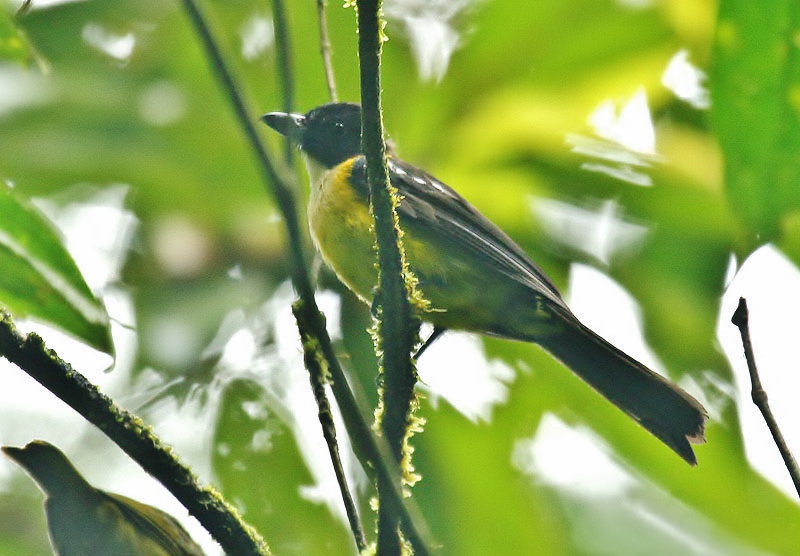
Wikipedia: White-throated shrike-tanager
![]() The white-throated shrike-tanager (Lanio leucothorax) is a species of bird in the family Thraupidae. It is found in Costa Rica, Honduras, Nicaragua, and Panama. Its natural habitat is subtropical or tropical moist lowland forests.
[more]
The white-throated shrike-tanager (Lanio leucothorax) is a species of bird in the family Thraupidae. It is found in Costa Rica, Honduras, Nicaragua, and Panama. Its natural habitat is subtropical or tropical moist lowland forests.
[more]
Gattung Mitrospingus:
Mitrospingus cassinii / Dusky-faced tanager (Mitrospingus cassinii)
Profil Wikipedia Xeno-Canto

Wikipedia: Dusky-faced tanager
![]() The dusky-faced tanager (Mitrospingus cassinii) is a species of bird formerly in the family Thraupidae.
[more]
The dusky-faced tanager (Mitrospingus cassinii) is a species of bird formerly in the family Thraupidae.
[more]
Gattung Tachyphonus:
Tachyphonus delattrii / Tawny-crested tanager (Tachyphonus delattrii)
Profil Wikipedia Xeno-Canto

Wikipedia: Tawny-crested tanager
![]() The tawny-crested tanager (Tachyphonus delatrii) is a species of bird in the family Thraupidae.
It is found in Colombia, Costa Rica, Ecuador, Honduras, Nicaragua, and Panama.
Its natural habitats are subtropical or tropical moist lowland forests, subtropical or tropical moist montane forests, and heavily degraded former forest.[1]
[more]
The tawny-crested tanager (Tachyphonus delatrii) is a species of bird in the family Thraupidae.
It is found in Colombia, Costa Rica, Ecuador, Honduras, Nicaragua, and Panama.
Its natural habitats are subtropical or tropical moist lowland forests, subtropical or tropical moist montane forests, and heavily degraded former forest.[1]
[more]
Tachyphonus rufus / White-lined tanager (Tachyphonus rufus)
Profil Wikipedia Xeno-Canto

Wikipedia: White-lined tanager
![]() The white-lined tanager (Tachyphonus rufus) is a medium-sized passerine bird in the tanager family Thraupidae. It is a resident breeder from Costa Rica south to northern Argentina, and on the islands of Trinidad and Tobago.
[more]
The white-lined tanager (Tachyphonus rufus) is a medium-sized passerine bird in the tanager family Thraupidae. It is a resident breeder from Costa Rica south to northern Argentina, and on the islands of Trinidad and Tobago.
[more]
Schwarzachseltangare / Tawny-crested tanager (Tachyphonus delatrii)
Profil Wikipedia Xeno-Canto

Wikipedia: Tawny-crested tanager
![]() The tawny-crested tanager (Tachyphonus delatrii) is a species of bird in the family Thraupidae.
It is found in Colombia, Costa Rica, Ecuador, Honduras, Nicaragua, and Panama.
Its natural habitats are subtropical or tropical moist lowland forests, subtropical or tropical moist montane forests, and heavily degraded former forest.[1]
[more]
The tawny-crested tanager (Tachyphonus delatrii) is a species of bird in the family Thraupidae.
It is found in Colombia, Costa Rica, Ecuador, Honduras, Nicaragua, and Panama.
Its natural habitats are subtropical or tropical moist lowland forests, subtropical or tropical moist montane forests, and heavily degraded former forest.[1]
[more]
Gattung Coereba:
Coereba flaveola / Bananaquit (Coereba flaveola)
Profil Wikipedia Xeno-Canto

Wikipedia: Bananaquit
![]() The bananaquit (Coereba flaveola) is a species of passerine bird in the tanager family Thraupidae. Before the development of molecular genetics in the 21st century, its relationship to other species was uncertain and it was either placed with the buntings and New World sparrows in the family Emberizidae, with New World warblers in the family Parulidae or in its own monotypic family Coerebidae. This small, active nectarivore is found in warmer parts of the Americas, and is generally common.
[more]
The bananaquit (Coereba flaveola) is a species of passerine bird in the tanager family Thraupidae. Before the development of molecular genetics in the 21st century, its relationship to other species was uncertain and it was either placed with the buntings and New World sparrows in the family Emberizidae, with New World warblers in the family Parulidae or in its own monotypic family Coerebidae. This small, active nectarivore is found in warmer parts of the Americas, and is generally common.
[more]
Gattung Tiaris:
Tiaris olivaceus / Yellow-faced grassquit (Tiaris olivaceus)

Wikipedia: Yellow-faced grassquit
![]() The yellow-faced grassquit (Tiaris olivaceus) is a passerine bird in the tanager family Thraupidae and is the only member of the genus Tiaris. It is native to the Central America, South America, and the Caribbean.
[more]
The yellow-faced grassquit (Tiaris olivaceus) is a passerine bird in the tanager family Thraupidae and is the only member of the genus Tiaris. It is native to the Central America, South America, and the Caribbean.
[more]
Gattung Pinaroloxias:
Pinaroloxias inornata / Cocos finch (Pinaroloxias inornata)
Profil Wikipedia Xeno-Canto

Wikipedia: Cocos finch
![]() The Cocos finch or Cocos Island finch (Pinaroloxias inornata) is the only one of the Darwin's finches not native to the Galápagos Islands, and the only member of the genus Pinaroloxias. Sometimes classified in the family Emberizidae, more recent studies have shown it to belongs in the tanager family, Thraupidae. It is endemic to Cocos Island, which is approximately 360 miles (580 km) south of Costa Rica.
[more]
The Cocos finch or Cocos Island finch (Pinaroloxias inornata) is the only one of the Darwin's finches not native to the Galápagos Islands, and the only member of the genus Pinaroloxias. Sometimes classified in the family Emberizidae, more recent studies have shown it to belongs in the tanager family, Thraupidae. It is endemic to Cocos Island, which is approximately 360 miles (580 km) south of Costa Rica.
[more]
Gattung Haplospiza:
Haplospiza rustica / Slaty finch (Haplospiza rustica)
Profil Wikipedia Xeno-Canto

Wikipedia: Slaty finch
![]() The slaty finch (Haplospiza rustica) is a bird species in the family Thraupidae (formerly in Emberizidae).
[more]
The slaty finch (Haplospiza rustica) is a bird species in the family Thraupidae (formerly in Emberizidae).
[more]
Gattung Sporophila:
Sporophila morelleti / Morelet's seedeater (Sporophila morelleti)
Profil Wikipedia Audubon Xeno-Canto

Wikipedia: Morelet's seedeater
![]() Morelet's seedeater (Sporophila morelleti) is a passerine bird in the typical seedeater genus Sporophila.
[more]
Morelet's seedeater (Sporophila morelleti) is a passerine bird in the typical seedeater genus Sporophila.
[more]
Sporophila schistacea / Slate-colored seedeater (Sporophila schistacea)
Profil Wikipedia Xeno-Canto

Wikipedia: Slate-colored seedeater
![]() The slate-coloured seedeater (Sporophila schistacea) is a bird species in the family Thraupidae.
[more]
The slate-coloured seedeater (Sporophila schistacea) is a bird species in the family Thraupidae.
[more]
Sporophila funerea / Thick-billed seed-finch (Sporophila funerea)
Profil Wikipedia Xeno-Canto

Wikipedia: Thick-billed seed-finch
![]() The thick-billed seed finch (Sporophila funerea) is a species of bird in the family Thraupidae, but was until recently placed in Emberizidae. It is found widely in shrubby and grassy areas from southern Mexico, through Central America, to the Chocó in Colombia and Ecuador. It is replaced by the closely related chestnut-bellied seed finch in South America east of the Andes, as well as the valleys of Cauca and Magdalena in Colombia. The two have often been considered conspecific as the lesser seed-finch (Oryzoborus angolensis).
[more]
The thick-billed seed finch (Sporophila funerea) is a species of bird in the family Thraupidae, but was until recently placed in Emberizidae. It is found widely in shrubby and grassy areas from southern Mexico, through Central America, to the Chocó in Colombia and Ecuador. It is replaced by the closely related chestnut-bellied seed finch in South America east of the Andes, as well as the valleys of Cauca and Magdalena in Colombia. The two have often been considered conspecific as the lesser seed-finch (Oryzoborus angolensis).
[more]
Sporophila nuttingi / Nicaraguan seed-finch (Sporophila nuttingi)
Profil Wikipedia Xeno-Canto

Wikipedia: Nicaraguan seed-finch
![]() The Nicaraguan seed finch (Sporophila nuttingi) is a species of bird in the family Thraupidae. It is found in Costa Rica, Nicaragua and northwestern Panama.
[more]
The Nicaraguan seed finch (Sporophila nuttingi) is a species of bird in the family Thraupidae. It is found in Costa Rica, Nicaragua and northwestern Panama.
[more]
Gelbbauchpfäffchen / Yellow-bellied seedeater (Sporophila nigricollis)
Profil Wikipedia Xeno-Canto

Wikipedia: Yellow-bellied seedeater
![]() The yellow-bellied seedeater (Sporophila nigricollis) is a species of bird in the family Thraupidae, formerly placed with the American sparrows in the Emberizidae.
[more]
The yellow-bellied seedeater (Sporophila nigricollis) is a species of bird in the family Thraupidae, formerly placed with the American sparrows in the Emberizidae.
[more]
Sporophila corvina / Variable seedeater (Sporophila corvina)
Profil Wikipedia Xeno-Canto

Wikipedia: Variable seedeater
![]() The variable seedeater (Sporophila corvina) is a passerine bird which breeds from southern Mexico through Central America to the Chocó of northwestern South America. The taxonomy is confusing, and it was formerly considered a subspecies of Sporophila americana (see Taxonomy). Even within the variable seedeater as presently defined, there are great variations in plumage.
[more]
The variable seedeater (Sporophila corvina) is a passerine bird which breeds from southern Mexico through Central America to the Chocó of northwestern South America. The taxonomy is confusing, and it was formerly considered a subspecies of Sporophila americana (see Taxonomy). Even within the variable seedeater as presently defined, there are great variations in plumage.
[more]
Sporophila minuta / Ruddy-breasted seedeater (Sporophila minuta)
Profil Wikipedia Xeno-Canto

Wikipedia: Ruddy-breasted seedeater
![]() The ruddy-breasted seedeater (Sporophila minuta) is a species of bird in the tanager family Thraupidae.
It is found in Brazil, Colombia, Costa Rica, Ecuador, El Salvador, French Guiana, Guatemala, Guyana, Honduras, Mexico, Nicaragua, Panama, Suriname, Trinidad and Tobago, and Venezuela.
Its natural habitats are dry savanna, subtropical or tropical seasonally wet or flooded lowland grassland, and heavily degraded former forest.
[more]
The ruddy-breasted seedeater (Sporophila minuta) is a species of bird in the tanager family Thraupidae.
It is found in Brazil, Colombia, Costa Rica, Ecuador, El Salvador, French Guiana, Guatemala, Guyana, Honduras, Mexico, Nicaragua, Panama, Suriname, Trinidad and Tobago, and Venezuela.
Its natural habitats are dry savanna, subtropical or tropical seasonally wet or flooded lowland grassland, and heavily degraded former forest.
[more]
Sporophila crassirostris / Large-billed seed-finch (Sporophila crassirostris)
Profil Wikipedia Xeno-Canto

Wikipedia: Large-billed seed-finch
![]() The large-billed seed finch (Sporophila crassirostris) is a species of bird in the family Thraupidae.
[more]
The large-billed seed finch (Sporophila crassirostris) is a species of bird in the family Thraupidae.
[more]
Gattung Volatinia:
Volatinia jacarina / Blue-black grassquit (Volatinia jacarina)

Wikipedia: Blue-black grassquit
![]() Tanagra jacarina Linnaeus, 1766
[more]
Tanagra jacarina Linnaeus, 1766
[more]
Gattung Sicalis:
Sicalis flaveola / Saffron finch (Sicalis flaveola)
Profil Wikipedia Audubon Xeno-Canto

Wikipedia: Saffron finch
![]() The saffron finch (Sicalis flaveola) is a tanager from South America that is common in open and semi-open areas in lowlands outside the Amazon Basin. They have a wide distribution in Colombia, northern Venezuela (where it is called "canario de tejado" or "roof canary"), western Ecuador, western Peru, eastern and southern Brazil (where it is called "canário-da-terra" or "native canary"), Bolivia, Paraguay, Uruguay, northern Argentina, and Trinidad and Tobago. It has also been introduced to Hawaii, Puerto Rico and elsewhere. Although commonly regarded as a canary, it is not related to the Atlantic canary. Formerly, it was placed in the Emberizidae but it is close to the seedeaters.
[more]
The saffron finch (Sicalis flaveola) is a tanager from South America that is common in open and semi-open areas in lowlands outside the Amazon Basin. They have a wide distribution in Colombia, northern Venezuela (where it is called "canario de tejado" or "roof canary"), western Ecuador, western Peru, eastern and southern Brazil (where it is called "canário-da-terra" or "native canary"), Bolivia, Paraguay, Uruguay, northern Argentina, and Trinidad and Tobago. It has also been introduced to Hawaii, Puerto Rico and elsewhere. Although commonly regarded as a canary, it is not related to the Atlantic canary. Formerly, it was placed in the Emberizidae but it is close to the seedeaters.
[more]
Sicalis luteola / Grassland yellow-finch (Sicalis luteola)
Profil Wikipedia Xeno-Canto

Wikipedia: Grassland yellow-finch
![]() The grassland yellow finch (Sicalis luteola) is a small passerine bird. Despite its name, it is not a finch, but is a seedeater. These were formerly united with the buntings and American sparrows in the Emberizidae, but are now known to be tanagers.
[more]
The grassland yellow finch (Sicalis luteola) is a small passerine bird. Despite its name, it is not a finch, but is a seedeater. These were formerly united with the buntings and American sparrows in the Emberizidae, but are now known to be tanagers.
[more]
Gattung Conirostrum:
Conirostrum leucogenys / White-eared conebill (Conirostrum leucogenys)
Profil Wikipedia Xeno-Canto
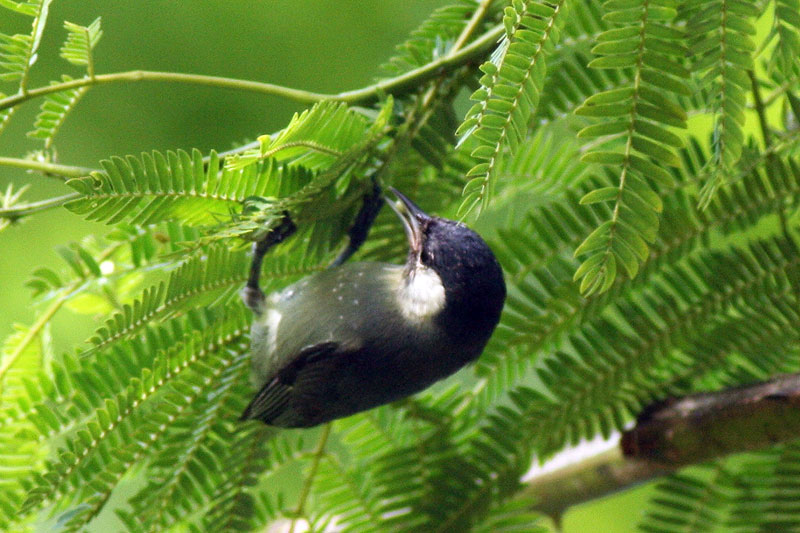
Wikipedia: White-eared conebill
![]() The white-eared conebill (Conirostrum leucogenys) is a species of bird in the family Thraupidae.
[more]
The white-eared conebill (Conirostrum leucogenys) is a species of bird in the family Thraupidae.
[more]
Gattung Acanthidops:
Acanthidops bairdi / Peg-billed finch (Acanthidops bairdi)
Profil Wikipedia Xeno-Canto

Wikipedia: Peg-billed finch
![]() The peg-billed finch, Acanthidops bairdi, is a passerine bird endemic to the highlands of Costa Rica and western Panama. Despite its name, it is not a true finch, but now recognized as a member of the tanager family (Thraupidae), after being long placed in the Emberizidae. It is the only member of the genus Acanthidops. The scientific name commemorates the American ornithologist Spencer Fullerton Baird.
[more]
The peg-billed finch, Acanthidops bairdi, is a passerine bird endemic to the highlands of Costa Rica and western Panama. Despite its name, it is not a true finch, but now recognized as a member of the tanager family (Thraupidae), after being long placed in the Emberizidae. It is the only member of the genus Acanthidops. The scientific name commemorates the American ornithologist Spencer Fullerton Baird.
[more]
Gattung Emberizoides:
Emberizoides herbicola / Wedge-tailed grass-finch (Emberizoides herbicola)
Profil Wikipedia Xeno-Canto

Wikipedia: Wedge-tailed grass-finch
![]() The wedge-tailed grass finch (Emberizoides herbicola) is a species of bird in the family Thraupidae; it was formerly placed in the Emberizidae. It is found in Argentina, Bolivia, Brazil, Colombia, Costa Rica, Ecuador, French Guiana, Guyana, Panama, Paraguay, Peru, Suriname, Uruguay, and Venezuela.
[more]
The wedge-tailed grass finch (Emberizoides herbicola) is a species of bird in the family Thraupidae; it was formerly placed in the Emberizidae. It is found in Argentina, Bolivia, Brazil, Colombia, Costa Rica, Ecuador, French Guiana, Guyana, Panama, Paraguay, Peru, Suriname, Uruguay, and Venezuela.
[more]
Gattung Amaurospiza:
Amaurospiza concolor / Blue seedeater (Amaurospiza concolor)
Profil Wikipedia Xeno-Canto

Wikipedia: Blue seedeater
![]() The Cabanis's seedeater (Amaurospiza concolor) is a species of bird in the cardinal family Cardinalidae.[2] It is found in highland forest and woodland, mainly near bamboo, in southern Mexico and Central America. Due to its association with bamboo, it is often local and erratic in occurrence, but overall it is not considered threatened and therefore listed as Least Concern by BirdLife International and IUCN.[1]
[more]
The Cabanis's seedeater (Amaurospiza concolor) is a species of bird in the cardinal family Cardinalidae.[2] It is found in highland forest and woodland, mainly near bamboo, in southern Mexico and Central America. Due to its association with bamboo, it is often local and erratic in occurrence, but overall it is not considered threatened and therefore listed as Least Concern by BirdLife International and IUCN.[1]
[more]
Unterfamilie Thraupinae:
Gattung Saltator:
Profil Wikipedia Xeno-Canto

Wikipedia: Grayish saltator
![]() The greyish saltator (Saltator coerulescens) is a passerine bird in the tanager family Thraupidae that is widespread in the tropical Americas. In El Salvador, it is well known as dichosofui after the "elaborate" version of its call, which sounds like a drawn-out ¡dichoso fui!, Spanish for "I was happy!"
[more]
The greyish saltator (Saltator coerulescens) is a passerine bird in the tanager family Thraupidae that is widespread in the tropical Americas. In El Salvador, it is well known as dichosofui after the "elaborate" version of its call, which sounds like a drawn-out ¡dichoso fui!, Spanish for "I was happy!"
[more]
Profil Wikipedia Xeno-Canto

Wikipedia: Black-headed saltator
![]() The black-headed saltator (Saltator atriceps) is a seed-eating bird in the tanager family Thraupidae. It breeds from central Mexico to eastern Panama.
[more]
The black-headed saltator (Saltator atriceps) is a seed-eating bird in the tanager family Thraupidae. It breeds from central Mexico to eastern Panama.
[more]
Profil Wikipedia Xeno-Canto

Wikipedia: Slate-colored grosbeak
![]() The slate-coloured grosbeak (Saltator grossus) is a species of grosbeak in the family Thraupidae. Most of its range is the Amazon in South America, but it is also found in forests of the Chocó in Ecuador and Colombia, and southern Central America from Panama to Honduras.
[more]
The slate-coloured grosbeak (Saltator grossus) is a species of grosbeak in the family Thraupidae. Most of its range is the Amazon in South America, but it is also found in forests of the Chocó in Ecuador and Colombia, and southern Central America from Panama to Honduras.
[more]
Profil Wikipedia Xeno-Canto

Wikipedia: Buff-throated saltator
![]() The buff-throated saltator (Saltator maximus) is a seed-eating bird in the tanager family Thraupidae. It breeds from southeastern Mexico to western Ecuador and northeastern Brazil.
[more]
The buff-throated saltator (Saltator maximus) is a seed-eating bird in the tanager family Thraupidae. It breeds from southeastern Mexico to western Ecuador and northeastern Brazil.
[more]
Profil Wikipedia Xeno-Canto

Wikipedia: Streaked saltator
![]() The streaked saltator (Saltator striatipectus) is a species of saltator in the family Thraupidae. It is found in Colombia, Costa Rica, Ecuador, Guadeloupe, Panama, Peru, and Venezuela.
[more]
The streaked saltator (Saltator striatipectus) is a species of saltator in the family Thraupidae. It is found in Colombia, Costa Rica, Ecuador, Guadeloupe, Panama, Peru, and Venezuela.
[more]
Gattung Tangara:
Arenal blue gray tanager. 2018-02-27 13.05.16 null
We saw this on the grounds of Gamboa Rainforest Resort.
Allgemein: ![]() Die Blautangare (Tangara episcopus, Syn.: Thraupis episcopus), auch Bischofstangare oder Blaugraue Tangare genannt, ist eine Vogelart der Gattung der Schillertangaren (Tangara) aus der Familie der Tangaren (Thraupidae). Ihr natürliches Verbreitungsgebiet reicht von Mexiko bis nach Peru und dem Nordwesten Brasiliens. Die Art kommt außerdem auf Tobago und Trinidad vor.
[more]
Die Blautangare (Tangara episcopus, Syn.: Thraupis episcopus), auch Bischofstangare oder Blaugraue Tangare genannt, ist eine Vogelart der Gattung der Schillertangaren (Tangara) aus der Familie der Tangaren (Thraupidae). Ihr natürliches Verbreitungsgebiet reicht von Mexiko bis nach Peru und dem Nordwesten Brasiliens. Die Art kommt außerdem auf Tobago und Trinidad vor.
[more]
Zoom one golden-hooded tanager on telephone wire. 2020-02-18 10.52.28
We saw this on a nature tour on the grounds of Gamboa Rainforest Resort. I noted it as a honeycreeper, which it is not - not sure if my mistake or the guide's.
Allgemein: ![]() Die Goldscheiteltangare (Stilpnia larvata, Syn.: Tangara larvata) früher auch Purpurmaskentangare ist eine in Mittel- und Südamerika vorkommende Vogelart aus der Familie der Tangaren (Thraupidae).
[more]
Die Goldscheiteltangare (Stilpnia larvata, Syn.: Tangara larvata) früher auch Purpurmaskentangare ist eine in Mittel- und Südamerika vorkommende Vogelart aus der Familie der Tangaren (Thraupidae).
[more]
Profil Wikipedia Xeno-Canto

Wikipedia: Bay-headed tanager
![]() The bay-headed tanager (Tangara gyrola) is a medium-sized passerine bird. This tanager is a resident breeder in Costa Rica, Panama, South America south to Ecuador, Bolivia and southern Brazil, and on Trinidad.
[more]
The bay-headed tanager (Tangara gyrola) is a medium-sized passerine bird. This tanager is a resident breeder in Costa Rica, Panama, South America south to Ecuador, Bolivia and southern Brazil, and on Trinidad.
[more]
Profil Wikipedia Xeno-Canto

Wikipedia: Plain-colored tanager
![]() The plain-colored tanager (Tangara inornata) is a species of bird in the family Thraupidae. It is found in Colombia, Costa Rica, and Panama. Its natural habitats are subtropical or tropical moist lowland forests and heavily degraded former forest.
[more]
The plain-colored tanager (Tangara inornata) is a species of bird in the family Thraupidae. It is found in Colombia, Costa Rica, and Panama. Its natural habitats are subtropical or tropical moist lowland forests and heavily degraded former forest.
[more]
Profil Wikipedia Xeno-Canto

Wikipedia: Rufous-winged tanager
![]() The rufous-winged tanager (Tangara lavinia) is a species of bird in the family Thraupidae. It is found in Colombia, Costa Rica, Ecuador, Honduras, Nicaragua, and Panama. Its natural habitats are subtropical or tropical moist lowland forests and heavily degraded former forest.
[more]
The rufous-winged tanager (Tangara lavinia) is a species of bird in the family Thraupidae. It is found in Colombia, Costa Rica, Ecuador, Honduras, Nicaragua, and Panama. Its natural habitats are subtropical or tropical moist lowland forests and heavily degraded former forest.
[more]
Profil Wikipedia Xeno-Canto

Wikipedia: Emerald tanager
![]() The emerald tanager (Tangara florida) is a species of bird in the family Thraupidae.
It is found in Colombia, Costa Rica, Ecuador, and Panama.
Its natural habitats are subtropical or tropical moist lowland forests and subtropical or tropical moist montane forests.
[more]
The emerald tanager (Tangara florida) is a species of bird in the family Thraupidae.
It is found in Colombia, Costa Rica, Ecuador, and Panama.
Its natural habitats are subtropical or tropical moist lowland forests and subtropical or tropical moist montane forests.
[more]

Wikipedia: Silver-throated tanager
![]() The silver-throated tanager (Tangara icterocephala) is a small passerine bird. This brightly coloured tanager is a resident from Costa Rica, through Panama and western Colombia, to western Ecuador.
[more]
The silver-throated tanager (Tangara icterocephala) is a small passerine bird. This brightly coloured tanager is a resident from Costa Rica, through Panama and western Colombia, to western Ecuador.
[more]
Profil Wikipedia Xeno-Canto

Wikipedia: Spangle-cheeked tanager
![]() The spangle-cheeked tanager (Tangara dowii) is a medium-sized passerine bird. This tanager is an endemic resident breeder in the highlands of Costa Rica and western Panama.
[more]
The spangle-cheeked tanager (Tangara dowii) is a medium-sized passerine bird. This tanager is an endemic resident breeder in the highlands of Costa Rica and western Panama.
[more]
Profil Wikipedia Xeno-Canto

Wikipedia: Green-naped tanager
![]() The green-naped tanager (Tangara fucosa) is a species of bird in the family Thraupidae. It is found in Colombia and Panama. Its natural habitat is subtropical or tropical moist montane forests. It is threatened by habitat loss.
[more]
The green-naped tanager (Tangara fucosa) is a species of bird in the family Thraupidae. It is found in Colombia and Panama. Its natural habitat is subtropical or tropical moist montane forests. It is threatened by habitat loss.
[more]
Gattung Thraupis:
Wikipedia: Yellow-winged tanager
![]() The yellow-winged tanager (Thraupis abbas) is a neotropical member of the tanager family. It is of average size for a tanager, about 18 centimetres (7 inches long). It is distinguished by the yellow patches on its dusky green wings, marking an otherwise dark bluish and gray body. It has a pale lavender tone on its throat and breast. The juvenile lacks this color, but has an olive-green head and upper back.
[more]
The yellow-winged tanager (Thraupis abbas) is a neotropical member of the tanager family. It is of average size for a tanager, about 18 centimetres (7 inches long). It is distinguished by the yellow patches on its dusky green wings, marking an otherwise dark bluish and gray body. It has a pale lavender tone on its throat and breast. The juvenile lacks this color, but has an olive-green head and upper back.
[more]
Arenal feeder palm tanager. 2018-02-27 12.23.14 null
![]() The palm tanager (Thraupis palmarum) is a medium-sized passerine bird. This tanager is a resident breeder from Nicaragua south to Bolivia, Paraguay and southern Brazil.[2][3] It also breeds on Trinidad and, since 1962, on Tobago. In Trinidad and Tobago, it is known by colloquial names such as the "palmiste" and the "green jean".[4]
[more]
The palm tanager (Thraupis palmarum) is a medium-sized passerine bird. This tanager is a resident breeder from Nicaragua south to Bolivia, Paraguay and southern Brazil.[2][3] It also breeds on Trinidad and, since 1962, on Tobago. In Trinidad and Tobago, it is known by colloquial names such as the "palmiste" and the "green jean".[4]
[more]
Gattung Bangsia:

Wikipedia: Blue-and-gold tanager
![]() The blue-and-gold tanager (Bangsia arcaei) is a species of bird in the family Thraupidae.
It is found in Costa Rica and Panama.
Its natural habitats are subtropical or tropical moist lowland forests and subtropical or tropical moist montane forests.
It is threatened by habitat loss.
[more]
The blue-and-gold tanager (Bangsia arcaei) is a species of bird in the family Thraupidae.
It is found in Costa Rica and Panama.
Its natural habitats are subtropical or tropical moist lowland forests and subtropical or tropical moist montane forests.
It is threatened by habitat loss.
[more]
Familie Passerellidae:
Gattung Junco (Juncos):
Vulkanammer / Volcano junco (Junco vulcani)
Profil Wikipedia Xeno-Canto

Wikipedia: Volcano junco
![]() The volcano junco (Junco vulcani) is an New World sparrow endemic to the Talamancan montane forests of Costa Rica and western Panama.
[more]
The volcano junco (Junco vulcani) is an New World sparrow endemic to the Talamancan montane forests of Costa Rica and western Panama.
[more]
Gattung Zonotrichia:
Zonotrichia capensis / Rufous-collared sparrow (Zonotrichia capensis)
La fortuna rufous collared sparrow. 2018-02-26 10.16.56 null
![]() The rufous-collared sparrow or Andean sparrow (Zonotrichia capensis) is an American sparrow found in a wide range of habitats, often near humans, from the extreme south-east of Mexico to Tierra del Fuego, and in the Caribbean, only on the island of Hispaniola (in both the Dominican Republic and Haiti). It is famous for its diverse vocalizations, which have been intensely studied since the 1970s, particularly by Paul Handford and Stephen C. Lougheed (UWO), Fernando Nottebohm (Rockefeller University) and Pablo Luis Tubaro (UBA). Local names for this bird include the Portuguese tico-tico, the Spanish chingolo, chincol and copetón, "tufted" in Colombia and comemaíz "corn eater" in Costa Rica.
[more]
The rufous-collared sparrow or Andean sparrow (Zonotrichia capensis) is an American sparrow found in a wide range of habitats, often near humans, from the extreme south-east of Mexico to Tierra del Fuego, and in the Caribbean, only on the island of Hispaniola (in both the Dominican Republic and Haiti). It is famous for its diverse vocalizations, which have been intensely studied since the 1970s, particularly by Paul Handford and Stephen C. Lougheed (UWO), Fernando Nottebohm (Rockefeller University) and Pablo Luis Tubaro (UBA). Local names for this bird include the Portuguese tico-tico, the Spanish chingolo, chincol and copetón, "tufted" in Colombia and comemaíz "corn eater" in Costa Rica.
[more]
Gattung Melospiza:
Lincoln-Ammer / Lincoln's sparrow (Melospiza lincolnii)
Profil Wikipedia Audubon Xeno-Canto

Wikipedia: Lincoln's sparrow
![]() Lincoln's sparrow (Melospiza lincolnii) is a small sparrow native to North America. It is a less common passerine bird that often stays hidden under thick ground cover, but can be distinguished by its sweet, wrenlike song. Lincoln's sparrow is one of three species in the genus Melospiza which also includes the song sparrow (M. melodia) and the swamp sparrow (M. georgiana). It lives in well-covered brushy habitats, often near water. This bird is poorly documented because of its secretive nature and breeding habits solely in boreal regions.[2]
[more]
Lincoln's sparrow (Melospiza lincolnii) is a small sparrow native to North America. It is a less common passerine bird that often stays hidden under thick ground cover, but can be distinguished by its sweet, wrenlike song. Lincoln's sparrow is one of three species in the genus Melospiza which also includes the song sparrow (M. melodia) and the swamp sparrow (M. georgiana). It lives in well-covered brushy habitats, often near water. This bird is poorly documented because of its secretive nature and breeding habits solely in boreal regions.[2]
[more]
Gattung Chlorospingus:
Chlorospingus pileatus / Sooty-capped chlorospingus (Chlorospingus pileatus)
Profil Wikipedia Xeno-Canto

Wikipedia: Sooty-capped chlorospingus
![]() The sooty-capped bush tanager or sooty-capped chlorospingus (Chlorospingus pileatus) is a small passerine bird traditionally placed in the family Thraupidae, but now viewed closer to Arremonops in the Passerellidae. This bird is an endemic resident breeder in the highlands of Costa Rica and western Panama.
[more]
The sooty-capped bush tanager or sooty-capped chlorospingus (Chlorospingus pileatus) is a small passerine bird traditionally placed in the family Thraupidae, but now viewed closer to Arremonops in the Passerellidae. This bird is an endemic resident breeder in the highlands of Costa Rica and western Panama.
[more]
Chlorospingus canigularis / Ashy-throated chlorospingus (Chlorospingus canigularis)
Profil Wikipedia Xeno-Canto

Wikipedia: Ashy-throated chlorospingus
![]() The ashy-throated bush tanager (Chlorospingus canigularis) is a species of bird traditionally placed in the family Thraupidae, but perhaps closer to Arremonops in the Passerellidae.
It is found in Colombia, Costa Rica, Ecuador, Panama, Peru, and Venezuela.
Its natural habitats are subtropical or tropical dry forests, subtropical or tropical moist lowland forests, and subtropical or tropical moist montane forests.
[more]
The ashy-throated bush tanager (Chlorospingus canigularis) is a species of bird traditionally placed in the family Thraupidae, but perhaps closer to Arremonops in the Passerellidae.
It is found in Colombia, Costa Rica, Ecuador, Panama, Peru, and Venezuela.
Its natural habitats are subtropical or tropical dry forests, subtropical or tropical moist lowland forests, and subtropical or tropical moist montane forests.
[more]
Chlorospingus flavopectus / Common chlorospingus (Chlorospingus flavopectus)
Profil Wikipedia Xeno-Canto

Wikipedia: Common chlorospingus
![]() The common bush tanager (Chlorospingus flavopectus), also referred to as common chlorospingus, is a small passerine bird. It is a resident breeder in the highlands from central Mexico south to Bolivia and northwest Argentina. C. flavopectus in the loose sense is a notorious cryptic species complex, and several of the up to 25 subspecies recognized in recent times are likely to be distinct species. Some populations in fact appear to be more distinct than several other members of Chlorospingus.[2]
[more]
The common bush tanager (Chlorospingus flavopectus), also referred to as common chlorospingus, is a small passerine bird. It is a resident breeder in the highlands from central Mexico south to Bolivia and northwest Argentina. C. flavopectus in the loose sense is a notorious cryptic species complex, and several of the up to 25 subspecies recognized in recent times are likely to be distinct species. Some populations in fact appear to be more distinct than several other members of Chlorospingus.[2]
[more]
Chlorospingus tacarcunae / Tacarcuna chlorospingus (Chlorospingus tacarcunae)
Profil Wikipedia Xeno-Canto

Wikipedia: Tacarcuna chlorospingus
![]() The Tacarcuna bush tanager (Chlorospingus tacarcunae) is a species of bird traditionally placed in the family Thraupidae, but now viewed closer to Arremonops in the Passerellidae.
[more]
The Tacarcuna bush tanager (Chlorospingus tacarcunae) is a species of bird traditionally placed in the family Thraupidae, but now viewed closer to Arremonops in the Passerellidae.
[more]
Chlorospingus flavigularis / Yellow-throated chlorospingus (Chlorospingus flavigularis)
Profil Wikipedia Xeno-Canto

Wikipedia: Yellow-throated chlorospingus
![]() The yellow-throated bush tanager (Chlorospingus flavigularis) is a species of bird traditionally placed in the family Thraupidae, but now closer to Arremonops in the Passerellidae. It is found in Bolivia, Colombia, Ecuador, Panama, and Peru.
[more]
The yellow-throated bush tanager (Chlorospingus flavigularis) is a species of bird traditionally placed in the family Thraupidae, but now closer to Arremonops in the Passerellidae. It is found in Bolivia, Colombia, Ecuador, Panama, and Peru.
[more]
Gattung Atlapetes:
Atlapetes tibialis / Yellow-thighed brushfinch (Atlapetes tibialis)
Profil Wikipedia Xeno-Canto

Wikipedia: Yellow-thighed brushfinch
![]() The yellow-thighed brushfinch (Atlapetes tibialis) is a passerine bird which is endemic to the highlands of Costa Rica and western Panama. Despite its name, it is not a true finch, but rather a member of the family Passerellidae, which also includes American sparrows, juncos and towhees.
[more]
The yellow-thighed brushfinch (Atlapetes tibialis) is a passerine bird which is endemic to the highlands of Costa Rica and western Panama. Despite its name, it is not a true finch, but rather a member of the family Passerellidae, which also includes American sparrows, juncos and towhees.
[more]
Atlapetes albinucha / White-naped brush-finch (Atlapetes albinucha)

Wikipedia: White-naped brush-finch
![]() The white-naped brushfinch (Atlapetes albinucha), also known as the yellow-throated brush finch, is a species of bird in the family Passerellidae.
[more]
The white-naped brushfinch (Atlapetes albinucha), also known as the yellow-throated brush finch, is a species of bird in the family Passerellidae.
[more]
Gattung Ammodramus:
Heuschreckenammer / Grasshopper sparrow (Ammodramus savannarum)
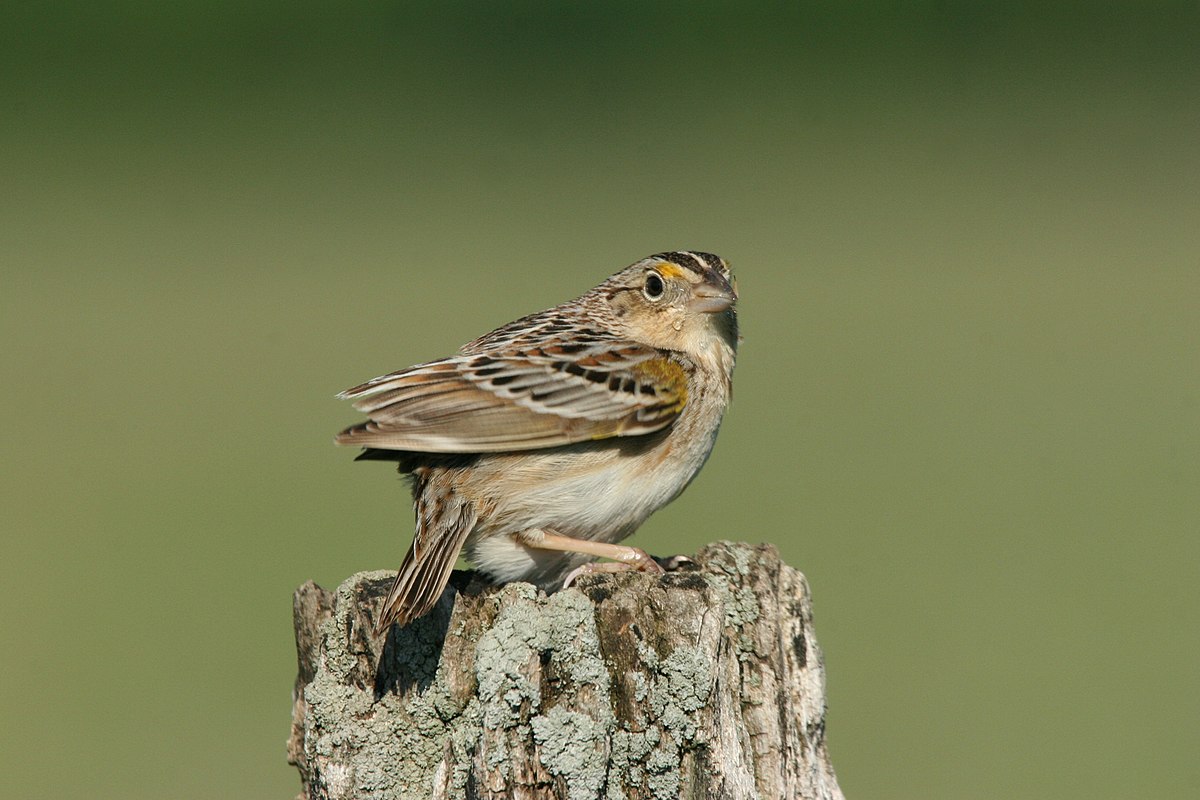
Wikipedia: Grasshopper sparrow
![]() The grasshopper sparrow (Ammodramus savannarum) is a small New World sparrow. The genus Ammodramus contains nine species that inhabit grasslands and prairies.
[more]
The grasshopper sparrow (Ammodramus savannarum) is a small New World sparrow. The genus Ammodramus contains nine species that inhabit grasslands and prairies.
[more]
Gattung Arremonops:
Arremonops rufivirgatus / Olive sparrow (Arremonops rufivirgatus)
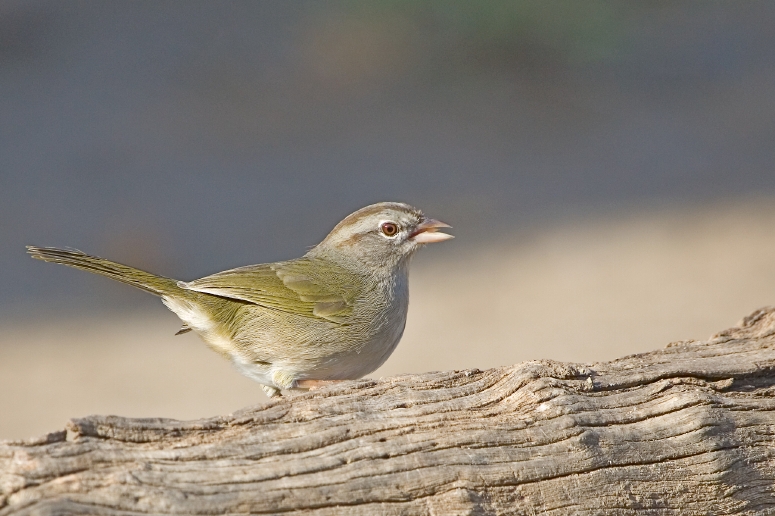
Wikipedia: Olive sparrow
![]() The olive sparrow (Arremonops rufivirgatus) is a species of American sparrow in the family Passerellidae. (Other names include green finch and Texas sparrow.) Its range includes Belize, Costa Rica, Guatemala, Honduras, Mexico, Nicaragua and southern Texas (including the counties of Val Verde, Atascosa, and Nueces).
[more]
The olive sparrow (Arremonops rufivirgatus) is a species of American sparrow in the family Passerellidae. (Other names include green finch and Texas sparrow.) Its range includes Belize, Costa Rica, Guatemala, Honduras, Mexico, Nicaragua and southern Texas (including the counties of Val Verde, Atascosa, and Nueces).
[more]
Arremonops conirostris / Black-striped sparrow (Arremonops conirostris)

Wikipedia: Black-striped sparrow
![]() The black-striped sparrow (Arremonops conirostris) is a passerine bird found from eastern Honduras to western Ecuador, northern Brazil, and Venezuela.
[more]
The black-striped sparrow (Arremonops conirostris) is a passerine bird found from eastern Honduras to western Ecuador, northern Brazil, and Venezuela.
[more]
Gattung Melozone:
Melozone cabanisi / Cabanis's ground-sparrow (Melozone cabanisi)
Profil Wikipedia Xeno-Canto

Wikipedia: Cabanis's ground-sparrow
![]() Cabanis's ground sparrow or Costa Rican ground sparrow (Melozone cabanisi), is an American sparrow. It previously was considered a subspecies of the Prevost's ground sparrow.
[more]
Cabanis's ground sparrow or Costa Rican ground sparrow (Melozone cabanisi), is an American sparrow. It previously was considered a subspecies of the Prevost's ground sparrow.
[more]
Melozone leucotis / White-eared ground-sparrow (Melozone leucotis)
Profil Wikipedia Xeno-Canto

Wikipedia: White-eared ground-sparrow
![]() The white-eared ground sparrow (Melozone leucotis) is a large American sparrow which breeds in a small range of Central America at middle altitudes from southern Mexico and Guatemala to northern Costa Rica. The species range is on the Pacific side of Central America, and Belize (on the Gulf of Mexico) and Honduras are not in its normal range.
[more]
The white-eared ground sparrow (Melozone leucotis) is a large American sparrow which breeds in a small range of Central America at middle altitudes from southern Mexico and Guatemala to northern Costa Rica. The species range is on the Pacific side of Central America, and Belize (on the Gulf of Mexico) and Honduras are not in its normal range.
[more]
Gattung Chondestes:
Chondestes grammacus / Lark sparrow (Chondestes grammacus)
Profil Wikipedia Audubon Xeno-Canto

Wikipedia: Lark sparrow
![]() The lark sparrow (Chondestes grammacus) is a fairly large New World sparrow. It is the only member of the genus Chondestes.
[more]
The lark sparrow (Chondestes grammacus) is a fairly large New World sparrow. It is the only member of the genus Chondestes.
[more]
Gattung Aimophila:
Aimophila rufescens / Rusty sparrow (Aimophila rufescens)

Wikipedia: Rusty sparrow
![]() The rusty sparrow (Aimophila rufescens) is a species of bird in the family Passerellidae that is found in Belize, Costa Rica, El Salvador, Guatemala, Honduras, Mexico and Nicaragua. Its natural habitats are subtropical or tropical dry forest, subtropical or tropical moist montane forest, and subtropical or tropical high-altitude shrubland.
[more]
The rusty sparrow (Aimophila rufescens) is a species of bird in the family Passerellidae that is found in Belize, Costa Rica, El Salvador, Guatemala, Honduras, Mexico and Nicaragua. Its natural habitats are subtropical or tropical dry forest, subtropical or tropical moist montane forest, and subtropical or tropical high-altitude shrubland.
[more]
Gattung Arremon:
Arremon crassirostris / Sooty-faced finch (Arremon crassirostris)

Wikipedia: Sooty-faced finch
![]() The sooty-faced finch (Arremon crassirostris) is a species of bird in the family Emberizidae. Until recently, it was placed in the genus Lysurus.[2]
[more]
The sooty-faced finch (Arremon crassirostris) is a species of bird in the family Emberizidae. Until recently, it was placed in the genus Lysurus.[2]
[more]
Arremon aurantiirostris / Orange-billed sparrow (Arremon aurantiirostris)
Profil Wikipedia Xeno-Canto

Wikipedia: Orange-billed sparrow
![]() The orange-billed sparrow (Arremon aurantiirostris) is a species of bird in the family Passerellidae.
In Central America it is found in Belize, Costa Rica, Guatemala, Honduras, Mexico, Nicaragua and Panama. In northwestern South America the orange-billed sparrow is found in Colombia, Ecuador and northern Peru. The species are black and as the name suggests, have an orange bill.[2] Its natural habitat is subtropical or tropical moist lowland forest.
[more]
The orange-billed sparrow (Arremon aurantiirostris) is a species of bird in the family Passerellidae.
In Central America it is found in Belize, Costa Rica, Guatemala, Honduras, Mexico, Nicaragua and Panama. In northwestern South America the orange-billed sparrow is found in Colombia, Ecuador and northern Peru. The species are black and as the name suggests, have an orange bill.[2] Its natural habitat is subtropical or tropical moist lowland forest.
[more]
Arremon costaricensis / Costa Rican brushfinch (Arremon costaricensis)
Profil Wikipedia Xeno-Canto

Wikipedia: Costa Rican brushfinch
![]() The Costa Rican brushfinch or grey-striped brushfinch[2] (Arremon costaricensis) is a species of bird in the family Passerellidae. It is found in the undergrowth of humid forest, especially near the edges, at altitudes of 300 to 1,200 metres (980 to 3,940 ft) in Panama and Costa Rica.[3][4]
[more]
The Costa Rican brushfinch or grey-striped brushfinch[2] (Arremon costaricensis) is a species of bird in the family Passerellidae. It is found in the undergrowth of humid forest, especially near the edges, at altitudes of 300 to 1,200 metres (980 to 3,940 ft) in Panama and Costa Rica.[3][4]
[more]
Arremon brunneinucha / Chestnut-capped brush-finch (Arremon brunneinucha)

Wikipedia: Chestnut-capped brush-finch
![]() The chestnut-capped brushfinch (Arremon brunneinucha), is a Neotropical passerine bird in the New World sparrow Passerellidae
[more]
The chestnut-capped brushfinch (Arremon brunneinucha), is a Neotropical passerine bird in the New World sparrow Passerellidae
[more]
Arremon atricapillus / Black-headed brushfinch (Arremon atricapillus)
Profil Wikipedia Xeno-Canto

Wikipedia: Black-headed brushfinch
![]() The black-headed brushfinch (Arremon atricapillus) is a species of bird in the family Passerellidae. It is found in the undergrowth of humid forest, especially near edges, at altitudes of 300 to 1,200 metres (980 to 3,940 ft) in Colombia and Panama.[2][3]
[more]
The black-headed brushfinch (Arremon atricapillus) is a species of bird in the family Passerellidae. It is found in the undergrowth of humid forest, especially near edges, at altitudes of 300 to 1,200 metres (980 to 3,940 ft) in Colombia and Panama.[2][3]
[more]
Gattung Pezopetes:
Pezopetes capitalis / Large-footed finch (Pezopetes capitalis)
Profil Wikipedia Xeno-Canto

Wikipedia: Large-footed finch
![]() The large-footed finch (Pezopetes capitalis) is a passerine bird endemic to the highlands of Costa Rica and western Panama. Despite its name, it is not a true finch, but rather a member of the large family Passerellidae, which also includes American sparrows, juncos and towhees. It is the only member of the genus Pezopetes.
[more]
The large-footed finch (Pezopetes capitalis) is a passerine bird endemic to the highlands of Costa Rica and western Panama. Despite its name, it is not a true finch, but rather a member of the large family Passerellidae, which also includes American sparrows, juncos and towhees. It is the only member of the genus Pezopetes.
[more]
Ordnung Charadriiformes (Regenpfeiferartige / Shorebirds and others):
Familie Laridae (Reiher / Gulls):
Unterfamilie Larinae (Möwen):
Gattung Larus:

Wikipedia: European herring gull
Dieser Vogel erscheint jenseits grossen Meere in Kontinenten :
Europa, Nordamerika, Südamerika.
Deutschland: Brut-, Jahres-, Zugvogel, Wintergast
Vokalisierung: ![]() Quite vocal. A long and strong "ay-kay-kay-kay-kay" with fading strength commonly heard. A deep "ga-ga-ga" heard from anxious birds. [Link]
Quite vocal. A long and strong "ay-kay-kay-kay-kay" with fading strength commonly heard. A deep "ga-ga-ga" heard from anxious birds. [Link]
Rufe: ![]() All calls much deeper pitched than Common Gull. Difficult to distinguish from Lesser Black-backed Gull, but tone is less nasal. [Link]
All calls much deeper pitched than Common Gull. Difficult to distinguish from Lesser Black-backed Gull, but tone is less nasal. [Link]
Körperlich: Länge=55-64 cm,
Flügelspanne=123-148 cm,
Gewicht=750-1440 g
Profil Wikipedia Audubon Xeno-Canto

Wikipedia: Ring-billed gull
Allgemein: ![]() The ring-billed gull (Larus delawarensis) is a medium-sized gull. The genus name is from Latin Larus which appears to have referred to a gull or other large seabird. The specific delawarensis refers to the Delaware River.[2]
[more]
The ring-billed gull (Larus delawarensis) is a medium-sized gull. The genus name is from Latin Larus which appears to have referred to a gull or other large seabird. The specific delawarensis refers to the Delaware River.[2]
[more]
Gattung Gelochelidon:
Lachseeschwalbe / Gull-billed tern (Gelochelidon nilotica)
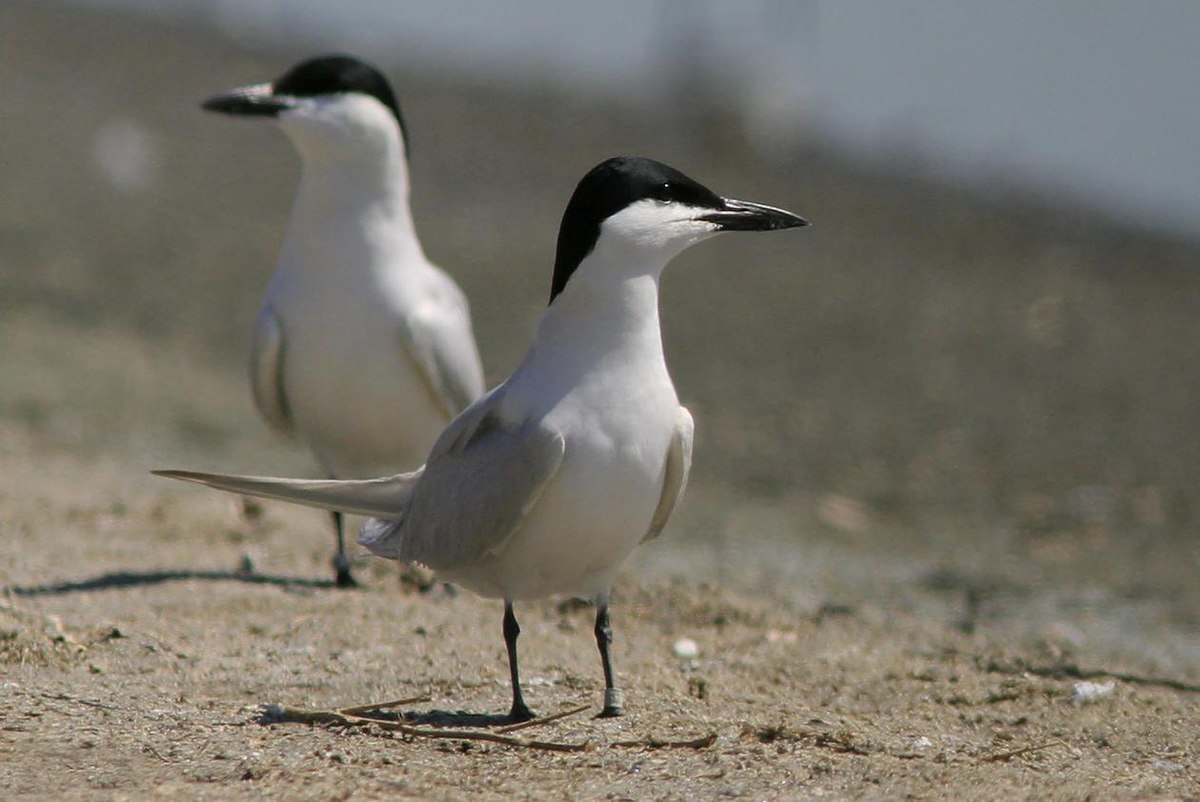
Wikipedia: Gull-billed tern
Dieser Vogel erscheint jenseits grossen Meere in Kontinenten :
Europa, Nordamerika, Südamerika, Afrika.
![]() The gull-billed tern (Gelochelidon nilotica), formerly Sterna nilotica,[2] is a tern in the family Laridae. The genus name is from Ancient Greek gelao, "to laugh", and khelidon, "swallow". The specific niloticus is from Latin and means of the Nile.[3] The Australian gull-billed tern was previously considered a subspecies.
[more]
The gull-billed tern (Gelochelidon nilotica), formerly Sterna nilotica,[2] is a tern in the family Laridae. The genus name is from Ancient Greek gelao, "to laugh", and khelidon, "swallow". The specific niloticus is from Latin and means of the Nile.[3] The Australian gull-billed tern was previously considered a subspecies.
[more]
Gattung Creagrus:
Gabelschwanzmöwe / Swallow-tailed gull (Creagrus furcatus)

Wikipedia: Swallow-tailed gull
![]() The swallow-tailed gull (Creagrus furcatus) is an equatorial seabird in the gull family, Laridae. It is the only species in the genus Creagrus, which derives from the Latin Creagra and the Greek kreourgos which means butcher, also from kreas, meat; according to Jobling it would mean "hook for meat" referring to the hooked bill of this species.[2] It was first described by French naturalist and surgeon Adolphe-Simon Neboux in 1846. Its scientific name is originally derived from the Greek word for gull, "Glaros" and via Latin Larus, "gull" and furca "two-tined fork".[3] It spends most of its life flying and hunting over the open ocean. The main breeding location is in the Galápagos Islands, particularly the rocky shores and cliffs of Hood, Tower and Wolf Islands, with lower numbers on most of the other islands. It is more common on the eastern islands where the water is warmer.[4]
[more]
The swallow-tailed gull (Creagrus furcatus) is an equatorial seabird in the gull family, Laridae. It is the only species in the genus Creagrus, which derives from the Latin Creagra and the Greek kreourgos which means butcher, also from kreas, meat; according to Jobling it would mean "hook for meat" referring to the hooked bill of this species.[2] It was first described by French naturalist and surgeon Adolphe-Simon Neboux in 1846. Its scientific name is originally derived from the Greek word for gull, "Glaros" and via Latin Larus, "gull" and furca "two-tined fork".[3] It spends most of its life flying and hunting over the open ocean. The main breeding location is in the Galápagos Islands, particularly the rocky shores and cliffs of Hood, Tower and Wolf Islands, with lower numbers on most of the other islands. It is more common on the eastern islands where the water is warmer.[4]
[more]
Gattung Xema:
Schwalbenmöwe / Sabine's gull (Xema sabini)

Wikipedia: Sabine's gull
Dieser Vogel erscheint jenseits grossen Meere in Kontinenten :
Europa, Nordamerika, Südamerika, Afrika.
![]() Sabine's gull (/ˈseɪbɪn/ SAY-bin; Xema sabini), also known as the fork-tailed gull or xeme, is a small gull. Its generic placement is disputed; some authors treat it as the sole species in the genus Xema as Xema sabini,[2] while others retain it in the genus Larus as Larus sabini.[3][4]
[more]
Sabine's gull (/ˈseɪbɪn/ SAY-bin; Xema sabini), also known as the fork-tailed gull or xeme, is a small gull. Its generic placement is disputed; some authors treat it as the sole species in the genus Xema as Xema sabini,[2] while others retain it in the genus Larus as Larus sabini.[3][4]
[more]
Gattung Rynchops:
Schwarzmantel-Scherenschnabel / Black skimmer (Rynchops niger)
Profil Wikipedia Xeno-Canto

Wikipedia: Black skimmer
Dieser Vogel erscheint jenseits grossen Meere in Kontinenten :
Südamerika, Afrika.
![]() The black skimmer (Rynchops niger) is a tern-like seabird, one of three very similar birds species in the skimmer genus Rynchops in the gull family Laridae. It breeds in North and South America. Northern populations winter in the warmer waters of the Caribbean and the tropical and subtropical Pacific coasts, but the South American races make only shorter movements in response to annual floods which extend their feeding areas in the river shallows.
[more]
The black skimmer (Rynchops niger) is a tern-like seabird, one of three very similar birds species in the skimmer genus Rynchops in the gull family Laridae. It breeds in North and South America. Northern populations winter in the warmer waters of the Caribbean and the tropical and subtropical Pacific coasts, but the South American races make only shorter movements in response to annual floods which extend their feeding areas in the river shallows.
[more]
Gattung Chlidonias:
Trauerseeschwalbe / Black tern (Chlidonias niger)
Profil Wikipedia Vogelwarte BirdLife ZH Audubon Xeno-Canto BirdID NABU

Wikipedia: Black tern
Dieser Vogel erscheint jenseits grossen Meere in Kontinenten :
Europa, Nordamerika, Südamerika, Afrika.
![]() The black tern (Chlidonias niger) is a small tern generally found in or near inland water in Europe, Western Asia and North America. As its name suggests, it has predominantly dark plumage. In some lights it can appear blue in the breeding season, hence the old English name "blue darr".[2] The genus name is from Ancient Greek khelidonios, "swallow-like", from khelidon, "swallow": another old English name for the black tern is "carr (i.e. lake) swallow".[3] The species name is from Latin niger "shining black".[4]
[more]
The black tern (Chlidonias niger) is a small tern generally found in or near inland water in Europe, Western Asia and North America. As its name suggests, it has predominantly dark plumage. In some lights it can appear blue in the breeding season, hence the old English name "blue darr".[2] The genus name is from Ancient Greek khelidonios, "swallow-like", from khelidon, "swallow": another old English name for the black tern is "carr (i.e. lake) swallow".[3] The species name is from Latin niger "shining black".[4]
[more]
Vokalisierung: ![]() Moderately vocal. [Link]
Moderately vocal. [Link]
Rufe: ![]() Flight call a more or less clear "kleck, or a disyllabic "klee-ake" with accented first syllable. Sometimes slightly rolling "klirr-eke", but never as much as in White-winged Tern. Also a slightly harsher "kreek", but not as raspy as in Whiskered Tern. [Link]
Flight call a more or less clear "kleck, or a disyllabic "klee-ake" with accented first syllable. Sometimes slightly rolling "klirr-eke", but never as much as in White-winged Tern. Also a slightly harsher "kreek", but not as raspy as in Whiskered Tern. [Link]
Körperlich: Länge=22-24 cm,
Flügelspanne=64-68 cm,
Gewicht=60-86 g
Gattung Anous:
Noddi / Brown noddy (Anous stolidus)

Wikipedia: Brown noddy
Dieser Vogel erscheint jenseits grossen Meere in Kontinenten :
Nordamerika, Südamerika, Afrika.
Allgemein: ![]() The brown noddy or common noddy (Anous stolidus) is a seabird in the family Laridae. The largest of the noddies, it can be told from the closely related black noddy by its larger size and plumage, which is dark brown rather than black. The brown noddy is a tropical seabird with a worldwide distribution, ranging from Hawaii to the Tuamotu Archipelago and Australia in the Pacific Ocean, from the Red Sea to the Seychelles and Australia in the Indian Ocean and in the Caribbean to Tristan da Cunha in the Atlantic Ocean. The brown noddy is colonial, usually nesting on elevated situations on cliffs or in short trees or shrubs. It only occasionally nests on the ground. A single egg is laid by the female of a pair each breeding season. In India the brown noddy is protected in the PM Sayeed Marine Birds Conservation Reserve.[2]
[more]
The brown noddy or common noddy (Anous stolidus) is a seabird in the family Laridae. The largest of the noddies, it can be told from the closely related black noddy by its larger size and plumage, which is dark brown rather than black. The brown noddy is a tropical seabird with a worldwide distribution, ranging from Hawaii to the Tuamotu Archipelago and Australia in the Pacific Ocean, from the Red Sea to the Seychelles and Australia in the Indian Ocean and in the Caribbean to Tristan da Cunha in the Atlantic Ocean. The brown noddy is colonial, usually nesting on elevated situations on cliffs or in short trees or shrubs. It only occasionally nests on the ground. A single egg is laid by the female of a pair each breeding season. In India the brown noddy is protected in the PM Sayeed Marine Birds Conservation Reserve.[2]
[more]
Weißkappennoddi / Black noddy (Anous minutus)
Profil Wikipedia Audubon Xeno-Canto

Wikipedia: Black noddy
Dieser Vogel erscheint jenseits grossen Meere in Kontinenten :
Nordamerika, Südamerika, Afrika.
![]() The black noddy or white-capped noddy (Anous minutus) is a seabird from the family Laridae. It is a medium-sized species of tern with black plumage and a white cap. It closely resembles the lesser noddy (Anous tenuirostris) with which it was at one time considered conspecific. The black noddy has slightly darker plumage and dark rather than pale lores.
[more]
The black noddy or white-capped noddy (Anous minutus) is a seabird from the family Laridae. It is a medium-sized species of tern with black plumage and a white cap. It closely resembles the lesser noddy (Anous tenuirostris) with which it was at one time considered conspecific. The black noddy has slightly darker plumage and dark rather than pale lores.
[more]
Gattung Gygis:
Feenseeschwalbe / White tern (Gygis alba )
Profil Wikipedia Xeno-Canto
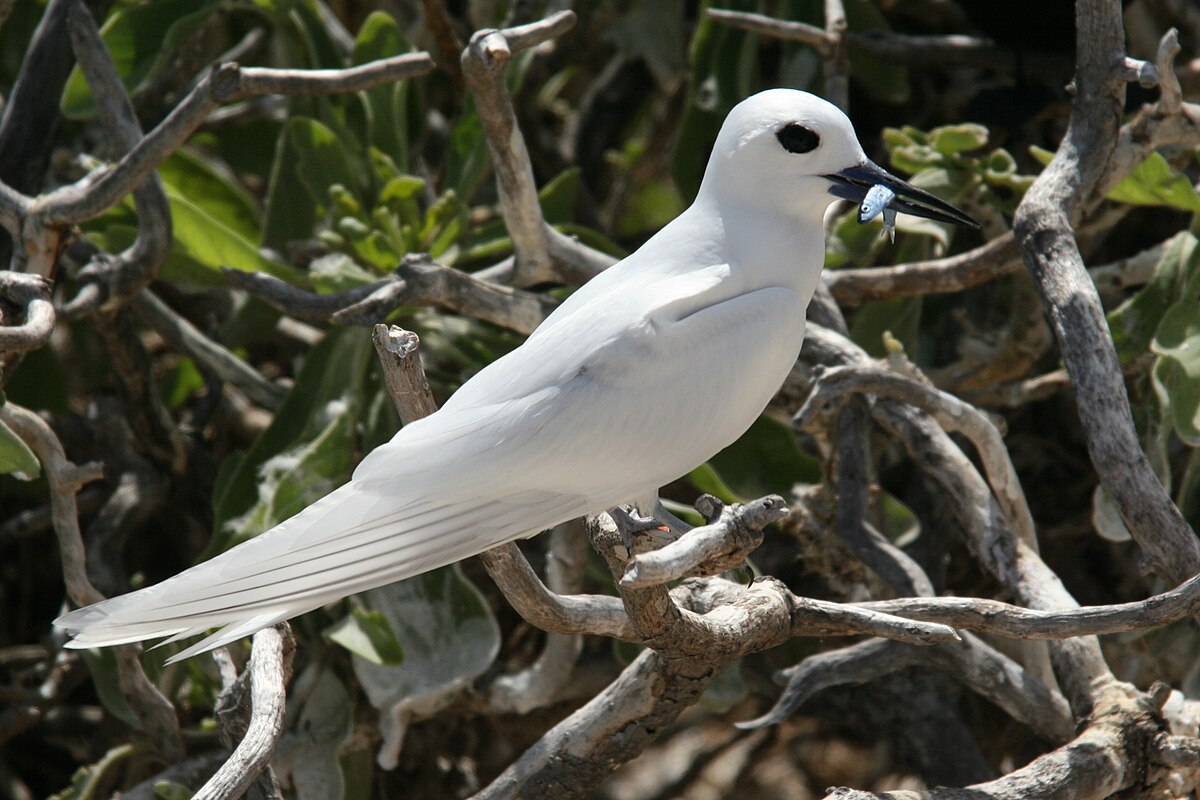
Wikipedia: White tern
![]() The white tern (Gygis alba) is a small seabird found across the tropical oceans of the world. It is sometimes known as the fairy tern although this name is potentially confusing as it is also the common name of Sternula nereis. Other names for the species include angel tern and white noddy in English, and manu-o-Kū in Hawaiian.
[more]
The white tern (Gygis alba) is a small seabird found across the tropical oceans of the world. It is sometimes known as the fairy tern although this name is potentially confusing as it is also the common name of Sternula nereis. Other names for the species include angel tern and white noddy in English, and manu-o-Kū in Hawaiian.
[more]
Gattung Leucophaeus:
Präriemöwe / Franklin's gull (Leucophaeus pipixcan)

Wikipedia: Franklin's gull
Dieser Vogel erscheint jenseits grossen Meere in Kontinenten :
Nordamerika, Südamerika, Afrika.
![]() Franklin's gull (Leucophaeus pipixcan) is a small (length 12.6–14.2 in, 32–36 cm) gull.[2] The genus name Leucophaeus is from Ancient Greek leukos, "white", and phaios, "dusky". The specific pipixcan is a Nahuatl name for a type of gull.[3][4]
[more]
Franklin's gull (Leucophaeus pipixcan) is a small (length 12.6–14.2 in, 32–36 cm) gull.[2] The genus name Leucophaeus is from Ancient Greek leukos, "white", and phaios, "dusky". The specific pipixcan is a Nahuatl name for a type of gull.[3][4]
[more]
Aztekenmöwe / Laughing gull (Leucophaeus atricilla)

Wikipedia: Laughing gull
![]() The laughing gull (Leucophaeus atricilla) is a medium-sized gull of North and South America. Named for its laugh-like call, it is an opportunistic omnivore and scavenger. It breeds in large colonies mostly along the Atlantic coast of North America, the Caribbean, and northern South America. The two subspecies are: L. a. megalopterus – which can be seen from southeast Canada down to Central America, and L. a. atricilla which appears from the West Indies to the Venezuelan islands. The laughing gull was long placed in the genus Larus until its present placement in Leucophaeus, which follows the American Ornithologists' Union.
[more]
The laughing gull (Leucophaeus atricilla) is a medium-sized gull of North and South America. Named for its laugh-like call, it is an opportunistic omnivore and scavenger. It breeds in large colonies mostly along the Atlantic coast of North America, the Caribbean, and northern South America. The two subspecies are: L. a. megalopterus – which can be seen from southeast Canada down to Central America, and L. a. atricilla which appears from the West Indies to the Venezuelan islands. The laughing gull was long placed in the genus Larus until its present placement in Leucophaeus, which follows the American Ornithologists' Union.
[more]
Gattung Hydroprogne:
Raubseeschwalbe / Caspian tern (Hydroprogne caspia)

Wikipedia: Caspian tern
Dieser Vogel erscheint jenseits grossen Meere in Kontinenten :
Europa, Nordamerika, Südamerika, Afrika.
![]() The Caspian tern (Hydroprogne caspia)[2] is a species of tern, with a subcosmopolitan but scattered distribution. Despite its extensive range, it is monotypic of its genus, and has no accepted subspecies.[3] The genus name is from Ancient Greek hudros, "water", and Latin progne, "swallow". The specific caspia is from Latin and, like the English name, refers to the Caspian Sea.[4]
[more]
The Caspian tern (Hydroprogne caspia)[2] is a species of tern, with a subcosmopolitan but scattered distribution. Despite its extensive range, it is monotypic of its genus, and has no accepted subspecies.[3] The genus name is from Ancient Greek hudros, "water", and Latin progne, "swallow". The specific caspia is from Latin and, like the English name, refers to the Caspian Sea.[4]
[more]
Rufe: ![]() Easily recognized by its very harsh calls. Sometimes likened to the sound of a plate of steel being dragged across a concrete floor. Similar in harshness to Grey Heron, but more drawn, with an accented middle; "Kraaeeet", or with a double syllable start "ka-ha-kraaaeet". Immature birds begs with a penetrating, sharp whistle. [Link]
Easily recognized by its very harsh calls. Sometimes likened to the sound of a plate of steel being dragged across a concrete floor. Similar in harshness to Grey Heron, but more drawn, with an accented middle; "Kraaeeet", or with a double syllable start "ka-ha-kraaaeet". Immature birds begs with a penetrating, sharp whistle. [Link]
Körperlich: Länge=47-54 cm,
Flügelspanne=130-145 cm,
Gewicht=500-750 g
Gattung Onychoprion:
Rußseeschwalbe / Sooty tern (Onychoprion fuscatus)

Wikipedia: Sooty tern
Dieser Vogel erscheint jenseits grossen Meere in Kontinenten :
Nordamerika, Südamerika, Afrika.
Allgemein: ![]() The sooty tern (Onychoprion fuscatus) is a seabird in the family Laridae. It is a bird of the tropical oceans which sleeps on the wing, returning to land only to breed on islands throughout the equatorial zone.
[more]
The sooty tern (Onychoprion fuscatus) is a seabird in the family Laridae. It is a bird of the tropical oceans which sleeps on the wing, returning to land only to breed on islands throughout the equatorial zone.
[more]
Zügelseeschwalbe / Bridled tern (Onychoprion anaethetus)
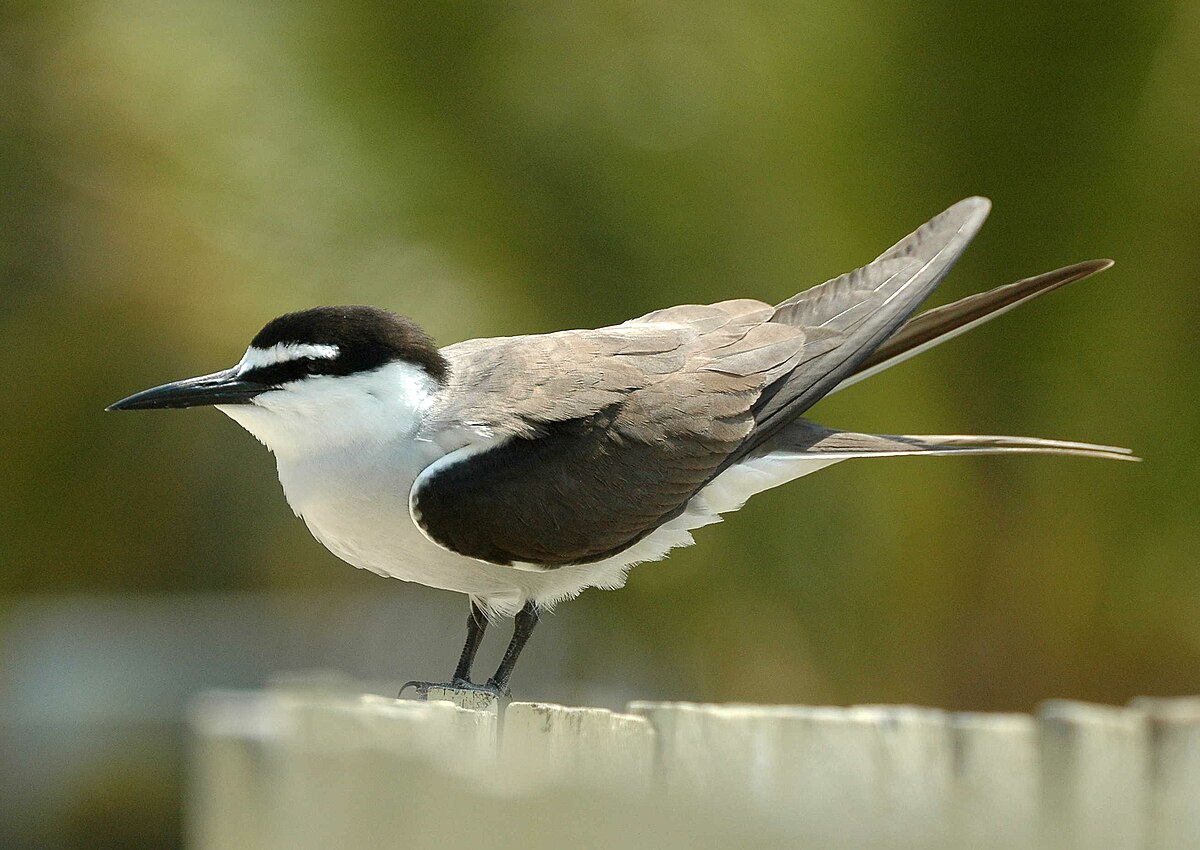
Wikipedia: Bridled tern
Dieser Vogel erscheint jenseits grossen Meere in Kontinenten :
Nordamerika, Südamerika, Afrika.
![]() The bridled tern (Onychoprion anaethetus)[2] is a seabird of the family Laridae. It is a bird of the tropical oceans. The scientific name is from Ancient Greek. The genus comes from onux meaning "claw" or "nail", and prion, meaning "saw". The specific anaethetus means "senseless, stupid".[3]
[more]
The bridled tern (Onychoprion anaethetus)[2] is a seabird of the family Laridae. It is a bird of the tropical oceans. The scientific name is from Ancient Greek. The genus comes from onux meaning "claw" or "nail", and prion, meaning "saw". The specific anaethetus means "senseless, stupid".[3]
[more]
Gattung Sternula:
Amerikanische Zwergseeschwalbe / Least tern (Sternula antillarum)

Wikipedia: Least tern
![]() The least tern (Sternula antillarum) is a species of tern that breeds in North America and locally in northern South America. It is closely related to, and was formerly often considered conspecific with, the little tern of the Old World. Other close relatives include the yellow-billed tern and Peruvian tern, both from South America.
[more]
The least tern (Sternula antillarum) is a species of tern that breeds in North America and locally in northern South America. It is closely related to, and was formerly often considered conspecific with, the little tern of the Old World. Other close relatives include the yellow-billed tern and Peruvian tern, both from South America.
[more]
Gattung Thalasseus:
Thalasseus elegans / Elegant tern (Thalasseus elegans)

Wikipedia: Elegant tern
Dieser Vogel erscheint jenseits grossen Meere in Kontinenten :
Südamerika, Afrika.
![]() The elegant tern (Thalasseus elegans) is a tern in the family Laridae. It breeds on the Pacific coasts of the southern United States and Mexico and winters south to Peru, Ecuador and Chile.
[more]
The elegant tern (Thalasseus elegans) is a tern in the family Laridae. It breeds on the Pacific coasts of the southern United States and Mexico and winters south to Peru, Ecuador and Chile.
[more]
Brandseeschwalbe / Sandwich tern (Thalasseus sandvicensis)
La tarde 5 sandwich terns tenative ID by Merlin. 2018-03-11 06.35.12 null
Dieser Vogel erscheint jenseits grossen Meere in Kontinenten :
Europa, Südamerika, Afrika.
![]() The Sandwich tern (Thalasseus sandvicensis)[2] is a tern in the family Laridae. It is very closely related to the lesser crested tern (T. bengalensis), Chinese crested tern (T. bernsteini), Cabot's tern (T. acuflavidus), and elegant tern (T. elegans) and has been known to interbreed with the lesser crested. It breeds in the Palearctic from Europe to the Caspian Sea wintering to South Africa, India and Sri Lanka.
[more]
The Sandwich tern (Thalasseus sandvicensis)[2] is a tern in the family Laridae. It is very closely related to the lesser crested tern (T. bengalensis), Chinese crested tern (T. bernsteini), Cabot's tern (T. acuflavidus), and elegant tern (T. elegans) and has been known to interbreed with the lesser crested. It breeds in the Palearctic from Europe to the Caspian Sea wintering to South Africa, India and Sri Lanka.
[more]
Rufe: ![]() Contact call a sharp and grating "keeree-eek". Often compared to the pressing of amalgam into a tooth. [Link]
Contact call a sharp and grating "keeree-eek". Often compared to the pressing of amalgam into a tooth. [Link]
Körperlich: Länge=36-41 cm,
Flügelspanne=95-105 cm,
Gewicht=215-275 g
Thalasseus maximus / Royal tern (Thalasseus maximus)

Wikipedia: Royal tern
Dieser Vogel erscheint jenseits grossen Meere in Kontinenten :
Europa, Nordamerika, Südamerika, Afrika.
Allgemein: ![]() The royal tern (Thalasseus maximus) is a tern in the family Laridae.
[more]
The royal tern (Thalasseus maximus) is a tern in the family Laridae.
[more]
Thalasseus maxima / Royal tern (Thalasseus maxima)
Profil Wikipedia Xeno-Canto

Wikipedia: Royal tern
![]() The royal tern (Thalasseus maximus) is a tern in the family Laridae.
[more]
The royal tern (Thalasseus maximus) is a tern in the family Laridae.
[more]
Familie Charadriidae (Regenpfeifer):
Gattung Vanellus:
Bronzekiebitz / Southern lapwing (Vanellus chilensis)
Profil Wikipedia Xeno-Canto

Wikipedia: Southern lapwing
![]() The southern lapwing (Vanellus chilensis) is a wader in the order Charadriiformes. It is a common and widespread resident throughout South America, except in densely forested regions (e.g. most of the Amazon), the higher parts of the Andes and the arid coast of a large part of western South America. This bird is particularly common in the basin of the Rio de la Plata. It has also been spreading through Central America in recent years. It reached Trinidad in 1961 and Tobago in 1974, and has rapidly increased on both islands, sporadically making its way North to Barbados where one pair mated, nested and produced chicks in 2007.
[more]
The southern lapwing (Vanellus chilensis) is a wader in the order Charadriiformes. It is a common and widespread resident throughout South America, except in densely forested regions (e.g. most of the Amazon), the higher parts of the Andes and the arid coast of a large part of western South America. This bird is particularly common in the basin of the Rio de la Plata. It has also been spreading through Central America in recent years. It reached Trinidad in 1961 and Tobago in 1974, and has rapidly increased on both islands, sporadically making its way North to Barbados where one pair mated, nested and produced chicks in 2007.
[more]
Gattung Charadrius:
Charadrius nivosus / Snowy plover (Charadrius nivosus)
Profil Wikipedia Audubon Xeno-Canto

Wikipedia: Snowy plover
![]() The snowy plover (Charadrius nivosus) is a small wader in the plover bird family, typically about 5-7" in length.[2] It breeds in Ecuador, Peru, Chile, the southern and western United States and the Caribbean. Long considered to be a subspecies of the Kentish plover, it is now known to be a distinct species.
[more]
The snowy plover (Charadrius nivosus) is a small wader in the plover bird family, typically about 5-7" in length.[2] It breeds in Ecuador, Peru, Chile, the southern and western United States and the Caribbean. Long considered to be a subspecies of the Kentish plover, it is now known to be a distinct species.
[more]
Amerika-Sandregenpfeifer / Semipalmated plover (Charadrius semipalmatus)
Profil Wikipedia Audubon Xeno-Canto

Wikipedia: Semipalmated plover
![]() The semipalmated plover (Charadrius semipalmatus) is a small plover. The genus name Charadrius is a Late Latin word for a yellowish bird mentioned in the fourth-century Vulgate. It derives from Ancient Greek kharadrios a bird found in ravines and river valleys (kharadra, "ravine"). The specific semipalmatus is Latin and comes from semi, "half" and palma, "palm". Like the English name, this refers to its only partly webbed feet.[2]
[more]
The semipalmated plover (Charadrius semipalmatus) is a small plover. The genus name Charadrius is a Late Latin word for a yellowish bird mentioned in the fourth-century Vulgate. It derives from Ancient Greek kharadrios a bird found in ravines and river valleys (kharadra, "ravine"). The specific semipalmatus is Latin and comes from semi, "half" and palma, "palm". Like the English name, this refers to its only partly webbed feet.[2]
[more]
Keilschwanz-Regenpfeifer / Killdeer (Charadrius vociferus)

Wikipedia: Killdeer
![]() The killdeer (Charadrius vociferus) is a large plover found in the Americas. It was described and given its current scientific name in 1758 by Carl Linnaeus in the 10th edition of his Systema Naturae. There are three subspecies. The killdeer's common name comes from its often-heard call. Its upperparts are mostly brown with rufous fringes, the head has patches of white and black, and there are two black breast bands. The belly and the rest of the breast are white. The nominate (or originally described) subspecies breeds from southeastern Alaska and southern Canada to Mexico. It is seen year-round in the southern half of its breeding range; the subspecies C. v. ternominatus is probably resident in the West Indies and C. v. peruvianus inhabits Peru and areas of the surrounding countries throughout the year. North American breeders winter from their resident range south to Central America, the West Indies, and the northernmost portions of South America.
[more]
The killdeer (Charadrius vociferus) is a large plover found in the Americas. It was described and given its current scientific name in 1758 by Carl Linnaeus in the 10th edition of his Systema Naturae. There are three subspecies. The killdeer's common name comes from its often-heard call. Its upperparts are mostly brown with rufous fringes, the head has patches of white and black, and there are two black breast bands. The belly and the rest of the breast are white. The nominate (or originally described) subspecies breeds from southeastern Alaska and southern Canada to Mexico. It is seen year-round in the southern half of its breeding range; the subspecies C. v. ternominatus is probably resident in the West Indies and C. v. peruvianus inhabits Peru and areas of the surrounding countries throughout the year. North American breeders winter from their resident range south to Central America, the West Indies, and the northernmost portions of South America.
[more]
Charadrius wilsonia / Wilson's plover (Charadrius wilsonia)
Profil Wikipedia Audubon Xeno-Canto

Wikipedia: Wilson's plover
![]() Wilson's plover (Charadrius wilsonia) is a small bird of the family Charadriidae.
[more]
Wilson's plover (Charadrius wilsonia) is a small bird of the family Charadriidae.
[more]
Charadrius collaris / Collared plover (Charadrius collaris)
Profil Wikipedia Xeno-Canto

Wikipedia: Collared plover
![]() The collared plover (Charadrius collaris) is a small shorebird in the plover family, Charadriidae. It lives along coasts and riverbanks of the tropical to temperate Americas, from central Mexico south to Chile and Argentina.
[more]
The collared plover (Charadrius collaris) is a small shorebird in the plover family, Charadriidae. It lives along coasts and riverbanks of the tropical to temperate Americas, from central Mexico south to Chile and Argentina.
[more]
Gattung Pluvialis:
Pluvialis dominica / American golden-plover (Pluvialis dominica)
Profil Wikipedia Audubon Xeno-Canto
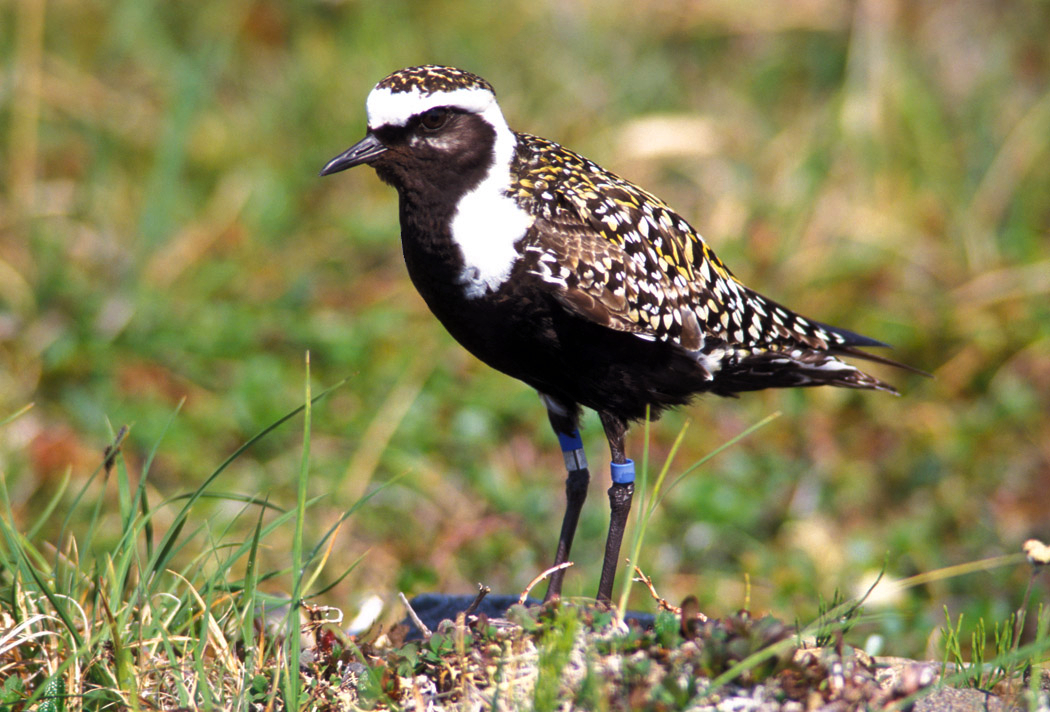
Wikipedia: American golden-plover
Dieser Vogel erscheint jenseits grossen Meere in Kontinenten :
Nordamerika, Südamerika, Afrika.
![]() The American golden plover (Pluvialis dominica), or American golden-plover is a medium-sized plover. The genus name is Latin and means relating to rain, from pluvia, "rain". It was believed that golden plovers flocked when rain was imminent. The species name dominica refers to Santo Domingo, now Hispaniola, in the West Indies.[2]
[more]
The American golden plover (Pluvialis dominica), or American golden-plover is a medium-sized plover. The genus name is Latin and means relating to rain, from pluvia, "rain". It was believed that golden plovers flocked when rain was imminent. The species name dominica refers to Santo Domingo, now Hispaniola, in the West Indies.[2]
[more]
Kiebitzregenpfeifer / Black-bellied plover (Pluvialis squatarola)
Black-bellied plover on its nest. 2016-09-25 16.50.10 null
Dieser Vogel erscheint jenseits grossen Meere in Kontinenten :
Europa, Nordamerika, Südamerika, Afrika.
![]() The grey plover or black-bellied plover (Pluvialis squatarola) is a medium-sized plover breeding in Arctic regions. It is a long-distance migrant, with a nearly worldwide coastal distribution when not breeding.[2] The genus name is Latin and means relating to rain, from pluvia, "rain". It was believed that golden plovers flocked when rain was imminent. The species name squatarola is a Latinised version of Sgatarola, a Venetian name for some kind of plover.[3]
[more]
The grey plover or black-bellied plover (Pluvialis squatarola) is a medium-sized plover breeding in Arctic regions. It is a long-distance migrant, with a nearly worldwide coastal distribution when not breeding.[2] The genus name is Latin and means relating to rain, from pluvia, "rain". It was believed that golden plovers flocked when rain was imminent. The species name squatarola is a Latinised version of Sgatarola, a Venetian name for some kind of plover.[3]
[more]
Rufe: ![]() Contact call diagnostic. A plaintive, drawn and trisyllabic (but continuous) "kleeooowee". Pitch falls on second syllable and rises on last. [Link]
Contact call diagnostic. A plaintive, drawn and trisyllabic (but continuous) "kleeooowee". Pitch falls on second syllable and rises on last. [Link]
Körperlich: Länge=27-30 cm,
Flügelspanne=71-83 cm,
Gewicht=190-280 g
Familie Scolopacidae (Schnepfenvögel / Shorebirds):
Gattung Calidris:
Weißbürzelstrandläufer / White-rumped sandpiper (Calidris fuscicollis)
Profil Wikipedia Audubon Xeno-Canto

Wikipedia: White-rumped sandpiper
Dieser Vogel erscheint jenseits grossen Meere in Kontinenten :
Nordamerika, Südamerika, Afrika.
Allgemein: ![]() The white-rumped sandpiper (Calidris fuscicollis) is a small shorebird that breeds in the northern tundra of Canada and Alaska. This bird can be difficult to distinguish from other similar tiny shorebirds; these are known collectively as "peeps" or "stints".
[more]
The white-rumped sandpiper (Calidris fuscicollis) is a small shorebird that breeds in the northern tundra of Canada and Alaska. This bird can be difficult to distinguish from other similar tiny shorebirds; these are known collectively as "peeps" or "stints".
[more]
Sichelstrandläufer / Curlew sandpiper (Calidris ferruginea)
Profil Wikipedia Vogelwarte BirdLife ZH Audubon Xeno-Canto BirdID NABU

Wikipedia: Curlew sandpiper
Dieser Vogel erscheint jenseits grossen Meere in Kontinenten :
Europa, Nordamerika, Südamerika, Afrika.
![]() The curlew sandpiper (Calidris ferruginea) is a small wader that breeds on the tundra of Arctic Siberia.[2] The genus name is from Ancient Greek kalidris or skalidris, a term used by Aristotle for some grey-coloured waterside birds. The specific ferruginea is from Latin ferrugo, ferruginis, "iron rust" referring to its colour in breeding plumage.[3]
[more]
The curlew sandpiper (Calidris ferruginea) is a small wader that breeds on the tundra of Arctic Siberia.[2] The genus name is from Ancient Greek kalidris or skalidris, a term used by Aristotle for some grey-coloured waterside birds. The specific ferruginea is from Latin ferrugo, ferruginis, "iron rust" referring to its colour in breeding plumage.[3]
[more]
Rufe: ![]() Flight call a soft, ringing and rolling "krrrrrt, with variations. Lacks the hoarse, nasal quality of similar call by Dunlin. [Link]
Flight call a soft, ringing and rolling "krrrrrt, with variations. Lacks the hoarse, nasal quality of similar call by Dunlin. [Link]
Körperlich: Länge=18-19 cm,
Flügelspanne=42-46 cm,
Gewicht=50-65 g
Knutt / Red knot (Calidris canutus)
Profil Wikipedia Vogelwarte BirdLife ZH Audubon Xeno-Canto BirdID NABU

Wikipedia: Red knot
Dieser Vogel erscheint jenseits grossen Meere in Kontinenten :
Europa, Nordamerika, Südamerika, Afrika.
Allgemein: ![]() The red knot (Calidris canutus) (just knot in English-speaking Europe) is a medium-sized shorebird which breeds in tundra and the Arctic Cordillera in the far north of Canada, Europe, and Russia. It is a large member of the Calidris sandpipers, second only to the great knot.[2] Six subspecies are recognised.
[more]
The red knot (Calidris canutus) (just knot in English-speaking Europe) is a medium-sized shorebird which breeds in tundra and the Arctic Cordillera in the far north of Canada, Europe, and Russia. It is a large member of the Calidris sandpipers, second only to the great knot.[2] Six subspecies are recognised.
[more]
Gesang: ![]() Song an undulating, nasal mewing "poooor-mee", or "po-hor-mee". [Link]
Song an undulating, nasal mewing "poooor-mee", or "po-hor-mee". [Link]
Rufe: ![]() Most commonly heard migratory call, a short "kut" or "knot". Sometimes given in stuttering series. [Link]
Most commonly heard migratory call, a short "kut" or "knot". Sometimes given in stuttering series. [Link]
Körperlich: Länge=23-25 cm,
Flügelspanne=57-61 cm,
Gewicht=110-160 g
Bairdstrandläufer / Baird's sandpiper (Calidris bairdii)
Profil Wikipedia Audubon Xeno-Canto

Wikipedia: Baird's sandpiper
Dieser Vogel erscheint jenseits grossen Meere in Kontinenten :
Nordamerika, Südamerika, Afrika.
Allgemein: ![]() Baird's sandpiper (Calidris bairdii) is a small shorebird. It is among those calidrids which were formerly included in the genus Erolia, which was subsumed into the genus Calidris in 1973.[2] The genus name is from Ancient Greek kalidris or skalidris, a term used by Aristotle for some grey-coloured waterside birds. The English name and specific bairdii commemorate Spencer Fullerton Baird, 19th-century naturalist and assistant secretary of the Smithsonian Institution.[3]
[more]
Baird's sandpiper (Calidris bairdii) is a small shorebird. It is among those calidrids which were formerly included in the genus Erolia, which was subsumed into the genus Calidris in 1973.[2] The genus name is from Ancient Greek kalidris or skalidris, a term used by Aristotle for some grey-coloured waterside birds. The English name and specific bairdii commemorate Spencer Fullerton Baird, 19th-century naturalist and assistant secretary of the Smithsonian Institution.[3]
[more]
Grasläufer / Buff-breasted sandpiper (Calidris subruficollis)

Wikipedia: Buff-breasted sandpiper
Dieser Vogel erscheint jenseits grossen Meere in Kontinenten :
Nordamerika, Südamerika, Afrika.
![]() The buff-breasted sandpiper (Calidris subruficollis) is a small shorebird. The species name subruficollis is from Latin subrufus, "reddish" (from sub, "somewhat", and rufus, "rufous") and collis, "-necked/-throated" (from collum, "neck").[2] It is a calidrid sandpiper.
[more]
The buff-breasted sandpiper (Calidris subruficollis) is a small shorebird. The species name subruficollis is from Latin subrufus, "reddish" (from sub, "somewhat", and rufus, "rufous") and collis, "-necked/-throated" (from collum, "neck").[2] It is a calidrid sandpiper.
[more]
Sanderling / Sanderling (Calidris alba)
Profil Wikipedia Vogelwarte BirdLife ZH Audubon Xeno-Canto BirdID NABU

Wikipedia: Sanderling
Dieser Vogel erscheint jenseits grossen Meere in Kontinenten :
Europa, Nordamerika, Südamerika, Afrika.
![]() The sanderling (Calidris alba) is a small wading bird. The name derives from Old English sand-yrðling, "sand-ploughman".[2] The genus name is from Ancient Greek kalidris or skalidris, a term used by Aristotle for some grey-coloured waterside birds. The specific alba is Latin for "white".[3]
[more]
The sanderling (Calidris alba) is a small wading bird. The name derives from Old English sand-yrðling, "sand-ploughman".[2] The genus name is from Ancient Greek kalidris or skalidris, a term used by Aristotle for some grey-coloured waterside birds. The specific alba is Latin for "white".[3]
[more]
Rufe: ![]() Call not very diagnostic; a short and soft "pleet" or "keek". [Link]
Call not very diagnostic; a short and soft "pleet" or "keek". [Link]
Körperlich: Länge=20-21 cm,
Flügelspanne=40-45 cm,
Gewicht=44-70 g
Alpenstrandläufer / Dunlin (Calidris alpina)
Profil Wikipedia Vogelwarte BirdLife ZH Audubon Xeno-Canto BirdID NABU
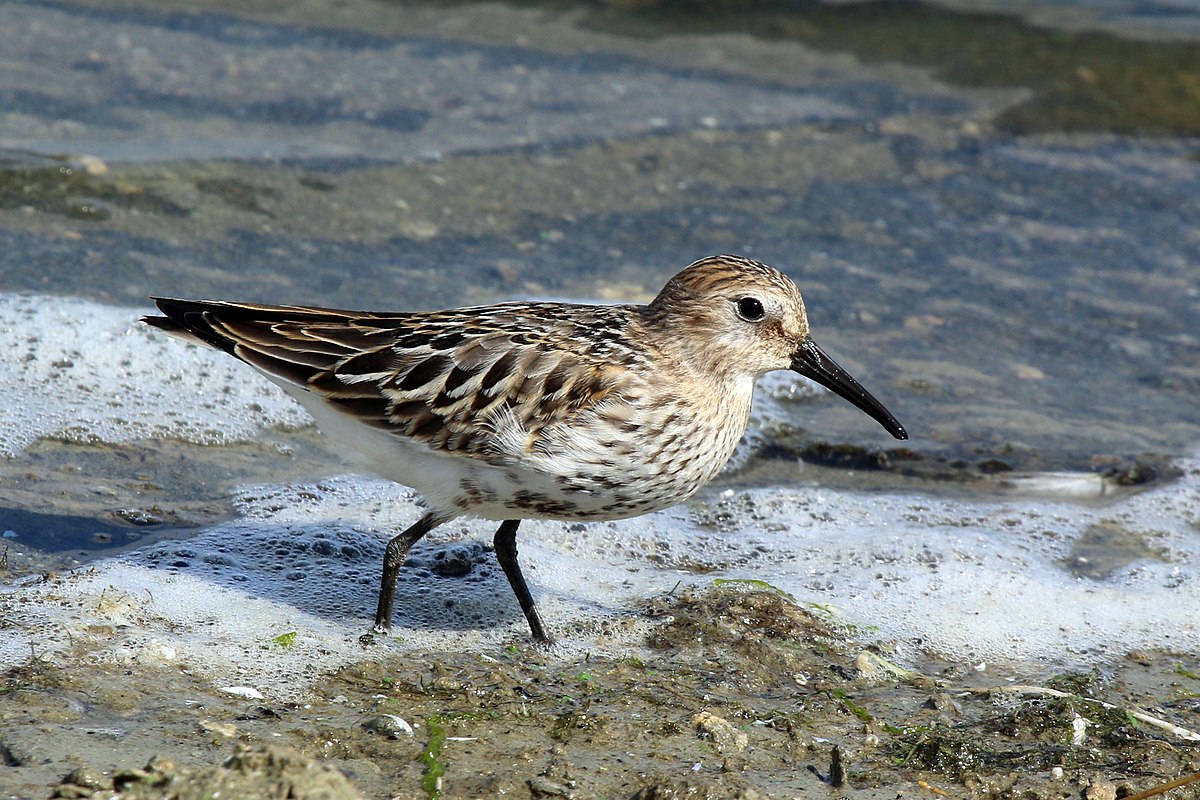
Wikipedia: Dunlin
Dieser Vogel erscheint jenseits grossen Meere in Kontinenten :
Europa, Nordamerika, Südamerika, Afrika.
Allgemein: ![]() The dunlin (Calidris alpina) is a small wader, sometimes separated with the other "stints" in Erolia. The English name is a dialect form of "dunling", first recorded in 1531–2. It derives from dun, "dull brown", with the suffix -ling, meaning a person or thing with the given quality.[2] The genus name is from Ancient Greek kalidris or skalidris, a term used by Aristotle for some grey-coloured waterside birds. The specific alpina is from Latin and means "of high mountains", in this case referring to the Alps.[3]
[more]
The dunlin (Calidris alpina) is a small wader, sometimes separated with the other "stints" in Erolia. The English name is a dialect form of "dunling", first recorded in 1531–2. It derives from dun, "dull brown", with the suffix -ling, meaning a person or thing with the given quality.[2] The genus name is from Ancient Greek kalidris or skalidris, a term used by Aristotle for some grey-coloured waterside birds. The specific alpina is from Latin and means "of high mountains", in this case referring to the Alps.[3]
[more]
Gesang: ![]() Song: A drawn out, nasal "tweeet", and ringing variations on the contact call in decrescendo. Low chattering heard from feeding birds. [Link]
Song: A drawn out, nasal "tweeet", and ringing variations on the contact call in decrescendo. Low chattering heard from feeding birds. [Link]
Rufe: ![]() Contact call a diagnostic, very nasal "trrreeet" . Given throughout the year and in many situations, including when being flushed. [Link]
Contact call a diagnostic, very nasal "trrreeet" . Given throughout the year and in many situations, including when being flushed. [Link]
Körperlich: Länge=16-20 cm,
Flügelspanne=38-43 cm,
Gewicht=35-60 g
Kampfläufer / Ruff (Calidris pugnax)

Wikipedia: Ruff
Dieser Vogel erscheint jenseits grossen Meere in Kontinenten :
Europa, Nordamerika, Südamerika, Afrika.
Allgemein: ![]() Der Kampfläufer (Calidris pugnax,[1] Syn.: Philomachus pugnax) ist ein streng geschützter, knapp 30 cm großer Schnepfenvogel der Paläarktis, der in der nördlichen Tundra, aber auch in feuchten Niederungswiesen und Mooren in ganz Eurasien brütet. Kampfläufer sind Zugvögel. Brutvögel aus Nordwesteuropa überwintern zumeist im westafrikanischen Binnenland, z. B. im inneren Nigerdelta in Mali. Auf dem Durchzug in die Brutgebiete kann man Kampfläufer auf feuchten Niederungen oder auch auf Schlammflächen beobachten.
[more]
Der Kampfläufer (Calidris pugnax,[1] Syn.: Philomachus pugnax) ist ein streng geschützter, knapp 30 cm großer Schnepfenvogel der Paläarktis, der in der nördlichen Tundra, aber auch in feuchten Niederungswiesen und Mooren in ganz Eurasien brütet. Kampfläufer sind Zugvögel. Brutvögel aus Nordwesteuropa überwintern zumeist im westafrikanischen Binnenland, z. B. im inneren Nigerdelta in Mali. Auf dem Durchzug in die Brutgebiete kann man Kampfläufer auf feuchten Niederungen oder auch auf Schlammflächen beobachten.
[more]
Vokalisierung: ![]() Generally silent. Short, muted, nasal, mono or disyllabic grunts sometimes heard. [Link]
Generally silent. Short, muted, nasal, mono or disyllabic grunts sometimes heard. [Link]
Körperlich: Länge=26-30 cm,
Flügelspanne=54-58 cm,
Gewicht=75-230 g
Graubrust-Strandläufer / Pectoral sandpiper (Calidris melanotos)
Profil Wikipedia Audubon Xeno-Canto

Wikipedia: Pectoral sandpiper
Dieser Vogel erscheint jenseits grossen Meere in Kontinenten :
Nordamerika, Südamerika, Afrika.
Allgemein: ![]() The pectoral sandpiper (Calidris melanotos) is a small, migratory wader that breeds in North America and Asia, wintering in South America and Oceania. It eats small invertebrates. Its nest, a hole scraped in the ground and with a thick lining, is deep enough to protect its four eggs from the cool breezes of its breeding grounds. The pectoral sandpiper is 21 cm (8.3 in) long, with a wingspan of 46 cm (18 in).
[more]
The pectoral sandpiper (Calidris melanotos) is a small, migratory wader that breeds in North America and Asia, wintering in South America and Oceania. It eats small invertebrates. Its nest, a hole scraped in the ground and with a thick lining, is deep enough to protect its four eggs from the cool breezes of its breeding grounds. The pectoral sandpiper is 21 cm (8.3 in) long, with a wingspan of 46 cm (18 in).
[more]
Gischtläufer / Surfbird (Calidris virgata)
Profil Wikipedia Audubon Xeno-Canto

Wikipedia: Surfbird
![]() The surfbird (Calidris virgata) is a small stocky wader in the family Scolopacidae. It was once considered to be allied to the turnstones, and placed in the monotypic genus Aphriza, but is now placed in the genus Calidris.
[more]
The surfbird (Calidris virgata) is a small stocky wader in the family Scolopacidae. It was once considered to be allied to the turnstones, and placed in the monotypic genus Aphriza, but is now placed in the genus Calidris.
[more]
Bergstrandläufer / Western sandpiper (Calidris mauri)
Profil Wikipedia Audubon Xeno-Canto

Wikipedia: Western sandpiper
![]() The western sandpiper (Calidris mauri) is a small shorebird. The genus name is from Ancient Greek kalidris or skalidris, a term used by Aristotle for some grey-coloured waterside birds. The specific mauri commemorates Italian botanist Ernesto Mauri (1791–1836).[2]
[more]
The western sandpiper (Calidris mauri) is a small shorebird. The genus name is from Ancient Greek kalidris or skalidris, a term used by Aristotle for some grey-coloured waterside birds. The specific mauri commemorates Italian botanist Ernesto Mauri (1791–1836).[2]
[more]
Sandstrandläufer / Semipalmated sandpiper (Calidris pusilla)

Wikipedia: Semipalmated sandpiper
![]() The semipalmated sandpiper (Calidris pusilla) is a very small shorebird. The genus name is from Ancient Greek kalidris or skalidris, a term used by Aristotle for some grey-coloured waterside birds. The specific pusilla is Latin for "very small".[2]
[more]
The semipalmated sandpiper (Calidris pusilla) is a very small shorebird. The genus name is from Ancient Greek kalidris or skalidris, a term used by Aristotle for some grey-coloured waterside birds. The specific pusilla is Latin for "very small".[2]
[more]
Wiesenstrandläufer / Least sandpiper (Calidris minutilla)
Profil Wikipedia Audubon Xeno-Canto
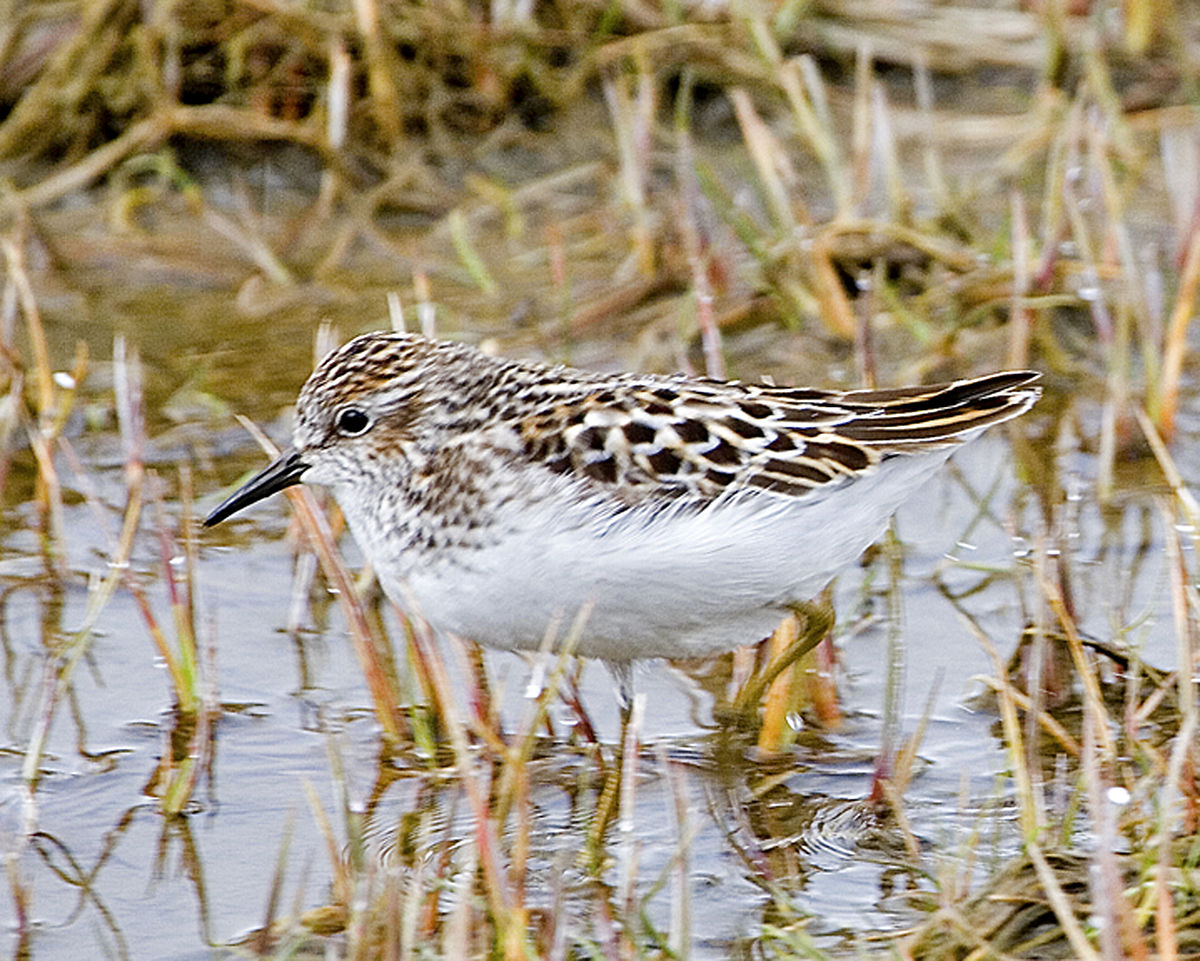
Wikipedia: Least sandpiper
![]() The least sandpiper (Calidris minutilla) is the smallest shorebird. The genus name is from Ancient Greek kalidris or skalidris, a term used by Aristotle for some grey-colored waterside birds. The specific minutilla is Medieval Latin for "very small".[2]
[more]
The least sandpiper (Calidris minutilla) is the smallest shorebird. The genus name is from Ancient Greek kalidris or skalidris, a term used by Aristotle for some grey-colored waterside birds. The specific minutilla is Medieval Latin for "very small".[2]
[more]
Calidris himantopus / Stilt sandpiper (Calidris himantopus)

Wikipedia: Stilt sandpiper
![]() The stilt sandpiper (Calidris himantopus) is a small shorebird. The scientific name is from Ancient Greek. The genus name kalidris or skalidris is a term used by Aristotle for some grey-coloured waterside birds. The specific himantopus means "strap foot" or "thong foot".[2]
[more]
The stilt sandpiper (Calidris himantopus) is a small shorebird. The scientific name is from Ancient Greek. The genus name kalidris or skalidris is a term used by Aristotle for some grey-coloured waterside birds. The specific himantopus means "strap foot" or "thong foot".[2]
[more]
Gattung Numenius (Curlews):
Numenius americanus / Long-billed curlew (Numenius americanus)
Profil Wikipedia Audubon Xeno-Canto

Wikipedia: Long-billed curlew
![]() The long-billed curlew (Numenius americanus) is a large North American shorebird of the family Scolopacidae. This species was also called "sicklebird"[2] and the "candlestick bird". The species breeds in central and western North America, migrating southward and coastward for the winter.
[more]
The long-billed curlew (Numenius americanus) is a large North American shorebird of the family Scolopacidae. This species was also called "sicklebird"[2] and the "candlestick bird". The species breeds in central and western North America, migrating southward and coastward for the winter.
[more]
Gattung Arenaria (Turnstones):
Steinwälzer / Ruddy turnstone (Arenaria interpres)

Wikipedia: Ruddy turnstone
Dieser Vogel erscheint jenseits grossen Meere in Kontinenten :
Europa, Nordamerika, Südamerika, Afrika.
![]() The ruddy turnstone (Arenaria interpres) is a small wading bird, one of two species of turnstone in the genus Arenaria. The scientific name is from Latin. The genus name arenaria derives from arenarius, "inhabiting sand, from arena, "sand". The specific interpres means "messenger"; when visiting Gotland in 1741, Linnaeus thought that the Swedish word Tolk "interpreter" applied to this species, but in the local dialect the word means "legs" and is used for the redshank.[2]
[more]
The ruddy turnstone (Arenaria interpres) is a small wading bird, one of two species of turnstone in the genus Arenaria. The scientific name is from Latin. The genus name arenaria derives from arenarius, "inhabiting sand, from arena, "sand". The specific interpres means "messenger"; when visiting Gotland in 1741, Linnaeus thought that the Swedish word Tolk "interpreter" applied to this species, but in the local dialect the word means "legs" and is used for the redshank.[2]
[more]
Gesang: ![]() Alarm call/song more "wader-like", a staccato "kuvi-kuvi-vit-vit-vitua". [Link]
Alarm call/song more "wader-like", a staccato "kuvi-kuvi-vit-vit-vitua". [Link]
Rufe: ![]() Characteristic call: An explosive, hard, resonant and short "koi" or "kott" with a peculiar timbre, usually given in rapid or accelerating series. [Link]
Characteristic call: An explosive, hard, resonant and short "koi" or "kott" with a peculiar timbre, usually given in rapid or accelerating series. [Link]
Körperlich: Länge=22-24 cm,
Flügelspanne=50-57 cm,
Gewicht=85-150 g
Gattung Gallinago:
Wilsonbekassine / Wilson's snipe (Gallinago delicata)
Profil Wikipedia Audubon Xeno-Canto

Wikipedia: Wilson's snipe
Allgemein: ![]() Wilson's snipe (Gallinago delicata) is a small, stocky shorebird.[2] The genus name gallinago is New Latin for a woodcock or snipe from Latin gallina, "hen" and the suffix -ago, "resembling". The specific delicata is Latin for "dainty".[3]
[more]
Wilson's snipe (Gallinago delicata) is a small, stocky shorebird.[2] The genus name gallinago is New Latin for a woodcock or snipe from Latin gallina, "hen" and the suffix -ago, "resembling". The specific delicata is Latin for "dainty".[3]
[more]
Gattung Limnodromus:
Großer Schlammläufer / Long-billed dowitcher (Limnodromus scolopaceus)
Profil Wikipedia Audubon Xeno-Canto

Wikipedia: Long-billed dowitcher
![]() The long-billed dowitcher (Limnodromus scolopaceus) is a medium-sized shorebird with a relatively long bill belonging to the sandpiper family, Scolopacidae. In breeding plumage, adults are characterized by a beautiful rufous head and underparts with a darker mottled back and a large white upper rump only seen in flight.[2][3][4] They feed in various freshwater habitats with their bill underwater in a "sewing machine" motion and are known to have an exciting mating display where males chase females in flight.[2] The genus, Limnodromus is Ancient Greek from limne, "marsh" and dromos, "racer". The specific scolopaceus is New Latin for "snipe-like", from Latin scolopax, scolopacis, a snipe or woodcock.[5] The English name is from Iroquois and was first recorded in 1841.[6]
[more]
The long-billed dowitcher (Limnodromus scolopaceus) is a medium-sized shorebird with a relatively long bill belonging to the sandpiper family, Scolopacidae. In breeding plumage, adults are characterized by a beautiful rufous head and underparts with a darker mottled back and a large white upper rump only seen in flight.[2][3][4] They feed in various freshwater habitats with their bill underwater in a "sewing machine" motion and are known to have an exciting mating display where males chase females in flight.[2] The genus, Limnodromus is Ancient Greek from limne, "marsh" and dromos, "racer". The specific scolopaceus is New Latin for "snipe-like", from Latin scolopax, scolopacis, a snipe or woodcock.[5] The English name is from Iroquois and was first recorded in 1841.[6]
[more]
Gattung Limosa:
Hudsonschnepfe / Hudsonian godwit (Limosa haemastica)
Profil Wikipedia Audubon Xeno-Canto

Wikipedia: Hudsonian godwit
Dieser Vogel erscheint jenseits grossen Meere in Kontinenten :
Nordamerika, Südamerika, Afrika.
![]() The Hudsonian godwit (Limosa haemastica) is a large shorebird in the sandpiper family, Scolopacidae. The genus name Limosa is from Latin and means "muddy", from limus, "mud". The specific haemastica is from Ancient Greek and means "bloody". An 18th century name for this bird was red-breasted godwit.[2] The English term "godwit" was first recorded in about 1416–7 and is believed to imitate the bird's call.[3]
[more]
The Hudsonian godwit (Limosa haemastica) is a large shorebird in the sandpiper family, Scolopacidae. The genus name Limosa is from Latin and means "muddy", from limus, "mud". The specific haemastica is from Ancient Greek and means "bloody". An 18th century name for this bird was red-breasted godwit.[2] The English term "godwit" was first recorded in about 1416–7 and is believed to imitate the bird's call.[3]
[more]
Amerikanische Pfuhlschnepfe / Marbled godwit (Limosa fedoa)
Profil Wikipedia Audubon Xeno-Canto
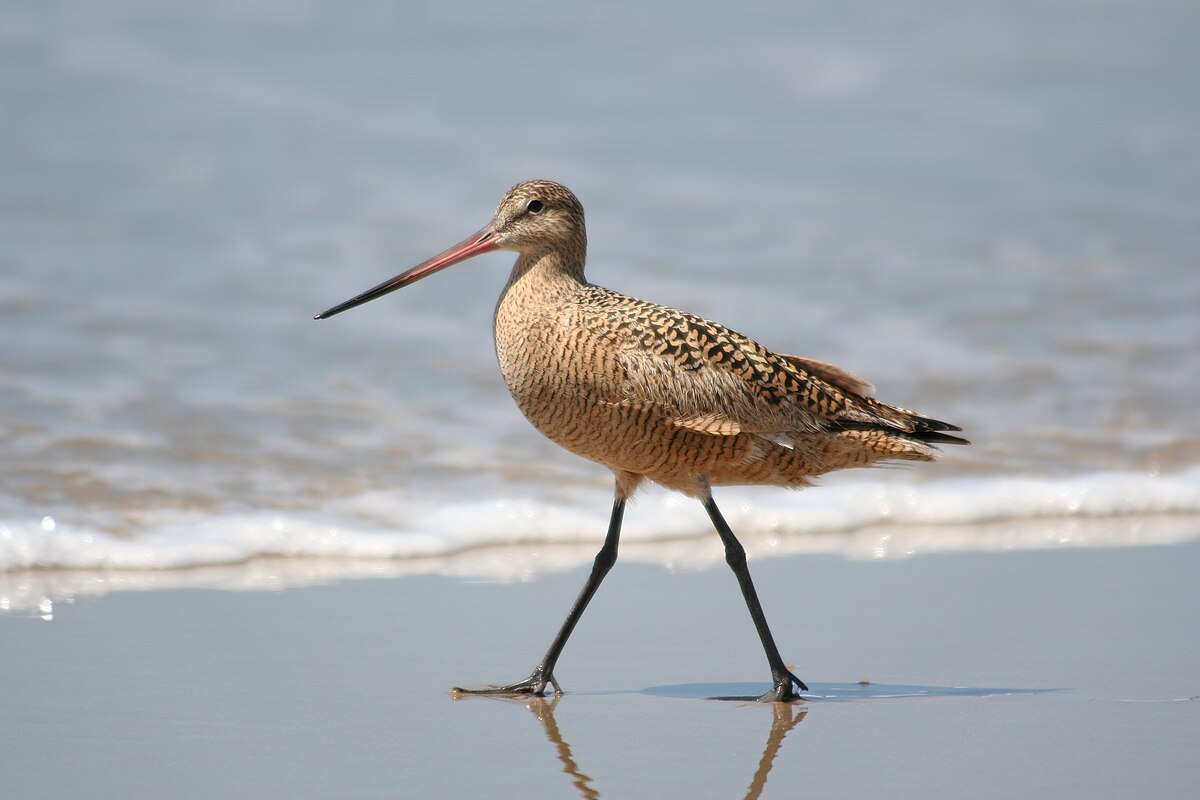
Wikipedia: Marbled godwit
![]() The marbled godwit (Limosa fedoa) is a large shorebird. On average, it is the largest of the 4 species of godwit.
[more]
The marbled godwit (Limosa fedoa) is a large shorebird. On average, it is the largest of the 4 species of godwit.
[more]
Gattung Tringa:
Kleiner Gelbschenkel / Lesser yellowlegs (Tringa flavipes)
Profil Wikipedia Audubon Xeno-Canto

Wikipedia: Lesser yellowlegs
Dieser Vogel erscheint jenseits grossen Meere in Kontinenten :
Nordamerika, Südamerika, Afrika.
![]() The lesser yellowlegs (Tringa flavipes) is a medium-sized shorebird. The genus name Tringa is the New Latin name given to the green sandpiper by Aldrovandus in 1599 based on Ancient Greek trungas, a thrush-sized, white-rumped, tail-bobbing wading bird mentioned by Aristotle. The specific flavipes is from Latin flavus, "yellow", and pes, "foot".[2]
[more]
The lesser yellowlegs (Tringa flavipes) is a medium-sized shorebird. The genus name Tringa is the New Latin name given to the green sandpiper by Aldrovandus in 1599 based on Ancient Greek trungas, a thrush-sized, white-rumped, tail-bobbing wading bird mentioned by Aristotle. The specific flavipes is from Latin flavus, "yellow", and pes, "foot".[2]
[more]
Schlammtreter / Willet (Tringa semipalmata)

Wikipedia: Willet
![]() The willet (Tringa semipalmata), formerly in the monotypic genus Catoptrophorus as Catoptrophorus semipalmatus,[2][3] is a large shorebird in the family Scolopacidae. It is a relatively large and robust sandpiper, and is the largest of the species called "shanks" in the genus Tringa. Its closest relative is the lesser yellowlegs, a much smaller bird with a very different appearance apart from the fine, clear, and dense pattern of the neck, which both species show in breeding plumage. It breeds in North America and the West Indies and winters in southern North America, Central America, the West Indies and South America.
[more]
The willet (Tringa semipalmata), formerly in the monotypic genus Catoptrophorus as Catoptrophorus semipalmatus,[2][3] is a large shorebird in the family Scolopacidae. It is a relatively large and robust sandpiper, and is the largest of the species called "shanks" in the genus Tringa. Its closest relative is the lesser yellowlegs, a much smaller bird with a very different appearance apart from the fine, clear, and dense pattern of the neck, which both species show in breeding plumage. It breeds in North America and the West Indies and winters in southern North America, Central America, the West Indies and South America.
[more]
Wanderwasserläufer / Wandering tattler (Tringa incana)

Wikipedia: Wandering tattler
![]() The wandering tattler (Tringa incana) (formerly Heteroscelus incanus: Pereira & Baker, 2005; Banks et al., 2006), is a medium-sized wading bird. It is similar in appearance to the closely related gray-tailed tattler, T. brevipes. The tattlers are unique among the species of Tringa for having unpatterned, greyish wings and backs, and a scaly breast pattern extending more or less onto the belly in breeding plumage, in which both also have a rather prominent supercilium.
[more]
The wandering tattler (Tringa incana) (formerly Heteroscelus incanus: Pereira & Baker, 2005; Banks et al., 2006), is a medium-sized wading bird. It is similar in appearance to the closely related gray-tailed tattler, T. brevipes. The tattlers are unique among the species of Tringa for having unpatterned, greyish wings and backs, and a scaly breast pattern extending more or less onto the belly in breeding plumage, in which both also have a rather prominent supercilium.
[more]
Einsamer Wasserläufer / Solitary sandpiper (Tringa solitaria)
Profil Wikipedia Audubon Xeno-Canto

Wikipedia: Solitary sandpiper
![]() The solitary sandpiper (Tringa solitaria) is a small shorebird. The genus name Tringa is the New Latin name given to the green sandpiper by Aldrovandus in 1599 based on Ancient Greek trungas, a thrush-sized, white-rumped, tail-bobbing wading bird mentioned by Aristotle. The specific solitaria is Latin for "solitary" from solus, "alone".[2]
[more]
The solitary sandpiper (Tringa solitaria) is a small shorebird. The genus name Tringa is the New Latin name given to the green sandpiper by Aldrovandus in 1599 based on Ancient Greek trungas, a thrush-sized, white-rumped, tail-bobbing wading bird mentioned by Aristotle. The specific solitaria is Latin for "solitary" from solus, "alone".[2]
[more]
Tringa melanoleuca / Greater yellowlegs (Tringa melanoleuca)
Profil Wikipedia Audubon Xeno-Canto
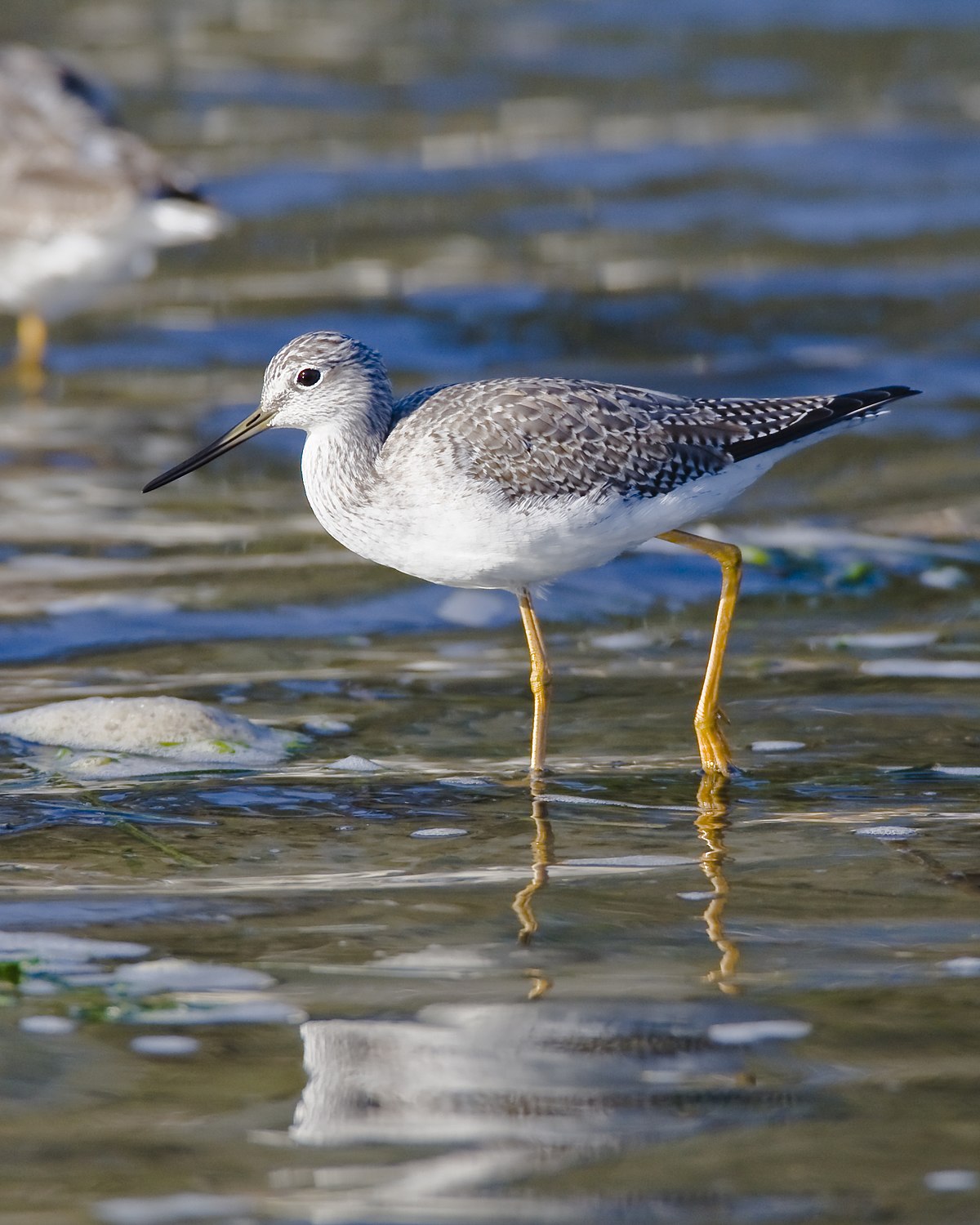
Wikipedia: Greater yellowlegs
![]() Totanus melanoleucus
[more]
Totanus melanoleucus
[more]
Gattung Actitis:
Drosseluferläufer / Spotted sandpiper (Actitis macularius)
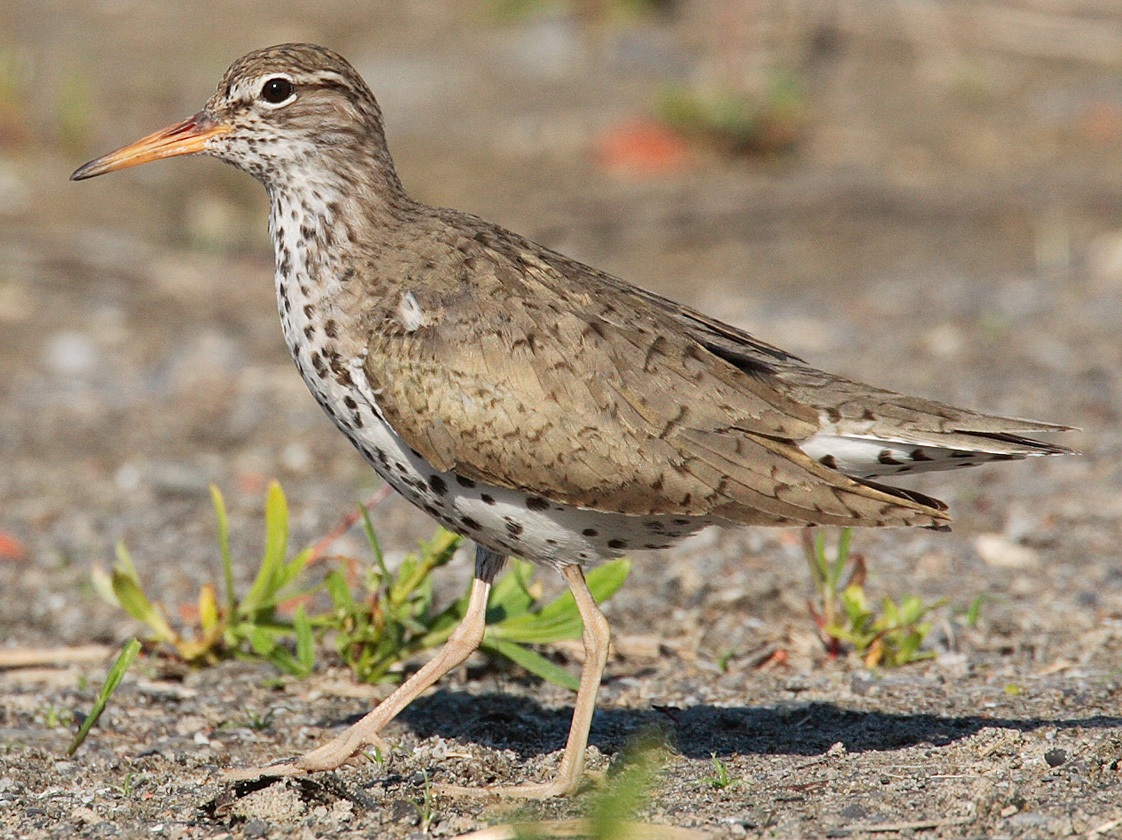
Wikipedia: Spotted sandpiper
![]() The spotted sandpiper (Actitis macularius) is a small shorebird. The genus name Actitis is from Ancient Greek aktites, "coast-dweller", derived from akte, "coast", and macularius is Latin from macula, "spot".[2]
[more]
The spotted sandpiper (Actitis macularius) is a small shorebird. The genus name Actitis is from Ancient Greek aktites, "coast-dweller", derived from akte, "coast", and macularius is Latin from macula, "spot".[2]
[more]
Gattung Phalaropus:
Thorshühnchen / Red phalarope (Phalaropus fulicarius)

Wikipedia: Red phalarope
Dieser Vogel erscheint jenseits grossen Meere in Kontinenten :
Europa, Nordamerika, Südamerika, Afrika.
![]() The red phalarope or grey phalarope (Phalaropus fulicarius) is a small wader. This phalarope breeds in the Arctic regions of North America and Eurasia. It is migratory, and, unusually for a wader, migrating mainly on oceanic routes and wintering at sea on tropical oceans.
[more]
The red phalarope or grey phalarope (Phalaropus fulicarius) is a small wader. This phalarope breeds in the Arctic regions of North America and Eurasia. It is migratory, and, unusually for a wader, migrating mainly on oceanic routes and wintering at sea on tropical oceans.
[more]
Rufe: ![]() Flight-call a short and sharp, Coot-like "kit". Cleaner and higher pitched than Red-necked Phalarope. Display sound a rolling cooing, at stable pitch. Other calls: a hissing like the squeezing of a rubber duck, rising quickly in pitch and ending abruptly. [Link]
Flight-call a short and sharp, Coot-like "kit". Cleaner and higher pitched than Red-necked Phalarope. Display sound a rolling cooing, at stable pitch. Other calls: a hissing like the squeezing of a rubber duck, rising quickly in pitch and ending abruptly. [Link]
Körperlich: Länge=20-22 cm,
Flügelspanne=40-44 cm,
Gewicht=40-75 g
Wilson-Wassertreter / Wilson's phalarope (Phalaropus tricolor)
Profil Wikipedia Audubon Xeno-Canto
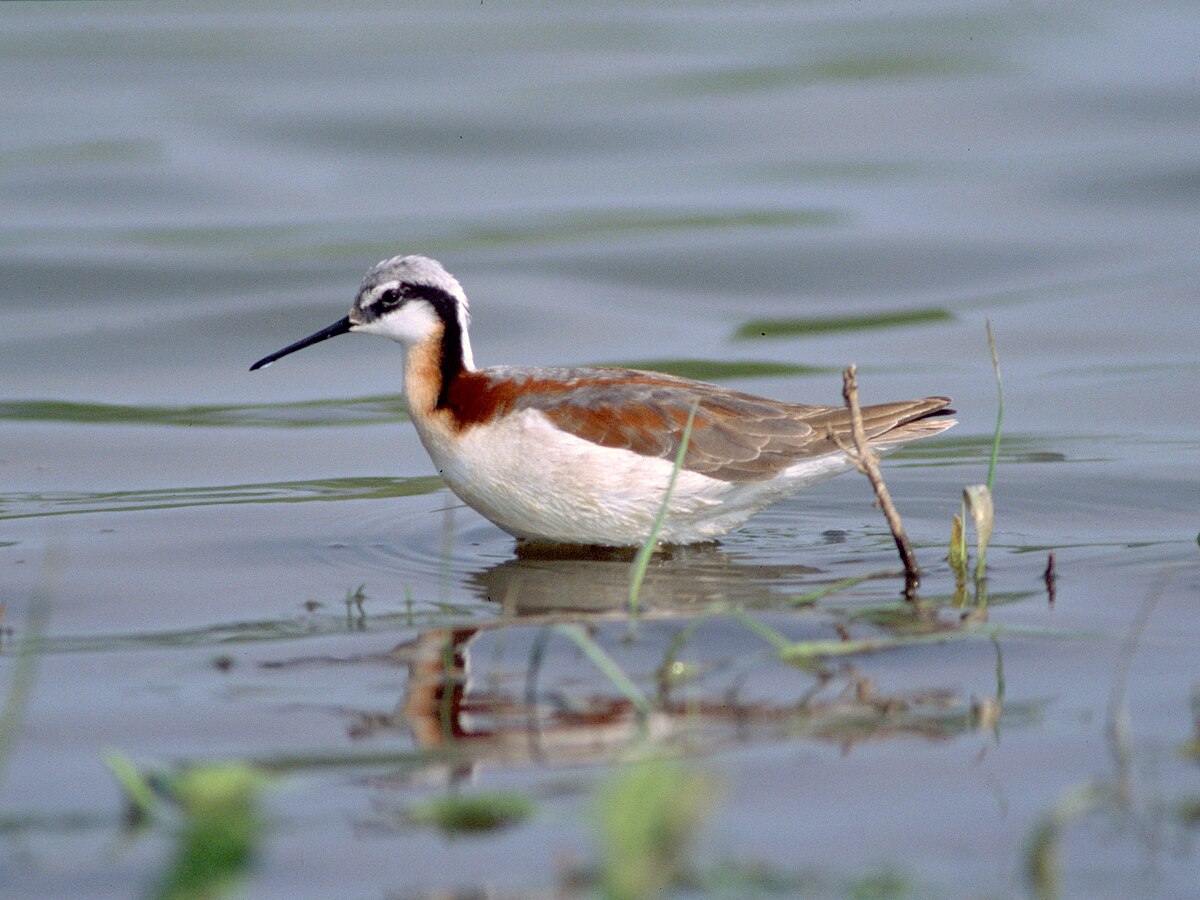
Wikipedia: Wilson's phalarope
Dieser Vogel erscheint jenseits grossen Meere in Kontinenten :
Nordamerika, Südamerika, Afrika.
Allgemein: ![]() Wilson's phalarope (Phalaropus tricolor) is a small wader. This bird, the largest of the phalaropes, breeds in the prairies of North America in western Canada and the western United States. It is migratory, wintering in inland salt lakes near the Andes in Argentina.[2] They are passage migrants through Central America around March/April and again during September/October.[3] The species is a rare vagrant to western Europe.
[more]
Wilson's phalarope (Phalaropus tricolor) is a small wader. This bird, the largest of the phalaropes, breeds in the prairies of North America in western Canada and the western United States. It is migratory, wintering in inland salt lakes near the Andes in Argentina.[2] They are passage migrants through Central America around March/April and again during September/October.[3] The species is a rare vagrant to western Europe.
[more]
Odinshühnchen / Red-necked phalarope (Phalaropus lobatus)
Profil Wikipedia Vogelwarte BirdLife ZH Audubon Xeno-Canto NABU
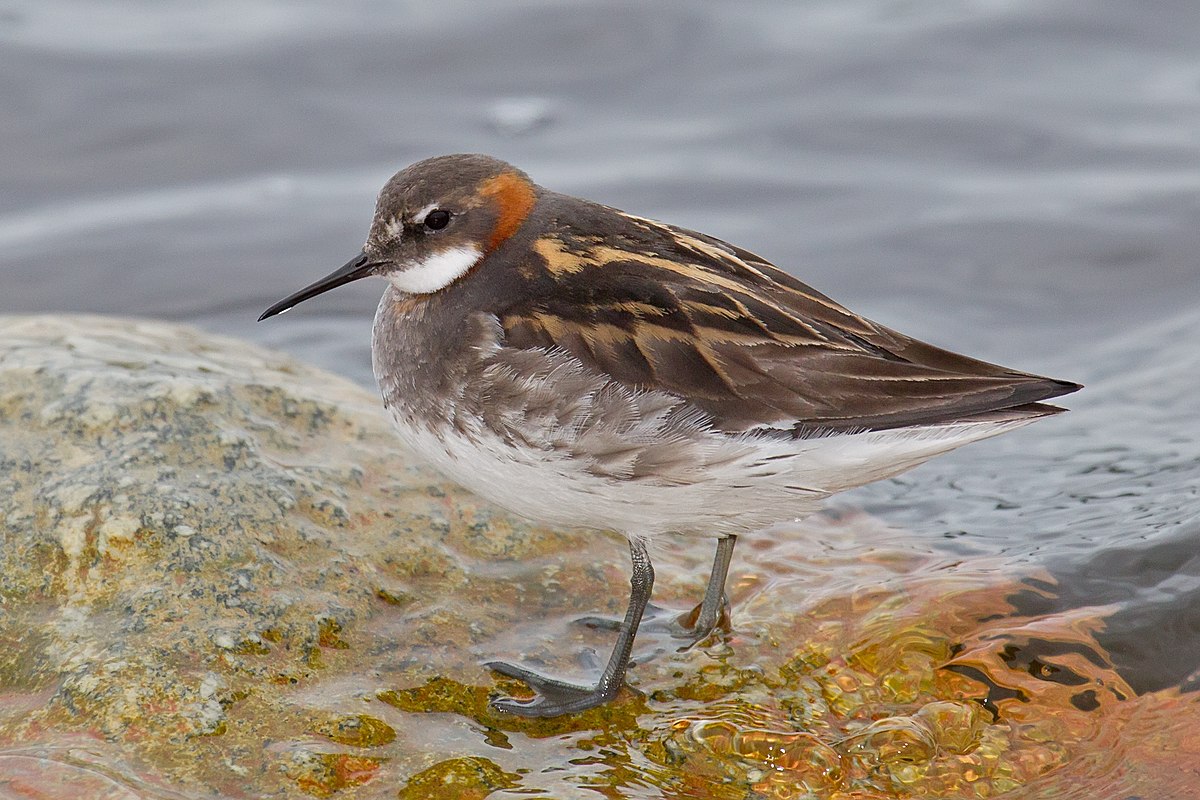
Wikipedia: Red-necked phalarope
Dieser Vogel erscheint jenseits grossen Meere in Kontinenten :
Europa, Nordamerika, Südamerika, Afrika.
![]() The red-necked phalarope (Phalaropus lobatus), also known as the northern phalarope and hyperborean phalarope,[2] is a small wader. This phalarope breeds in the Arctic regions of North America and Eurasia. It is migratory, and, unusually for a wader, winters at sea on tropical oceans.
[more]
The red-necked phalarope (Phalaropus lobatus), also known as the northern phalarope and hyperborean phalarope,[2] is a small wader. This phalarope breeds in the Arctic regions of North America and Eurasia. It is migratory, and, unusually for a wader, winters at sea on tropical oceans.
[more]
Gattung Bartramia:
Prärieläufer / Upland sandpiper (Bartramia longicauda)
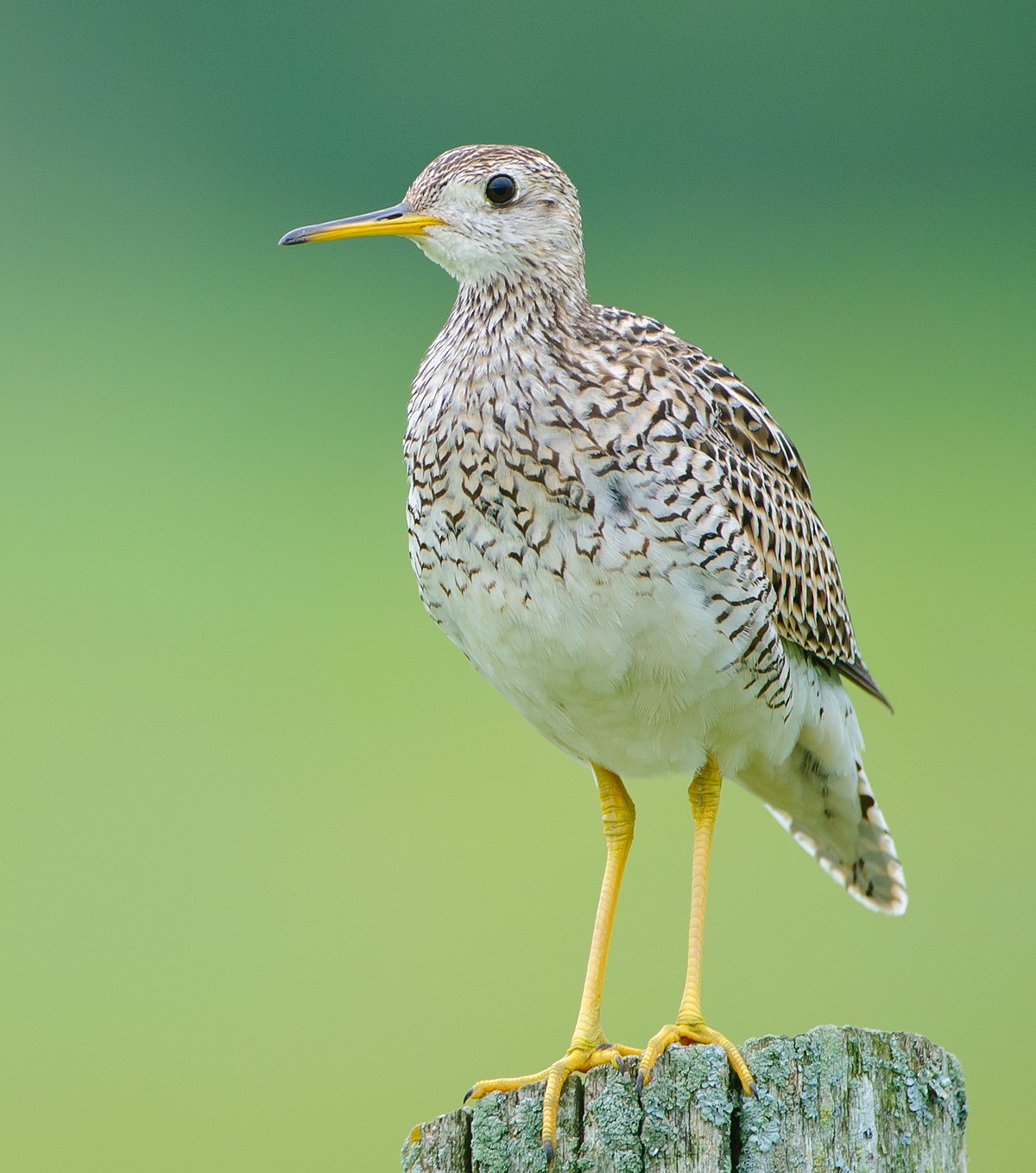
Wikipedia: Upland sandpiper
![]() The upland sandpiper (Bartramia longicauda) is a large sandpiper, closely related to the curlews.[2] Older names are the upland plover and Bartram's sandpiper. In Louisiana, it is also colloquially known as the papabotte.[3] It is the only member of the genus Bartramia. The genus name and the old common name Bartram's sandpiper commemorate the American naturalist William Bartram. The species name longicauda is from Latin longus, "long" and caudus, "tail".[4] The name "Bartram's sandpiper" was made popular by Alexander Wilson, who was taught ornithology and natural history illustration by Bartram.
[more]
The upland sandpiper (Bartramia longicauda) is a large sandpiper, closely related to the curlews.[2] Older names are the upland plover and Bartram's sandpiper. In Louisiana, it is also colloquially known as the papabotte.[3] It is the only member of the genus Bartramia. The genus name and the old common name Bartram's sandpiper commemorate the American naturalist William Bartram. The species name longicauda is from Latin longus, "long" and caudus, "tail".[4] The name "Bartram's sandpiper" was made popular by Alexander Wilson, who was taught ornithology and natural history illustration by Bartram.
[more]
Unterfamilie Sterninae (Möwenverwandte / Terns):
Gattung Sterna:
Flussseeschwalbe / Common tern (Sterna hirundo)
Profil Wikipedia Vogelwarte BirdLife ZH Audubon Xeno-Canto BirdID NABU
Common tern pfaeffikersee. 2020-05-20 09.31.28 null
Dieser Vogel erscheint jenseits grossen Meere in Kontinenten :
Europa, Nordamerika, Südamerika, Afrika.
Saisonal: ![]() Die Flussseeschwalbe (Sterna hirundo) ist eine Vogelart aus der Familie der Seeschwalben (Sternidae).
Sie ist in Mitteleuropa ein verbreiteter, aber nicht sehr häufiger Brut- und Sommervogel.
Während der Zugzeiten können im mitteleuropäischen Raum außerdem viele Durchzügler beobachtet werden. [Link]
Die Flussseeschwalbe (Sterna hirundo) ist eine Vogelart aus der Familie der Seeschwalben (Sternidae).
Sie ist in Mitteleuropa ein verbreiteter, aber nicht sehr häufiger Brut- und Sommervogel.
Während der Zugzeiten können im mitteleuropäischen Raum außerdem viele Durchzügler beobachtet werden. [Link]
Vokalisierung: ![]() Similar to Arctic Tern but deeper. [Link]
Similar to Arctic Tern but deeper. [Link]
Rufe: ![]() Lacks latter's high pitched "tip-tip-tip" call, and the drawn out "kree-aaahh" call falls more distinctly in pitch. [Link]
Lacks latter's high pitched "tip-tip-tip" call, and the drawn out "kree-aaahh" call falls more distinctly in pitch. [Link]
Körperlich: Länge=31-35 cm,
Flügelspanne=77-98 cm,
Gewicht=110-150 g
Küstenseeschwalbe / Arctic tern (Sterna paradisaea)
Profil Wikipedia Vogelwarte BirdLife ZH Audubon Xeno-Canto BirdID NABU
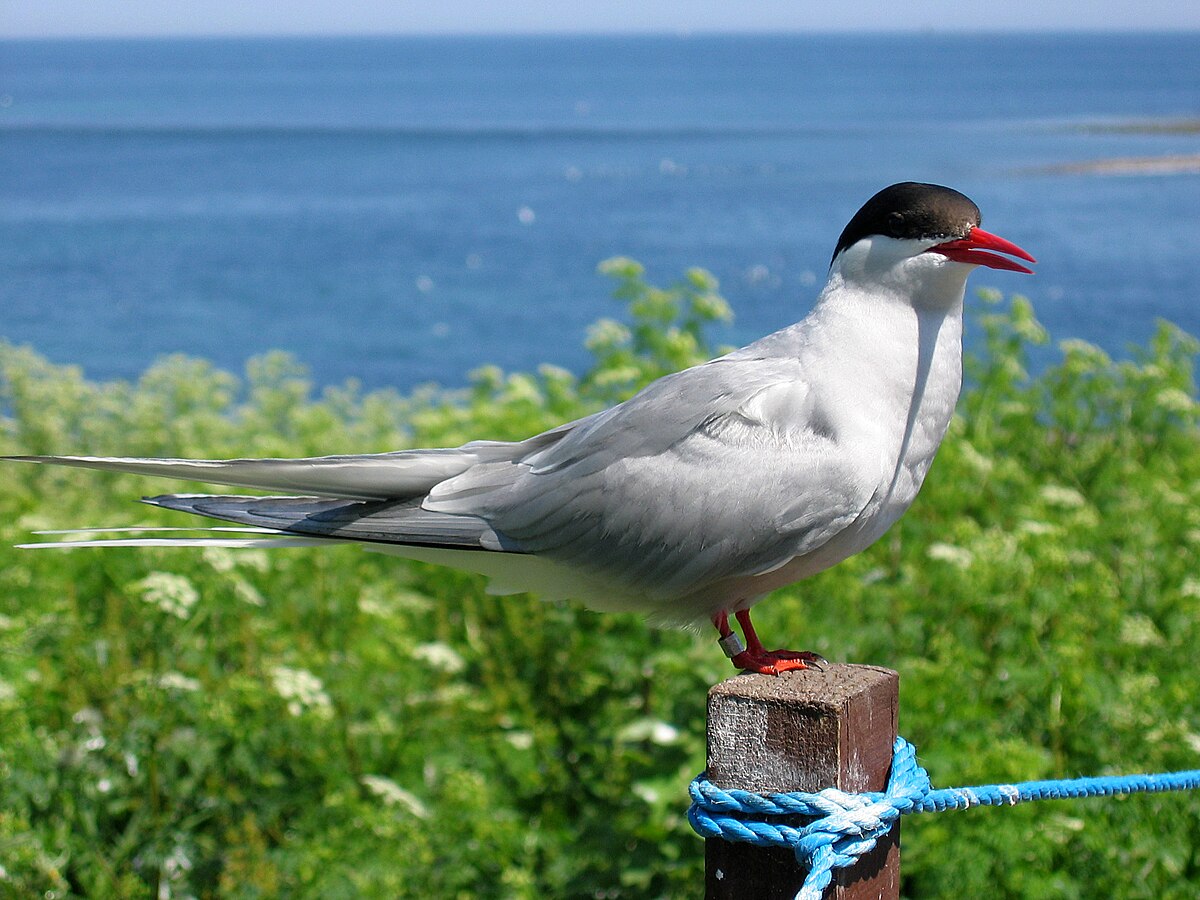
Wikipedia: Arctic tern
Dieser Vogel erscheint jenseits grossen Meere in Kontinenten :
Europa, Nordamerika, Südamerika, Afrika.
Allgemein: ![]() The Arctic tern (Sterna paradisaea) is a tern in the family Laridae. This bird has a circumpolar breeding distribution covering the Arctic and sub-Arctic regions of Europe, Asia, and North America (as far south as Brittany and Massachusetts). The species is strongly migratory, seeing two summers each year as it migrates along a convoluted route from its northern breeding grounds to the Antarctic coast for the southern summer and back again about six months later. Recent studies have shown average annual roundtrip lengths of about 70,900 km (44,100 mi) for birds nesting in Iceland and Greenland[3] and about 90,000 km (56,000 mi) for birds nesting in the Netherlands.[4] These are by far the longest migrations known in the animal kingdom. The Arctic tern flies as well as glides through the air. It nests once every one to three years (depending on its mating cycle); once it has finished nesting it takes to the sky for another long southern migration.
[more]
The Arctic tern (Sterna paradisaea) is a tern in the family Laridae. This bird has a circumpolar breeding distribution covering the Arctic and sub-Arctic regions of Europe, Asia, and North America (as far south as Brittany and Massachusetts). The species is strongly migratory, seeing two summers each year as it migrates along a convoluted route from its northern breeding grounds to the Antarctic coast for the southern summer and back again about six months later. Recent studies have shown average annual roundtrip lengths of about 70,900 km (44,100 mi) for birds nesting in Iceland and Greenland[3] and about 90,000 km (56,000 mi) for birds nesting in the Netherlands.[4] These are by far the longest migrations known in the animal kingdom. The Arctic tern flies as well as glides through the air. It nests once every one to three years (depending on its mating cycle); once it has finished nesting it takes to the sky for another long southern migration.
[more]
Vokalisierung: ![]() Similar to Common Tern but higher pitched. [Link]
Similar to Common Tern but higher pitched. [Link]
Rufe: ![]() Typical call a series of high pitched "tip-tip-tip", and longer, ringing, high-pitched "kriiiiii" calls. The drawn out "kree-aaahh" call falls less distinctly in pitch than Common Tern. [Link]
Typical call a series of high pitched "tip-tip-tip", and longer, ringing, high-pitched "kriiiiii" calls. The drawn out "kree-aaahh" call falls less distinctly in pitch than Common Tern. [Link]
Körperlich: Länge=33-35 cm,
Flügelspanne=75-85 cm,
Gewicht=95-120 g
Sterna forsteri / Forster's tern (Sterna forsteri)
Profil Wikipedia Audubon Xeno-Canto

Wikipedia: Forster's tern
Allgemein: ![]() Forster's tern (Sterna forsteri) is a tern in the family Laridae. The genus name Sterna is derived from Old English "stearn", "tern",[2] and forsteri commemorates the naturalist Johann Reinhold Forster.[3]
[more]
Forster's tern (Sterna forsteri) is a tern in the family Laridae. The genus name Sterna is derived from Old English "stearn", "tern",[2] and forsteri commemorates the naturalist Johann Reinhold Forster.[3]
[more]
Familie Haematopodidae (Oystercatchers):
Gattung Haematopus:
Braunmantel-Austernfischer / American oystercatcher (Haematopus palliatus)
Profil Wikipedia Audubon Xeno-Canto

Wikipedia: American oystercatcher
![]() The American oystercatcher (Haematopus palliatus), occasionally called the American pied oystercatcher, is a member of family Haematopodidae. Originally called the "sea pie", it was renamed in 1731 when naturalist Mark Catesby observed the bird eating oysters.[2] The current population of American oystercatchers is estimated to be 43,000.[2] There are estimated to be 1,500 breeding pairs along the Atlantic and Gulf Coasts of the US.[3] The bird is marked by its black and white body and a long, thick orange beak.
[more]
The American oystercatcher (Haematopus palliatus), occasionally called the American pied oystercatcher, is a member of family Haematopodidae. Originally called the "sea pie", it was renamed in 1731 when naturalist Mark Catesby observed the bird eating oysters.[2] The current population of American oystercatchers is estimated to be 43,000.[2] There are estimated to be 1,500 breeding pairs along the Atlantic and Gulf Coasts of the US.[3] The bird is marked by its black and white body and a long, thick orange beak.
[more]
Familie Stercorariidae:
Gattung Stercorarius:
Spatelraubmöwe / Pomarine jaeger (Stercorarius pomarinus)
Profil Wikipedia Vogelwarte BirdLife ZH Audubon Xeno-Canto BirdID NABU
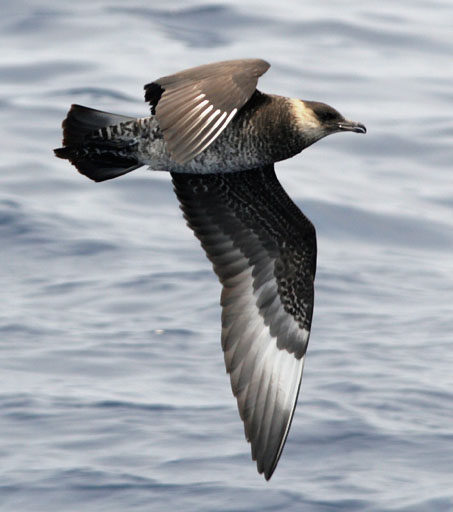
Wikipedia: Pomarine jaeger
Dieser Vogel erscheint jenseits grossen Meere in Kontinenten :
Europa, Nordamerika, Südamerika, Afrika.
![]() The pomarine jaeger (Stercorarius pomarinus), pomarine skua, or pomatorhine skua,[2] is a seabird in the skua family Stercorariidae. It is a migrant, wintering at sea in the tropical oceans.
[more]
The pomarine jaeger (Stercorarius pomarinus), pomarine skua, or pomatorhine skua,[2] is a seabird in the skua family Stercorariidae. It is a migrant, wintering at sea in the tropical oceans.
[more]
Rufe: ![]() Short "kea" or "ke", and various mewing calls, usually deeper pitched than Arctic Skua. Also a characteristic, laughing and vibrating "kayayayayaya", heard mostly on breeding ground. [Link]
Short "kea" or "ke", and various mewing calls, usually deeper pitched than Arctic Skua. Also a characteristic, laughing and vibrating "kayayayayaya", heard mostly on breeding ground. [Link]
Körperlich: Länge=46-51 cm,
Flügelspanne=125-138 cm,
Gewicht=600-900 g
Schmarotzerraubmöwe / Parasitic jaeger (Stercorarius parasiticus)
Profil Wikipedia Vogelwarte BirdLife ZH Audubon Xeno-Canto BirdID NABU

Wikipedia: Parasitic jaeger
Dieser Vogel erscheint jenseits grossen Meere in Kontinenten :
Europa, Nordamerika, Südamerika, Afrika.
Allgemein: ![]() The parasitic jaeger (Stercorarius parasiticus), also known as the Arctic skua, Arctic jaeger or parasitic skua, is a seabird in the skua family Stercorariidae. The word "jaeger" is derived from the German word Jäger, meaning "hunter".[2] The English "skua" comes from the Faroese name skúgvur [ˈskɪkvʊər] for the great skua, with the island of Skúvoy known for its colony of that bird. The general Faroese term for skuas is kjógvi [ˈtʃɛkvə].[3] The genus name Stercorarius is Latin and means "of dung"; the food disgorged by other birds when pursued by skuas was once thought to be excrement. The specific parasiticus is from Latin and means "parasitic".[4]
[more]
The parasitic jaeger (Stercorarius parasiticus), also known as the Arctic skua, Arctic jaeger or parasitic skua, is a seabird in the skua family Stercorariidae. The word "jaeger" is derived from the German word Jäger, meaning "hunter".[2] The English "skua" comes from the Faroese name skúgvur [ˈskɪkvʊər] for the great skua, with the island of Skúvoy known for its colony of that bird. The general Faroese term for skuas is kjógvi [ˈtʃɛkvə].[3] The genus name Stercorarius is Latin and means "of dung"; the food disgorged by other birds when pursued by skuas was once thought to be excrement. The specific parasiticus is from Latin and means "parasitic".[4]
[more]
Vokalisierung: ![]() Mostly heard at breeding ground. [Link]
Mostly heard at breeding ground. [Link]
Rufe: ![]() Most characteristic call is a mewing, kittiwake-like "aeeeee-ah". First syllable drawn-out and rising in pitch, and followed by a deeper conclusive second syllable "ah". Lacks the introductory double accent of Kittiwakes ("kitti-wake"). [Link]
Most characteristic call is a mewing, kittiwake-like "aeeeee-ah". First syllable drawn-out and rising in pitch, and followed by a deeper conclusive second syllable "ah". Lacks the introductory double accent of Kittiwakes ("kitti-wake"). [Link]
Körperlich: Länge=41-46 cm,
Flügelspanne=110-125 cm,
Gewicht=330-570 g
Familie Jacanidae (Jacanas):
Gattung Jacana:
Gelbstirn-Blatthühnchen / Northern jacana (Jacana spinosa)
Profil Wikipedia Xeno-Canto

Wikipedia: Northern jacana
Allgemein: ![]() The northern jacana or northern jaçana (Jacana spinosa) is a wader which is a resident breeder from coastal Mexico to western Panama, and on Cuba, Jamaica and Hispaniola in the Caribbean. It sometimes breeds in Texas, United States, and has also been recorded on several occasions as a vagrant in Arizona. The jacanas are a group of wetland birds, which are identifiable by their huge feet and claws, which enable them to walk on floating vegetation in the shallow lakes that are their preferred habitat. In Jamaica, this bird is also known as the 'Jesus bird', as it appears to walk on water.[2] Jacana is Linnæus' scientific Latin spelling of the Brazilian Portuguese jaçanã, pronounced [ʒasaˈnɐ̃], from the Tupi name of the bird. See jacana for pronunciations.
[more]
The northern jacana or northern jaçana (Jacana spinosa) is a wader which is a resident breeder from coastal Mexico to western Panama, and on Cuba, Jamaica and Hispaniola in the Caribbean. It sometimes breeds in Texas, United States, and has also been recorded on several occasions as a vagrant in Arizona. The jacanas are a group of wetland birds, which are identifiable by their huge feet and claws, which enable them to walk on floating vegetation in the shallow lakes that are their preferred habitat. In Jamaica, this bird is also known as the 'Jesus bird', as it appears to walk on water.[2] Jacana is Linnæus' scientific Latin spelling of the Brazilian Portuguese jaçanã, pronounced [ʒasaˈnɐ̃], from the Tupi name of the bird. See jacana for pronunciations.
[more]
Jacana jacana / Wattled jacana (Jacana jacana)
Profil Wikipedia Xeno-Canto

Wikipedia: Wattled jacana
![]() The wattled jacana (Jacana jacana) is a wader which is a resident breeder from western Panama and Trinidad south through most of South America east of the Andes.
[more]
The wattled jacana (Jacana jacana) is a wader which is a resident breeder from western Panama and Trinidad south through most of South America east of the Andes.
[more]
Familie Burhinidae (Triele, Haematopodidae – Austernfischer und Recurvirostridae – Säbelschnäblerverwandte):
Gattung Burhinus:
Burhinus bistriatus / Double-striped thick-knee (Burhinus bistriatus)

Wikipedia: Double-striped thick-knee
![]() The double-striped thick-knee (Burhinus bistriatus) is a stone-curlew, a group of waders in the family Burhinidae. The vernacular name refers to the prominent joints in the long greenish-grey legs, and bistriatus to the two stripes of the head pattern.
[more]
The double-striped thick-knee (Burhinus bistriatus) is a stone-curlew, a group of waders in the family Burhinidae. The vernacular name refers to the prominent joints in the long greenish-grey legs, and bistriatus to the two stripes of the head pattern.
[more]
Familie Recurvirostridae:
Gattung Recurvirostra:
Amerikanischer Säbelschnäbler / American avocet (Recurvirostra americana)
Profil Wikipedia Audubon Xeno-Canto

Wikipedia: American avocet
![]() The American avocet (Recurvirostra americana) is a large wader in the avocet and stilt family, Recurvirostridae. It spends much of its time foraging in shallow water or on mud flats, often sweeping its bill from side to side in water as it seeks its crustacean and insect prey.[2]
[more]
The American avocet (Recurvirostra americana) is a large wader in the avocet and stilt family, Recurvirostridae. It spends much of its time foraging in shallow water or on mud flats, often sweeping its bill from side to side in water as it seeks its crustacean and insect prey.[2]
[more]
Gattung Himantopus:
Amerikanischer Stelzenläufer / Black-necked stilt (Himantopus mexicanus)
Profil Wikipedia Audubon Xeno-Canto
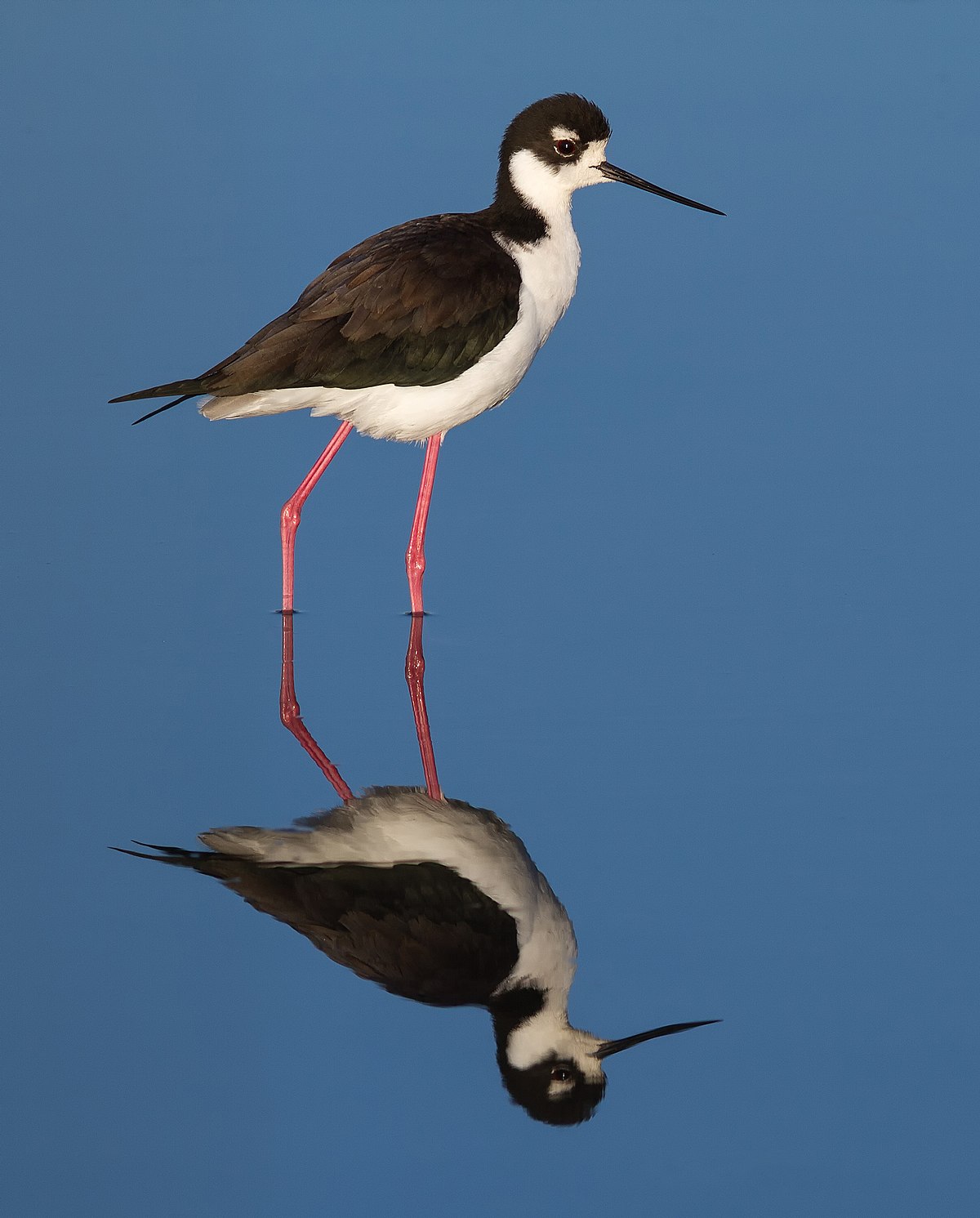
Wikipedia: Black-necked stilt
![]() The black-necked stilt (Himantopus mexicanus) is a locally abundant shorebird of American wetlands and coastlines. It is found from the coastal areas of California through much of the interior western United States and along the Gulf of Mexico as far east as Florida, then south through Central America and the Caribbean to Ecuador and the Galápagos Islands. The northernmost populations, particularly those from inland, are migratory, wintering from the extreme south of the United States to southern Mexico, rarely as far south as Costa Rica; on the Baja California peninsula it is only found regularly in winter.[2]
[more]
The black-necked stilt (Himantopus mexicanus) is a locally abundant shorebird of American wetlands and coastlines. It is found from the coastal areas of California through much of the interior western United States and along the Gulf of Mexico as far east as Florida, then south through Central America and the Caribbean to Ecuador and the Galápagos Islands. The northernmost populations, particularly those from inland, are migratory, wintering from the extreme south of the United States to southern Mexico, rarely as far south as Costa Rica; on the Baja California peninsula it is only found regularly in winter.[2]
[more]
Ordnung Gruiformes (Kranichvögel / Terrestrial and marshbirds):
Familie Rallidae (Rallen / Rails):
Gattung Fulica (Coots):
Fulica americana / American coot (Fulica americana)
Profil Wikipedia Audubon Xeno-Canto
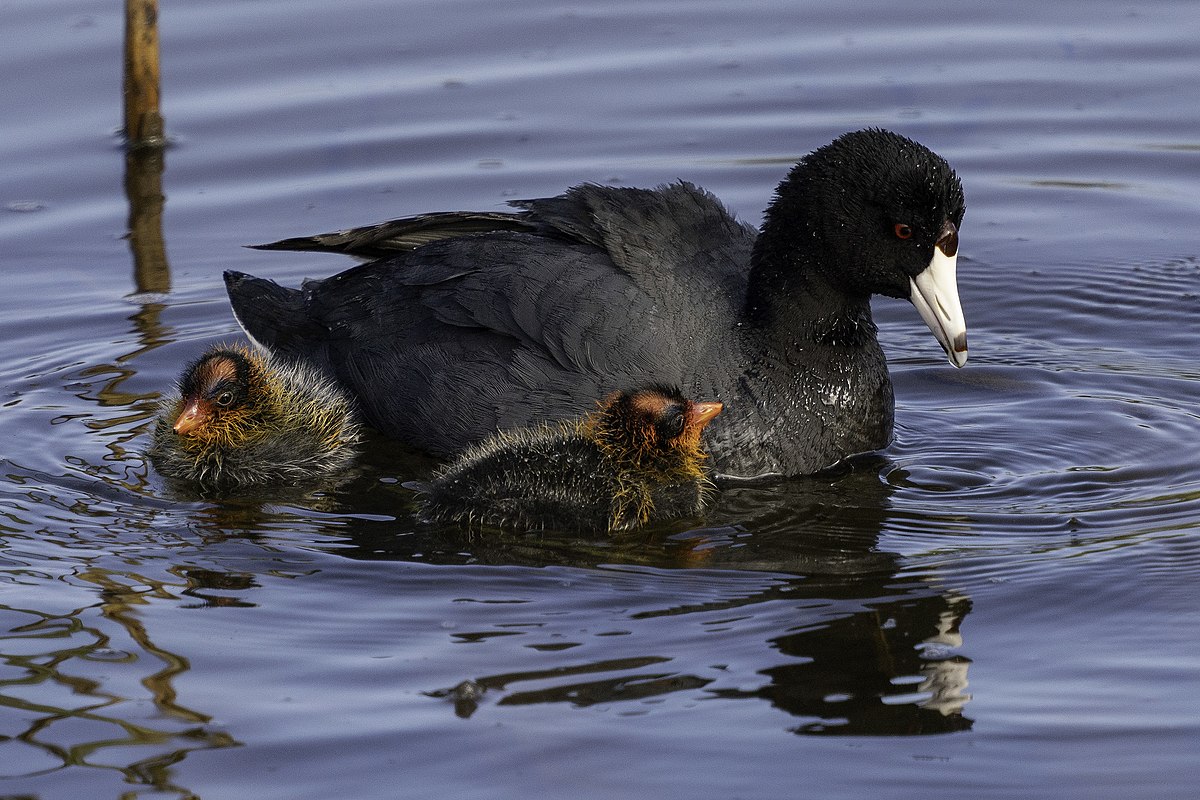
Wikipedia: American coot
![]() The American coot (Fulica americana), also known as a mud hen or pouldeau, is a bird of the family Rallidae. Though commonly mistaken for ducks, American coots are only distantly related to ducks, belonging to a separate order. Unlike the webbed feet of ducks, coots have broad, lobed scales on their lower legs and toes that fold back with each step in order to facilitate walking on dry land.[2] Coots live near water, typically inhabiting wetlands and open water bodies in North America. Groups of coots are called covers[3] or rafts.[citation needed] The oldest known coot lived to be 22 years old.[2]
[more]
The American coot (Fulica americana), also known as a mud hen or pouldeau, is a bird of the family Rallidae. Though commonly mistaken for ducks, American coots are only distantly related to ducks, belonging to a separate order. Unlike the webbed feet of ducks, coots have broad, lobed scales on their lower legs and toes that fold back with each step in order to facilitate walking on dry land.[2] Coots live near water, typically inhabiting wetlands and open water bodies in North America. Groups of coots are called covers[3] or rafts.[citation needed] The oldest known coot lived to be 22 years old.[2]
[more]
Gattung Rallus:
Klapperralle / Mangrove rail (Rallus longirostris)
Profil Wikipedia Xeno-Canto
![]()
Wikipedia: Mangrove rail
![]() The mangrove rail (Rallus longirostris) is a species of bird in the family Rallidae.
It is found in Central and South America. It was formerly considered conspecific with the clapper rail (Rallus crepitans).
[more]
The mangrove rail (Rallus longirostris) is a species of bird in the family Rallidae.
It is found in Central and South America. It was formerly considered conspecific with the clapper rail (Rallus crepitans).
[more]
Gattung Gallinula:
Gallinula galeata / Common gallinule (Gallinula galeata)
Profil Wikipedia Audubon Xeno-Canto
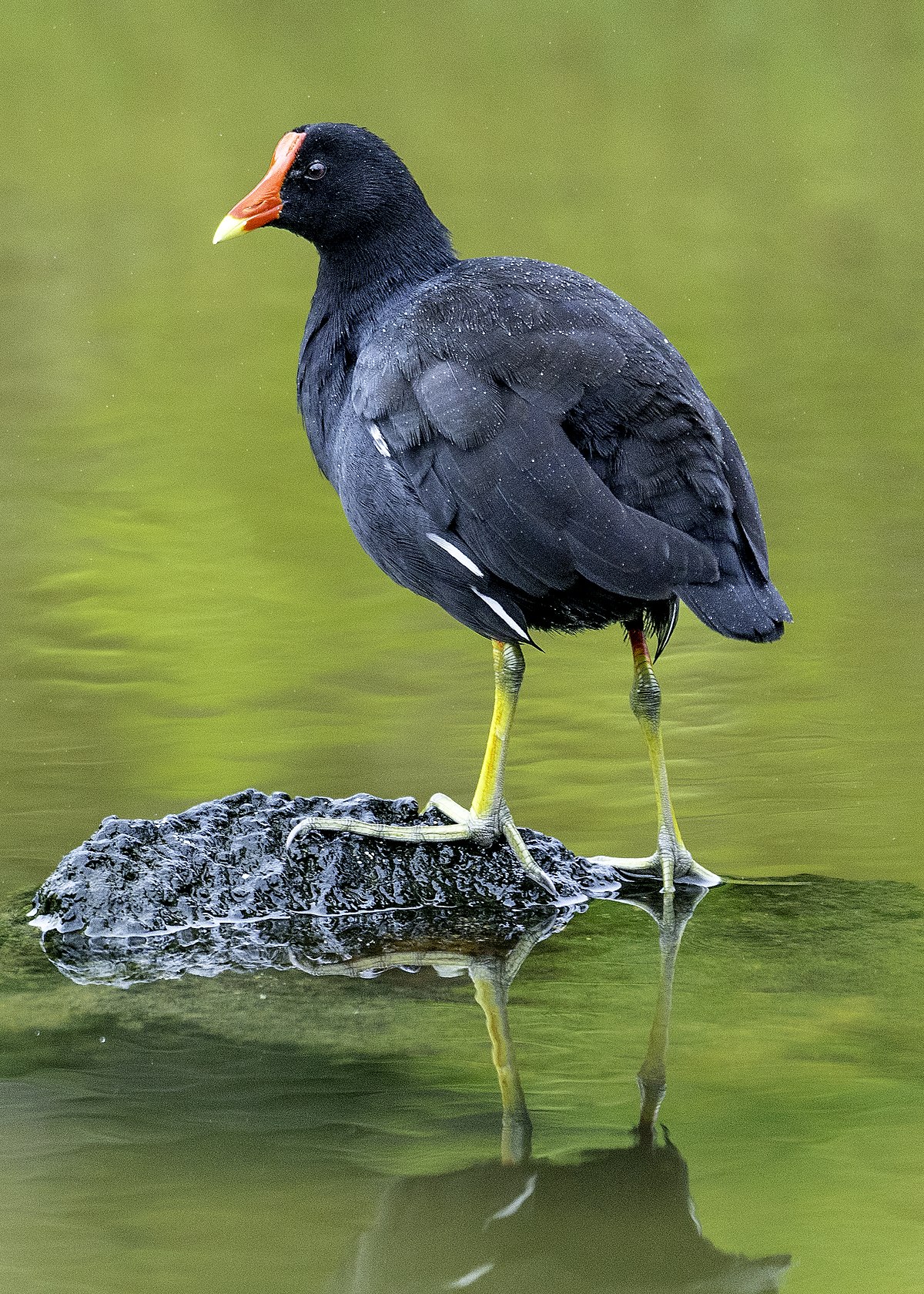
Wikipedia: Common gallinule
![]() The common gallinule (Gallinula galeata) is a bird in the family Rallidae. It was split from the common moorhen by the American Ornithologists' Union in July 2011.[3] It lives around well-vegetated marshes, ponds, canals, and other wetlands in the Americas. The species is not found in the polar regions or many tropical rainforests. Elsewhere, the common gallinule is likely the most commonly seen rail species in much of North America, except for the American coot in some regions.
[more]
The common gallinule (Gallinula galeata) is a bird in the family Rallidae. It was split from the common moorhen by the American Ornithologists' Union in July 2011.[3] It lives around well-vegetated marshes, ponds, canals, and other wetlands in the Americas. The species is not found in the polar regions or many tropical rainforests. Elsewhere, the common gallinule is likely the most commonly seen rail species in much of North America, except for the American coot in some regions.
[more]
Gattung Laterallus:
Laterallus jamaicensis / Black rail (Laterallus jamaicensis)
Profil Wikipedia Audubon Xeno-Canto

Wikipedia: Black rail
![]() The black rail (Laterallus jamaicensis) is a mouse-sized member of the bird family Rallidae.
[more]
The black rail (Laterallus jamaicensis) is a mouse-sized member of the bird family Rallidae.
[more]
Laterallus ruber / Ruddy crake (Laterallus ruber)
Profil Wikipedia Xeno-Canto

Wikipedia: Ruddy crake
![]() The ruddy crake (Laterallus ruber) is a bird in the rail family, Rallidae. Other names the Ruddy Crake is known by are “Red Rail”, “Rudy Rail” and “Red Crake”.[2]
[more]
The ruddy crake (Laterallus ruber) is a bird in the rail family, Rallidae. Other names the Ruddy Crake is known by are “Red Rail”, “Rudy Rail” and “Red Crake”.[2]
[more]
Laterallus albigularis / White-throated crake (Laterallus albigularis)
Profil Wikipedia Xeno-Canto

Wikipedia: White-throated crake
![]() The white-throated crake (Laterallus albigularis) is a species of bird in the family Rallidae.
[more]
The white-throated crake (Laterallus albigularis) is a species of bird in the family Rallidae.
[more]
Laterallus exilis / Gray-breasted crake (Laterallus exilis)
Profil Wikipedia Xeno-Canto
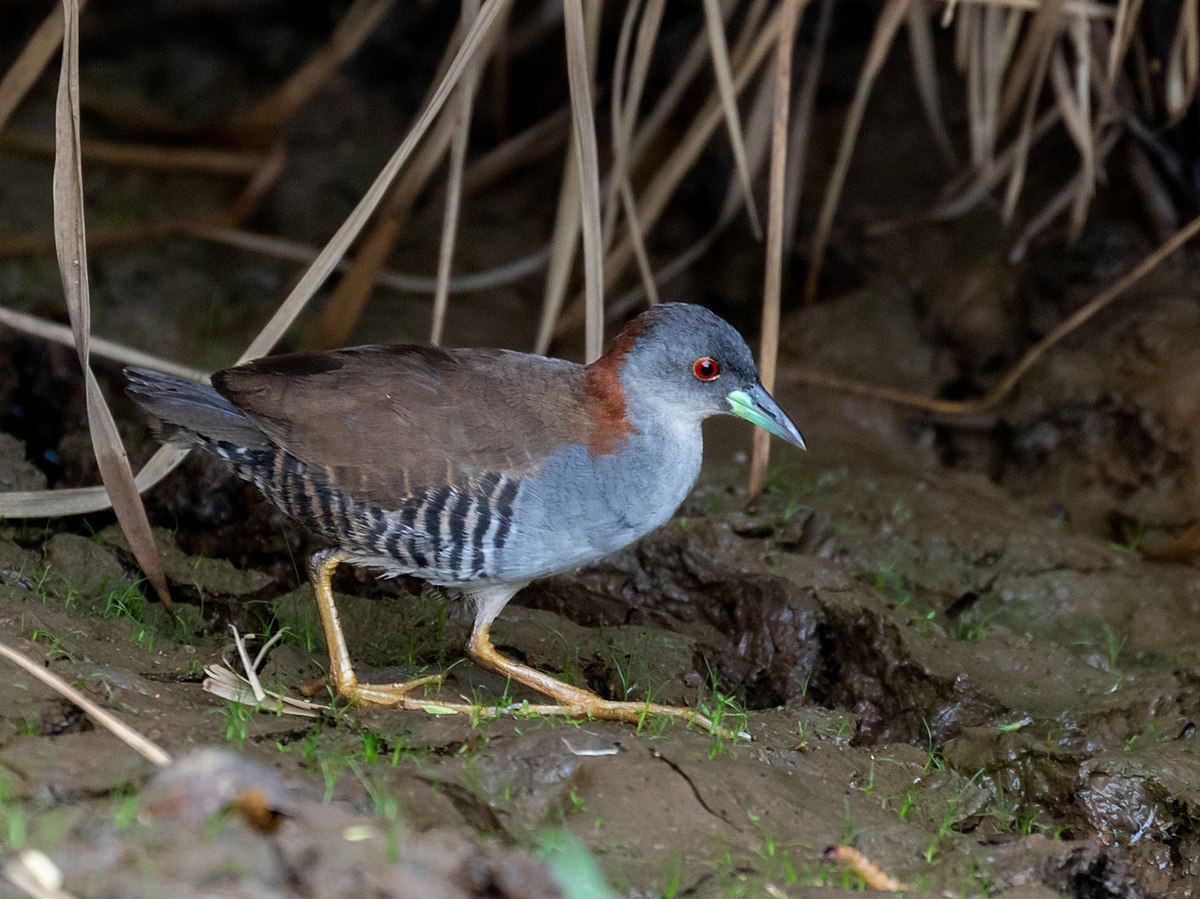
Wikipedia: Gray-breasted crake
![]() The grey-breasted crake (Laterallus exilis) is a species of bird in the family Rallidae. It is found in Argentina, Belize, Bolivia, Brazil, Colombia, Costa Rica, Ecuador, French Guiana, Guatemala, Guyana, Honduras, Nicaragua, Panama, Paraguay, Peru, Suriname, Trinidad and Tobago, and Venezuela. Its natural habitats are swamps and pastureland.
[more]
The grey-breasted crake (Laterallus exilis) is a species of bird in the family Rallidae. It is found in Argentina, Belize, Bolivia, Brazil, Colombia, Costa Rica, Ecuador, French Guiana, Guatemala, Guyana, Honduras, Nicaragua, Panama, Paraguay, Peru, Suriname, Trinidad and Tobago, and Venezuela. Its natural habitats are swamps and pastureland.
[more]
Gattung Aramides:
Cayenneralle / Gray-cowled wood-rail (Aramides cajaneus)
Profil Wikipedia Xeno-Canto

Wikipedia: Gray-cowled wood-rail
![]() The grey-cowled wood rail or grey-necked wood rail (Aramides cajaneus) is a species of bird in the family Rallidae, the rails. It lives primarily in the forests, mangroves, and swamps of Central and South America. Of the two subspecies, A. c. avicenniae is found in southeastern Brazil, while the nominate is found throughout the portion of the range not occupied by the other subspecies. The species as a whole is usually found at elevations from sea level to 2,000 metres (6,600 ft), although some have been found above that. This bird's large extent of occurrence along with its population is why it is considered to be least-concern by the International Union for Conservation of Nature (IUCN). In some places, it is occasionally hunted and kept for food.
[more]
The grey-cowled wood rail or grey-necked wood rail (Aramides cajaneus) is a species of bird in the family Rallidae, the rails. It lives primarily in the forests, mangroves, and swamps of Central and South America. Of the two subspecies, A. c. avicenniae is found in southeastern Brazil, while the nominate is found throughout the portion of the range not occupied by the other subspecies. The species as a whole is usually found at elevations from sea level to 2,000 metres (6,600 ft), although some have been found above that. This bird's large extent of occurrence along with its population is why it is considered to be least-concern by the International Union for Conservation of Nature (IUCN). In some places, it is occasionally hunted and kept for food.
[more]
Aramides albiventris / Russet-naped wood-rail (Aramides albiventris)
Profil Wikipedia Xeno-Canto

Wikipedia: Russet-naped wood-rail
![]() The russet-naped wood rail or rufous-naped wood rail[1][2] (Aramides albiventris) is a species of bird in the family Rallidae. It lives primarily in forests and mangroves of Central America.
[more]
The russet-naped wood rail or rufous-naped wood rail[1][2] (Aramides albiventris) is a species of bird in the family Rallidae. It lives primarily in forests and mangroves of Central America.
[more]
Aramides axillaris / Rufous-necked wood-rail (Aramides axillaris)
Profil Wikipedia Xeno-Canto

Wikipedia: Rufous-necked wood-rail
![]() The rufous-necked wood rail (Aramides axillaris) is a species of bird in the family Rallidae.
It is found in Belize, Colombia, Costa Rica, Ecuador, El Salvador, French Guiana, Guyana, Honduras, Mexico, Nicaragua, Panama, Peru, Suriname, Trinidad and Tobago, and Venezuela.
Its natural habitats are subtropical or tropical dry forest, subtropical or tropical moist lowland forest, and subtropical or tropical mangrove forest.
[more]
The rufous-necked wood rail (Aramides axillaris) is a species of bird in the family Rallidae.
It is found in Belize, Colombia, Costa Rica, Ecuador, El Salvador, French Guiana, Guyana, Honduras, Mexico, Nicaragua, Panama, Peru, Suriname, Trinidad and Tobago, and Venezuela.
Its natural habitats are subtropical or tropical dry forest, subtropical or tropical moist lowland forest, and subtropical or tropical mangrove forest.
[more]
Gattung Pardirallus:
Pardirallus maculatus / Spotted rail (Pardirallus maculatus)
Profil Wikipedia Xeno-Canto

Wikipedia: Spotted rail
![]() The spotted rail (Pardirallus maculatus) is a species of bird in the family Rallidae.
It is found in Argentina, Belize, Bolivia, Brazil, Cayman Islands, Chile, Colombia, Costa Rica, Cuba, the Dominican Republic, Ecuador, El Salvador, French Guiana, Guyana, Jamaica, Mexico, Panama, Paraguay, Peru, Suriname, Trinidad and Tobago, Uruguay, Venezuela, and possibly Honduras.
The spotted rail is found in marshland and swamps.
[more]
The spotted rail (Pardirallus maculatus) is a species of bird in the family Rallidae.
It is found in Argentina, Belize, Bolivia, Brazil, Cayman Islands, Chile, Colombia, Costa Rica, Cuba, the Dominican Republic, Ecuador, El Salvador, French Guiana, Guyana, Jamaica, Mexico, Panama, Paraguay, Peru, Suriname, Trinidad and Tobago, Uruguay, Venezuela, and possibly Honduras.
The spotted rail is found in marshland and swamps.
[more]
Gattung Amaurolimnas:
Amaurolimnas concolor / Uniform crake (Amaurolimnas concolor)

Wikipedia: Uniform crake
![]() The uniform crake (Amaurolimnas concolor) is a species of bird in the family Rallidae, the only member of the genus Amaurolimnas.
[more]
The uniform crake (Amaurolimnas concolor) is a species of bird in the family Rallidae, the only member of the genus Amaurolimnas.
[more]
Gattung Micropygia:
Micropygia schomburgkii / Ocellated crake (Micropygia schomburgkii)
Profil Wikipedia Xeno-Canto

Wikipedia: Ocellated crake
![]() The ocellated crake (Micropygia schomburgkii) is a species of bird in the family Rallidae. It belongs to the monotypic genus Micropygia.
It is found in Bolivia, Brazil, Colombia, Costa Rica, French Guiana, Guyana, Paraguay, Peru, Suriname, and Venezuela.
Its natural habitats are dry savanna and subtropical or tropical seasonally wet or flooded lowland grassland.
[more]
The ocellated crake (Micropygia schomburgkii) is a species of bird in the family Rallidae. It belongs to the monotypic genus Micropygia.
It is found in Bolivia, Brazil, Colombia, Costa Rica, French Guiana, Guyana, Paraguay, Peru, Suriname, and Venezuela.
Its natural habitats are dry savanna and subtropical or tropical seasonally wet or flooded lowland grassland.
[more]
Familie Aramidae (Limpkins):
Gattung Aramus:
Rallenkranich / Limpkin (Aramus guarauna)

Wikipedia: Limpkin
![]() The limpkin (Aramus guarauna), also called carrao, courlan, and crying bird, is a large wading bird related to rails and cranes, and the only extant species in the genus Aramus and the family Aramidae. It is found mostly in wetlands in warm parts of the Americas, from Florida to northern Argentina. It feeds on molluscs, with the diet dominated by apple snails of the genus Pomacea. Its name derives from its seeming limp when it walks.[2]
[more]
The limpkin (Aramus guarauna), also called carrao, courlan, and crying bird, is a large wading bird related to rails and cranes, and the only extant species in the genus Aramus and the family Aramidae. It is found mostly in wetlands in warm parts of the Americas, from Florida to northern Argentina. It feeds on molluscs, with the diet dominated by apple snails of the genus Pomacea. Its name derives from its seeming limp when it walks.[2]
[more]
Familie Heliornithidae (Sungrebes):
Gattung Heliornis:
Zwergbinsenralle / Sungrebe (Heliornis fulica)
Profil Wikipedia Xeno-Canto
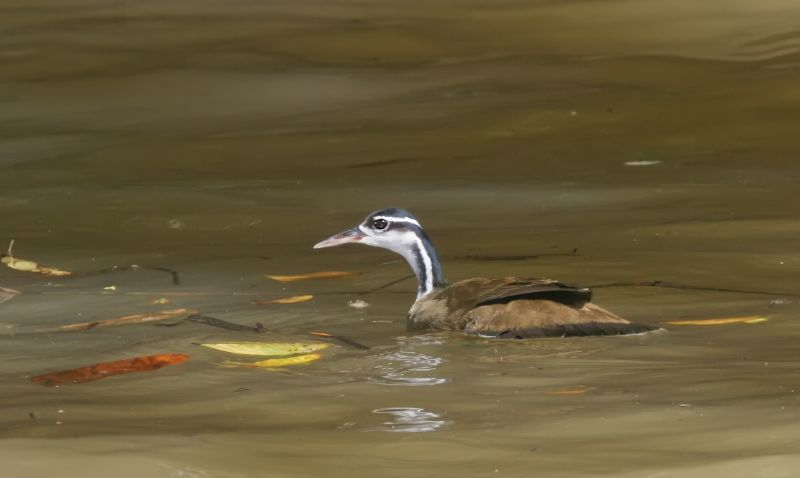
Wikipedia: Sungrebe
![]() The sungrebe (Heliornis fulica) is a small aquatic gruiforme found in the tropical and subtropical Americas from northeastern Mexico to central Ecuador and southern Brazil.[2]
[more]
The sungrebe (Heliornis fulica) is a small aquatic gruiforme found in the tropical and subtropical Americas from northeastern Mexico to central Ecuador and southern Brazil.[2]
[more]
Familie Eurypygidae (Sunbitterns):
Gattung Eurypyga:
Sonnenralle / Sunbittern (Eurypyga helias)
Profil Wikipedia Xeno-Canto

Wikipedia: Sunbittern
![]() The sunbittern (Eurypyga helias) is a bittern-like bird of tropical regions of the Americas, and the sole member of the family Eurypygidae (sometimes spelled Eurypigidae) and genus Eurypyga. It is found in Central and South America, and has three subspecies. The sunbittern shows both morphological and molecular similarities with the kagu (Rhynochetos jubatus) of New Caledonia, indicating a gondwanic origin, both species being placed in the clade Eurypygiformes.[3]
[more]
The sunbittern (Eurypyga helias) is a bittern-like bird of tropical regions of the Americas, and the sole member of the family Eurypygidae (sometimes spelled Eurypigidae) and genus Eurypyga. It is found in Central and South America, and has three subspecies. The sunbittern shows both morphological and molecular similarities with the kagu (Rhynochetos jubatus) of New Caledonia, indicating a gondwanic origin, both species being placed in the clade Eurypygiformes.[3]
[more]
Klasse Accipitriformes (Greifvögel / Hawks and eagles):
Familie Accipitridae (Habichtartige):
Unterfamilie Buteoninae (Bussardartige):
Gattung Buteo (Hawks):
Tikal roadside hawk. 2018-02-07 12.31.44 null
We saw this on the Pipeline Road near Gamboa, Panama - see tiger heron for more on that.
Allgemein: ![]() The roadside hawk (Rupornis magnirostris) is a relatively small bird of prey found in America. This vocal species is often the most common raptor in its range. It has many subspecies and is now usually placed in the monotypic genus Rupornis instead of Buteo.[2]
[more]
The roadside hawk (Rupornis magnirostris) is a relatively small bird of prey found in America. This vocal species is often the most common raptor in its range. It has many subspecies and is now usually placed in the monotypic genus Rupornis instead of Buteo.[2]
[more]
Profil Wikipedia Audubon Xeno-Canto

Wikipedia: Short-tailed hawk
![]() The short-tailed hawk (Buteo brachyurus) is an American bird of prey in the family Accipitridae, which also includes the eagles and Old World vultures. As a member of the genus Buteo, it is not a true hawk and thus also referred to as a "buteo" or (outside North America) "buzzard". The white-throated hawk (B. albigula) is a close relative and was formerly included in the species B. brachyurus.
[more]
The short-tailed hawk (Buteo brachyurus) is an American bird of prey in the family Accipitridae, which also includes the eagles and Old World vultures. As a member of the genus Buteo, it is not a true hawk and thus also referred to as a "buteo" or (outside North America) "buzzard". The white-throated hawk (B. albigula) is a close relative and was formerly included in the species B. brachyurus.
[more]

Wikipedia: Red-tailed hawk
![]() The red-tailed hawk (Buteo jamaicensis) is a bird of prey that breeds throughout most of North America, from the interior of Alaska and northern Canada to as far south as Panama and the West Indies. It is one of the most common members within the genus of Buteo in North America or worldwide.[2] The red-tailed hawk is one of three species colloquially known in the United States as the "chickenhawk", though it rarely preys on standard-sized chickens.[3] The bird is sometimes also referred to as the red-tail for short, when the meaning is clear in context. Red-tailed hawks can acclimate to all the biomes within their range, occurring on the edges of non-ideal habitats such as dense forests and sandy deserts.[4] The red-tailed hawk occupies a wide range of habitats and altitudes including deserts, grasslands, coniferous and deciduous forests, agricultural fields and urban areas. Its latitudinal limits fall around the tree line in the Arctic and the species is absent from the high Arctic. It is legally protected in Canada, Mexico, and the United States by the Migratory Bird Treaty Act.
[more]
The red-tailed hawk (Buteo jamaicensis) is a bird of prey that breeds throughout most of North America, from the interior of Alaska and northern Canada to as far south as Panama and the West Indies. It is one of the most common members within the genus of Buteo in North America or worldwide.[2] The red-tailed hawk is one of three species colloquially known in the United States as the "chickenhawk", though it rarely preys on standard-sized chickens.[3] The bird is sometimes also referred to as the red-tail for short, when the meaning is clear in context. Red-tailed hawks can acclimate to all the biomes within their range, occurring on the edges of non-ideal habitats such as dense forests and sandy deserts.[4] The red-tailed hawk occupies a wide range of habitats and altitudes including deserts, grasslands, coniferous and deciduous forests, agricultural fields and urban areas. Its latitudinal limits fall around the tree line in the Arctic and the species is absent from the high Arctic. It is legally protected in Canada, Mexico, and the United States by the Migratory Bird Treaty Act.
[more]
Profil Wikipedia Audubon Xeno-Canto

Wikipedia: Zone-tailed hawk
![]() The zone-tailed hawk (Buteo albonotatus) is a medium-sized hawk of warm, dry parts of the Americas. It is somewhat similar in plumage and flight style to a common scavenger, the turkey vulture, and may benefit from being able to blend into groups of vultures. It feeds on small terrestrial tetrapods of all kinds.
[more]
The zone-tailed hawk (Buteo albonotatus) is a medium-sized hawk of warm, dry parts of the Americas. It is somewhat similar in plumage and flight style to a common scavenger, the turkey vulture, and may benefit from being able to blend into groups of vultures. It feeds on small terrestrial tetrapods of all kinds.
[more]
Profil Wikipedia Audubon Xeno-Canto

Wikipedia: Gray hawk
![]() The gray hawk (Buteo plagiatus) or Mexican goshawk[2] is a smallish raptor found in open country and forest edges. It is sometimes placed in the genus Asturina as Asturina plagiata. The species was split by the American Ornithological Society (AOU) from the gray-lined hawk. The gray hawk is found from Costa Rica north into the southwestern United States.
[more]
The gray hawk (Buteo plagiatus) or Mexican goshawk[2] is a smallish raptor found in open country and forest edges. It is sometimes placed in the genus Asturina as Asturina plagiata. The species was split by the American Ornithological Society (AOU) from the gray-lined hawk. The gray hawk is found from Costa Rica north into the southwestern United States.
[more]
Wikipedia: Broad-winged hawk
![]() The broad-winged hawk (Buteo platypterus) is a medium-sized hawk of the genus Buteo. During the summer, some subspecies are distributed over eastern North America, as far west as British Columbia and Texas; they then migrate south to winter in the Neotropics from Mexico south to southern Brazil.[2] Other subspecies are all-year residents on Caribbean islands.[3] As in most raptors, females are slightly larger than males. Broad-winged hawks' wings are relatively short and broad with a tapered, somewhat pointed appearance. The two types of coloration are a dark morph with fewer white areas and a light morph that is more pale overall. Although the broad-winged hawk's numbers are relatively stable, populations are declining in some parts of its breeding range because of forest fragmentation.
[more]
The broad-winged hawk (Buteo platypterus) is a medium-sized hawk of the genus Buteo. During the summer, some subspecies are distributed over eastern North America, as far west as British Columbia and Texas; they then migrate south to winter in the Neotropics from Mexico south to southern Brazil.[2] Other subspecies are all-year residents on Caribbean islands.[3] As in most raptors, females are slightly larger than males. Broad-winged hawks' wings are relatively short and broad with a tapered, somewhat pointed appearance. The two types of coloration are a dark morph with fewer white areas and a light morph that is more pale overall. Although the broad-winged hawk's numbers are relatively stable, populations are declining in some parts of its breeding range because of forest fragmentation.
[more]

Wikipedia: Swainson's hawk
![]() Swainson's hawk (Buteo swainsoni) is a large birds species in the Accipitriformes order. This species was named after William Swainson, a British naturalist. It is colloquially known as the grasshopper hawk or locust hawk, as it is very fond of Acrididae (locusts and grasshoppers) and will voraciously eat these insects whenever they are available.
[more]
Swainson's hawk (Buteo swainsoni) is a large birds species in the Accipitriformes order. This species was named after William Swainson, a British naturalist. It is colloquially known as the grasshopper hawk or locust hawk, as it is very fond of Acrididae (locusts and grasshoppers) and will voraciously eat these insects whenever they are available.
[more]
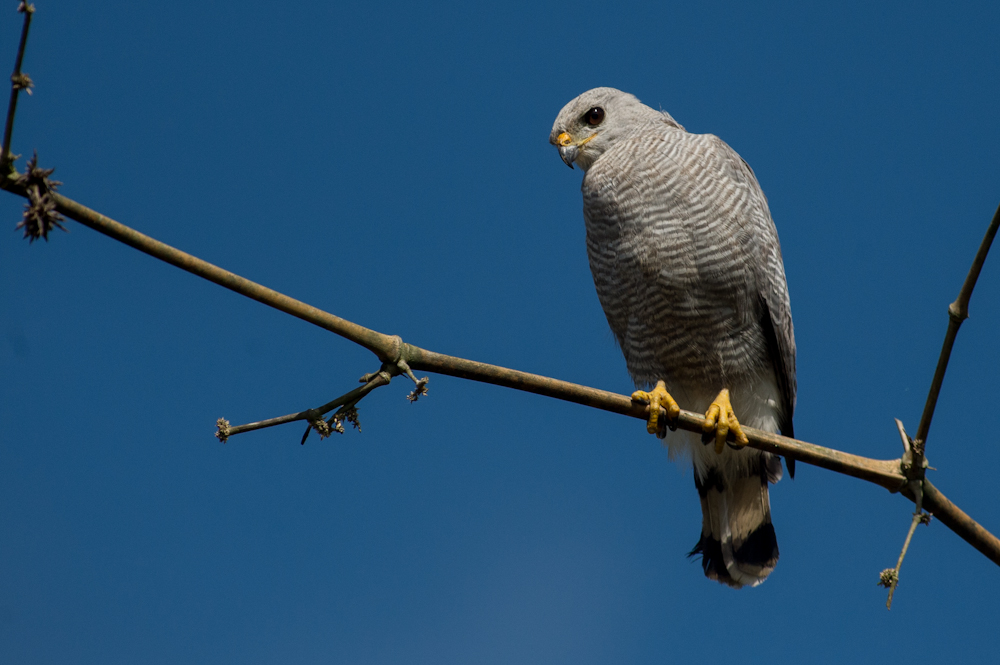
Wikipedia: Grey-lined hawk
![]() The gray-lined hawk (Buteo nitidus) is a smallish raptor found in open country and forest edges. It is sometimes placed in the genus Asturina as Asturina nitida. The species has been split by the American Ornithological Society from the gray hawk. The gray-lined hawk is found from El Salvador to Argentina.
[more]
The gray-lined hawk (Buteo nitidus) is a smallish raptor found in open country and forest edges. It is sometimes placed in the genus Asturina as Asturina nitida. The species has been split by the American Ornithological Society from the gray hawk. The gray-lined hawk is found from El Salvador to Argentina.
[more]
Unterfamilie Accipitrinae (Bussardartige / True hawks):
Gattung Accipiter:

Wikipedia: Cooper's hawk
![]() Cooper's hawk (Accipiter cooperii) is a medium-sized hawk native to the North American continent and found from southern Canada to Mexico.[2] This species is a member of the genus Accipiter, sometimes referred to as true hawks, which are famously agile, relatively small hawks common to wooded habitats around the world and also the most diverse of all diurnal raptor genera.[2] As in many birds of prey, the male is smaller than the female.[3] The birds found east of the Mississippi River tend to be larger on average than the birds found to the west.[4] It is easily confused with the smaller but similar Sharp-shinned hawk.
[more]
Cooper's hawk (Accipiter cooperii) is a medium-sized hawk native to the North American continent and found from southern Canada to Mexico.[2] This species is a member of the genus Accipiter, sometimes referred to as true hawks, which are famously agile, relatively small hawks common to wooded habitats around the world and also the most diverse of all diurnal raptor genera.[2] As in many birds of prey, the male is smaller than the female.[3] The birds found east of the Mississippi River tend to be larger on average than the birds found to the west.[4] It is easily confused with the smaller but similar Sharp-shinned hawk.
[more]
Profil Wikipedia Audubon Xeno-Canto

Wikipedia: Sharp-shinned hawk
![]() A. s. chionogaster
A. s. chionogaster
A. s. erythronemius
A. s. fringilloides
A. s. madrensis
A. s. perobscurus
A. s. striatus
A. s. suttoni
A. s. velox
A. s. venator
A. s. ventralis
[more]

Wikipedia: Tiny hawk
![]() The tiny hawk (Accipiter superciliosus) is a small diurnal bird of prey found in or near forests, primarily humid, throughout much of the Neotropics. It is primarily a bird-eater, and is known to prey on hummingbirds.
[more]
The tiny hawk (Accipiter superciliosus) is a small diurnal bird of prey found in or near forests, primarily humid, throughout much of the Neotropics. It is primarily a bird-eater, and is known to prey on hummingbirds.
[more]

Wikipedia: Bicolored hawk
![]() The bicolored hawk (Accipiter bicolor) is a species of bird of prey in the family Accipitridae. It is found in forest, woodland, second growth, plantations, and wooded savanna in southeastern Mexico, Central America, and northern and central South America (as far south as northern Argentina).[3] Though generally uncommon, it is the most common species of Accipiter in most of its range, but it does not occur at altitudes above 2,700 metres (8,900 ft) such as the highest parts of the Andes.[4]
[more]
The bicolored hawk (Accipiter bicolor) is a species of bird of prey in the family Accipitridae. It is found in forest, woodland, second growth, plantations, and wooded savanna in southeastern Mexico, Central America, and northern and central South America (as far south as northern Argentina).[3] Though generally uncommon, it is the most common species of Accipiter in most of its range, but it does not occur at altitudes above 2,700 metres (8,900 ft) such as the highest parts of the Andes.[4]
[more]

Wikipedia: Gray-bellied hawk
![]() The grey-bellied hawk or grey-bellied goshawk (Accipiter poliogaster) is a fairly large and rare species of forest-dwelling South American bird of prey in the family Accipitridae.
[more]
The grey-bellied hawk or grey-bellied goshawk (Accipiter poliogaster) is a fairly large and rare species of forest-dwelling South American bird of prey in the family Accipitridae.
[more]
Gattung Gampsonyx:
Profil Wikipedia Xeno-Canto

Wikipedia: Pearl kite
![]() The pearl kite (Gampsonyx swainsonii) is a very small raptor found in open savanna habitat adjacent to deciduous woodland. It is the only member of the genus Gampsonyx. The scientific name commemorates the English naturalist William Swainson.
[more]
The pearl kite (Gampsonyx swainsonii) is a very small raptor found in open savanna habitat adjacent to deciduous woodland. It is the only member of the genus Gampsonyx. The scientific name commemorates the English naturalist William Swainson.
[more]
Gattung Rostrhamus:
Profil Wikipedia Audubon Xeno-Canto

Wikipedia: Snail kite
![]() The snail kite (Rostrhamus sociabilis) is a bird of prey within the family Accipitridae, which also includes the eagles, hawks, and Old World vultures. Its relative, the slender-billed kite, is now again placed in Helicolestes, making the genus Rostrhamus monotypic. Usually, it is placed in the milvine kites, but the validity of that group is under investigation.
[more]
The snail kite (Rostrhamus sociabilis) is a bird of prey within the family Accipitridae, which also includes the eagles, hawks, and Old World vultures. Its relative, the slender-billed kite, is now again placed in Helicolestes, making the genus Rostrhamus monotypic. Usually, it is placed in the milvine kites, but the validity of that group is under investigation.
[more]
Gattung Elanoides:
Profil Wikipedia Audubon Xeno-Canto

Wikipedia: Swallow-tailed kite
![]() The swallow-tailed kite (Elanoides forficatus) is a pernine raptor which breeds from the southeastern United States to eastern Peru and northern Argentina. It is the only species in the genus Elanoides. Most North and Central American breeders winter in South America where the species is resident year round.
[more]
The swallow-tailed kite (Elanoides forficatus) is a pernine raptor which breeds from the southeastern United States to eastern Peru and northern Argentina. It is the only species in the genus Elanoides. Most North and Central American breeders winter in South America where the species is resident year round.
[more]
Gattung Harpia:
Profil Wikipedia Xeno-Canto

Wikipedia: Harpy eagle
![]() The harpy eagle (Harpia harpyja) is a neotropical species of eagle. It is also called the American harpy eagle to distinguish it from the Papuan eagle, which is sometimes known as the New Guinea harpy eagle or Papuan harpy eagle.[3] It is the largest and most powerful raptor found throughout its range,[4] and among the largest extant species of eagles in the world. It usually inhabits tropical lowland rainforests in the upper (emergent) canopy layer. Destruction of its natural habitat has caused it to vanish from many parts of its former range, and it is nearly extirpated from much of Central America. In Brazil, the harpy eagle is also known as royal-hawk (in Portuguese: gavião-real).[5] The genus Harpia, together with Harpyopsis and Morphnus form the subfamily Harpiinae.
[more]
The harpy eagle (Harpia harpyja) is a neotropical species of eagle. It is also called the American harpy eagle to distinguish it from the Papuan eagle, which is sometimes known as the New Guinea harpy eagle or Papuan harpy eagle.[3] It is the largest and most powerful raptor found throughout its range,[4] and among the largest extant species of eagles in the world. It usually inhabits tropical lowland rainforests in the upper (emergent) canopy layer. Destruction of its natural habitat has caused it to vanish from many parts of its former range, and it is nearly extirpated from much of Central America. In Brazil, the harpy eagle is also known as royal-hawk (in Portuguese: gavião-real).[5] The genus Harpia, together with Harpyopsis and Morphnus form the subfamily Harpiinae.
[more]
Gattung Spizaetus:
Profil Wikipedia Xeno-Canto
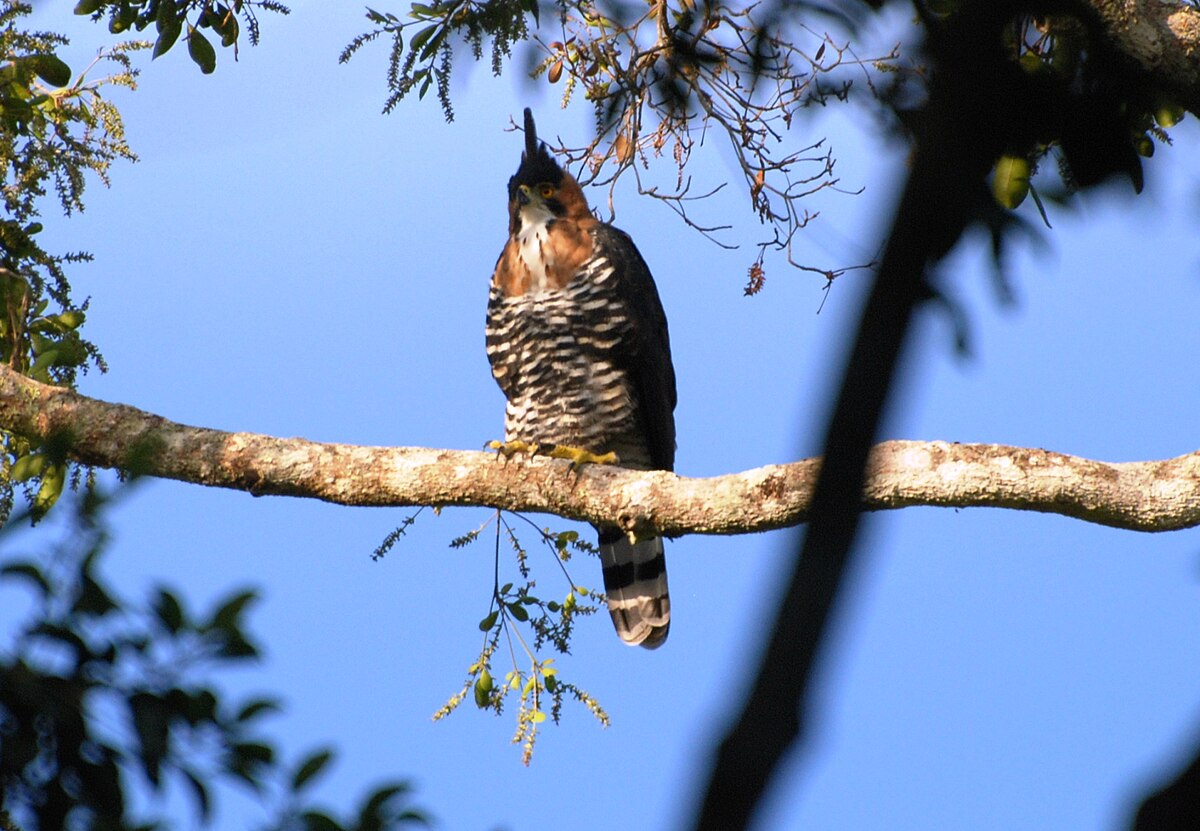
Wikipedia: Ornate hawk-eagle
![]() The ornate hawk-eagle (Spizaetus ornatus) is a fairly large bird of prey from the tropical Americas. Formerly, some authorities referred to this species as the crested hawk-eagle, a name that may cause some confusion as it is more commonly used for an Asian eagle species.[3] Like all eagles, it is in the family Accipitridae. This species has a feathered tarsus that marks it as a member of the Aquilinae or booted eagle subfamily.[4] This species is notable for the vivid colors and bold markings of adults, which differ considerably from the far more whitish plumage of the juvenile bird.[5] The ornate hawk-eagle ranges from central Mexico south through much of Central America and in a somewhat spotty but broad overall range into South America, including in the west apart from the Andes and broadly on the Atlantic side especially Brazil down to as far as Southeast Brazil and northern Argentina.[1][6] This species is found largely in primary forests with tall trees, although can be found in many forest types.[6] The ornate hawk-eagle female lays almost always a single egg and the species has a fairly prolonged breeding cycle like many tropical raptors, especially due to a lengthy post-fledging stage on which juveniles are dependent on their parents.[7] It is a diversified and exceptionally powerful predator which takes a range of prey, usually various medium-to-large-sized birds and small-to-medium-sized mammals as well as occasional reptiles.[8] Like many forest-dependent raptors, especially those in the tropical and subtropical regions, this species is likely under the pressing threat of deforestation. The decline of forest habitat in this species range, especially the Amazon rainforest, led the IUCN to uplist the ornate hawk-eagle as Near Threatened in 2016.[1]
[more]
The ornate hawk-eagle (Spizaetus ornatus) is a fairly large bird of prey from the tropical Americas. Formerly, some authorities referred to this species as the crested hawk-eagle, a name that may cause some confusion as it is more commonly used for an Asian eagle species.[3] Like all eagles, it is in the family Accipitridae. This species has a feathered tarsus that marks it as a member of the Aquilinae or booted eagle subfamily.[4] This species is notable for the vivid colors and bold markings of adults, which differ considerably from the far more whitish plumage of the juvenile bird.[5] The ornate hawk-eagle ranges from central Mexico south through much of Central America and in a somewhat spotty but broad overall range into South America, including in the west apart from the Andes and broadly on the Atlantic side especially Brazil down to as far as Southeast Brazil and northern Argentina.[1][6] This species is found largely in primary forests with tall trees, although can be found in many forest types.[6] The ornate hawk-eagle female lays almost always a single egg and the species has a fairly prolonged breeding cycle like many tropical raptors, especially due to a lengthy post-fledging stage on which juveniles are dependent on their parents.[7] It is a diversified and exceptionally powerful predator which takes a range of prey, usually various medium-to-large-sized birds and small-to-medium-sized mammals as well as occasional reptiles.[8] Like many forest-dependent raptors, especially those in the tropical and subtropical regions, this species is likely under the pressing threat of deforestation. The decline of forest habitat in this species range, especially the Amazon rainforest, led the IUCN to uplist the ornate hawk-eagle as Near Threatened in 2016.[1]
[more]
Profil Wikipedia Xeno-Canto

Wikipedia: Black hawk-eagle
![]() The black hawk-eagle (Spizaetus tyrannus), also known as the tyrant hawk-eagle,[3] is a species of eagle found from central Mexico through Central America[4] into Colombia, eastern Peru, the south of Brazil, and as far as northern Argentina.[5] There are two known subspecies, S.t. tyrannus, which is found in Southeastern Brazil and Northeastern Argentina, and the slightly smaller S. t. serus, which can be found elsewhere throughout the species' range.[6] Its preferred habitats include humid and moist forests close to rivers, and several types of woodland.[7] It is uncommon to fairly common throughout most of its range. Its closest relative is the ornate hawk-eagle, which is similar in size, appearance and behavior but lives at lower elevations.
[more]
The black hawk-eagle (Spizaetus tyrannus), also known as the tyrant hawk-eagle,[3] is a species of eagle found from central Mexico through Central America[4] into Colombia, eastern Peru, the south of Brazil, and as far as northern Argentina.[5] There are two known subspecies, S.t. tyrannus, which is found in Southeastern Brazil and Northeastern Argentina, and the slightly smaller S. t. serus, which can be found elsewhere throughout the species' range.[6] Its preferred habitats include humid and moist forests close to rivers, and several types of woodland.[7] It is uncommon to fairly common throughout most of its range. Its closest relative is the ornate hawk-eagle, which is similar in size, appearance and behavior but lives at lower elevations.
[more]
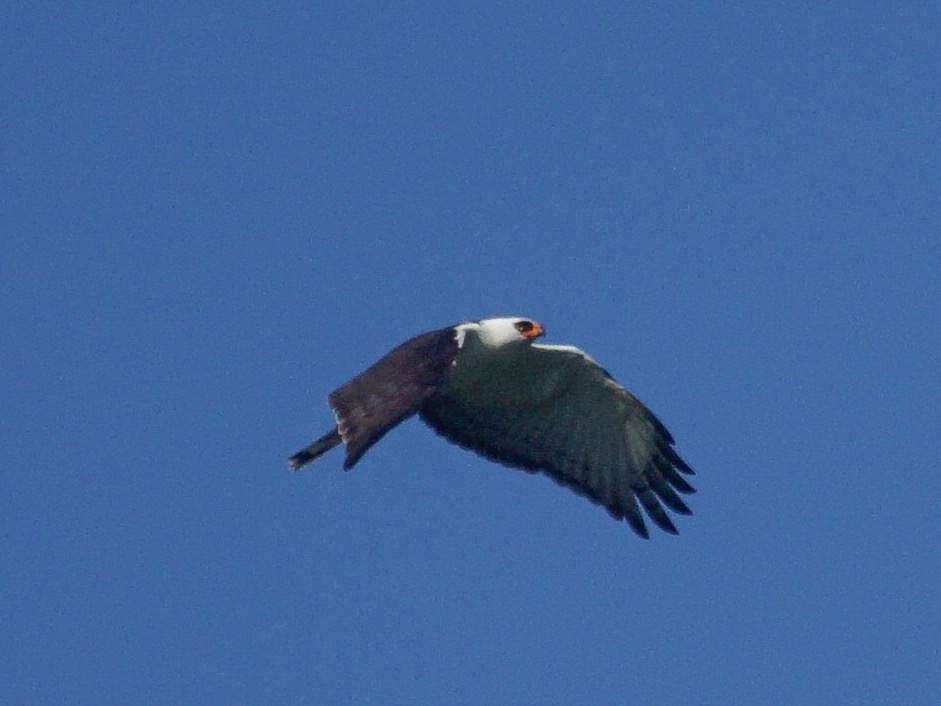
Wikipedia: Black-and-white hawk-eagle
![]() The black-and-white hawk-eagle (Spizaetus melanoleucus, formerly Spizastur melanoleucus) is a bird of prey species in the eagle and hawk family (Accipitridae). It is found throughout a large part of tropical America, from southern Mexico to northern Argentina.[2]
[more]
The black-and-white hawk-eagle (Spizaetus melanoleucus, formerly Spizastur melanoleucus) is a bird of prey species in the eagle and hawk family (Accipitridae). It is found throughout a large part of tropical America, from southern Mexico to northern Argentina.[2]
[more]
Gattung Parabuteo:
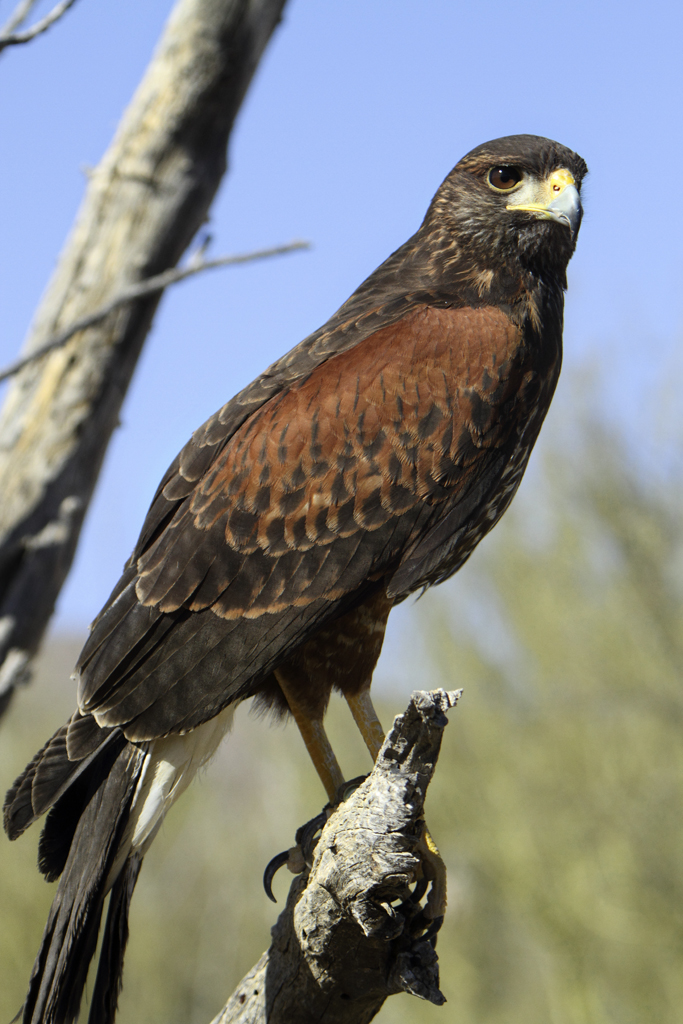
Wikipedia: Harris's hawk
![]() Harris's hawk (Parabuteo unicinctus), formerly known as the bay-winged hawk or dusky hawk, and known in Latin America as peuco, is a medium-large bird of prey that breeds from the southwestern United States south to Chile, central Argentina, and Brazil. Birds are sometimes reported at large in Western Europe, especially Britain, but it is a popular species in falconry and these records almost certainly all refer to escapes from captivity.
[more]
Harris's hawk (Parabuteo unicinctus), formerly known as the bay-winged hawk or dusky hawk, and known in Latin America as peuco, is a medium-large bird of prey that breeds from the southwestern United States south to Chile, central Argentina, and Brazil. Birds are sometimes reported at large in Western Europe, especially Britain, but it is a popular species in falconry and these records almost certainly all refer to escapes from captivity.
[more]
Gattung Buteogallus:
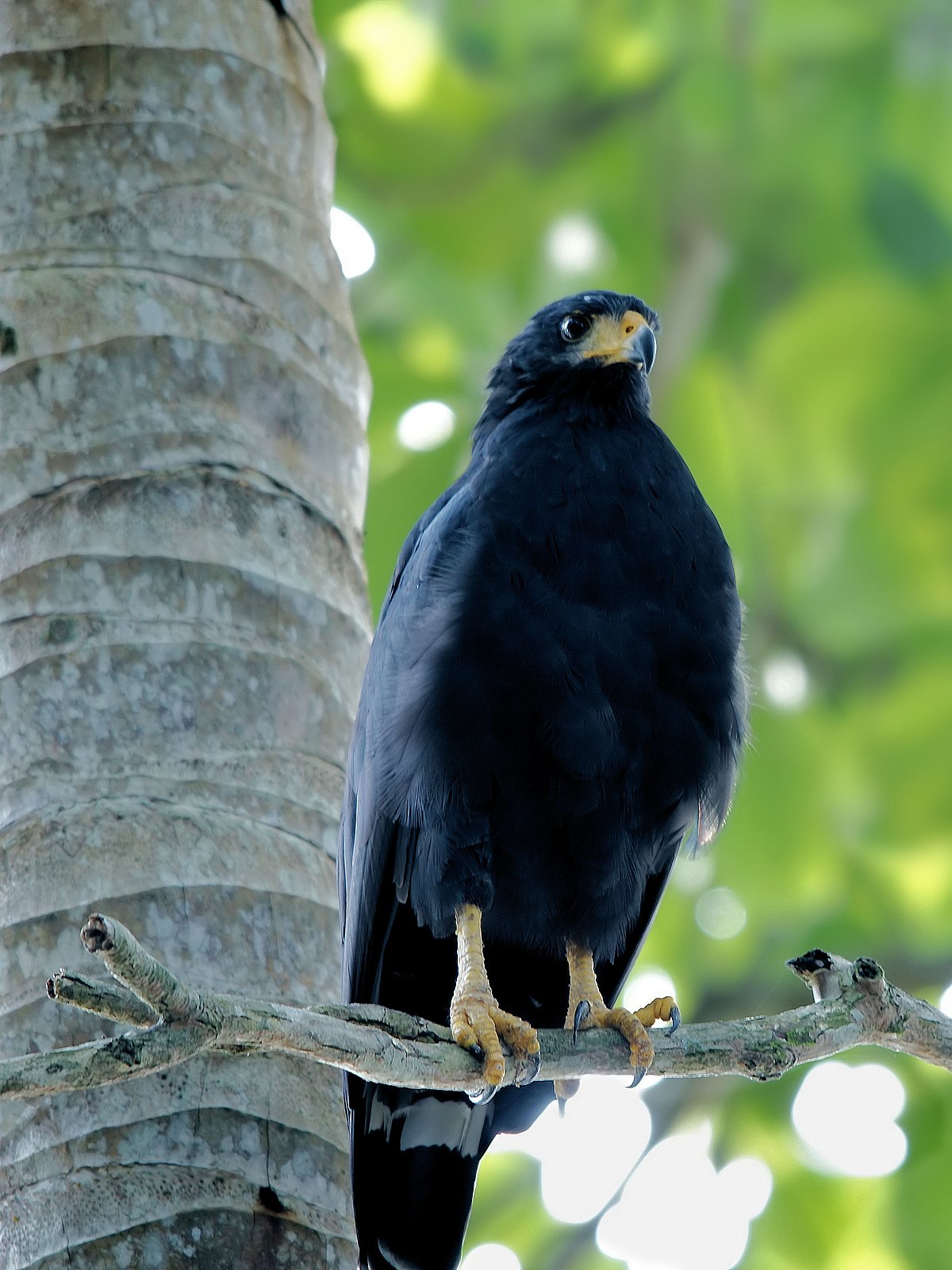
Wikipedia: Common black hawk
![]() The common black hawk (Buteogallus anthracinus) is a bird of prey in the family Accipitridae, which also includes the eagles, hawks, and Old World vultures. It formerly included the Cuban black-hawk (Buteogallus gundlachii) as a subspecies. The mangrove black hawk, traditionally considered a distinct species, is now generally considered a subspecies, B. a. subtilis, of the common black-hawk.[3]
[more]
The common black hawk (Buteogallus anthracinus) is a bird of prey in the family Accipitridae, which also includes the eagles, hawks, and Old World vultures. It formerly included the Cuban black-hawk (Buteogallus gundlachii) as a subspecies. The mangrove black hawk, traditionally considered a distinct species, is now generally considered a subspecies, B. a. subtilis, of the common black-hawk.[3]
[more]

Wikipedia: Savanna hawk
![]() The savanna hawk (Buteogallus meridionalis) is a large raptor found in open savanna and swamp edges. It was formerly placed in the genus Heterospizias. It breeds from Panama and Trinidad south to Bolivia, Uruguay and central Argentina.[2]
[more]
The savanna hawk (Buteogallus meridionalis) is a large raptor found in open savanna and swamp edges. It was formerly placed in the genus Heterospizias. It breeds from Panama and Trinidad south to Bolivia, Uruguay and central Argentina.[2]
[more]
Profil Wikipedia Xeno-Canto
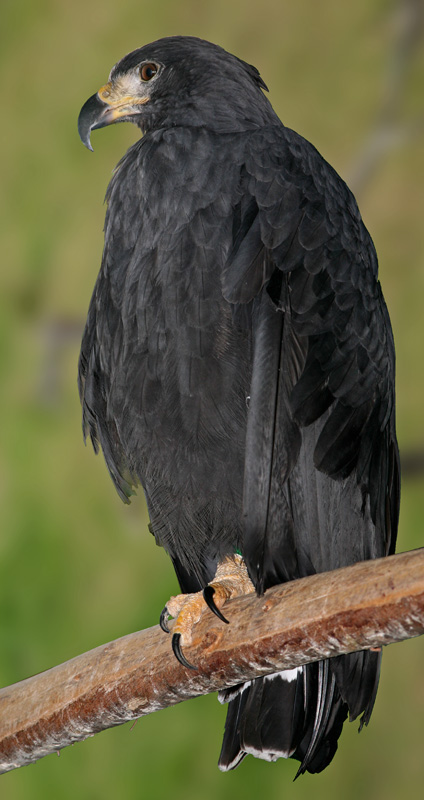
Wikipedia: Solitary eagle
![]() The solitary eagle or montane solitary eagle (Buteogallus solitarius) is a large Neotropical eagle. It is also known as the black solitary eagle.
[more]
The solitary eagle or montane solitary eagle (Buteogallus solitarius) is a large Neotropical eagle. It is also known as the black solitary eagle.
[more]

Wikipedia: Great black-hawk
![]() The great black hawk (Buteogallus urubitinga) is a bird of prey in the family Accipitridae, which also includes the eagles, hawks, and Old World vultures.
[more]
The great black hawk (Buteogallus urubitinga) is a bird of prey in the family Accipitridae, which also includes the eagles, hawks, and Old World vultures.
[more]
Gattung Geranoaetus:
Profil Wikipedia Audubon Xeno-Canto

Wikipedia: White-tailed hawk
![]() The white-tailed hawk (Geranoaetus albicaudatus) is a large bird of prey species found in tropical and subtropical environments of the Americas.
[more]
The white-tailed hawk (Geranoaetus albicaudatus) is a large bird of prey species found in tropical and subtropical environments of the Americas.
[more]
Gattung Busarellus:

Wikipedia: Black-collared hawk
![]() The black-collared hawk (Busarellus nigricollis) is a species of bird of prey in the family Accipitridae. It is monotypic within the genus Busarellus.[3] It has a widespread range of presence, from western Mexico to Uruguay. Its natural habitats are subtropical or tropical moist lowland forests, subtropical or tropical swamps, and swamps.[1]
[more]
The black-collared hawk (Busarellus nigricollis) is a species of bird of prey in the family Accipitridae. It is monotypic within the genus Busarellus.[3] It has a widespread range of presence, from western Mexico to Uruguay. Its natural habitats are subtropical or tropical moist lowland forests, subtropical or tropical swamps, and swamps.[1]
[more]
Gattung Morphnus:
Profil Wikipedia Xeno-Canto
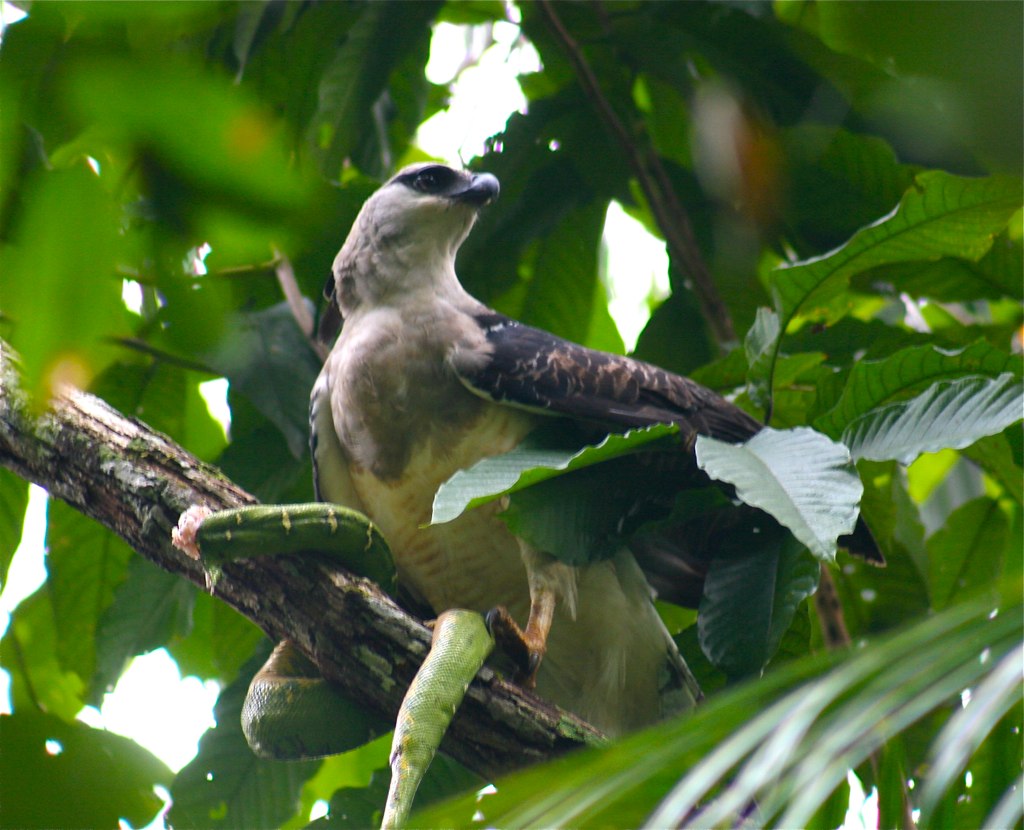
Wikipedia: Crested eagle
![]() The crested eagle (Morphnus guianensis) is a large Neotropical eagle.
[more]
The crested eagle (Morphnus guianensis) is a large Neotropical eagle.
[more]
Gattung Elanus:
Profil Wikipedia Audubon Xeno-Canto

Wikipedia: White-tailed kite
![]() The white-tailed kite (Elanus leucurus) is a small raptor found in western North America and parts of South America.
[more]
The white-tailed kite (Elanus leucurus) is a small raptor found in western North America and parts of South America.
[more]
Gattung Chondrohierax:
Profil Wikipedia Audubon Xeno-Canto

Wikipedia: Hook-billed kite
![]() The hook-billed kite (Chondrohierax uncinatus), is a bird of prey in the family Accipitridae, which also includes many other diurnal raptors such as kites, eagles, and harriers. It occurs in the Americas, including the Rio Grande Valley of Texas in the United States, Mexico, the Caribbean, Central America, and tropical South America.
[more]
The hook-billed kite (Chondrohierax uncinatus), is a bird of prey in the family Accipitridae, which also includes many other diurnal raptors such as kites, eagles, and harriers. It occurs in the Americas, including the Rio Grande Valley of Texas in the United States, Mexico, the Caribbean, Central America, and tropical South America.
[more]
Gattung Leptodon:
Profil Wikipedia Xeno-Canto
Wikipedia: Gray-headed kite
![]() The gray-headed kite (Leptodon cayanensis) is a raptor found in open woodland and swamp forests. It shares the genus Leptodon with the extremely rare white-collared kite. It breeds from eastern Mexico and Trinidad south to Peru, Bolivia, Brazil and northern Argentina.
[more]
The gray-headed kite (Leptodon cayanensis) is a raptor found in open woodland and swamp forests. It shares the genus Leptodon with the extremely rare white-collared kite. It breeds from eastern Mexico and Trinidad south to Peru, Bolivia, Brazil and northern Argentina.
[more]
Gattung Leucopternis:
Profil Wikipedia Xeno-Canto

Wikipedia: Semiplumbeous hawk
![]() The semiplumbeous hawk (Leucopternis semiplumbeus) is a species of bird of prey in the family Accipitridae. It is found in Colombia, Costa Rica, Ecuador, Honduras, and Panama. Its natural habitat is subtropical or tropical moist lowland forests.
[more]
The semiplumbeous hawk (Leucopternis semiplumbeus) is a species of bird of prey in the family Accipitridae. It is found in Colombia, Costa Rica, Ecuador, Honduras, and Panama. Its natural habitat is subtropical or tropical moist lowland forests.
[more]
Gattung Ictinia:
Profil Wikipedia Audubon Xeno-Canto

Wikipedia: Mississippi kite
![]() The Mississippi kite (Ictinia mississippiensis) is a small bird of prey in the family Accipitridae. Mississippi kites have narrow, pointed wings and are graceful in flight, often appearing to float in the air. It is not uncommon to see several circling in the same area.
[more]
The Mississippi kite (Ictinia mississippiensis) is a small bird of prey in the family Accipitridae. Mississippi kites have narrow, pointed wings and are graceful in flight, often appearing to float in the air. It is not uncommon to see several circling in the same area.
[more]
Profil Wikipedia Xeno-Canto

Wikipedia: Plumbeous kite
![]() The plumbeous kite (Ictinia plumbea) is a bird of prey in the family Accipitridae.
[more]
The plumbeous kite (Ictinia plumbea) is a bird of prey in the family Accipitridae.
[more]
Gattung Geranospiza:
Profil Wikipedia Xeno-Canto

Wikipedia: Crane hawk
![]() The crane hawk (Geranospiza caerulescens) is a species of bird of prey in the family Accipitridae. It is monotypic within the genus Geranospiza.[2]
[more]
The crane hawk (Geranospiza caerulescens) is a species of bird of prey in the family Accipitridae. It is monotypic within the genus Geranospiza.[2]
[more]
Gattung Harpagus:
Profil Wikipedia Xeno-Canto
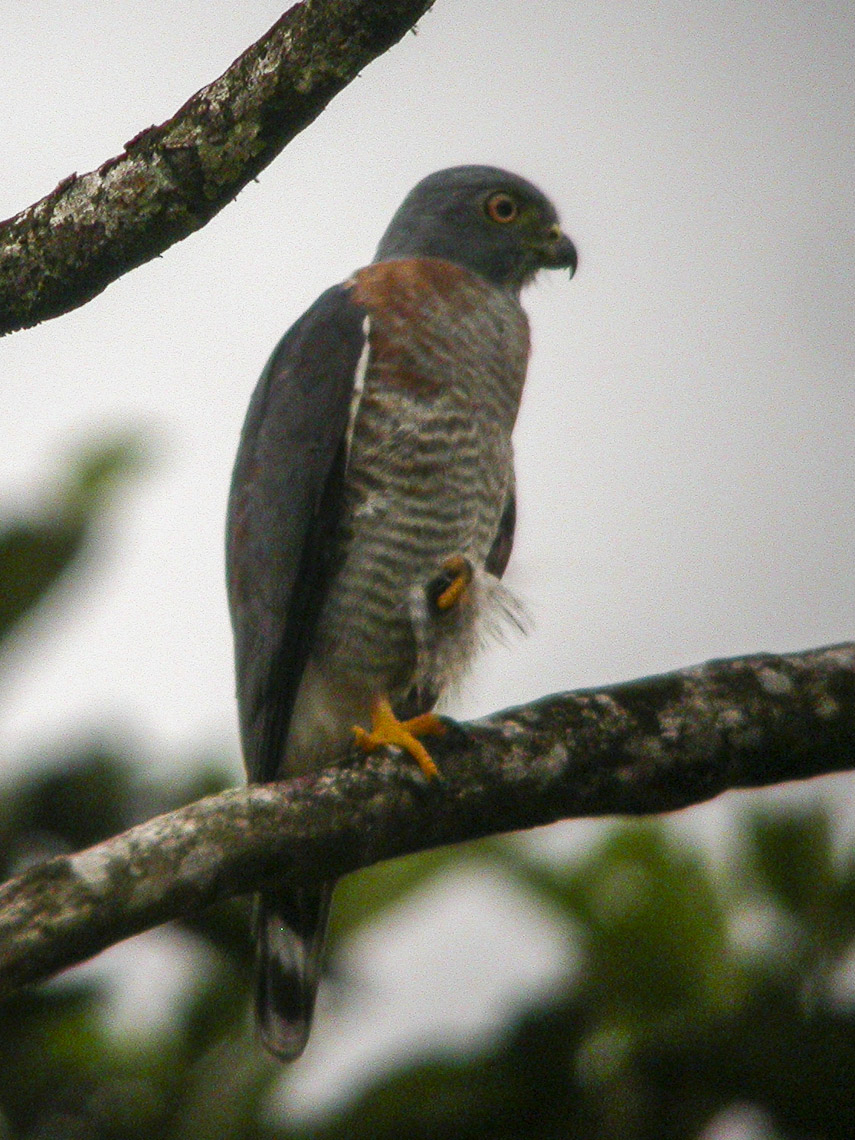
Wikipedia: Double-toothed kite
![]() The double-toothed kite (Harpagus bidentatus) is a species of bird of prey in the family Accipitridae. It is found in Belize, Bolivia, Brazil, Colombia, Costa Rica, Ecuador, El Salvador, French Guiana, Guatemala, Guyana, Honduras, Mexico, Nicaragua, Panama, Peru, Suriname, Trinidad and Tobago, and Venezuela.[1]
[more]
The double-toothed kite (Harpagus bidentatus) is a species of bird of prey in the family Accipitridae. It is found in Belize, Bolivia, Brazil, Colombia, Costa Rica, Ecuador, El Salvador, French Guiana, Guatemala, Guyana, Honduras, Mexico, Nicaragua, Panama, Peru, Suriname, Trinidad and Tobago, and Venezuela.[1]
[more]
Familie Cathartidae:
Gattung Cathartes:
Cathartes aura / Turkey vulture (Cathartes aura)
Profil Wikipedia Audubon Xeno-Canto
Arenal hike turkey vultures. 2018-02-28 11.30.14 null
![]() The turkey vulture (Cathartes aura), also known in some North American regions as the turkey buzzard (or just buzzard), and in some areas of the Caribbean as the John crow or carrion crow,[2] is the most widespread of the New World vultures.[3] One of three species in the genus Cathartes of the family Cathartidae, the turkey vulture ranges from southern Canada to the southernmost tip of South America. It inhabits a variety of open and semi-open areas, including subtropical forests, shrublands, pastures, and deserts.[1]
[more]
The turkey vulture (Cathartes aura), also known in some North American regions as the turkey buzzard (or just buzzard), and in some areas of the Caribbean as the John crow or carrion crow,[2] is the most widespread of the New World vultures.[3] One of three species in the genus Cathartes of the family Cathartidae, the turkey vulture ranges from southern Canada to the southernmost tip of South America. It inhabits a variety of open and semi-open areas, including subtropical forests, shrublands, pastures, and deserts.[1]
[more]
Kleiner Gelbkopfgeier / Lesser yellow-headed vulture (Cathartes burrovianus)
Profil Wikipedia Xeno-Canto
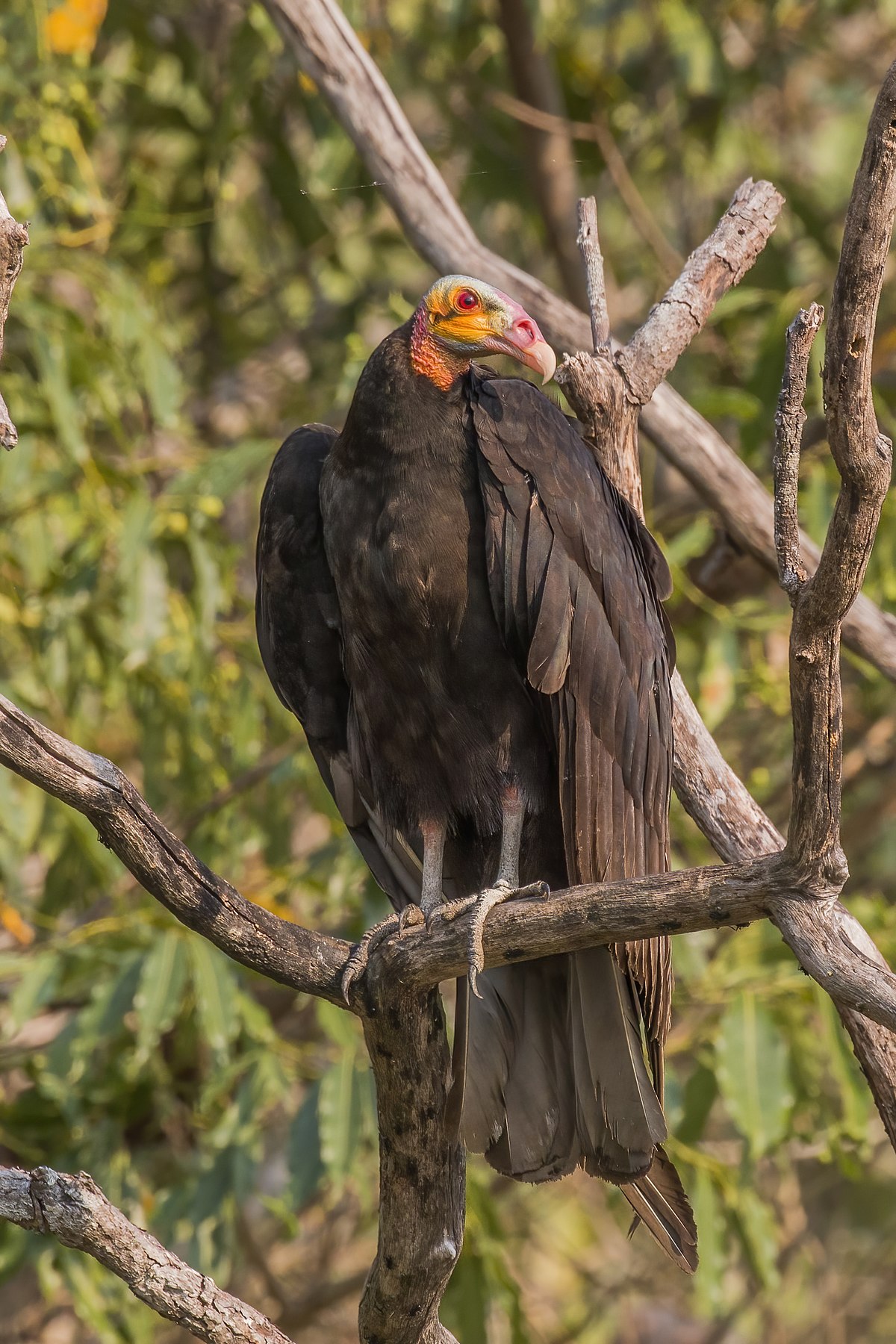
Wikipedia: Lesser yellow-headed vulture
![]() The lesser yellow-headed vulture (Cathartes burrovianus) also known as the savannah vulture,[2] is a species of bird in the New World vulture family Cathartidae. It was considered to be the same species as the greater yellow-headed vulture until they were split in 1964.[3] It is found in Mexico, Central America, and South America in seasonally wet or flooded lowland grassland, swamps, and heavily degraded former forest. It is a large bird, with a wingspan of 150–165 cm (59–65 in). The body plumage is black, and the head and neck, which are featherless, are pale orange with red or blue areas. It lacks a syrinx, so therefore its vocalizations are limited to grunts or low hisses.
[more]
The lesser yellow-headed vulture (Cathartes burrovianus) also known as the savannah vulture,[2] is a species of bird in the New World vulture family Cathartidae. It was considered to be the same species as the greater yellow-headed vulture until they were split in 1964.[3] It is found in Mexico, Central America, and South America in seasonally wet or flooded lowland grassland, swamps, and heavily degraded former forest. It is a large bird, with a wingspan of 150–165 cm (59–65 in). The body plumage is black, and the head and neck, which are featherless, are pale orange with red or blue areas. It lacks a syrinx, so therefore its vocalizations are limited to grunts or low hisses.
[more]
Gattung Coragyps:
Rabengeier / Black vulture (Coragyps atratus)

Wikipedia: Black vulture
![]() The black vulture (Coragyps atratus), also known as the American black vulture, is a bird in the New World vulture family whose range extends from the northeastern United States to Peru, Central Chile and Uruguay in South America. Although a common and widespread species, it has a somewhat more restricted distribution than its compatriot, the turkey vulture, which breeds well into Canada and south to Tierra del Fuego. It is the only extant member of the genus Coragyps, which is in the family Cathartidae. Despite the similar name and appearance, this species is unrelated to the Eurasian black vulture, an Old World vulture in the family Accipitridae (which includes eagles, hawks, kites, and harriers). It inhabits relatively open areas which provide scattered forests or shrublands. With a wingspan of 1.5 m (4.9 ft), the black vulture is a large bird though relatively small for a vulture. It has black plumage, a featherless, grayish-black head and neck, and a short, hooked beak.
[more]
The black vulture (Coragyps atratus), also known as the American black vulture, is a bird in the New World vulture family whose range extends from the northeastern United States to Peru, Central Chile and Uruguay in South America. Although a common and widespread species, it has a somewhat more restricted distribution than its compatriot, the turkey vulture, which breeds well into Canada and south to Tierra del Fuego. It is the only extant member of the genus Coragyps, which is in the family Cathartidae. Despite the similar name and appearance, this species is unrelated to the Eurasian black vulture, an Old World vulture in the family Accipitridae (which includes eagles, hawks, kites, and harriers). It inhabits relatively open areas which provide scattered forests or shrublands. With a wingspan of 1.5 m (4.9 ft), the black vulture is a large bird though relatively small for a vulture. It has black plumage, a featherless, grayish-black head and neck, and a short, hooked beak.
[more]
Gattung Sarcoramphus:
Königsgeier / King vulture (Sarcoramphus papa)

Wikipedia: King vulture
![]() The king vulture (Sarcoramphus papa) is a large bird found in Central and South America. It is a member of the New World vulture family Cathartidae. This vulture lives predominantly in tropical lowland forests stretching from southern Mexico to northern Argentina. It is the only surviving member of the genus Sarcoramphus, although fossil members are known.
[more]
The king vulture (Sarcoramphus papa) is a large bird found in Central and South America. It is a member of the New World vulture family Cathartidae. This vulture lives predominantly in tropical lowland forests stretching from southern Mexico to northern Argentina. It is the only surviving member of the genus Sarcoramphus, although fossil members are known.
[more]
Familie Pandionidae (Fischadler):
Gattung Pandion:
Fischadler / Osprey (Pandion haliaetus)
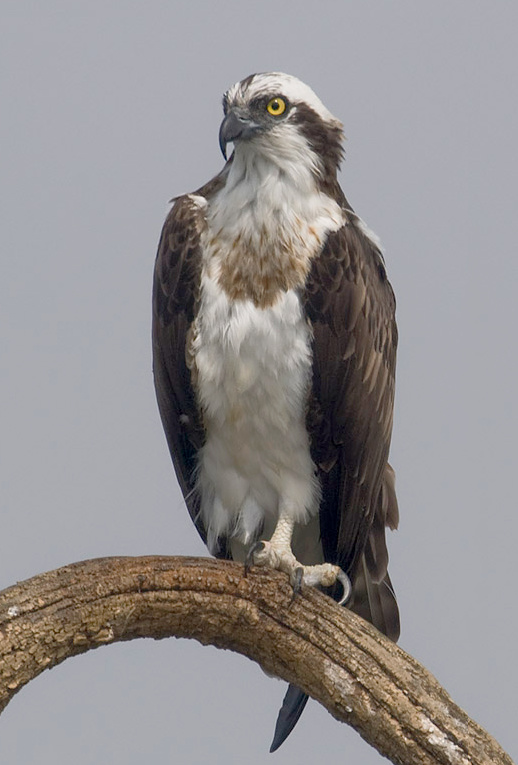
Wikipedia: Osprey
Dieser Vogel erscheint jenseits grossen Meere in Kontinenten :
Europa, Nordamerika, Südamerika, Afrika.
![]() Falco haliaetus Linnaeus, 1758
[more]
Falco haliaetus Linnaeus, 1758
[more]
Rufe: ![]() Calls with sequences of short, soft and clear whistling notes. Often in series with rising pitch, then ending with a few lower pitched notes. [Link]
Calls with sequences of short, soft and clear whistling notes. Often in series with rising pitch, then ending with a few lower pitched notes. [Link]
Körperlich: Länge=55-58 cm,
Flügelspanne=145-170 cm,
Gewicht=1120-2050 g
Überordnung Palaeognathae:
Ordnung Tinamiformes (Tinamous):
Familie Tinamidae:
Gattung Tinamus:
Profil Wikipedia Xeno-Canto
La tarde great tinamou tenative ID by Merlin. 2018-03-09 12.58.40 null
Allgemein: ![]() The great tinamou (Tinamus major) is a species of tinamou ground bird native to Central and South America. There are several subspecies, mostly differentiated by their coloration.
[more]
The great tinamou (Tinamus major) is a species of tinamou ground bird native to Central and South America. There are several subspecies, mostly differentiated by their coloration.
[more]
Gattung Crypturellus:
Profil Wikipedia Xeno-Canto

Wikipedia: Thicket tinamou
![]() The thicket tinamou or rufescent tinamou (Crypturellus cinnamomeus) is a type of tinamou commonly found in moist forests in subtropical and tropical central Mexico.[4]
[more]
The thicket tinamou or rufescent tinamou (Crypturellus cinnamomeus) is a type of tinamou commonly found in moist forests in subtropical and tropical central Mexico.[4]
[more]
Profil Wikipedia Xeno-Canto

Wikipedia: Slaty-breasted tinamou
![]() The slaty-breasted tinamou or Boucard's tinamou (Crypturellus boucardi) is a type of tinamou commonly found in lowland moist forests of Mexico and Central America.[4]
[more]
The slaty-breasted tinamou or Boucard's tinamou (Crypturellus boucardi) is a type of tinamou commonly found in lowland moist forests of Mexico and Central America.[4]
[more]
Profil Wikipedia Xeno-Canto

Wikipedia: Little tinamou
![]() The little tinamou (Crypturellus soui) is a species of tinamou. It is found in Central and South America.[4]
[more]
The little tinamou (Crypturellus soui) is a species of tinamou. It is found in Central and South America.[4]
[more]
Profil Wikipedia Xeno-Canto

Wikipedia: Choco tinamou
![]() The Choco tinamou or Chocó tinamou (Crypturellus kerriae) is a type of tinamou found in lowland forest and montane forest in subtropical and tropical regions of Colombia and Panama.[4]
[more]
The Choco tinamou or Chocó tinamou (Crypturellus kerriae) is a type of tinamou found in lowland forest and montane forest in subtropical and tropical regions of Colombia and Panama.[4]
[more]
Gattung Nothocercus:
Profil Wikipedia Xeno-Canto

Wikipedia: Highland tinamou
![]() The highland tinamou or Bonaparte's tinamou (Nothocercus bonapartei) is a type of ground bird found in montane moist forest typically over 1,500 m (4,900 ft) altitude.
[more]
The highland tinamou or Bonaparte's tinamou (Nothocercus bonapartei) is a type of ground bird found in montane moist forest typically over 1,500 m (4,900 ft) altitude.
[more]
Infraklasse Neognathae:
Ordnung Ciconiiformes (Storchenvögel / Storks and others):
Familie Ciconiidae (Storks):
Gattung Mycteria:
Profil Wikipedia Audubon Xeno-Canto

Wikipedia: Wood stork
![]() The wood stork (Mycteria americana) is a large American wading bird in the family Ciconiidae (storks). It was formerly called the "wood ibis", though it is not an ibis. It is found in subtropical and tropical habitats in the Americas, including the Caribbean. In South America, it is resident, but in North America, it may disperse as far as Florida. Originally described by Carl Linnaeus in 1758, this stork likely evolved in tropical regions. The head and neck are bare of feathers, and dark grey in colour.[2] The plumage is mostly white, with the exception of the tail and some of the wing feathers, which are black with a greenish-purplish sheen. The juvenile differs from the adult, with the former having a feathered head and a yellow bill, compared to the black adult bill. There is little sexual dimorphism.
[more]
The wood stork (Mycteria americana) is a large American wading bird in the family Ciconiidae (storks). It was formerly called the "wood ibis", though it is not an ibis. It is found in subtropical and tropical habitats in the Americas, including the Caribbean. In South America, it is resident, but in North America, it may disperse as far as Florida. Originally described by Carl Linnaeus in 1758, this stork likely evolved in tropical regions. The head and neck are bare of feathers, and dark grey in colour.[2] The plumage is mostly white, with the exception of the tail and some of the wing feathers, which are black with a greenish-purplish sheen. The juvenile differs from the adult, with the former having a feathered head and a yellow bill, compared to the black adult bill. There is little sexual dimorphism.
[more]
Gattung Jabiru:

Wikipedia: Jabiru stork
![]() The jabiru (/ˌdʒæbɪˈruː/ or /ˈdʒæbɪruː/; Latin: Jabiru mycteria) is a large stork found in the Americas from Mexico to Argentina, except west of the Andes. It sometimes wanders into the United States, usually in Texas, but has been reported as far north as Mississippi. It is most common in the Pantanal region of Brazil and the Eastern Chaco region of Paraguay. It is the only member of the genus Jabiru. The name comes from a Tupi–Guaraní language and means "swollen neck".
[more]
The jabiru (/ˌdʒæbɪˈruː/ or /ˈdʒæbɪruː/; Latin: Jabiru mycteria) is a large stork found in the Americas from Mexico to Argentina, except west of the Andes. It sometimes wanders into the United States, usually in Texas, but has been reported as far north as Mississippi. It is most common in the Pantanal region of Brazil and the Eastern Chaco region of Paraguay. It is the only member of the genus Jabiru. The name comes from a Tupi–Guaraní language and means "swollen neck".
[more]
Ordnung Columbiformes (Taubenvögel / Pigeons and others):
Familie Columbidae (Pigeons):
Gattung Columba:

Wikipedia: Rock dove
Dieser Vogel erscheint jenseits grossen Meere in Kontinenten :
Europa, Nordamerika, Südamerika, Afrika.
![]() Die Felsentaube (Columba livia) ist eine Vogelart aus der Familie der Tauben (Columbidae). Sie ist die alleinige Stammform der Haustaube und damit auch der Stadttaube.[1] Diese domestizierte und verwilderte Form zählt zu den erfolgreichsten Vögeln der Erde und ist mittlerweile, von der Arktis und Antarktis abgesehen, weltweit verbreitet. Die Wildform ist dagegen auf Eurasien und Afrika beschränkt.
[more]
Die Felsentaube (Columba livia) ist eine Vogelart aus der Familie der Tauben (Columbidae). Sie ist die alleinige Stammform der Haustaube und damit auch der Stadttaube.[1] Diese domestizierte und verwilderte Form zählt zu den erfolgreichsten Vögeln der Erde und ist mittlerweile, von der Arktis und Antarktis abgesehen, weltweit verbreitet. Die Wildform ist dagegen auf Eurasien und Afrika beschränkt.
[more]
Vokalisierung: ![]() Not loud. [Link]
Not loud. [Link]
Gesang: ![]() Song a two-syllable, but continuous cooing. First a rolling ascending "orrrrrr" immediately followed by a short descending "oohh". Wings produce a quite audible whistling sound. [Link]
Song a two-syllable, but continuous cooing. First a rolling ascending "orrrrrr" immediately followed by a short descending "oohh". Wings produce a quite audible whistling sound. [Link]
Körperlich: Länge=31-34 cm,
Flügelspanne=63-70 cm,
Gewicht=230-370 g
Gattung Zenaida:
Profil Wikipedia Audubon Xeno-Canto
Mourning dove, Cromwell Valley Park. 2021-06-18 11.32.40 null
Allgemein: ![]() The mourning dove (Zenaida macroura) is a member of the dove family, Columbidae. The bird is also known as the American mourning dove, the rain dove, and colloquially as the turtle dove, and was once known as the Carolina pigeon and Carolina turtledove.[2] It is one of the most abundant and widespread of all North American birds. It is also a leading gamebird, with more than 20 million birds (up to 70 million in some years) shot annually in the U.S., both for sport and for meat. Its ability to sustain its population under such pressure is due to its prolific breeding; in warm areas, one pair may raise up to six broods of two young each in a single year. The wings make an unusual whistling sound upon take-off and landing, a form of sonation. The bird is a strong flier, capable of speeds up to 88 km/h (55 mph).[3] It is the national bird of the British Virgin Islands.
[more]
The mourning dove (Zenaida macroura) is a member of the dove family, Columbidae. The bird is also known as the American mourning dove, the rain dove, and colloquially as the turtle dove, and was once known as the Carolina pigeon and Carolina turtledove.[2] It is one of the most abundant and widespread of all North American birds. It is also a leading gamebird, with more than 20 million birds (up to 70 million in some years) shot annually in the U.S., both for sport and for meat. Its ability to sustain its population under such pressure is due to its prolific breeding; in warm areas, one pair may raise up to six broods of two young each in a single year. The wings make an unusual whistling sound upon take-off and landing, a form of sonation. The bird is a strong flier, capable of speeds up to 88 km/h (55 mph).[3] It is the national bird of the British Virgin Islands.
[more]
Profil Wikipedia Audubon Xeno-Canto
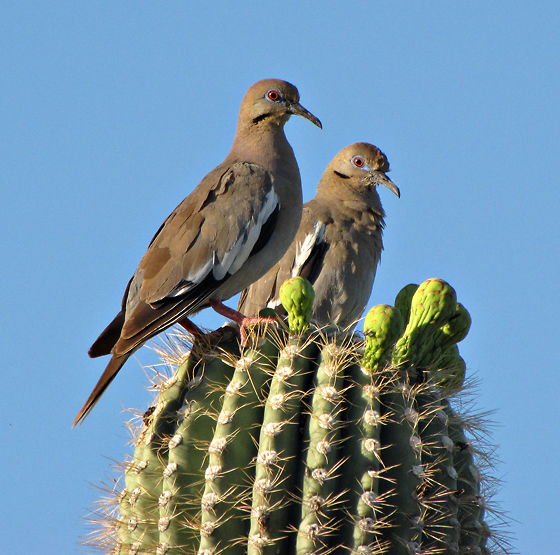
Wikipedia: White-winged dove
![]() The white-winged dove (Zenaida asiatica) is a dove whose native range extends from the Southwestern United States through Mexico, Central America, and the Caribbean. They are large for doves, and can be distinguished from similar doves by the distinctive white edge on their wings. They have a blue eyering, and red eyes. The plumage is brownish-gray to gray. Juveniles are duller in color, and have brown eyes. The call is likened to English phrase "who cooks for you". There are three subspecies. It was first described by George Edwards in 1743, and given its binomial name by Linnaeus in 1756. It was moved into the genus Zenaida in 1838.
[more]
The white-winged dove (Zenaida asiatica) is a dove whose native range extends from the Southwestern United States through Mexico, Central America, and the Caribbean. They are large for doves, and can be distinguished from similar doves by the distinctive white edge on their wings. They have a blue eyering, and red eyes. The plumage is brownish-gray to gray. Juveniles are duller in color, and have brown eyes. The call is likened to English phrase "who cooks for you". There are three subspecies. It was first described by George Edwards in 1743, and given its binomial name by Linnaeus in 1756. It was moved into the genus Zenaida in 1838.
[more]
Gattung Columbina:

Wikipedia: Common ground-dove
![]() The common ground dove (Columbina passerina) is a small bird that inhabits the southern United States, parts of Central America, the Caribbean and northern South America. It is considered to be the smallest dove that inhabits the United States. As its name suggests, the bird spends the majority of its time on the ground walking but still has the ability to fly.
[more]
The common ground dove (Columbina passerina) is a small bird that inhabits the southern United States, parts of Central America, the Caribbean and northern South America. It is considered to be the smallest dove that inhabits the United States. As its name suggests, the bird spends the majority of its time on the ground walking but still has the ability to fly.
[more]
La tarde ruddy ground dove tentative ID. 2018-03-11 09.38.10 null
![]() The ruddy ground dove (Columbina talpacoti) is a small New World tropical dove. It is a resident breeder from Mexico south to Peru, Brazil and Paraguay, and northern Argentina, and on Trinidad and Tobago. Individual birds can sometimes be seen in the southwestern USA, from southern Texas to southernmost California, primarily during winter.
[more]
The ruddy ground dove (Columbina talpacoti) is a small New World tropical dove. It is a resident breeder from Mexico south to Peru, Brazil and Paraguay, and northern Argentina, and on Trinidad and Tobago. Individual birds can sometimes be seen in the southwestern USA, from southern Texas to southernmost California, primarily during winter.
[more]

Wikipedia: Inca dove
![]() The Inca dove or Mexican dove (Columbina inca) is a small New World dove. The species was first described by French surgeon and naturalist René Lesson in 1847. It reaches a length of 16.5–23 cm (6.5–9.1 in) and weighs 30–58 g (1.1–2.0 oz).[2] The Inca dove has an average wingspan of 28.5 cm and a max wingspan of 32 cm.[3] It is a slender species, with a gray-brown body covered in feathers that resemble a scaled pattern. The tail is long and square and edged with white feathers that may flare out in flight. The underwings are reddish, like other ground doves, and upon takeoff, the wings produce a distinctive, quiet rattling noise.
[more]
The Inca dove or Mexican dove (Columbina inca) is a small New World dove. The species was first described by French surgeon and naturalist René Lesson in 1847. It reaches a length of 16.5–23 cm (6.5–9.1 in) and weighs 30–58 g (1.1–2.0 oz).[2] The Inca dove has an average wingspan of 28.5 cm and a max wingspan of 32 cm.[3] It is a slender species, with a gray-brown body covered in feathers that resemble a scaled pattern. The tail is long and square and edged with white feathers that may flare out in flight. The underwings are reddish, like other ground doves, and upon takeoff, the wings produce a distinctive, quiet rattling noise.
[more]

Wikipedia: Plain-breasted ground-dove
![]() The plain-breasted ground dove (Columbina minuta) is a species of bird in the family Columbidae. It lacks the scaled appearance to the feathers of the similar and typically more abundant common ground dove.
[more]
The plain-breasted ground dove (Columbina minuta) is a species of bird in the family Columbidae. It lacks the scaled appearance to the feathers of the similar and typically more abundant common ground dove.
[more]
Gattung Claravis:

Wikipedia: Blue ground-dove
![]() The blue ground dove (Claravis pretiosa) is a small New World tropical dove. It is a resident breeder from southeastern Mexico to northwestern Peru and northern Argentina, and on Trinidad in the Caribbean.
[more]
The blue ground dove (Claravis pretiosa) is a small New World tropical dove. It is a resident breeder from southeastern Mexico to northwestern Peru and northern Argentina, and on Trinidad in the Caribbean.
[more]
Gattung Geotrygon:
Profil Wikipedia Xeno-Canto
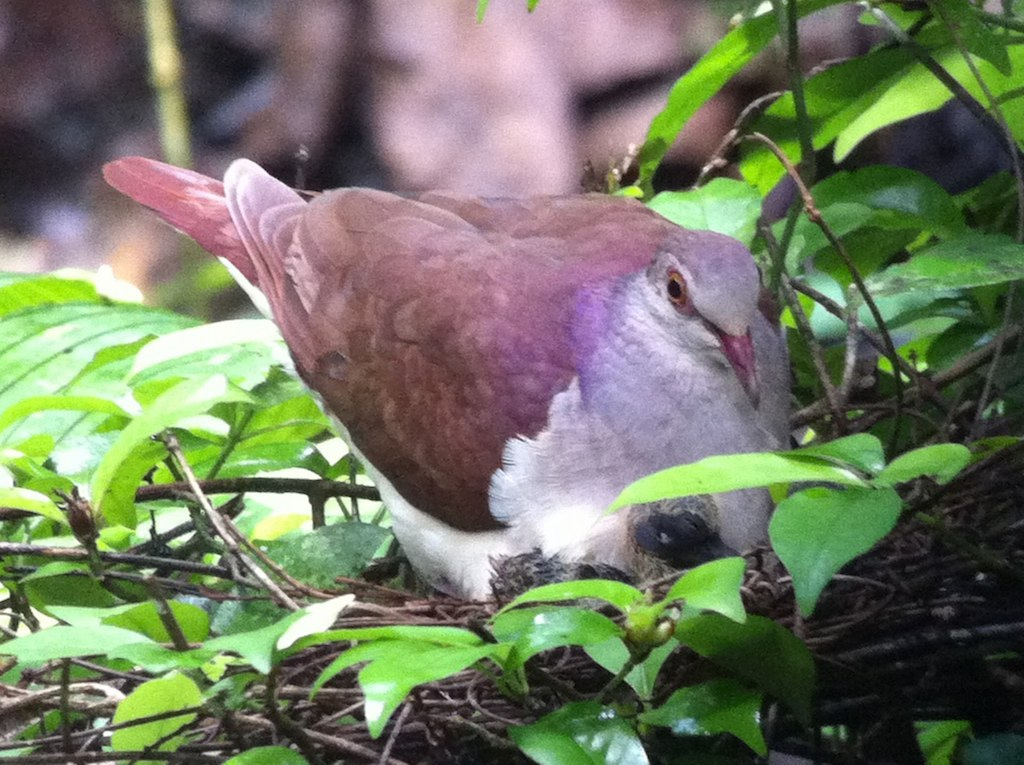
Wikipedia: Violaceous quail-dove
![]() The violaceous quail-dove (Geotrygon violacea) is a species of bird in the family Columbidae. It is found in Argentina, Bolivia, Brazil, Colombia, Costa Rica, Ecuador, Nicaragua, Panama, Paraguay, Peru, Suriname, and Venezuela. Its natural habitats are subtropical or tropical moist lowland forest and heavily degraded former forest.
[more]
The violaceous quail-dove (Geotrygon violacea) is a species of bird in the family Columbidae. It is found in Argentina, Bolivia, Brazil, Colombia, Costa Rica, Ecuador, Nicaragua, Panama, Paraguay, Peru, Suriname, and Venezuela. Its natural habitats are subtropical or tropical moist lowland forest and heavily degraded former forest.
[more]
Profil Wikipedia Xeno-Canto

Wikipedia: Ruddy quail-dove
![]() The ruddy quail-dove (Geotrygon montana) is a species of bird in the dove and pigeon family Columbidae. It breeds throughout the West Indies, Central America, and tropical South America. It has appeared as a vagrant in Florida and southern Texas. It lays two buff-colored eggs on a flimsy platform built on a shrub. Some nests are built on the ground.
[more]
The ruddy quail-dove (Geotrygon montana) is a species of bird in the dove and pigeon family Columbidae. It breeds throughout the West Indies, Central America, and tropical South America. It has appeared as a vagrant in Florida and southern Texas. It lays two buff-colored eggs on a flimsy platform built on a shrub. Some nests are built on the ground.
[more]

Wikipedia: Olive-backed quail-dove
![]() The olive-backed quail-dove (Leptotrygon veraguensis) is a species of bird in the family Columbidae. It is the only species in the genus Leptotrygon.
[more]
The olive-backed quail-dove (Leptotrygon veraguensis) is a species of bird in the family Columbidae. It is the only species in the genus Leptotrygon.
[more]
Gattung Leptotila:
Profil Wikipedia Audubon Xeno-Canto
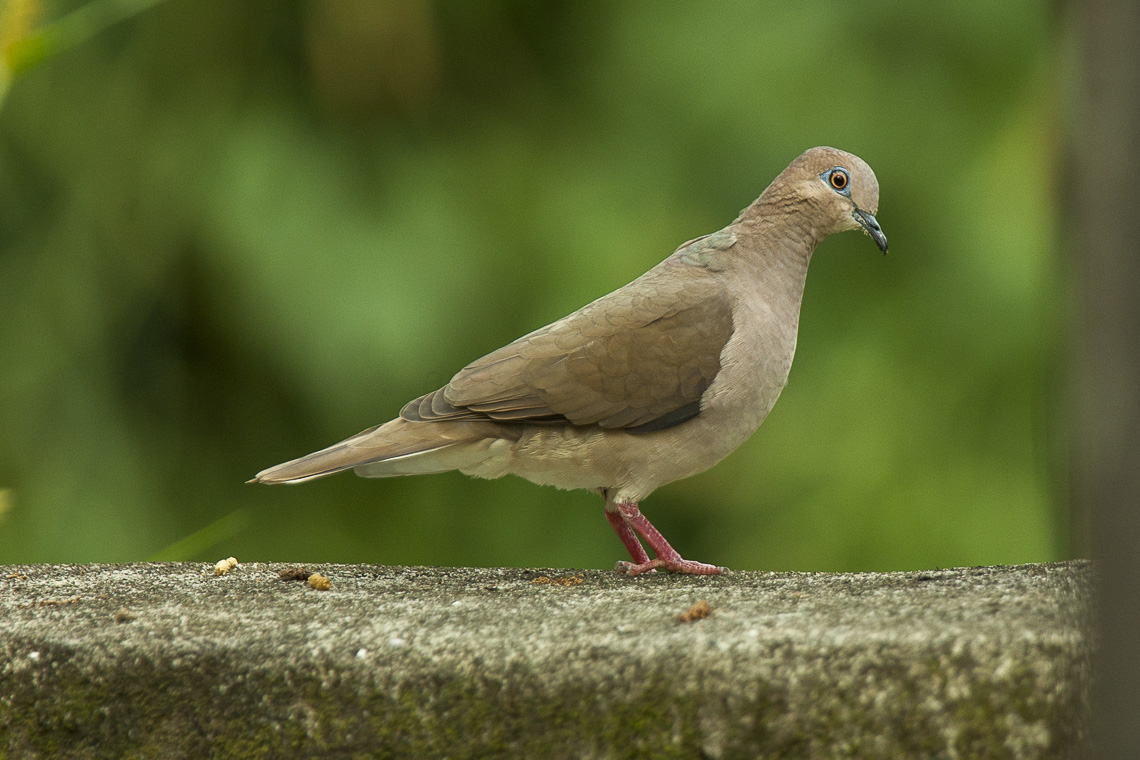
Wikipedia: White-tipped dove
![]() The white-tipped dove (Leptotila verreauxi) is a large New World tropical dove. Its scientific name commemorates the French naturalists Jules and Edouard Verreaux.
[more]
The white-tipped dove (Leptotila verreauxi) is a large New World tropical dove. Its scientific name commemorates the French naturalists Jules and Edouard Verreaux.
[more]

Wikipedia: Grey-chested dove
![]() The grey-chested dove (Leptotila cassinii) is a species of bird in the family Columbidae.
[more]
The grey-chested dove (Leptotila cassinii) is a species of bird in the family Columbidae.
[more]

Wikipedia: Grey-headed dove
![]() The grey-headed dove (Leptotila plumbeiceps) is a large New World tropical dove. It is a resident breeder from eastern Mexico to western Panama. It was formerly considered conspecific with the grey-fronted dove, L. rufaxilla, of South America and the Grenada dove, L. wellsi, of Grenada.
[more]
The grey-headed dove (Leptotila plumbeiceps) is a large New World tropical dove. It is a resident breeder from eastern Mexico to western Panama. It was formerly considered conspecific with the grey-fronted dove, L. rufaxilla, of South America and the Grenada dove, L. wellsi, of Grenada.
[more]
Gattung Patagioenas:

Wikipedia: Red-billed pigeon
![]() The red-billed pigeon (Patagioenas flavirostris)[2] is a relatively large, girth-y pigeon which breeds from southern Texas, United States, and northwestern Mexico south to Costa Rica. It belongs to a clade of Patagioenas which generally lack iridescent display plumage, except some vestiges in the pale-vented pigeon.
[more]
The red-billed pigeon (Patagioenas flavirostris)[2] is a relatively large, girth-y pigeon which breeds from southern Texas, United States, and northwestern Mexico south to Costa Rica. It belongs to a clade of Patagioenas which generally lack iridescent display plumage, except some vestiges in the pale-vented pigeon.
[more]

Wikipedia: Band-tailed pigeon
![]() Columba fasciata (Say, 1823)
Columba fasciata (Say, 1823)
Northern band-tailed pigeon (Patagioenas fasciata)
Southern band-tailed pigeon (Patagioenas albilinea)
[more]

Wikipedia: White-crowned pigeon
![]() The white-crowned pigeon (Patagioenas leucocephala) is a fruit and seed-eating species of bird in the dove and pigeon family Columbidae. It is found primarily in the Caribbean.
[more]
The white-crowned pigeon (Patagioenas leucocephala) is a fruit and seed-eating species of bird in the dove and pigeon family Columbidae. It is found primarily in the Caribbean.
[more]
Profil Wikipedia Xeno-Canto
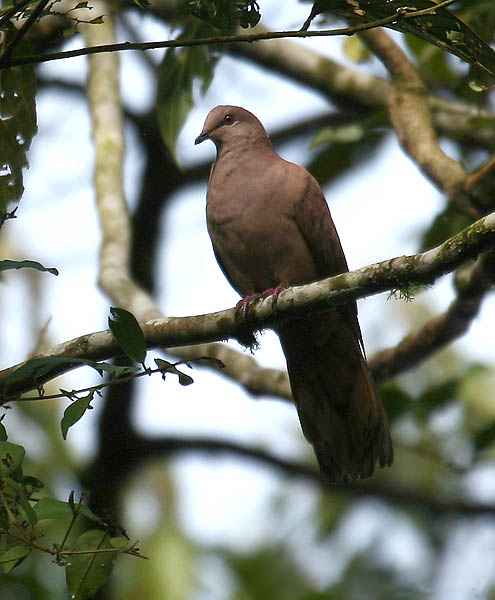
Wikipedia: Ruddy pigeon
![]() The ruddy pigeon (Patagioenas subvinacea) is a largish pigeon which breeds from Costa Rica south to western Ecuador, Bolivia, and central Brazil. It belongs to a clade of small and rather plain species of Patagioenas with characteristic calls[2] that constitute the subgenus Oenoenas.[3] Like the other New World pigeons, it was formerly united with their Old World relatives in Columba, but today the New World genus Patagioenas is recognized as distinct again.[2]
[more]
The ruddy pigeon (Patagioenas subvinacea) is a largish pigeon which breeds from Costa Rica south to western Ecuador, Bolivia, and central Brazil. It belongs to a clade of small and rather plain species of Patagioenas with characteristic calls[2] that constitute the subgenus Oenoenas.[3] Like the other New World pigeons, it was formerly united with their Old World relatives in Columba, but today the New World genus Patagioenas is recognized as distinct again.[2]
[more]
Profil Wikipedia Xeno-Canto

Wikipedia: Pale-vented pigeon
![]() The pale-vented pigeon (Patagioenas cayennensis) is a large pigeon (family Columbidae) found in the tropical Americas. Formerly often placed in Columba, it actually belongs to a clade of the older New World genus Patagioenas. With its relatives it represents an evolutionary radiation extending through most of the warm-temperate to tropical Americas. Grey-hued birds, even their males generally lack iridescent display plumage, although the present species has some coppery gloss on the nape.[2]
[more]
The pale-vented pigeon (Patagioenas cayennensis) is a large pigeon (family Columbidae) found in the tropical Americas. Formerly often placed in Columba, it actually belongs to a clade of the older New World genus Patagioenas. With its relatives it represents an evolutionary radiation extending through most of the warm-temperate to tropical Americas. Grey-hued birds, even their males generally lack iridescent display plumage, although the present species has some coppery gloss on the nape.[2]
[more]

Wikipedia: Scaled pigeon
![]() The scaled pigeon (Patagioenas speciosa)[2] is a large New World tropical dove. It is a resident breeder from southern Mexico south to western Ecuador, southern Brazil, northern Argentina, and Trinidad.
[more]
The scaled pigeon (Patagioenas speciosa)[2] is a large New World tropical dove. It is a resident breeder from southern Mexico south to western Ecuador, southern Brazil, northern Argentina, and Trinidad.
[more]
Profil Wikipedia Xeno-Canto

Wikipedia: Short-billed pigeon
![]() The short-billed pigeon (Patagioenas nigrirostris)[2] is a largish pigeon which breeds from southern Mexico south to northwestern Colombia. It is a member of a clade of Patagioenas that contains the smaller and rather plain species with characteristic calls[2] that constitute the subgenus Oenoenas.[3]
[more]
The short-billed pigeon (Patagioenas nigrirostris)[2] is a largish pigeon which breeds from southern Mexico south to northwestern Colombia. It is a member of a clade of Patagioenas that contains the smaller and rather plain species with characteristic calls[2] that constitute the subgenus Oenoenas.[3]
[more]

Wikipedia: Plumbeous pigeon
![]() The plumbeous pigeon (Patagioenas plumbea) is a species of bird in the family Columbidae. It is found in Bolivia, Brazil, Colombia, Ecuador, French Guiana, Guyana, Panama, Paraguay, Peru, Suriname, and Venezuela in secondary growth forests, edge forests, and low hills. It can often be confused with the Ruddy Pigeon.[2]
[more]
The plumbeous pigeon (Patagioenas plumbea) is a species of bird in the family Columbidae. It is found in Bolivia, Brazil, Colombia, Ecuador, French Guiana, Guyana, Panama, Paraguay, Peru, Suriname, and Venezuela in secondary growth forests, edge forests, and low hills. It can often be confused with the Ruddy Pigeon.[2]
[more]
Gattung Zentrygon:

Wikipedia: Purplish-backed quail-dove
![]() The purplish-backed quail-dove (Zentrygon lawrencii) is a species of bird in the family Columbidae.
It is endemic to the highlands of Central America, more specifically those of Costa Rica and Panama. The Tuxtla quail-dove of Mexico was once considered part of this species.
Its natural habitats are subtropical or tropical moist lowland forest and subtropical or tropical moist montane forest.
[more]
The purplish-backed quail-dove (Zentrygon lawrencii) is a species of bird in the family Columbidae.
It is endemic to the highlands of Central America, more specifically those of Costa Rica and Panama. The Tuxtla quail-dove of Mexico was once considered part of this species.
Its natural habitats are subtropical or tropical moist lowland forest and subtropical or tropical moist montane forest.
[more]

Wikipedia: Buff-fronted quail-dove
![]() The buff-fronted quail-dove (Zentrygon costaricensis) or Costa Rican quail-dove, is a species of bird in the family Columbidae. It is found in the Talamancan montane forestss, where it forages on the ground for seeds and fruit.
[more]
The buff-fronted quail-dove (Zentrygon costaricensis) or Costa Rican quail-dove, is a species of bird in the family Columbidae. It is found in the Talamancan montane forestss, where it forages on the ground for seeds and fruit.
[more]
Ordnung Coraciiformes (Rackenvögel / Kingfishers and others):
Familie Cerylidae:
Gattung Chloroceryle:

Wikipedia: Green kingfisher
![]() The green kingfisher (Chloroceryle americana) is a resident breeding bird which occurs from southern Texas in the United States south through Central and South America to central Argentina.
[more]
The green kingfisher (Chloroceryle americana) is a resident breeding bird which occurs from southern Texas in the United States south through Central and South America to central Argentina.
[more]
Profil Wikipedia Xeno-Canto

Wikipedia: American pygmy kingfisher
![]() The American pygmy kingfisher (Chloroceryle aenea) is a resident breeding kingfisher which occurs in the American tropics from southern Mexico south through Central America to western Ecuador, and then around the northern Andes cordillera in the east to central Bolivia and central Brazil. The species occupies the entire Amazon basin and the Tocantins River drainage adjacent in Pará state Brazil. It also occurs on Trinidad.
[more]
The American pygmy kingfisher (Chloroceryle aenea) is a resident breeding kingfisher which occurs in the American tropics from southern Mexico south through Central America to western Ecuador, and then around the northern Andes cordillera in the east to central Bolivia and central Brazil. The species occupies the entire Amazon basin and the Tocantins River drainage adjacent in Pará state Brazil. It also occurs on Trinidad.
[more]
Profil Wikipedia Xeno-Canto

Wikipedia: Green-and-rufous kingfisher
![]() The green-and-rufous kingfisher (Chloroceryle inda) is a resident breeding bird in the lowlands of the American tropics from southeastern Nicaragua south to southern Brazil.
[more]
The green-and-rufous kingfisher (Chloroceryle inda) is a resident breeding bird in the lowlands of the American tropics from southeastern Nicaragua south to southern Brazil.
[more]
Profil Wikipedia Xeno-Canto

Wikipedia: Amazon kingfisher
![]() The Amazon kingfisher (Chloroceryle amazona) is a resident breeding kingfisher in the lowlands of the American tropics from southern Mexico south through Central America to northern Argentina.
[more]
The Amazon kingfisher (Chloroceryle amazona) is a resident breeding kingfisher in the lowlands of the American tropics from southern Mexico south through Central America to northern Argentina.
[more]
Gattung Megaceryle:

Wikipedia: Belted kingfisher
![]() The belted kingfisher (Megaceryle alcyon) is a large, conspicuous water kingfisher. It is depicted on the 1986 series Canadian $5 note. All kingfishers were formerly placed in one family, Alcedinidae, but recent research suggests that this should be divided into three subfamilies.
[more]
The belted kingfisher (Megaceryle alcyon) is a large, conspicuous water kingfisher. It is depicted on the 1986 series Canadian $5 note. All kingfishers were formerly placed in one family, Alcedinidae, but recent research suggests that this should be divided into three subfamilies.
[more]
Profil Wikipedia Xeno-Canto

Wikipedia: Ringed kingfisher
![]() The ringed kingfisher (Megaceryle torquata) is a large, conspicuous and noisy kingfisher bird commonly found along the lower Rio Grande valley in southeasternmost Texas in the United States through Central America to Tierra del Fuego in South America.[4]
[more]
The ringed kingfisher (Megaceryle torquata) is a large, conspicuous and noisy kingfisher bird commonly found along the lower Rio Grande valley in southeasternmost Texas in the United States through Central America to Tierra del Fuego in South America.[4]
[more]
Familie Momotidae:
Gattung Momotus:
Curi cancha blue crowned motmot in tree. 2018-02-18 13.52.48 null
![]() Der Amazonasmotmot (Momotus momota, Syn.: Ramphastos momota) ist eine Vogelart aus der Familie der Sägeracken (Momotidae), die im südamerikanischen Amazonasbecken weit verbreitet ist.
[more]
Der Amazonasmotmot (Momotus momota, Syn.: Ramphastos momota) ist eine Vogelart aus der Familie der Sägeracken (Momotidae), die im südamerikanischen Amazonasbecken weit verbreitet ist.
[more]
Profil Wikipedia Xeno-Canto
Curi cancha Lessons motmot in tree. 2018-02-18 13.52.46 null
![]() Lesson's motmot (Momotus lessonii) or the blue-diademed motmot, is a colorful near-passerine bird found in forests and woodlands of southern Mexico to western Panama. This species and the blue-capped motmot, whooping motmot, Trinidad motmot, Amazonian motmot, and Andean motmot were all considered conspecific.
[more]
Lesson's motmot (Momotus lessonii) or the blue-diademed motmot, is a colorful near-passerine bird found in forests and woodlands of southern Mexico to western Panama. This species and the blue-capped motmot, whooping motmot, Trinidad motmot, Amazonian motmot, and Andean motmot were all considered conspecific.
[more]
Profil Wikipedia Xeno-Canto

Wikipedia: Whooping motmot
![]() The whooping motmot (Momotus subrufescens) is a colorful near-passerine bird found in forests and woodlands of southern Panama to northwestern Peru. This species and the blue-capped motmot, Lesson's motmot, Trinidad motmot, Amazonian motmot, and Andean motmot were all considered conspecific.
[more]
The whooping motmot (Momotus subrufescens) is a colorful near-passerine bird found in forests and woodlands of southern Panama to northwestern Peru. This species and the blue-capped motmot, Lesson's motmot, Trinidad motmot, Amazonian motmot, and Andean motmot were all considered conspecific.
[more]
Gattung Baryphthengus:

Wikipedia: Rufous motmot
![]() The rufous motmot (Baryphthengus martii) is a near-passerine bird which is a resident breeder in rain forests from northeastern Honduras south to western Ecuador, northeastern Bolivia, and southwestern Brazil.
[more]
The rufous motmot (Baryphthengus martii) is a near-passerine bird which is a resident breeder in rain forests from northeastern Honduras south to western Ecuador, northeastern Bolivia, and southwestern Brazil.
[more]
Gattung Hylomanes:
Profil Wikipedia Xeno-Canto
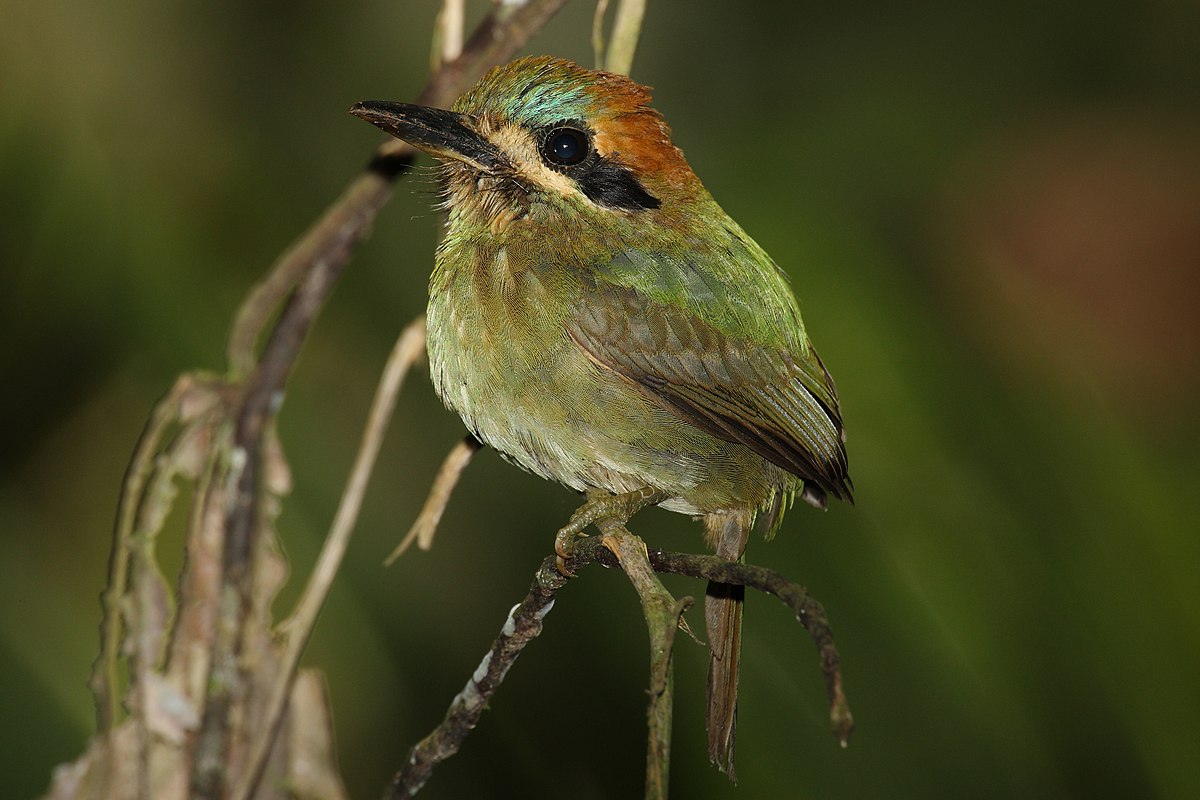
Wikipedia: Tody motmot
![]() The tody motmot (Hylomanes momotula) is a species of bird in the family Momotidae. It is monotypic within the genus Hylomanes.[2]
It is found in Belize, Colombia, Costa Rica, El Salvador, Guatemala, Honduras, Mexico, Nicaragua, and Panama.
Its natural habitats are subtropical or tropical moist lowland forest and subtropical or tropical moist montane forest.
[more]
The tody motmot (Hylomanes momotula) is a species of bird in the family Momotidae. It is monotypic within the genus Hylomanes.[2]
It is found in Belize, Colombia, Costa Rica, El Salvador, Guatemala, Honduras, Mexico, Nicaragua, and Panama.
Its natural habitats are subtropical or tropical moist lowland forest and subtropical or tropical moist montane forest.
[more]
Gattung Electron:
Profil Wikipedia Xeno-Canto

Wikipedia: Keel-billed motmot
![]() The keel-billed motmot (Electron carinatum) is a species of bird in the motmot family Momotidae. It is very closely related to the broad-billed motmot, and the two may be the same species. The two are similar sizes and shapes, and have been reported to have similar calls, but they do have different plumage.[2]
[more]
The keel-billed motmot (Electron carinatum) is a species of bird in the motmot family Momotidae. It is very closely related to the broad-billed motmot, and the two may be the same species. The two are similar sizes and shapes, and have been reported to have similar calls, but they do have different plumage.[2]
[more]
Profil Wikipedia Xeno-Canto
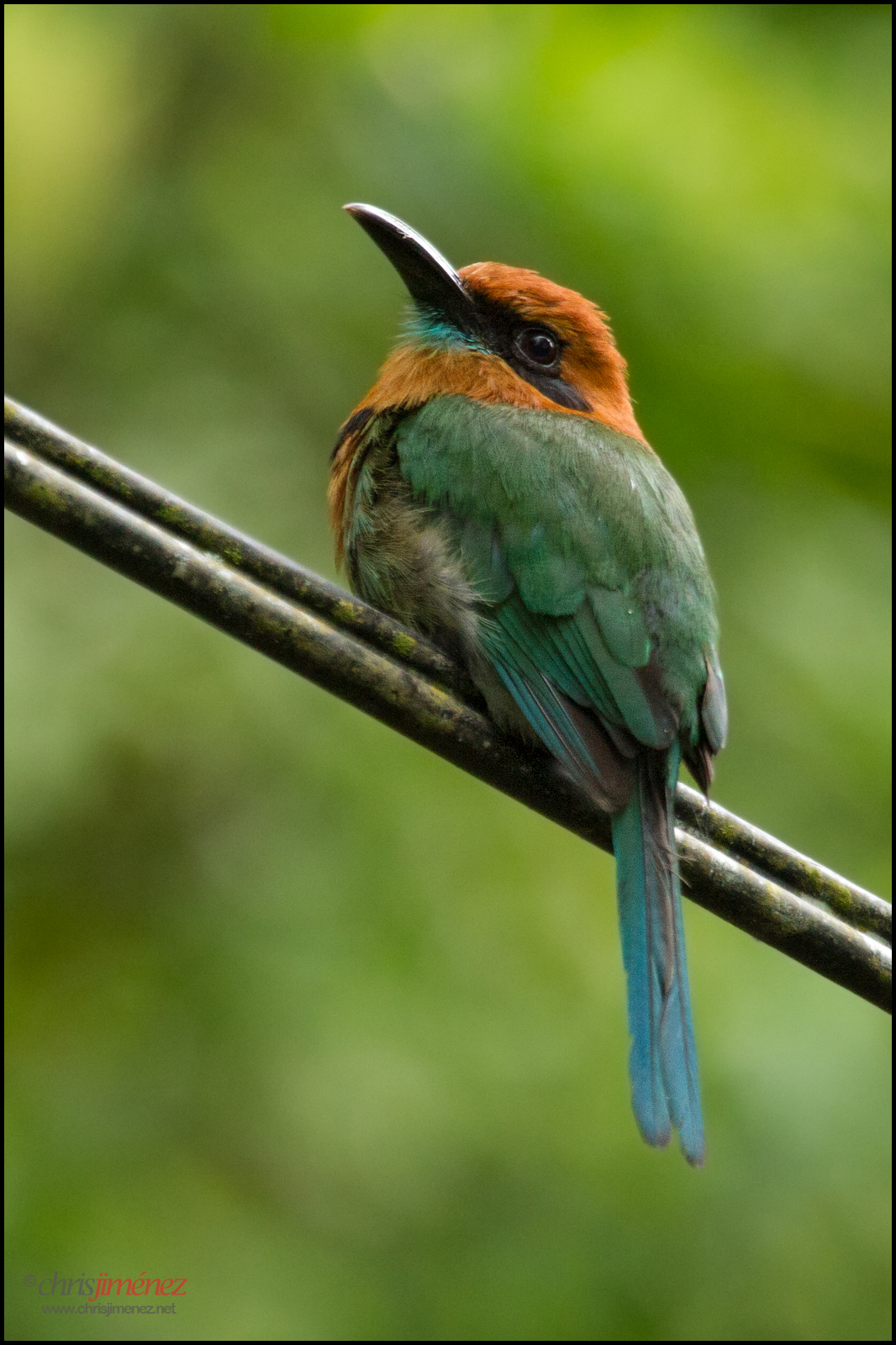
Wikipedia: Broad-billed motmot
![]() The broad-billed motmot (Electron platyrhynchum) is a fairly common[2] Central and South American bird of the Momotidae family.[3] They are nonmigratory, sedentary birds[4] that are most frequently seen in singles or pairs.[3] There exist six subspecies of the broad-billed motmot.[3]
[more]
The broad-billed motmot (Electron platyrhynchum) is a fairly common[2] Central and South American bird of the Momotidae family.[3] They are nonmigratory, sedentary birds[4] that are most frequently seen in singles or pairs.[3] There exist six subspecies of the broad-billed motmot.[3]
[more]
Gattung Eumomota:
Profil Wikipedia Xeno-Canto

Wikipedia: Turquoise-browed motmot
![]() The turquoise-browed motmot (Eumomota superciliosa) also known as Torogoz, is a colourful, medium-sized bird of the motmot family, Momotidae. It inhabits Central America from south-east Mexico (mostly the Yucatán Peninsula), to Costa Rica, where it is common and not considered threatened. It lives in fairly open habitats such as forest edge, gallery forest and scrubland. It is more conspicuous than other motmots, often perching in the open on wires and fences. From these perches it scans for prey, such as insects and small reptiles. White eggs (3–6) are laid in a long tunnel nest in an earth bank or sometimes in a quarry or fresh-water well. Its name originates from the turquoise color of its brow. It is the national bird of both El Salvador and Nicaragua, where it is known as "Torogoz" and "Guardabarranco" respectively.[2][3]
[more]
The turquoise-browed motmot (Eumomota superciliosa) also known as Torogoz, is a colourful, medium-sized bird of the motmot family, Momotidae. It inhabits Central America from south-east Mexico (mostly the Yucatán Peninsula), to Costa Rica, where it is common and not considered threatened. It lives in fairly open habitats such as forest edge, gallery forest and scrubland. It is more conspicuous than other motmots, often perching in the open on wires and fences. From these perches it scans for prey, such as insects and small reptiles. White eggs (3–6) are laid in a long tunnel nest in an earth bank or sometimes in a quarry or fresh-water well. Its name originates from the turquoise color of its brow. It is the national bird of both El Salvador and Nicaragua, where it is known as "Torogoz" and "Guardabarranco" respectively.[2][3]
[more]
Ordnung Cuculiformes (Kuckucke / Cuckoos and others):
Familie Cuculidae (Cuckoos):
Gattung Coccycua:
Profil Wikipedia Xeno-Canto

Wikipedia: Little cuckoo
![]() The little cuckoo (Coccycua minuta) is a species of bird in the cuckoo family (Cuculidae) from South America and Panama. It was formerly placed in the genus Piaya, but was moved to the reinstated genus Coccycua following the discovery that its closest living relatives are a couple species traditionally placed in Coccyzus or Micrococcyx, rather than the other members of Piaya.[2]
[more]
The little cuckoo (Coccycua minuta) is a species of bird in the cuckoo family (Cuculidae) from South America and Panama. It was formerly placed in the genus Piaya, but was moved to the reinstated genus Coccycua following the discovery that its closest living relatives are a couple species traditionally placed in Coccyzus or Micrococcyx, rather than the other members of Piaya.[2]
[more]
Familie Crotophagidae:
Gattung Crotophaga:
Profil Wikipedia Audubon Xeno-Canto
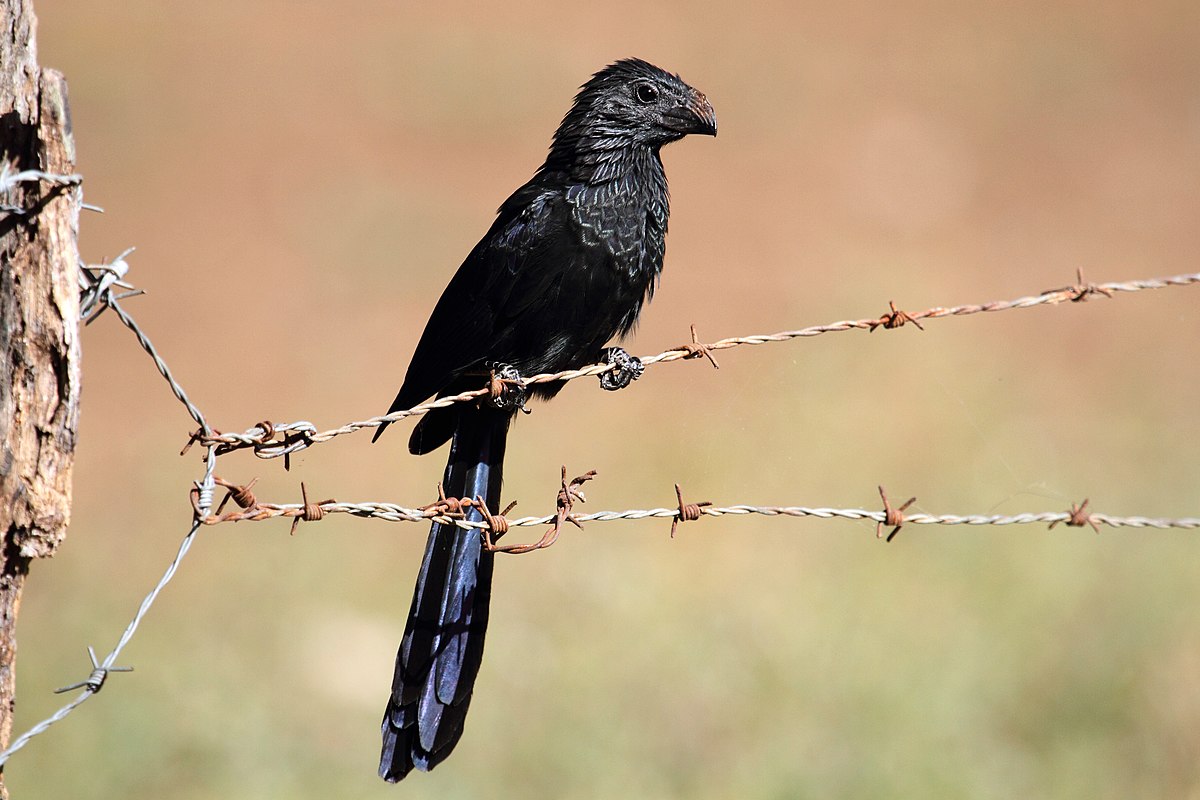
Wikipedia: Groove-billed ani
![]() The groove-billed ani (Crotophaga sulcirostris) is a tropical bird in the cuckoo family with a long tail and a large, curved beak. It is a resident species throughout most of its range, from southern Texas, central Mexico and The Bahamas, through Central America, to northern Colombia and Venezuela, and coastal Ecuador and Peru. It only retreats from the northern limits of its range in Texas and northern Mexico during winter.
[more]
The groove-billed ani (Crotophaga sulcirostris) is a tropical bird in the cuckoo family with a long tail and a large, curved beak. It is a resident species throughout most of its range, from southern Texas, central Mexico and The Bahamas, through Central America, to northern Colombia and Venezuela, and coastal Ecuador and Peru. It only retreats from the northern limits of its range in Texas and northern Mexico during winter.
[more]
Profil Wikipedia Audubon Xeno-Canto

Wikipedia: Smooth-billed ani
![]() The smooth-billed ani (Crotophaga ani) is a large near passerine bird in the cuckoo family. It is a resident breeding species from southern Florida, the Caribbean, parts of Central America, south to western Ecuador, Brazil, northern Argentina and southern Chile.[2] It was introduced to Galápagos around the 1960s and is potentially impacting native and endemic species across the archipelago.[3]
[more]
The smooth-billed ani (Crotophaga ani) is a large near passerine bird in the cuckoo family. It is a resident breeding species from southern Florida, the Caribbean, parts of Central America, south to western Ecuador, Brazil, northern Argentina and southern Chile.[2] It was introduced to Galápagos around the 1960s and is potentially impacting native and endemic species across the archipelago.[3]
[more]
Profil Wikipedia Xeno-Canto
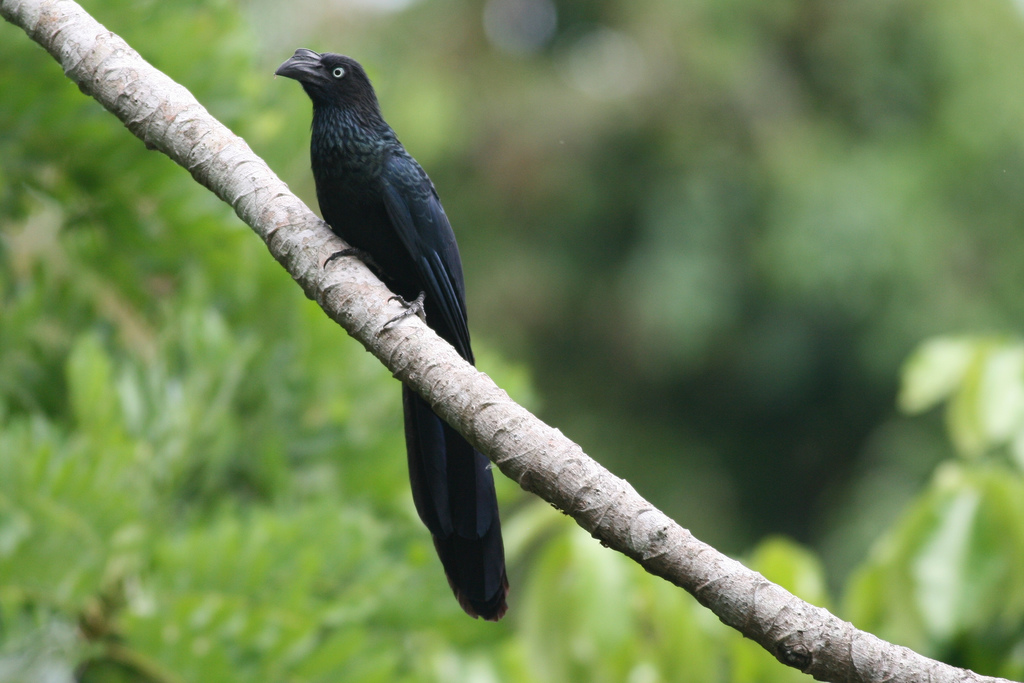
Wikipedia: Greater ani
![]() The greater ani (Crotophaga major) is a large bird in the cuckoo family. It is a breeding species from Panama and Trinidad through tropical South America to northern Argentina. It is sometimes referred to as the black cuckoo.
[more]
The greater ani (Crotophaga major) is a large bird in the cuckoo family. It is a breeding species from Panama and Trinidad through tropical South America to northern Argentina. It is sometimes referred to as the black cuckoo.
[more]
Familie Coccyzidae:
Gattung Piaya:
Profil Wikipedia Xeno-Canto
Squirrel cuckoo in Manzanillo, Costa Rica. 2020-03-12 08.12.56 null
![]() The squirrel cuckoo (Piaya cayana) is a large and active species of cuckoo found in wooded habitats from northwestern Mexico to northern Argentina and Uruguay, and on Trinidad. Some authorities have split off the western Mexican form as the Mexican squirrel-cuckoo (Piaya mexicana).[2]
[more]
The squirrel cuckoo (Piaya cayana) is a large and active species of cuckoo found in wooded habitats from northwestern Mexico to northern Argentina and Uruguay, and on Trinidad. Some authorities have split off the western Mexican form as the Mexican squirrel-cuckoo (Piaya mexicana).[2]
[more]
Gattung Coccyzus:
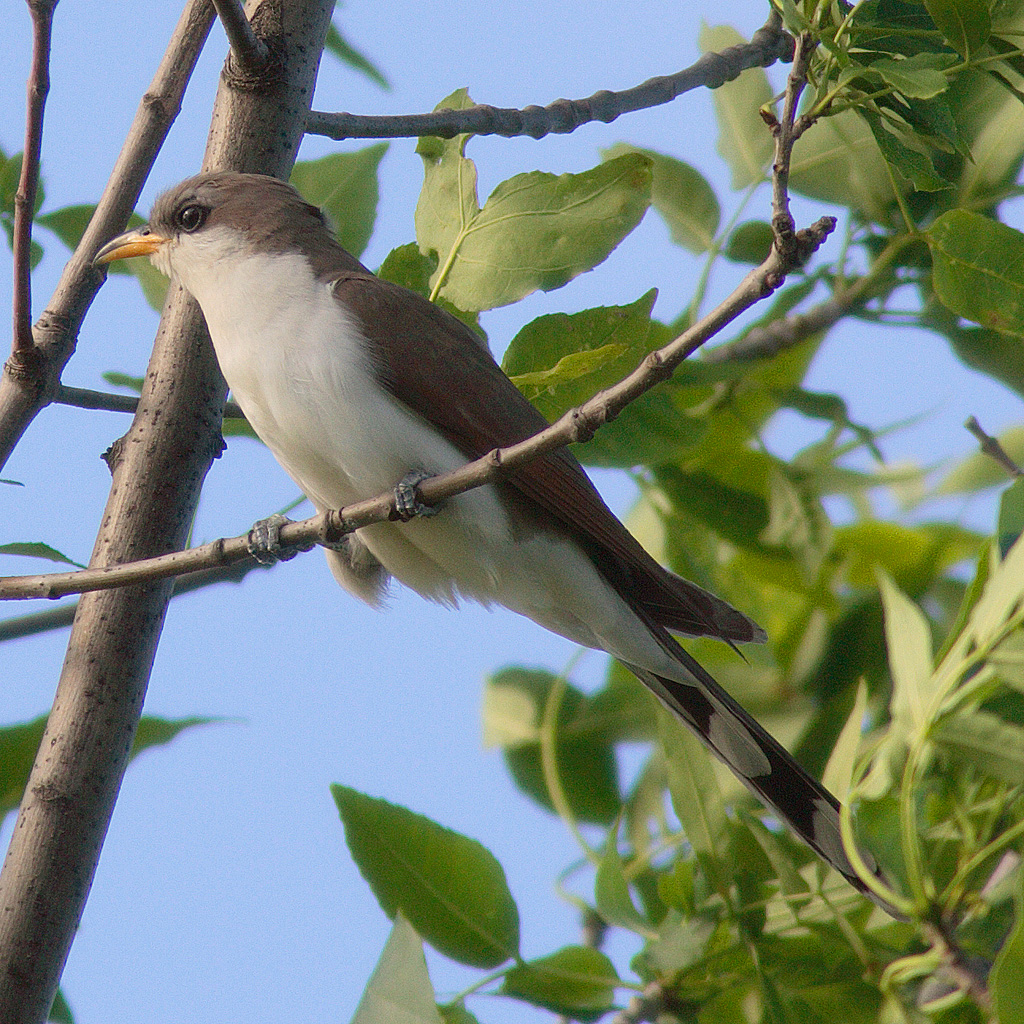
Wikipedia: Yellow-billed cuckoo
![]() The yellow-billed cuckoo (Coccyzus americanus) is a cuckoo. Common folk-names for this bird in the southern United States are rain crow and storm crow. These likely refer to the bird's habit of calling on hot days, often presaging rain or thunderstorms.
[more]
The yellow-billed cuckoo (Coccyzus americanus) is a cuckoo. Common folk-names for this bird in the southern United States are rain crow and storm crow. These likely refer to the bird's habit of calling on hot days, often presaging rain or thunderstorms.
[more]
Profil Wikipedia Audubon Xeno-Canto

Wikipedia: Mangrove cuckoo
![]() The mangrove cuckoo (Coccyzus minor) is a species of cuckoo that is native to the Neotropics.
[more]
The mangrove cuckoo (Coccyzus minor) is a species of cuckoo that is native to the Neotropics.
[more]
Profil Wikipedia Xeno-Canto

Wikipedia: Cocos cuckoo
![]() The Cocos cuckoo (Coccyzus ferrugineus) is a species of cuckoo in the family Cuculidae.
It is endemic to Cocos Island, an island in the Pacific Ocean which is part of Costa Rica.
[more]
The Cocos cuckoo (Coccyzus ferrugineus) is a species of cuckoo in the family Cuculidae.
It is endemic to Cocos Island, an island in the Pacific Ocean which is part of Costa Rica.
[more]
Profil Wikipedia Xeno-Canto

Wikipedia: Pearly-breasted cuckoo
![]() The pearly-breasted cuckoo (Coccyzus euleri) is a species of cuckoo in the family Cuculidae.
It is found in Argentina, Bolivia, Brazil,[2] Colombia, Ecuador, French Guiana, Guyana, Paraguay, Suriname, Peru[3] and Venezuela.
Its natural habitats are subtropical or tropical moist lowland forests and heavily degraded former forest. It does not occur above an elevation of 2000 meters.[4]
[more]
The pearly-breasted cuckoo (Coccyzus euleri) is a species of cuckoo in the family Cuculidae.
It is found in Argentina, Bolivia, Brazil,[2] Colombia, Ecuador, French Guiana, Guyana, Paraguay, Suriname, Peru[3] and Venezuela.
Its natural habitats are subtropical or tropical moist lowland forests and heavily degraded former forest. It does not occur above an elevation of 2000 meters.[4]
[more]
Familie Neomorphidae:
Gattung Dromococcyx:
Profil Wikipedia Xeno-Canto

Wikipedia: Pheasant cuckoo
![]() The pheasant cuckoo (Dromococcyx phasianellus) is a species of neotropical cuckoo in the subfamily Neomorphinae of the family Cuculidae. It is native to Central and South America where it occurs in lowland tropical forest.
[more]
The pheasant cuckoo (Dromococcyx phasianellus) is a species of neotropical cuckoo in the subfamily Neomorphinae of the family Cuculidae. It is native to Central and South America where it occurs in lowland tropical forest.
[more]
Gattung Neomorphus:
Profil Wikipedia Xeno-Canto

Wikipedia: Rufous-vented ground-cuckoo
![]() The rufous-vented ground cuckoo (Neomorphus geoffroyi) is a large terrestrial species of cuckoo in the family Cuculidae. It is found in humid primary forests from southern Nicaragua, through Costa Rica and Panama, into north-western Colombia. Another population occurs in the western and southern Amazon Basin of south-eastern Colombia, eastern Ecuador, eastern Peru, northern Bolivia and Brazil, while a final population occurs in the Atlantic Forest of eastern Brazil. Much confusion exists over the exact limits of its distribution in the south-central Amazon, where the very similar scaled ground cuckoo occurs (the breast-markings typically used to separate the scaled and the rufous-vented ground cuckoos are known to vary clinally). Consequently, the scaled ground cuckoo has often been considered a subspecies of the rufous-vented ground cuckoo.[2]
[more]
The rufous-vented ground cuckoo (Neomorphus geoffroyi) is a large terrestrial species of cuckoo in the family Cuculidae. It is found in humid primary forests from southern Nicaragua, through Costa Rica and Panama, into north-western Colombia. Another population occurs in the western and southern Amazon Basin of south-eastern Colombia, eastern Ecuador, eastern Peru, northern Bolivia and Brazil, while a final population occurs in the Atlantic Forest of eastern Brazil. Much confusion exists over the exact limits of its distribution in the south-central Amazon, where the very similar scaled ground cuckoo occurs (the breast-markings typically used to separate the scaled and the rufous-vented ground cuckoos are known to vary clinally). Consequently, the scaled ground cuckoo has often been considered a subspecies of the rufous-vented ground cuckoo.[2]
[more]
Gattung Tapera:
Profil Wikipedia Xeno-Canto
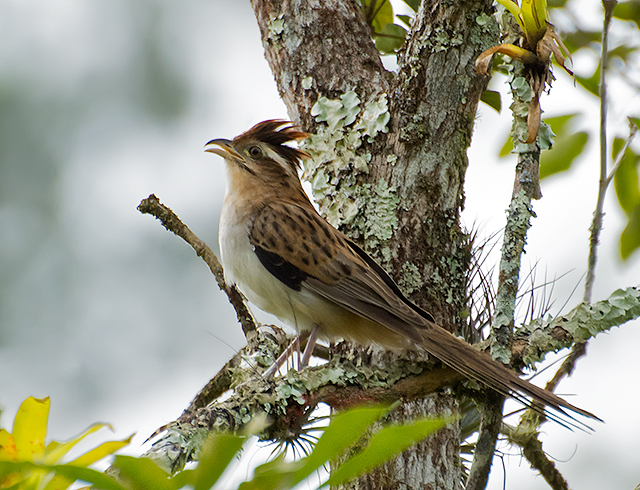
Wikipedia: Striped cuckoo
![]() The striped cuckoo (Tapera naevia) is a near-passerine bird, the only member of the genus Tapera. This resident cuckoo is found from Mexico and Trinidad south to Bolivia and Argentina.
[more]
The striped cuckoo (Tapera naevia) is a near-passerine bird, the only member of the genus Tapera. This resident cuckoo is found from Mexico and Trinidad south to Bolivia and Argentina.
[more]
Ordnung Falconiformes (Falkenartige / Falcons and others):
Familie Falconidae:
Gattung Falco (Falcons):
Profil Wikipedia Vogelwarte BirdLife ZH Audubon Xeno-Canto BirdID NABU

Wikipedia: Peregrine falcon
Dieser Vogel erscheint jenseits grossen Meere in Kontinenten :
Europa, Nordamerika, Südamerika, Afrika.
![]() The peregrine falcon (Falco peregrinus), also known as the peregrine,[2] and historically as the duck hawk in North America,[3] is a widespread bird of prey (raptor) in the family Falconidae. A large, crow-sized falcon, it has a blue-grey back, barred white underparts, and a black head. The peregrine is renowned for its speed, reaching over 320 km/h (200 mph) during its characteristic hunting stoop (high-speed dive),[4] making it the fastest bird in the world, as well as the fastest member of the animal kingdom.[5][6][7] According to a National Geographic TV program, the highest measured speed of a peregrine falcon is 389 km/h (242 mph).[8][9] As is typical for bird-eating raptors, peregrine falcons are sexually dimorphic, with females being considerably larger than males.[10][11]
[more]
The peregrine falcon (Falco peregrinus), also known as the peregrine,[2] and historically as the duck hawk in North America,[3] is a widespread bird of prey (raptor) in the family Falconidae. A large, crow-sized falcon, it has a blue-grey back, barred white underparts, and a black head. The peregrine is renowned for its speed, reaching over 320 km/h (200 mph) during its characteristic hunting stoop (high-speed dive),[4] making it the fastest bird in the world, as well as the fastest member of the animal kingdom.[5][6][7] According to a National Geographic TV program, the highest measured speed of a peregrine falcon is 389 km/h (242 mph).[8][9] As is typical for bird-eating raptors, peregrine falcons are sexually dimorphic, with females being considerably larger than males.[10][11]
[more]
Vokalisierung: ![]() A harsh, drawn out "kiaaaa" with emphasised endings repeated in series. Much slower than Merlin, but higher pitched than Gyrfalcon. [Link]
A harsh, drawn out "kiaaaa" with emphasised endings repeated in series. Much slower than Merlin, but higher pitched than Gyrfalcon. [Link]
Rufe: ![]() Also shorter, coarse warning-calls. [Link]
Also shorter, coarse warning-calls. [Link]
Körperlich: Länge=36-48 cm,
Flügelspanne=95-110 cm,
Gewicht=582-1300 g
Profil Wikipedia Vogelwarte BirdLife ZH Audubon Xeno-Canto BirdID NABU
Night tour - sleeping trogon, tenative ID by Merlin collared trogon. 2018-02-14 18.46.34 null
Dieser Vogel erscheint jenseits grossen Meere in Kontinenten :
Europa, Nordamerika, Südamerika, Afrika.
Deutschland: Zugvogel, Wintergast
Vokalisierung: ![]() Series of harsh "kwik-wik wik". Coarseness similar to Peregrine, but pace much quicker. [Link]
Series of harsh "kwik-wik wik". Coarseness similar to Peregrine, but pace much quicker. [Link]
Rufe: ![]() Female call harsher than male. Lacking the clearer tones and attack of Kestrel. [Link]
Female call harsher than male. Lacking the clearer tones and attack of Kestrel. [Link]
Körperlich: Länge=25-30 cm,
Flügelspanne=50-62 cm,
Gewicht=125-300 g
Profil Wikipedia Audubon Xeno-Canto

Wikipedia: Aplomado falcon
Allgemein: ![]() The aplomado falcon (Falco femoralis) is a medium-sized falcon of the Americas. The species' largest contiguous range is in South America, but not in the deep interior Amazon Basin. It was long known as Falco fusco-coerulescens or Falco fuscocaerulescens, but these names are now believed to refer to the bat falcon (F. rufigularis).[2] Its resemblance in shape to the hobbies accounts for its old name orange-chested hobby. Aplomado is an unusual Spanish word for "lead-colored", referring to the blue-grey areas of the plumage – an approximate English translation would be "plumbeous falcon". Spanish names for the species include halcón aplomado and halcón fajado (roughly "banded falcon" in reference to the characteristic pattern); in Brazil it is known as falcão-de-coleira.
[more]
The aplomado falcon (Falco femoralis) is a medium-sized falcon of the Americas. The species' largest contiguous range is in South America, but not in the deep interior Amazon Basin. It was long known as Falco fusco-coerulescens or Falco fuscocaerulescens, but these names are now believed to refer to the bat falcon (F. rufigularis).[2] Its resemblance in shape to the hobbies accounts for its old name orange-chested hobby. Aplomado is an unusual Spanish word for "lead-colored", referring to the blue-grey areas of the plumage – an approximate English translation would be "plumbeous falcon". Spanish names for the species include halcón aplomado and halcón fajado (roughly "banded falcon" in reference to the characteristic pattern); in Brazil it is known as falcão-de-coleira.
[more]
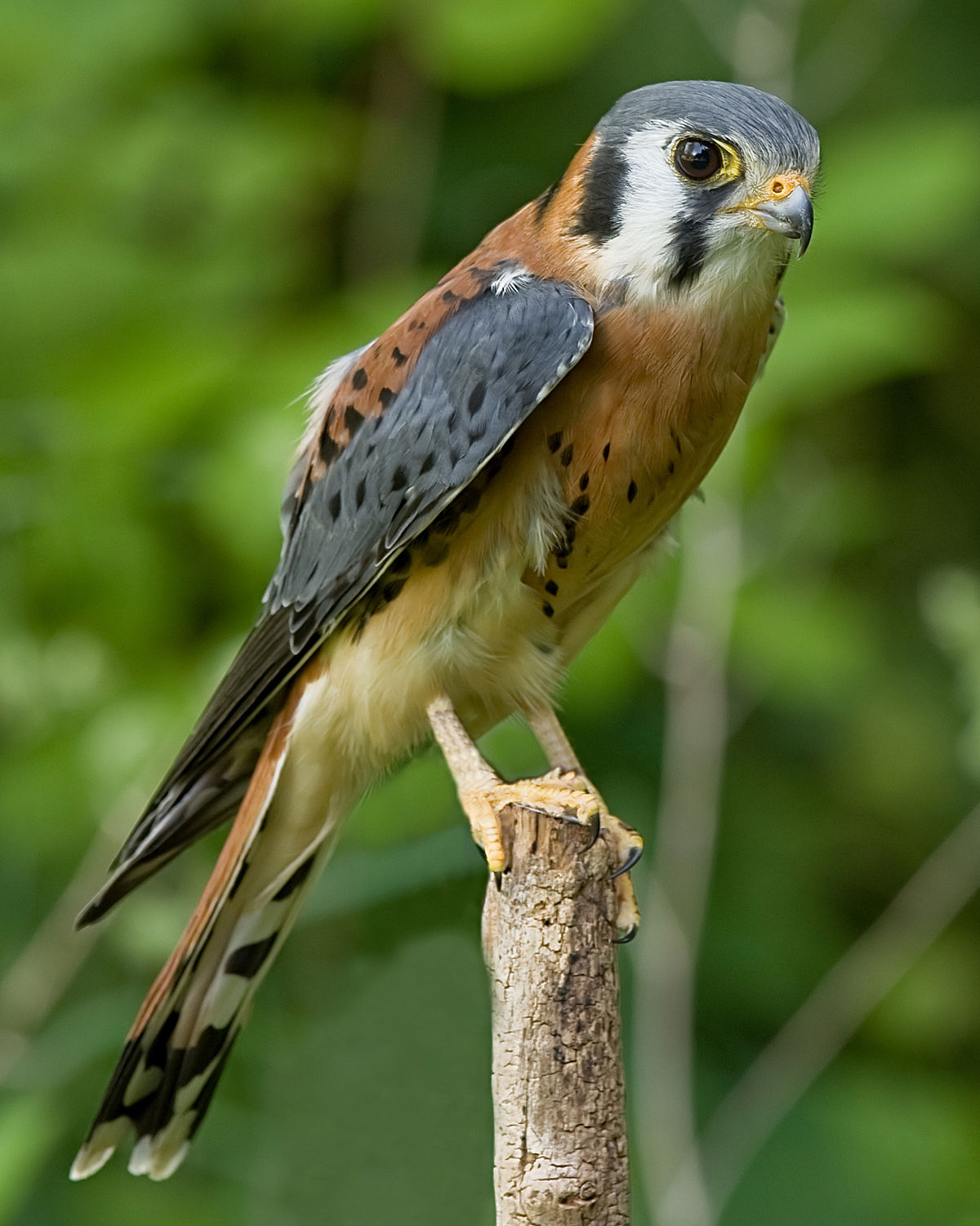
Wikipedia: American kestrel
![]() The American kestrel (Falco sparverius), also called the sparrow hawk, is the smallest and most common falcon in North America. It has a roughly two-to-one range in size over subspecies and sex, varying in size from about the weight of a blue jay to a mourning dove. It also ranges to South America and is a well-established species that has evolved into 17 subspecies adapted to different environments and habitats throughout the Americas. It exhibits sexual dimorphism in size (females being moderately larger) and plumage, although both sexes have a rufous back with noticeable barring. Its plumage is colorful and attractive, and juveniles are similar in plumage to adults.
[more]
The American kestrel (Falco sparverius), also called the sparrow hawk, is the smallest and most common falcon in North America. It has a roughly two-to-one range in size over subspecies and sex, varying in size from about the weight of a blue jay to a mourning dove. It also ranges to South America and is a well-established species that has evolved into 17 subspecies adapted to different environments and habitats throughout the Americas. It exhibits sexual dimorphism in size (females being moderately larger) and plumage, although both sexes have a rufous back with noticeable barring. Its plumage is colorful and attractive, and juveniles are similar in plumage to adults.
[more]
Profil Wikipedia Xeno-Canto

Wikipedia: Bat falcon
![]() The bat falcon (Falco rufigularis) is a falcon that is a resident breeder in tropical Mexico, Central and South America, and Trinidad. It was long known as Falco albigularis; the names Falco fusco-coerulescens or Falco fuscocaerulescens, long used for the aplomado falcon, are now believed to refer to the present species.[2]
[more]
The bat falcon (Falco rufigularis) is a falcon that is a resident breeder in tropical Mexico, Central and South America, and Trinidad. It was long known as Falco albigularis; the names Falco fusco-coerulescens or Falco fuscocaerulescens, long used for the aplomado falcon, are now believed to refer to the present species.[2]
[more]
Profil Wikipedia Xeno-Canto

Wikipedia: Orange-breasted falcon
![]() The orange-breasted falcon (Falco deiroleucus) is a bird of the falcon family. It is probably closely related to and looks like a larger version of the bat falcon. These two, in turn, are probably closest to the aplomado falcon and constitute a rather old American lineage of Falco.[2]
[more]
The orange-breasted falcon (Falco deiroleucus) is a bird of the falcon family. It is probably closely related to and looks like a larger version of the bat falcon. These two, in turn, are probably closest to the aplomado falcon and constitute a rather old American lineage of Falco.[2]
[more]
Gattung Micrastur:
Profil Wikipedia Xeno-Canto

Wikipedia: Barred forest-falcon
![]() The barred forest falcon (Micrastur ruficollis) is a species of bird of prey in the family Falconidae which includes the falcons, caracaras, and their relatives. It occurs throughout most of tropical and subtropical Latin America, except the arid Pacific coast in South America, northern and western Mexico, and the Antilles.
[more]
The barred forest falcon (Micrastur ruficollis) is a species of bird of prey in the family Falconidae which includes the falcons, caracaras, and their relatives. It occurs throughout most of tropical and subtropical Latin America, except the arid Pacific coast in South America, northern and western Mexico, and the Antilles.
[more]

Wikipedia: Slaty-backed forest-falcon
![]() The slaty-backed forest falcon (Micrastur mirandollei) is a species of bird of prey in the family Falconidae.
It is found in Bolivia, Brazil, Colombia, Costa Rica, Ecuador, French Guiana, Guyana, Panama, Peru, Suriname, and Venezuela. Its natural habitat is subtropical or tropical moist lowland forests. It is an active hunter that preys on birds, snakes, lizards, rodents, fish, and sometimes bats. Its call is different from that of other forest falcons, with 7-10 notes repeated in a series.
[more]
The slaty-backed forest falcon (Micrastur mirandollei) is a species of bird of prey in the family Falconidae.
It is found in Bolivia, Brazil, Colombia, Costa Rica, Ecuador, French Guiana, Guyana, Panama, Peru, Suriname, and Venezuela. Its natural habitat is subtropical or tropical moist lowland forests. It is an active hunter that preys on birds, snakes, lizards, rodents, fish, and sometimes bats. Its call is different from that of other forest falcons, with 7-10 notes repeated in a series.
[more]
Profil Wikipedia Xeno-Canto

Wikipedia: Collared forest-falcon
![]() The collared forest falcon (Micrastur semitorquatus) is a species of bird of prey in the family Falconidae. It is the largest member of the Micrastur genus and a common inhabitant of tropical rainforests in Latin America.[2] Hiding in the dense forest canopy, they are a secretive bird often only recognized by their distinctive call. With a morphology or body type allowing them to be agile in their forested habitat, their diet comprises a wide variety of prey from smaller frogs (20 g) to adult turkeys (2.7-3.2 kg).[3]
[more]
The collared forest falcon (Micrastur semitorquatus) is a species of bird of prey in the family Falconidae. It is the largest member of the Micrastur genus and a common inhabitant of tropical rainforests in Latin America.[2] Hiding in the dense forest canopy, they are a secretive bird often only recognized by their distinctive call. With a morphology or body type allowing them to be agile in their forested habitat, their diet comprises a wide variety of prey from smaller frogs (20 g) to adult turkeys (2.7-3.2 kg).[3]
[more]
Gattung Milvago:
Profil Wikipedia Xeno-Canto

Wikipedia: Yellow-headed caracara
![]() The yellow-headed caracara (Milvago chimachima) is a bird of prey in the family Falconidae. It is found in tropical and subtropical South America and the southern portion of Central America. Unlike the falcons in the same family, the caracara is not a fast-flying aerial hunter, but is rather sluggish and often obtains food by scavenging.
[more]
The yellow-headed caracara (Milvago chimachima) is a bird of prey in the family Falconidae. It is found in tropical and subtropical South America and the southern portion of Central America. Unlike the falcons in the same family, the caracara is not a fast-flying aerial hunter, but is rather sluggish and often obtains food by scavenging.
[more]
Gattung Herpetotheres:
Profil Wikipedia Xeno-Canto
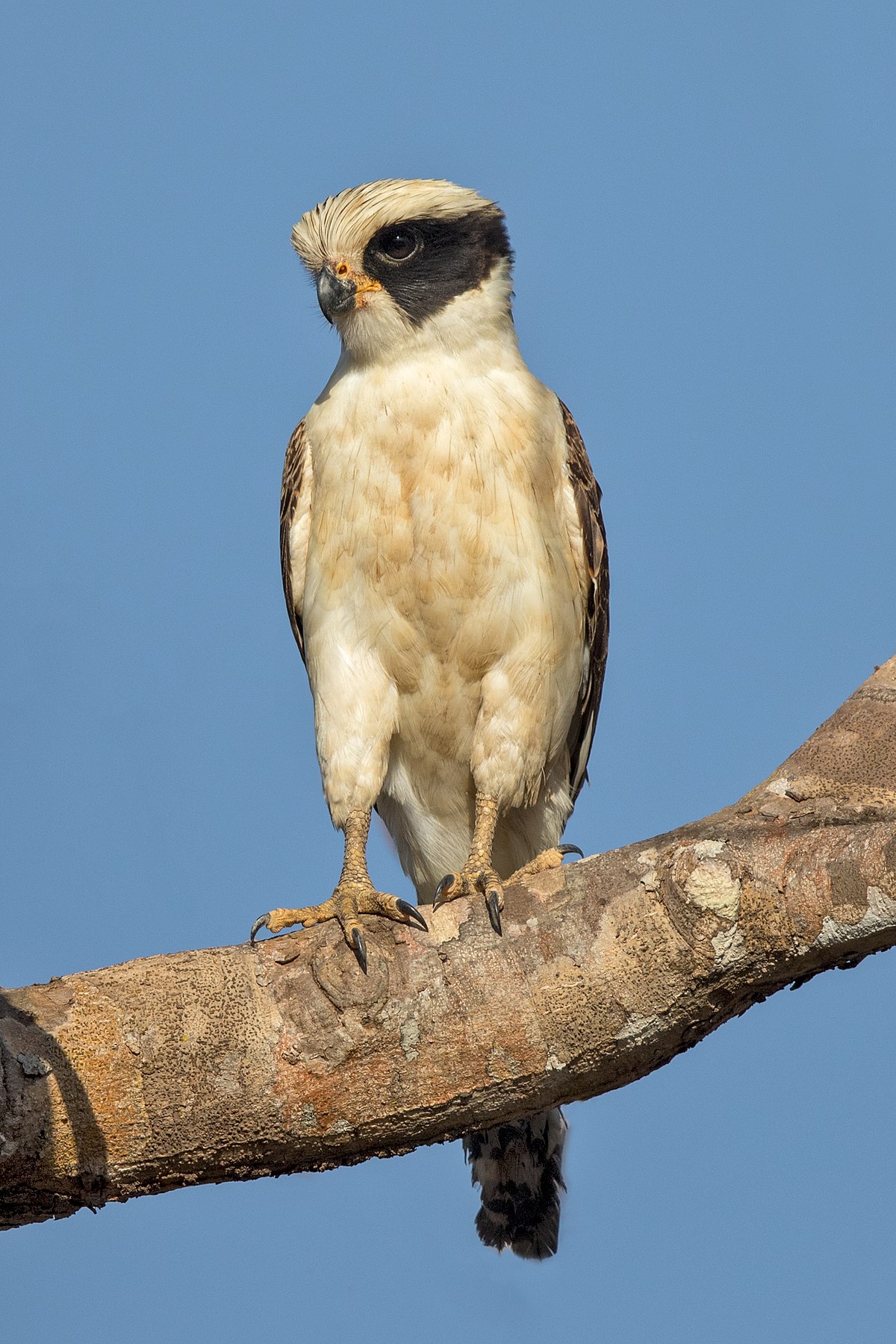
Wikipedia: Laughing falcon
![]() The laughing falcon (Herpetotheres cachinnans), also called the snake hawk (erroneously, since it is not a hawk), is a medium-sized bird of prey in the falcon family (Falconidae), the only member of the genus Herpetotheres. This Neotropical species is a specialist snake-eater. Its common and scientific names both refer to its distinctive voice.
[more]
The laughing falcon (Herpetotheres cachinnans), also called the snake hawk (erroneously, since it is not a hawk), is a medium-sized bird of prey in the falcon family (Falconidae), the only member of the genus Herpetotheres. This Neotropical species is a specialist snake-eater. Its common and scientific names both refer to its distinctive voice.
[more]
Gattung Caracara:
Profil Wikipedia Audubon Xeno-Canto

Wikipedia: Crested caracara
![]() The crested caracara (Caracara plancus), is a bird of prey in the family Falconidae. As presently defined, the crested caracara is found in South America, the southern United States, including Florida, where it has been seen on the East coast as far as extreme eastern Seminole County, Florida (Lake Harney), where it is now considered a resident but listed as threatened. There have been reports of the crested caracara as far north as San Francisco, California.[2] and, in 2012, near Crescent City, California.[3] Some are believed to possibly be living in Nova Scotia, with numerous sightings throughout the 2010s.[4] In July 2016 a northern caracara was reported and photographed by numerous people in the upper peninsula of Michigan, just outside of Munising.[5][6][7] In June 2017, a northern caracara was sighted far north in St. George, New Brunswick, Canada.[8] A specimen was photographed in Woodstock, Vermont in March 2020.[citation needed] The species has recently become more common in central and north Texas and is generally common in south Texas and south of the US border.[citation needed] It can also be found (nesting) in the Southern Caribbean (e.g. Aruba, Curaçao and Bonaire)[citation needed], Mexico, and Central America. It was formerly placed in the genus Polyborus.
[more]
The crested caracara (Caracara plancus), is a bird of prey in the family Falconidae. As presently defined, the crested caracara is found in South America, the southern United States, including Florida, where it has been seen on the East coast as far as extreme eastern Seminole County, Florida (Lake Harney), where it is now considered a resident but listed as threatened. There have been reports of the crested caracara as far north as San Francisco, California.[2] and, in 2012, near Crescent City, California.[3] Some are believed to possibly be living in Nova Scotia, with numerous sightings throughout the 2010s.[4] In July 2016 a northern caracara was reported and photographed by numerous people in the upper peninsula of Michigan, just outside of Munising.[5][6][7] In June 2017, a northern caracara was sighted far north in St. George, New Brunswick, Canada.[8] A specimen was photographed in Woodstock, Vermont in March 2020.[citation needed] The species has recently become more common in central and north Texas and is generally common in south Texas and south of the US border.[citation needed] It can also be found (nesting) in the Southern Caribbean (e.g. Aruba, Curaçao and Bonaire)[citation needed], Mexico, and Central America. It was formerly placed in the genus Polyborus.
[more]
Gattung Ibycter:

Wikipedia: Red-throated caracara
![]() The red-throated caracara (Ibycter americanus) is a social species of bird of prey in the family Falconidae. It is placed in the monotypic genus Ibycter, or sometimes united in Daptrius with the black caracara. Unique among caracaras, it mainly feeds on the larvae of bees and wasps, but also takes the adult insects and fruits and berries.[2]
[more]
The red-throated caracara (Ibycter americanus) is a social species of bird of prey in the family Falconidae. It is placed in the monotypic genus Ibycter, or sometimes united in Daptrius with the black caracara. Unique among caracaras, it mainly feeds on the larvae of bees and wasps, but also takes the adult insects and fruits and berries.[2]
[more]
Ordnung Piciformes (Spechtvögel / Woodpeckers and others):
Familie Picidae (Woodpeckers):
Gattung Colaptes:

Wikipedia: Golden-olive woodpecker
![]() The golden-olive woodpecker (Colaptes rubiginosus) is a resident breeding bird from Mexico south and east to Guyana, northwest Argentina, Trinidad and Tobago. It was formerly placed in the genus Piculus.[4] The scientific name rubiginosus means "full of rust", describing the color of the bird's wings and back.
[more]
The golden-olive woodpecker (Colaptes rubiginosus) is a resident breeding bird from Mexico south and east to Guyana, northwest Argentina, Trinidad and Tobago. It was formerly placed in the genus Piculus.[4] The scientific name rubiginosus means "full of rust", describing the color of the bird's wings and back.
[more]
Profil Wikipedia Xeno-Canto

Wikipedia: Spot-breasted woodpecker
![]() The spot-breasted woodpecker (Colaptes punctigula) is a species of bird in the family Picidae.
It is found in South America in Bolivia, Brazil, Colombia, Ecuador, French Guiana, Peru, Suriname and Venezuela and also in eastern Panama of Central America.
Its natural habitats are subtropical or tropical moist lowland forests, subtropical or tropical mangrove forests and heavily degraded former forest.
[more]
The spot-breasted woodpecker (Colaptes punctigula) is a species of bird in the family Picidae.
It is found in South America in Bolivia, Brazil, Colombia, Ecuador, French Guiana, Peru, Suriname and Venezuela and also in eastern Panama of Central America.
Its natural habitats are subtropical or tropical moist lowland forests, subtropical or tropical mangrove forests and heavily degraded former forest.
[more]
Gattung Picoides:

Wikipedia: Hairy woodpecker
![]() The hairy woodpecker (Leuconotopicus villosus) is a medium-sized woodpecker that is found over a large area of North America. It is approximately 250 mm (9.8 in) in length with a 380 mm (15 in) wingspan.[2] With an estimated population in 2003 of over nine million individuals, the hairy woodpecker is listed by the IUCN as a species of least concern.[3] Some ornithologists place this species in the genus Dryobates.
[more]
The hairy woodpecker (Leuconotopicus villosus) is a medium-sized woodpecker that is found over a large area of North America. It is approximately 250 mm (9.8 in) in length with a 380 mm (15 in) wingspan.[2] With an estimated population in 2003 of over nine million individuals, the hairy woodpecker is listed by the IUCN as a species of least concern.[3] Some ornithologists place this species in the genus Dryobates.
[more]
Gattung Dryocopus:
Profil Wikipedia Xeno-Canto
Lineated woodpecker cahal pech. 2018-02-04 15.57.04 null
![]() The lineated woodpecker (Dryocopus lineatus) is a very large woodpecker which is a resident breeding bird from southern Mexico to northern Argentina and on Trinidad in the Caribbean.
[more]
The lineated woodpecker (Dryocopus lineatus) is a very large woodpecker which is a resident breeding bird from southern Mexico to northern Argentina and on Trinidad in the Caribbean.
[more]
Gattung Piculus:
Profil Wikipedia Xeno-Canto

Wikipedia: Rufous-winged woodpecker
![]() The rufous-winged woodpecker (Piculus simplex) is a species of bird in the family Picidae. It is found in Costa Rica, Honduras, Nicaragua and Panama. Its natural habitat is subtropical or tropical moist lowland forests.
[more]
The rufous-winged woodpecker (Piculus simplex) is a species of bird in the family Picidae. It is found in Costa Rica, Honduras, Nicaragua and Panama. Its natural habitat is subtropical or tropical moist lowland forests.
[more]
Profil Wikipedia Xeno-Canto

Wikipedia: Golden-green woodpecker
![]() The golden-green woodpecker (Piculus chrysochloros) is a species of bird in the family Picidae, the woodpeckers, piculets and wrynecks.
It is found in north-central South America, centered on the Amazon Basin in the countries of Argentina, Bolivia, Brazil, Ecuador, French Guiana, Guyana, Paraguay, Peru and Suriname. A disjunct region of the bird's range occurs in northwestern Colombia and Venezuela. A second disjunct group is found 1,500 km southeast of the Amazon Basin in the Brazilian states of Minas Gerais and Espírito Santo in an 800 km coastal strip.
[more]
The golden-green woodpecker (Piculus chrysochloros) is a species of bird in the family Picidae, the woodpeckers, piculets and wrynecks.
It is found in north-central South America, centered on the Amazon Basin in the countries of Argentina, Bolivia, Brazil, Ecuador, French Guiana, Guyana, Paraguay, Peru and Suriname. A disjunct region of the bird's range occurs in northwestern Colombia and Venezuela. A second disjunct group is found 1,500 km southeast of the Amazon Basin in the Brazilian states of Minas Gerais and Espírito Santo in an 800 km coastal strip.
[more]
Gattung Veniliornis:
Profil Wikipedia Xeno-Canto

Wikipedia: Red-rumped woodpecker
![]() The red-rumped woodpecker (Veniliornis kirkii) is a resident breeding bird from Costa Rica south and east to Ecuador, Venezuela, Trinidad and Tobago.
[more]
The red-rumped woodpecker (Veniliornis kirkii) is a resident breeding bird from Costa Rica south and east to Ecuador, Venezuela, Trinidad and Tobago.
[more]
Gattung Sphyrapicus:
Profil Wikipedia Audubon Xeno-Canto

Wikipedia: Yellow-bellied sapsucker
![]() The yellow-bellied sapsucker (Sphyrapicus varius) is a medium-sized woodpecker that breeds in Canada and the northeastern United States.
[more]
The yellow-bellied sapsucker (Sphyrapicus varius) is a medium-sized woodpecker that breeds in Canada and the northeastern United States.
[more]
Gattung Picumnus:
Profil Wikipedia Xeno-Canto

Wikipedia: Olivaceous piculet
![]() The olivaceous piculet (Picumnus olivaceus) is a species of bird in the family Picidae. Etymologically, piculet is as a double diminutive of the Latin picus, woodpecker,[2] see also Picus. In Greek, δρύοψ is woodpecker, which shares its roots with δρῦς, 'tree'; 'oak' and Druids.
[more]
The olivaceous piculet (Picumnus olivaceus) is a species of bird in the family Picidae. Etymologically, piculet is as a double diminutive of the Latin picus, woodpecker,[2] see also Picus. In Greek, δρύοψ is woodpecker, which shares its roots with δρῦς, 'tree'; 'oak' and Druids.
[more]
Gattung Melanerpes:
Profil Wikipedia Audubon Xeno-Canto
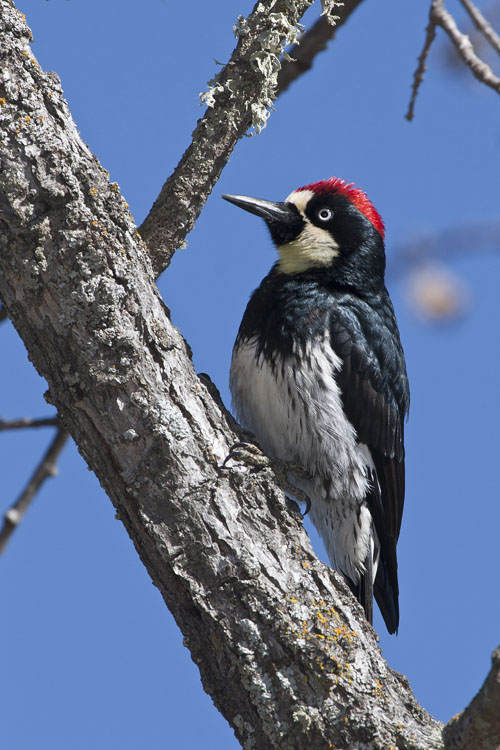
Wikipedia: Acorn woodpecker
![]() The acorn woodpecker (Melanerpes formicivorus) is a medium-sized woodpecker, 21 cm (8.3 in) long, with an average weight of 85 g (3.0 oz).
[more]
The acorn woodpecker (Melanerpes formicivorus) is a medium-sized woodpecker, 21 cm (8.3 in) long, with an average weight of 85 g (3.0 oz).
[more]
Profil Wikipedia Xeno-Canto

Wikipedia: Golden-naped woodpecker
![]() The golden-naped woodpecker (Melanerpes chrysauchen) is a species of bird in the woodpecker family Picidae. The species is very closely related to the beautiful woodpecker, which is sometimes treated as the same species. The two species, along with several other species, are sometimes placed in the genus Tripsurus.[2]
[more]
The golden-naped woodpecker (Melanerpes chrysauchen) is a species of bird in the woodpecker family Picidae. The species is very closely related to the beautiful woodpecker, which is sometimes treated as the same species. The two species, along with several other species, are sometimes placed in the genus Tripsurus.[2]
[more]
Profil Wikipedia Xeno-Canto

Wikipedia: Black-cheeked woodpecker
![]() The black-cheeked woodpecker (Melanerpes pucherani) is a resident breeding bird from southeastern Mexico south to western Ecuador.
[more]
The black-cheeked woodpecker (Melanerpes pucherani) is a resident breeding bird from southeastern Mexico south to western Ecuador.
[more]
Profil Wikipedia Xeno-Canto
Red crowned woodpecker. 2020-02-18 09.37.00 null
![]() The red-crowned woodpecker (Melanerpes rubricapillus) is a resident breeding bird from southwestern Costa Rica, Panama, Colombia, Venezuela, the Guianas and Tobago.[2]
[more]
The red-crowned woodpecker (Melanerpes rubricapillus) is a resident breeding bird from southwestern Costa Rica, Panama, Colombia, Venezuela, the Guianas and Tobago.[2]
[more]

Wikipedia: Hoffmann's woodpecker
![]() Hoffmann's woodpecker (Melanerpes hoffmannii) is a resident breeding bird from southern Honduras south to Costa Rica. It is a common species on the Pacific slopes, locally as high as 2,150 m (7,050 ft). It is expanding on the Caribbean slope, aided by deforestation. This is further facilitated by its tendency to wander about outside the breeding season.[2]
[more]
Hoffmann's woodpecker (Melanerpes hoffmannii) is a resident breeding bird from southern Honduras south to Costa Rica. It is a common species on the Pacific slopes, locally as high as 2,150 m (7,050 ft). It is expanding on the Caribbean slope, aided by deforestation. This is further facilitated by its tendency to wander about outside the breeding season.[2]
[more]
Gattung Campephilus:
Profil Wikipedia Xeno-Canto
Arenal pale-billed woodpecker. 2018-02-27 15.51.26 null
![]() The pale-billed woodpecker (Campephilus guatemalensis) is a very large woodpecker that is a resident breeding bird from northern Mexico to western Panama.
[more]
The pale-billed woodpecker (Campephilus guatemalensis) is a very large woodpecker that is a resident breeding bird from northern Mexico to western Panama.
[more]

Wikipedia: Crimson-bellied woodpecker
![]() The crimson-bellied woodpecker (Campephilus haematogaster) is a species of bird in the family Picidae.
It is found in Colombia, Ecuador, Panama, and Peru.
Its natural habitats are subtropical or tropical moist lowland forest and subtropical or tropical moist montane forest.
[more]
The crimson-bellied woodpecker (Campephilus haematogaster) is a species of bird in the family Picidae.
It is found in Colombia, Ecuador, Panama, and Peru.
Its natural habitats are subtropical or tropical moist lowland forest and subtropical or tropical moist montane forest.
[more]
Profil Wikipedia Xeno-Canto

Wikipedia: Crimson-crested woodpecker
![]() The crimson-crested woodpecker (Campephilus melanoleucos) is a very large woodpecker which is a resident breeding bird from Panama south to northern border regions of Argentina, and on Trinidad.
[more]
The crimson-crested woodpecker (Campephilus melanoleucos) is a very large woodpecker which is a resident breeding bird from Panama south to northern border regions of Argentina, and on Trinidad.
[more]
Gattung Celeus:
Profil Wikipedia Xeno-Canto

Wikipedia: Chestnut-colored woodpecker
![]() The chestnut-colored woodpecker (Celeus castaneus) is a species of bird in the family Picidae.
It is found in Belize, Costa Rica, Guatemala, Honduras, Mexico, Nicaragua, and Panama.
[more]
The chestnut-colored woodpecker (Celeus castaneus) is a species of bird in the family Picidae.
It is found in Belize, Costa Rica, Guatemala, Honduras, Mexico, Nicaragua, and Panama.
[more]
Profil Wikipedia Xeno-Canto

Wikipedia: Cinnamon woodpecker
![]() The cinnamon woodpecker (Celeus loricatus) is a species of bird in the family Picidae.
[more]
The cinnamon woodpecker (Celeus loricatus) is a species of bird in the family Picidae.
[more]
Gattung Dryobates:
Profil Wikipedia Audubon Xeno-Canto

Wikipedia: Hairy woodpecker
![]() The hairy woodpecker (Leuconotopicus villosus) is a medium-sized woodpecker that is found over a large area of North America. It is approximately 250 mm (9.8 in) in length with a 380 mm (15 in) wingspan.[2] With an estimated population in 2003 of over nine million individuals, the hairy woodpecker is listed by the IUCN as a species of least concern.[3] Some ornithologists place this species in the genus Dryobates.
[more]
The hairy woodpecker (Leuconotopicus villosus) is a medium-sized woodpecker that is found over a large area of North America. It is approximately 250 mm (9.8 in) in length with a 380 mm (15 in) wingspan.[2] With an estimated population in 2003 of over nine million individuals, the hairy woodpecker is listed by the IUCN as a species of least concern.[3] Some ornithologists place this species in the genus Dryobates.
[more]
Profil Wikipedia Xeno-Canto
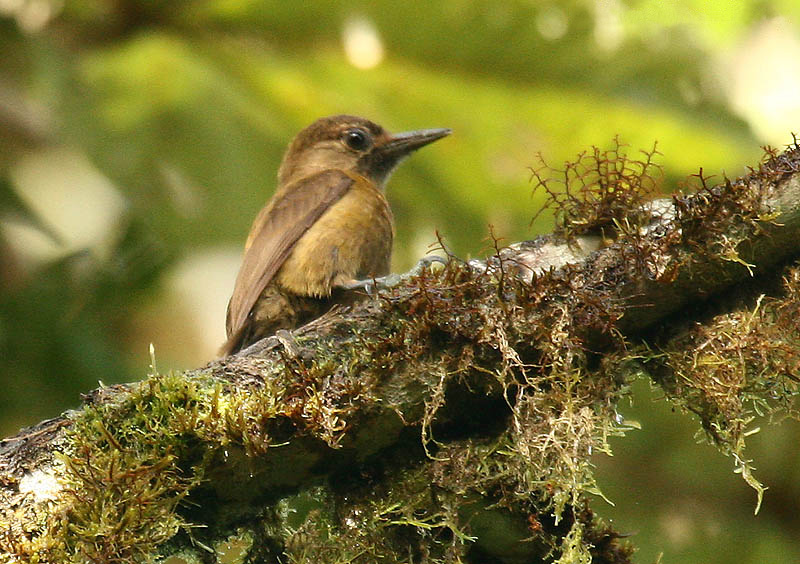
Wikipedia: Smoky-brown woodpecker
![]() The smoky-brown woodpecker or brown woodpecker (Leuconotopicus fumigatus) is a species of bird in the family Picidae.
[more]
The smoky-brown woodpecker or brown woodpecker (Leuconotopicus fumigatus) is a species of bird in the family Picidae.
[more]
Familie Ramphastidae:
Gattung Aulacorhynchus:

Wikipedia: Northern emerald-toucanet
![]() The emerald toucanet or northern emerald toucanet (Aulacorhynchus prasinus) is a species of near-passerine bird in the family Ramphastidae occurring in mountainous regions of Mexico and Central America.[4] Several taxa formerly included within this species have now been re-classified into separate species of their own (see Taxonomy).
[more]
The emerald toucanet or northern emerald toucanet (Aulacorhynchus prasinus) is a species of near-passerine bird in the family Ramphastidae occurring in mountainous regions of Mexico and Central America.[4] Several taxa formerly included within this species have now been re-classified into separate species of their own (see Taxonomy).
[more]
Gattung Capito:
Profil Wikipedia Xeno-Canto

Wikipedia: Spot-crowned barbet
![]() The spot-crowned barbet (Capito maculicoronatus) is a species of bird in the family Capitonidae. It is found in Colombia and Panama. Its natural habitats are subtropical or tropical moist lowland forest and heavily degraded former forest.
[more]
The spot-crowned barbet (Capito maculicoronatus) is a species of bird in the family Capitonidae. It is found in Colombia and Panama. Its natural habitats are subtropical or tropical moist lowland forest and heavily degraded former forest.
[more]
Gattung Eubucco:
Profil Wikipedia Xeno-Canto

Wikipedia: Red-headed barbet
![]() The red-headed barbet (Eubucco bourcierii) is a species of bird in the family Capitonidae. It is found in humid highland forest in Costa Rica and Panama, as well as the Andes in western Venezuela, Colombia, Ecuador and far northern Peru. The diet of the red-headed barbet may include bananas and various other fruits.[2]
[more]
The red-headed barbet (Eubucco bourcierii) is a species of bird in the family Capitonidae. It is found in humid highland forest in Costa Rica and Panama, as well as the Andes in western Venezuela, Colombia, Ecuador and far northern Peru. The diet of the red-headed barbet may include bananas and various other fruits.[2]
[more]
Gattung Pteroglossus:
Profil Wikipedia Xeno-Canto
Tikal collared aracari. 2018-02-07 12.38.40 null
![]() The collared aracari or collared araçari (Pteroglossus torquatus) is a toucan, a near-passerine bird. It breeds from southern Mexico(North America) to Panama; also Ecuador, Colombia, Venezuela and Costa Rica.
[more]
The collared aracari or collared araçari (Pteroglossus torquatus) is a toucan, a near-passerine bird. It breeds from southern Mexico(North America) to Panama; also Ecuador, Colombia, Venezuela and Costa Rica.
[more]

Wikipedia: Fiery-billed aracari
![]() The fiery-billed aracari or fiery-billed araçari (Pteroglossus frantzii) is a toucan, a near-passerine bird. It breeds only on the Pacific slopes of southern Costa Rica and western Panama. The binomial commemorates the German naturalist Alexander von Frantzius.
[more]
The fiery-billed aracari or fiery-billed araçari (Pteroglossus frantzii) is a toucan, a near-passerine bird. It breeds only on the Pacific slopes of southern Costa Rica and western Panama. The binomial commemorates the German naturalist Alexander von Frantzius.
[more]
Gattung Ramphastos:
Profil Wikipedia Xeno-Canto
Keel billed toucan. 2020-02-19 06.49.02
We saw this on the grounds of Gamboa Rainforest Resort and around Panama and Costa Rica.
Allgemein: ![]() Der Fischertukan (Ramphastos sulfuratus), auch Regenbogentukan genannt, ist eine im tropischen Mittel- und Südamerika lebende Vogelart aus der Familie der Tukane. Es werden zwei Unterarten unterschieden. Der Fischertukan gehört zu den am besten erforschten Tukanarten, bereits 1929 führte der Ornithologe Josselyn van Tyne ausführliche Freilandstudien an dieser Art durch.[1] Sie wird wegen ihrer Größe und Farbenpracht verhältnismäßig häufig in Zoologischen Gärten und Vogelparks gehalten. Die Welt-Erstzucht erfolgte 1974 im Zoo von Houston, die europäische Erstzucht gelang 1983 dem Wuppertaler Zoo.[2]
[more]
Der Fischertukan (Ramphastos sulfuratus), auch Regenbogentukan genannt, ist eine im tropischen Mittel- und Südamerika lebende Vogelart aus der Familie der Tukane. Es werden zwei Unterarten unterschieden. Der Fischertukan gehört zu den am besten erforschten Tukanarten, bereits 1929 führte der Ornithologe Josselyn van Tyne ausführliche Freilandstudien an dieser Art durch.[1] Sie wird wegen ihrer Größe und Farbenpracht verhältnismäßig häufig in Zoologischen Gärten und Vogelparks gehalten. Die Welt-Erstzucht erfolgte 1974 im Zoo von Houston, die europäische Erstzucht gelang 1983 dem Wuppertaler Zoo.[2]
[more]
Profil Wikipedia Xeno-Canto

Wikipedia: Yellow-throated toucan
![]() The yellow-throated toucan (Ramphastos ambiguus) is a large toucan in the family Ramphastidae found in Central and northern South America.
[more]
The yellow-throated toucan (Ramphastos ambiguus) is a large toucan in the family Ramphastidae found in Central and northern South America.
[more]
Gattung Selenidera:
Profil Wikipedia Xeno-Canto

Wikipedia: Yellow-eared toucanet
![]() The yellow-eared toucanet (Selenidera spectabilis) is a species of bird in the family Ramphastidae found in humid forests of Central America and the Chocó. Cassin's aracari is an alternate name for the yellow-eared toucanet. A somewhat aberrant member of the genus Selenidera, it is relatively large (total length approximately 38 cm [15 in]) and the plumage of the sexes only differ in that the male has a yellow auricular streak, while the female has a brown crown. It weighs 175-245 grams (6.2-8.7 oz.)[2]
[more]
The yellow-eared toucanet (Selenidera spectabilis) is a species of bird in the family Ramphastidae found in humid forests of Central America and the Chocó. Cassin's aracari is an alternate name for the yellow-eared toucanet. A somewhat aberrant member of the genus Selenidera, it is relatively large (total length approximately 38 cm [15 in]) and the plumage of the sexes only differ in that the male has a yellow auricular streak, while the female has a brown crown. It weighs 175-245 grams (6.2-8.7 oz.)[2]
[more]
Gattung Semnornis:
Profil Wikipedia Xeno-Canto

Wikipedia: Prong-billed barbet
![]() The prong-billed barbet (Semnornis frantzii) is a distinctive, relatively large-billed bird native to humid highland forest of Costa Rica and western Panama.
[more]
The prong-billed barbet (Semnornis frantzii) is a distinctive, relatively large-billed bird native to humid highland forest of Costa Rica and western Panama.
[more]
Ordnung Psittaciformes (Papageien / Parrots and others):
Familie Psittacidae (Parrots):
Gattung Ara:
Profil Wikipedia Xeno-Canto

Wikipedia: Great green macaw
![]() The great green macaw (Ara ambiguus), also known as Buffon's macaw or the great military macaw, is a Central and South American parrot found in Nicaragua, Honduras, Costa Rica, Panama, Colombia and Ecuador.[2] Two allopatric subspecies are recognized; the nominate subspecies, Ara ambiguus ssp. ambiguus, occurs from Honduras to Colombia, while Ara ambiguus ssp. guayaquilensis appears to be endemic to remnants of dry forests on the southern Pacific coast of Ecuador.[3] The nominate subspecies lives in the canopy of wet tropical forests and in Costa Rica is usually associated with the almendro tree, Dipteryx oleifera.[4]
[more]
The great green macaw (Ara ambiguus), also known as Buffon's macaw or the great military macaw, is a Central and South American parrot found in Nicaragua, Honduras, Costa Rica, Panama, Colombia and Ecuador.[2] Two allopatric subspecies are recognized; the nominate subspecies, Ara ambiguus ssp. ambiguus, occurs from Honduras to Colombia, while Ara ambiguus ssp. guayaquilensis appears to be endemic to remnants of dry forests on the southern Pacific coast of Ecuador.[3] The nominate subspecies lives in the canopy of wet tropical forests and in Costa Rica is usually associated with the almendro tree, Dipteryx oleifera.[4]
[more]
La tarde 3 scarlet macaws in tree our first morning. 2018-03-09 06.31.28 null
![]() The scarlet macaw (Ara macao) is a large red, yellow, and blue Central and South American parrot, a member of a large group of Neotropical parrots called macaws. It is native to humid evergreen forests of tropical Central and South America. Its range extends from south-eastern Mexico to the Peruvian Amazon, Ecuador, Colombia, Bolivia, Venezuela and Brazil in lowlands of 500 m (1,600 ft) (at least formerly) up to 1,000 m (3,300 ft), as well as the Pacific island of Coiba. Formerly, it ranged north to southern Tamaulipas. In some areas, it has suffered local extinction because of habitat destruction, or capture for the parrot trade, but in other areas, it remains fairly common. It is the national bird of Honduras. Like its relative the blue-and-yellow macaw, scarlet macaws are popular birds in aviculture as a result of their striking plumage.
[more]
The scarlet macaw (Ara macao) is a large red, yellow, and blue Central and South American parrot, a member of a large group of Neotropical parrots called macaws. It is native to humid evergreen forests of tropical Central and South America. Its range extends from south-eastern Mexico to the Peruvian Amazon, Ecuador, Colombia, Bolivia, Venezuela and Brazil in lowlands of 500 m (1,600 ft) (at least formerly) up to 1,000 m (3,300 ft), as well as the Pacific island of Coiba. Formerly, it ranged north to southern Tamaulipas. In some areas, it has suffered local extinction because of habitat destruction, or capture for the parrot trade, but in other areas, it remains fairly common. It is the national bird of Honduras. Like its relative the blue-and-yellow macaw, scarlet macaws are popular birds in aviculture as a result of their striking plumage.
[more]
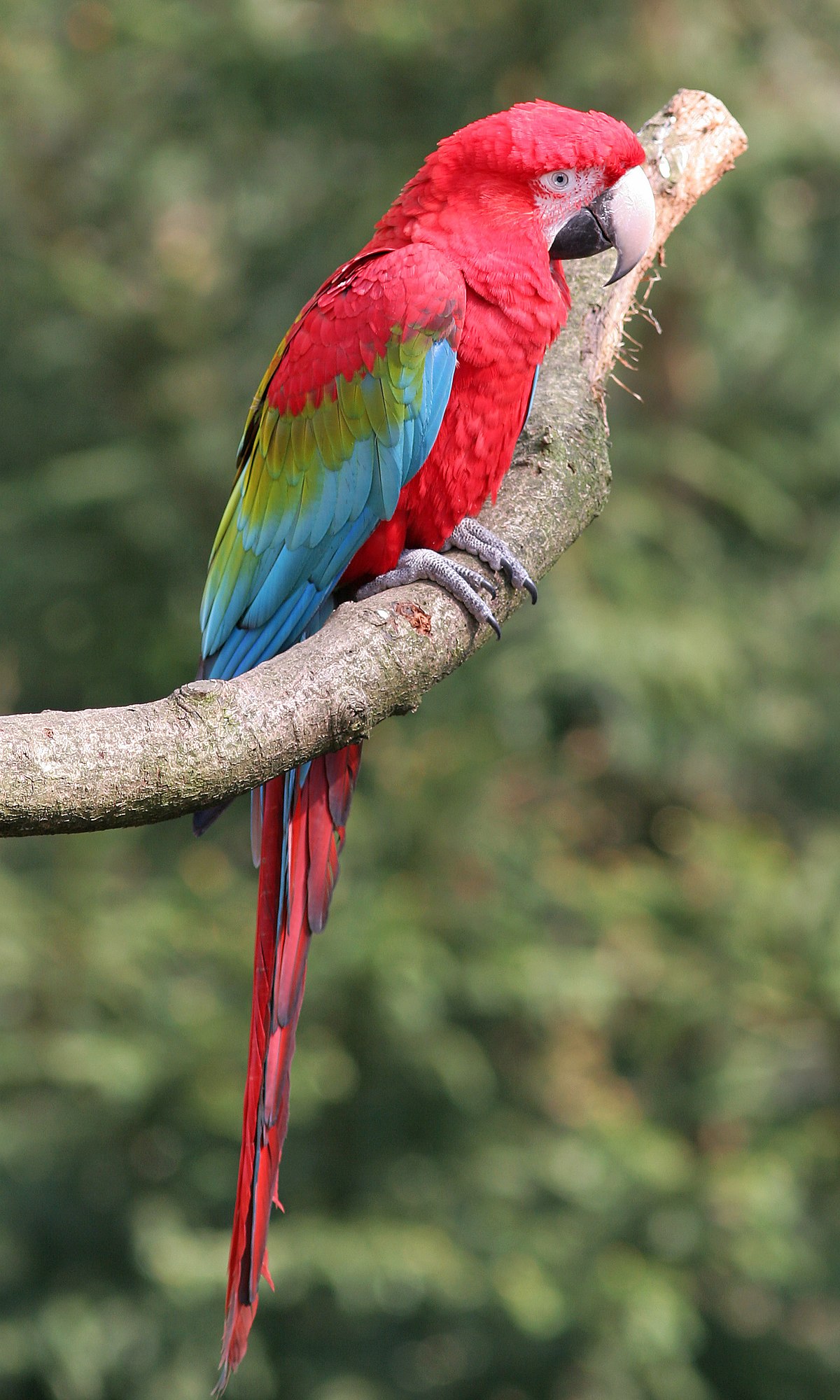
Wikipedia: Red-and-green macaw
![]() The red-and-green macaw (Ara chloropterus), also known as the green-winged macaw,[2] is a large, mostly-red macaw of the genus Ara.
[more]
The red-and-green macaw (Ara chloropterus), also known as the green-winged macaw,[2] is a large, mostly-red macaw of the genus Ara.
[more]
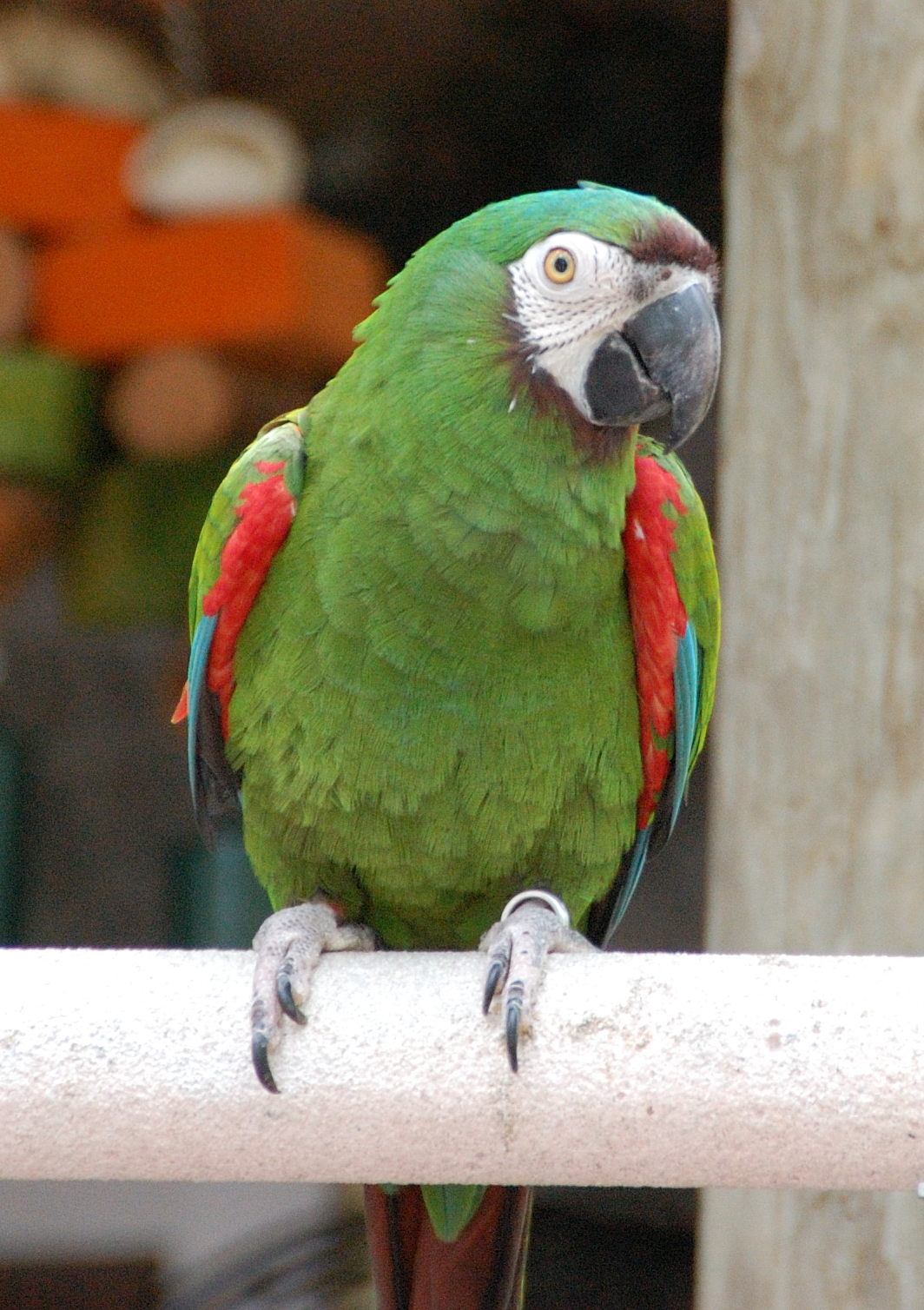
Wikipedia: Chestnut-fronted macaw
![]() The chestnut-fronted macaw or severe macaw (Ara severus) is one of the largest of the mini-macaws. It reaches a size of around 45 cm (18 in) of which around half is the length of the tail.
[more]
The chestnut-fronted macaw or severe macaw (Ara severus) is one of the largest of the mini-macaws. It reaches a size of around 45 cm (18 in) of which around half is the length of the tail.
[more]

Wikipedia: Great green macaw
![]() The great green macaw (Ara ambiguus), also known as Buffon's macaw or the great military macaw, is a Central and South American parrot found in Nicaragua, Honduras, Costa Rica, Panama, Colombia and Ecuador.[2] Two allopatric subspecies are recognized; the nominate subspecies, Ara ambiguus ssp. ambiguus, occurs from Honduras to Colombia, while Ara ambiguus ssp. guayaquilensis appears to be endemic to remnants of dry forests on the southern Pacific coast of Ecuador.[3] The nominate subspecies lives in the canopy of wet tropical forests and in Costa Rica is usually associated with the almendro tree, Dipteryx oleifera.[4]
[more]
The great green macaw (Ara ambiguus), also known as Buffon's macaw or the great military macaw, is a Central and South American parrot found in Nicaragua, Honduras, Costa Rica, Panama, Colombia and Ecuador.[2] Two allopatric subspecies are recognized; the nominate subspecies, Ara ambiguus ssp. ambiguus, occurs from Honduras to Colombia, while Ara ambiguus ssp. guayaquilensis appears to be endemic to remnants of dry forests on the southern Pacific coast of Ecuador.[3] The nominate subspecies lives in the canopy of wet tropical forests and in Costa Rica is usually associated with the almendro tree, Dipteryx oleifera.[4]
[more]

Wikipedia: Blue-and-yellow macaw
![]() The blue-and-yellow macaw (Ara ararauna), also known as the blue-and-gold macaw, is a large South American parrot with mostly blue top parts and light orange underparts, with gradient hues of green on top of its head. It is a member of the large group of neotropical parrots known as macaws. It inhabits forest (especially varzea, but also in open sections of terra firme or unflooded forest), woodland and savannah of tropical South America. They are popular in aviculture because of their striking color, ability to talk, ready availability in the marketplace, and close bonding to humans.
[more]
The blue-and-yellow macaw (Ara ararauna), also known as the blue-and-gold macaw, is a large South American parrot with mostly blue top parts and light orange underparts, with gradient hues of green on top of its head. It is a member of the large group of neotropical parrots known as macaws. It inhabits forest (especially varzea, but also in open sections of terra firme or unflooded forest), woodland and savannah of tropical South America. They are popular in aviculture because of their striking color, ability to talk, ready availability in the marketplace, and close bonding to humans.
[more]
Gattung Amazona:
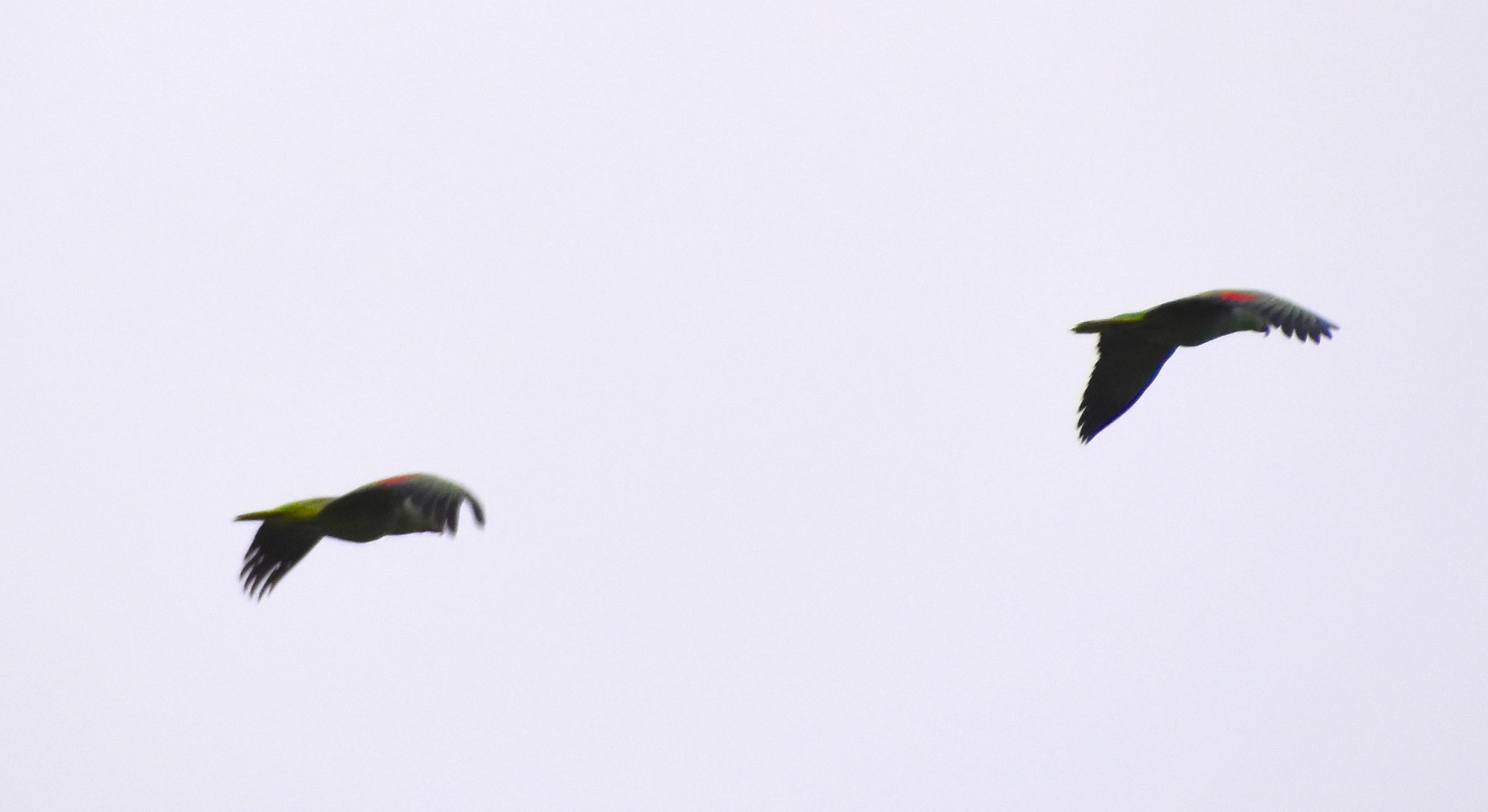
Probably red-lored amazons flying gamboa. 2020-02-19 17.41.24 null
It's hard to overlook this parrot because of the incredible racket they make! In Manzanilla, Costa Rica, small groups of them (more properly called pandemoniums) flew past our house every morning and evening.
Allgemein: ![]() Die Rotstirnamazone (Amazona autumnalis), früher Gelbwangenamazone genannt, ist eine Papageienart aus der Unterfamilie der Neuweltpapageien.
[more]
Die Rotstirnamazone (Amazona autumnalis), früher Gelbwangenamazone genannt, ist eine Papageienart aus der Unterfamilie der Neuweltpapageien.
[more]
Possibly mealy parrots in Manzanillo, Costa Rica. 2020-03-12 17.25.08 null
Profil Wikipedia Xeno-Canto
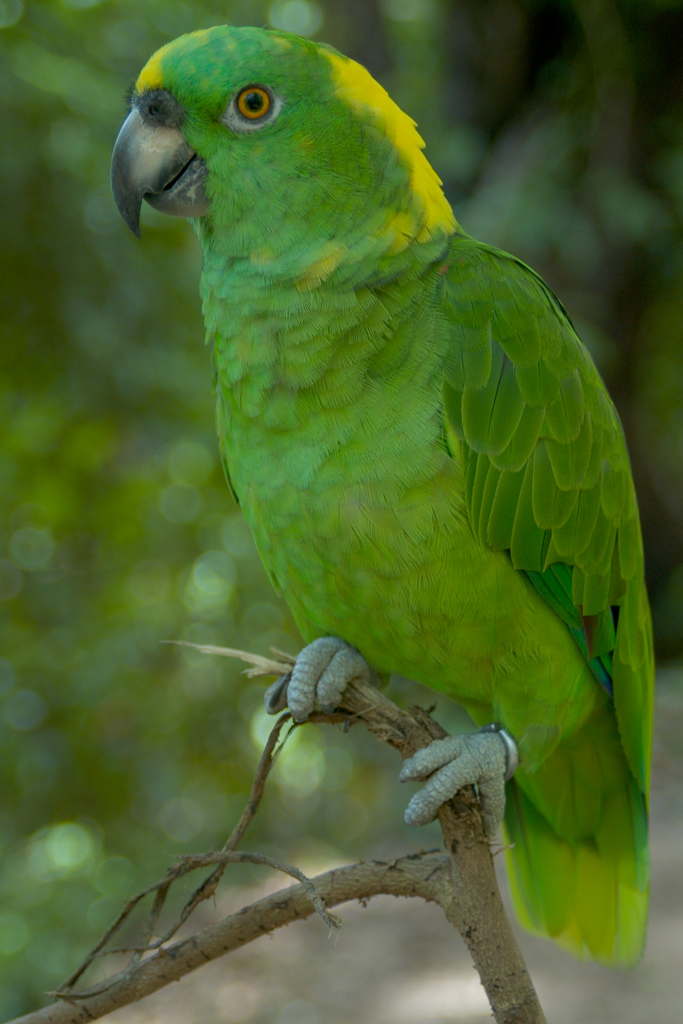
Wikipedia: Yellow-naped parrot
![]() Amazona ochrocephala auropalliata
[more]
Amazona ochrocephala auropalliata
[more]

Wikipedia: White-fronted parrot
![]() The white-fronted amazon (Amazona albifrons) also known as the white-fronted parrot, or by the adopted slang term spectacled amazon parrot, is a Central American species of parrot. Not to be confused with the red-spectacled amazon. They can imitate a range from 30 to 40 different sounds. Like other large parrots, the white-fronted parrot has a long potential life span, usually around 40 years.
[more]
The white-fronted amazon (Amazona albifrons) also known as the white-fronted parrot, or by the adopted slang term spectacled amazon parrot, is a Central American species of parrot. Not to be confused with the red-spectacled amazon. They can imitate a range from 30 to 40 different sounds. Like other large parrots, the white-fronted parrot has a long potential life span, usually around 40 years.
[more]

Wikipedia: Yellow-crowned parrot
![]() The yellow-crowned amazon or yellow-crowned parrot (Amazona ochrocephala) is a species of parrot native to tropical South America, Panama and Trinidad and Tobago. The taxonomy is highly complex and the yellow-headed (A. oratrix) and yellow-naped amazon (A. auropalliata) are sometimes considered subspecies of the yellow-crowned amazon. Except in the taxonomic section, the following deals only with the nominate group (including subspecies xantholaema, nattereri and panamensis).They are found in the Amazon basin.
[more]
The yellow-crowned amazon or yellow-crowned parrot (Amazona ochrocephala) is a species of parrot native to tropical South America, Panama and Trinidad and Tobago. The taxonomy is highly complex and the yellow-headed (A. oratrix) and yellow-naped amazon (A. auropalliata) are sometimes considered subspecies of the yellow-crowned amazon. Except in the taxonomic section, the following deals only with the nominate group (including subspecies xantholaema, nattereri and panamensis).They are found in the Amazon basin.
[more]
Gattung Pionus:
Arenal white-crowned parrot tentative ID by Merlin. 2018-03-01 06.54.32 null
![]() The white-capped parrot (Pionus seniloides) is a bird in the family Psittacidae formerly considered conspecific with the speckle-faced parrot (Pionus tumultuosus).
The species is found in the Andes mountains from northwestern Venezuela, through Colombia and Ecuador, to northern Peru.[2]
[more]
The white-capped parrot (Pionus seniloides) is a bird in the family Psittacidae formerly considered conspecific with the speckle-faced parrot (Pionus tumultuosus).
The species is found in the Andes mountains from northwestern Venezuela, through Colombia and Ecuador, to northern Peru.[2]
[more]
Profil Wikipedia Xeno-Canto
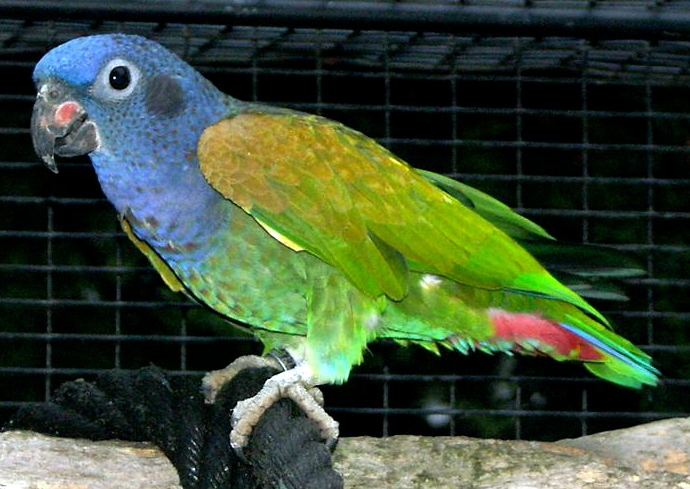
Wikipedia: Blue-headed parrot
![]() The blue-headed parrot, also known as the blue-headed pionus (Pionus menstruus) is a medium-sized parrot of about 27 cm in length. The body is mostly green, with a blue head and neck, and red undertail coverts.[2] It is a resident in tropical and subtropical South America and southern Central America, from Costa Rica, Venezuela and Trinidad south to Bolivia and Brazil.
[more]
The blue-headed parrot, also known as the blue-headed pionus (Pionus menstruus) is a medium-sized parrot of about 27 cm in length. The body is mostly green, with a blue head and neck, and red undertail coverts.[2] It is a resident in tropical and subtropical South America and southern Central America, from Costa Rica, Venezuela and Trinidad south to Bolivia and Brazil.
[more]
Gattung Pyrrhura:
Profil Wikipedia Xeno-Canto

Wikipedia: Sulphur-winged parakeet
![]() The sulphur-winged parakeet (Pyrrhura hoffmanni), also known as the Hoffmann's conure in aviculture, is a medium-small parrot endemic to humid highland forests and woodlands in Costa Rica and western Panama. It occurs up to 3000 m asl, and locally down to 1300 m in the wet season. It is named for the German naturalist Karl Hoffmann.
[more]
The sulphur-winged parakeet (Pyrrhura hoffmanni), also known as the Hoffmann's conure in aviculture, is a medium-small parrot endemic to humid highland forests and woodlands in Costa Rica and western Panama. It occurs up to 3000 m asl, and locally down to 1300 m in the wet season. It is named for the German naturalist Karl Hoffmann.
[more]
Profil Wikipedia Xeno-Canto

Wikipedia: Painted parakeet
![]() The painted parakeet (Pyrrhura picta), more commonly known as the painted conure in aviculture, is a species of bird in the family Psittacidae, the true parrots. Its taxonomy is highly complex, and has undergone significant changes in recent years. As here defined, it is restricted to forests in northern South America (north of the Amazon River) and Panama. Some of the taxa here included in the painted parakeet are highly endangered.
[more]
The painted parakeet (Pyrrhura picta), more commonly known as the painted conure in aviculture, is a species of bird in the family Psittacidae, the true parrots. Its taxonomy is highly complex, and has undergone significant changes in recent years. As here defined, it is restricted to forests in northern South America (north of the Amazon River) and Panama. Some of the taxa here included in the painted parakeet are highly endangered.
[more]
Gattung Forpus:
Profil Wikipedia Xeno-Canto

Wikipedia: Spectacled parrotlet
![]() The spectacled parrotlet (Forpus conspicillatus) is a species of parrot in the family Psittacidae.
[more]
The spectacled parrotlet (Forpus conspicillatus) is a species of parrot in the family Psittacidae.
[more]
Gattung Brotogeris:
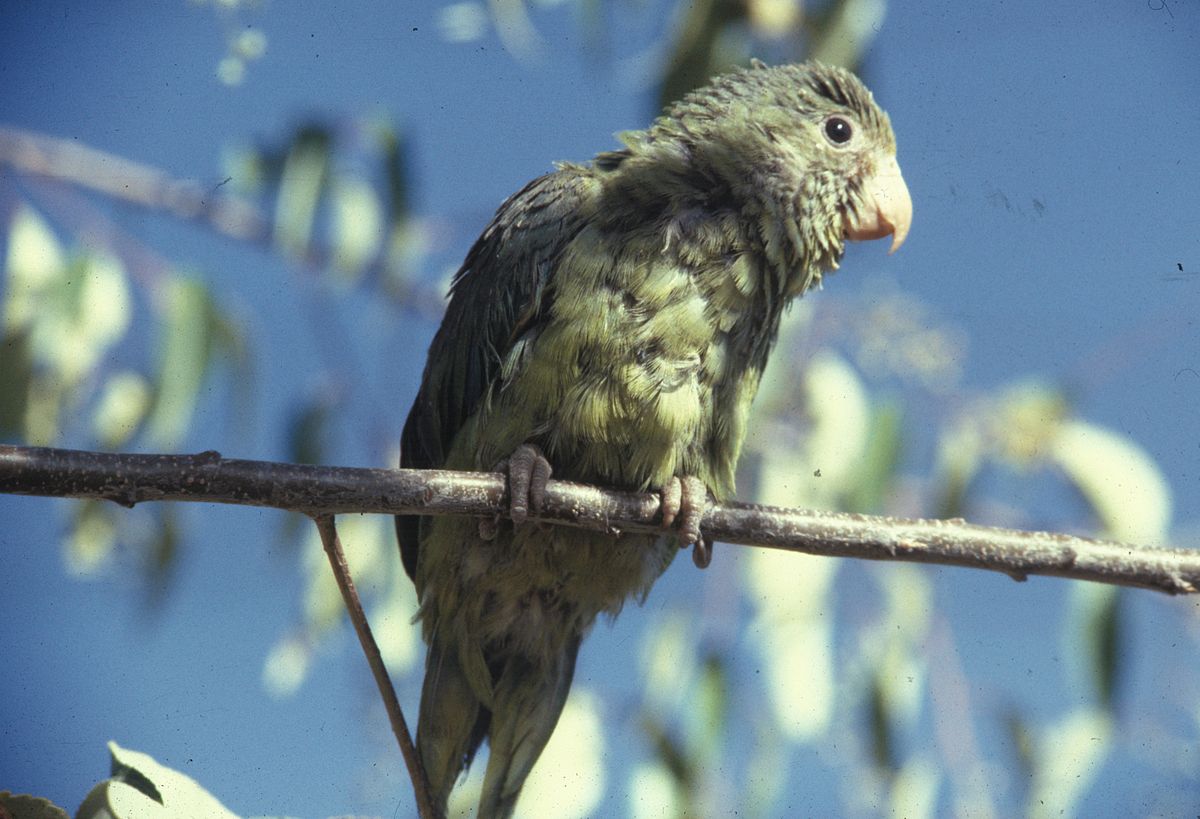
Wikipedia: Cobalt-winged parakeet
![]() The cobalt-winged parakeet (Brotogeris cyanoptera) is a species of bird in the family Psittacidae, the true parrots.
It is found in the eastern Andean foothills, the far western Amazonian regions in Venezuela, Colombia, Ecuador, Peru, and Bolivia; and Brazil, in the Amazon Basin states of Amazonas, Acre, and Rondonia.
Its natural habitats are subtropical or tropical, moist lowland forests and heavily degraded former forest.
[more]
The cobalt-winged parakeet (Brotogeris cyanoptera) is a species of bird in the family Psittacidae, the true parrots.
It is found in the eastern Andean foothills, the far western Amazonian regions in Venezuela, Colombia, Ecuador, Peru, and Bolivia; and Brazil, in the Amazon Basin states of Amazonas, Acre, and Rondonia.
Its natural habitats are subtropical or tropical, moist lowland forests and heavily degraded former forest.
[more]
Gattung Bolborhynchus:

Wikipedia: Barred parakeet
![]() The barred parakeet (Bolborhynchus lineola), also known as lineolated parakeet, Catherine parakeet or 'linnies' for short, is a small parrot found disjunctly in highland forests from southern Mexico to Panama, in the Andes from western Venezuela to southern Peru and Bolivia, the Santa Marta Mountains in Colombia and the Venezuelan Coastal Range. Its plumage is mostly green with multiple black and dark green stripes or bars, and it has a pale-horn coloured beak. The dark stripes vary in prominence between its two subspecies. Several colour mutants are available in aviculture.
[more]
The barred parakeet (Bolborhynchus lineola), also known as lineolated parakeet, Catherine parakeet or 'linnies' for short, is a small parrot found disjunctly in highland forests from southern Mexico to Panama, in the Andes from western Venezuela to southern Peru and Bolivia, the Santa Marta Mountains in Colombia and the Venezuelan Coastal Range. Its plumage is mostly green with multiple black and dark green stripes or bars, and it has a pale-horn coloured beak. The dark stripes vary in prominence between its two subspecies. Several colour mutants are available in aviculture.
[more]
Gattung Touit:
Profil Wikipedia Xeno-Canto

Wikipedia: Red-fronted parrotlet
![]() The red-fronted parrotlet (Touit costaricensis) is a parrot in Central America in Costa Rica and Panama. It is 15 cm, green with a short tail, red forehead, lores, and under eye, red shoulders and leading edge of underwing, and the remaining underwing coverts yellow. Edges of tail also yellowish.
[more]
The red-fronted parrotlet (Touit costaricensis) is a parrot in Central America in Costa Rica and Panama. It is 15 cm, green with a short tail, red forehead, lores, and under eye, red shoulders and leading edge of underwing, and the remaining underwing coverts yellow. Edges of tail also yellowish.
[more]

Wikipedia: Blue-fronted parrotlet
![]() The blue-fronted parrotlet (Touit dilectissimus) is also known as the red-winged parrotlet (but see below). It is a parrot in N. South America from E. Panama down the west coastal Andes to Peru, with a second population around and south of Lake Maracaibo. It is 15 cm, green with a short tail, blue forehead with narrow band of red under eye, red shoulders and leading edge of underwing, and the remaining underwing coverts yellow. Edges of tail also yellowish.
[more]
The blue-fronted parrotlet (Touit dilectissimus) is also known as the red-winged parrotlet (but see below). It is a parrot in N. South America from E. Panama down the west coastal Andes to Peru, with a second population around and south of Lake Maracaibo. It is 15 cm, green with a short tail, blue forehead with narrow band of red under eye, red shoulders and leading edge of underwing, and the remaining underwing coverts yellow. Edges of tail also yellowish.
[more]
Gattung Eupsittula:

Wikipedia: Orange-fronted parakeet
![]() The orange-fronted parakeet or orange-fronted conure (Eupsittula canicularis), also known as the half-moon conure, is a medium-sized parrot that is resident from western Mexico to Costa Rica.
[more]
The orange-fronted parakeet or orange-fronted conure (Eupsittula canicularis), also known as the half-moon conure, is a medium-sized parrot that is resident from western Mexico to Costa Rica.
[more]

Wikipedia: Brown-throated parakeet
![]() The brown-throated parakeet (Eupsittula pertinax), also known as the St. Thomas conure or the brown-throated conure, in aviculture, is a species of parrot in the family Psittacidae.
[more]
The brown-throated parakeet (Eupsittula pertinax), also known as the St. Thomas conure or the brown-throated conure, in aviculture, is a species of parrot in the family Psittacidae.
[more]
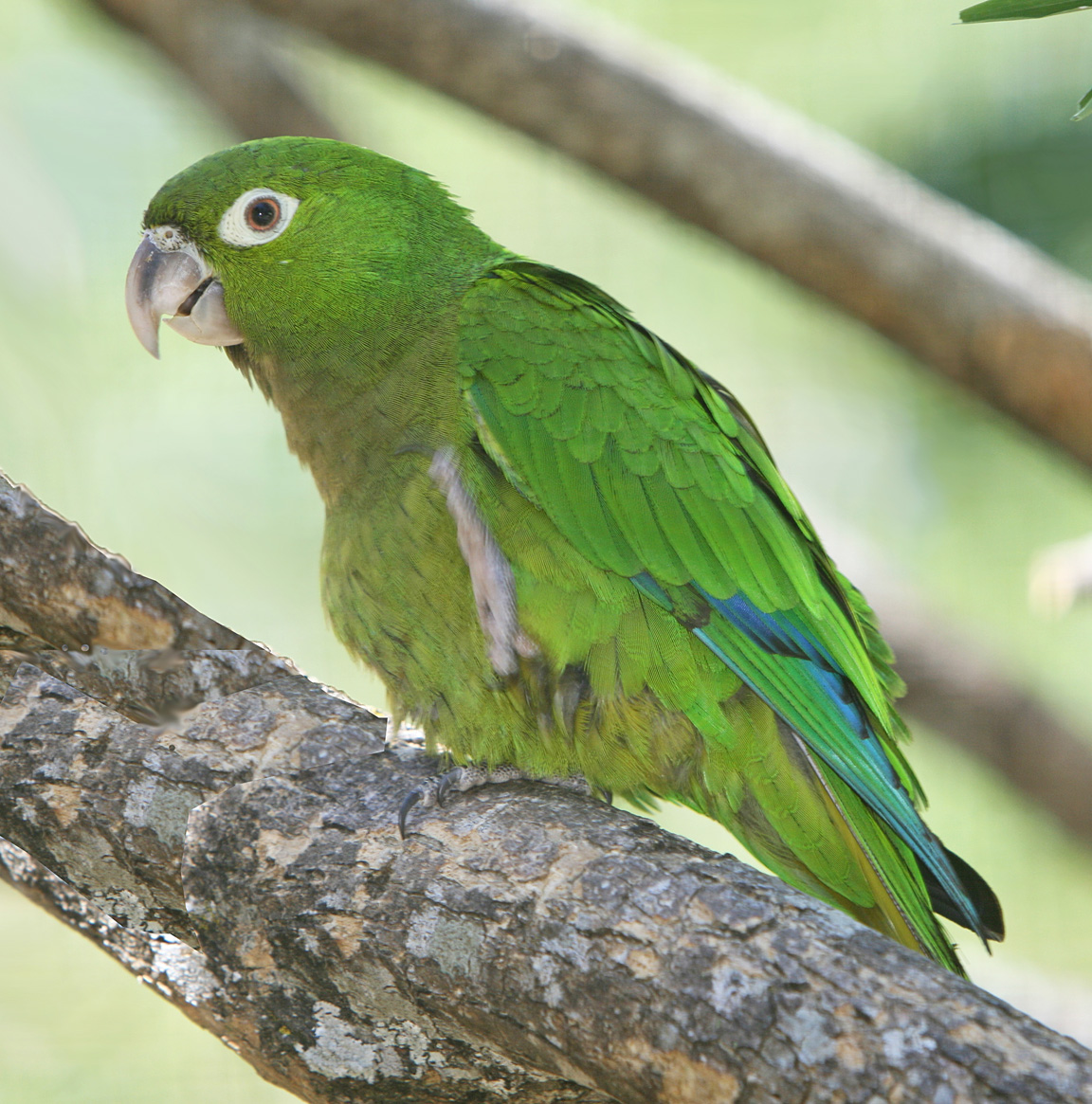
Wikipedia: Olive-throated parakeet
![]() The olive-throated parakeet (Eupsittula nana), also known as the olive-throated conure in aviculture, is a species of parrot in the family Psittacidae. It is found in forest and woodland in Jamaica, Mexico and Central America, and has been introduced to the Dominican Republic.
[more]
The olive-throated parakeet (Eupsittula nana), also known as the olive-throated conure in aviculture, is a species of parrot in the family Psittacidae. It is found in forest and woodland in Jamaica, Mexico and Central America, and has been introduced to the Dominican Republic.
[more]
Gattung Psittacara:
City parrots in San Jose, Costa Rica, tentative iD crimson-fronted parakeet,. 2018-03-16 15.50.26 null
![]() The crimson-fronted parakeet (Psittacara finschi), also known as Finsch's parakeet or Finsch's conure, is a small green Neotropical parrot. It is found in Nicaragua, Costa Rica and western Panama.Its natural habitats are subtropical or tropical moist lowland forest and heavily degraded former forest.[2]
[more]
The crimson-fronted parakeet (Psittacara finschi), also known as Finsch's parakeet or Finsch's conure, is a small green Neotropical parrot. It is found in Nicaragua, Costa Rica and western Panama.Its natural habitats are subtropical or tropical moist lowland forest and heavily degraded former forest.[2]
[more]
Gattung Pyrilia:

Wikipedia: Brown-hooded parrot
![]() The brown-hooded parrot (Pyrilia haematotis) is a small parrot which is a resident breeding species from southeastern Mexico to north-western Colombia. Until recently, it was placed in the genus Pionopsitta, which now is restricted to the type species, the pileated parrot. It is sometimes considered conspecific with the rose-faced parrot (P. pulchra). This species has been adversely affected by deforestation.
[more]
The brown-hooded parrot (Pyrilia haematotis) is a small parrot which is a resident breeding species from southeastern Mexico to north-western Colombia. Until recently, it was placed in the genus Pionopsitta, which now is restricted to the type species, the pileated parrot. It is sometimes considered conspecific with the rose-faced parrot (P. pulchra). This species has been adversely affected by deforestation.
[more]
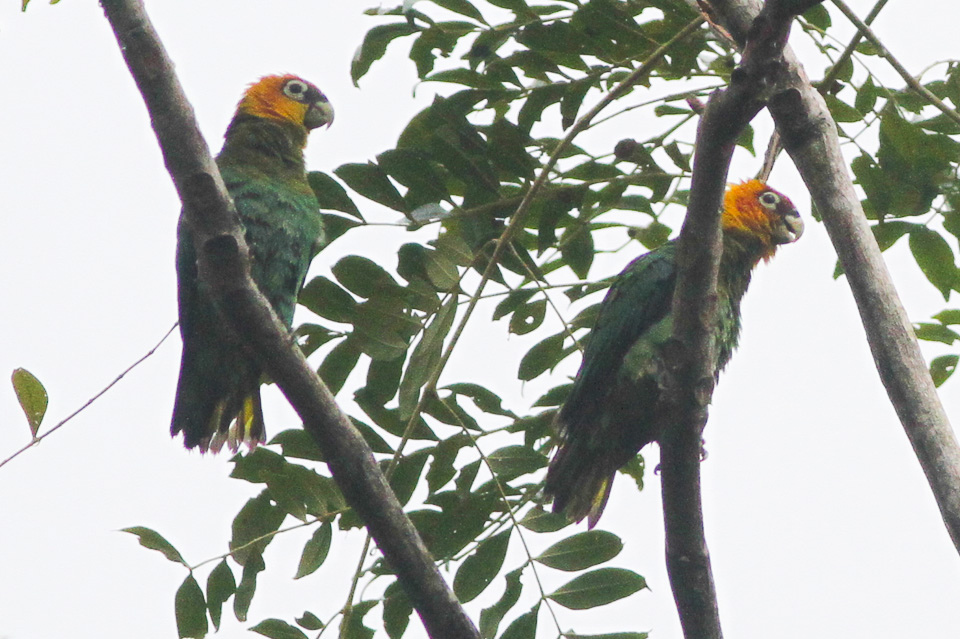
Wikipedia: Saffron-headed parrot
![]() The saffron-headed parrot (Pyrilia pyrilia) is a species of parrot in the family Psittacidae. It was previously placed in the genus Pionopsitta, but moved out, as it is not as close to the type species Pionopsitta pileata as it was believed. It was briefly placed in Gypopsitta, but this is a junior synonym of Pyrilia and thus the saffron-headed parrot is now placed in the latter genus.
[more]
The saffron-headed parrot (Pyrilia pyrilia) is a species of parrot in the family Psittacidae. It was previously placed in the genus Pionopsitta, but moved out, as it is not as close to the type species Pionopsitta pileata as it was believed. It was briefly placed in Gypopsitta, but this is a junior synonym of Pyrilia and thus the saffron-headed parrot is now placed in the latter genus.
[more]
Ordnung Podicipediformes (Lappentaucher / Grebes):
Familie Podicipedidae (Grebes):
Gattung Podilymbus:
Profil Wikipedia Audubon Xeno-Canto
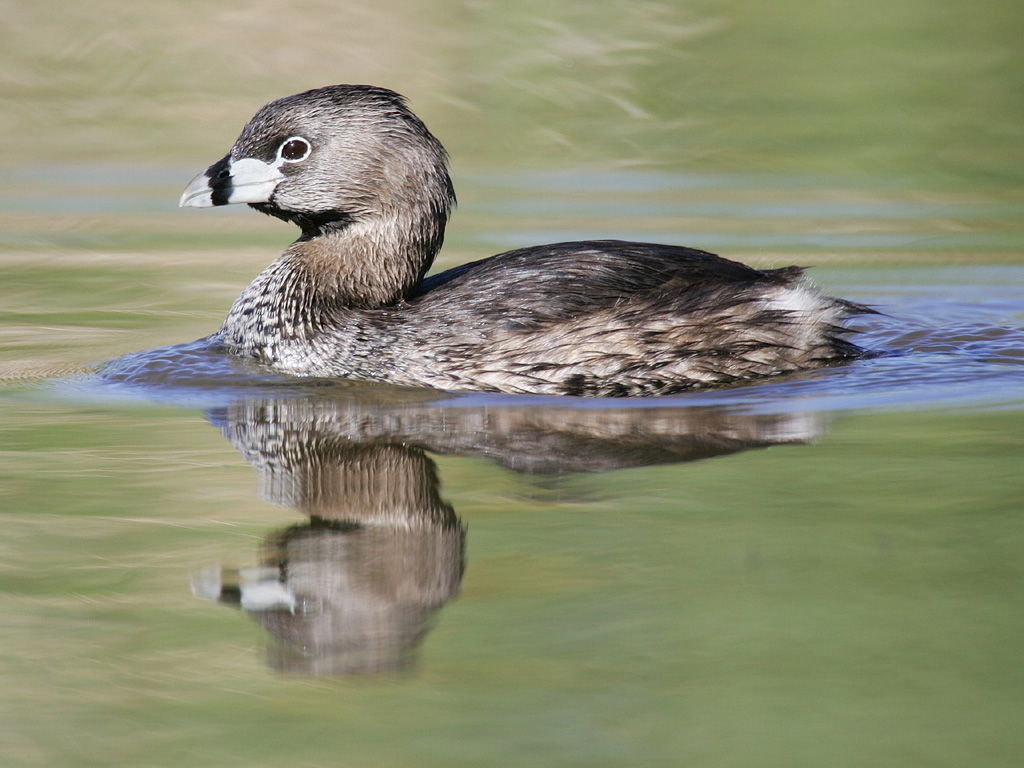
Wikipedia: Pied-billed grebe
Dieser Vogel erscheint jenseits grossen Meere in Kontinenten :
Nordamerika, Südamerika, Afrika.
![]() The pied-billed grebe (Podilymbus podiceps) is a species of the grebe family of water birds. Since the Atitlán grebe (Podilymbus gigas) has become extinct, it is the sole extant member of the genus Podilymbus.[2] The pied-billed grebe is primarily found in ponds throughout the Americas.[3] Other names of this grebe include American dabchick, rail, dabchick, Carolina grebe, devil-diver, dive-dapper, dipper, hell-diver, pied-billed dabchick, pied-bill, thick-billed grebe, and water witch.[4][5]
[more]
The pied-billed grebe (Podilymbus podiceps) is a species of the grebe family of water birds. Since the Atitlán grebe (Podilymbus gigas) has become extinct, it is the sole extant member of the genus Podilymbus.[2] The pied-billed grebe is primarily found in ponds throughout the Americas.[3] Other names of this grebe include American dabchick, rail, dabchick, Carolina grebe, devil-diver, dive-dapper, dipper, hell-diver, pied-billed dabchick, pied-bill, thick-billed grebe, and water witch.[4][5]
[more]
Gattung Tachybaptus:
Profil Wikipedia Audubon Xeno-Canto

Wikipedia: Least grebe
![]() The least grebe (Tachybaptus dominicus), an aquatic bird, is the smallest member of the grebe family. It occurs in the New World from the southwestern United States and Mexico to Argentina, and also on Trinidad and Tobago, the Bahamas and the Greater Antilles.
[more]
The least grebe (Tachybaptus dominicus), an aquatic bird, is the smallest member of the grebe family. It occurs in the New World from the southwestern United States and Mexico to Argentina, and also on Trinidad and Tobago, the Bahamas and the Greater Antilles.
[more]
Ordnung Procellariiformes (Röhrennasen / Petrels and albatrosses):
Familie Procellariidae (Sturmvögel / Shearwaters and petrels):
Gattung Puffinus:
Profil Wikipedia Audubon Xeno-Canto

Wikipedia: Audubon's shearwater
![]() Audubon's shearwater (Puffinus lherminieri) is a common tropical seabird in the petrel family. Sometimes known as the dusky-backed shearwater,[2] the specific epithet honours the French naturalist Félix Louis L'Herminier.
[more]
Audubon's shearwater (Puffinus lherminieri) is a common tropical seabird in the petrel family. Sometimes known as the dusky-backed shearwater,[2] the specific epithet honours the French naturalist Félix Louis L'Herminier.
[more]

Wikipedia: Galapagos shearwater
![]() The Galápagos shearwater (Puffinus subalaris) is a small shearwater. Until recently it was considered to be a subspecies of Audubon's shearwater, but it is actually one of two members of a very ancient lineage of the small Puffinus species, the other being, as indicated by mtDNA cytochrome b sequence data, the Christmas shearwater.[3]
[more]
The Galápagos shearwater (Puffinus subalaris) is a small shearwater. Until recently it was considered to be a subspecies of Audubon's shearwater, but it is actually one of two members of a very ancient lineage of the small Puffinus species, the other being, as indicated by mtDNA cytochrome b sequence data, the Christmas shearwater.[3]
[more]
Gattung Procellaria:
Profil Wikipedia Xeno-Canto
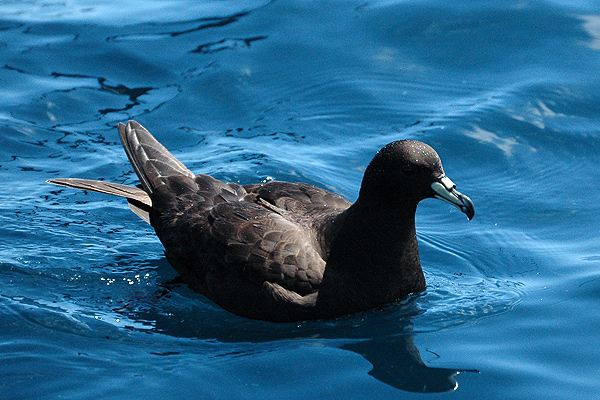
Wikipedia: Parkinson's petrel
![]() The black petrel (Procellaria parkinsoni), also called the Parkinson's petrel, is a medium-sized, black-plumaged petrel, the smallest of the Procellaria. The species is an endemic breeder of New Zealand, breeding only on Great Barrier Island and Little Barrier Island, off the North Island. At sea it disperses as far as Australia and Ecuador.
[more]
The black petrel (Procellaria parkinsoni), also called the Parkinson's petrel, is a medium-sized, black-plumaged petrel, the smallest of the Procellaria. The species is an endemic breeder of New Zealand, breeding only on Great Barrier Island and Little Barrier Island, off the North Island. At sea it disperses as far as Australia and Ecuador.
[more]
Gattung Pseudobulweria:

Wikipedia: Tahiti petrel
Dieser Vogel erscheint jenseits grossen Meere in Kontinenten :
Südamerika, Afrika.
![]() The Tahiti petrel (Pseudobulweria rostrata) is a species of seabird in the family Procellariidae. It is found in American Samoa, Australia, Fiji, French Polynesia, Mexico, New Caledonia, New Zealand, the Solomon Islands, Tonga, Vanuatu, and possibly the Cook Islands. It is a pelagic bird of the open seas, but nests in subtropical or tropical moist lowland forest, subtropical or tropical moist montane forest, subtropical or tropical moist shrubland and subtropical or tropical high-altitude shrubland. It has been recorded as a vagrant in Hawaii, Taiwan, Baja California, and, most surprisingly, in North Carolina.
[more]
The Tahiti petrel (Pseudobulweria rostrata) is a species of seabird in the family Procellariidae. It is found in American Samoa, Australia, Fiji, French Polynesia, Mexico, New Caledonia, New Zealand, the Solomon Islands, Tonga, Vanuatu, and possibly the Cook Islands. It is a pelagic bird of the open seas, but nests in subtropical or tropical moist lowland forest, subtropical or tropical moist montane forest, subtropical or tropical moist shrubland and subtropical or tropical high-altitude shrubland. It has been recorded as a vagrant in Hawaii, Taiwan, Baja California, and, most surprisingly, in North Carolina.
[more]
Gattung Ardenna:

Wikipedia: Sooty shearwater
Dieser Vogel erscheint jenseits grossen Meere in Kontinenten :
Europa, Südamerika, Afrika.
![]() The sooty shearwater (Ardenna grisea) is a medium-large shearwater in the seabird family Procellariidae. Ardenna was first used to refer to a seabird by Italian naturalist Ulisse Aldrovandi in 1603, and grisea is medieval Latin for "grey".[2]
[more]
The sooty shearwater (Ardenna grisea) is a medium-large shearwater in the seabird family Procellariidae. Ardenna was first used to refer to a seabird by Italian naturalist Ulisse Aldrovandi in 1603, and grisea is medieval Latin for "grey".[2]
[more]
Vokalisierung: ![]() Mostly heard at breeding ground. A peculiar, rhythmic, coarse moaning, with a disyllabic attack, followed by a deeper, cooing "in-breath". [Link]
Mostly heard at breeding ground. A peculiar, rhythmic, coarse moaning, with a disyllabic attack, followed by a deeper, cooing "in-breath". [Link]
Körperlich: Länge=40-51 cm,
Flügelspanne=94-109 cm,
Gewicht=666-978 g

Wikipedia: Wedge-tailed shearwater
Dieser Vogel erscheint jenseits grossen Meere in Kontinenten :
Südamerika, Afrika.
Allgemein: ![]() The wedge-tailed shearwater (Ardenna pacifica) is a medium-large shearwater in the seabird family Procellariidae. It is one of the shearwater species that is sometimes referred to as a muttonbird, like the sooty shearwater of New Zealand and the short-tailed shearwater of Australia. It ranges throughout the tropical Pacific and Indian Oceans, roughly between latitudes 35°N and 35°S. It breeds on islands off Japan, on the Islas Revillagigedo, the Hawaiian Islands, the Seychelles, the Northern Mariana Islands, and off Eastern and Western Australia.
[more]
The wedge-tailed shearwater (Ardenna pacifica) is a medium-large shearwater in the seabird family Procellariidae. It is one of the shearwater species that is sometimes referred to as a muttonbird, like the sooty shearwater of New Zealand and the short-tailed shearwater of Australia. It ranges throughout the tropical Pacific and Indian Oceans, roughly between latitudes 35°N and 35°S. It breeds on islands off Japan, on the Islas Revillagigedo, the Hawaiian Islands, the Seychelles, the Northern Mariana Islands, and off Eastern and Western Australia.
[more]

Wikipedia: Pink-footed shearwater
![]() The pink-footed shearwater (Ardenna creatopus) is a species of seabird. The bird is 48 cm in length, with a 109-cm wingspan. It is polymorphic, having both darker- and lighter-phase populations. Together with the equally light-billed flesh-footed shearwater, it forms the Hemipuffinus group, a superspecies that may or may not have an Atlantic relative in the great shearwater.[2][3] These are large shearwaters which are among those that could be separated in the genus Ardenna.[4]
[more]
The pink-footed shearwater (Ardenna creatopus) is a species of seabird. The bird is 48 cm in length, with a 109-cm wingspan. It is polymorphic, having both darker- and lighter-phase populations. Together with the equally light-billed flesh-footed shearwater, it forms the Hemipuffinus group, a superspecies that may or may not have an Atlantic relative in the great shearwater.[2][3] These are large shearwaters which are among those that could be separated in the genus Ardenna.[4]
[more]

Wikipedia: Short-tailed shearwater
![]() The short-tailed shearwater or slender-billed shearwater (Ardenna tenuirostris; formerly Puffinus tenuirostris), also called yolla or moonbird, and commonly known as the muttonbird in Australia, is the most abundant seabird species in Australian waters, and is one of the few Australian native birds in which the chicks are commercially harvested. It is a migratory species that breeds mainly on small islands in Bass Strait and Tasmania and migrates to the Northern Hemisphere for the boreal summer.
[more]
The short-tailed shearwater or slender-billed shearwater (Ardenna tenuirostris; formerly Puffinus tenuirostris), also called yolla or moonbird, and commonly known as the muttonbird in Australia, is the most abundant seabird species in Australian waters, and is one of the few Australian native birds in which the chicks are commercially harvested. It is a migratory species that breeds mainly on small islands in Bass Strait and Tasmania and migrates to the Northern Hemisphere for the boreal summer.
[more]
Profil Wikipedia Audubon Xeno-Canto

Wikipedia: Sooty shearwater
![]() The sooty shearwater (Ardenna grisea) is a medium-large shearwater in the seabird family Procellariidae. Ardenna was first used to refer to a seabird by Italian naturalist Ulisse Aldrovandi in 1603, and grisea is medieval Latin for "grey".[2]
[more]
The sooty shearwater (Ardenna grisea) is a medium-large shearwater in the seabird family Procellariidae. Ardenna was first used to refer to a seabird by Italian naturalist Ulisse Aldrovandi in 1603, and grisea is medieval Latin for "grey".[2]
[more]
Unterfamilie Hydrobatidae (Sturmschwalben):
Gattung Pelagodroma:
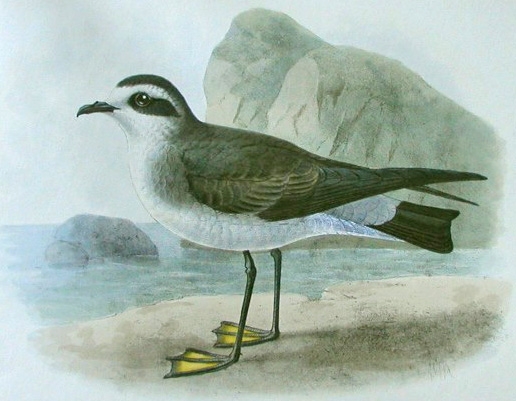
Wikipedia: White-faced storm-petrel
Dieser Vogel erscheint jenseits grossen Meere in Kontinenten :
Europa, Nordamerika, Südamerika, Afrika.
![]() The white-faced storm petrel (Pelagodroma marina), also known as white-faced petrel is a small seabird of the austral storm petrel family Oceanitidae. It is the only member of the monotypic genus Pelagodroma.
[more]
The white-faced storm petrel (Pelagodroma marina), also known as white-faced petrel is a small seabird of the austral storm petrel family Oceanitidae. It is the only member of the monotypic genus Pelagodroma.
[more]
Gattung Oceanodroma:
Wikipedia: Black storm-petrel
![]() The black storm petrel (Oceanodroma melania) is a small seabird of the storm petrel family Hydrobatidae. It is 23 cm in length, with a wingspan of 46–51 cm.
[more]
The black storm petrel (Oceanodroma melania) is a small seabird of the storm petrel family Hydrobatidae. It is 23 cm in length, with a wingspan of 46–51 cm.
[more]

Wikipedia: Markham's storm-petrel
![]() Markham's storm petrel (Oceanodroma markhami) is a species of storm petrel in the family Hydrobatidae. An all black to sooty brown seabird, Markham's storm petrel is difficult to differentiate from the black petrel Procellaria parkinsoni in life, and was once described as conspecific with, or biologically identical to, Tristram's storm petrel Oceanodroma tristrami. Markham's storm petrel inhabits open seas in the Pacific Ocean around Peru, Chile, and Ecuador, but only nests in northern Chile and Peru, with ninety-five percent of all known breeding populations in 2019 found in the Atacama Desert. First described by British ornithologist Osbert Salvin in 1883, the bird was named in honor of Albert Hastings Markham, a naval officer who collected a specimen off Peru.
[more]
Markham's storm petrel (Oceanodroma markhami) is a species of storm petrel in the family Hydrobatidae. An all black to sooty brown seabird, Markham's storm petrel is difficult to differentiate from the black petrel Procellaria parkinsoni in life, and was once described as conspecific with, or biologically identical to, Tristram's storm petrel Oceanodroma tristrami. Markham's storm petrel inhabits open seas in the Pacific Ocean around Peru, Chile, and Ecuador, but only nests in northern Chile and Peru, with ninety-five percent of all known breeding populations in 2019 found in the Atacama Desert. First described by British ornithologist Osbert Salvin in 1883, the bird was named in honor of Albert Hastings Markham, a naval officer who collected a specimen off Peru.
[more]

Wikipedia: Wedge-rumped storm-petrel
![]() The wedge-rumped storm petrel (Oceanodroma tethys) is a storm petrel. It breeds in the Galápagos Islands and on the coast of Peru.[1]
[more]
The wedge-rumped storm petrel (Oceanodroma tethys) is a storm petrel. It breeds in the Galápagos Islands and on the coast of Peru.[1]
[more]
Gattung Hydrobates:
Profil Wikipedia Audubon Xeno-Canto

Wikipedia: Least storm-petrel
![]() The least storm petrel (Oceanodroma microsoma) is a small seabird of the storm petrel family Hydrobatidae. It is 13–15 cm in length, with a wingspan of 32 cm. It is the smallest member of the order Procellariiformes.
[more]
The least storm petrel (Oceanodroma microsoma) is a small seabird of the storm petrel family Hydrobatidae. It is 13–15 cm in length, with a wingspan of 32 cm. It is the smallest member of the order Procellariiformes.
[more]
Profil Wikipedia Audubon Xeno-Canto

Wikipedia: Leach's storm-petrel
![]() Leach's storm petrel or Leach's petrel (Oceanodroma leucorhoa) is a small seabird of the tubenose order. It is named after the British zoologist William Elford Leach. The scientific name is derived from Ancient Greek. Oceanodroma is from okeanos, "ocean" and dromos, "runner", and leucorhoa is from leukos, "white" and orrhos, "rump".[2]
[more]
Leach's storm petrel or Leach's petrel (Oceanodroma leucorhoa) is a small seabird of the tubenose order. It is named after the British zoologist William Elford Leach. The scientific name is derived from Ancient Greek. Oceanodroma is from okeanos, "ocean" and dromos, "runner", and leucorhoa is from leukos, "white" and orrhos, "rump".[2]
[more]
Gattung Oceanites:

Wikipedia: Wilson's storm-petrel
Dieser Vogel erscheint jenseits grossen Meere in Kontinenten :
Europa, Nordamerika, Südamerika, Afrika.
![]() Wilson's storm petrel (Oceanites oceanicus), also known as Wilson's petrel, is a small seabird of the austral storm petrel family Oceanitidae. It is one of the most abundant bird species in the world and has a circumpolar distribution mainly in the seas of the southern hemisphere but extending northwards during the summer of the northern hemisphere. The world population has been estimated to be more than 50 million pairs.[2] The name commemorates the Scottish-American ornithologist Alexander Wilson. The genus name Oceanites refers to the mythical Oceanids, the three thousand daughters of Tethys. The species name is from Latin oceanus, "ocean".[3]
[more]
Wilson's storm petrel (Oceanites oceanicus), also known as Wilson's petrel, is a small seabird of the austral storm petrel family Oceanitidae. It is one of the most abundant bird species in the world and has a circumpolar distribution mainly in the seas of the southern hemisphere but extending northwards during the summer of the northern hemisphere. The world population has been estimated to be more than 50 million pairs.[2] The name commemorates the Scottish-American ornithologist Alexander Wilson. The genus name Oceanites refers to the mythical Oceanids, the three thousand daughters of Tethys. The species name is from Latin oceanus, "ocean".[3]
[more]
Ordnung Strigiformes (Eulen / Owls):
Familie Strigidae:
Gattung Bubo (Eagle owls):

Wikipedia: Great horned owl
![]() About 12, see text
[more]
About 12, see text
[more]
Gattung Aegolius (Saw-whet owls):
Profil Wikipedia Xeno-Canto
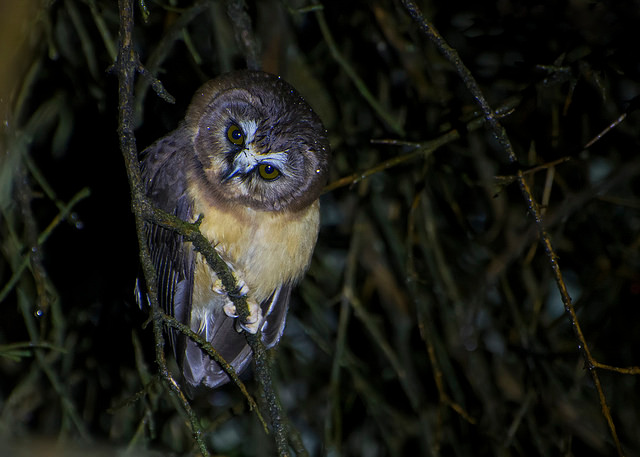
Wikipedia: Unspotted saw-whet owl
![]() The unspotted saw-whet owl (Aegolius ridgwayi) is a small owl. It is a resident breeder in the highlands of Central America from southern Mexico south to western Panama, mainly at altitudes above 2500 m. It has occasionally been considered conspecific with the northern saw-whet owl. There are currently no recognized subspecies.[2]
[more]
The unspotted saw-whet owl (Aegolius ridgwayi) is a small owl. It is a resident breeder in the highlands of Central America from southern Mexico south to western Panama, mainly at altitudes above 2500 m. It has occasionally been considered conspecific with the northern saw-whet owl. There are currently no recognized subspecies.[2]
[more]
Gattung Glaucidium:
Profil Wikipedia Audubon Xeno-Canto
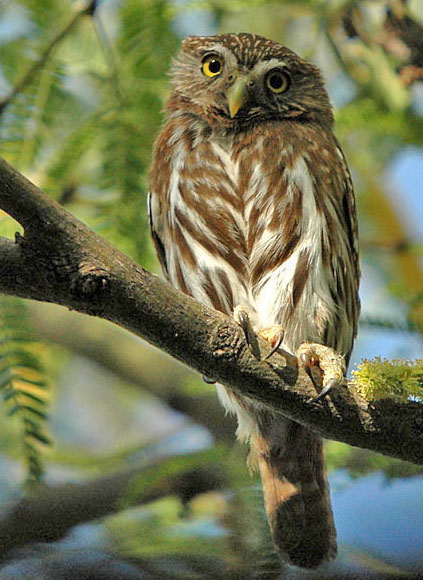
Wikipedia: Ferruginous pygmy-owl
![]() The ferruginous pygmy owl (Glaucidium brasilianum) is a small owl that breeds in south-central Arizona and southern Texas in the United States, south through Mexico and Central America, to South America into Bolivia, Paraguay and Argentina.
[more]
The ferruginous pygmy owl (Glaucidium brasilianum) is a small owl that breeds in south-central Arizona and southern Texas in the United States, south through Mexico and Central America, to South America into Bolivia, Paraguay and Argentina.
[more]
Profil Wikipedia Xeno-Canto

Wikipedia: Central American pygmy-owl
![]() The Central American pygmy owl (Glaucidium griseiceps) is a species of owl in the family Strigidae.
[more]
The Central American pygmy owl (Glaucidium griseiceps) is a species of owl in the family Strigidae.
[more]
Profil Wikipedia Xeno-Canto

Wikipedia: Costa Rican pygmy-owl
![]() The Costa Rican pygmy owl (Glaucidium costaricanum) is a species of owl in the family Strigidae found in the Talamancan montane forests of Costa Rica and western Panama.
[more]
The Costa Rican pygmy owl (Glaucidium costaricanum) is a species of owl in the family Strigidae found in the Talamancan montane forests of Costa Rica and western Panama.
[more]
Gattung Lophostrix:
Profil Wikipedia Xeno-Canto

Wikipedia: Crested owl
![]() The crested owl (Lophostrix cristata) is a species of owl in the family Strigidae. It is the only species (monotypic) in the genus Lophostrix. It is a resident bird and occurs in Central America and northern South America. It is a medium-sized owl, easily recognizable with its very long whitish ear tufts and otherwise darker appearance. It inhabits lowland rainforests and prefers old growth in proximity with water. The crested owl is a strictly nocturnal species, but very little is known about its behaviour.
[more]
The crested owl (Lophostrix cristata) is a species of owl in the family Strigidae. It is the only species (monotypic) in the genus Lophostrix. It is a resident bird and occurs in Central America and northern South America. It is a medium-sized owl, easily recognizable with its very long whitish ear tufts and otherwise darker appearance. It inhabits lowland rainforests and prefers old growth in proximity with water. The crested owl is a strictly nocturnal species, but very little is known about its behaviour.
[more]
Gattung Pulsatrix:
Profil Wikipedia Xeno-Canto

Wikipedia: Spectacled owl
![]() The spectacled owl (Pulsatrix perspicillata) is a large tropical owl native to the neotropics. It is a resident breeder in forests from southern Mexico and Trinidad, through Central America, south to southern Brazil, Paraguay and northwestern Argentina.[1] There are six subspecies.[2] One is occasionally treated as a separate species called the short-browed or brown spectacled owl[3] but the consensus is that it is still merely a race until more detailed analysis can be done.[4]
[more]
The spectacled owl (Pulsatrix perspicillata) is a large tropical owl native to the neotropics. It is a resident breeder in forests from southern Mexico and Trinidad, through Central America, south to southern Brazil, Paraguay and northwestern Argentina.[1] There are six subspecies.[2] One is occasionally treated as a separate species called the short-browed or brown spectacled owl[3] but the consensus is that it is still merely a race until more detailed analysis can be done.[4]
[more]
Gattung Ciccaba:
Profil Wikipedia Xeno-Canto

Wikipedia: Mottled owl
![]() The mottled owl (Strix virgata) is a medium-sized owl found in Central and South America from Mexico to Brazil and Argentina. The head and back are mottled brown and the underparts whitish, with vertical bars on the chest and throat. The eyes are dark and the head is round and they do not have ear tufts. They are territorial and found in dry forests and jungles at altitudes of up to 2,500 m (8,200 ft) above sea level.
[more]
The mottled owl (Strix virgata) is a medium-sized owl found in Central and South America from Mexico to Brazil and Argentina. The head and back are mottled brown and the underparts whitish, with vertical bars on the chest and throat. The eyes are dark and the head is round and they do not have ear tufts. They are territorial and found in dry forests and jungles at altitudes of up to 2,500 m (8,200 ft) above sea level.
[more]
Profil Wikipedia Xeno-Canto
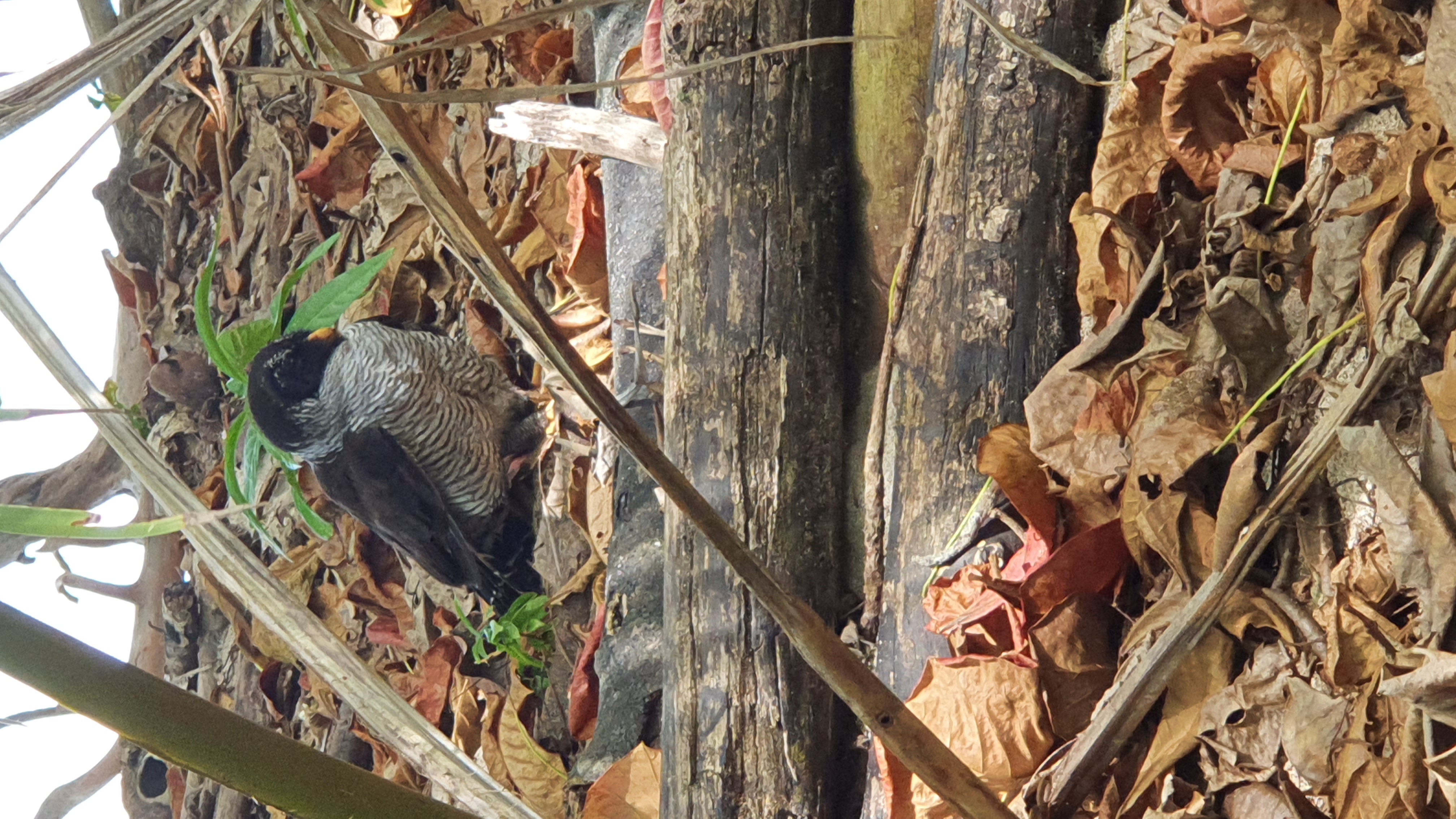
Black-and-white owl near Punta Cahuita in Cahuita National Park, Costa Rica. 2020-03-18 10.22.31 null
![]() The black-and-white owl (Strix nigrolineata) is a species of owl in the family Strigidae.[1][2]
[more]
The black-and-white owl (Strix nigrolineata) is a species of owl in the family Strigidae.[1][2]
[more]
Gattung Megascops:

Wikipedia: Tropical screech owl
![]() The tropical screech owl (Megascops choliba) is a small species of owl in the family Strigidae.
[more]
The tropical screech owl (Megascops choliba) is a small species of owl in the family Strigidae.
[more]

Wikipedia: Middle-American screech-owl
![]() The Middle American screech owl (Megascops guatemalae), also known as the Guatemalan screech owl, is a species of owl in the family Strigidae and is usually found in forests and dense second growth. The taxonomy of this species and the vermiculated screech owl can be confusing. When split, the name vermiculated screech owl (M. vermiculatus) is used for the population from eastern Nicaragua to Panama, and this species is found from northern Mexico to Nicaragua. When conspecific, the English name vermiculated screech owl is used, but M. guatemalae is used for the scientific name since it is older.[2] The "guatemalae" larger conspecific group usually includes the foothill screech owl, M. roraimae and the Choco screech owl, M. centralis.
[more]
The Middle American screech owl (Megascops guatemalae), also known as the Guatemalan screech owl, is a species of owl in the family Strigidae and is usually found in forests and dense second growth. The taxonomy of this species and the vermiculated screech owl can be confusing. When split, the name vermiculated screech owl (M. vermiculatus) is used for the population from eastern Nicaragua to Panama, and this species is found from northern Mexico to Nicaragua. When conspecific, the English name vermiculated screech owl is used, but M. guatemalae is used for the scientific name since it is older.[2] The "guatemalae" larger conspecific group usually includes the foothill screech owl, M. roraimae and the Choco screech owl, M. centralis.
[more]

Wikipedia: Pacific screech-owl
![]() The Pacific screech owl (Megascops cooperi) is a species of owl in the family Strigidae. It is found in Costa Rica, El Salvador, Guatemala, Honduras, Mexico, and Nicaragua. Its natural habitats are subtropical or tropical dry forest, subtropical or tropical moist lowland forest, subtropical or tropical mangrove forest, and heavily degraded former forest.[1]
[more]
The Pacific screech owl (Megascops cooperi) is a species of owl in the family Strigidae. It is found in Costa Rica, El Salvador, Guatemala, Honduras, Mexico, and Nicaragua. Its natural habitats are subtropical or tropical dry forest, subtropical or tropical moist lowland forest, subtropical or tropical mangrove forest, and heavily degraded former forest.[1]
[more]
Profil Wikipedia Xeno-Canto

Wikipedia: Bare-shanked screech-owl
![]() The bare-shanked screech owl (Megascops clarkii) is a species of owl in the family Strigidae. It is a large owl that feeds at night in forests and lives in a family size group, even during breeding season. The owl's range is only in Costa Rica, Panama, and far northwestern Colombia. The owl preys on large insects, shrews, and small rodents.
[more]
The bare-shanked screech owl (Megascops clarkii) is a species of owl in the family Strigidae. It is a large owl that feeds at night in forests and lives in a family size group, even during breeding season. The owl's range is only in Costa Rica, Panama, and far northwestern Colombia. The owl preys on large insects, shrews, and small rodents.
[more]
Gattung Pseudoscops:

Wikipedia: Striped owl
![]() The striped owl (Asio clamator) is a medium-sized owl with large ear tufts and a brownish-white facial disk rimmed with black. Its beak is black, and it has cinnamon-colored eyes. It has shorter, rounder wings than most of its close relatives. The upperparts are cinnamon with fine black vermiculation and heavy stripes. The underparts are pale tawny with dusky streaks. It is native to South America and parts of Central America.
[more]
The striped owl (Asio clamator) is a medium-sized owl with large ear tufts and a brownish-white facial disk rimmed with black. Its beak is black, and it has cinnamon-colored eyes. It has shorter, rounder wings than most of its close relatives. The upperparts are cinnamon with fine black vermiculation and heavy stripes. The underparts are pale tawny with dusky streaks. It is native to South America and parts of Central America.
[more]
Familie Tytonidae (Barn owls):
Gattung Tyto:

Wikipedia: Barn owl
Dieser Vogel erscheint jenseits grossen Meere in Kontinenten :
Europa, Nordamerika, Südamerika, Afrika.
![]() The barn owl (Tyto alba) is the most widely distributed species of owl in the world and one of the most widespread of all species of birds, being found almost everywhere in the world except for the polar and desert regions, Asia north of the Himalayas, most of Indonesia, and some Pacific Islands. It is also known as the common barn owl, to distinguish it from the other species in its family, Tytonidae, which forms one of the two main lineages of living owls, the other being the typical owls (Strigidae).
[more]
The barn owl (Tyto alba) is the most widely distributed species of owl in the world and one of the most widespread of all species of birds, being found almost everywhere in the world except for the polar and desert regions, Asia north of the Himalayas, most of Indonesia, and some Pacific Islands. It is also known as the common barn owl, to distinguish it from the other species in its family, Tytonidae, which forms one of the two main lineages of living owls, the other being the typical owls (Strigidae).
[more]
Vokalisierung: ![]() Large repertoire of mainly hissing and screeching sounds. [Link]
Large repertoire of mainly hissing and screeching sounds. [Link]
Gesang: ![]() Song consists of a single, drawn screech, lasting about a second and is often performed in flight. Starting in a very hoarse tone, then progressing with a rising pitch into a more burbling sound, before suddenly ending. [Link]
Song consists of a single, drawn screech, lasting about a second and is often performed in flight. Starting in a very hoarse tone, then progressing with a rising pitch into a more burbling sound, before suddenly ending. [Link]
Körperlich: Länge=33-35 cm,
Flügelspanne=80-95 cm,
Gewicht=240-350 g
Ordnung Trogoniformes (Trogons and quetzals):
Familie Trogonidae:
Gattung Trogon:
Profil Wikipedia Audubon Xeno-Canto

Wikipedia: Elegant trogon
Allgemein: ![]() The elegant trogon (Trogon elegans) (formerly the "coppery-tailed" trogon) is a near passerine bird in the trogon family.[2] Along with the eared quetzal, it is the most poleward-occurring species of trogon in the world, ranging from Guatemala in the south as far north as the upper Gila River in Arizona and New Mexico. The most northerly populations of subspecies ambiguus are partially migratory,[3] and the species is occasionally found as a vagrant in southeasternmost and western Texas.
[more]
The elegant trogon (Trogon elegans) (formerly the "coppery-tailed" trogon) is a near passerine bird in the trogon family.[2] Along with the eared quetzal, it is the most poleward-occurring species of trogon in the world, ranging from Guatemala in the south as far north as the upper Gila River in Arizona and New Mexico. The most northerly populations of subspecies ambiguus are partially migratory,[3] and the species is occasionally found as a vagrant in southeasternmost and western Texas.
[more]
Profil Wikipedia Xeno-Canto
Uvita bairds trogon. 2018-03-05 13.36.20 null
![]() Baird's trogon (Trogon bairdii) is a species of bird belonging to the family Trogonidae. This bird was named after Spencer Fullerton Baird, a 19th-century naturalist.
[more]
Baird's trogon (Trogon bairdii) is a species of bird belonging to the family Trogonidae. This bird was named after Spencer Fullerton Baird, a 19th-century naturalist.
[more]
Profil Wikipedia Xeno-Canto
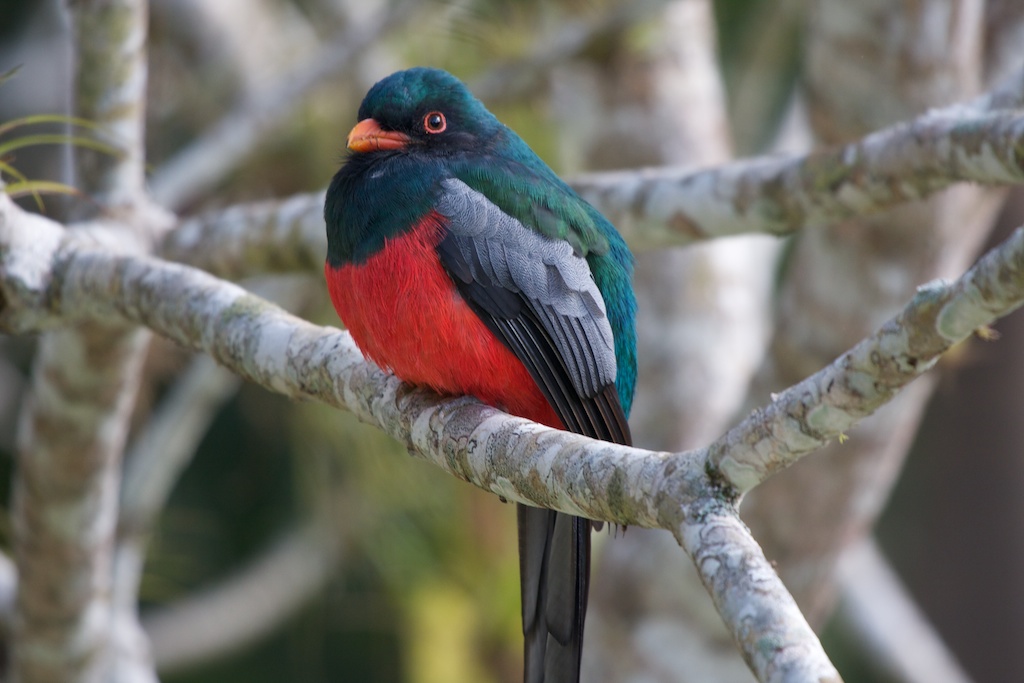
Wikipedia: Slaty-tailed trogon
![]() The slaty-tailed trogon (Trogon massena) is a near passerine bird in the trogon family, Trogonidae. It breeds in lowlands from southeastern Mexico south through Central America, to Colombia, and a small region of northwestern Ecuador.
[more]
The slaty-tailed trogon (Trogon massena) is a near passerine bird in the trogon family, Trogonidae. It breeds in lowlands from southeastern Mexico south through Central America, to Colombia, and a small region of northwestern Ecuador.
[more]
Profil Wikipedia Xeno-Canto

Wikipedia: Collared trogon
![]() The collared trogon (Trogon collaris) is a near passerine bird in the trogon family, Trogonidae.
[more]
The collared trogon (Trogon collaris) is a near passerine bird in the trogon family, Trogonidae.
[more]
Profil Wikipedia Xeno-Canto
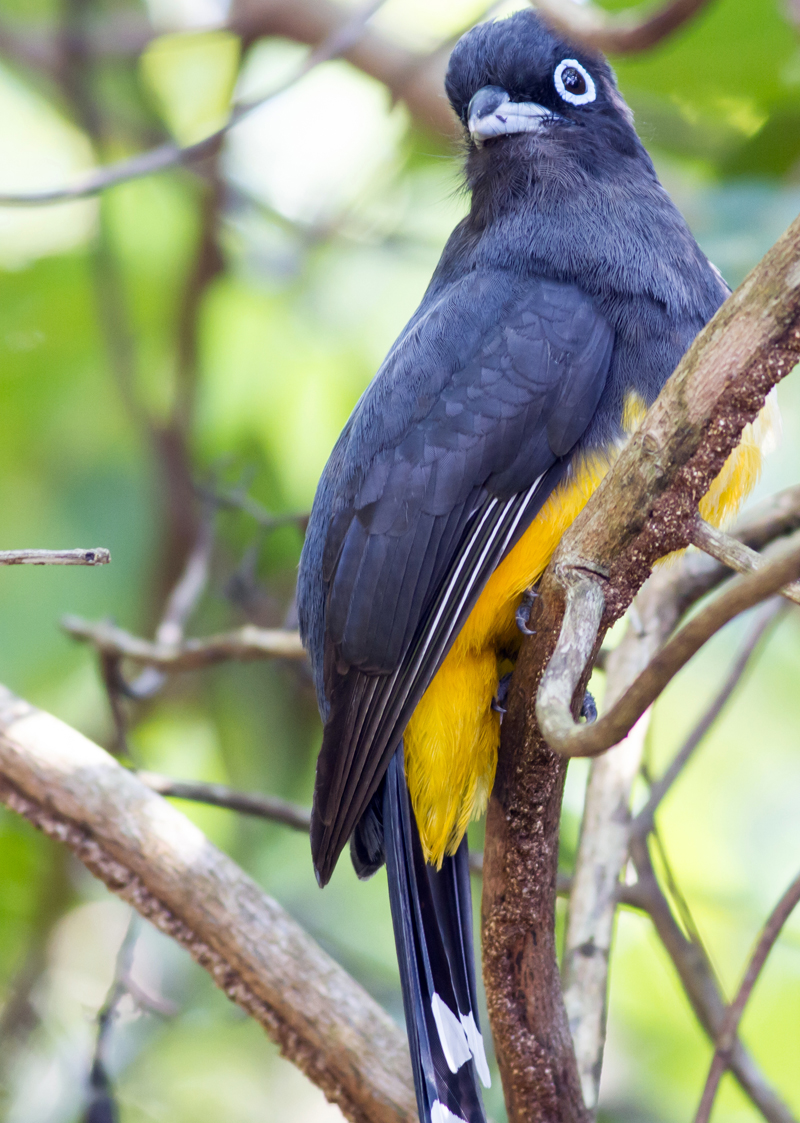
Wikipedia: Black-headed trogon
![]() The black-headed trogon (Trogon melanocephalus) is a species of bird in the family Trogonidae. It is found in Belize, Costa Rica, El Salvador, Guatemala, Honduras, Mexico, and Nicaragua. Its natural habitats are subtropical or tropical dry forest, subtropical or tropical moist lowland forest, and heavily degraded former forest.
[more]
The black-headed trogon (Trogon melanocephalus) is a species of bird in the family Trogonidae. It is found in Belize, Costa Rica, El Salvador, Guatemala, Honduras, Mexico, and Nicaragua. Its natural habitats are subtropical or tropical dry forest, subtropical or tropical moist lowland forest, and heavily degraded former forest.
[more]
Profil Wikipedia Xeno-Canto

Wikipedia: Lattice-tailed trogon
![]() The lattice-tailed trogon (Trogon clathratus) is a species of bird in the family Trogonidae. It is found in Costa Rica and Panama.
[more]
The lattice-tailed trogon (Trogon clathratus) is a species of bird in the family Trogonidae. It is found in Costa Rica and Panama.
[more]
Profil Wikipedia Xeno-Canto
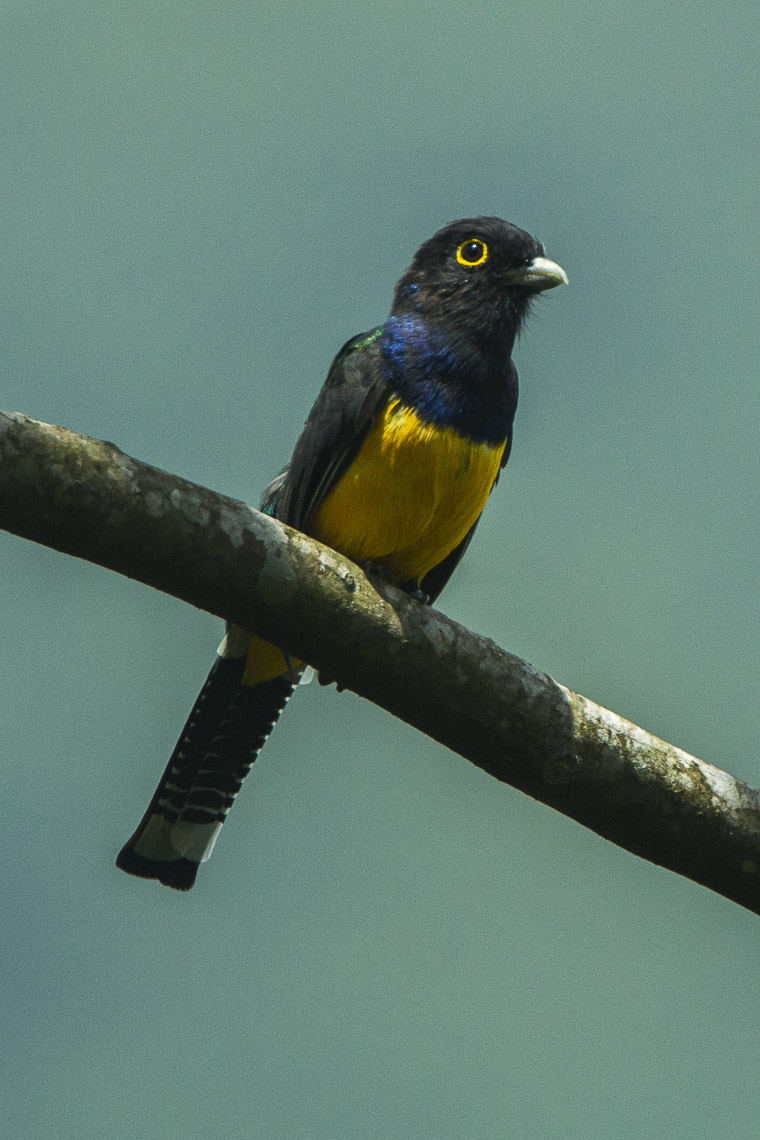
Wikipedia: Gartered trogon
![]() The gartered trogon (Trogon caligatus), also known as the northern violaceous trogon, is a near passerine bird in the trogon family, Trogonidae. It is found in forests in east-central Mexico, south through Central America, to north-western South America (west or north of the Andes in Colombia, Ecuador and Venezuela).[2] It was formerly treated as a subspecies of the violaceous trogon.[1][3]
[more]
The gartered trogon (Trogon caligatus), also known as the northern violaceous trogon, is a near passerine bird in the trogon family, Trogonidae. It is found in forests in east-central Mexico, south through Central America, to north-western South America (west or north of the Andes in Colombia, Ecuador and Venezuela).[2] It was formerly treated as a subspecies of the violaceous trogon.[1][3]
[more]
Profil Wikipedia Xeno-Canto

Wikipedia: Black-throated trogon
![]() The black-throated trogon, also known as yellow-bellied trogon, (Trogon rufus) is a near passerine bird in the trogon family, Trogonidae. Although it is also called "yellow-bellied trogon" it is not the only trogon with a yellow belly. It breeds in lowlands from Honduras south to western Ecuador and northern Argentina.
[more]
The black-throated trogon, also known as yellow-bellied trogon, (Trogon rufus) is a near passerine bird in the trogon family, Trogonidae. Although it is also called "yellow-bellied trogon" it is not the only trogon with a yellow belly. It breeds in lowlands from Honduras south to western Ecuador and northern Argentina.
[more]

Wikipedia: White-tailed trogon
![]() The white-tailed trogon (Trogon chionurus) is a near passerine bird in the trogon family. It is found in tropical humid forests of the Chocó, ranging from Panama, through western Colombia, to western Ecuador. It was formerly considered a subspecies of T. viridis, which is widespread in South America east of the Andes, but under the English name white-tailed trogon (a name now reserved for T. chionurus, leaving T. viridis as the green-backed trogon).[3]
[more]
The white-tailed trogon (Trogon chionurus) is a near passerine bird in the trogon family. It is found in tropical humid forests of the Chocó, ranging from Panama, through western Colombia, to western Ecuador. It was formerly considered a subspecies of T. viridis, which is widespread in South America east of the Andes, but under the English name white-tailed trogon (a name now reserved for T. chionurus, leaving T. viridis as the green-backed trogon).[3]
[more]
Profil Wikipedia Xeno-Canto

Wikipedia: Black-tailed trogon
![]() The black-tailed trogon (Trogon melanurus) is a species of bird in the family Trogonidae. It is found in humid forest in the Amazon basin, north-western South America and adjacent Panama. The taxon mesurus from western Ecuador and far north-western Peru was formerly considered a subspecies of the black-tailed trogon, but is now considered a separate species, the Ecuadorian trogon.
[more]
The black-tailed trogon (Trogon melanurus) is a species of bird in the family Trogonidae. It is found in humid forest in the Amazon basin, north-western South America and adjacent Panama. The taxon mesurus from western Ecuador and far north-western Peru was formerly considered a subspecies of the black-tailed trogon, but is now considered a separate species, the Ecuadorian trogon.
[more]
Gattung Pharomachrus:
Profil Wikipedia Xeno-Canto
Resplendent quetzal. 2020-03-04 10.43.26 null
Systematik: ![]() ..ist ein grün- und scharlachrot gefärbter Vogel aus der Familie der Trogone. [Link]
..ist ein grün- und scharlachrot gefärbter Vogel aus der Familie der Trogone. [Link]
We saw a nesting quetzal pair on the Pipeline Trail near Boquete, Panama, and it was a wonderful experience!
Aussehen und Identifizierung: ![]() Der Quetzal ist 35–38 cm lang und etwa 210 g schwer, die Männchen mit Schwanzfedern können eine Länge von bis zu 1 m erreichen.[3] Die Bauchseite des Weibchens ist einfarbig grün. Bei den Männchen der beiden Unterarten P. m. mocinno und P. m. costaricensis bilden sich während der Fortpflanzungszeit stark verlängerte Oberschwanzdecken, die den Schwanz verdecken und nach der Brutzeit wieder ausfallen. Die Federn können bis zu 80 cm lang werden. Vor allem während der Brutzeit führen die Quetzalmännchen spektakuläre, wenige Sekunden dauernde Balzflüge aus. Aus den Bäumen im Kammbereich der Berge steigen sie rufend in welligem Flug nach oben, um dann im Sturzflug wieder in den Kronen zu verschwinden. Bei der Brut und Versorgung der meistens zwei Jungen wechseln sich die Geschlechter ab. Nach der Brutzeit wandern die Quetzale in tiefer gelegene Bereiche der Gebirge ab. ...Der Quetzal lebt ausschließlich in den Wolken- und Nebelwäldern Mittelamerikas [Link]
Der Quetzal ist 35–38 cm lang und etwa 210 g schwer, die Männchen mit Schwanzfedern können eine Länge von bis zu 1 m erreichen.[3] Die Bauchseite des Weibchens ist einfarbig grün. Bei den Männchen der beiden Unterarten P. m. mocinno und P. m. costaricensis bilden sich während der Fortpflanzungszeit stark verlängerte Oberschwanzdecken, die den Schwanz verdecken und nach der Brutzeit wieder ausfallen. Die Federn können bis zu 80 cm lang werden. Vor allem während der Brutzeit führen die Quetzalmännchen spektakuläre, wenige Sekunden dauernde Balzflüge aus. Aus den Bäumen im Kammbereich der Berge steigen sie rufend in welligem Flug nach oben, um dann im Sturzflug wieder in den Kronen zu verschwinden. Bei der Brut und Versorgung der meistens zwei Jungen wechseln sich die Geschlechter ab. Nach der Brutzeit wandern die Quetzale in tiefer gelegene Bereiche der Gebirge ab. ...Der Quetzal lebt ausschließlich in den Wolken- und Nebelwäldern Mittelamerikas [Link]
Profil Wikipedia Xeno-Canto
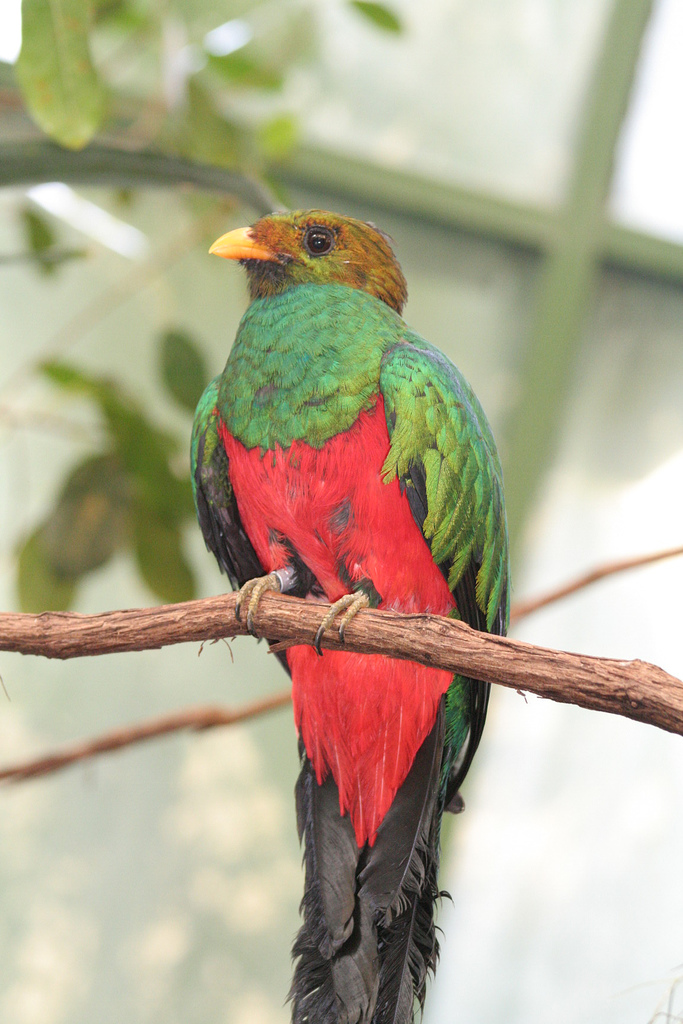
Wikipedia: Golden-headed quetzal
Allgemein: ![]() The golden-headed quetzal or corequenque (Pharomachrus auriceps) is a strikingly coloured bird in the genus Pharomachrus; it is also referred to as Trogon auriceps. It is found in moist mid-elevation forests from eastern Panama to northern Bolivia.
[more]
The golden-headed quetzal or corequenque (Pharomachrus auriceps) is a strikingly coloured bird in the genus Pharomachrus; it is also referred to as Trogon auriceps. It is found in moist mid-elevation forests from eastern Panama to northern Bolivia.
[more]
Ordnung Galbuliformes (Jacamars):
Familie Galbulidae:
Gattung Galbula:
Profil Wikipedia Xeno-Canto

Wikipedia: Rufous-tailed jacamar
![]() The rufous-tailed jacamar (Galbula ruficauda) is a near-passerine bird which breeds in the tropical New World in southern Mexico, Central America and South America as far south as southern Brazil and Ecuador.
[more]
The rufous-tailed jacamar (Galbula ruficauda) is a near-passerine bird which breeds in the tropical New World in southern Mexico, Central America and South America as far south as southern Brazil and Ecuador.
[more]
Gattung Jacamerops:
Profil Wikipedia Xeno-Canto

Wikipedia: Great jacamar
![]() The great jacamar (Jacamerops aureus) is a species of bird in the family Galbulidae. It is placed in the monotypic genus Jacamerops.[2] It is found in Bolivia, Brazil, Colombia, Costa Rica, Ecuador, French Guiana, Guyana, Panama, Peru, Suriname, and Venezuela, where its natural habitat is subtropical and tropical moist lowland forests.[1]
[more]
The great jacamar (Jacamerops aureus) is a species of bird in the family Galbulidae. It is placed in the monotypic genus Jacamerops.[2] It is found in Bolivia, Brazil, Colombia, Costa Rica, Ecuador, French Guiana, Guyana, Panama, Peru, Suriname, and Venezuela, where its natural habitat is subtropical and tropical moist lowland forests.[1]
[more]
Gattung Brachygalba:
Profil Wikipedia Xeno-Canto

Wikipedia: Dusky-backed jacamar
![]() The dusky-backed jacamar (Brachygalba salmoni) is a species of bird in the family Galbulidae. It is found in Colombia and Panama.[2]
[more]
The dusky-backed jacamar (Brachygalba salmoni) is a species of bird in the family Galbulidae. It is found in Colombia and Panama.[2]
[more]
Familie Bucconidae:
Gattung Nystalus:
Profil Wikipedia Xeno-Canto
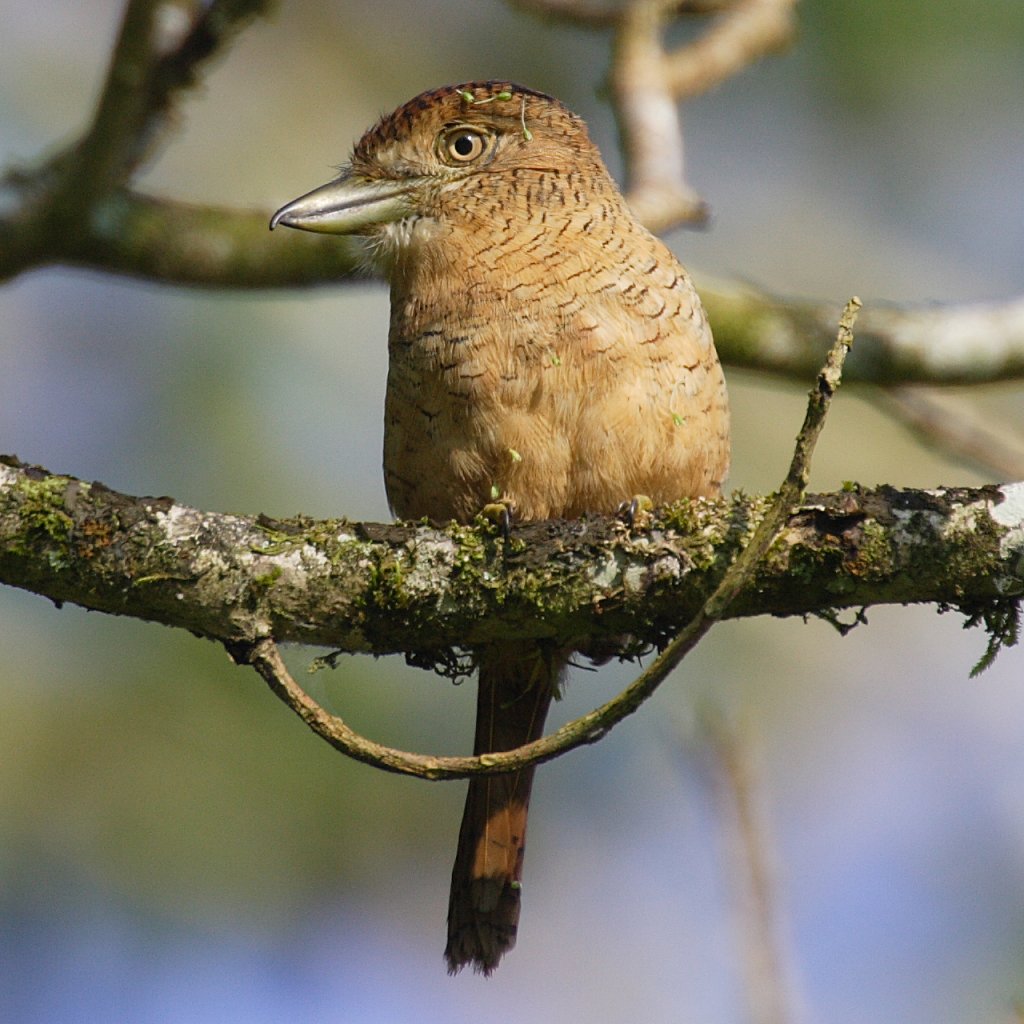
Wikipedia: Barred puffbird
![]() The barred puffbird (Nystalus radiatus) is a species of puffbird in the family Bucconidae. It lives in forests in the Tumbes-Chocó-Magdalena of Panama, Colombia and Ecuador. They can often be found in the middle to upper levels of the forests, in addition it has been spotted on the edges of forest trials, wires in loosely populated land, clearings with scattered trees, and occasionally in lower stories of humid forest borders. In terms of behavior, this bird is easily overlooked because of its propensity to sit still for long periods of time (similar to other puffbirds). Migration of this species has not been observed. Their diet consists of beetles, large caterpillars, local praying mantis, and small lizards. It can be identified by its faint red color, long, narrow and slightly graduated tail, creamy yellow colored iris and small size.[2][3]
[more]
The barred puffbird (Nystalus radiatus) is a species of puffbird in the family Bucconidae. It lives in forests in the Tumbes-Chocó-Magdalena of Panama, Colombia and Ecuador. They can often be found in the middle to upper levels of the forests, in addition it has been spotted on the edges of forest trials, wires in loosely populated land, clearings with scattered trees, and occasionally in lower stories of humid forest borders. In terms of behavior, this bird is easily overlooked because of its propensity to sit still for long periods of time (similar to other puffbirds). Migration of this species has not been observed. Their diet consists of beetles, large caterpillars, local praying mantis, and small lizards. It can be identified by its faint red color, long, narrow and slightly graduated tail, creamy yellow colored iris and small size.[2][3]
[more]
Gattung Nonnula:
Profil Wikipedia Xeno-Canto

Wikipedia: Gray-cheeked nunlet
![]() The grey-cheeked nunlet (Nonnula frontalis) is a species of puffbird in the family Bucconidae.
It is found in Colombia and Panama.
Its natural habitats are subtropical and tropical moist lowland forests and heavily degraded former forest.
[more]
The grey-cheeked nunlet (Nonnula frontalis) is a species of puffbird in the family Bucconidae.
It is found in Colombia and Panama.
Its natural habitats are subtropical and tropical moist lowland forests and heavily degraded former forest.
[more]
Gattung Malacoptila:
Profil Wikipedia Xeno-Canto

Wikipedia: White-whiskered puffbird
![]() The white-whiskered puffbird (Malacoptila panamensis) is a resident breeding bird species from southeastern Mexico to central Ecuador. It is sometimes known as the white-whiskered softwing.
[more]
The white-whiskered puffbird (Malacoptila panamensis) is a resident breeding bird species from southeastern Mexico to central Ecuador. It is sometimes known as the white-whiskered softwing.
[more]
Gattung Notharchus:
Profil Wikipedia Xeno-Canto

Wikipedia: Pied puffbird
![]() The pied puffbird (Notharchus tectus) is a species of puffbird in the family Bucconidae.
[more]
The pied puffbird (Notharchus tectus) is a species of puffbird in the family Bucconidae.
[more]
Profil Wikipedia Xeno-Canto

Wikipedia: White-necked puffbird
![]() The white-necked puffbird (Notharchus hyperrhynchus) is a species of puffbird in the family Bucconidae.
[more]
The white-necked puffbird (Notharchus hyperrhynchus) is a species of puffbird in the family Bucconidae.
[more]
Profil Wikipedia Xeno-Canto

Wikipedia: Black-breasted puffbird
![]() The black-breasted puffbird (Notharchus pectoralis) is a species of puffbird in the family Bucconidae. It is found in Colombia, Ecuador, and Panama.
[more]
The black-breasted puffbird (Notharchus pectoralis) is a species of puffbird in the family Bucconidae. It is found in Colombia, Ecuador, and Panama.
[more]
Gattung Monasa:
Profil Wikipedia Xeno-Canto

Wikipedia: White-fronted nunbird
![]() The white-fronted nunbird (Monasa morphoeus) is a species of near passerine bird in the puffbird family (Bucconidae). It is found in the tropical Americas.
[more]
The white-fronted nunbird (Monasa morphoeus) is a species of near passerine bird in the puffbird family (Bucconidae). It is found in the tropical Americas.
[more]
Überordnung Galloanserae:
Ordnung Galliformes (Hühnervögel / Landfowls):
Familie Cracidae:
Profil Wikipedia Audubon Xeno-Canto

Wikipedia: Plain chachalaca
![]() The plain chachalaca (Ortalis vetula) is a large bird in the chachalaca, guan and curassow family Cracidae. It breeds in tropical and subtropical environments from mezquital thickets in the Rio Grande Valley in southernmost Texas, United States to northernmost Costa Rica. In Central America, this species occurs in the Pacific lowlands from Chiapas, Mexico to northern Nicaragua and as a separate population in Costa Rica, where its range is separated by a short distance, as a disjunct population.
[more]
The plain chachalaca (Ortalis vetula) is a large bird in the chachalaca, guan and curassow family Cracidae. It breeds in tropical and subtropical environments from mezquital thickets in the Rio Grande Valley in southernmost Texas, United States to northernmost Costa Rica. In Central America, this species occurs in the Pacific lowlands from Chiapas, Mexico to northern Nicaragua and as a separate population in Costa Rica, where its range is separated by a short distance, as a disjunct population.
[more]

Wikipedia: Grey-headed chachalaca
![]() The grey-headed chachalaca (Ortalis cinereiceps) is a member of an ancient group of birds of the family Cracidae, which are related to the Australasian mound builders. It breeds in lowlands from eastern Honduras to northwestern Colombia (from South Chocó to the upper Atrato) at up to 1,100 m (3,600 ft) altitude.
[more]
The grey-headed chachalaca (Ortalis cinereiceps) is a member of an ancient group of birds of the family Cracidae, which are related to the Australasian mound builders. It breeds in lowlands from eastern Honduras to northwestern Colombia (from South Chocó to the upper Atrato) at up to 1,100 m (3,600 ft) altitude.
[more]
Profil Wikipedia Xeno-Canto
La fortuna crested guan. 2018-02-26 10.56.06 null
![]() The crested guan (Penelope purpurascens) is a member of an ancient group of birds of the family Cracidae, which are related to the Australasian mound builders. It is found in the Neotropics, in lowlands forests ranging from south Mexico and the Yucatán Peninsula to western Ecuador and southern Venezuela. The sexes are similar in appearance; the plumage is mainly dark brown with white spotting, an area of bare skin round the eye, bright red wattles, a bushy crest, a long broad tail and pink legs. It is a social bird, often seen in pairs or small family groups. It feeds in trees, mainly on fruit, and builds a nest of twigs on a branch. The two or three white eggs are incubated by the female. The International Union for Conservation of Nature has rated this bird's conservation status as "least concern".
[more]
The crested guan (Penelope purpurascens) is a member of an ancient group of birds of the family Cracidae, which are related to the Australasian mound builders. It is found in the Neotropics, in lowlands forests ranging from south Mexico and the Yucatán Peninsula to western Ecuador and southern Venezuela. The sexes are similar in appearance; the plumage is mainly dark brown with white spotting, an area of bare skin round the eye, bright red wattles, a bushy crest, a long broad tail and pink legs. It is a social bird, often seen in pairs or small family groups. It feeds in trees, mainly on fruit, and builds a nest of twigs on a branch. The two or three white eggs are incubated by the female. The International Union for Conservation of Nature has rated this bird's conservation status as "least concern".
[more]
Profil Wikipedia Xeno-Canto
Tikal great curassow. 2018-02-07 12.29.42 null
![]() The great curassow (Crax rubra) (Spanish: hocofaisán, pavón norteño) is a large, pheasant-like bird from the Neotropical rainforests, its range extending from eastern Mexico, through Central America to western Colombia and northwestern Ecuador. Male birds are black with curly crests and yellow beaks; females come in three colour morphs, barred, rufous and black. These birds form small groups, foraging mainly on the ground for fruits and arthropods, and the occasional small vertebrate, but they roost and nest in trees. This species is monogamous, the male usually building the rather small nest of leaves in which two eggs are laid. This species is threatened by loss of habitat and hunting, and the International Union for Conservation of Nature has rated its conservation status as "vulnerable".
[more]
The great curassow (Crax rubra) (Spanish: hocofaisán, pavón norteño) is a large, pheasant-like bird from the Neotropical rainforests, its range extending from eastern Mexico, through Central America to western Colombia and northwestern Ecuador. Male birds are black with curly crests and yellow beaks; females come in three colour morphs, barred, rufous and black. These birds form small groups, foraging mainly on the ground for fruits and arthropods, and the occasional small vertebrate, but they roost and nest in trees. This species is monogamous, the male usually building the rather small nest of leaves in which two eggs are laid. This species is threatened by loss of habitat and hunting, and the International Union for Conservation of Nature has rated its conservation status as "vulnerable".
[more]
Profil Wikipedia Xeno-Canto
Curi cancha black guan. 2018-02-18 13.38.52 null
![]() The black guan (Chamaepetes unicolor) is a species of bird in the family Cracidae. It is found in the Talamancan montane forests of Costa Rica and Panama.
[more]
The black guan (Chamaepetes unicolor) is a species of bird in the family Cracidae. It is found in the Talamancan montane forests of Costa Rica and Panama.
[more]
Familie Phasianidae (Turkeys):

Ocellated turkey sign. 2018-02-07 11.30.46 null
![]() Das Pfauentruthuhn (Meleagris ocellata) ist neben dem eigentlichen Truthuhn die einzige weitere Art der Truthühner (Meleagris). Es ist im Norden Mittelamerikas verbreitet.
[more]
Das Pfauentruthuhn (Meleagris ocellata) ist neben dem eigentlichen Truthuhn die einzige weitere Art der Truthühner (Meleagris). Es ist im Norden Mittelamerikas verbreitet.
[more]
Familie Odontophoridae:
Profil Wikipedia Xeno-Canto

Wikipedia: Crested bobwhite
![]() The crested bobwhite (Colinus cristatus) is a species of bird in the family Odontophoridae. It is found in northern South America, extending through Panama to just reach Costa Rica. It also occurs on Aruba and the Netherlands Antilles. Its natural habitats are subtropical or tropical dry shrubland, subtropical or tropical seasonally wet or flooded lowland grassland, and heavily degraded former forest.
[more]
The crested bobwhite (Colinus cristatus) is a species of bird in the family Odontophoridae. It is found in northern South America, extending through Panama to just reach Costa Rica. It also occurs on Aruba and the Netherlands Antilles. Its natural habitats are subtropical or tropical dry shrubland, subtropical or tropical seasonally wet or flooded lowland grassland, and heavily degraded former forest.
[more]

Wikipedia: Black-breasted wood quail
![]() The black-breasted wood quail (Odontophorus leucolaemus) is a bird species in the family Odontophoridae. It is found in Costa Rica and Panama. Its natural habitat is subtropical or tropical moist montane forest.
[more]
The black-breasted wood quail (Odontophorus leucolaemus) is a bird species in the family Odontophoridae. It is found in Costa Rica and Panama. Its natural habitat is subtropical or tropical moist montane forest.
[more]

Wikipedia: Marbled wood quail
![]() The marbled wood quail (Odontophorus gujanensis), also known as the Amazonian wood quail, is a species of bird in the New World quail family. It is found in Bolivia, Brazil, Colombia, Costa Rica, Ecuador, French Guiana, Guyana, Panama, Peru, Suriname, and Venezuela. Its natural habitat is subtropical or tropical moist lowland forests.
[more]
The marbled wood quail (Odontophorus gujanensis), also known as the Amazonian wood quail, is a species of bird in the New World quail family. It is found in Bolivia, Brazil, Colombia, Costa Rica, Ecuador, French Guiana, Guyana, Panama, Peru, Suriname, and Venezuela. Its natural habitat is subtropical or tropical moist lowland forests.
[more]

Wikipedia: Spotted wood quail
![]() The spotted wood quail (Odontophorus guttatus) is a small ground-dwelling bird in the New World quail family. It is a resident breeder in the mountains of Central America from southern Mexico to western Panama.
[more]
The spotted wood quail (Odontophorus guttatus) is a small ground-dwelling bird in the New World quail family. It is a resident breeder in the mountains of Central America from southern Mexico to western Panama.
[more]

Wikipedia: Black-eared wood quail
![]()
 [more]
[more]
Profil Wikipedia Xeno-Canto

Wikipedia: Buffy-crowned wood-partridge
![]() The buffy-crowned wood partridge (Dendrortyx leucophrys) is a bird species in the family Odontophoridae. It is found in Chiapas, Guatemala, Honduras, El Salvador, Costa Rica and Nicaragua. Its natural habitat is subtropical or tropical moist montane forest. Small groups forage in underbrush, secondary growth, near forest clearings and coffee plantations. The species local name is "chir-ras-qua" after its noisy call. It has a chicken-like appearance due to its long tail and legs. Its pale iris and streaked neck differentiates it from other quail like birds.
[more]
The buffy-crowned wood partridge (Dendrortyx leucophrys) is a bird species in the family Odontophoridae. It is found in Chiapas, Guatemala, Honduras, El Salvador, Costa Rica and Nicaragua. Its natural habitat is subtropical or tropical moist montane forest. Small groups forage in underbrush, secondary growth, near forest clearings and coffee plantations. The species local name is "chir-ras-qua" after its noisy call. It has a chicken-like appearance due to its long tail and legs. Its pale iris and streaked neck differentiates it from other quail like birds.
[more]
Profil Wikipedia Xeno-Canto

Wikipedia: Tawny-faced quail
![]() The tawny-faced quail (Rhynchortyx cinctus) is a species of bird in the family Odontophoridae, and the only species in its genus Rhynchortyx.
[more]
The tawny-faced quail (Rhynchortyx cinctus) is a species of bird in the family Odontophoridae, and the only species in its genus Rhynchortyx.
[more]
Ordnung Apodiformes (Segler / Swifts and hummingbirds):
Familie Apodidae (Swifts):
Unterfamilie Cypseloidinae:
Profil Wikipedia Xeno-Canto

Wikipedia: Spot-fronted swift
![]() The spot-fronted swift (Cypseloides cherriei) is a species of swift in the family Apodidae. It is found in Colombia, Costa Rica, Ecuador and western Venezuela. Its natural habitat is subtropical or tropical moist montane forests. The scientific name commemorates the specimen collector George K. Cherrie.
[more]
The spot-fronted swift (Cypseloides cherriei) is a species of swift in the family Apodidae. It is found in Colombia, Costa Rica, Ecuador and western Venezuela. Its natural habitat is subtropical or tropical moist montane forests. The scientific name commemorates the specimen collector George K. Cherrie.
[more]
Profil Wikipedia Xeno-Canto

Wikipedia: White-chinned swift
![]() The white-chinned swift (Cypseloides cryptus) is a species of swift in the family Apodidae. It is found in Belize, Colombia, Costa Rica, Ecuador, Guyana, Honduras, Mexico, Nicaragua, Panama, Peru, and Venezuela. Its natural habitats are subtropical or tropical moist lowland forests and subtropical or tropical moist montane forests.
[more]
The white-chinned swift (Cypseloides cryptus) is a species of swift in the family Apodidae. It is found in Belize, Colombia, Costa Rica, Ecuador, Guyana, Honduras, Mexico, Nicaragua, Panama, Peru, and Venezuela. Its natural habitats are subtropical or tropical moist lowland forests and subtropical or tropical moist montane forests.
[more]
Profil Wikipedia Xeno-Canto
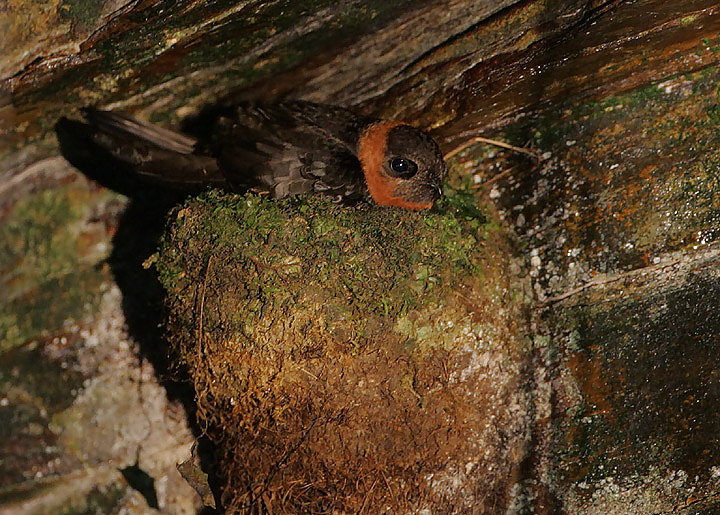
Wikipedia: Chestnut-collared swift
![]() The chestnut-collared swift (Streptoprocne rutila) is a resident breeding bird from Mexico and Trinidad south to Peru and Bolivia. It was one of the species of Cypseloides controversially moved to Streptoprocne by the AOU (BLI 2004).
[more]
The chestnut-collared swift (Streptoprocne rutila) is a resident breeding bird from Mexico and Trinidad south to Peru and Bolivia. It was one of the species of Cypseloides controversially moved to Streptoprocne by the AOU (BLI 2004).
[more]
Profil Wikipedia Xeno-Canto

Wikipedia: White-collared swift
![]() The white-collared swift (Streptoprocne zonaris) is a resident breeding bird from central Mexico, the Greater Antilles and Trinidad south to Peru, northern Argentina and southeastern Brazil.
[more]
The white-collared swift (Streptoprocne zonaris) is a resident breeding bird from central Mexico, the Greater Antilles and Trinidad south to Peru, northern Argentina and southeastern Brazil.
[more]
Unterfamilie Apodinae:
Profil Wikipedia Audubon Xeno-Canto

Wikipedia: Chimney swift
![]() The chimney swift (Chaetura pelagica) is a bird belonging to the swift family Apodidae. A member of the genus Chaetura, it is closely related to both the Vaux's swift and the Chapman's swift; in the past, the three were sometimes considered to be conspecific. It has no subspecies. The chimney swift is a medium-sized, sooty gray bird with very long, slender wings and very short legs. Like all swifts, it is incapable of perching, and can only cling vertically to surfaces.
[more]
The chimney swift (Chaetura pelagica) is a bird belonging to the swift family Apodidae. A member of the genus Chaetura, it is closely related to both the Vaux's swift and the Chapman's swift; in the past, the three were sometimes considered to be conspecific. It has no subspecies. The chimney swift is a medium-sized, sooty gray bird with very long, slender wings and very short legs. Like all swifts, it is incapable of perching, and can only cling vertically to surfaces.
[more]
Profil Wikipedia Audubon Xeno-Canto
Wikipedia: Short-tailed swift
![]() The short-tailed swift (Chaetura brachyura) is a bird in the Apodidae, or swift family.
[more]
The short-tailed swift (Chaetura brachyura) is a bird in the Apodidae, or swift family.
[more]
Profil Wikipedia Audubon Xeno-Canto

Wikipedia: Vaux's swift
![]() Vaux's swift (Chaetura vauxi) is a small swift native to North America and northern South America. It was named for the American scientist William Sansom Vaux.
[more]
Vaux's swift (Chaetura vauxi) is a small swift native to North America and northern South America. It was named for the American scientist William Sansom Vaux.
[more]
Profil Wikipedia Xeno-Canto

Wikipedia: Gray-rumped swift
![]() The grey-rumped swift (Chaetura cinereiventris) is a small swift.
[more]
The grey-rumped swift (Chaetura cinereiventris) is a small swift.
[more]

Wikipedia: Costa Rican swift
![]() The Costa Rican swift (Chaetura fumosa) is a species of swift in the family Apodidae. It was split from the band-rumped swift, Chaetura spinacauda, in 1998.
[more]
The Costa Rican swift (Chaetura fumosa) is a species of swift in the family Apodidae. It was split from the band-rumped swift, Chaetura spinacauda, in 1998.
[more]
Profil Wikipedia Xeno-Canto
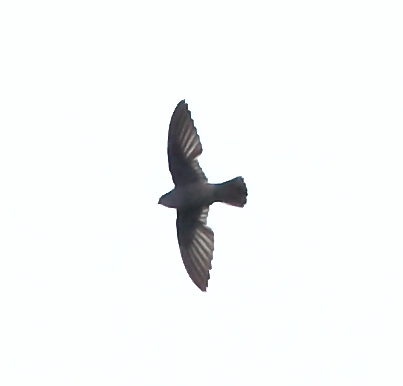
Wikipedia: Band-rumped swift
![]() The band-rumped swift (Chaetura spinicaudus) is a small swift. Until 1998, it was known as Chaetura spinicauda. At that time, the previously considered subspecies Costa Rican swift, Chaetura fumosa, was split from this species and the scientific name was modified from C. spinacauda to C. spinacaudus.
[more]
The band-rumped swift (Chaetura spinicaudus) is a small swift. Until 1998, it was known as Chaetura spinicauda. At that time, the previously considered subspecies Costa Rican swift, Chaetura fumosa, was split from this species and the scientific name was modified from C. spinacauda to C. spinacaudus.
[more]
Familie Trochilidae (Hummingbirds):
Gattung Selasphorus:
Profil Wikipedia Xeno-Canto

Wikipedia: Volcano hummingbird
![]() The volcano hummingbird (Selasphorus flammula) is a very small hummingbird, native to the Talamancan montane forests of Costa Rica and western Panama.
[more]
The volcano hummingbird (Selasphorus flammula) is a very small hummingbird, native to the Talamancan montane forests of Costa Rica and western Panama.
[more]
Profil Wikipedia Xeno-Canto

Wikipedia: Scintillant hummingbird
![]() The scintillant hummingbird (Selasphorus scintilla) is ahummingbird endemic to Costa Rica and Panama.
This species is replaced at higher elevations by its relative, the volcano hummingbird, Selasphorus flammula.
[more]
The scintillant hummingbird (Selasphorus scintilla) is ahummingbird endemic to Costa Rica and Panama.
This species is replaced at higher elevations by its relative, the volcano hummingbird, Selasphorus flammula.
[more]
Gattung Phaethornis:
Profil Wikipedia Xeno-Canto
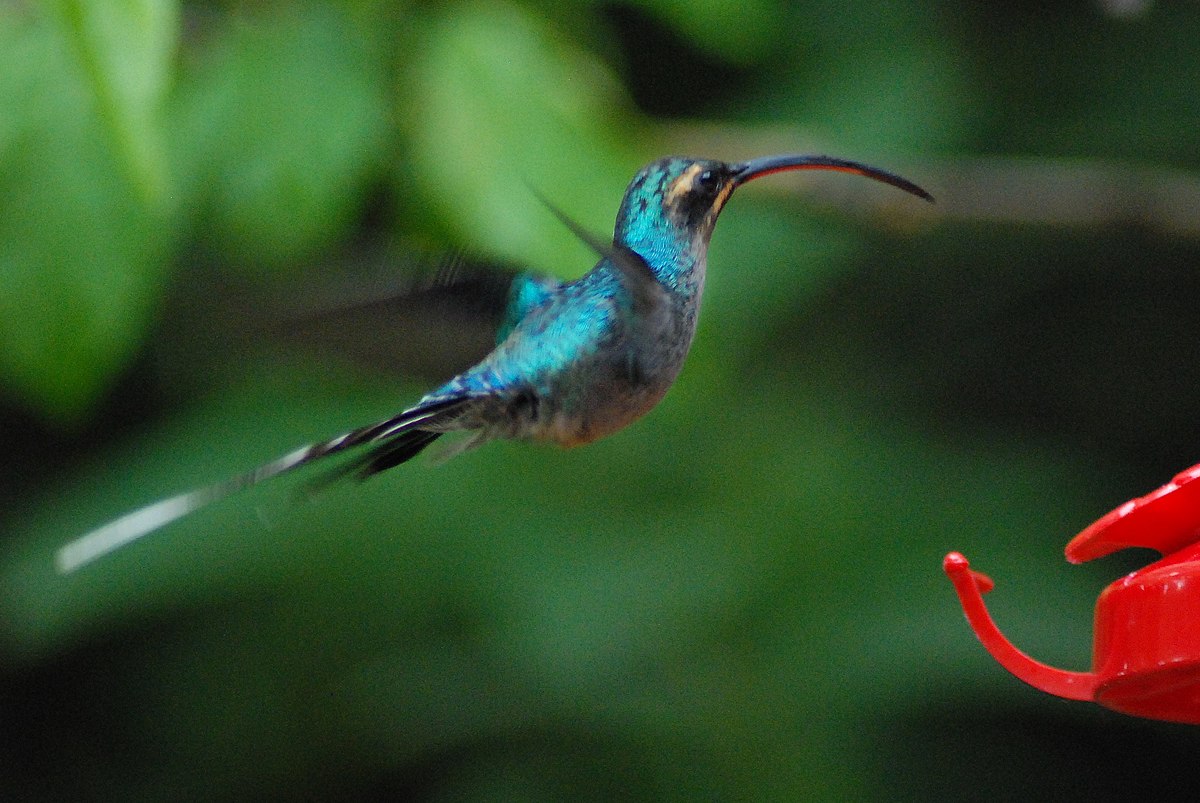
Wikipedia: Green hermit
![]() The green hermit (Phaethornis guy) is a large hummingbird that is a resident breeder from southern Central America (Costa Rica and Panama) south to northern South America (north-eastern Venezuela and Trinidad, and the northern Andes of eastern Peru)
[more]
The green hermit (Phaethornis guy) is a large hummingbird that is a resident breeder from southern Central America (Costa Rica and Panama) south to northern South America (north-eastern Venezuela and Trinidad, and the northern Andes of eastern Peru)
[more]
Profil Wikipedia Xeno-Canto

Wikipedia: Long-billed hermit
![]() The long-billed hermit (Phaethornis longirostris) is a large hummingbird that is a resident breeder from central Mexico south to northwestern Colombia, extreme western Venezuela and western Ecuador. This species was formerly known as the western long-tailed hermit or just long-tailed hermit, but was renamed to highlight its unusual bill.
[more]
The long-billed hermit (Phaethornis longirostris) is a large hummingbird that is a resident breeder from central Mexico south to northwestern Colombia, extreme western Venezuela and western Ecuador. This species was formerly known as the western long-tailed hermit or just long-tailed hermit, but was renamed to highlight its unusual bill.
[more]
Profil Wikipedia Xeno-Canto
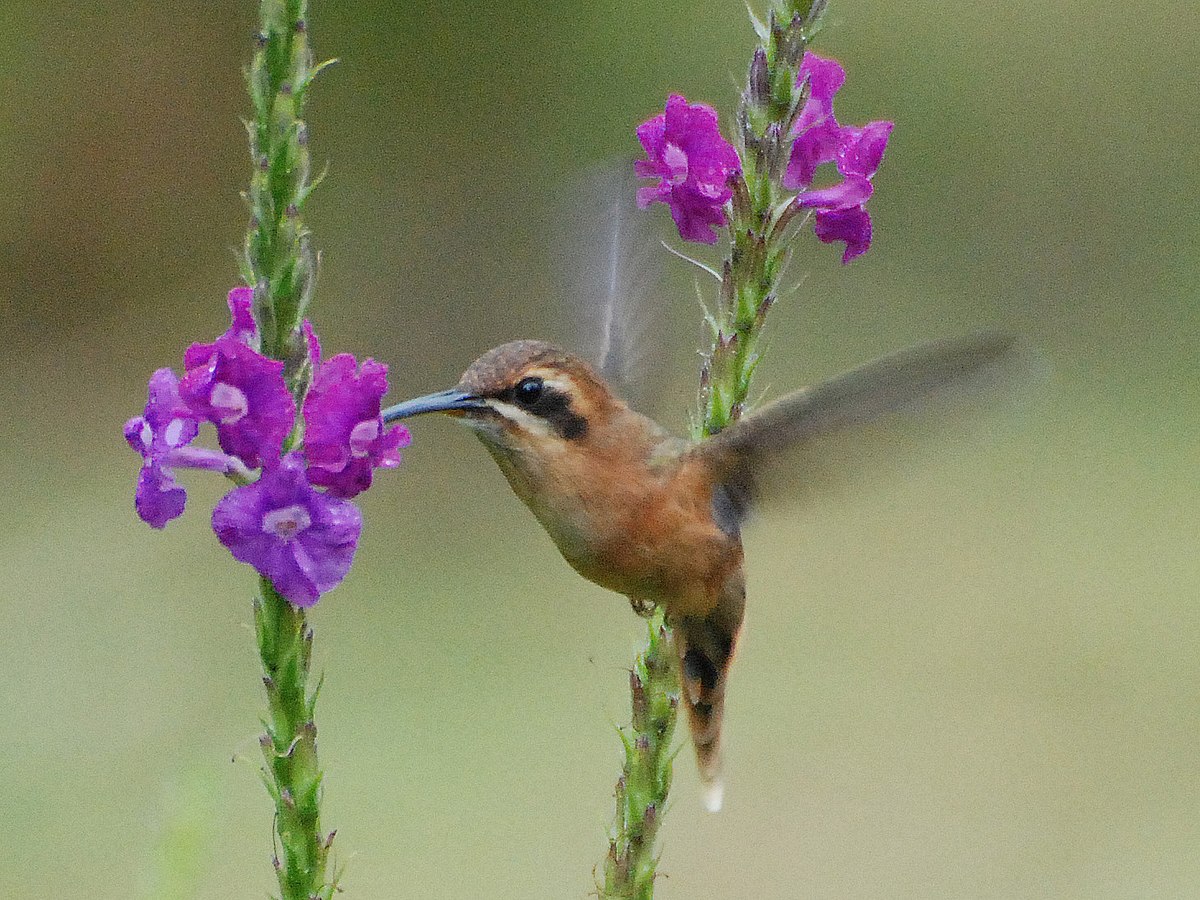
Wikipedia: Stripe-throated hermit
![]() The stripe-throated hermit (Phaethornis striigularis) is a species of hummingbird from Central America and north-western South America. It is generally fairly common and considered Least Concern by BirdLife International.
[more]
The stripe-throated hermit (Phaethornis striigularis) is a species of hummingbird from Central America and north-western South America. It is generally fairly common and considered Least Concern by BirdLife International.
[more]
Profil Wikipedia Xeno-Canto

Wikipedia: Pale-bellied hermit
![]() The pale-bellied hermit (Phaethornis anthophilus), also known as the Carinegro Hermit, is a species of hummingbird in the family Trochilidae.[2]
[more]
The pale-bellied hermit (Phaethornis anthophilus), also known as the Carinegro Hermit, is a species of hummingbird in the family Trochilidae.[2]
[more]
Gattung Amazilia:
La tarde rufous-tailed hummingbird. 2018-03-10 07.58.50 null
![]() The rufous-tailed hummingbird (Amazilia tzacatl) is a medium-sized hummingbird that breeds from east-central Mexico, through Central America and Colombia, east to western Venezuela and south through western Ecuador to near the border with Peru. The larger Escudo hummingbird from Isla Escudo de Veraguas in Panama is commonly considered a subspecies of the rufous-tailed hummingbird. This is a common to abundant bird of open country, river banks, woodland, scrub, forest edge, coffee plantations and gardens up to 1,850 m (6,070 ft).
[more]
The rufous-tailed hummingbird (Amazilia tzacatl) is a medium-sized hummingbird that breeds from east-central Mexico, through Central America and Colombia, east to western Venezuela and south through western Ecuador to near the border with Peru. The larger Escudo hummingbird from Isla Escudo de Veraguas in Panama is commonly considered a subspecies of the rufous-tailed hummingbird. This is a common to abundant bird of open country, river banks, woodland, scrub, forest edge, coffee plantations and gardens up to 1,850 m (6,070 ft).
[more]

Wikipedia: Cinnamon hummingbird
![]() The cinnamon hummingbird (Amazilia rutila) is a species of hummingbird in the family Trochilidae. It is found from northwestern Mexico to Costa Rica. Its natural habitats are subtropical or tropical dry forest, subtropical or tropical moist lowland forest, subtropical or tropical dry shrubland, and heavily degraded former forest.
[more]
The cinnamon hummingbird (Amazilia rutila) is a species of hummingbird in the family Trochilidae. It is found from northwestern Mexico to Costa Rica. Its natural habitats are subtropical or tropical dry forest, subtropical or tropical moist lowland forest, subtropical or tropical dry shrubland, and heavily degraded former forest.
[more]

Wikipedia: Mangrove hummingbird
![]() The mangrove hummingbird (Amazilia boucardi) is a species of hummingbird in the family Trochilidae. It is found only in Costa Rica. Its natural habitat is subtropical or tropical mangrove forest. It is threatened by habitat loss. The mangrove hummingbird feeds primarily on nectar from the flowers of the tea mangrove Pelliciera rhizophorae. Mangrove hummingbirds are occasionally seen in adjacent non-mangrove habitats. Nesting for these birds has been recorded during the months of October through February. The mangrove hummingbird is on average approximately 10 cm (3.9 in) long.
[more]
The mangrove hummingbird (Amazilia boucardi) is a species of hummingbird in the family Trochilidae. It is found only in Costa Rica. Its natural habitat is subtropical or tropical mangrove forest. It is threatened by habitat loss. The mangrove hummingbird feeds primarily on nectar from the flowers of the tea mangrove Pelliciera rhizophorae. Mangrove hummingbirds are occasionally seen in adjacent non-mangrove habitats. Nesting for these birds has been recorded during the months of October through February. The mangrove hummingbird is on average approximately 10 cm (3.9 in) long.
[more]
Gattung Chlorostilbon:
Profil Wikipedia Xeno-Canto

Wikipedia: Garden emerald
![]() The garden emerald (Chlorostilbon assimilis) is a small hummingbird that is an endemic resident breeder in Costa Rica and western Panama. It was formerly considered to be a subspecies of the blue-tailed emerald.
[more]
The garden emerald (Chlorostilbon assimilis) is a small hummingbird that is an endemic resident breeder in Costa Rica and western Panama. It was formerly considered to be a subspecies of the blue-tailed emerald.
[more]
Gattung Anthracothorax:
Profil Wikipedia Xeno-Canto

Wikipedia: Veraguan mango
![]() The Veraguan mango (Anthracothorax veraguensis) is a species of hummingbird in the family Trochilidae.
It is found in Panama and recently in Costa Rica.[2] It was considered conspecific with the Green-breasted Mango (Anthracothorax prevostii) but was separated due to morphological and geographical differences in 1995.[3]
[more]
The Veraguan mango (Anthracothorax veraguensis) is a species of hummingbird in the family Trochilidae.
It is found in Panama and recently in Costa Rica.[2] It was considered conspecific with the Green-breasted Mango (Anthracothorax prevostii) but was separated due to morphological and geographical differences in 1995.[3]
[more]
Funky bird on Bastimentos Island, Panama, possibly green-breasted mango. 2020-03-10 12.07.52 null
![]() The green-breasted mango (Anthracothorax prevostii) is a hummingbird from tropical America. The scientific name of this bird commemorates the French naturalist Florent Prévost.
[more]
The green-breasted mango (Anthracothorax prevostii) is a hummingbird from tropical America. The scientific name of this bird commemorates the French naturalist Florent Prévost.
[more]

Wikipedia: Black-throated mango
![]() The black-throated mango (Anthracothorax nigricollis) is a hummingbird species native to South America and Trinidad and Tobago.
[more]
The black-throated mango (Anthracothorax nigricollis) is a hummingbird species native to South America and Trinidad and Tobago.
[more]
Gattung Heliomaster:
Profil Wikipedia Xeno-Canto

Wikipedia: Long-billed starthroat
![]() The long-billed starthroat (Heliomaster longirostris) is a hummingbird that breeds from southern Mexico to Panama, from Colombia south and east to Bolivia and Brazil, and on Trinidad. It is present throughout South and Central America and is an uncommon but widespread species, which appears to be a local or seasonal migrant, although its movements are not well understood.
[more]
The long-billed starthroat (Heliomaster longirostris) is a hummingbird that breeds from southern Mexico to Panama, from Colombia south and east to Bolivia and Brazil, and on Trinidad. It is present throughout South and Central America and is an uncommon but widespread species, which appears to be a local or seasonal migrant, although its movements are not well understood.
[more]
Gattung Glaucis:

Wikipedia: Bronzy hermit
![]() The bronzy hermit (Glaucis aeneus) is a species of hummingbird in the family Trochilidae. It is found in forests and thickets from eastern Honduras south to western Panama, and in the Chocó of western Colombia and north-western Ecuador. It closely resembles the larger rufous-breasted hermit.
[more]
The bronzy hermit (Glaucis aeneus) is a species of hummingbird in the family Trochilidae. It is found in forests and thickets from eastern Honduras south to western Panama, and in the Chocó of western Colombia and north-western Ecuador. It closely resembles the larger rufous-breasted hermit.
[more]
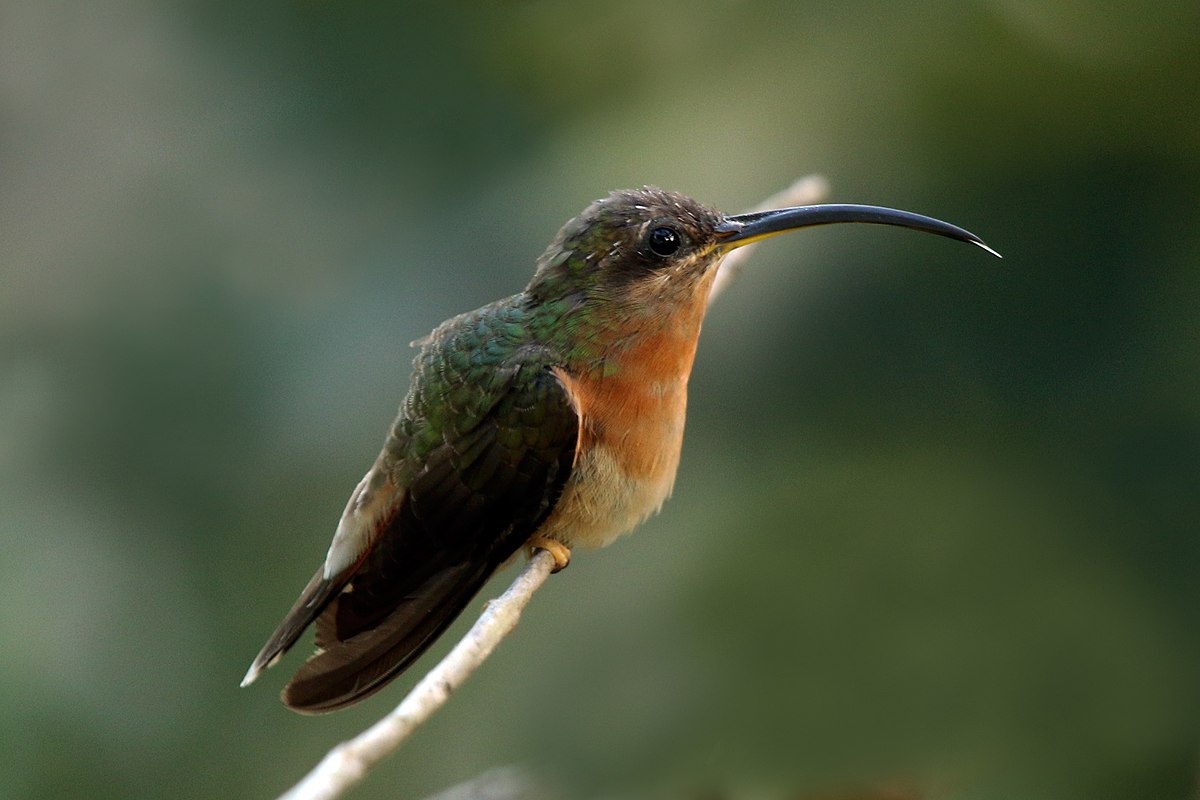
Wikipedia: Rufous-breasted hermit
![]() The rufous-breasted hermit or hairy hermit (Glaucis hirsutus) is a hummingbird that breeds from Panama south to Bolivia, and on Trinidad, Tobago and Grenada. It is a widespread and generally common species, though local populations may change in numbers and disappear altogether in marginal habitat[2]
[more]
The rufous-breasted hermit or hairy hermit (Glaucis hirsutus) is a hummingbird that breeds from Panama south to Bolivia, and on Trinidad, Tobago and Grenada. It is a widespread and generally common species, though local populations may change in numbers and disappear altogether in marginal habitat[2]
[more]
Gattung Archilochus:

Wikipedia: Ruby-throated hummingbird
![]() The ruby-throated hummingbird (Archilochus colubris) is a species of hummingbird that generally spends the winter in Central America, Mexico, and Florida, and migrates to Canada and other parts of Eastern North America for the summer to breed. It is by far the most common hummingbird seen east of the Mississippi River in North America.
[more]
The ruby-throated hummingbird (Archilochus colubris) is a species of hummingbird that generally spends the winter in Central America, Mexico, and Florida, and migrates to Canada and other parts of Eastern North America for the summer to breed. It is by far the most common hummingbird seen east of the Mississippi River in North America.
[more]
Gattung Discosura:
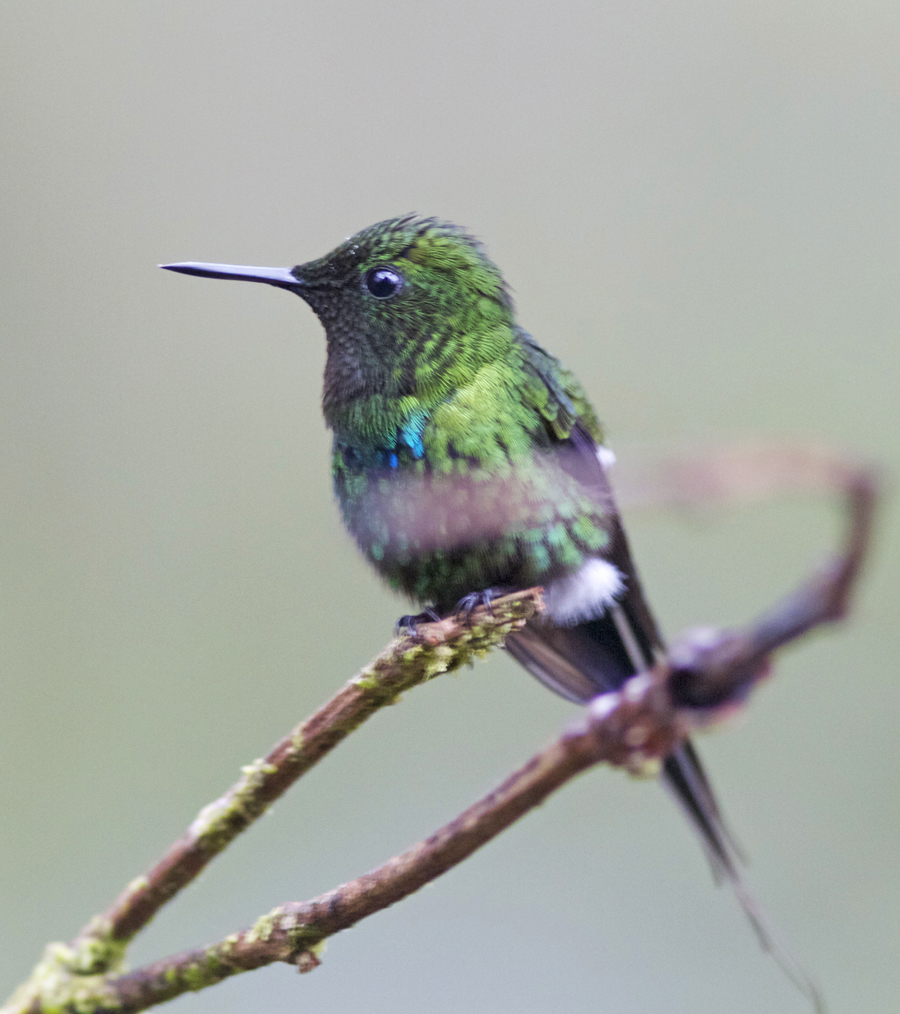
Wikipedia: Green thorntail
![]() The green thorntail (Discosura conversii) is a small hummingbird that is a resident breeder from Costa Rica to western Ecuador. It occurs at middle elevations from 700–1,400 m (2,300–4,600 ft) but may descend lower early in the wet season. In Costa Rica and Panama it is confined to the Caribbean slopes.
[more]
The green thorntail (Discosura conversii) is a small hummingbird that is a resident breeder from Costa Rica to western Ecuador. It occurs at middle elevations from 700–1,400 m (2,300–4,600 ft) but may descend lower early in the wet season. In Costa Rica and Panama it is confined to the Caribbean slopes.
[more]
Gattung Eutoxeres:
Profil Wikipedia Xeno-Canto

Wikipedia: White-tipped sicklebill
![]() The white-tipped sicklebill (Eutoxeres aquila) is a species of hummingbird in the family Trochilidae.
It is found in Costa Rica and Panama of Central America, and Colombia, Ecuador, and far northern Peru. There is also a single recent record from Mérida in Venezuela.
[more]
The white-tipped sicklebill (Eutoxeres aquila) is a species of hummingbird in the family Trochilidae.
It is found in Costa Rica and Panama of Central America, and Colombia, Ecuador, and far northern Peru. There is also a single recent record from Mérida in Venezuela.
[more]
Gattung Heliothryx:
Profil Wikipedia Xeno-Canto

Wikipedia: Purple-crowned fairy
![]() The purple-crowned fairy (Heliothryx barroti) is a large hummingbird that breeds in the lowlands and hills from southeastern Mexico south to southwestern Ecuador.
[more]
The purple-crowned fairy (Heliothryx barroti) is a large hummingbird that breeds in the lowlands and hills from southeastern Mexico south to southwestern Ecuador.
[more]
Gattung Lampornis:

Wikipedia: Purple-throated mountain-gem
![]() The purple-throated mountaingem (Lampornis calolaemus) is a hummingbird that breeds in the mountains of southern Nicaragua, northern Costa Rica and western Panama. This bird inhabits forested areas in hilly terrain, and is found at altitudes from 800 to 2,500 m (2,600 to 8,200 ft).
[more]
The purple-throated mountaingem (Lampornis calolaemus) is a hummingbird that breeds in the mountains of southern Nicaragua, northern Costa Rica and western Panama. This bird inhabits forested areas in hilly terrain, and is found at altitudes from 800 to 2,500 m (2,600 to 8,200 ft).
[more]
Profil Wikipedia Xeno-Canto

Wikipedia: White-throated mountain-gem
![]() The white-throated mountaingem (Lampornis castaneoventris) is a hummingbird which breeds in the mountains of western Panama. It is replaced in southern Costa Rica by the gray-tailed mountaingem, L. cinereicauda (García-Moreno et al., 2006). Another very close relative, the purple-throated mountaingem, is found sympatrically.
[more]
The white-throated mountaingem (Lampornis castaneoventris) is a hummingbird which breeds in the mountains of western Panama. It is replaced in southern Costa Rica by the gray-tailed mountaingem, L. cinereicauda (García-Moreno et al., 2006). Another very close relative, the purple-throated mountaingem, is found sympatrically.
[more]
Profil Wikipedia Xeno-Canto

Wikipedia: White-bellied mountain-gem
![]() The white-bellied mountaingem (Lampornis hemileucus) is a species of hummingbird in the family Trochilidae. It is found in the Talamancan montane forests.
[more]
The white-bellied mountaingem (Lampornis hemileucus) is a species of hummingbird in the family Trochilidae. It is found in the Talamancan montane forests.
[more]
Gattung Thalurania:
Profil Wikipedia Xeno-Canto

Wikipedia: Crowned woodnymph
![]() The crowned woodnymph (Thalurania colombica) is a species of bird in the hummingbird family Trochilidae.
It is found in Belize and Guatemala to northern Peru.
Its natural habitats are subtropical or tropical moist lowland forest, subtropical or tropical moist montane forest, and heavily degraded former forest.
[more]
The crowned woodnymph (Thalurania colombica) is a species of bird in the hummingbird family Trochilidae.
It is found in Belize and Guatemala to northern Peru.
Its natural habitats are subtropical or tropical moist lowland forest, subtropical or tropical moist montane forest, and heavily degraded former forest.
[more]
Gattung Androdon:
Profil Wikipedia Xeno-Canto
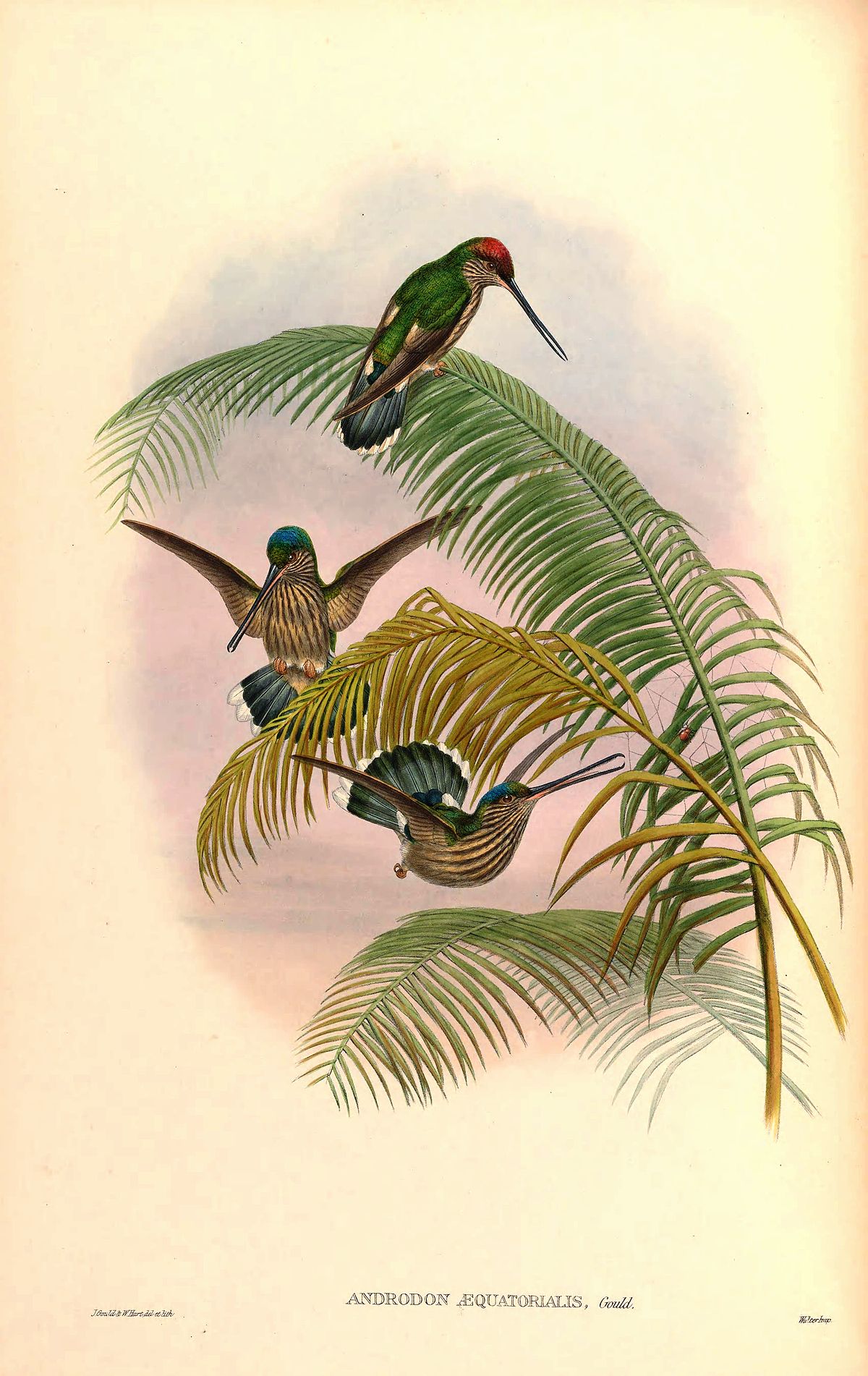
Wikipedia: Tooth-billed hummingbird
![]() The tooth-billed hummingbird (Androdon aequatorialis) is a species of bird from the family Trochilidae. It is monotypic within the genus Androdon. It is found in humid forests in western Colombia, north-western Ecuador (south to Pichincha Province), and far eastern Panama (Darién Province). While generally scarce, localized and associated with the highly threatened humid sections of the Chocó, its range remains relatively large, and it is therefore considered to be of least concern by BirdLife International.
[more]
The tooth-billed hummingbird (Androdon aequatorialis) is a species of bird from the family Trochilidae. It is monotypic within the genus Androdon. It is found in humid forests in western Colombia, north-western Ecuador (south to Pichincha Province), and far eastern Panama (Darién Province). While generally scarce, localized and associated with the highly threatened humid sections of the Chocó, its range remains relatively large, and it is therefore considered to be of least concern by BirdLife International.
[more]
Gattung Colibri:
Profil Wikipedia Xeno-Canto

Wikipedia: Brown violetear
![]() The brown violetear (Colibri delphinae) is a large hummingbird that breeds at middle elevations in the mountains in Central America, and western and northern South America (primarily the Andes and the tepuis) with isolated populations on Trinidad and in the Brazilian state Bahia.
[more]
The brown violetear (Colibri delphinae) is a large hummingbird that breeds at middle elevations in the mountains in Central America, and western and northern South America (primarily the Andes and the tepuis) with isolated populations on Trinidad and in the Brazilian state Bahia.
[more]
Profil Wikipedia Xeno-Canto
Cloud forest reserve - Lesser violetear and green crowned brilliants. 2018-02-17 11.04.20 null
![]() The lesser violetear (Colibri cyanotus), also known as the mountain violet-ear, is a medium-sized, metallic green hummingbird species commonly found in forested areas from Costa Rica to northern South America. This species and the Mexican violetear were formerly considered as conspecific and named the 'green violetear'.
[more]
The lesser violetear (Colibri cyanotus), also known as the mountain violet-ear, is a medium-sized, metallic green hummingbird species commonly found in forested areas from Costa Rica to northern South America. This species and the Mexican violetear were formerly considered as conspecific and named the 'green violetear'.
[more]
Gattung Doryfera:
Profil Wikipedia Xeno-Canto

Wikipedia: Green-fronted lancebill
![]() The green-fronted lancebill (Doryfera ludovicae) is a species of hummingbird in the family Trochilidae. Primarily known for its incredibly long bill and “glittering” green patch of feathers on its forehead, D. ludovicae is found in subtropical and tropical moist montane forest and prefers regions that include fast moving rivers and streams.[2]
[more]
The green-fronted lancebill (Doryfera ludovicae) is a species of hummingbird in the family Trochilidae. Primarily known for its incredibly long bill and “glittering” green patch of feathers on its forehead, D. ludovicae is found in subtropical and tropical moist montane forest and prefers regions that include fast moving rivers and streams.[2]
[more]
Gattung Threnetes:
Profil Wikipedia Xeno-Canto

Wikipedia: Band-tailed barbthroat
![]() The band-tailed barbthroat (Threnetes ruckeri) is a medium-sized hummingbird which is a resident breeder from southeastern Guatemala and Belize to western Ecuador and western Venezuela.[1]
[more]
The band-tailed barbthroat (Threnetes ruckeri) is a medium-sized hummingbird which is a resident breeder from southeastern Guatemala and Belize to western Ecuador and western Venezuela.[1]
[more]
Gattung Campylopterus:
Profil Wikipedia Xeno-Canto

Wikipedia: Scaly-breasted hummingbird
![]() The scaly-breasted hummingbird (Phaeochroa cuvierii) is a species of hummingbird in the family Trochilidae. It is the only species placed in the genus Phaeochroa.
[more]
The scaly-breasted hummingbird (Phaeochroa cuvierii) is a species of hummingbird in the family Trochilidae. It is the only species placed in the genus Phaeochroa.
[more]
Profil Wikipedia Xeno-Canto

Wikipedia: Violet sabrewing
![]() The violet sabrewing (Campylopterus hemileucurus) is a very large hummingbird native to southern Mexico and Central America as far south as Costa Rica and western Panama.
[more]
The violet sabrewing (Campylopterus hemileucurus) is a very large hummingbird native to southern Mexico and Central America as far south as Costa Rica and western Panama.
[more]
Gattung Chrysuronia:
Profil Wikipedia Xeno-Canto

Wikipedia: Sapphire-throated hummingbird
![]() The sapphire-throated hummingbird (Chrysuronia coeruleogularis) is a shiny metallic-green hummingbird found in Panama, Colombia, and more recently Costa Rica.[2] The sapphire-throated hummingbird is separated into three subspecies; Chrysuronia coeruleogularis coeruleogularis, Chrysuronia coeruleogularis coelina, and Chrysuronia coeruleogularis conifis.[3][4]
[more]
The sapphire-throated hummingbird (Chrysuronia coeruleogularis) is a shiny metallic-green hummingbird found in Panama, Colombia, and more recently Costa Rica.[2] The sapphire-throated hummingbird is separated into three subspecies; Chrysuronia coeruleogularis coeruleogularis, Chrysuronia coeruleogularis coelina, and Chrysuronia coeruleogularis conifis.[3][4]
[more]
Gattung Florisuga:
Profil Wikipedia Xeno-Canto
Arenal hummingbird tentative ID White-necked Jacobin. 2018-02-28 09.40.12 null
![]() The white-necked jacobin (Florisuga mellivora) is a large and attractive hummingbird that ranges from Mexico, south to Peru, Bolivia and south Brazil. It is also found on Tobago (subspecies F. m. flabellifera) and in Trinidad (subspecies F. m. mellivora)
[more]
The white-necked jacobin (Florisuga mellivora) is a large and attractive hummingbird that ranges from Mexico, south to Peru, Bolivia and south Brazil. It is also found on Tobago (subspecies F. m. flabellifera) and in Trinidad (subspecies F. m. mellivora)
[more]
Gattung Haplophaedia:
Profil Wikipedia Xeno-Canto

Wikipedia: Greenish puffleg
![]() The greenish puffleg (Haplophaedia aureliae) is a species of hummingbird in the family Trochilidae.
It is found in Colombia, Ecuador, and Panama.
Its natural habitats are subtropical or tropical moist montane forest and heavily degraded former forest. It is often regarded as including the buff-thighed puffleg as a subspecies.
[more]
The greenish puffleg (Haplophaedia aureliae) is a species of hummingbird in the family Trochilidae.
It is found in Colombia, Ecuador, and Panama.
Its natural habitats are subtropical or tropical moist montane forest and heavily degraded former forest. It is often regarded as including the buff-thighed puffleg as a subspecies.
[more]
Gattung Heliodoxa:
Profil Wikipedia Xeno-Canto
Cloud forest green crowned brilliant hummingbird in tree. 2018-02-17 11.03.54 null
![]() The green-crowned brilliant (Heliodoxa jacula) is a large, robust hummingbird that is a resident breeder in the highlands from Costa Rica to western Ecuador. It is also known as the green-fronted brilliant.[2]
[more]
The green-crowned brilliant (Heliodoxa jacula) is a large, robust hummingbird that is a resident breeder in the highlands from Costa Rica to western Ecuador. It is also known as the green-fronted brilliant.[2]
[more]
Gattung Klais:
Profil Wikipedia Xeno-Canto

Wikipedia: Violet-headed hummingbird
![]() The violet-headed hummingbird (Klais guimeti) is a species of hummingbird in the family Trochilidae. It is the only species in the genus Klais.
[more]
The violet-headed hummingbird (Klais guimeti) is a species of hummingbird in the family Trochilidae. It is the only species in the genus Klais.
[more]
Gattung Lophornis:
Profil Wikipedia Xeno-Canto

Wikipedia: White-crested coquette
![]() The white-crested coquette (Lophornis adorabilis) is a species of hummingbird in the family Trochilidae.
It is found in Costa Rica and Panama.
Its natural habitats are subtropical or tropical moist lowland forest and heavily degraded former forest.
[more]
The white-crested coquette (Lophornis adorabilis) is a species of hummingbird in the family Trochilidae.
It is found in Costa Rica and Panama.
Its natural habitats are subtropical or tropical moist lowland forest and heavily degraded former forest.
[more]
Profil Wikipedia Xeno-Canto
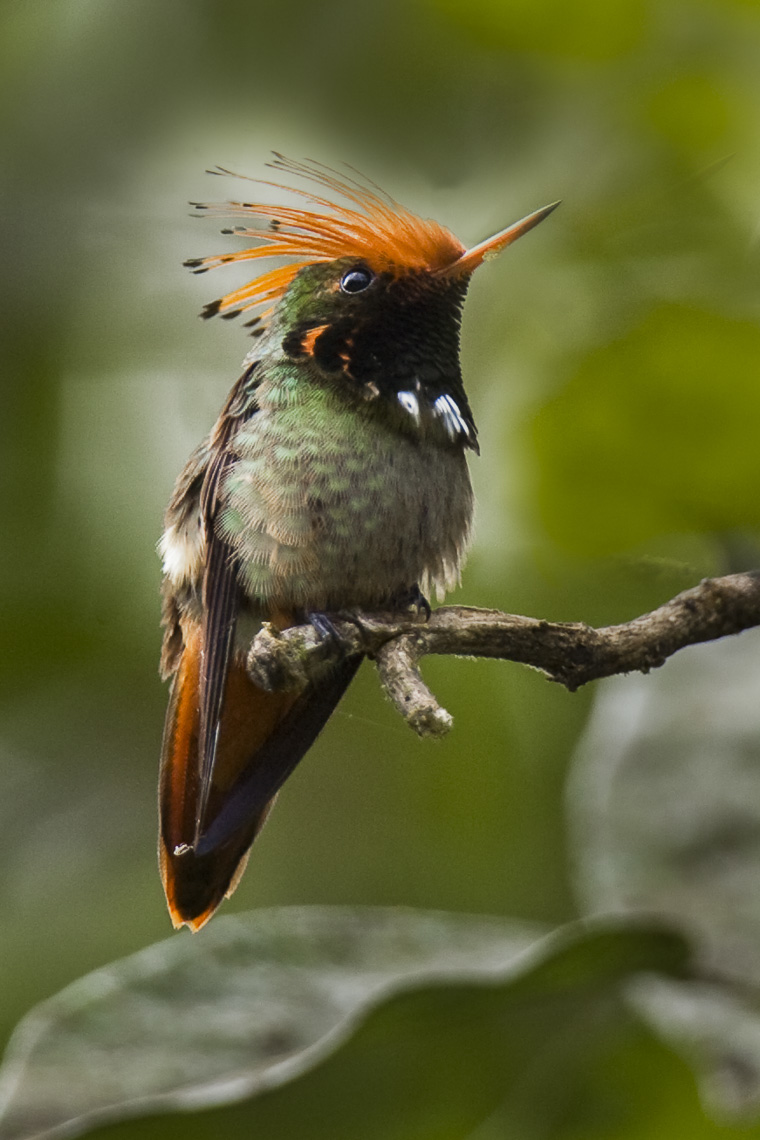
Wikipedia: Rufous-crested coquette
![]() The rufous-crested coquette (Lophornis delattrei) is a species of hummingbird native to the tropical slopes of pacific South America. Due to its small size and population, it is a rare sight even within its native region. Males of the species can be easily distinguished by their striking rufous coloured spiked crests, and females, while less obvious, can be identified by their small size and rufous coloured foreheads.[2]
[more]
The rufous-crested coquette (Lophornis delattrei) is a species of hummingbird native to the tropical slopes of pacific South America. Due to its small size and population, it is a rare sight even within its native region. Males of the species can be easily distinguished by their striking rufous coloured spiked crests, and females, while less obvious, can be identified by their small size and rufous coloured foreheads.[2]
[more]
Gattung Panterpe:
Profil Wikipedia Xeno-Canto

Wikipedia: Fiery-throated hummingbird
![]() The fiery-throated hummingbird (Panterpe insignis) is a medium-sized hummingbird of the Talamancan montane forests of Costa Rica and western Panama. It is the only member of the genus Panterpe.
[more]
The fiery-throated hummingbird (Panterpe insignis) is a medium-sized hummingbird of the Talamancan montane forests of Costa Rica and western Panama. It is the only member of the genus Panterpe.
[more]
Gattung Eugenes:
Profil Wikipedia Xeno-Canto

Wikipedia: Talamanca hummingbird
![]() The Talamanca hummingbird (Eugenes spectabilis) or admirable hummingbird, is a large hummingbird. Some taxonomic authorities, such as the International Ornithological Committee, split the magnificent hummingbird into two species,[1] in which case the nominate subspecies fulgens is renamed Rivoli's hummingbird and spectabilis is named the admirable hummingbird. Other taxonomic authorities have not recognized the split. The talamanca hummingbird's range is Costa Rica to Panama.
[more]
The Talamanca hummingbird (Eugenes spectabilis) or admirable hummingbird, is a large hummingbird. Some taxonomic authorities, such as the International Ornithological Committee, split the magnificent hummingbird into two species,[1] in which case the nominate subspecies fulgens is renamed Rivoli's hummingbird and spectabilis is named the admirable hummingbird. Other taxonomic authorities have not recognized the split. The talamanca hummingbird's range is Costa Rica to Panama.
[more]
Gattung Calliphlox:
Profil Wikipedia Xeno-Canto
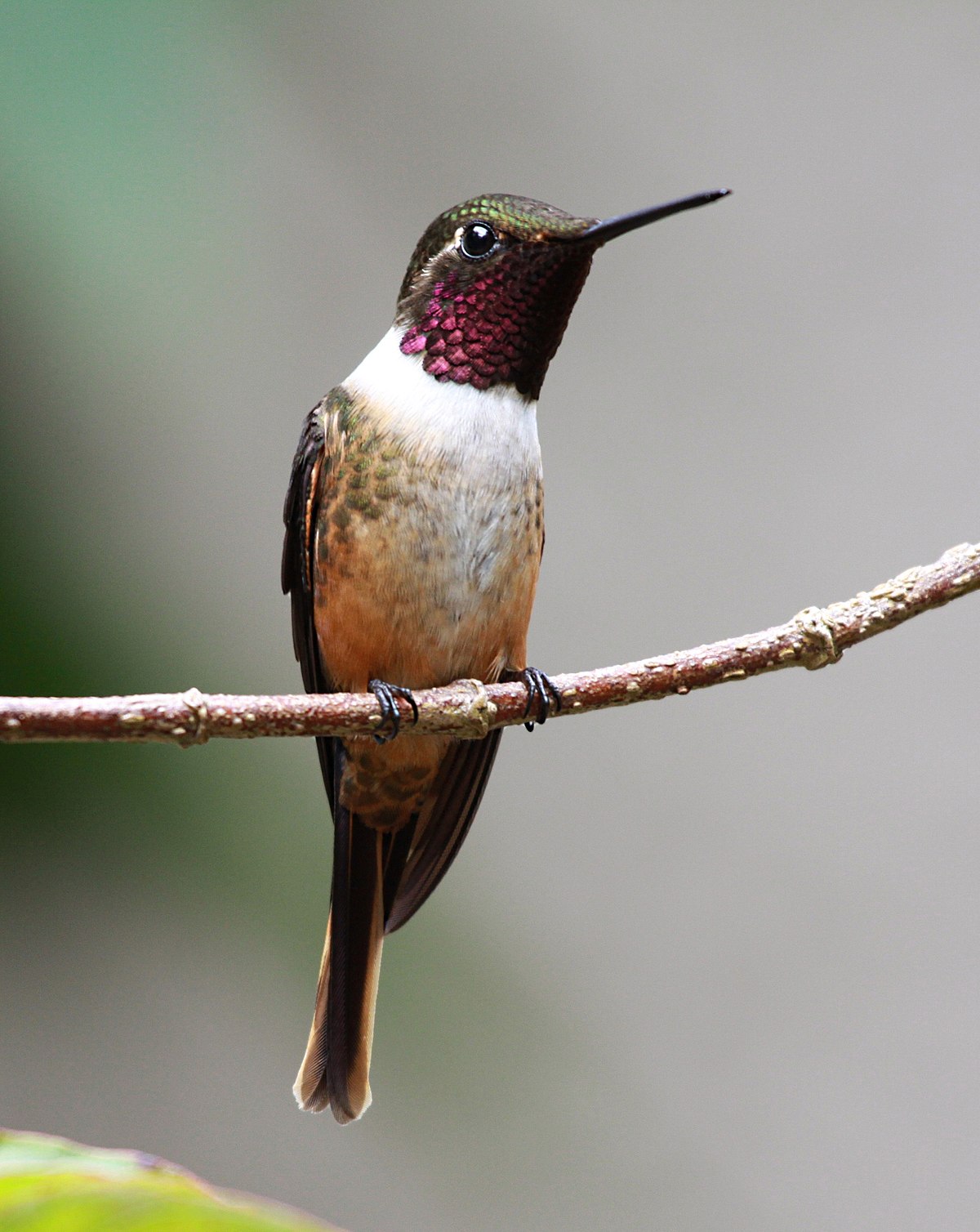
Wikipedia: Magenta-throated woodstar
![]() The magenta-throated woodstar (Calliphlox bryantae) is a hummingbird that is a resident breeder in forest edge and scrub of the Talamancan montane forests.
[more]
The magenta-throated woodstar (Calliphlox bryantae) is a hummingbird that is a resident breeder in forest edge and scrub of the Talamancan montane forests.
[more]
Profil Wikipedia Xeno-Canto

Wikipedia: Purple-throated woodstar
![]() The purple-throated woodstar (Calliphlox mitchellii) is a species of hummingbird, and it is one of the four Calliphlox species, the woodstars. The species is found in Colombia and Ecuador, and a minor localized population in Panama, 600 km from its main species distribution.
[more]
The purple-throated woodstar (Calliphlox mitchellii) is a species of hummingbird, and it is one of the four Calliphlox species, the woodstars. The species is found in Colombia and Ecuador, and a minor localized population in Panama, 600 km from its main species distribution.
[more]
Gattung Chalybura:
Profil Wikipedia Xeno-Canto
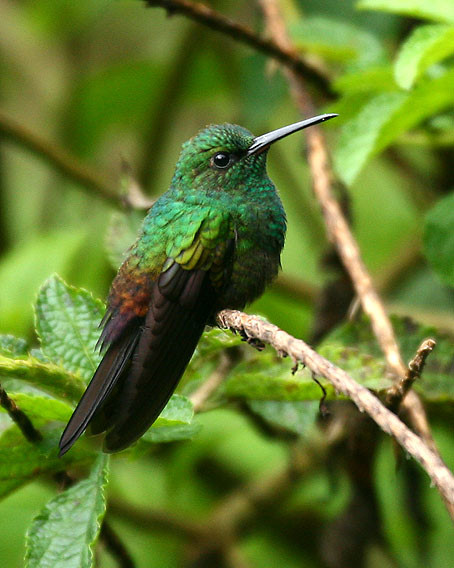
Wikipedia: Bronze-tailed plumeleteer
![]() The bronze-tailed plumeleteer (Chalybura urochrysia) is a large hummingbird resident in Central America and South America from eastern Honduras to northwestern Ecuador. The birds inhabit forests and have a preference for edges, gaps and secondary growth. It occurs in the Caribbean lowlands, typically up to an elevation of 700 metres.
[more]
The bronze-tailed plumeleteer (Chalybura urochrysia) is a large hummingbird resident in Central America and South America from eastern Honduras to northwestern Ecuador. The birds inhabit forests and have a preference for edges, gaps and secondary growth. It occurs in the Caribbean lowlands, typically up to an elevation of 700 metres.
[more]
Profil Wikipedia Xeno-Canto

Wikipedia: White-vented plumeleteer
![]() The white-vented plumeleteer (Chalybura buffonii) is a species of hummingbird in the family Trochilidae.
[more]
The white-vented plumeleteer (Chalybura buffonii) is a species of hummingbird in the family Trochilidae.
[more]
Gattung Eupherusa:

Wikipedia: Stripe-tailed hummingbird
![]() The stripe-tailed hummingbird (Eupherusa eximia) is a species of hummingbird endemic to subtropical moist forest and adjacent clearings of Middle America, from the Gulf slope of southeastern Mexico to Panama.
[more]
The stripe-tailed hummingbird (Eupherusa eximia) is a species of hummingbird endemic to subtropical moist forest and adjacent clearings of Middle America, from the Gulf slope of southeastern Mexico to Panama.
[more]
Profil Wikipedia Xeno-Canto

Wikipedia: Black-bellied hummingbird
![]() The black-bellied hummingbird (Eupherusa nigriventris) is a species of hummingbird in the family Trochilidae.
[more]
The black-bellied hummingbird (Eupherusa nigriventris) is a species of hummingbird in the family Trochilidae.
[more]
Gattung Microchera:
Profil Wikipedia Xeno-Canto

Wikipedia: Coppery-headed emerald
![]() The coppery-headed emerald (Microchera cupreiceps) is a small hummingbird endemic to Costa Rica. It measures a mere 3 in (7.6 cm) in length, and weighs only 3 g (0.11 oz).[2] The male has distinctive coppery crown and rump with a whole green belly and white vent. The female has a white belly and a narrow black subterminal band on white outer rectrices of the tail. Its noticeably decurved bill sets it apart from similar the allopatric white-tailed emerald.
[more]
The coppery-headed emerald (Microchera cupreiceps) is a small hummingbird endemic to Costa Rica. It measures a mere 3 in (7.6 cm) in length, and weighs only 3 g (0.11 oz).[2] The male has distinctive coppery crown and rump with a whole green belly and white vent. The female has a white belly and a narrow black subterminal band on white outer rectrices of the tail. Its noticeably decurved bill sets it apart from similar the allopatric white-tailed emerald.
[more]
Profil Wikipedia Xeno-Canto

Wikipedia: White-tailed emerald
![]() The white-tailed emerald (Microchera chionura) is a species of hummingbird in the family Trochilidae.
It is native to the Talamancan montane forests. With a weight under 3 grams, this is one of the smallest birds in existence.[2]
[more]
The white-tailed emerald (Microchera chionura) is a species of hummingbird in the family Trochilidae.
It is native to the Talamancan montane forests. With a weight under 3 grams, this is one of the smallest birds in existence.[2]
[more]
Profil Wikipedia Xeno-Canto

Wikipedia: Snowcap
![]() The snowcap (Microchera albocoronata) is a small hummingbird.
[more]
The snowcap (Microchera albocoronata) is a small hummingbird.
[more]
Gattung Cynanthus:
Profil Wikipedia Xeno-Canto
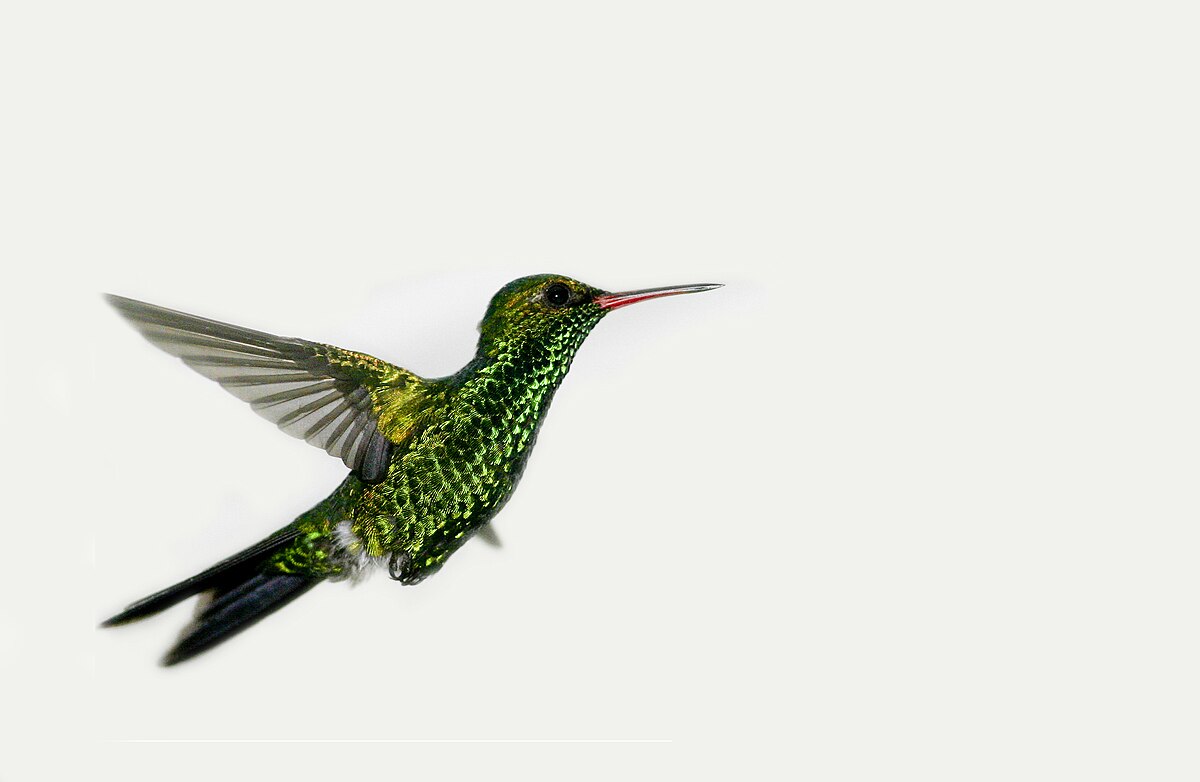
Wikipedia: Canivet's emerald
![]() Canivet's emerald (Cynanthus canivetii) or the fork-tailed emerald, is a species of hummingbird in the family Trochilidae. It is found in Belize, Costa Rica, El Salvador, Guatemala, Honduras, Mexico, and Nicaragua. Its natural habitats are subtropical or tropical dry forest, subtropical or tropical moist lowland forest, and heavily degraded former forest.
[more]
Canivet's emerald (Cynanthus canivetii) or the fork-tailed emerald, is a species of hummingbird in the family Trochilidae. It is found in Belize, Costa Rica, El Salvador, Guatemala, Honduras, Mexico, and Nicaragua. Its natural habitats are subtropical or tropical dry forest, subtropical or tropical moist lowland forest, and heavily degraded former forest.
[more]
Gattung Goldmania:
Profil Wikipedia Xeno-Canto

Wikipedia: Violet-capped hummingbird
![]() The violet-capped hummingbird (Goldmania violiceps) is a species of hummingbird in the family Trochilidae. It is found in Panama and far northwestern Colombia.
[more]
The violet-capped hummingbird (Goldmania violiceps) is a species of hummingbird in the family Trochilidae. It is found in Panama and far northwestern Colombia.
[more]
Ordnung Caprimulgiformes (Schwalmvögel / Nightjars and others):
Familie Caprimulgidae:
Unterfamilie Caprimulginae:
Profil Wikipedia Xeno-Canto

Wikipedia: Ocellated poorwill
![]() The ocellated poorwill (Nyctiphrynus ocellatus) is a species of nightjar in the family Caprimulgidae. It is found in Argentina, Bolivia, Brazil, Colombia, Costa Rica, Ecuador, Honduras, Nicaragua, Paraguay, and Peru. Its natural habitats are subtropical or tropical moist lowland forests and subtropical or tropical moist montane forests.
[more]
The ocellated poorwill (Nyctiphrynus ocellatus) is a species of nightjar in the family Caprimulgidae. It is found in Argentina, Bolivia, Brazil, Colombia, Costa Rica, Ecuador, Honduras, Nicaragua, Paraguay, and Peru. Its natural habitats are subtropical or tropical moist lowland forests and subtropical or tropical moist montane forests.
[more]

Wikipedia: Pauraque
![]() The pauraque (Nyctidromus albicollis) – also called the common pauraque to distinguish it from similar species – is a nightjar species, one of two birds in the genus Nyctidromus. It breeds in the subtropical and tropical of the New World, and except for northernmost birds it is largely resident all year round.[2]
[more]
The pauraque (Nyctidromus albicollis) – also called the common pauraque to distinguish it from similar species – is a nightjar species, one of two birds in the genus Nyctidromus. It breeds in the subtropical and tropical of the New World, and except for northernmost birds it is largely resident all year round.[2]
[more]

Wikipedia: White-tailed nightjar
![]() The white-tailed nightjar (Hydropsalis cayennensis) is a species of nightjar in the family Caprimulgidae.
[more]
The white-tailed nightjar (Hydropsalis cayennensis) is a species of nightjar in the family Caprimulgidae.
[more]
Unterfamilie Chordeilinae:

Wikipedia: Common nighthawk
![]() The common nighthawk (Chordeiles minor) is a medium-sized [3][4] crepuscular or nocturnal bird[3][5] of the Americas within the nightjar family, whose presence and identity are best revealed by its vocalization. Typically dark[3] (grey, black and brown),[5] displaying cryptic colouration and intricate patterns, this bird is difficult to spot with the naked eye during the day. Once aerial, with its buoyant but erratic flight, this bird is most conspicuous. The most remarkable feature of this aerial insectivore is its small beak that belies the massiveness of its mouth. Some claim appearance similarities to owls. With its horizontal stance[3] and short legs, the common nighthawk does not travel frequently on the ground, instead preferring to perch horizontally, parallel to branches, on posts, on the ground or on a roof.[5] The males of this species may roost together but the bird is primarily solitary. The common nighthawk shows variability in territory size.[4]
[more]
The common nighthawk (Chordeiles minor) is a medium-sized [3][4] crepuscular or nocturnal bird[3][5] of the Americas within the nightjar family, whose presence and identity are best revealed by its vocalization. Typically dark[3] (grey, black and brown),[5] displaying cryptic colouration and intricate patterns, this bird is difficult to spot with the naked eye during the day. Once aerial, with its buoyant but erratic flight, this bird is most conspicuous. The most remarkable feature of this aerial insectivore is its small beak that belies the massiveness of its mouth. Some claim appearance similarities to owls. With its horizontal stance[3] and short legs, the common nighthawk does not travel frequently on the ground, instead preferring to perch horizontally, parallel to branches, on posts, on the ground or on a roof.[5] The males of this species may roost together but the bird is primarily solitary. The common nighthawk shows variability in territory size.[4]
[more]
Profil Wikipedia Audubon Xeno-Canto

Wikipedia: Lesser nighthawk
![]() The lesser nighthawk (Chordeiles acutipennis) is a nightjar found throughout a large part of the Americas.
[more]
The lesser nighthawk (Chordeiles acutipennis) is a nightjar found throughout a large part of the Americas.
[more]
Profil Wikipedia Xeno-Canto

Wikipedia: Short-tailed nighthawk
![]() The short-tailed nighthawk (Lurocalis semitorquatus) is a species of nightjar in the family Caprimulgidae.[2]
[more]
The short-tailed nighthawk (Lurocalis semitorquatus) is a species of nightjar in the family Caprimulgidae.[2]
[more]
Gattung Antrostomus:

Wikipedia: Chuck-will's-widow
![]() The chuck-will's-widow (Antrostomus carolinensis) is a nocturnal bird of the nightjar family Caprimulgidae. It is found in the southeastern United States near swamps, rocky uplands, and pine woods. It migrates to the West Indies, Central America, and northwestern South America.
[more]
The chuck-will's-widow (Antrostomus carolinensis) is a nocturnal bird of the nightjar family Caprimulgidae. It is found in the southeastern United States near swamps, rocky uplands, and pine woods. It migrates to the West Indies, Central America, and northwestern South America.
[more]

Wikipedia: Eastern whip-poor-will
![]() The eastern whip-poor-will (Antrostomus vociferus) is a medium-sized (22–27 cm) nightjar from North America. The whip-poor-will is commonly heard within its range, but less often seen because of its camouflage. It is named onomatopoeically after its song.[2]
[more]
The eastern whip-poor-will (Antrostomus vociferus) is a medium-sized (22–27 cm) nightjar from North America. The whip-poor-will is commonly heard within its range, but less often seen because of its camouflage. It is named onomatopoeically after its song.[2]
[more]

Wikipedia: Dusky nightjar
![]() The dusky nightjar (Antrostomus saturatus) is a species of nightjar in the family Caprimulgidae. It is found in Costa Rica and western Panama. Its natural habitats are subtropical or tropical moist montane forests and heavily degraded former forest.
[more]
The dusky nightjar (Antrostomus saturatus) is a species of nightjar in the family Caprimulgidae. It is found in Costa Rica and western Panama. Its natural habitats are subtropical or tropical moist montane forests and heavily degraded former forest.
[more]

Wikipedia: Rufous nightjar
![]() The rufous nightjar (Antrostomus rufus) is a species of nightjar in the family Caprimulgidae.
[more]
The rufous nightjar (Antrostomus rufus) is a species of nightjar in the family Caprimulgidae.
[more]
Familie Nyctibiidae:
Gattung Nyctibius:
Profil Wikipedia Xeno-Canto

Wikipedia: Common potoo
![]() The common potoo, or poor-me-ones (Nyctibius griseus), is one of seven species within the genus Nyctibius.[2] It is notable for its large yellow eyes and comically wide mouth. Potoos are nocturnal near passerines related to nightjars and frogmouths. They lack the characteristic bristles around the mouths of true nightjars.[3] Until recently, the common potoo was said to range from Mexico down to the lowlands of central South America. However, in 2016, the species was subdivided into the northern potoo and the continuing branch of the common potoo, which only retains residence from Nicaragua to northern Argentina and Uruguay.[2] This division was largely based on the differing calls of the two species (view 0:39-0:50 here). Though not yet classified as endangered, the common potoo has been declining in numbers due to habitat destruction.[2]
[more]
The common potoo, or poor-me-ones (Nyctibius griseus), is one of seven species within the genus Nyctibius.[2] It is notable for its large yellow eyes and comically wide mouth. Potoos are nocturnal near passerines related to nightjars and frogmouths. They lack the characteristic bristles around the mouths of true nightjars.[3] Until recently, the common potoo was said to range from Mexico down to the lowlands of central South America. However, in 2016, the species was subdivided into the northern potoo and the continuing branch of the common potoo, which only retains residence from Nicaragua to northern Argentina and Uruguay.[2] This division was largely based on the differing calls of the two species (view 0:39-0:50 here). Though not yet classified as endangered, the common potoo has been declining in numbers due to habitat destruction.[2]
[more]
Profil Wikipedia Xeno-Canto
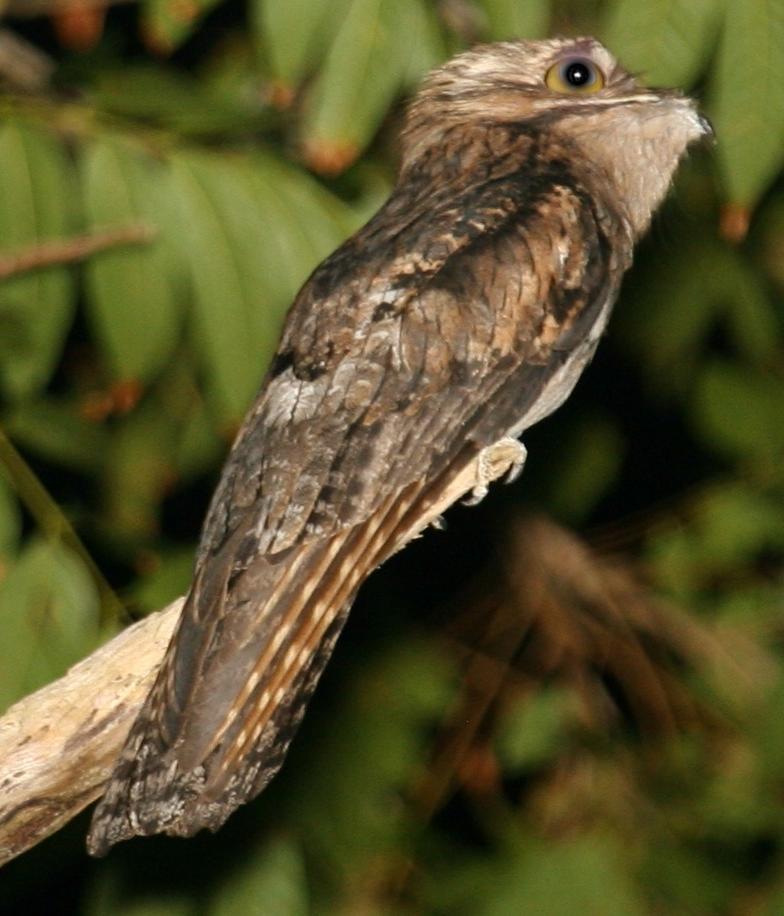
Wikipedia: Northern potoo
![]() The northern potoo (Nyctibius jamaicensis) is a nocturnal bird belonging to the potoo family, Nyctibiidae. It is found from Mexico south to Costa Rica, and on the islands of Jamaica and Hispaniola (Dominican Republic). It was formerly classified as a subspecies of the common potoo (Nyctibius griseus) but is now usually treated as a separate species based on differences in vocalizations.
[more]
The northern potoo (Nyctibius jamaicensis) is a nocturnal bird belonging to the potoo family, Nyctibiidae. It is found from Mexico south to Costa Rica, and on the islands of Jamaica and Hispaniola (Dominican Republic). It was formerly classified as a subspecies of the common potoo (Nyctibius griseus) but is now usually treated as a separate species based on differences in vocalizations.
[more]
Profil Wikipedia Xeno-Canto

Wikipedia: Great potoo
![]() The great potoo (Nyctibius grandis) is a near passerine bird, both the largest potoo species and the largest member of the order Caprimulgiformes (nightjars and allies). They are also one of seven species in one genus, Nyctibius, located in tropical America.
[more]
The great potoo (Nyctibius grandis) is a near passerine bird, both the largest potoo species and the largest member of the order Caprimulgiformes (nightjars and allies). They are also one of seven species in one genus, Nyctibius, located in tropical America.
[more]
Familie Steatornithidae:
Gattung Steatornis:
Profil Wikipedia Xeno-Canto

Wikipedia: Oilbird
![]() The oilbird (Steatornis caripensis), locally known as the guácharo, is a bird species found in the northern areas of South America including the island of Trinidad. It is the only species in the genus Steatornis and the family Steatornithidae. Nesting in colonies in caves, oilbirds are nocturnal feeders on the fruits of the oil palm and tropical laurels. They are the only nocturnal flying fruit-eating birds in the world (the kakapo is flightless). They forage at night, with specially adapted eyesight. However they navigate by echolocation in the same way as bats, one of the few birds to do so. They produce a high-pitched clicking sound of around 2 kHz that is audible to humans.[2]
[more]
The oilbird (Steatornis caripensis), locally known as the guácharo, is a bird species found in the northern areas of South America including the island of Trinidad. It is the only species in the genus Steatornis and the family Steatornithidae. Nesting in colonies in caves, oilbirds are nocturnal feeders on the fruits of the oil palm and tropical laurels. They are the only nocturnal flying fruit-eating birds in the world (the kakapo is flightless). They forage at night, with specially adapted eyesight. However they navigate by echolocation in the same way as bats, one of the few birds to do so. They produce a high-pitched clicking sound of around 2 kHz that is audible to humans.[2]
[more]
Klassifikation nicht gefunden:
Berg-Veilchenohrkolibri / Lesser violetear (Colibri cyanotus)
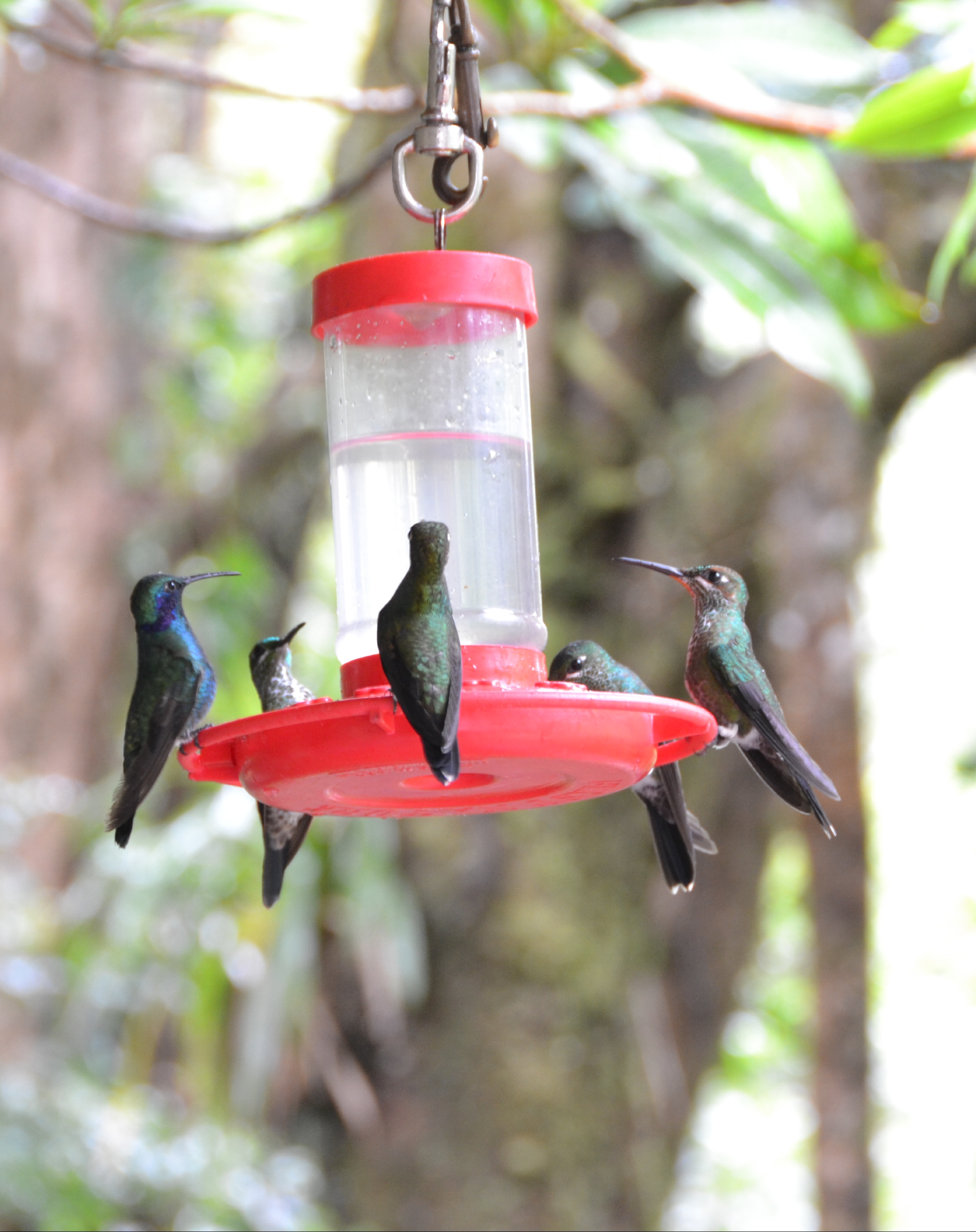
Green violetear and green crowned brilliants at cloud forest hummingbird feeder. 2018-02-17 18.04.19 null
![]() The lesser violetear (Colibri cyanotus), also known as the mountain violet-ear, is a medium-sized, metallic green hummingbird species commonly found in forested areas from Costa Rica to northern South America. This species and the Mexican violetear were formerly considered as conspecific and named the 'green violetear'.
[more]
The lesser violetear (Colibri cyanotus), also known as the mountain violet-ear, is a medium-sized, metallic green hummingbird species commonly found in forested areas from Costa Rica to northern South America. This species and the Mexican violetear were formerly considered as conspecific and named the 'green violetear'.
[more]
Schwarzschopfelfe / Black-crested coquette (Lophornis helenae)
Profil Wikipedia Xeno-Canto
La tarde Black-crested Coquette hummingbird. 2018-03-11 09.53.40 null
![]() Die Schwarzschopfelfe (Lophornis helenae) ist eine Vogelart aus der Familie der Kolibris (Trochilidae). Die Art hat ein großes Verbreitungsgebiet, das etwa 250.000 Quadratkilometer in den mittelamerikanischen Ländern Belize, Costa Rica, Guatemala, Honduras, Mexiko und Nicaragua umfasst. Der Bestand wird von der IUCN als nicht gefährdet (Least Concern) eingeschätzt.
[more]
Die Schwarzschopfelfe (Lophornis helenae) ist eine Vogelart aus der Familie der Kolibris (Trochilidae). Die Art hat ein großes Verbreitungsgebiet, das etwa 250.000 Quadratkilometer in den mittelamerikanischen Ländern Belize, Costa Rica, Guatemala, Honduras, Mexiko und Nicaragua umfasst. Der Bestand wird von der IUCN als nicht gefährdet (Least Concern) eingeschätzt.
[more]
Löffelente / Northern shoveler (Spatula clypeata)
Profil Wikipedia Vogelwarte BirdLife ZH Audubon Xeno-Canto BirdID NABU
Loeffelente, Neeracherried. 2021-02-24 12.27.04 null
Dieser Vogel erscheint jenseits grossen Meere in Kontinenten :
Europa, Nordamerika, Südamerika, Afrika.
![]() Die Löffelente (Spatula clypeata, Syn.: Anas clypeata) ist eine holarktisch verbreitete Vogelart aus der Familie der Entenvögel (Anatidae). Sie ist nur wenig kleiner als die bekannte Stockente. Der Erpel hat im Prachtkleid ein auffallend kontrastreiches Gefieder. In seiner Färbung erinnert es entfernt an das der Brandgans. Von dieser ist die Löffelente auf Grund ihrer geringeren Größe sowie ihres ententypischen Habitus sicher zu unterscheiden.
[more]
Die Löffelente (Spatula clypeata, Syn.: Anas clypeata) ist eine holarktisch verbreitete Vogelart aus der Familie der Entenvögel (Anatidae). Sie ist nur wenig kleiner als die bekannte Stockente. Der Erpel hat im Prachtkleid ein auffallend kontrastreiches Gefieder. In seiner Färbung erinnert es entfernt an das der Brandgans. Von dieser ist die Löffelente auf Grund ihrer geringeren Größe sowie ihres ententypischen Habitus sicher zu unterscheiden.
[more]
Vokalisierung: ![]() Male is characteristic and most often heard: A hoarse nasal knocking sound "took took", often staccato or disyllabic. Female similar to Mallard but flatter and more creaking. [Link]
Male is characteristic and most often heard: A hoarse nasal knocking sound "took took", often staccato or disyllabic. Female similar to Mallard but flatter and more creaking. [Link]
Körperlich: Länge=44-52 cm,
Flügelspanne=70-84 cm,
Gewicht=470-800 g